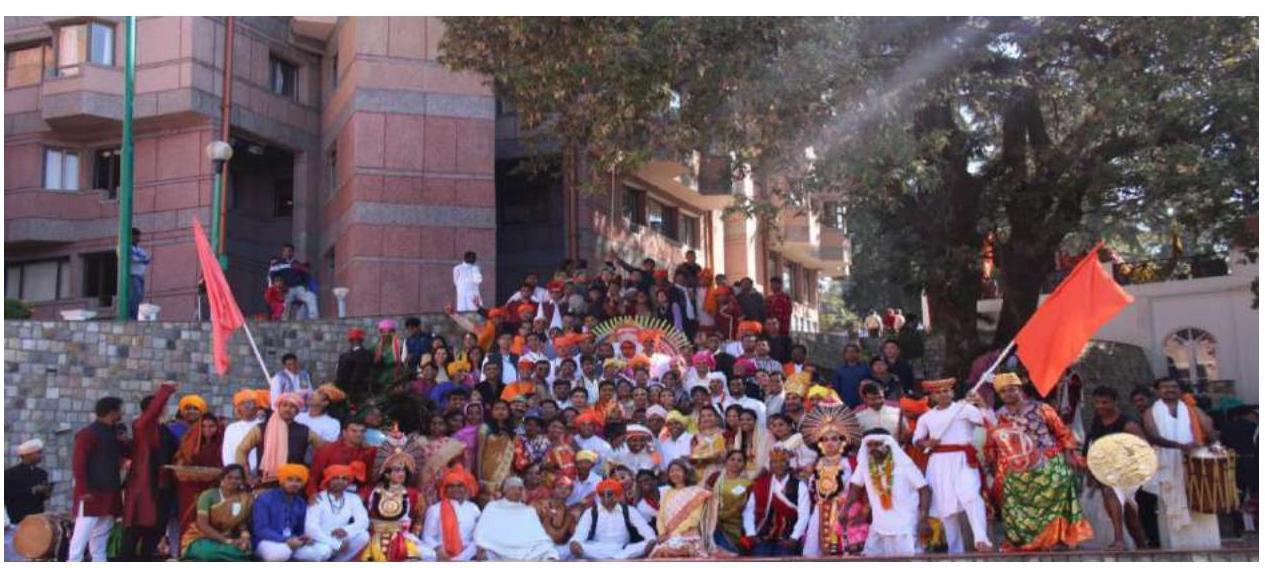This comprehensive annual report details the Ministry of Personnel, Public Grievances and Pensions’ initiatives, policies, and achievements from April 2022 to March 2023. It covers various aspects of personnel management, including cadre management, recruitment, training programs, and the department’s structure. The report also highlights efforts in administrative reforms, e-governance, public grievance redressal, and international cooperation. Key initiatives like Mission Karmayogi, the development of digital platforms for HR management, and measures for promoting the use of Hindi in official work are also elaborated upon. The document provides a detailed overview of the Ministry’s commitment to enhancing efficiency, transparency, and citizen-centric governance.
SOURCE PDF LINK :
Click to access AR2022-23English.pdf
Click to view full document content
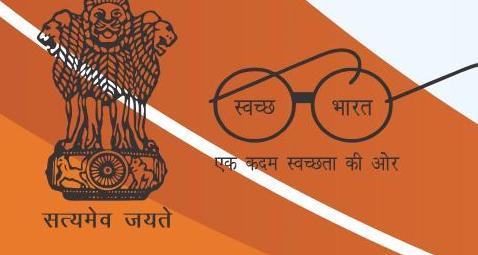
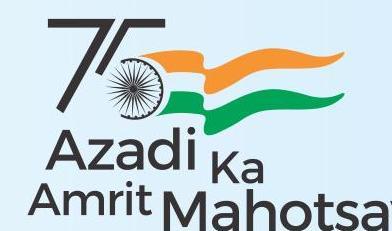
ANNUAL REPORT 2022-23
MINISTRY OF PERSONNEL, PUBLIC GRIEVANCES AND PENSIONS GOVERNMENT OF INDIA
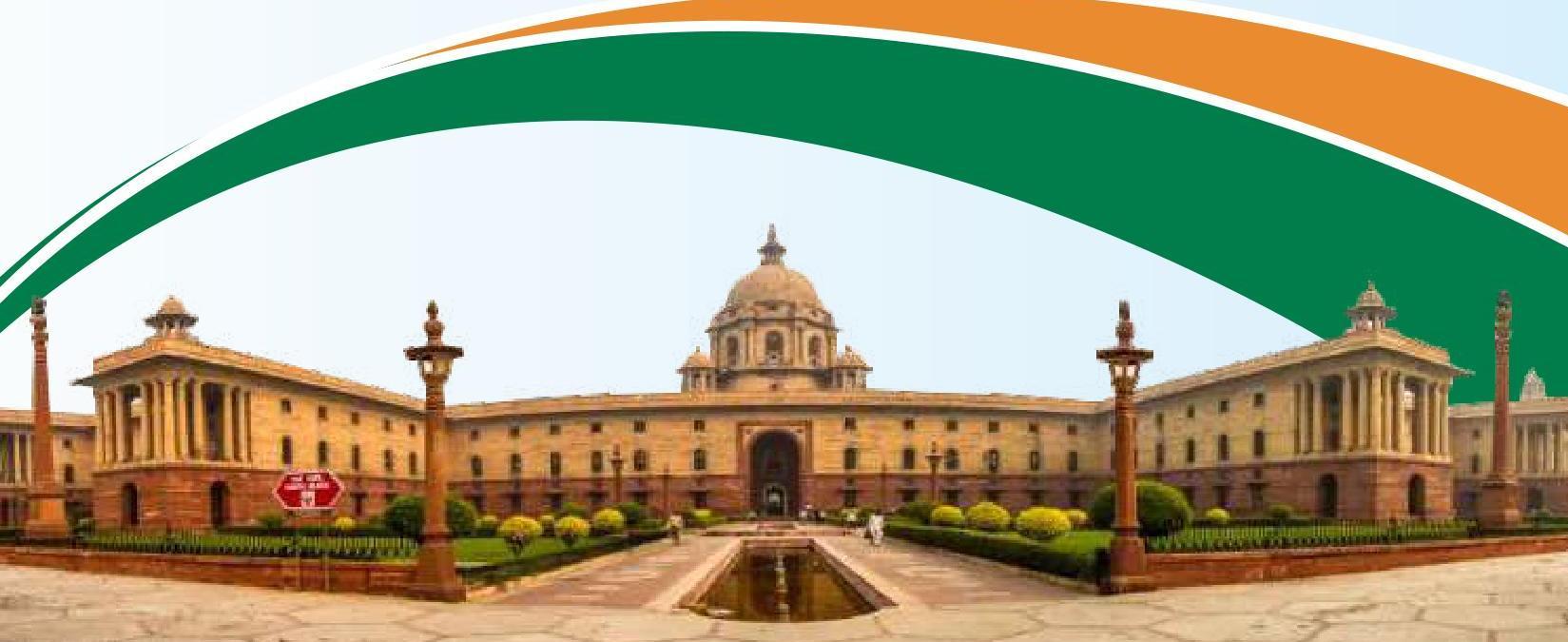
ANNUAL REPORT 2022-23
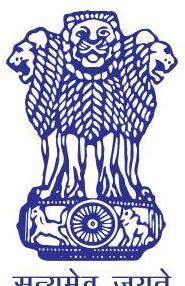
Ministry of Personnel, Public Grievances and Pensions
Government of India
.
CONTENTS
| List of chapters | Page Nos. | |
|---|---|---|
| Vision and Mission | (iii) | |
| Executive Summary | (iv) | |
| DEPARTMENT OF PERSONNEL AND TRAINING | ||
| 1 | Overview | 1 |
| 2 | Major Initiatives/Achievements/Events during the year | 7 |
| 3 | Personnel Policies | 24 |
| 4 | Reservation in the Central Government Services | 46 |
| 5 | Cadre Management | 51 |
| a) Indian Administrative Service (IAS) | 51 | |
| b) Central Secretariat Service (CSS) | 59 | |
| c) Central Secretariat Stenographers’ Service (CSSS) | 62 | |
| d) Central Secretariat Clerical Service (CSCS) | 65 | |
| e) State Reorganization | 66 | |
| 6 | Senior Appointments under Government of India | 70 |
| 7 | Training Policy and Programmes | 75 |
| 8 | Training Institutions | 83 |
| 9 | Mission Karmayogi & e-HRMS | 147 |
| 10 | Administrative Vigilance Division | 158 |
| 11 | International Cooperation | 167 |
| 12 | Central Bureau of Investigation | 169 |
| 13 | Joint Consultative Machinery | 194 |
| 14 | Administrative Tribunals | 196 |
| 15 | Staff Welfare | 200 |
| 16 | Right to Information | 209 |
| 17 | Grievance Redressal Mechanism \& Citizens’ Charter | 215 |
| 18 | Progressive Use of Hindi in Official Works | 218 |
| 19 | Financial Management | 223 |
| 20 | DEPARTMENT OF ADMINISTRATIVE REFORMS AND PUBLIC GRIEVANCES | 228 |
| 21 | Administrative Reforms | 237 |
| 22 | Public Grievances | 253 |
| 23 | Organisation and Methods Division | 261 |
| 24 | E-Governance | 269 |
| 25 | International Exchange \& Cooperation (IE\&C) | 283 |
| 26 | Documentation and Dissemination Division (D\&D) | 289 |
| 27 | Hindi Section | 297 |
| 28 | DEPARTMENT OF PENSIONS AND PENSIONERS’ WELFARE | 298 |
| ANNEXURES | ||
| 29 | Department of Personnel and Training | |
| Annexure-I – Incumbency Position of Under Secretary level Officers and above in DoPT | 324 | |
| Annexure-II – Disposed Disciplinary Proceedings Cases | 328 | |
| Annexure-III – Disposed Sanction of Prosecution Cases | 329 |
| 30 | Department of Administrative Reforms and Public Grievances | 332 |
|---|---|---|
| Annexure-IV – National Awards for e-Governance 2022 | 332 | |
| Annexure-V – Organisational Chart of DARPG | 333 | |
| Annexure-VI – Incumbency position of Under Secretary level officers and above in DARPG | 334 | |
| Annexure-VII- Prevention of Sexual Harassment of Women at Workplace | 335 | |
| Annexure-VIII – Welfare of SC, ST, OBC and Person with Disability (PWD) | 336 | |
| 31 | Department of Pensions and Pensioners’ Welfare | |
| Annexure-IX- Organisation Chart | 337 | |
| Annexure-X – Incumbency Position of Group ‘A’ officers in D/o PPW | 338 |
Ministry of Personnel, Public Grievances and Pensions
Department of Personnel & Training
Vision
To create an enabling environment for the development and management of Human Resources of the Government for efficient, effective, accountable, responsive and transparent and ethical governance.
Mission
Development and management of government personnel by attracting the best talent, providing excellent career advancement opportunities, encouraging competence and innovation, adopting a dynamic framework of personnel policies and procedures, ensuring capacity building at all levels, inculcating and supporting a culture of transparency, accountability and zero tolerance to corruption in public affairs, and institutionalizing a system of continuous and constructive engagement with stakeholders to make the public services in India more efficient, effective, accountable and responsive.
EXECUTIVE SUMMARY
The Ministry of Personnel, Public Grievances and Pensions is the nodal Ministry responsible for personnel matters, especially in respect of issues concerning recruitment, training, career development, staff welfare, and the post-retirement dispensation. The Ministry also works towards the promotion of responsive, people-oriented, and modern administration.
The Ministry comprises three Departments:
(i) Department of Personnel and Training (DoP&T)
(ii) Department of Administrative Reforms and Public Grievances (DARPG)
(iii) Department of Pensions and Pensioners’ Welfare (DPPW)
DEPARTMENT OF PERSONNEL AND TRAINING (DOPT)
Various wings of DoP\&T are as under:
Establishment Officer’s (EO) Wing
Services \& Vigilance (S\&V) Wing
Personnel Policy Wing
AT, IR, Welfare \& Administration
Training (Trg.) Wing
Central Secretariat
The Establishment Officer’s Wing deals with the matter relating to senior appointments under the Government of India requiring approval of the ACC.
The Services \& Vigilance Wing handles matters relating to Administration of Rules on all the service matters in respect of All India Services and acts as the nodal agency in the arena of vigilance and anti-corruption.
The Personnel Policy Wing is responsible for framing and revising rules and regulations regarding service conditions of the employees and personnel policies of the Central Government employees other than All India Service Officers. This wing handles the work related to Reservation Policy of the Government, Joint Consultative Machinery (JCM) and Cadre Review. This wing also looks after the work related to the allocation of State cadre employees consequent upon the reorganization of the States and Redeployment and Retraining of surplus Staff of various Central Government Organisations.
The IR, AT, Welfare \& Administration Wing is responsible for governing \& implementation of the RTI Act. Also handles the administrative matters relating to the Administrative Tribunals and Central Information Commission. This wing also handles the work related to internal Administration of DoPT and welfare activities for benefit of the employees of the Government.
The Training Wing acts as the nodal agency for training of Government functionaries and is primarily responsible for formulating policies regarding training.
The Central Secretariat Wing deals with the matters related to Cadre Management of the Central Secretariat Service, Central Secretariat Stenographers’ Service and the Central Secretariat Clerical Service.
The Department of Personnel and Training also handles the administrative work relating to the following Institutions: –
- Union Public Service Commission
- Central Vigilance Commission
- Lokpal
- Central Administrative Tribunals
- Central Information Commission
- Central Bureau of Investigation
- Staff Selection Commission
- Public Enterprises Selection Board
- Lal Bahadur Shastri National Academy of Administration
- Institute of Secretariat Training and Management
- Capacity Building Commission
- National Recruitment Agency
- Karmayogi Bharat – Special Purpose Vehicle
DEPARTMENT OF ADMINISTRATIVE REFORMS & PUBLIC GRIEVANCES
The Department of Administrative Reforms and Public Grievances is the nodal agency of the Government of India for administrative reforms as well as redressal of public grievances relating to the States in general and those pertaining to the Central Government agencies in particular. The Department endeavours to document and disseminate successful governance practices by way of audio-visual media and publications. The Department also undertakes activities in the field of international exchange and cooperation to promote public service reforms. There are 7 Divisions in the Department namely Administrative Reforms, Organization \& Methods, e-Governance, Documentation \& Dissemination, International Cooperation, Administration \& Coordination and Public Grievances.
DEPARTMENT OF PENSIONS AND PENSIONERS’ WELFARE
The Department of Pension \& Pensioners’ Welfare was set up in 1985 as part of the Ministry of Personnel, Public Grievances and Pensions to formulate policy and coordination of matters relating to retirement benefits of Central Government employees (except Defence, Railway and Post \& Telecommunication).
.
CHAPTER-1
OVERVIEW
1.0 The Ministry of Personnel, Public Grievances and Pensions acts as the formulator of policies pertaining to recruitment, regulation of service conditions, and deputation of personnel besides advising all organizations of the Central Government on issues pertaining to personnel management. The Organizational chart of the Department is on the next page.
Major Initiatives/Achievements/Events during the year (Chapter 2)
1.1 Major Initiatives/Achievementsduring the period of April 2022 – March 2023 have been brought out in Chapter 2.
Personnel Policies (Chapter 3)
1.2 The Department is responsible for framing rules and regulations governing service conditions including recruitment rules, promotions and seniority, Flexible Complementing Scheme, Leave Travel Concession, Deputation and Leave of employees. Personnel are recruited for the Central Government by the Union Public Service Commission through competitive examinations conducted by them for appointments to higher civil services and through the Staff Selection Commission for non-gazetted staff in Group ‘B’ & ‘C’ categories.
Reservation (Chapter 4)
1.3 In order to achieve the objective of upliftment and welfare of the Scheduled Castes and Scheduled Tribes, Other Backward Classes and Persons with Disabilities and Economically Weaker Sections (EWS); the Department frames policies to provide reservation to these groups in various Central Government services and for monitoring its implementation.
Cadre Management (Chapter 5)
1.4 This Department is responsible for the management of the cadres of All India Services (AIS) (IAS, IPS, and IFoS) and all three Secretariat Services namely Central Secretariat Services (CSS), Central Secretariat Stenographers’ Services (CSSS) and Central Secretariat Clerical Services (CSCS). In addition, this Department frames and revises Rules and Regulations regarding conditions of the All India Services, such as Indian Police Service (IPS) and Indian Forest Service (IFoS), in consultation with the Ministry of Home Affairs and Ministry of Environment, Forest and Climate Change respectively. This Department is also responsible for the cadre review of 66 existing Central Group ‘A’ Services/ Cadresperiodically.
Senior Appointments under the Government of India (Chapter 6)
1.5 The Department deals with appointments at senior level and personnel policies of the Government of India. All proposals for senior appointments under the Government of India, which require the approval of the Appointments Committee of the Cabinet (ACC), are processed by the Department. These include board-level appointments to Central Public Sector Undertakings and appointments under the Central Staffing Scheme for posts of Joint Secretary, Director, and Deputy Secretary in Ministries /Departments. In addition, all appointments by promotion, which require the approval of the ACC, are also processed by the Department.
Organisation Chart for Department of Personnel & Training
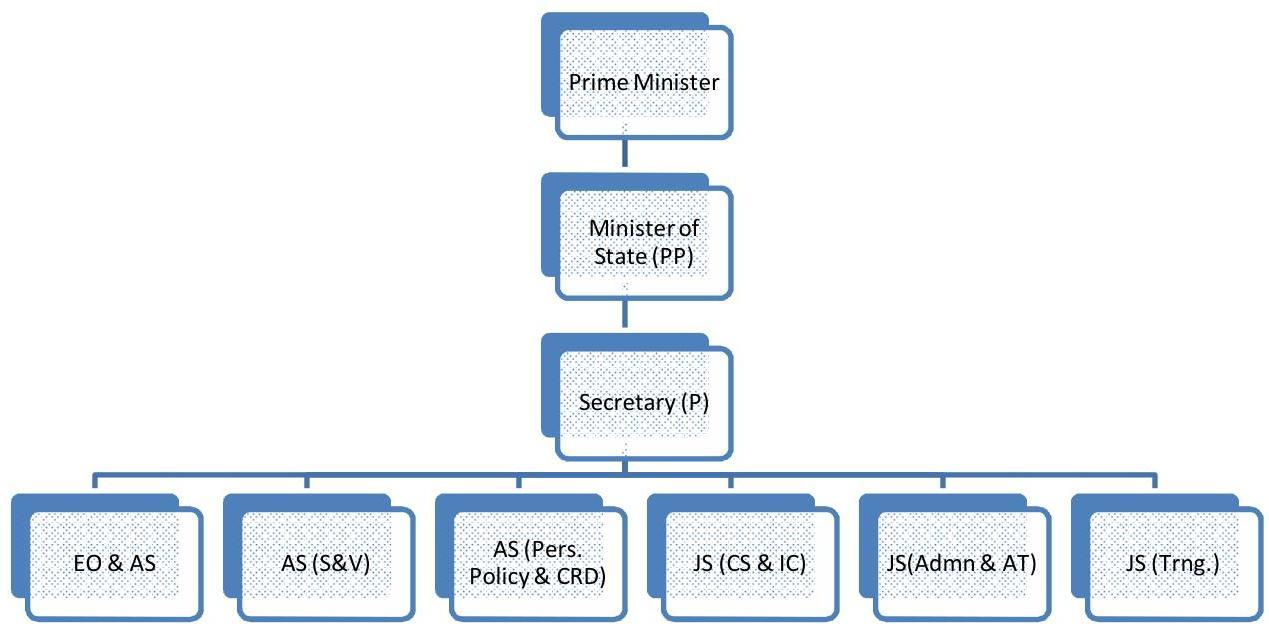
| Abbreviations Used in the Organization Chart | |
|---|---|
| ACC | Appointments Committee of Cabinet |
| AVD | Administrative Vigilance Division |
| ADMIN | Administration |
| AIS | All India Services |
| AS | Additional Secretary |
| B&A | Budget \& Accounts |
| CS | Central Secretariat |
| CPC | Central Pay Commission |
| CRD | Cadre Review Division |
| CWO | Chief Welfare Officer |
| DFFT | Domestic Funding of Foreign Training |
| DS | Deputy Secretary |
| DIR | Director |
| E | Establishment |
| EO | Establishment Officer |
| IR | Information Rights |
| JS | Joint Secretary |
| JCA | Joint Consultative Machinery and Arbitration |
| LTTP | Long Term Training Programme |
| L\&A | Leave and Allowances |
| MOS | Minister of State |
| MM | Middle Management |
| PR | Personal Records |
| PIIA | Pathways for an Inclusive India Administration |
| PESB | Public Enterprises Selection Board |
| PP | Personnel \& Pension |
| RES | Reservation |
| R\&R and DC | Redeployments \& Retraining and Departmental Council |
| S\&V | Services \& Vigilance |
| S | Services |
| SM | Senior Management |
| SR | State Reorganization |
| TRG | Training |
| V | Vigilance |
Training Policy and Programmes (Chapter 7)
1.6 The Department is the nodal Department to impart training to the government functionaries. The Training Wing of the Department formulates policies and implements its training programmes by identifying areas of training, designing training programmes, development of trainers and training capabilities and administering policies in training. Major training activities undertaken during the year are (i) In-service training of AIS/CSS/CSSS officers; (ii) Mid-Career Training of IAS Officers; (iii) Overseas (Foreign) Training Programmes; (iv) Post Graduate Programmes in Public Policy/Sustainable Development/Management; (v) State Category Training Programmes (SCTP); (vi) Trainer Development Programmes (TDP); (vii) Comprehensive Online Modified Modules for Induction Training (COMMIT); (viii) e-governance initiatives;(ix) Integrated Government Online Training Programme (i-GOT); and (x) National Programme for Civil Services Capacity Building (NPCSCB)- Mission Karmayogi.
Training Institutions (Chapter 8)
1.7 Lal Bahadur Shastri National Academy of Administration (LBSNAA), Mussourie, Uttarakhand and Institute of Secretariat Training and Management (ISTM), New Delhi are two premier training institutions, attached to this Department. These institutions cater to the needs of human resource development by imparting training to all officers of Central Government and AIS at regular intervals for their career progression. The Department also supports the Indian Institute of Public Administration (IIPA), an autonomous organization, in undertaking advance training programmes for administrators as well as researchers on issues relating to public administration.
Mission Karmayogi & e-HRMS (Chapter 9)
1.8.1 National Programme for Civil Services Capacity Building (NPCSCB) – Mission Karmayogi is being implemented with the goal of systematically imparting behavioral and functional competencies needed by a government official to best discharge their assigned roles and aims to effect a signal shift in competency driven training and Human Resource (HR) management of officials, by transitioning from a ‘rule-based’ system to the ‘role-based’ system.
1.8.2 Through the adoption of modern technological tools such as a digital platform – the integrated Government online Training (iGoT) portal – https://igotkarmayogi.gov.in/ and with effective harnessing of artificial Intelligence, machine learning and data analytics, Mission Karmayogi endeavors to break silos in capacity development and democratize knowledge on an equitable basis across civil services, by bringing easy access to world class continuous learning opportunities for all government officials.
1.8.3 The NPCSCB facilitates data-driven decisions for training and personnel management through the electronic Human Resources Management System (e-HRMS), which has now been revamped as eHRMS2.0 and also integrated with the iGOT portal. This helps the Government to digitally manage the service matters of officials leading to reduction in transaction time and cost, availability of digital records, dashboards for MIS, real time monitoring of manpower deployment as well as serving as a productivity enhancement tool amongst others.
Administrative Vigilance Division (Chapter 10)
1.9 The Department is the nodal agency responsible for the formulation and implementation of vigilance and anti-corruption policies of the Government. Administrative Vigilance Wing in the Department oversees government programme for maintenance of discipline and eradication of corruption from public service. The Central Vigilance Commission (CVC) advises the Central Government on all vigilance matters. The jurisdiction of the Commission extends to all the organisations to which the executive powers of the Union of India extend.
International Cooperation (Chapter 11)
1.10 The Department of Personnel and Training is the nodal Department for formation of policies for anti-corruption in Government of India. To deal with international cooperation on these aspects an International Cooperation Cell was created in this Department. The primary tasks of this Cell emanate from the follow up to the ratification of the United Nations Convention Against Corruption (UNCAC) and the other consequential international collaborative efforts, on global platforms. This Cell acts in conjunction with specialized agencies like the Central Bureau of Investigation, the Enforcement Directorate and the other line Ministries entrusted with the specific ancillary tasks within their respective administrative domain, viz. corporate governance, extradition matters, prevention of money laundering, mutual legal assistance treaties etc.
Central Bureau of Investigation (Chapter 12)
1.11 Central Bureau of Investigation (CBI) was set up by the Government of India by a Resolution dated April 1, 1963, to not only investigate cases of bribery and corruption but also the cases of violation of central fiscal laws, major frauds relating to Government of India Departments, Public Joint Stock Companies, passport frauds and serious crimes committed by organized gangs and professional criminals. CBI was further strengthened by the addition of Economic Offences Wing by the Government of India by Resolution dated February 2, 1964.
Joint Consultative Machinery (Chapter 13)
1.12 The Government provides for a Joint Consultative Machinery for joint consultation at three levels between the Central Government and its employees for promoting harmonious relations and securing the optimum level of co-operation between the Central Government and its employees in matters of common concern. The objective is to increase the efficiency of public services along with the well-being of the employees. The three tiers are:
a) National Council – at the apex level, functioning under the Department of Personnel and Training.
b) Department Councils – functioning at the level of the Ministries / Departments.
c) Office Councils – functioning at offices/organisations under various Ministries / Departments.
The Scheme has proved to be an effective forum for amicable settlement of grievances of the Central Government employees relating to their service matters etc.
Administrative Tribunal (Chapter 14)
1.13 In order to provide speedy and inexpensive justice delivery system to the employees who feel aggrieved by Government decisions, the Government set up the Central Administrative Tribunal (CAT) in 1985, which now deals with all cases relating to service matters. The CAT has 19 regular benches, 17 of which operate at the Principal seats of High Courts and the remaining two are at Jaipur and Lucknow.
Staff Welfare (Chapter 15)
1.14 The Central Government being the largest single employer in the country discharges its responsibility for looking after the welfare of employees through various welfare measures. The Department also extends support to various staff welfare measures. The DoPT is the nodal Department for registered societies set up for the welfare of the Government employees and their families. In addition, the Department lays down policies for Departmental Canteens and supports the Resident Welfare Associations.
Right to Information (Chapter 16)
1.15 The Department has brought out a comprehensive law to ensure the right to information to the citizens of India in almost entire matters of governance at all levels from the Central Government to the local self-government. The Law (RTI Act, 2005) has provided a mechanism where the Central Information Commission, being the apex body at the Centre, facilitates its citizenry in accessing information in a time-bound, hassle-free and affordable manner.
Grievance Redressal Mechanism & Citizens’ Charter (Chapter 17)
1.16 The Department has identified some of the core services being offered by its various divisions and their standards for the purpose in its first Citizen Charter. This has been undertaken by a Task Force in consultation with the Stakeholders. While identifying the services the focus has been on measurable and verifiable services and their standards. The charter contains a Grievance Redress Mechanism related to the services mentioned in the Citizens’/Clients’ Charter. The Charter also provides links for other grievances which are not related to the Citizens’/Clients’ Charter. Timelines have been prescribed for final disposal of the complaint arising out of the Citizens’/Client’s Charter.
Progressive Use of Hindi (Chapter 18)
1.17 The Department is fully committed to promoting the use of Hindi as the official language, in official matters and motivate compliance of the provisions of the Official Language Act, 1963, and the rules framed there under. The Department also ensures that the spirit of various orders and guidelines issued by the Department of Official Language is appropriately enforced for implementation of the official language policy of the Union. The Department has an Official Language Division which monitors the implementation of the Official Language policy in the Department.
Financial Management (Chapter 19)
1.18 In order to promote the various programmes administered by Ministry of Personnel, Public Grievances and Pensions, an allocation of Rs. 149.00 crore was made in the Central Sector Scheme Outlay for the year 2021-22 against the total allocation of Rs. 1950.00 crore at the Revised Estimate 2021-22 stage. The corresponding figures for RE 2022-23 are Rs. 229.25 crore as Central Sector Scheme Outlay against a total allocation of Rs. 2320.37 crore (RE 2022-23). The requirements and priorities of its attached and subordinate offices were kept in view while making budgetary allocation to them by this Department. One C\&AG Para is pending in r/o D/o ARPG
YOGA TRANING SESSION AT NORTH BLOCK MAY- JUNE 22 yoga at workplace
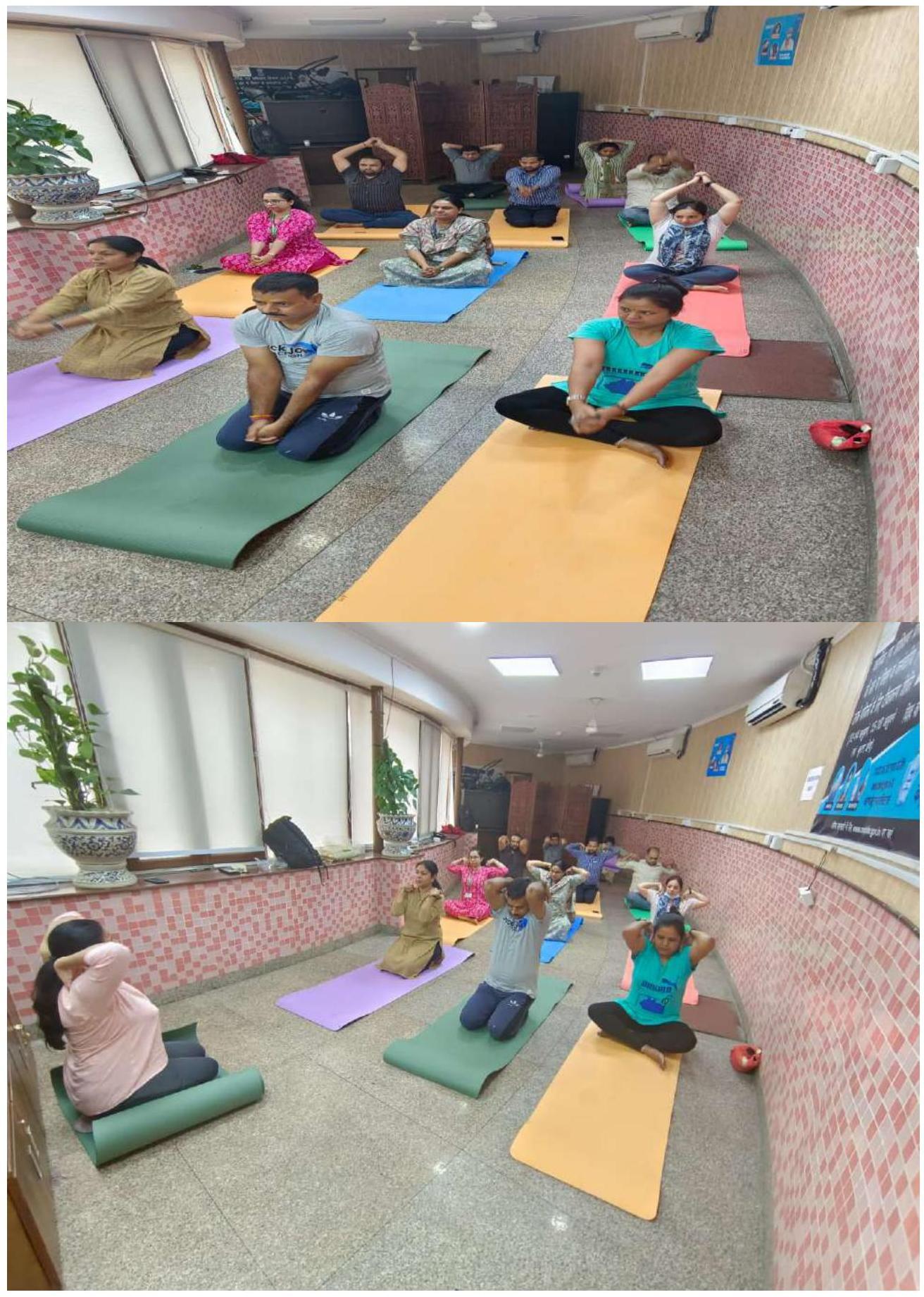
SWACHTA SHAPATH
2.1 “Swachta Hi Seva” On the day of Swachata Pakhwada, today the officer and employees of the department took oath related to cleanliness under the chairmanship of Additional Secretary Administration.
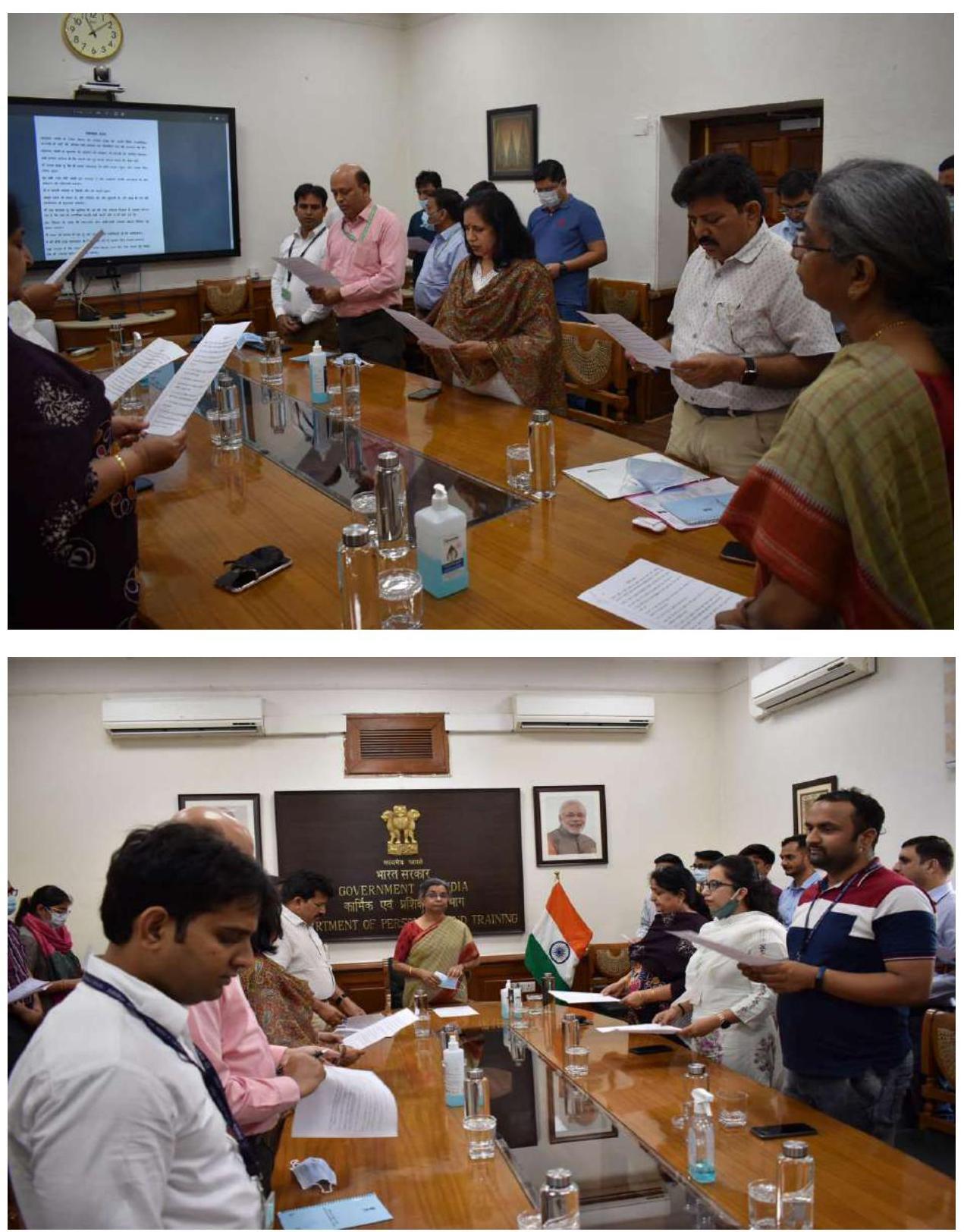
ANTI TERRORSIM DAY 21 MAY 2022
2.2 On the occasion of Anti Terrorism Day, Rashmi Chaudhary (Additional Secretary) lead the pledge taking by employees of Department of Personnel and Training (DoPT), Government of India
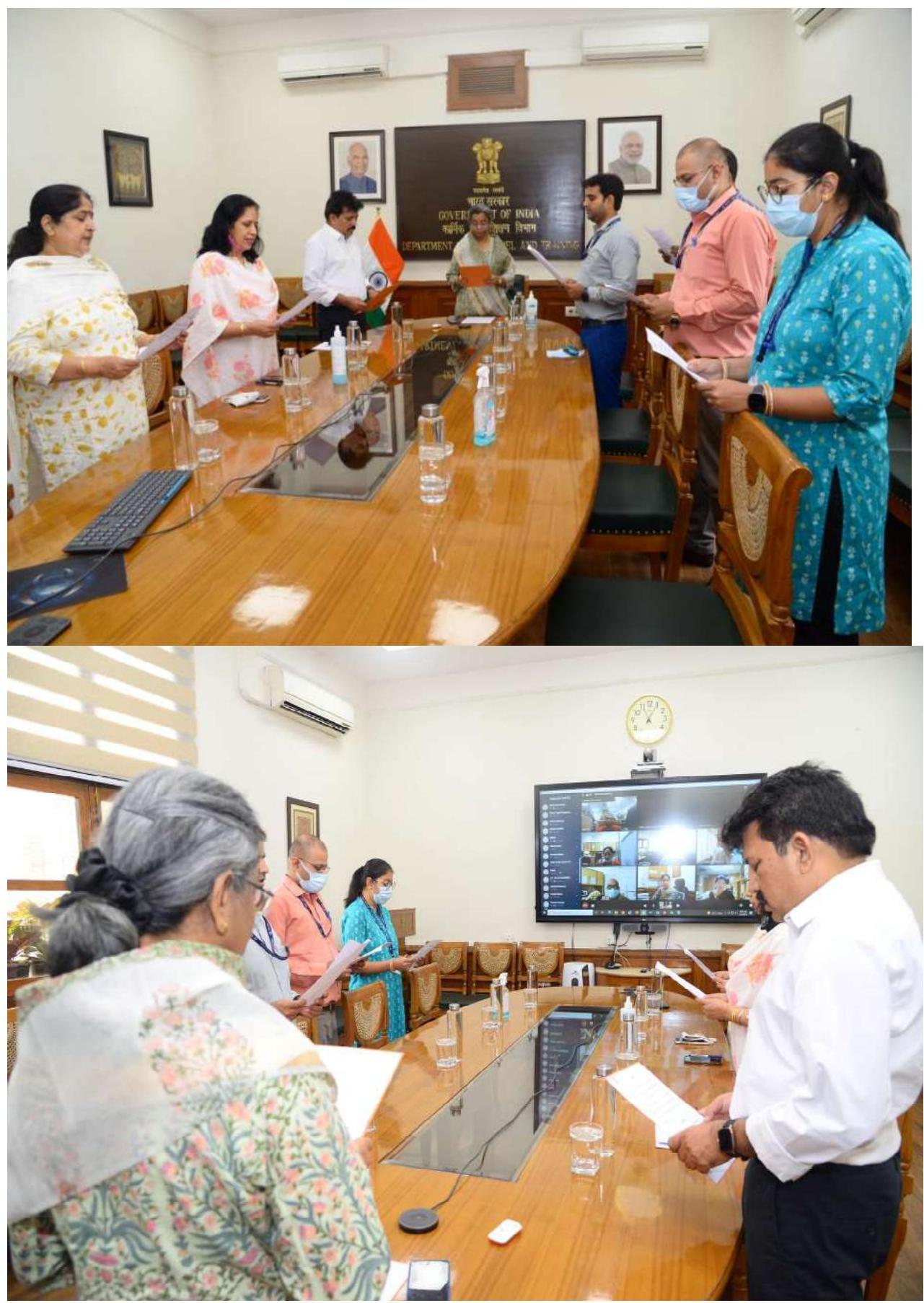
$\square$
2.3 “Yoga guarantees wellness as well as fitness. It is not merely an exercise but a way to attain peace through physical, mental and spiritual wellbeing
Celebrating the $8^{\text {th }}$ International Day of Yoga Dopt observed Yoga Day Celebration at North Block, New Delhi on 21 June, 2022
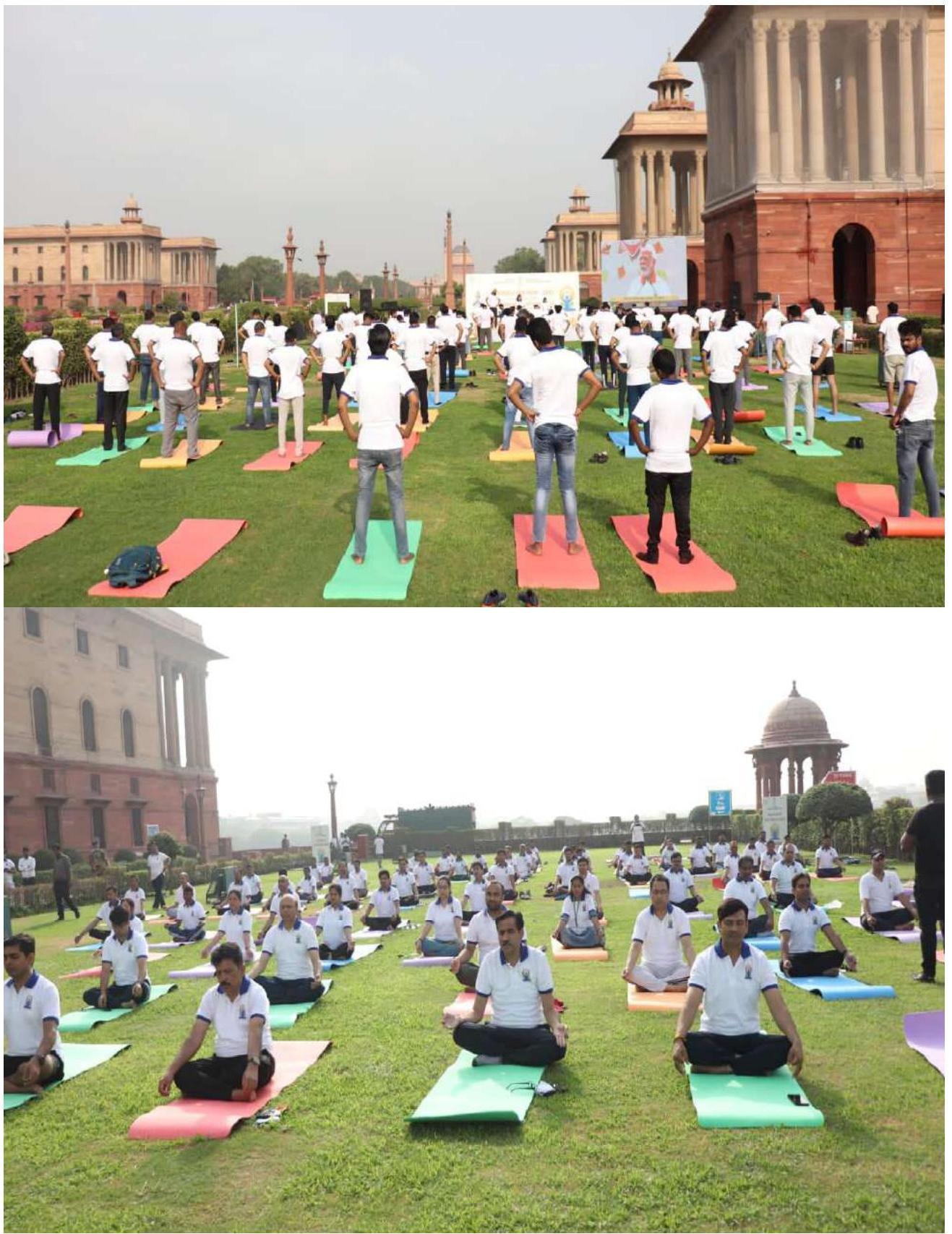
COUNTDOWN PROGRAME IN OBSERVANCE OF IDY 2022 ON 28 MAY
2.4 On the occasion of 24 days left for International Yoga day 2022, a special session was organized by the Department of Personnel and Training to increase the awareness of Yoga, in which the entire team of Dopt participated with full enthusiasm.
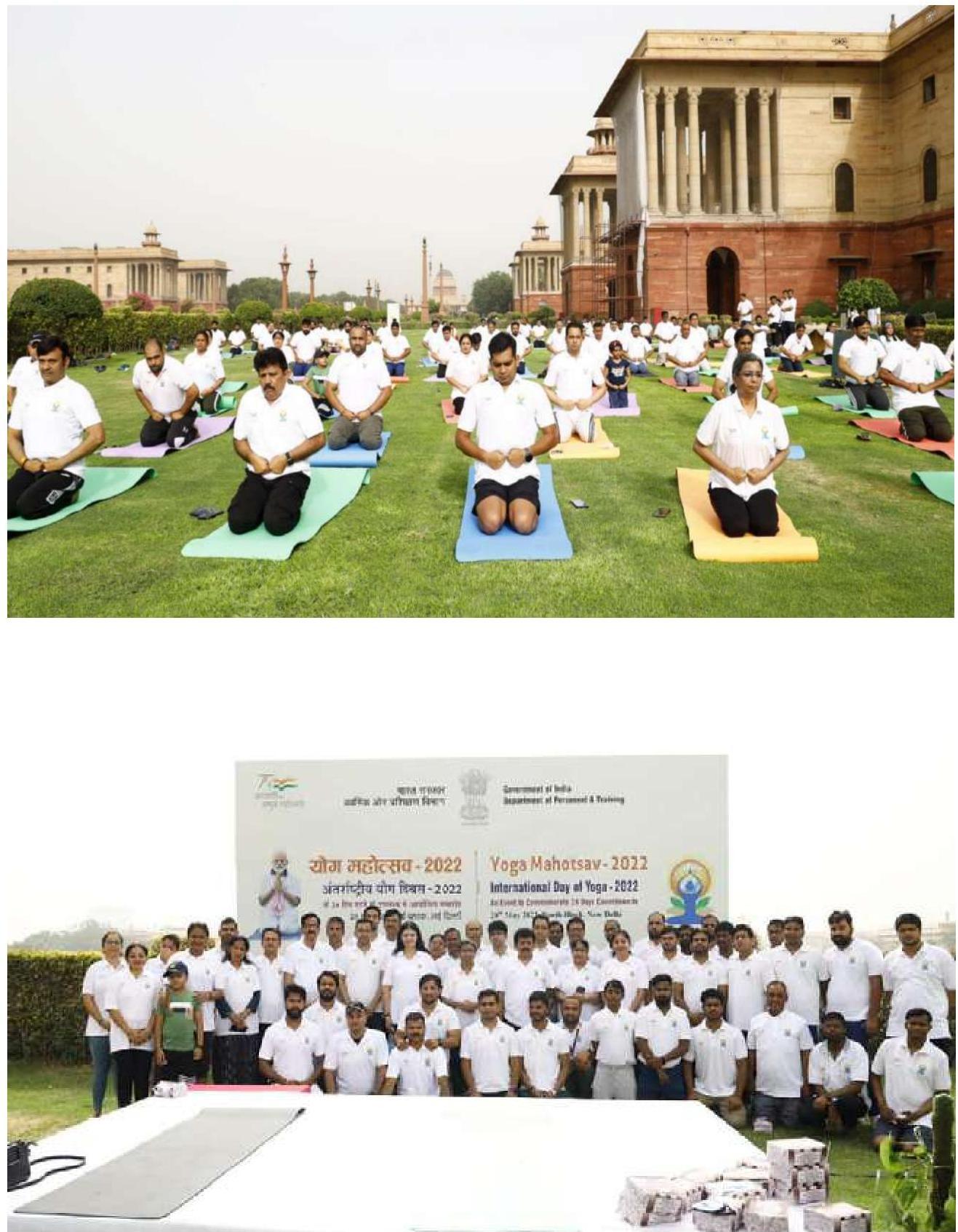
YOGA POSTER MAKING COMPETETION
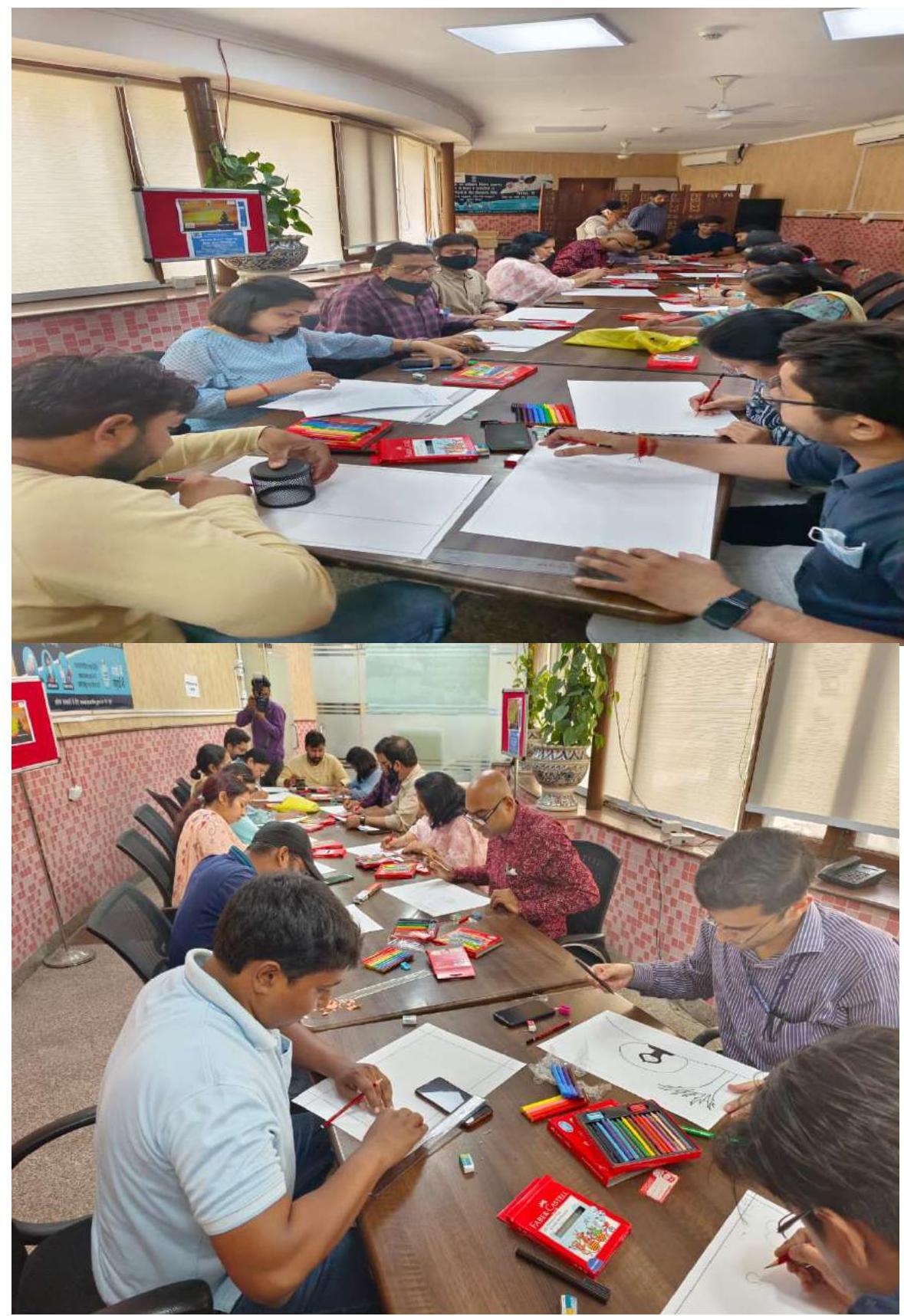
2.5 #DoPT organized a Blood Donation Camp at North Block, New Delhi in collaboration with Indian Red Cross Society today.
Hon’ble MoS (PP) Dr Jitendra Singh appreciated the efforts of employees as well as the medical team involved in the programme.
Team DoPT enthusiastically participated in this noble cause.
More than 75 employees donated their blood.
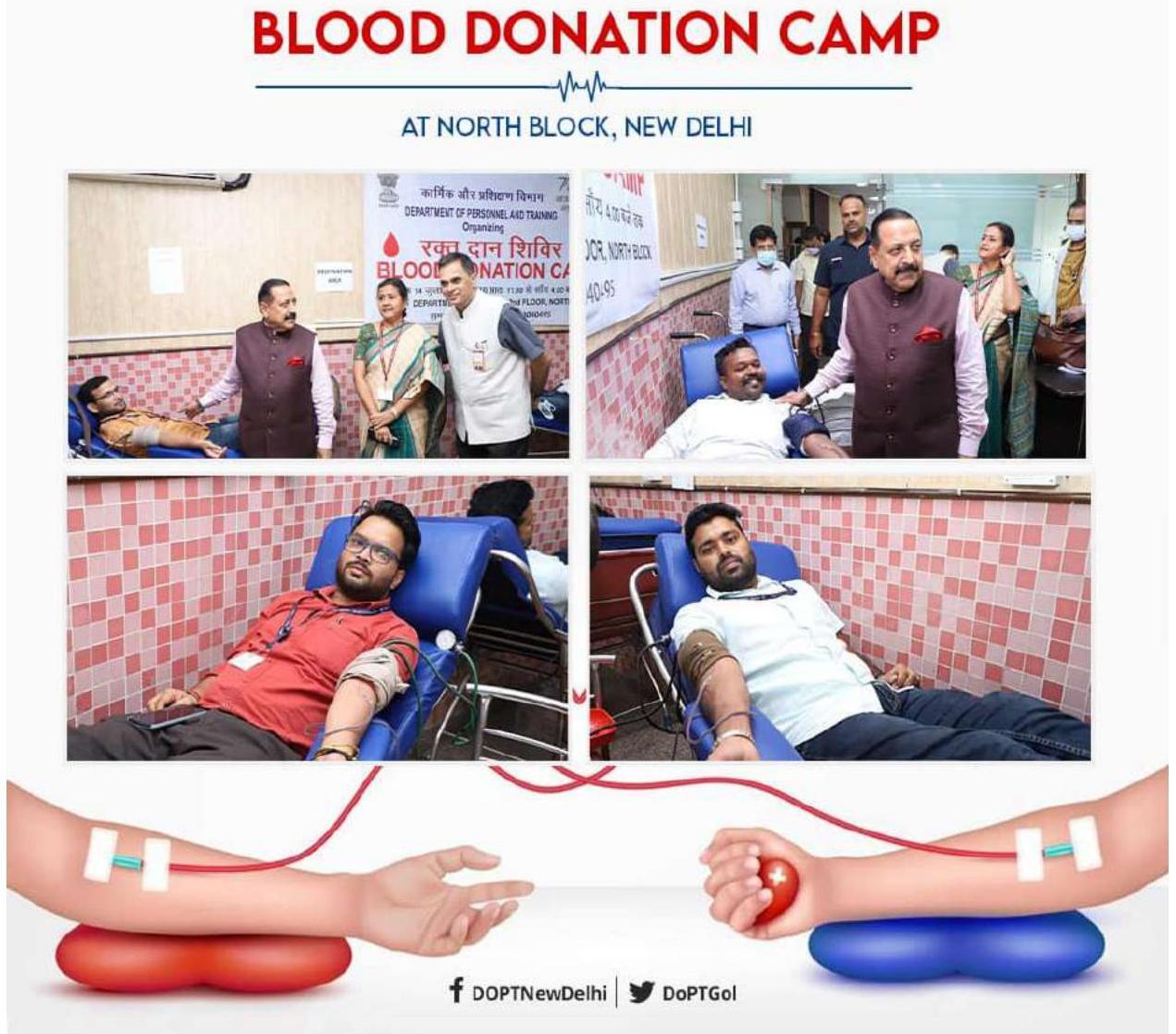
2.6 The battle against COVID-19 is still ON!
Bolstering the fight against COVID-19 & raising awareness on the importance of ‘Precaution Dose’, #DoPT organized a free COVID-19 Precaution Dose camp at North Block, New Delhi on 19th July and 20th July, 2022.
Hon’ble MoS(PP) Dr Jitendra Singh Joined the event \& encouraged the Medical Staff and officers
More than 225 employees/dependents have received vaccination upto this moment
This initiative is part of the efforts under #AmritMahotsav to provide free COVID-19 Precaution Dose for the 18-59 age group at Government Centres from 15th July 2022 till the next 75 days.
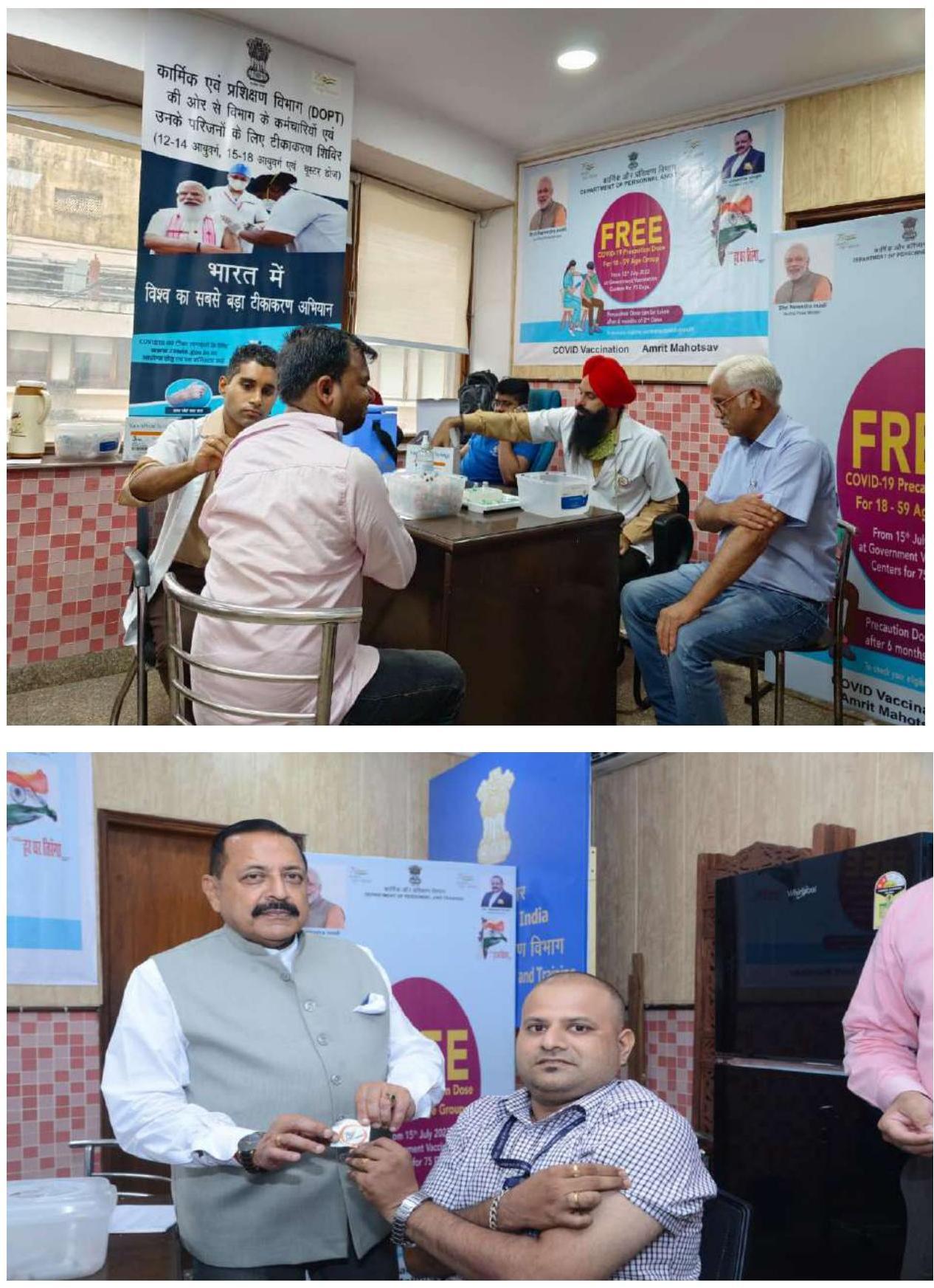
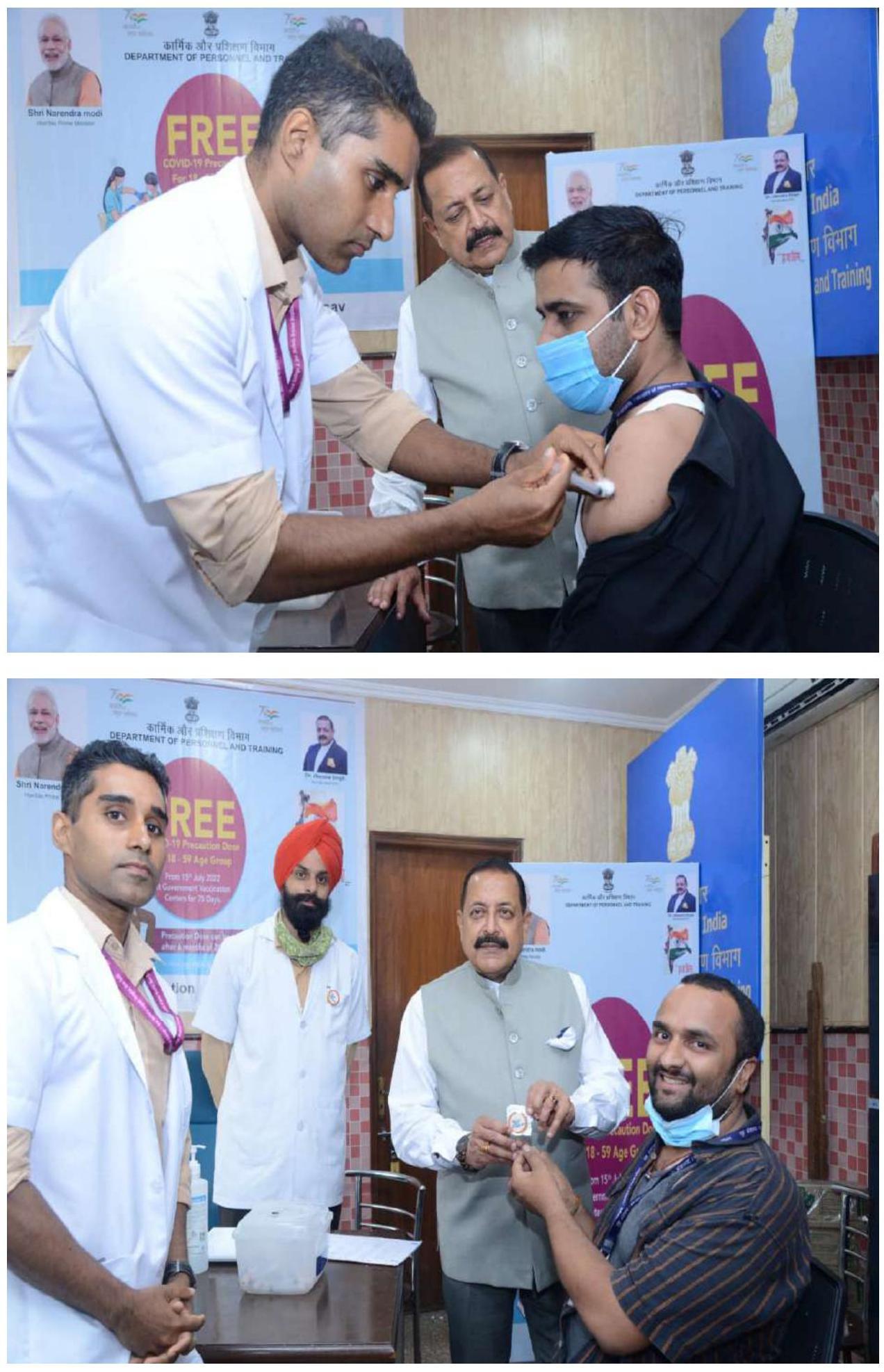
$\qquad$
2.7 Mera Tirangaa Mera Abhimaan
Team DOPT proudly further the #HarGharTiranga campaign on the occasion of $75^{\text {th }}$ #independence day
May our nation keep pacing ahead towards prosperity.
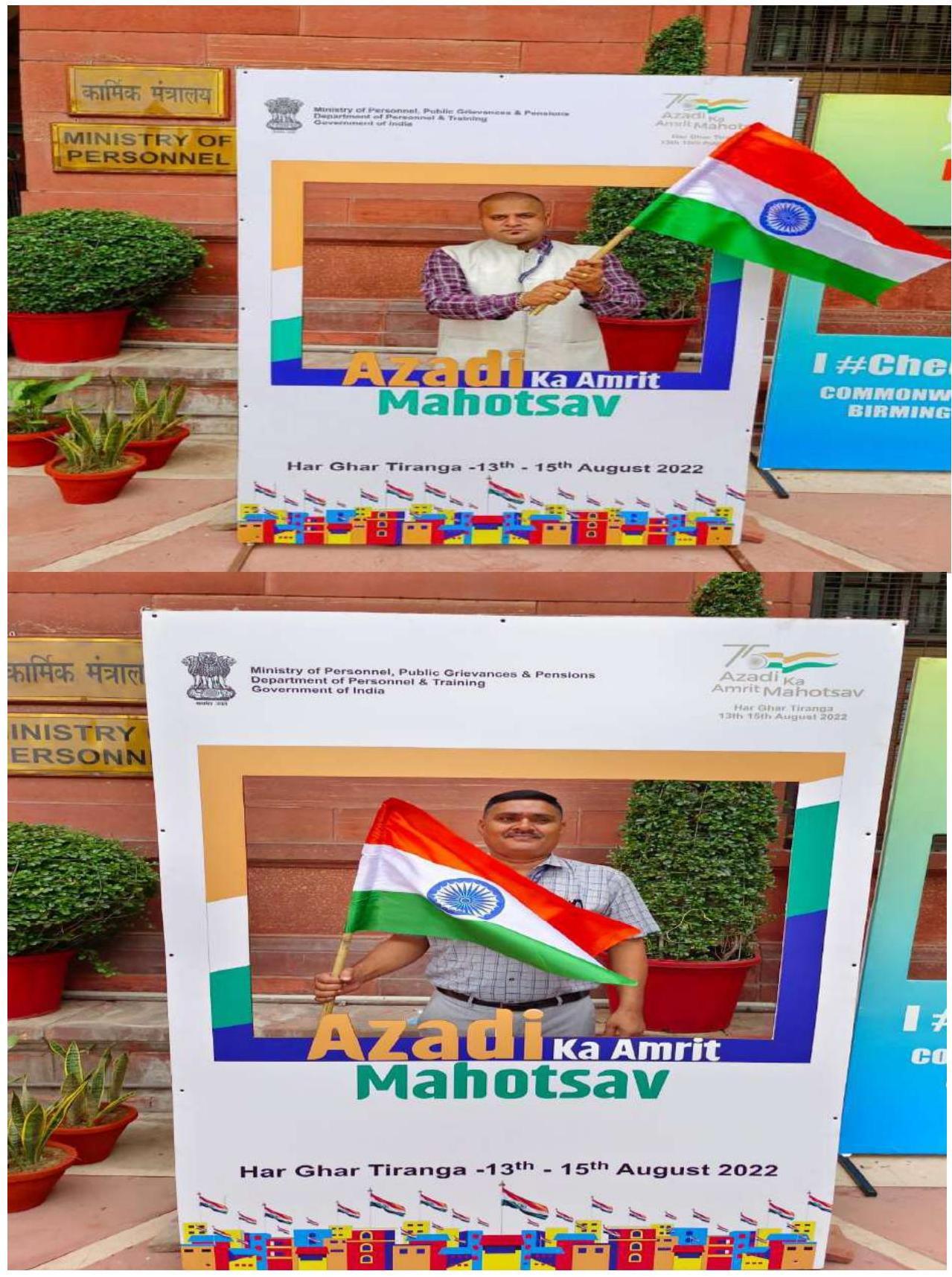
RASHTRIYA EKTA DIWAS
2.8 Humble tributes to India’s Iron Man, Sardar Vallabhbhai Patel on his Birth Anniversary.
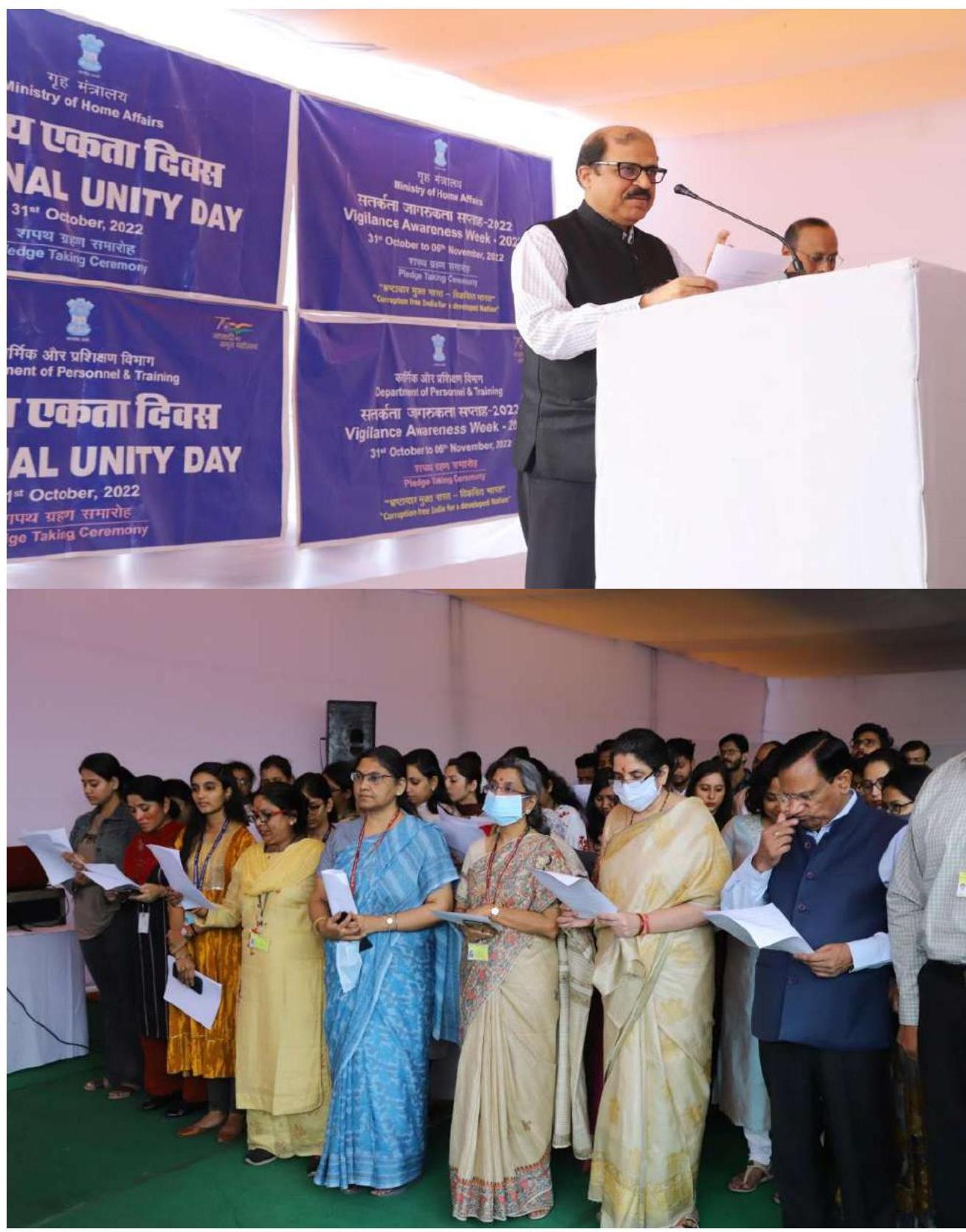
2.9 A two-day inter-ministerial cricket selection competition was organized on November 16 and 17, 2022 at Vinay Marg with the aim of creating awareness about fitness among the employees in the three departments and related offices of Ministry of Personnel, P.G. & Pensions.
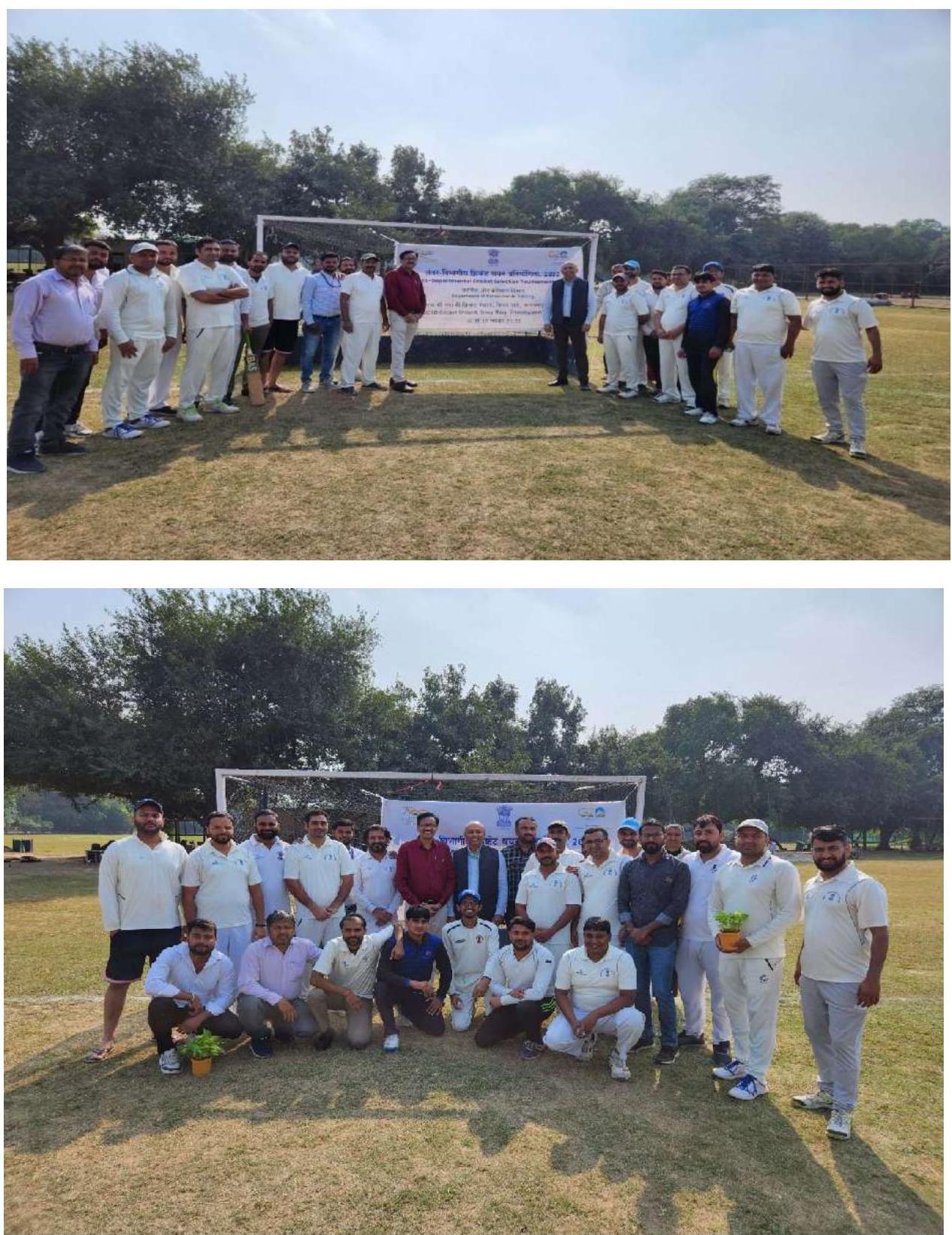
2.10 Greetings to everyone on the occasion of #ConstitutionDay.
We salute those Extraordinary Individuals who kept working to frame our Indian Constitution for the prosperity of our country.
Let us always cherish the ideals of Liberty, Equality & Fraternity.
#SamvidhanDivas
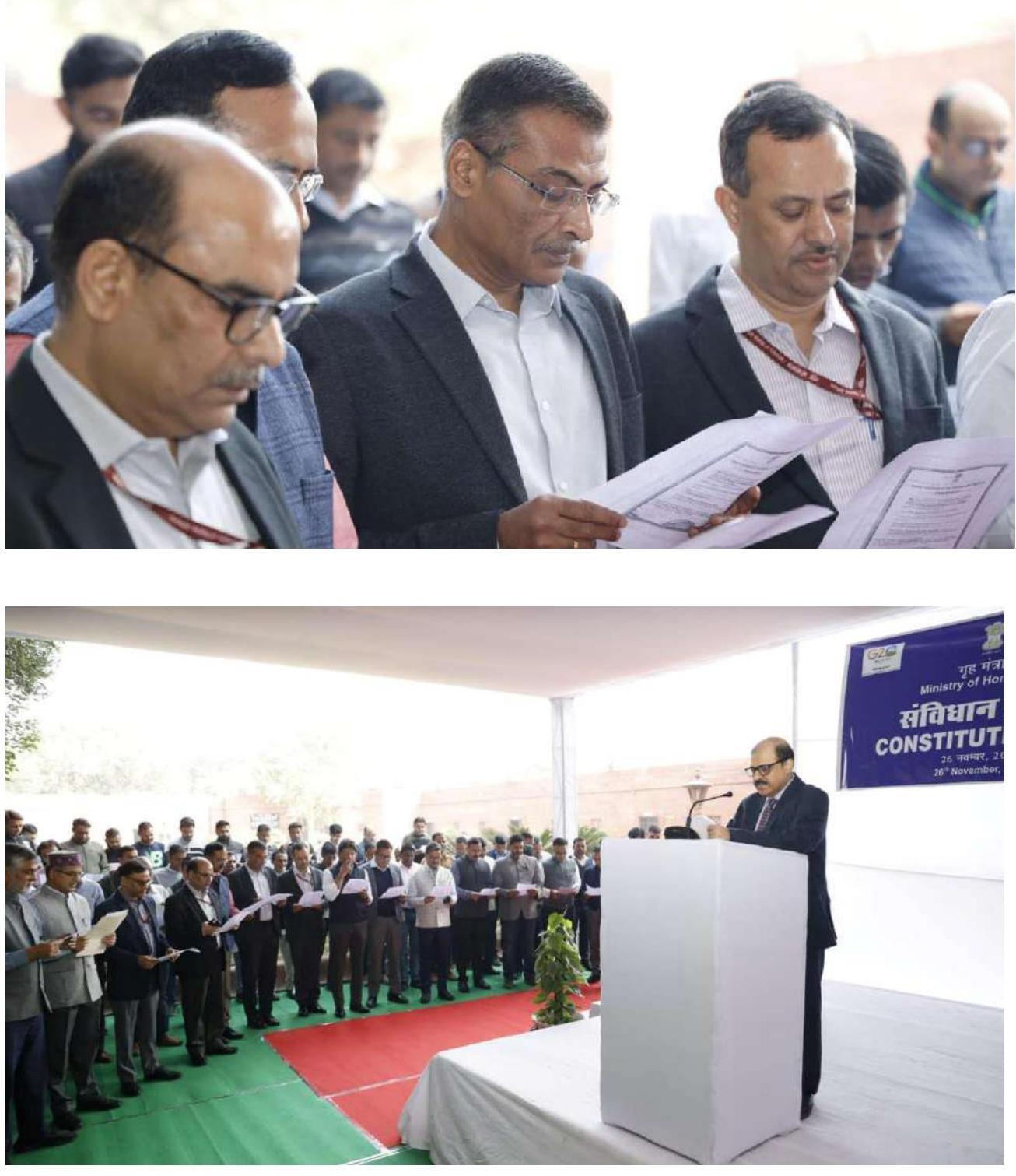
CONSTITION DAY QUIZ AND ESSAY COMPETETTION
2.11 Commemorating the celebrations of constitution Day, Team DOPT took part in an essay competition at North Block, New Delhi. A quiz competition was also held on Indian Constitution for the officials.
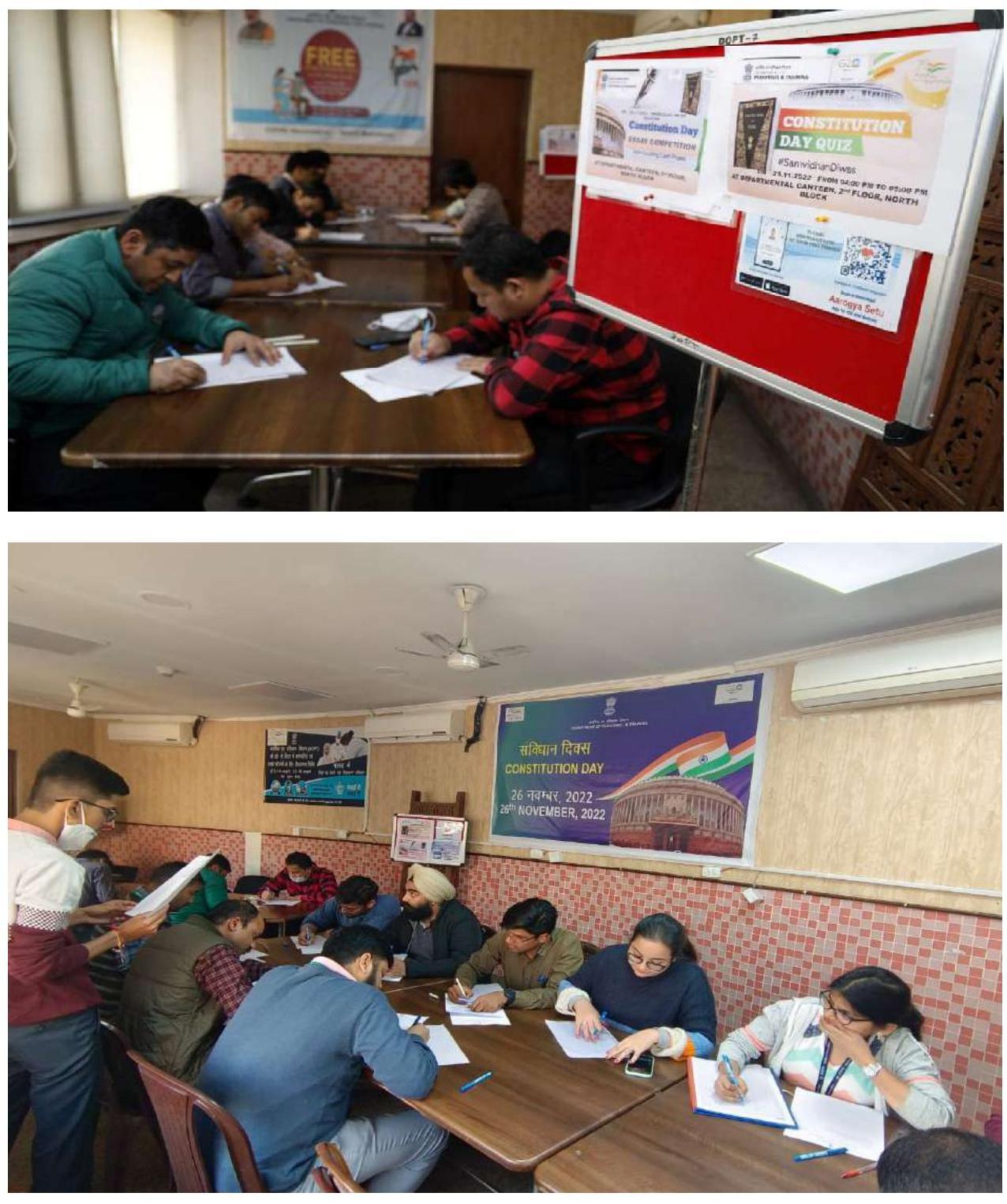
2.12 Salute Our Armed Forces
Team Dopt took part in the noble initiative of raising voluntary donations at the North Block, New Delhi
The money contributed by the Central Officers would go to the families of our Departed Soldiers.
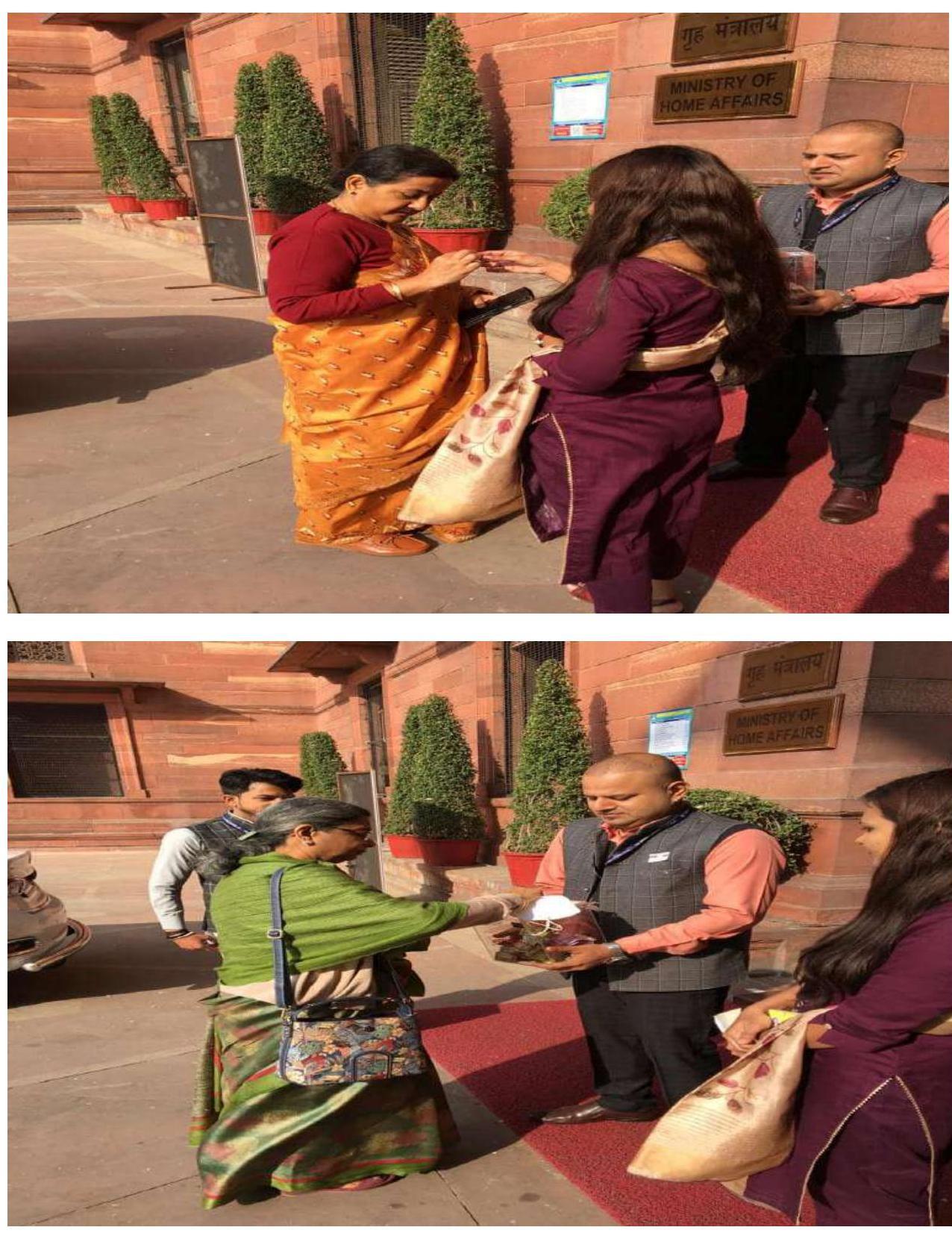
2.13 The Special Purpose Vehicle (SPV), Karmayogi incorporated on 31.01.2022 under Section 8 of the Companies Act, 2013 as a 100% Government owned not for profit Company to own and manage the iGOT Karmayogi platform and any other digital assets pertaining to the NPCSCB started functioning from July 2022 with the appointment of its CEO and the Board of Directors.
2.14 iGOT Mobile Application launched on 25.12.2022 by Dr. Jitendra Singh, Hon’ble Minister of State for Personnel, Public Grievances and Pensions as a further step in fulfilling the vision of Mission Karmayogi of anytime anywhere anytime learning.
2.15 A new revamped version of the electronic Human Resource Management System (e-HRMS) software – e-HRMS 2.0 was launched on 25.12.2022 by the Hon’ble Minister of State for Personnel, Pensions and Public Grievances. The e-HRMS 2.0 is AI enabled and envisaged to have bespoke prompts for career path and progression based on Employees’ competence & profile. It is also equipped to use data analytics tools through dynamic Dashboards, to facilitate better monitoring and policy making. The portal is envisaged to provide transparent, accurate and speedy services to employee, employer and policy makers.
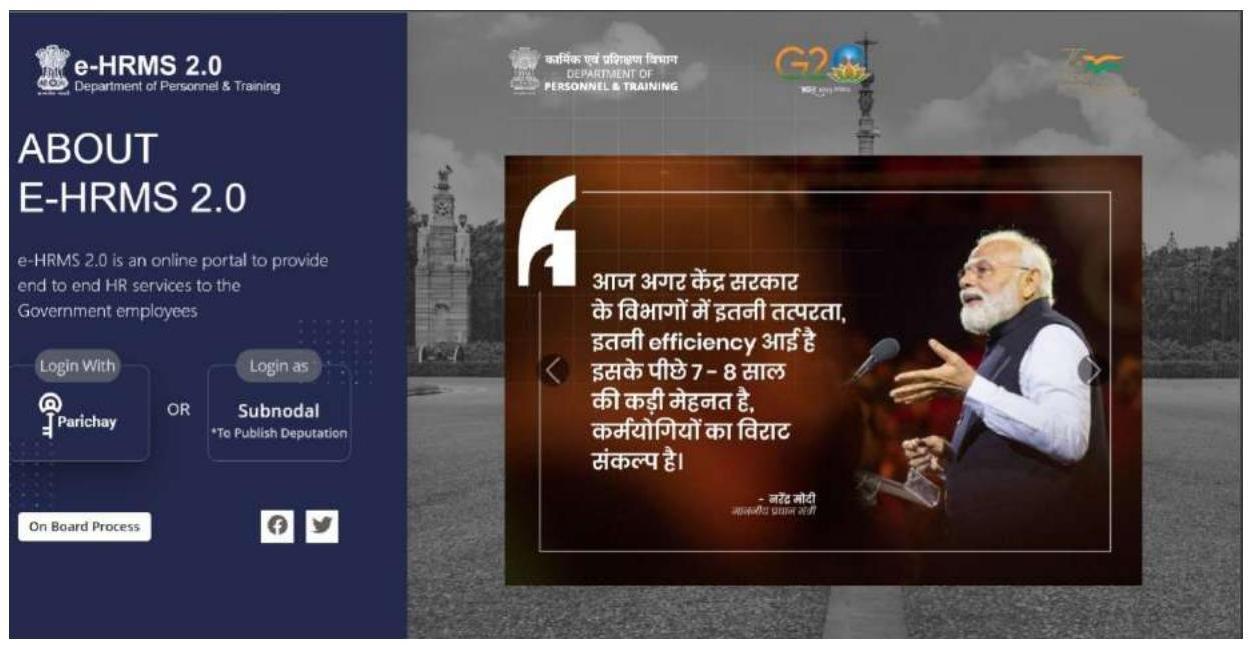
eHRMS 2.0 HR Services portal for Government Employees
Smart Performance Appraisal Report Recording Window (SPARROW):
2.16 SPARROW is an online system based on the comprehensive performance appraisal dossier maintained for IAS officers. The system aims at bringing greater transparency in the recording of performance appraisals of the officers, eliminating loss of Performance Appraisal Reports (PARs) during transition, ensuring better monitoring and timely completion of PARs and providing easy and real time access to the PARs by authorized stakeholders. This system is not only user friendly but can be accessed uninterruptedly through an internet enabled computer system from anywhere, anytime, which reduces the delays in processing of PARs by officers concerned. The system was launched with effect from 01.04.2014 and was initially linked to the intra-IAS database enabling the PAR form to be pre-populated with the existing information. Subsequently the responsibility to update the requisite details in respect of officers was passed on to the Employee Master Data (EMD) manager of the respective Ministry or Department / State Cadre. In order to make the system
hassle-free and more user-friendly, the system has been enabled with e Sign (electronic Signature), an Aadhaar based authentication service.
2.17 For ensuring recording of PAR in a timely manner by all the authorities, autoforwarding of PARs has been implemented vide AIS (PAR) Amendment Rules, 2019.
2.18 As on 31.12.2022, the total number of the electronically generated PARs for the Assessment Year 2021-22 is 9581 and that of 2022-23, as on 16.01.2023 is 722.
Immovable Property Returns (IPR) Module
2.19 As per Rule 16(2) of AIS (Conduct) Rules, 1968, IAS officers are required to submit IPRs every year as on $1^{\text {st }}$ January and latest by $31^{\text {st }}$ January of the year, in respect of the preceding year. Since the year 2011, the IPRs of the officers are being uploaded on the Department’s website. Subsequently, an IPR Module has been introduced for filing the IPRs online by the officers w.e.f. 1.1.2017, the navigation tab of which has been provided in the menu on Home Page of SPARROW. The officers can access the Module by using the login ID and password, which are already provided to them for accessing the SPARROW and after filing the return, they are required to authenticate it by using either DSC or eSign. SPARROW is now available to other services also.
CHAPTER 3
PERSONNEL POLICIES
- Matters relating to framing and amendment of recruitment rules/service rules for Group “A” and “B” posts
- Framing of policy relating to the procedure for Departmental Promotion Committee(s)
- Policy on seniority
- General policy matters relating to:-
(a) Flexible complementing scheme,
(b) Modified Assured Career Progression Scheme,
(c) Lateral entry in Central Government,
(d) Leave travel concession,
(e) Deputation,
(f) Leave,
(g) Pay & allowances,
(h) Holiday policy,
(i) Age relaxation and
(j) Other matters concerning service conditions. - Administration of UPSC and SSC including exams except for the Civil Service Examination
- Policy matters of PESB
- Policy on Character verification before an appointment
- Disagreement cases with UPSC from various Ministries except on appointment cases
- UPSC (Exemption from Consultation) Regulations
- Policy on APAR.
- Commercial employment after retirement
- Policy on
(a) Retirement, extension, re-employment,
(b) Posting and transfers, Conduct and CCA Rules,
(c) Sealed Cover procedure,
(d) Status of Women in Central Government,
(e) Temporary Service Rules, etc.
(f) Lien, Probation, Confirmation,
(g) Daily Wage Casual Labourers
Establishment A-III Section
3.0 Master OM on Sealed Cover Procedure.
Instructions on Sealed Cover Procedure have been consolidated vide DoPT OM No. 1667551707825 dated 30.08.2022.
3.1 Master OM on Sanction for holding elective office by a Government servant.
Instructions on Sanction for holding elective office by a Government servant have been consolidated vide DoPT OM No. 1668163505583 dated 31.08.2022.
3.2 Master OM on Observance of proper procedure in official dealings between Administration and MPs and State Legislatures.
Instructions Observance of proper procedure in official dealings between Administration and MPs and State Legislatures have been consolidated vide DoPT OM No. 1667559842019 dated 13.09.2022.
3.3 Master OM on Representation from Government servants on service matters.
Instructions on Representation from Government servants on service matters have been consolidated vide DoPT OM No. 1667545596919 dated 23.09.2022.
3.4 Master OM on Prevention of Sexual Harassment of working women at workplace.
Instructions on Prevention of Sexual Harassment of working women at workplace have been consolidated vide DoPT OM No. 1667566576557 dated 04.11.2022.
3.5 Master OM on Suspension.
Instructions on Suspension have been consolidated vide DoPT OM No. 1667564457999 dated 04.11.2022.
3.6 Master OM on Disciplinary Jurisdiction of CAT/Election Commission of India.
Instructions on Disciplinary Jurisdiction of CAT/Election Commission of India have been consolidated vide DoPT OM No. 1669276191264 dated 24.11.2022.
3.7 Master OM on Sharing of Advice of UPSC with the Charged Officer.
Instructions on Sharing of Advice of UPSC with the Charged Officer have been consolidated vide DoPT OM No. 1669704112515 dated 29.11.2022.
3.8 Master OM on Simultaneous action of prosecution and initiation of departmental proceedings.
Instructions on Simultaneous action of prosecution and initiation of departmental proceedings have been consolidated vide DoPT OM NO. 1669703753924 dated 29.11.2022.
3.9 Master OM on Procedural aspects during the course of inquiry under Rule 14 of CCS (CCA) Rules, 1965.
Instructions on Procedural aspects during the course of inquiry under Rule 14 of CCS (CCA) Rules, 1965 have been consolidated vide DoPT OM No. 1673502477928 dated 21.12.2022.
3.10 Amalgamation of Master OMs issued on various subject matters
Subsequently, these Master OMs were amalgamated in the form of a single document and the same has been placed in the public domain on the website of DOPT on 29.03.2023 with the heading “Handling of Disciplinary proceedings in respect of Central Civilian Employees”.
3.11 COVID Vaccination Amrit Mahotsav
With a view to contain the spread of Novel Coronavirus (COVID 19), guidelines/advisories on preventive measures were issued from time to time. In 2022, as a part of celebration of Azadi Ka Amrit Mahotsav, Government of India launched a new initiative ‘Covid Vaccination Amrit Mahotsav’ to provide free precaution dose to all adult eligible population who had completed 6 months (or 26 weeks) from the date of administration of the 2 nd dose. The initiative was implemented at Government Covid Vaccination Centres for 75 days from July 15 to September 30, 2022. This Department vide OM No. 11013/9/2014-Estt. A-III dated 20.07.2022 issued instructions to all the Ministries/Departments for organizing “COVID Vaccination Amrit Mahotsav Camps” at the workplaces for providing Free Covid precaution doses to the eligible employees and their family members.
(DoPT OM No. 11013/9/2014-Estt. A-III dated 20.07.2022 and 28.07.2022)
3.12 Review of Policy of Suspension in the event of non-issuance of Charge Sheet
Vide Gazette Notification No. 11012/04/2016 dated 19.10.2022, a new proviso has been added under Rule 10(7) of CCS (CCA) Rules, 1965 providing therein that in a case where no charge sheet is issued under these rules, the total period under suspension or deemed suspension, as the case may be, including any extended period in terms of sub-rule (6) shall not exceed- (a) two hundred seventy days from the date of order of suspension, if the Government servant is placed under suspension in terms of clause (a) of sub-rule (1); or (b) two years from the date of order of suspension, if the Government servant is placed under suspension in terms of clause (a) or clause (b) of sub-rule (1) as the case may be; or (c) two years from the date the Government servant detained in custody is released or the date on which the fact of his release from detention is intimated to his appointing authority, whichever is later, in the case of deemed suspension under sub-rule (2).”
(Gazette Notification No. 11012/04/2016 dated 19.10.2022)
Establishment A-IV Section
3.13 Instructions on booking of Air Tickets on Government Account in respect of Leave Travel Concession (LTC) – regarding.
In view of the disinvestment of Air India and the consolidated instructions issued consequently by Department of Expenditure vide O.M. No. 19024/03/2021- E.IV dated 16.06.2022, which is also applicable in case of air journey in respect of LTC, it was, interalia, decided that:
i) In all cases of air travel in respect of LTC, air tickets shall be purchased only from the three Authorized Travel Agents (ATAs), namely: (a) M/s Balmer Lawrie & Company Limited (BLCL), (b) M/s Ashok Travels \& Tours (ATT), (c) Indian Railways Catering and Tourism Corporation Ltd. (IRCTC).No agency charges/convenience fees were to be paid to these ATAs.
ii) Government employees are to choose flight having the Best Available Fare on their entitled travel class which is the Cheapest Fare available, preferably for Nonstop flight in a prescribed slot, with provision of optimizing within a $10 %$ price band, for convenience and comfort.
iii) Employees are encouraged to book flight tickets at least 21 days prior to the intended date of travel on LTC, to avail the most competitive fares and minimize burden on the exchequer.
iv) In case of unavoidable circumstances, where the booking of ticket is done from unauthorized travel agent/website, the Financial Advisors of the Ministry/Department and Head of Department not below the rank of Joint Secretary in subordinate/attached offices are authorized to grant relaxation.
- Provisions for Reimbursements and Advance were also made in light of the above.
(Reference DoPT’s O.M. No. 31011/12/2022-Estt.A-IV dated 29.08.2022)
3.14 Central Civil Services (Leave Travel Concession) Rules, 1988 – Relaxation to travel by air to visit North East Region, Jammu & Kashmir, Ladakh and Andaman \& Nicobar – extension beyond 25.09.2022 – regarding.
To boost tourism, the Government has decided to extend the Special Dispensation Concession allowing Government servants to travel by air to North East Region (NER), Union Territory of Jammu and Kashmir (J\&K), Union Territory of Ladakh and Union Territory of Andaman \& Nicobar Islands (A\&N) for a further period of two years, w.e.f. 26 September, 2022 till 25th September, 2024. This concession may be availed in lieu of the Home Town LTC or against Anywhere in India LTC.
[Reference DoPT’s O.M. No. 31011/15/2022-Estt-A-IV dated 11.10.2022]
3.15 Extension of the LTC block year 2018-21 (extended) for a period of three months – regarding.
In relaxation of Rule 10 of the CCS(LTC) Rules, 1988, exercising the powers conferred under Rule 18 – ‘Power to relax’, of the CCS(LTC) Rules, 1988, Government had decided to extend the LTC Block year 2018-2021 (extended) for a period of three months i.e. upto 31st March, 2023.
[Reference DoPT’s O.M. No. 31011/24/2022-Estt-A-IV dated 27.12.2022]
3.16 Central Civil Services (Leave Travel Concession) Rules, 1988 – Fulfilment of procedural requirements.
Government employees are allowed to encash upto 10 days earned leave at the time of availing of LTC to the extent of 60 days during the entire service. It was further clarified that since the leave encashment is limited upto 60 days in the entire service, the denial of encashment of leave would not be appropriate in such cases where the Government employee decides to forgo his claim of reimbursement for travel undertaken on private/hired vehicle or his claim is ‘Nil’, provided that:
(i) A Government employee intimates to the Department his intention to avail of LTC in advance and gets the leave sanctioned as per the prescribed procedure before the journey is undertaken;
(ii) The Government employee has submitted a request for leave encashment before the commencement of the journey;
(iii) The Government employee gives a self-declaration that he has actually travelled to the declared place of visit and is not claiming the fare reimbursement for the entire LTC journey.
[Reference DoPT’s O.M. No. 31011/06/2023-Estt-A-IV dated 29.03.2023]
3.17 Strengthening of Administration by periodical review under FR 56(i): Statutory Body regarding.
As regards applicability of provisions of Fundamental Rules [FR-56(j)] and composition of Representation Committee in respect of statutory bodies, the following provisions were made for the statutory bodies:
(i) Where the Statutory Body have adopted the provisions of FR 56(i), Administrative Ministry may ensure that they are strictly followed;
(ii) Where the Statutory Body have similar provisions in their rule books, the Administrative Ministry may ensure that they are followed in letter and spirit;
(iii) Where no such provisions exist, the Administrative Ministry may ensure that the action is taken to put in place such rules as may be necessary; and
(iv) The composition of the Representation Committee in respect of employees of statutory bodies may be decided with the approval of Minister-in-charge of the Ministry under which the statutory bodies fall.
[Reference DoPT’s O.M. No. 26012/8/2022-Estt-A-IV dated 20.12.2022]
3.18 Superannuation, Extension in service, Re-employment, Premature retirement and Voluntary Retirement from Service (VRS)
Consolidated instructions on Superannuation, Extension in service, Re-employment, Premature retirement and Voluntary Retirement from Service (VRS) was issued vide DoPT’s OM No. 1669894287310 dated 01.12.2022.
[Reference DoPT’s O.M. No. 1669894287310 dated 01.12.2022]
3.19 Framing of transfer policy by all cadres and Posting of husband and wife at the same station
Consolidated instructions on issues of transfer were issued vide DoPT’s OM No. 1669289899529 dated 24.11.2022
[Reference DoPT’s O.M. No. 1669289899529 dated 24.11.2022]
Establishment C Section
3.20 Instructions on the subject of Casual Labourers
Consolidated instructions on the subject of Casual Labourers were issued on 30.09.2022.
3.21 Instructions on the subject of Forwarding of Applications
Consolidated instructions on the subject of Forwarding of Applications was issued vide DoP&T’s OM No. 1669271204071 dated 24.11.2022.
[Reference DoP\&T’s OM No. 1669271204071 dated 24.11.2022]
3.22 Instructions on the subject of Enforcement of Bond
Consolidated instructions on the subject of Enforcement of Bond was issued vide DoP&T’s OM No. 1670563492572 dated 09.12.2022.
[Reference DoP\&T’s OM No. 1670563492572 dated 09.12.2022]
3.23 Instructions on the subject of Technical Resignation and Lien
Consolidated instructions on the subject of Technical Resignation and Lien was issued vide DoP\&T’s OM No. 1669266628362 dated 24.11.2022.
[Reference DoP\&T’s OM No. 1669266628362 dated 24.11.2022]
Establishment (Leave) Section
3.24 Grant of 60 days Special Maternity Leave in case of death of a child soon after birth / stillbirth issued vide OM No. 13018/1/2021-Estt.(L) dated 02.09.2022.
3.25 Updated FAQs dated 30.08.2022 uploaded on the website of DoP\&T in supersession of OM No. 21011/08/2013-Estt.(AL) dated 25.03.2013 and OM No. I-11020/1/2014Estt.(AL) dated 28.04.2015 in respect of the CCS (Leave) Rules, 1972.
3.26 Extension of Special concessions / incentives to the Central Government employees working in Kashmir Valley in attached / subordinate offices or PSUs falling under control of the Central Government for a further period of three years with effect from 01.08.2021 issued vide OM No. A-24011/22/2022-Estt.(Leave) dated 02.09.2022.
Establishment (Allowance) Section
3.27 Consolidated Instructions on Risk Allowance to Central Government employees issued vide O.M. No. A-27018/02/2022-Estt. (AL) dated 02.09.2022.
3.28 Instructions were issued on acceptance of fees by Central Government employees (other than acceptance of fees by Medical Officers in civil employ) vide O.M. No.A37013/01/2018-Estt. (AL) dated 08.09.2022.
3.29 Consolidated Instructions were issued on Central Civil Services (Joining Time) Rules, 1979 uploaded on website on 12.09.2022.
Establishment (Pay) Section
3.30 Pay Division has consolidated instructions on following items and have prepared an information document thereof in order to simplify accessibility of information:
| S1 No. | Subject/Details |
|---|---|
| 1. | Regulation of Terms and Conditions governing Deputation/Foreign Service of employees to/from Central Govt. |
| 2. | Information document on pay fixation. |
| 3. | Information document on pay protection. |
| 4. | Information document on increment. |
| 5. | Consolidated instructions on incentives for participating in sports events. |
| 6. | Information document on grant of incentive for acquiring fresh higher educational qualifications. |
| 7. | Information document on recovery of wrongful/excess payments to Government servants. |
| 8. | Information document on combination of appointments. |
3.31 Pursuant to the Order dated 20.07.2022 passed by Hon’ble Central Administrative Tribunal (CAT), Lucknow Bench, in addition to the instructions laid down in OM No. 18/03/2015-Estt.(Pay-I) dated 2.3.2016 on recovery of wrongful/excess payments made to Government servants, all Ministries/Departments have been advised vide OM of even no. dated 3.10.2022 to exercise extreme caution and take suitable measures while handling pay fixation of their employees as also in other cases involving payments so as to ensure that such lapses/mistakes do not occur. It has further been advised that pay fixation orders issued due to grant of MACP/ACP/financial upgradation/increment/promotion etc. may necessarily be audited by the internal audit and/or the Pay & Accounts Office concerned within 3 months of issuing such orders and in cases where the employee is due to retire within next 4 years, audit of previous pay fixation orders shall be done on priority.
Establishment (RR) Section
3.32 As a major reform measure, the entire process of framing/ amendment of Recruitment Rules (RRs) for Group ‘A’ and ‘B’ posts involving approval of Department of Personnel \& Training, consultation with Union Public Service Commission, vetting of draft Notification by Legislative Department and publication of notification in the Gazette of India, is being automated through the Recruitment Rules Formulation, Amendment Monitoring System (RRFAMS) portal. Resultantly, the earlier system of sending physical files, which often resulted in considerable delay in finalization of recruitment rules, is being replaced by an online mechanism. The RRFAMS portal was formally launched on 25.12.2016 by Hon’ble Minister of State in the Ministry of Personnel, Public Grievances and Pensions.
At present, in the process of framing/ amendment of Recruitment Rules for Group ‘A’ and ‘B’ posts, the modules relating to approval by Department of Personnel \& Training and Union Public Service Commission, have been operationalised on the RRFAMS portal. The system of processing proposals for framing and amendment of RRs in the physical mode has been dispensed with. Once the Legislative Department and Directorate of Printing are also on-boarded the system, the entire process would become fully automated.
To further facilitate user Ministries/ Departments in operation of the RRFAMS portal, a user guide was published in September 2020 on the RRFAMS portal. The launching of RRFAMS portal has significantly improved the timelines for framing the RRs, besides streamlining the process. The average time taken by DoPT for final approval of the draft RRs has been significantly reduced. As on 31.12.2022, over 2500 proposals for framing/ amendment of RRs have been received on the RRFAMS portal, out of which over 1500 proposals have been approved by DoPT.
3.33 Lateral recruitment is an initiative of the Government to achieve the twin objective of bringing in fresh talent as well as augmenting the availability of manpower at middle management levels by appointing persons, at the level of Joint Secretary, Director and Deputy Secretary, for specific assignments keeping in view their specialized knowledge and expertise in their domain area. A total of 36 officers comprising 09 Joint Secretaries, 18 Directors and 09 Deputy Secretaries, appointed through Lateral Recruitment, are in position in various Ministries/ Departments. The list includes 30 officers who were selected during 2021, comprising 3 Joint Secretaries, 18 Directors and 9 Deputy Secretaries.
Establishment D Section:
Inclusion of Sports disciplines in the list of games for recruitment of meritorious sports persons to any post in Group ‘ $C$ ‘ in Ministries/ Department of Government of India regarding.
3.34 As per Office Memorandum No. 14034/1/2013-Estt.(D) dated 3.10.2013 forty three (43) sports disciplines have been identified for appointment of meritorious sportsperson to Group ‘ C ‘ posts. Thereafter 21 New sports disciplines have been included in the existing list of sports discipline for recruitment of meritorious sportsperson to any Group C post in Ministries/Department of Government of India. Now, a new sports discipline “Yogasana” has been added to the list of games for recruitment of meritorious sports persons to any post in Group C in Ministries/Department of Government of India vide this Department’s Office Memorandum No. 14034/1/2013-Estt. (D) Dated 17.06.2022.
Subject wise Consolidation of instructions.
3.35 Instructions on the broad subjects have been consolidated and uploaded on the website of the Department. The consolidations also contain the reference to the respective OMs as Appendix. These subject-wise consolidated OMs would serve as guides without the need for anyone to refer to old OMs issued from time to time on the respective subjects. The consolidated OMs issued during the year 2022-23 are as under:-
(a) Instructions on exemption from passing the Typewriting Test in respect of Lower Division Clerk (LDCs) who do not belong to Central Secretariat Clerical Service (CSCS):-Issued vide Office Memorandum No. DOPT- 1669618325007 dated 28.11.2022. This document is a compilation of all relevant instructions on the subject of “Exemption from passing the Typewriting Test in respect of LDCs who do not belong to Central Secretariat Clerical Service (CSCS)”.
(b) Instructions on Recruitment/Promotion for Sportspersons in Government of India:- Issued vide Office Memorandum No. DOPT-1668767575965 dated 18.11.2022. This document is a compilation of all relevant instructions on the subject of “Recruitment/Promotion for Sportspersons in Government of India”.
(c) Instructions on Promotion scheme for Staff Car Drivers:- Issued vide Office Memorandum No.35011/01/2022-Estt.(D) dated 18.11.2022. This document is a compilation of all relevant instructions on the subject of “Promotion scheme for staff car drivers”.
(d) Instructions on Ad-hoc Appointment/Promotion:-Issued vide Office Memorandum No. DOPT-1667556409102 Dated 02.09.2022. This document is a compilation of all relevant instructions on the subject of “Ad-hoc Appointment/ Promotion”.
(e) Instructions on ACP/MACP Scheme:-Issued vide Office Memorandum No. DOPT1669022409144 dated 21.11.2022. This document is a compilation of all relevant instructions on the subject of “ACP/MACP Scheme”.
(f) Instructions on Appointment on compassionate ground:- Issued vide Office Memorandum No. DOPT- 1667555281194 dated 02.08.2022. This document is a compilation of all relevant instructions on the subject of “Scheme for Compassionate Appointment under Central Government”.
(g) Instructions on Determination of seniority:-Issued vide Office Memorandum No.DOPT-1667564806251 dated 16.09.2022. This document is a compilation of all relevant instructions on the subject of “Determination of ‘Seniority’ of persons appointed to Services and Posts under the Central Government.”
(h) Instructions on Relaxation in upper age limit:- Issued vide Office Memorandum No.DOPT- 1667569393892 dated 06.09.2022. This document is a compilation of all relevant instructions on the subject of “GRANT OF RELAXATION OF UPPER AGE LIMIT TO VARIOUS CATEGORIES FOR DIRECT RECRUITEMNT TO CENTRAL CIVIL SERVICES/POSTS”.
RECRUITMENT AGENCIES
3.36 The Union Public Service Commission (UPSC) and the Staff Selection Commission (SSC) are the two designated recruitment agencies administered by the Department of Personnel and Training. While the UPSC is a Constitutional body set up under Article 315 of the Constitution, the Staff Selection Commission has been set up by Resolution of the Government and it has the status of an attached office of the Department of Personnel and Training. Both these agencies enjoy the reputation for selecting candidates for the Government services in a fair, objective, and impartial manner. The candidates for the various examinations come from a variety of social environment and having studied in different disciplines.
3.37 UNION PUBLIC SERVICE COMMISSION *
3.37.1 The Union Public Service Commission comprises a Chairman and ten Members. The UPSC makes recruitment for recruitment for All India Service, Group ‘A’ Central Civil Services /posts, and Group ‘B’ Gazetted posts in Ministries/Departments of the Central Government. The Commission also conducts the examination for recruitment of Commissioned officers in the Defence forces. Some Union Territories (UTs) also avail the services of the Union Public Service Commission for recruitment to the posts under the UT.
3.37.2 The functions of the Commission are as specified in Article 320 of the Constitution. By the exercise of powers conferred by the proviso to Article 320 (3) of the Constitution the President has made the UPSC (Exemption from Consultation) Regulations, 1958 as amended from time to time, as respects the All India Services and also as respects other services and posts in connection with the affairs of the Union specifying the matters in which it shall not be necessary for the UPSC to be consulted.
3.37.3 Examination
(a) During the year 2021-22, the Commission conducted a total of 16 examinations under the method of Recruitment by Examination, i.e. 13 examinations for selection to Civil Services/Posts and 03 for Defence Services, against which a total of 29,91,842 applications were received and processed. 4,256 candidates were interviewed for Civil Services/Posts and 22,820 candidates were interviewed for Defence Services/ Posts. The interviews for Defence Services were conducted by Services Selection Board (SSB) of Ministry of Defence. A total of 3,559 candidates were recommended for appointment to various posts; 1,940 candidates for Civil Services/Posts and 1,619 candidates for Defence Services/Posts.
(b) Against 1,157 posts reserved for SC, ST, OBC and EWS candidates to be filled up under method of Recruitment by Examinations, the Commission recommended 1,152
candidates, including 58 SC, ST, OBC and EWS candidates, who were recommended against the post reserved for them as well as against the general standard in respect of examinations having provision for Reserve List. Their final status will be known after allocation of service upon applying the Reserve List. In addition to above, 72 candidates were recommended at General Standard, against the unreserved posts, in respect of Examinations having no provision of Reserve List.
(c) Under the method of Recruitment by Examination, the offer of appointment is made by the Ministry/Department concerned. A delay in the issues of offer of appointment was reported in 51 cases.
(d) 08 cases of malpractices, committed by the candidates were reported to the Commission relating to suppression of information, submission of fabricated/ tempered documents, possession of mobile phone, using unfair means etc. during the conduct of examinations. The Commission took serious note of such cases and, after following due process, imposed penalties on the delinquent candidates, ranging from cancellation of their candidature to their debarment up to a period of 10 years from future Examination/ Selections, conducted by the Commission.
(e) Changes implemented during the year 2021-22:
(i) In Civil Services (Preliminary) Examination, 2021, there were 73 centres at the time of notification on 04.03 .2021 but subsequently i.e. after 31.03.2021, 4 new centres viz. Surat in Gujarat, Nashik in Maharashtra, Almora and Srinagar in Uttarakhand were included in the list of centres before the commencement of the Civil Services (Preliminary) Examination, 2021 held on 04.10.2021 in all the 77 centres.
(ii) NDA & NA Examination (II) 2021 and CDS Examination (II), 2021 were held simultaneously on the same date i.e. on 14-11-2021 at 75 centres.
(iii) Entry of women in NDA has been started from NDA \& NA Examination (II) 2021.
3.37.4 Direct Recruitment by Selection
(a) The Commission received 198 requisitions for 1,642 posts from various Ministries/Departments. After adding the cases carried forward from the previous year, a total of 402 requisitions for 3,930 posts were processed during the year. Of these, 62 requisitions for 365 posts were deemed as closed for want of clarifications from the Ministries/Departments concerned, or withdrawn at the pre-advertisement stage by them.
(b) A total of 1,277 posts against 136 requisitions were advertised during the year and $1,58,025$ applications were received. The recruitment process was cancelled in respect of five requisitions for 104 posts, subsequent to the publications of advertisement.
(c) During the year, a total of 87,960 applications were finalized including applications received in the preceding year; 2,694 candidates were called for interview and 1,931 candidates actually appeared for interview. 560 candidates were recommended against 666 posts requisitioned in 79 cases. The Applicant to Post Ratio was 132 and the Recommendation to Post Ratio was 0.84.
(d) Recruitment Tests were conducted in 17 cases, where the number of applicants was disproportionately high vis-à-vis the number of vacancies.
(e) The process of selection to 106 posts became infructuous due to non-availability of suitable candidates. Most of these posts required specialized medical or engineering qualifications.
(f) As against 338 reserved posts, a total of 259 candidates ( $73 \mathrm{SC}, 48 \mathrm{ST}, 115 \mathrm{OBC}$ and 23 EWS) were recommended. Thus 76.6 percent of the posts for reserved category were filled up. Besides, $04 \mathrm{SC}, 04 \mathrm{ST}, 42 \mathrm{OBC}$ and 08 EWS candidates were recommended for selection against the unreserved post.
(g) The Commission recommended 10 candidates against 25 posts reserved for Person with Benchmark Disabilities.
(h) A delay was reported in 55 cases in issue of offer letters of appointment, by the Ministry/ Department concerned, to the candidates recommended by the Commission. In certain cases, the Ministry/Department concerned did not provide information regarding the issuance of the offer letters of appointment to the recommended candidates.
3.37.5 Appointments
(a) The Commission considered the service records of 7,855 officers and made recommendations regarding the suitability of candidates/officials for promotion, deputation, absorptions etc. in respect of 4,773 officers as follows:
(b) 4,662 officers for promotion in Central Services and
(c) 111 officers for appointment on Deputation (ISTC)/Absorption.
(d) Advice letters were issued to the Ministries/ Departments concerned in 489 DPC cases and in 191 Deputation cases (including 92 infructuous cases).
3.37.6 Recruitment Rules
(a) During the year 2021-22, proposals relating to amendment, formulation of Recruitment Rules covering 242posts [including 7Service Rules and 5 One Time Mode proposals] were advised by the Commission.
(b) Out of 242 proposals, 177 proposals were advised online on RRFAMS and 65 proposals were advised offline.
(c) Commission advised on framing of Service Rules for the newly created Indian Railway Management Service under the Ministry of Railways.
3.37.7 Disciplinary Cases
(a) During the year 2021-22, 650 disciplinary proposals were received at Single Window System, out of which 498 proposals were accepted and 152 proposals were returned due to deficiencies in documents.
(b) Out of these 498 accepted proposals, seven proposals had two charged officers in each proposal and one proposal had three charged officers. Therefore, a total of 507 $[498+(7 \times 1)+(1 \times 2)]$ disciplinary cases were accepted at Single Window. Further, eight cases were received directly through post. Thus, a total of 515 cases were received in the Commission. 401 cases were brought forward from the previous year, i.e., 2020-21. Out of the total 916 cases, advice of the Commission was tendered in 535 cases and 58 cases were returned on account of procedural deficiencies, leaving a balance of 323 cases at the close of the year.
(c) UPSC issued 535 advice letters during the year 2021-22, which was the highest number during the last 15 years and $24 %$ increase over 433 advice letters issued in the previous year 2020-21, despite two intervening waves of Covid-19 pandemic during the year. Further, UPSC was able to reduce the pendency of disciplinary cases to 323 cases at the end of year 2021-22 which was a reduction of nearly $20 \%$ as compared to the pendency of 401 cases at the end of the previous year 2020-21.
3.37.8 Pursuant to the decision taken in the $22^{\text {nd }}$ National Conference of Chairpersons of State Public Service Commissions held on March 13-14, 2020 in Chandigarh, Haryana, the Commission organized the following Workshop:-
A virtual Workshop on ‘Interview Techniques for Hon’ble Chairmen and Members of the State PSCs’ was conducted on 14.02.2022.
3.37.9 Visit of Foreign Delegation
Six member delegation led by Dr. Folasade Yemi-Esan, Head of the Civil Service of the Federation, Nigeria visited the Commission on 16.03.2022.
3.37.10 Virtual workshop with Foreign Delegation
Commission participated in the $1^{\text {st }}$ Meeting of India – Gambia Joint Working Group held virtually on 22.11.2021.
3.37.11 Progressive use of Hindi in official work
Union Public Service Commission continued to make sincere and concerted efforts to ensure compliance with the provisions of the Official Language Act/Rules and various Orders/Instructions issued by the Department of the Official Language from time to time regarding the progressive use of Hindi for official purposes.
3.37.12 Implementation of Government’s Language Policy and programme
The Union Public Service Commission has a Hindi Branch under the charge of a Director (Official Language) with two Deputy Directors (Official Language), four Assistant Directors )Official Language( and other supporting staff. Apart from guiding and monitoring the implementation of the Official language policy and programmes of the Government, this Branch also performs the work relating to the translation of documents, which are required to be issued in Hindi or bilingually.
3.37.13 Official Language Implementation Committee
During 2021-22, three meetings of the Official Language Implementation Committee under the Chairmanship of Secretary, UPSC were held in the Commission and necessary follow-up action was taken to implement the decisions of the Committee.
3.38 THE STAFF SELECTION COMMISSION
A. INTRODUCTION
3.38.1 The Staff Selection Commission is one of the largest recruiting agency in India in terms of the number of candidates who apply for various posts in the Central Government.
The Staff Selection Commission is mandated to make recruitment to Group ‘B’ (NonGazetted) and Group ‘ C ‘ (Non-Technical) Posts in the Government of India. The Commission has also been assigned the responsibility of recruitment to Group ‘ B ‘ (Gazetted) Posts of Assistant Accounts Officer and Assistant Audit Officer for the Indian Audit and Accounts Department.
B. EXAMINATIONS CONDUCTED BY THE COMMISSION
3.38.2 The Commission is mandated to conduct the following Examinations:
I. Combined Graduate Level Examination;
II. Combined Higher Secondary (10+2) Level Examination;
III. Junior Engineers (Civil, Mechanical, Electrical and Quantity Surveying & Contracts) Examination;
IV. Sub Inspectors in Delhi Police, and Central Armed Police Forces Examination; ASI in CISF Examination;
V. Junior Hindi Translator, Junior Translator, Senior Hindi Translator Examination;
VI. Stenographer’s Grade ‘C’ \& ‘D’ Examination; and
VII. Multi-Tasking (Non-Technical) Staff Examination.
3.38.3 Non-mandated Examinations: In addition to the above, the Commission also conducts non-mandated Examinations on the specific directions of the Government. Such Examinations are conducted on Memorandum of Understanding basis.
3.38.4 Departmental Examinations: Besides, the Commission also conducts three Limited Departmental Competitive Examinations in a year for promotion from (i) MultiTasking Staff (MTS) to Lower Division Clerk (LDC) Grade, (ii) Lower Division Clerk (LDC) to Upper Division Clerk (UDC) Grade and (iii) Stenographer Grade ‘D’ to Stenographer Grade ‘ C ‘.
3.38.5 Selection Posts:The Commission makes recruitment to isolated posts (not covered by the open competitive examination) where the number of vacancies is small and the essential qualification vary from Matriculation to Graduate \& Post Graduate degree, specific to the job requirement for different Group ‘ B ‘ (Non-gazetted) and Group ‘ C ‘ posts in different Ministries/ Departments and Attached and Subordinate. In addition, the Commission also makes recruitment to Constitutional/ Statutory Bodies, including the NHRC (Constituted under Protection of Human Rights Act, 1993), NCSC (Constituted under Article 338 of the Constitution), NCST (Constituted under Article 338A of the Constitution), National Commission for Minorities (Constituted under NCM Act, 1992) etc. for such similar/analogous posts for which the educational qualification is same, and terms and conditions of service, classification of posts, pay structure etc are similar to the Central Government, provided recruitment to such posts can be made through any of the existing mandated examinations of SSC, without the SSC being required to conduct a separate examination.
3.38.6 During the year 2021-22 (upto 31.12 .2022 ), a total of $\mathbf{2 , 1 5 , 3 9 , 7 1 1}$ candidates had registered for appearing in various Competitive Examinations to be conducted by the Commission.
C. MEASURES ADOPTED IN THE EXAMINATION SYSTEM
3.38.7 Introduction of Computer Based Mode (CBM) of Examination for conduct of various examinations by the Staff Selection Commission.
In June 2016, the Commission adopted the Computer Based Mode for the conduct of its Objective Type Multiple Choice Examinations. Earlier these examinations were conducted in the conventional Optical Mark Reader (OMR) Based Mode. The Computer Based Mode of examination has the following strategic advantages:-
(i) The Computer Based Mode of Examination is more effective and with adequate safeguards in place, the said modality is more reliable, efficient and robust.
(ii) Human intervention is minimal which reduces the chances of the examination being compromised.
(iii) There is greater flexibility and higher confidentiality in the administration and management of Question Papers.
(iv) Complete automation leads to greater accuracy and faster processing of results.
(v) There is better data management, analysis and report generation.
3.38.8 Recruitment to Selection Posts
As a sequel to the Government’s decision to dispense with interviews for all Group “B’ and ‘ C ‘ posts with effect from 01.01.2016, the Staff Selection Commission has adopted the Computer Based Mode of Examinations for Selection Posts also. These examinations are conducted at three EQ Levels viz. the (i) Matriculation Level, (ii) Higher Secondary (10+2) Level and (iii) Graduate & above Level.
3.38.9 Measures for the benefit of Persons with Disabilities (Divyangjan)
The Commission has been extending the facility of Scribes for its written examinations/Computer Based Mode of examinations, and Passage Reader for Skill Test, along with the compensatory time of 20 minutes per hour, to Visually Handicapped (VH) candidates, candidates afflicted by cerebral palsy and candidates afflicted by locomotor disability ( $40 %$ or more) wherein the dominant writing extremity is affected to the extent of slowing the performance of the candidates.
With the passage of the rights of Persons with Disabilities Act 2016, the Commission now extends facilities to PwD (Divyangjan) candidates as per guidelines issued by Department of Empowerment of Persons with Disabilities. The Commission has taken due precaution, to ensure that a separate set of questions are administered in quantitative aptitude and general intelligence to VH candidates, which do not have components of maps, graphs, statistical data, diagram and figures.
The Commission makes a concerted effort to provide disabled – friendly examination venues, for candidates afflicted with disabilities, during various examinations conducted by it. Instructions are issued to the Venue Supervisors for making necessary arrangements for Divyangjan, preferably on the ground floor, with easy, safe and trouble free accessibility to the venues concerned. In case, adequate number of rooms or computer labs is not available on the ground floor, Divyangjan are accommodated in the venues which are easily accessible
and where lift facilities are available. The Commission makes concerted efforts to ensure that the Divyangjan are not subjected to any undue inconvenience while taking their examinations.
3.38.10 Transparency in Governance
As a premier Recruiting Agency, the Commission maintains a high standard of integrity, discipline and efficiency in the conduct of its examinations to ensure merit based selection.
The Commission also maintains transparency in its processes. The Commission has put in place a robust grievance redressal mechanism wherein references received through CPGRAMS, RTI or any other mode of communication are addressed on priority with due weightage assigned to the quality of replies.
3.38.11 Candidates registering with the Commission
Total number of candidates registered for various Examinations of the Commission during 2022-23 as on 31.12.2022 is as under:
| Sl. No. |
Name of Examination | Date of Examination | Registered candidates |
|---|---|---|---|
| 1 | Multi Tasking (Non-Technical) Staff, and Havaldar (CBIC & CBN) Examination, 2021 | $\begin{aligned} & 05.07 .2022 \text { to } \ & 26.07 .2022 \end{aligned}$ | 3220445 |
| 2 | Head Constable (Ministerial) in Delhi Police Examination, 2022 | $\begin{aligned} & 10.10 .2022 \text { to } \ & 20.10 .2022 \end{aligned}$ | 2297224 |
| 3 | Head Constable {Assistant Wireless Operator (AWO)/Tele-Printer Operator (TPO)} in Delhi Police Examination, 2022 | $\begin{aligned} & 27.10 .2022 \text { to } \ & 28.10 .2022 \end{aligned}$ | 561359 |
| 4 | Constable (Driver)-Male in Delhi Police Examination, 2022 | 21.10.2022 | 197493 |
| 5 | Junior Hindi Translator, Junior Translator and Senior Hindi Translator Examination, 2022 | 01.10.2022 | 9965 |
| 6 | Sub-Inspector in Delhi Police and Central Armed Police Forces Examination, 2022 | $\begin{aligned} & 09.11 .2022 \text { to } \ & 11.11 .2022 \end{aligned}$ | 749577 |
| 7 | Junior Engineer (Civil, Mechanical, Electrical and Quantity Surveying \& Contracts) Examination, 2022 | $\begin{aligned} & 14.11 .2022 \text { to } \ & 16.11 .2022 \end{aligned}$ | 642628 |
| 8 | Stenographer Grade ‘C’ \& ‘D’ Examination, 2022 | $\begin{aligned} & 17.11 .20222 \text { to } \ & 18.11 .2022 \end{aligned}$ | 526866 |
| 9 | Combined Graduate Level Examination, 2022 | $\begin{aligned} & 01.12 .2022 \text { to } \ & 13.12 .2022 \end{aligned}$ | 3483411 |
| 10 | Scientific Assistant in India Meteorological Department Examination, 2022 | $\begin{aligned} & 14.12 .2022 \text { to } \ & 16.12 .2022 \end{aligned}$ | 254808 |
| 11 | Constable (GD) in Central Armed Police Forces (CAPFs), SSF, Rifleman (GD) in Assam Rifles and Sepoy in Narcotics Control Bureau Examination, 2022 | $\begin{aligned} & 10.01 .2023 \text { to } \ & 14.02 .2023 \end{aligned}$ | 5439032 |
| 12 | Combined Higher Secondary (10+2) Level Examination, 2022 | March,2023 | 2807863 |
| 13 | Selection Post : Phase-X/2022 | 01.08 .2022 to 05.08 .2022 |
1216777 |
|---|---|---|---|
| 14 | Selection Posts: Ladakh/2022 | 01.08 .2022 to 05.08 .2022 |
132263 |
| Total | 21539711 |
Candidates selected by the Commission
3.38.12 During the Financial Year 2022-23 (upto 31.12.2022) the Commission has recommended 56886 candidates to various User Ministries / Departments. Details in this regard are given in the table below:-
| Sl. No. |
Name of Examination | Date of Declaration of Result |
Candidates Selected |
|---|---|---|---|
| 1 | Combined Graduate Level Examination, 2019 | 08.04 .2022 | 7700 |
| 2 | Combined Higher Secondary Level Examination, 2019 |
10.05 .2022 | 4684 |
| 3 | Junior Engineer 01.10.2020 (Civil, Mechanical, Electrical and Quantity Surveying & Contract Examination, 2020 |
20.05 .2022 | 800 |
| 4 | Stenographer Grade ‘C’ and ‘D’ Examination, 2019 | 25.05 .2022 | 499 |
| 5 | Sub-lnspector in Delhi Police and CAPFs Examination, 2020 |
15.07 .2022 | 1553 |
| 6 | Multi-Tasking (Non-Technical) Staff Examination, 2020 |
15.10 .2022 | 3887 |
| 7 | Stenographer Grade ‘C’ and ‘D’ Examination, 2020 | 17.10 .2022 | 764 |
| 8 | Combined Graduate Level Examination,2020 | 31.10 .2022 | 7108 |
| 9 | Constable (GD) in CAPFS, NIA, SSF and Rifleman in Assam Rifles Examination, 2021 |
07.11 .2022 | 24180 |
| 10 | Combined Higher Secondary (10+2) Level Examination, |
07.12 .2022 | 4791 |
| 11 | Selection Posts Examination, Phase VII \& VIII | — | 920 |
| Total | 56886 |
3.38.13. Progressive use of Hindi in Commission’s work
During the period under review, provision of section 3(3) of Official Language Act, 1963 and Official Language Rule, 1976 were duly complied with. All the notices of various examinations published during the period were issued bilingually and the emphasis was laid on increasing the original correspondence in Hindi with three regions namely A, B and C as per target prescribed by the Department of Official Language.
Three Regional/ Sub Regional Offices of Staff Selection Commission namely Raipur(Region-A), Mumbai(Region-B) and Guwahati(Region-c) were awarded the Rajbhasha Shield under the scheme of commendable work in Official Language Hindi for the year 2021-22. In the year 2021-22, Nine officials were awarded under the scheme of Original Work in Hindi and Estt-II Section of this Commission was awarded Rajbhasha Running Shield for the year 2021-22.
In order to encourage the progressive use of Hindi in the Official work and to create interest among officers/officials for its usage, Hindi Software supported by Unicode compliance is being used. All Regional / Sub Regional offices of the Commission along with Headquarter are using this Hindi Software/Fonts. The Hindi Fortnight event was organized from 14th September, 2022 to 28th September, 2022. During the fortnight various competitions like Hindi Typing, Hindi Story Writing, Noting and Drafting, Hindi Dictation, Hindi Essay and Debate competitions were organized. These winners were awarded by the Hon’ble Chairman, SSC )HQ) in a prize distribution function organized on 24th November, 2022. During the period under review, a Hindi workshop was also organized on 01.09.2022. Twenty Officers/Officials participated in this workshop.
In a major initiative taken by the Commission towards Rajbhasha implementation, an eMagazine of the Commission named “Naya Jharokha” was launched during the year 202223. While the First edition of this e-Magazine was released by the Commission on 22.04.2022, the second edition of this e-Magazine was released on 24.11.2022 ,during Hindi Fortnight Prize distribution function itself.
3.39 NATIONAL RECRUITMENT AGENCY
A. Introduction
3.39.1 The National Recruitment Agency (NRA) has been registered as a Society under the Societies Registration Act, 1860 with its HQ in Delhi. NRA has been set up to conduct the Common Eligibility Test (CET) for subordinate posts as per the DoPT order dated 28.08.2020. NRA aims to conduct Common Eligibility Tests (CET) to shortlist the candidates for vacancies of Group B Non Gazetted posts, Group B Gazetted posts which are exempted from consultation with UPSC; Group C posts in the Government and equivalent posts (where no such classifications exist) in instrumentalities of the Government, through a computerbased test (Tier-1 Examination).
B. Major Objectives of NRA
- To mitigate the hardship faced by candidates who have to appear for multiple examinations conducted by multiple agencies, where similar eligibility conditions have been prescribed.
- To bring in savings to the candidates towards multiple application fees and travelling cost to appear in these examinations.
- To reduce the time taken in the selection process.
- To facilitate employment generation- In the longer run, the CET score could be shared with other recruiting agencies in the Central Government, State Governments/ Union Territories, Public Sector Undertaking and Private Sector on MOU/Cost sharing basis, for appointment in their organizations. This would help such organizations in saving costs and time spent on recruitment.
C. Organizational Structure of NRA
The following is the organizational structure of NRA.
| SI No |
Name of the post | Pay level (7 $7^{\text {th }}$ CPC) | Number of posts | Current Position |
|---|---|---|---|---|
| 1 | Chairman | 17 | 01 | 01 |
| 2 | Secretary cum CoE | 14 | 01 | 01 |
| 3 | Director | 13 | 03 | 01 |
| 4 | Deputy Secretary | 12 | — | 01 |
| 5 | Deputy Director (Under Secretary Level) |
11 | 07 | $01^{*}$ |
| 6 | Assistant Director | 10 | — | 0 |
| 7 | Sr PPS (for Chairman Office) | 12 | 01 | 0 |
| 8 | PPS (for Secretary Cum CoE office) | 11 | 01 | 0 |
| 9 | Stenographer Grade C | 07 | 04 | |
| 10 | Executives (ASO) | 07 | 15 | 02 |
| Total | 33 | 7 |
*One US level official has been deployed on loan basis from DoPT.
D. The Proposed Examination Scheme
(a) To begin with, NRA will conduct separate CETs for the three levels viz., Graduate, $12^{\text {th }}$ pass and the $10^{\text {th }}$ pass candidates for those non-technical posts to which recruitment is carried out by the Staff Selection Commission (SSC), Railway Recruitment Boards (RRBs) and by the Institute of Banking Personnel Selection (IBPS).
(b) The CET for each of the three levels will be held bi-annually.
(c) NRA will enhance the frequency of the CET at each level in a planned manner so as to reach a stage where it will give opportunity to a candidate to book and take the test on the date and time requested by him.
(d) NRA would conduct the CET in examination centres with robust infrastructure across the country in adequately secured conditions for preventing possible malpractices and fraud during the conduct of the online examinations.
(e) The CET scores obtained by the candidates would form the basis of further screening. Based on the screening done at the CET score level, final selection for recruitment shall be made through separate specialized Tests/ examinations, to be conducted by the respective recruitment agencies.
E. General Body of NRA
The General Body (GB) of NRA has the following members has been fully set up as stated below:
- Chairman, NRA
- Secretary, DOPT or his representative
- Representative of Ministry of Finance (DFS)
- Representative of Ministry of Railways
- Chairman, Staff Selection Commission
- Executive Director (ED), Estt, RRBs
- Director, Institute of Banking Personnel Selection (IBPS)
- Chairman, All India Council of Technical Education (AICTE) – Member
- Director General (DG), National Testing Agency (NTA)
- Secretary cum Controller of Examinations, NRA
- Chairman
- Member
- Member
- Member
- Member
- Member
- Member
- Member
- Member
Secretary
F. ACTIVITIES DURING THE YEAR 2022-2023
a. NRA has shifted to its new HQ office at Jeevan Bharati Building, Connaught Place with effect from 01 April 2022.
b. An Expert Advisory Committee (EAC) was set up to harmonise syllabus for CET, suggest scheme of examination, deciding on fee structure, formula for normalization and suggestions on modern technology applications. The report of EAC has been received. In the mean time, Government in DoPT vide their letter No. 28013/08/2022 Coord., dated 04/08/2022 has directed that the role of NRA is to be clearly defined so that the problems encountered in other recruitment agencies are addressed ab-initio.
c. NRA has held discussions with all the stakeholders including SSC, RRBs and IBPS and private sector service providers. NRA studied the examination systems for recruitment prevalent in the State Governments and examined the legal framework of the examination system in the States. Field visits were carried out to understand the examination system in the States. Based on the inputs from the stakeholders, NRA has prepared a detailed report in which all aspects have been discussed in details and the likely problems which the CET may face have also been elaborated. The report has outlined the steps ahead.
d. The first General Body (GB) meeting was held on $21^{\text {st }}$ June 2022. The meeting was chaired by the Chairman NRA. The second GB meeting held on $12^{\text {th }}$ January 2023.
G. Expenditure
The Budgetary grants allocated / released during the year 2022-2023 and the annual expenditure is furnished below.
| SI No | Budget (BE) |
Estimate | Revised (RE) |
Estimate | Total Expenditure |
|---|---|---|---|---|---|
| 1 | 396 | 0.01 | $7.68^{*}$ |
*Expenditure up to December, 2022. All expenditure for the FY 2022-23 is being met out of the unused funds of Financial Year 2021-22.
3.40 Public Enterprises Selection Board
3.40.1 The public Enterprises Selection Board (PESB) is a high powered body constituted by Government of India Resolution dated 3.3.1987 which was subsequently amended from time to time. The latest amendment was made vide notification dated 30.12.2021 whereby candidates from State Public Sector Enterprises (SPSEs) and Private Sector has been made eligible to apply for Board Level posts of CPSEs. The PESB has been set up with the objective of evolving a sound managerial policy for the Central Public Sector Enterprises (CPSE) and in particular to advice Government on appointment to top management posts. The PESB is headed by a Part – time Chairperson with three Members.
3.40.2 The P.E.S.B shall not be mere Interview Board and it shall, also, constitute itself into a Search Committee to look out for and identify suitable persons who can be appointed to level-I and Level-II posts in PSEs.
3.40.3 The policy of Government is to appoint through a fair and objective selection procedure outstanding professional managers to Level-I and Level-II posts and posts at any other level, as may be decided by the Government from time to time. Government has also recognised the need to develop a cadre of professional managers within the public sector. Hence unless markedly better candidates are available from outside, internal candidates, employed in the PSE, will be preferred for appointment to Board Level posts. However, if internal candidates are not available, preference will be given to candidates working in other PSEs, either in the same area of business or in other areas. Mobility of managerial personnel among PSEs within the same sector or group, failing which mobility within the public sector as a whole will be encouraged, subject to certain limitations. However, in special cases, recruitment may be made from the organised services under the Central Government. Such cases would be where, because of special circumstances, it is necessary to place a member of an organised service in a PSE or where, because of the nature of the enterprise or its poor health, it would be difficult to attract good professional managerson a tenure basis.
3.40.4 Under special circumstances, the appointment to a particular post or posts in a PSE may be made other than through P.E.S.B with the prior and specific approval of the Govt.
3.40.5 For sick and potentially sick PSEs, the Administrative Ministry /Department concerned, in consultation with P.E.S.B could take a decision at any stage in the process of recruitment to the post of Chairman, Managing Director or Chairman-cum-Managing Director of the PSE, to take a person on deputation from any of the All India or Group “A” Central Services without insisting on the rule of immediate absorption.
Constitution of the Board
3.40.6 The P.E.S.B shall consist of a part-time or full-time Chairperson and three full-time Members. The Chairperson and Members shall be persons who have had a long and distinguished career in management of public or private corporations or public administration and have proven record of achievements, preferably, in the field of personnel, finance, production or marketing. The three full-time Members of P.E.S.B shall be:
(i) A distinguished serving or former Chief Executive of a Public Sector or Private Sector or Joint Sector Enterprise.
(ii) A distinguished person with experience in selection of Top Management personnel.
(iii) A distinguished serving or former Civil servant with experience in management of PSEs or in areas of finance, industry or economic affairs.
3.40.7 The specific functions assigned to the PESB include the following:
(i) To be responsible for the selection and placement of personnel in the posts of Chairman, Managing Director or Chairman-cum-Managing Director (Level-I), and functional Director (Level-II) in PSEs as well as in posts at any other level as may be specified by the Government;
(ii) To advise the Government on matters relating to appointments, confirmation or extension of tenure and termination of services of the personnel of the abovementioned levels;
(iii) To advice the Government on the desired structure at the Board level, and for senior management personnel, for each PSE or group of PSEs;
(iv) To advice the Government on a suitable performance appraisal system for both the PSEs and the managerial personnel in such enterprises;
(v) To build a data bank containing data relating to the performance of PSEs and its officers;
(vi) To advice the Government on formulation and enforcement of code of conduct and ethic for managerial personnel in PSEs;
(vii) To advice the Government on evolving suitable training and development programs for management personnel in PSEs.
3.40.8 Action taken by PESB during the year 2022-23 from April, 2022 to $30^{\text {th }}$ November, 2022.
The achievements made during the period under report are as follows:-
| Sr. No. | ||||
|---|---|---|---|---|
| Selection process | No of Advertisement s issued: | No. of selection meetings held | No. of posts where recommendations were made | |
| 78 | 96 | 89 | ||
| 1. | Joint Appraisal for nonextension/ nonconfirmation of tenure. | Nil | ||
| 2. | Creation of posts/ bifurcation of Board | (i) Director (Fuel), NTPC has been created in lieu of Director (Commerce), NTPC with DOV01.02.2023. (ii) Restructuring of the ONGC Board merging the post of Dir (Onshore) and Dir (Offshore) as Director (Production) and creation of the post of Dir (Strategy and Corporate Affairs) in ONGC. |
- Creation/ Categorization/ Re- categorization of CPSEs. (i) Initial categorization of SPV Karamyogi Bharat, Schedule A
CHAPTER: 4
RESERVATION IN THE CENTRAL GOVERNMENT SERVICES
MANDATE
Based on the policy decision taken by the concerned nodal Ministries/Departments, DoPT issues instructions on the matters regarding reservation in posts and services in Central Government for the following:-
- Scheduled Castes, Scheduled Tribes & Other Backward Classes;
- Economically Weaker Sections who are not covered under the scheme of reservation for SCs, STs and OBCs;
- Persons with Benchmark Disabilities;
- Ex-servicemen.
4.0 The Government has taken several steps for the upliftment and welfare of the Scheduled Castes (SCs), the Scheduled Tribes (ST) and Other Backward Classes (OBCs). One such welfare measure, as per Constitutional provisions, is to give them reservation in services under the State. Persons with Benchmark Disabilities (PwDs), Exservicemen and Economically Weaker Sections (EWS), also get the benefit of reservation in services.
RESERVATION FOR SCs, STs AND OBCs:
4.1 Clause (4) of Article 16 of the Constitution of India enables the State to make provision for reservation in appointments or posts in favour of any backward class of citizens which, in the opinion of the State, is not adequately represented in the services under the State. Clause (4A) of the same Article enables the State to provide reservation for the members of the SC and ST in the matters of promotions. Article 335 provides that the claims of the members of the SC and the ST shall be taken into consideration, consistently with the maintenance of efficiency of administration, in the making of appointments to services and posts in connection with the affairs of the Union or of a State.
4.2 In consonance with the powers given by the Constitution, the Government has issued various instructions, from time to time, providing for reservation in services for the members of the SCs, the STs and the OBCs. Such members of OBC, who fall in creamy layer, however, do not get the benefit of reservation. The income limit for determining the creamy layer status amongst the OBCs to exclude the socially advanced persons/sections is presently Rs.8.0 lakh per annum.
4.3 Reservation to SCs, STs, OBCs and EWS, in case of direct recruitment, is available in all groups of posts. When direct recruitment is made on all India basis by open competition, reservation for SCs, STs and OBCs is $15 %, 7.5 \%$ and $27 \%$ respectively, and when direct recruitment is made on all India basis otherwise than by open competition, it is $16.66 \%, 7.5 \%$ and $25.84 \%$, respectively.
4.4 In case of direct recruitment to Groups C and the erstwhile Group D posts, normally attracting candidates from a locality or a region, percentage of reservation for SCs and STs is generally fixed in proportion to the population of SCs and STs in the respective States/UTs. Reservation for OBCs, in such cases, is fixed keeping in view their proportion in the population of the State/UT subject to the maximum at $27 \%$. Further it is subject to the condition that total reservation for SCs, STs and OBCs does not exceed the limit of $50 \%$, prescribed by the Nine Judges Constitutional Bench of the Hon’ble Supreme Court in the Indira Sawhney Judgment.
4.5 Relaxations and concessions are given to SC and ST candidates with a view to increasing their representation in services. They get relaxation in upper age limit and exemption from payment of fees. They also get unlimited number of chances within the relaxed age limit prescribed for appearing in the competitive examinations.
4.6 Likewise, the OBC candidate get concession like relaxation in upper age Limit upto three years, relaxation in number of chances up to nine within the relaxed age limit for appearing in the Civil Services Examination etc. The SC/ST/OBC candidates appointed on their ‘own merit’ are adjusted against unreserved vacancies.
4.7 In case of promotion, the reservation is provided to SCs and STs only which is $15 %$ and $7.5 \%$ respectively. Further, SC and ST candidates appointed by promotion on their own merit and seniority and not owing to reservation or relaxation of qualifications will be adjusted against unreserved points of reservation roster, irrespective of the fact whether the promotion is made by selection method or non-selection method. However, the Office Memorandum, dated 13.8.1997, providing ‘reservation in promotions’ and the Office Memorandum, dated 10.8.2010, relating to ‘promotion of SCs/STs on own merit’ are under challenge and presently subjudice before the Hon’ble Supreme Court. In the SLP No. 30621/2011 titled “Jarnail Singh & Ors. vs. Lachhmi Narian Gupta \& Ors. Hon’ble Supreme Court has delivered a judgement in Jarnail Singh Case on 28/01/2022 in which Hon’ble Supreme Court has clarified some issues which have emanated from its erstwhile judgment in M. Nagaraj case. However, the Hon’ble Supreme Court has not expressed any opinion on the merits of any individual case. In pursuance of the aforesaid judgment in Jarnail Singh Case, an OM dated 12/4/2022 has been issued by DoPT vide which Ministries/Departments has been requested to fulfil certain conditions before making reservation in promotion which inter alia include, collection of quantifiable data regarding inadequacy of representation of SC \& ST and applicable of the said data to each cadre separately.
4.8 As per data received from 75 Ministries/ Departments, updated information on representation of SCs, STs and OBCs in the posts and services of the Central Government, as on 01.01.2022, is as under:-
| GROUP | Total Number of Employees |
SC | ST | OBC | |||
|---|---|---|---|---|---|---|---|
| Number | $\%$ | Number | $\%$ | Number | $\%$ | ||
| A | 77887 | 10290 | 13.21 | 4678 | 6.01 | 14074 | 18.07 |
| B | 156623 | 24051 | 15.36 | 11580 | 7.39 | 27344 | 17.46 |
| C (excluding Safai Karamchari) |
1622439 | 271510 | 16.73 | 119931 | 7.39 | 368101 | 22.69 |
| C (Safai Karamchari) |
35110 | 12404 | 35.33 | 2474 | 7.05 | 6280 | 17.89 |
| Total | 1892059 | 318255 | 16.82 | 138663 | 7.33 | 415799 | 21.98 |
4.9 Quantum of reservation for the SCs, STs and OBCs in any grade/cadre is determined on the basis of number of posts in the grade/cadre. However, in small cadres having less than 14 posts, where it is not possible to give reservation to all the three categories on the basis of this principle, reservation is provided by rotation by way of L-Shaped 14-Point rosters prescribed by Department of Personnel and Training Office Memorandum No.36012/2/96-Estt.(Res.), dated 2.7.1997, issued by DoPT.
4.10 As per the guidelines or instructions issued by DoPT, all Ministries/Departments are required to appoint/nominate Liaison Officers at the least the rank of Deputy Secretary and setting up of special Reservation cell for enforcement of orders of reservation in posts and services of the Central Government. The Liaison Officer has been assigned the duty of ensuring proper implementation of reservation orders, conducting annual inspection of reservation register/roster registers maintained in the Ministries/Departments/Offices, reporting the case of negligence or lapses in the matter of following reservation and orders relating to it coming to light through inspections carried out by him/her to the concerned Secretary/Additional Secretary/Head of Department etc. In offices and organizations under the control of the Ministries/Departments also, a Liaison Officer is required to be nominated in the same matter as is existing in the Ministries/Departments.
4.11 Instructions have been issued on $13^{\text {th }}$ February, 2014 wherever a Selection Committee/Board exists or has to be constituted for making recruitment to 10 or more vacancies in any level of posts or services, it is mandatory to have one member belonging to SC/ST, one member belong to OBC and one member belonging to Minority Community in such Committees/Boards. One of the members of the Selection Committee/Board, whether from the general category or from the minority community or from SC/ST/OBC, should be a lady failing which a lady member should be co-opted on the Committee/Board. It is also to be ensured that where the number of vacancies against which selection is to be made is less than 10, no effort should be spared in finding a Scheduled Caste/Scheduled Tribe/Other Backward Class Officer, a Minority Community officer and a lady officer for inclusion in such Committees/Boards.
4.12 Reservation for ex-servicemen and Persons with Benchmark Disabilities is termed as “horizontal” reservation and reservation for SCs, STs and OBCs is termed as “vertical” reservation. Guidelines have been issued vide Para No. 9 of OM No. 36035/2/2017-Estt.(Res) dated 15.01.2018 which are available on the website of this Department explaining how the “horizontal” reservation is to be adjusted against the “vertical” reservation.
RESERVATION FOR PERSONS WITH BENCHMARK DISABILITIES:
4.13 With enactment of ‘The Right of Persons with Disabilities Act, 2016’ and notification of ‘The Rights of Persons with Disabilities Rules, 2017’ issued by the Department of Empowerment of Persons with Disabilities, the Department of Personnel and Training issued instructions, vide OM No. 36035/2/2017-Estt.(Res), dated 15.01.2018, providing reservation to Persons with Benchmark Disabilities in the posts/services of the Central Government in direct recruitment as follows:-
In case of direct recruitment, four per cent of the total number of vacancies to be filled up by direct recruitment, in the cadre strength in each group of posts i.e. Groups A, B and C shall be reserved for persons with benchmark disabilities.
Against the posts identified for each disability, of which, one per cent each shall be reserved for persons with benchmark disabilities under clauses (a), (b) and (c) and one per cent, under clauses (d) and (e), namely:-
(a) blindness and low vision;
(b) deaf and hard of hearing;
(c) locomotor disability including cerebral palsy, leprosy cured, dwarfism, acid attack victims and muscular dystrophy;
(d) autism, intellectual disability, specific learning disability and mental illness;
(e) multiple disabilities from amongst persons under clauses (a) to (d) including deafblindness.
4.14 As per, data received from 75 Ministries/Departments, updated information on representation of Persons with Benchmark Disabilities in the posts and services of the Central Government services, as on 01.01.2022, is as under:-
| GROUP | Number of Persons with Benchmark Disabilities | ||||
|---|---|---|---|---|---|
| A* | B** | C*** | D&E**** | Total | |
| A | 63 | 90 | 576 | 62 | 791 |
| B | 228 | 356 | 1782 | 46 | 2412 |
| C (Excluding Safai Karmchari) |
2483 | 3102 | 12342 | 66 | 17993 |
| C (Safai Karmchari) | 126 | 219 | 328 | 5 | 678 |
| Total | 2900 | 3767 | 15028 | 179 | 21874 |
- ‘A’ (blindness and low vision)’,
-
- ‘B’ (deaf and hard of hearing)’,
*** ‘C’ (locomotor disabilities including cerebral palsy, leprosy cured, dwarfism, acid attack victims and muscular dystrophy)’ and
**** ‘D\&E’ (D: autism, intellectual disability, specific leaning disability and mental illness \& E: multiple Disabilities from amongst persons under clauses(A) to (D) including deaf-blindness)’.
4.15 As per OM dated 08.10.2018, a Government employee who is a care-giver of dependent daughter/son/ parents/spouse/brother/sister with Specified Disability, as certified by the certifying authority as a Persons with Benchmark Disability, as defined under Section 2(r) of the Rights of Persons with Disabilities Act, 2016 may be exempted from the routine exercise of transfer/rotational transfer subject to the administrative constraints.
4.16 Orders have been issued by DoP\&T for exemption of Persons with Benchmark Disabilities from payment of examination and application fee prescribed for competition examination held by SSC/UPSC.
4.17 DoPT has issued OM No. 36012/1/2020-Estt.(Res.-II), dated 17.05.2022 providing reservation in promotion to Persons with Benchmark Disabilities (PwBDs).
4.18 This Department has issued OM dated 27.9.2022 providing that facility of scribe taken by a PwBD candidate along with compensatory time shall not be treated as relaxed standard and disability of a person which he is suffering from shall not be treated as relaxed standard in medical fitness test for the purpose of ‘own merit’.
- ‘B’ (deaf and hard of hearing)’,
RESERVATION FOR ECONIMICALLY WEAKER SECTIONS (EWSs) WHO ARE NOT COVERED THE SCHEME OF RESERVATION FOR SCs, STs AND OBCs.
4.19 In pursuance of insertion of clauses 15(6) and 16(6) in the Constitution by One Hundred and Third Amendment Act, 2019 and in order to enable the Economically Weaker Sections (EWSs) who are not covered under the scheme of reservation for SCs, STs and
OBCs, Office Memoranda, dated 19.01.2019 and 31.01.2019, have been issued for providing $10 %$ reservation to them in direct recruitment in civil posts and services in the Government of India.
RESERVATION FOR EX-SERVICEMEN:
4.20 Reservation for ex-servicemen is available in terms of the Ex-servicemen (Reemployment in Central Civil Services and Posts) Rules, 1979, as amended from time to time. As per these Rules, ten percent of the vacancies in the posts upto of the level of Assistant Commandant in para-military forces, ten percent of the vacancies in Group ‘ C ‘ posts, and twenty per cent of the vacancies in Group ‘D’ posts are reserved for ex-servicemen to be filled by direct recruitment in any year. The DG (Resettlement), Ministry of Defence monitors the implementation of guidelines for resettlement of ex-servicemen.
4.21 As per Office Memorandum dated 14.08.2014, if an ex-serviceman applies for various vacancies before joining any civil employment, he/she can avail of the benefit of reservation as ex-serviceman for any subsequent employment, which are filled through direct recruitment and wherever reservation is applicable to the ex-servicemen. However, to avail of this benefit, an ex-serviceman, as soon as (s)he joins any civil employment, should give selfdeclaration/undertaking to the concerned employer about date-wise details of application for various vacancies for which (s)he had applied for before joining the initial civil employment. These Orders took effect from the date of the Office Memorandum i.e. $14^{\text {th }}$ August 2014.
4.22 Definition of Ex-servicemen has been amended to cover the Short Service Commissioned officers who have been released from service after completion of the initial terms of engagement and have been given gratuity. However, such release should not be by way of dismissal or discharge on account of misconduct or inefficiency.
4.23 An OM No. 36034/2/2017-Estt.(Res.), dated 31.12.2021 was issued by this Department regarding “Nomination of Liaison Officer for implementation of orders of reservations relating to Ex-Servicemen in the posts and services of the Central Government”.
CHAPTER 5
CADRE MANAGEMENT
MANDATE
The Services Division is responsible for Cadre Management of All India Services (IAS, IPS and IFS) which includes framing and revising rules and regulations regarding service conditions of the employees, in consultation with the Ministry of Home Affairs and Ministry of Environment and Forests. Matters relating to framing and amendment of recruitment rules, clarification related to rules etc., are examined and processed in this Division.
5.0 Amendments in AIS Rules
No AIS Rules have been amended during the year. However, several instructions were issued by AIS-II and AIS-III Section, the details of which are at Annexure A & B.
Cadre strength of IAS
5.1 The Total Authorized Cadre Strength of the IAS as on 01.01.2022 was 6789 and the number of officers in position was 5317 . The corresponding figures are 6829 and 5464 as on 01.01.2023 respectively. The authorized cadre strength and the number of officers in position in different years since 1951 is as given below:
| Year | Authorized cadre strength | Number of officers in position (As on $1^{\text {st }}$ January) |
|---|---|---|
| 1951 (At the time of the initial constitution of the service) |
1232 | 957 (Including 336 officers of the Indian Civil Service) |
| 1961 | 1862 | 1722 (Including 215 officers of the Indian Civil Service) |
| 1971 | 3203 | 2754 (Including 88 officers of the Indian Civil Service) |
| 1981 | 4599 | 3883 |
| 1991 | 5334 | 4881 |
| 2001 | 5159 | 5118 |
| 2002 | 5159 | 5051 |
| 2003 | 5159 | 4871 |
| 2004 | 5159 | 4791 |
| 2005 | 5261 | 4788 |
| 2006 | 5337 | 4790 |
| 2007 | 5422 | 4731 |
| 2008 | 5460 | 4761 |
| 2009 | 5671 | 4572 |
| 2010 | 5689 | 4534 |
| 2011 | 6077 | 4456 |
| 2012 | 6154 | 4377 |
|---|---|---|
| 2013 | 6217 | 4737 |
| 2014 | 6270 | 4619 |
| 2015 | 6375 | 4802 |
| 2016 | 6396 | 4926 |
| 2017 | 6500 | 5004 |
| 2018 | 6553 | 5104 |
| 2019 | 6699 | 5205 |
| 2020 | 6715 | 5205 |
| 2021 | 6746 | 5231 |
| 2022 | 6789 | 5317 |
| 2023 | 6829 | 5464 |
5.2 There is a provision for quinquennial cadre review in respect of every cadre of the three All India Services under the relevant Cadre Rules.
5.3 In the calendar year 2022, notifications have been issued revising the strength and composition of the following cadres participating in the All India Services:
| Indian Administrative Service | |
|---|---|
| 1. | Karnataka |
| 2. | Madhya Pradesh |
| 3. | Tamil Nadu |
| Indian Police Service | |
|---|---|
| 1. | Rajasthan |
| 2. | Uttar Pradesh |
| 3. | Jharkhand |
| 4. | Madhya Pradesh |
| 5. | Kerala |
| 6. | Karnataka |
Commercial Employment
5.4 As per Rule 26 of the All India Services (Death-Cum-Retirement Benefits) Rules, 1958 a pensioner shall not accept any commercial employment before the expiry of one year from the date of his retirement, except with the previous sanction of the Central Government by submitting an application in Schedule ‘L’.
During the year 2022, Permission of the Central Government was granted to 06 (six) retired IAS officers for accepting post retirement commercial employment under the above said rule by the Competent Authority, i.e. Prime Minister.
Resignation of AIS Officers
5.5 The issue of resignation of AIS officers is governed by Rule 5 of AIS (DCRB) Rules, 1958. Rule 5 of AIS (DCRB) Rules, 1958 provides that no retirement benefits may be granted to a person who has been dismissed or removed from the service or who has resigned from the service. Further, the issue of deemed to have resigned from service cases are governed under Rule 7 of AIS (Leave) Rules, 1955.
5.6 During the current year 2022-23, 04 (Four) resignation cases of IAS officers have been approved by Competent Authority, i/e MoS(PP) and as per resignation guidelines issued vide O.M No. 24012/10/2010-AIS-II dated 16.08.2011.
5.7 During the current year 2022-23, 02 (two) IAS officers have been deemed to have resigned from service under Rule 7 of AIS (Leave) Rules, 1955.
Consolidation of OMs / Instructions:
5.8 During the current year 2022-23, 45 separate OMs/Instructions were consolidated into 10 OMs.
Instructions issued under AIS Rules by AIS-II Section
(i) A decision has been taken to grant one-time relaxation to open window of SPARROW enabling the IAS officers to file their pending IPRs subject to the provisions of amended IAS (Pay) Rules vide gazette notifications dated $30^{\text {th }}$ December, 2021 to make it mandatory for officers to file IPR for being considered for appointment in the next level of pay in the pay matrix. The initiative has been taken to ensure high standard of probity in civil service.
(ii) The incentives provided to the AIS officers posted to the North East Region have been reviewed and a policy decision has been taken vide instructions issued vide $23^{\text {rd }}$ September, 2022 to withdraw some of the incentives provided to them. The decision has been taken in the backdrop of improvement of infrastructure in North-Eastern Region.
(iii) An instruction dated $17^{\text {th }}$ January, 2023 has been issued to all the State Governments for adherence to various rules / regulations relating to promotion of IAS officers so as to maintain uniform service conditions for officers across cadres.
Annexure-B
Instructions issued under AIS Rules by AIS-III Section
(i) Instruction issued vide letter dated 27.10.2022 under AIS (Leave) Rules, 1955, regarding payment of leave encashment in respect of AIS officers who were under suspension or disciplinary / criminal proceeding (s) pending against them at the time of retirement / superannuation.
(ii) Instructions issued vide letters dated 27.05.2022 and 15.06.2022 in relaxation of relevant provisions of AIS (PAR) Rules, 2007, relating to extending the timeline for recording of PAR for the year 2021-2022 in respect of AIS officers by the reporting/reviewing accepting authorities.
Data regarding Service Allocation on the basis of Civil Services Examination (CSE) 2021. 5.9 In 2021-2022, Union Public Service Commission conducted the Civil Services Examination (CSE)-2021 for recruitment to 19 participating services (as mentioned below) out of which 15 are Group ‘A’ Services and the remaining 4 services are Group ‘B’ Services. 5.10 After the completion of $7^{\text {th }}$ iteration of Service Allocation, 659 candidates, out of the advertised 749 vacancies for CSE-2021, have been allocated service in the following 19 participating services:
| SI. No. |
Service | SC | ST | OBC | EWS | UR | Total |
|---|---|---|---|---|---|---|---|
| 1 | Indian Administrative Service (IAS) | 27 | 14 | 49 | 18 | 72 | 180 |
| 2 | Indian Foreign Service (IFS) | 6 | 3 | 10 | 4 | 14 | 37 |
| 3 | Indian Police Service (IPS) | 26 | 20 | 50 | 19 | 83 | 198 |
| 4 | Indian Audit and Accounts Service (IA&AS), Group-A | 3 | 2 | 6 | 2 | 5 | 18 |
| 5 | Indian Civil Accounts Service (ICAS), Group-A | 2 | 1 | 3 | 3 | 1 | 10 |
| 6 | Indian Corporate Law Service (ICLS), Group-A | 0 | 1 | 3 | 0 | 8 | 12 |
| 7 | Indian Defence Accounts Service (IDAS), Group-A | 4 | 1 | 6 | 2 | 9 | 22 |
| 8 | Indian Defence Estates Service (IDES), Group-A | 2 | 0 | 2 | 1 | 2 | 7 |
| 9 | Indian Information Service (IIS), Junior Grade Group-A | 1 | 0 | 5 | 1 | 12 | 19 |
| 10 | Indian Post \& Telecommunication Accounts and Finance Service (IP\&TAFS), Group-A | 1 | 0 | 0 | 0 | 3 | 4 |
| 11 | Indian Postal Service (IPoS), Group-A | 2 | 0 | 4 | 2 | 4 | 12 |
| 12 | Indian Railway Protection Force Service (IRPFS), Group-A | 0 | 0 | 3 | 0 | 3 | 6 |
| 13 | Indian Revenue Service (Customs \& Indirect Taxes) [IRS(C\&IT)], Group-A | 6 | 3 | 11 | 4 | 16 | 40 |
| 14 | Indian Revenue Service (Income Tax) [IRS(IT)], Group-A | 9 | 5 | 16 | 5 | 22 | 57 |
| 15 | Indian Trade Service (ITS), Group-A (Grade III) | 0 | 0 | 2 | 1 | 6 | 9 |
| 16 | Armed Forces Headquarters Civil Service (AFHQCS), Group-B (Section Officer’s Grade) | 0 | 0 | 0 | 0 | 3 | 3 |
| 17 | Delhi, Andaman and Nicobar Islands, Lakshadweep, Daman \& Diu and Dadra \& Nagar Haveli Civil Service (DANICS), Group-B | 1 | 0 | 2 | 1 | 5 | 9 |
| 18 | Delhi, Andaman and Nicobar Islands, Lakshadweep, Daman \& Diu and Dadra \& Nagar Haveli Police Service (DANIPS), Group-B | 4 | 0 | 2 | 2 | 3 | 11 |
| 19 | Pondicherry Civil Service (PONDICS), Group-B | 0 | 0 | 0 | 0 | 3 | 3 |
| TOTAL | 94 | 50 | 174 | 65 | 274 | 657 |
5.11 Cadre Allocation of candidates selected for IAS through CSE – 2021:
Cadre allocations of 180 candidates selected for IAS through CSE-2021 has been made on 13.12.2022 vide DoP&T’s letter No. 13013/1/2022-AIS (I). State-wise details of the candidates allocated to various cadres /joint cadres are as follows:
| S. No. | Cadre/ Jt Cadre | CSE – 2020 |
|---|---|---|
| 1. | A G M U T | 14 |
| 2. | Andhra Pradesh | 10 |
| 3. | Assam Meghalaya | 9 |
| 4. | Bihar | 10 |
| 5. | Chhattisgarh | 3 |
| 6. | Gujarat | 9 |
| 7. | Haryana | 6 |
| 8. | Himachal Pradesh | 2 |
| 9. | Jharkhand | 6 |
| 10. | Karnataka | 4 |
| 11. | Kerala | 9 |
| 12. | Madhya Pradesh | 8 |
| 13. | Maharashtra | 13 |
| 14. | Manipur | 5 |
| 15. | Nagaland | 1 |
| 16. | Odisha | 6 |
| 17. | Punjab | 5 |
| 18. | Rajasthan | 9 |
| 19. | Sikkim | 2 |
| 20. | Tamil Nadu | 10 |
| 21. | Telangana | 6 |
| 22. | Tripura | 5 |
| 23. | Uttar Pradesh | 14 |
| 24. | Uttarakhand | 2 |
| 25. | West Bengal | 12 |
| Total | $\mathbf{1 8 0}$ |
Civil Services Examination-2021 – Personality Test/Interview and Medical Examination of the Candidates. 5.12 Personality Test/Interview of the 1824 candidates as recommended by UPSC in the Main List of CSE (Main)-2021 was scheduled from 05.04.2022 to 26.05.2022 and their medical Exam was conducted on the next working day of their interview observing full precautions against COVID-19.
Promotion SCS to IAS
5.13 During 2022, this Department made concerted efforts to make appointment from SCS/Non-SCS category to IAS. As a first step towards that, all the proposals for determination of vacancies received from cadres/ segments were finalized. As on 01.01.2022, against 2077 posts earmarked for being filled through Promotion/ Selection to IAS, a total of 1455 officers were in position. Against the shortfall of 622, this Department has made 298 appointments till 31.12.2022.
Inter-cadre deputation/ transfer during 2022
5.14 Inter cadre deputation:-
Inter-cadre deputation will be available to the officers only after completion of nine years of service in his or her cadre and before reaching pay at Level 14 of the Pay Matrix in his or her home cadre. The total allowable period of inter-cadre deputation in the entire career of the officer shall be five years.
During the period from January 2022 to December 2022, approval of the Competent Authority has been obtained on two inter cadre deputation proposals and one proposal of extension of inter cadre deputation.
5.15 Inter cadre transfer:-
Inter-cadre transfer shall be permitted for members of All India Service officers on marriage to another member of an All India Service, where the officer or officers concerned have sought a change. Inter-cadre transfer shall also be permitted on grounds of extreme hardship in the rarest of cases. Inter-cadre transfer shall not be permitted to the home State of the officer.
During the period from January 2022 to December 2022, approval of the Competent Authority has been obtained for 28 Inter cadre transfer proposals on grounds of marriage.
5.16 Cadre Review of Central Group ‘A’ Civil Services:
A. The Department of Personnel & Training is the nodal agency of the Govt. of India for personnel management policies. One of the major function envisaged for the Department of Personnel \& Training is periodical review of Central Group ‘A’ Civil Services. Cadre review encompasses several key elements of cadre management such as manpower projection, recruitment planning, training, deputation, etc. It helps to realign a service to the ever changing organizational needs and maintain congruence between functional needs and legitimate aspirations of the officers.
B. Cadre Review Division facilitates the review of 66 existing Central Group ‘A’ Services/cadres in consultation with Department of Expenditure and acts as Secretariat to Cadre Review Committee headed by Cabinet Secretary.
C. In 2022, the achievements of the Department in this regard are as under:
(i) With the objective to get all the pending cadre reviews completed in the year 2022, a calendar for cadre review of Central Group ‘A’ Services was issued. For conducting
cadre review of Group ‘B’ and ‘C’ cadres, too, directions were issued to the Cadre Controlling Authorities.
(ii) Approval of the Cabinet was obtained on cadre review of Indian Railway Health Service and Medical cadre of CAPFs, NSG and Assam Rifles.
(iii) Cadre review of Indian Corporate Law Service, Indian Radio Regulatory Service, Indian Economic Service, Indian Foreign Service and Indian Civil Accounts Service were considered and recommended by Cadre Review Committee for obtaining approval of the Cabinet.
(iv) The proposals of cadre review of Survey of India, Central Health Service and Indian Ordnance Factories Health Service, Defence Aeronautical Quality Assurance Service, Central Engineering Service (Roads) and Central Labour Service were also considered by the Cadre Review Committee.
(v) The proposals of cadre review of Indian Skill Development Service, Indian Statistical Service, Indian Revenue Service (C&IT), Central Water Engineering Service and Indian Legal Service are under process at various stages.
(vi) OMs on cadre review of Central Civil Services and Grant of Non-Functional Selection Grade/Non-Functional Second Grade to the Group ‘A’ Central Civil Service were consolidated.
D. For dissemination of information and for increasing transparency, this Division updates status of cadre review proposals on monthly basis on the website of DOPT for information of all concerned including Cadre Controlling Authorities (CCAs), who are further requested to move the proposal for cadre review, if due.
CENTRAL SECRETARIAT SERVICE (CSS)
MANDATE
5.17 CS-I Division is responsible for the Cadre Management of the Central Secretariat Service (CSS) comprising the grades, starting from the entry grade of Assistant Section Officer, Section Officer, Grade-I (Under Secretary), Selection Grade (Deputy Secretary) and Senior Selection Grade (Director). The responsibility involves, inter alia, Cadre management of CSS officers, viz. recruitment, promotion, posting, transfer, training, cadre clearance for deputation and etc., policy making, framing/amendments in CSS Rules and Regulations, encadrement of posts in CSS & CSSS, meeting the CSS manpower requirement of Ministries/Departments.
5.18 The details of the grades comprising CSS are as under:-
| Grade and Classification | Pay Scale and Grade Pay | Sanctioned Strength as on date |
|---|---|---|
| $\begin{aligned} & \text { Senior Selection Grade } \ & \text { (Director)/ Group ‘A’ (Gazetted) } \end{aligned}$ | Level 13 -Rs. 118500-214100; | 785 |
| Selection Grade (Deputy Secretary)/ Group ‘A’ (Gazetted) |
Level 12- Rs. 78800-209200; | |
| Grade-I (Under Secretary)/ Group ‘A’ (Gazetted) |
Level 11- Rs. 67700-208700; | 1872 |
| Section Officers’ Grade/ Group ‘B’ (Gazetted) | Level 8 – Rs. 47600-151100; | 3640 |
| Level 10- Rs. 56100-177500 (after 4 years of approved service) | ||
| Assistants Section Officers’ Grade/ Group ‘B’ (NonGazetted) | Level 7 – Rs. 44900-142400. | 6720 |
| Total | 13017 |
- The strength of Deputy Secretary/ Director is operated on combined basis with inter se flexibility. CSS officers empanelled as Joint Secretaries under Central Staffing Scheme are also given in situ promotion as Joint Secretary in SAG grade at their current places of posting till they are placed under the Central Staffing Scheme. The maximum number of Joint Secretary (in-situ) posts earmarked to CSS is 40 . In the combined strength of DS/Director, the ceiling for Director Grade is 220. Any unfilled post at Dir/JS (In-situ) is operated at the level of DS.
5.19 Cadre management of the grades of Under Secretary and above of CSS is centrally administered in the CS-I Division and that of the grades of Assistant Section Officer and Section Officer is partly centralized. Functions such as conduct of DPC for promotions, cadre clearance for deputations, acceptance of resignation, voluntary retirement, disciplinary powers etc. in respect of these two grades are carried out by the respective Ministries/Departments (also known as cadre units). However, the issue of zone of consideration for promotions, calculation of vacancies, and maintenance of reservation roster for these grades is done centrally by the CS.I Division.
Major developments during the year
i. Section Officers/Stenographers’ Limited Departmental Competitive Examination, 2018, a Fast track promotion method in Section Officer Grade, rules have been framed and notified for conduct of the examination.
ii. Rotational Transfer Policy (RTP) guidelines applicable to CSS Officers has been amended and consolidated vide OM dated 02.11.2022.
iii. Assistant Section Officers of 2013 batch have been made eligible for appearing the Section Officers Limited Departmental Examination, 2019 onwards by relaxing the eligibility criteria in Rule, 23 of Central Secretariat Service Rules, 2009.
iv. Committee for review and restructure of the Central Secretariat Service has been constituted on 27.10.2022.
v. Central Secretariat Service Rules has been relaxed for conducting Assistant Section officers Limited Departmental Competitive Examination 2017-2022 in time.
5.20 Promotions/ appointments
5.20.1 JS(in-situ): 11 CSS officers have been promoted as JS(in-situ)
5.20.2 Director:
i. Finalization of the Senior Selection Grade Select Lists (Director) for the years 20172021 (including grant of proforma promotion to the officers holding ex-cadre posts), covering 327 eligible officers.
ii. Issuance of orders regarding inclusion of 49 officers in Senior Selection Grade Select List (Director) for the year 2022 (including grant of proforma promotion to the officers holding ex-cadre posts), since July 2022.
5.20.3 Deputy Secretary:
i. Finalization of the Selection Grade Select Lists (Deputy Secretary) for the years 2013-2021 (including grant of proforma promotion to the officers holding ex-cadre posts), vide orders dated 29.06.2022 covering 1098 eligible officers.
ii. Issuance of orders regarding inclusion of 80 officers in Selection Grade Select List (Deputy Secretary) for the year 2022 (including grant of proforma promotion to the officers holding ex-cadre posts), since July 2022.
iii. Issuance of orders regarding inclusion of 04 officers in Selection Grade Select List (Deputy Secretary) for the Select List years 2013, 2014, 2016 & 2018.
5.20.4 Under Secretary:
3575 officers were promoted to the grade of Under Secretary consequent upon (i) review of USSLs for the years 2004 to 2011 vide OM No.5/14/2022-CS.I(U) dated 24.06.2022; and (ii) their inclusion in USSLs for the years 2015 to 2022 vide OM No.5/8/2022-CS.I(U) dated 24.06.2022, No.5/11/2022-CS.I(U) dated 30.06.2022 and No.5/15/2022-CS.I(U) dated 21.07.2022.
5.20.5 Section Officer:
Consequent upon issue of guidelines dated 12.04.2022 on reservation in promotions on the basis of judgment of Hon’ble Supreme Court, all the pending Select Lists from 2018 to 2022 under Seniority Quota were prepared and around 1700 ASOs were promoted as Section Officers within a short period of 2-3 months.
5.20.6 Assistant Section Officer:
75% Vacancies in this grade are filled by Direct recruitment through Combined Graduate Level Examination (CGLE) conducted by the Staff Selection Commission (SSC), 15\% vacancies through Seniority Quota and 10\% through Limited Departmental Competitive Examination conducted by SSC in ASO grade. For the RecruitmentYear 2019 and 2020, 138 and 151 vacancies, respectively were reported to SSC for nominating candidates for appointment. Against the 289 candidates nominated by SSC, 279 candidates were appointed and allocated to various Ministries/Departments. Vacancies under DR Quota for CGLE 2021 $& 2022$ have been intimated to SSC for nominating candidates against the vacancies.
5.21 Annual Performance Appraisal Report of CSS officers:
CS.I Division is the custodian of APARs of Under Secretary and above level officers of Central Secretariat Service (CSS). From 2018-19, online recording of APARs in the SPARROW portal has been made compulsory in all the grades of CSS. As on 15.02.2023 a total number of 15921 APARS for the year 2020-21 were generated online.
5.22 Cadre Training Plan for CSS
A comprehensive Cadre Training Plan (CTP) is in place for CSS officers. The training programmes under CSS (CTP) are mandatory and linked to promotion. There is also a Foundation Training for ASO recruited through Staff Selection Commission.
5.23 ISTM is the nodal agency for training of CSS officers, including foundational training for Direct Recruit Assistant Section Officers. During the year 2022-23, ISTM has so far conducted 46 training programmes under the CSS-CTP. The table below gives the levelwise details:
| Sl. No |
Training Programme |
Eligible officers | Duration (in weeks) |
Number of training courses held/ initiated |
Officers nominated during the year |
|---|---|---|---|---|---|
| 1 | DR-ASO | Direct Recruit Assistant Section Officers |
11 weeks |
02 | 1186 |
| 2 | Level A | UDCs with eight years of approved service |
4 weeks | 01 | 20 |
| 3 | Level B | Assistant Section Officer with six years of approved service |
5 weeks | 22 | 694 |
| 4 | Level D | Section Officers with six years of approved service |
6 weeks | 13 | 421 |
| 5 | Level E | Under Secretaries with four years of approved service |
5 / 4weeks |
05 | 174 |
| 6 | Level F | Deputy Secretaries with four years of approved service |
3 weeks | 03 | 110 |
5.24 MANDATE OF CS-II DIVISION
CS-II Division is responsible for the cadre management of the Central Secretariat Stenographers Service (CSSS) comprising the grades, starting from the entry grade of Stenographer Grade ‘D’. Personal Assistant (PA), Personal Private Secretary (PPS), Senior Principal Private Secretary (SR.PPS), Principal Staff Officer(PSO) and Central Secretariat Clerical Service(CSCS) comprising the grades of Junior Secretariat Assistant (JSA) and Senior Secretariat Assistant(SSA).
The responsibility involves, inter alia, cadre management of CSSS officers, viz. recruitment, promotion, posting, training and transfer etc. policy making, framing CSSS Rules and Regulations. Meeting the manpower requirement of Ministries/Departments having CSSS cadre posts therein.
The responsibility of (CSCS) cadre involves imparting advice to Cadre Authorities on individual cases of promotion, confirmation, seniority and other service related matters. Fixation of Zones of promotions for various grades in CSCS. Allocation and transfers of personnel to other cadres under the zoning schemes and inter-cadre transfers.
The creation of posts in the personal staff of the Union Council of Ministers is also the responsibility of this Division.
Central Secretariat Stenographers’ Service (CSSS):
5.25 The details of the grades comprising CSSS are as under:-
| Grade | Level in Pay Matrix | Sanctioned Strength on 31.12.2022 |
|---|---|---|
| Principal Staff Officer (PSO) |
Level-13, Rs.118500-214100 | 339 |
| Senior Principal Private Secretary (Sr. PPS) |
Level-12, Rs. 78800-209200 | |
| Principal Private Secretary (PPS) | Level-11, Rs. 67700-208700 | 1217 |
| Private Secretary (PS) NFSG Granted after 4 Years of regular service Level-10 |
Level-10, Rs. 56100-177500 | 1547 |
| Level-8, Rs. 47600-151100 | ||
| Personal Assistant (PA) | Level-7, Rs. 44900-142400 | 1657 |
| Stenographer Grade’D’ NFSG granted after 5 Years of service to the 30% of Grade ‘D’ officials at Level 6 |
Level-6, Rs. 35400-112400 | 2343 |
5.26 Cadre management of the grades of PSO, Sr. PPS and PPS in respect of promotion, maintenance of APAR, Immovable Property Return and Cadre clearance for various purposes is centrally administered by CS-II Division.
5.27 The other three grade viz. PS, PA & Stenographer Grade ‘D’ are decentralized into 56 cadre units. The Division coordinates the process of filling up the vacancies in these grades. Accordingly, as provided in CSSS Rules, 2010 and CSSS Regulations, 2010, the CSII Division prescribes the zone of promotion in respect of vacancies to be filed up though seniority quota on the basis of seniority-cum-fitness. In respect of vacancies to be filled up through direct recruitment in stenographer Grade ‘D’ as well as Limited Departmental Competitive examination in the grade of PA, the vacancies are reported by this Division to
the recruiting agency, namely, Staff Selection Commission (SSC). For PS Grade Limited Departmental Competitive Examination, the vacancies are reported to the Union Public Service Commission (UPSC) which conducts the examination and nominates the successful candidates to the Division for further appointment. All other issues relating to these grades are looked after by the respective Cadre Units.
5.28 Major achievements during the year 2022-2023
A. Promotion/Appointments
(a) Principal Staff Officer (PSO) :
(i) Promotion of 42 Senior Principal Private Secretary to the grade of PSO of SLY 2020.
(ii) Promotion of 9 Senior Principal Private Secretary to the grade of PSO of SLY 2021.
(iii) Promotion of 138 Senior Principal Private Secretary to the grade of PSO of SLY 2022.
(b) SeniorPrincipal Private Secretary (Sr. PPS):
(i) Promotion of 28 Principal Private Secretaries to the grade of Sr. PPS of SLY 2018.
(ii) Promotion of 40 Principal Private Secretaries to the grade of Sr. PPS of SLY 2019.
(iii) Promotion of 24 Principal Private Secretaries to the grade of Sr. PPS of SLY 2020.
(iv) Promotion of 61 Principal Private Secretaries to the grade of Sr. PPS of SLY 2021.
(v) Promotion of 40 Principal Private Secretaries to the grade of Sr. PPS of SLY 2022.
(c) PrincipalPrivate Secretary (PPS) :
(i) Promotion of 9 Private Secretaries to the grade of PPS of SLY 2013-2016.
(ii) Promotion of 733 Private Secretaries to the grade of PPS of SLY 2017.
(iii) Promotion of 63 Private Secretaries to the grade of PPS of SLY 2018.
(iv) Promotion of 93 Private Secretaries to the grade of PPS of SLY 2019.
(v) Promotion of 81 Private Secretaries to the grade of PPS of SLY 2020.
(vi) Promotion of 229 Private Secretaries to the grade of PPS of SLY 2021.
(vii) Promotion of 104 Private Secretaries to the grade of PPS of SLY 2022.
(d) Private Secretary (PS):
(i) Promotion of 139 Personal Assistants to the grade of PS of SLY 2016.
(ii) Promotion of 569 Personal Assistants to the grade of PS of SLY 2017.
(iii) Promotion of 188 Personal Assistants to the grade of PS of SLY 2018.
(iv) Promotion of 2 Personal Assistants to the grade of PS of SLY 2019.
(v) Promotion of 17 Personal Assistants to the grade of PS of SLY 2020.
(vi) Promotion of 59 Personal Assistants to the grade of PS of SLY 2021.
(vii) Promotion of 6 Personal Assistants to the grade of PS of SLY 2022.
(e) Personal Assistant : –
(i) Promotion of 5 Stenographer Grade ‘D’ to the grade of PA of SLY 2019.
(ii) Promotion of 1 Stenographer Grade ‘D’ to the grade of PA of SLY 2020.
(iii) Promotion of 268 Stenographer Grade ‘D’ to the grade of PA of SLY 2021.
(iv) Promotion of 222 Stenographer Grade ‘D’ to the grade of PA of SLY 2022.
(f) Final CSL of stenographer Grade ‘D’ of CSSS upto the SLY 2015 issued on 18.08.2022.
B. Recruitment
$76 & 128$ officials were finally recruited through Stenographer Grade ‘C’ \& ‘D’ Examination, 2019 \& 2020 respectively conducted by SSC and allocated amongst 56 Cadre Units.
C. Training :
| Programme conducted by ISTM | Batches | Number of officials/ officers nominated |
|---|---|---|
| Stenographers Direct Recruit (Foundational) (Stenographer Grade-D) |
2 | 78 |
| Level-I (Stenographer Grade-D to PA) |
9 | 298 |
| Level-II (PA) to (PS) | NIL | NIL |
D. Downgradation of posts : 125 posts in the Grade of PPS and 68 posts in the Grade of Sr. PPS/PSO and 600 vacant posts in the grade of PS have been downgraded to Stenographer Grade ‘D’ ${200$ posts in SLY 2021,200 posts for SLY 2022 and 200 posts for 2023$}$ in November, 2022 as per $3^{\text {rd }}$ Cadre Review Committee recommendations.
F. Grant of NFSG
477 officials in the Grade of Stenographer Grade ‘D’ have been granted NFSG w.e.f 01.07.2022 as O.M. no. 6/8/2018-CS.II dated 24.11.2022.
G. e-HRMS 2.0 Portal
This Division works in close tandem with eHRMS Division to successfully develop revamped cadre management portal i.e. e-HRMS 2.0 Portal. Inputs have been given to develop various modules like cadre clearance for the purpose of deputation, voluntary retirement and on several modules work is in progress. This will not only help cadre management but also less manual interface.
H. File Review
104 files were reviewed out of which 35 files were weeded out and 69 files have been retained.
CENTRAL SECRETARIAT CLERICAL SERVICE (CSCS):-
5.29 CSCS comprises the following grades: –
| Grade | Classification | Level in Pay Matrix | Sanctioned strength as on 31.12.2022 |
|---|---|---|---|
| $\begin{array}{ll} \text { Senior } & \text { Secretariat } \ \text { Assistant (SSA) } \end{array}$ | Group ‘C’ (NonGazetted) | $\begin{gathered} \text { Level-4 } \ \text { Rs. } 25500-81100 \end{gathered}$ | 1135 |
| Junior Secretariat Assistant (JSA) | Group ‘C’ (NonGazetted) | $\begin{gathered} \text { Level-2 } \ \text { Rs. } 19900-63200 \end{gathered}$ | 772 |
| Multi Tasking Staff | Group ‘C’ (NonGazetted) | $\begin{gathered} \text { Level-1 } \ \text { Rs. } 18000-56900 \end{gathered}$ | 6023 |
| Total | 7930 |
5.30 The Central Secretariat Clerical Service (CSCS) is decentralized into 42 cadre units. This Division coordinates the process of filling up the vacancies in the grade of Senior Secretariat Assistant as reported by the cadre units. Under the existing CSCS Rules and extant instructions, the CS-II Division prescribes the zone of promotion in respect of vacancies to be filled up in Senior Secretariat Assistant grade through seniority quota on the basis of seniority-cum-fitness. In respect of vacancies to be filled up through Limited Department Competitive Examination, the vacancies are reported, after compelling the inputs received from participating Ministries/Department, to the recruiting agency namely, Staff Selection Commission(SSC) . In addition, CS-II Division also prescribes the range of seniority for promotion under Seniority Quota to the Assistant Section Officer of CSS.
5.31 CS-II Division also coordinates the filling up of vacancies in the Junior Secretariat Assistant (JSA) and Senior Secretariat Assistant (SSA) grades of CSCS though Limited Departmental Examination for eligible to promotion in the Group C staff in Level-I, (Rs. 18000-56900) and Level-2, (Rs. 19900 to 63200), respectively.
5.32 Personal staff of Union Ministers
Matters relating to personal staff of the members of the Union Council of Ministers.
A. Relaxation in Eligibility Criteria.
This Division has given approval for relaxation of eligibility criteria and creation of posts in respect of 10 personnel for appointment in the personal staff of Union Ministers in various Ministries.
B. Creation of posts in personal staff of Union Ministers.
The followings posts were created in the personal staff of the members of the Union Council of Ministers:
| Post | Level in Pay Matrix | Case Approved |
|---|---|---|
| Officer on Special Duty | Level-13, Rs. 123100-215900 |
00 |
| Level-12, Rs. 78800-209200 |
02 | |
| Additional Private Secretary |
Level-11, Rs. 67700-208700 |
04 |
| Assistant Private Secretary |
Level-8, Rs. 47600-151100 |
04 |
| Total | 10 |
5.33 Major Achievement during 2022-2023
A. Consequent upon implementation of Hon’ble High Court order dated 07.02.2023 in writ petition no. 8616/2019 and 8454/2019 draft CSL of SSAs for 2004 to 2016 consisting of 3954 officials were reshuffled and issued. The judgment of Hon’ble High Court of Delhi in WP(C) No. 5259/2019 was further challenged in Hon’ble Supreme Court of India vide Special Level Appeal (C) No. 4089/2023. However, the SLA was dismissed by Hon’ble Supreme Court in its judgment dated 03.03.2023.
B. Conducted long pending Assistant Section Officer Grade Limited Departmental Competitive Examination for the SLY 2014, 2015, 2016 & 2017.
C. Promotion of 81 Senior Secretariat Assistant to the grade of Assistant Section Officer against SL 2013.
D. Promotion of 105 Junior Secretariat Assistant to the grade of Senior Secretariat Assistant against SLY 2018 to 2021.
E. Preparation of reservation roster for the SLY 2013 and 2014 of Assistant Section Officer (SQ).
5.34 File Review
640 files were reviewed out of which 251 files were weeded out and 389 files have been retained.
STATE REORGANISATION DIVISION
5.35 The State Reorganisation (SR) Division in the Department of Personnel \& Training is entrusted with the task of allocation of the State Governments’ employees (other than All India Services) between the successor States.
5.36 Andhra Pradesh and Telangana
(i) Allocation process is complete in respect of all the identified allocable categories. Now only a few individuals remain unallocated on account of ‘interim stay’ granted by the Hon’ble High Court.
(ii) Aggrieved by the final allocation, employees of some State cadres have filed cases in the Hon’ble High Court for Telangana and Hon’ble High Court for Andhra Pradesh for revision of the final allocation. Details of the number of court cases pending in various Courts/ Supreme Court are as under:-
| No. of court cases pending in High Courts / Supreme Court as on 01.04 .2022 |
141 |
|---|---|
| Cases filed during the year | 18 |
| Cases disposed of during the year | 19 |
| Total No. of court cases pending in High Courts / Supreme Court as on 14.02 .2023 |
140 |
5.37 Uttar Pradesh / Uttarakhand
A large number of Court Cases were filed by the employees who had been allocated to a successor State against their option/domicile. However, as on date only 68 Court cases remain pending before the concerned High Court(s)/ Supreme Court in respect of such employees of Uttar Pradesh / Uttarakhand.
Details of court cases pending in the Courts are as under:-
| No. of pending court cases in High Courts / Supreme Court as on 01.04 .2022 |
79 |
|---|---|
| Cases filed during the year | 1 |
| Cases disposed of during the year | 12 |
| Total No. of court cases pending in High Courts/Supreme Court as on 14.02 .2023 |
68 |
5.38 Madhya Pradesh / Chhattisgarh
Final allocation of State cadre employees has been completed in these States. The Advisory Committee was wound up on 01.04.2019. As per decision taken in the last meeting of the Advisory Committee, consequent upon winding up of the Advisory Committee, to deal with representation/Courts’ Order, if any, which may arise in future in allocation matters, the following mechanism is being followed:-
(i) The representations of aggrieved employees will be considered by the Central Govt./State Governments, on a case-to-case basis in compliance of Court’s directions, if, the Hon’ble Courts pass any specific directions to this effect.
(ii) If any issue regarding allocation of employees of erstwhile State of Madhya Pradesh arises in future, it will be considered by the Central Govt. in consultation with both the Successor State Governments.
The number of pending court cases filed against their final allocation by the aggrieved employees is given below:-
| No. of Court cases pending in various High Courts/Supreme Court as on 01.04 .2022 |
87 |
|---|---|
| Cases filed during the year | 0 |
| Cases disposed of during the year | 8 |
| Total No. of pending Court cases in various High Courts/Supreme Court as on 14.02 .2023 |
79 |
5.39 Bihar / Jharkhand
Final allocation of State cadre employees has been completed in these States. The Advisory Committee was wound up on 26.04.2019, as per the decision taken in the last meeting of the Advisory Committee. Representations of employees aggrieved by the allocation, if any, are being decided on case to case basis in compliance of directions of the Hon’ble High Courts.
The number of pending court cases filed by the aggrieved employees against final allocation is given below:-
| No. of pending Court cases in various High Courts/Supreme Court as on 01.04 .2022 |
9 |
|---|---|
| Court Cases filed during the year | 0 |
| Court Cases disposed of during the year | 4 |
| Total No. of pending Court cases in various High Courts/Supreme Court as on 14.02 .2023 |
5 |
Retraining and Redeployment and Departmental Council (R&R and DC) Division
REDEPLOYMENT OF SURPLUS STAFF
5.40 The Central Government employees rendered surplus along with their posts as a result of (1) administrative and financial reforms including inter-alia, restructuring of an organization, zero base budgeting, transfer of an activity to a State Government, Public Sector Undertaking or other autonomous organization, discontinuation of an on-going activity, and introduction of changes in technology; or (2) Studies of work measurement undertaken by the Staff Inspection Unit of the Ministry of Finance or any other body set up by the Central Government or the Ministry/ Department concerned; or (3) Abolition or winding up either in whole or in part of an organization of the Central Government, are taken on surplus rolls and redeployed in suitable vacancies by this Department under extant rules. The scheme for redeployment of personnel declared surplus has been in operation since 1966 and has undergone various modifications and improvements. Salient Provisions of the Revised Scheme for Redeployment – 1989 are:-
- Surplus employees enjoy first priority for absorption against the vacancies meant for direct recruitment;
- The need of interview etc. in appointments to the posts requiring recommendations of UPSC are decided by them. However, normally, appointments to other posts including Group-C posts are not subject to any test, interview, fresh medical examination or age limit;
- Prescribed educational qualifications may also be relaxed by DoPT, if necessary for redeployment;
- The provisions of relevant recruitment rules would be deemed to have been amended to the extent required for redeployment;
- A redeployed surplus employee enjoys protection of pay;
- Past service, however, does not count for seniority and promotion;
- There is no time limit for redeployment and a surplus employee can remain on surplus roll until he is redeployed or retired.
5.41 In order to make the Scheme of redeployment of surplus staff more effective, proactive measures have been adopted to ensure that the prior claim of surplus staff is considered before any action for fresh recruitment is initiated by the Ministries /Departments /Offices of the Government of India covered under the scheme. Whenever no suitable surplus employee is available on the surplus roll of this Department, No Objection Certificate (NOC) is issued against the vacancies for Direct Recruitment reported by various Ministries /Departments /Organisations to enable them to proceed further.
5.42 Details of activities from 01.04.2022 to 31.12.2022 in respect of surplus employees are listed below:-
| Sl. No. |
Details of Activities | No. of Surplus Employee(s) |
|---|---|---|
| 1. | Surplus employees available for redeployment as on 01.04 .2022 |
127 |
| 2. | Surplus employees taken on surplus roll | Nil |
| 3. | Surplus employees nominated for redeployment | Nil |
| 4. | Surplus employees retired on SVRS/ superannuation | 44 |
| 5. | Surplus employees available for redeployment as on 01.01 .2023 |
82 |
| 6. | Number of NOCs issued during the period | 1321 |
Departmental Council
5.43 Functioning of the Departmental Council which is a vital part of the Joint Consultative Machinery formed with the very important purpose of promotion of harmonious relations and ensuring cooperation between Government and its employees. 5.44 This division is concerned with the recognition of Service Associations formed by employees of different services working in Central Secretariat. At present, the following two Associations are recognised under the CCS (Recognition of Service Associations) Rules, 1993: – (i) Central Government Staff Car Drivers’ Association; and (ii) Central Secretariat MTS Association.
CHAPTER – 6
SENIOR APPOINTMENTS UNDER THE GOVERNMENT OF INDIA
6.0 The Department of Personnel & Training (DoPT) is not only responsible for the personnel policy of the Government of India but also looks after appointments at senior levels in the Government. For this purpose, the Establishment Officer in the Department is the Secretary to the Appointments Committee of the Cabinet (ACC). All proposals for senior appointments under the Government of India requiring approval of the ACC, as per the Government of India (Transaction of Business Rules) 1961 are processed through the Establishment Officer. These include Board level appointments in Public Sector Undertakings and appointment to posts at the level of Joint Secretary. In addition, all appointments by promotion, which require approval of the ACC, are also processed through the Establishment Officer.
6.1 The Establishment Officer is the Member Secretary of the Civil Services Board (CSB) chaired by the Cabinet Secretary. The Establishment Officer also assists the Screening Committee chaired by the Cabinet Secretary for considering cases of Foreign Assignments for All India Service (AIS) officers under Rule 6 (2)(ii) of the AIS (Cadre) Rules 1954 and para 2.1 of the Consolidated Deputation Guidelines (CDG) for members of the organized Group A and Group B Services of the Central Government (Officers of JS level \& above).
THE CENTRAL STAFFING SCHEME
6.2 The Central Staffing Scheme provides a systematic arrangement for the selection and appointment of officers to senior administrative posts at the Centre, excluding posts which are specifically encadred for the organized Group ‘A’ services or filled by recruitment through the Union Public Service Commission, by borrowing from the All India Services and participating Group ‘A’ services. The raison d’être of such a scheme is the Centre’s need for fresh inputs at senior levels in policy formulation and programme implementation from diverse sources viz. the All-India Services and the participating organized Group ‘A’ Services. The officer’s serve for specified periods on deputation and return to their respective cadres at the end of their tenure. This two-way movement is of mutual benefit to the service cadres and the Government of India.
PLACEMENT AT MIDDLE \& SENIOR MANAGEMENT LEVELS
6.3488 Officers have been appointed under the Central Staffing Scheme during the year 2022-23 (for the period from 01.01 .2022 to 31.12 .2022 ), of which 63 officers are at Secretary/Equivalent level, 71 officers at Additional Secretary/Equivalent level, 114 officers at Joint Secretary/Equivalent level and 240 officers at Director and below levels. Out of these, all the above appointment at the Middle \& Senior management levels, 221 officers belong to IAS and 267 officers are from the other All India Services including IPS and IFoS and the organized Group ‘A’ Services of the Government of India. These appointments include 94 women officers.
6.423 meetings of various Experts Panels have been held during the year 2022-23 (upto 31.12.2022) for assessment of officers belonging to 37 different batches of participating services for empanelment for holding the posts of Joint Secretary/equivalent at the Centre. The cases of 596 officers of various services have been considered by the CSB (upto 31.12.2022).
NUMBER OF APPOINTMENTS MADE UNDER CENTRAL STAFFING SCHEME DURING THE LAST FIVE YEARS
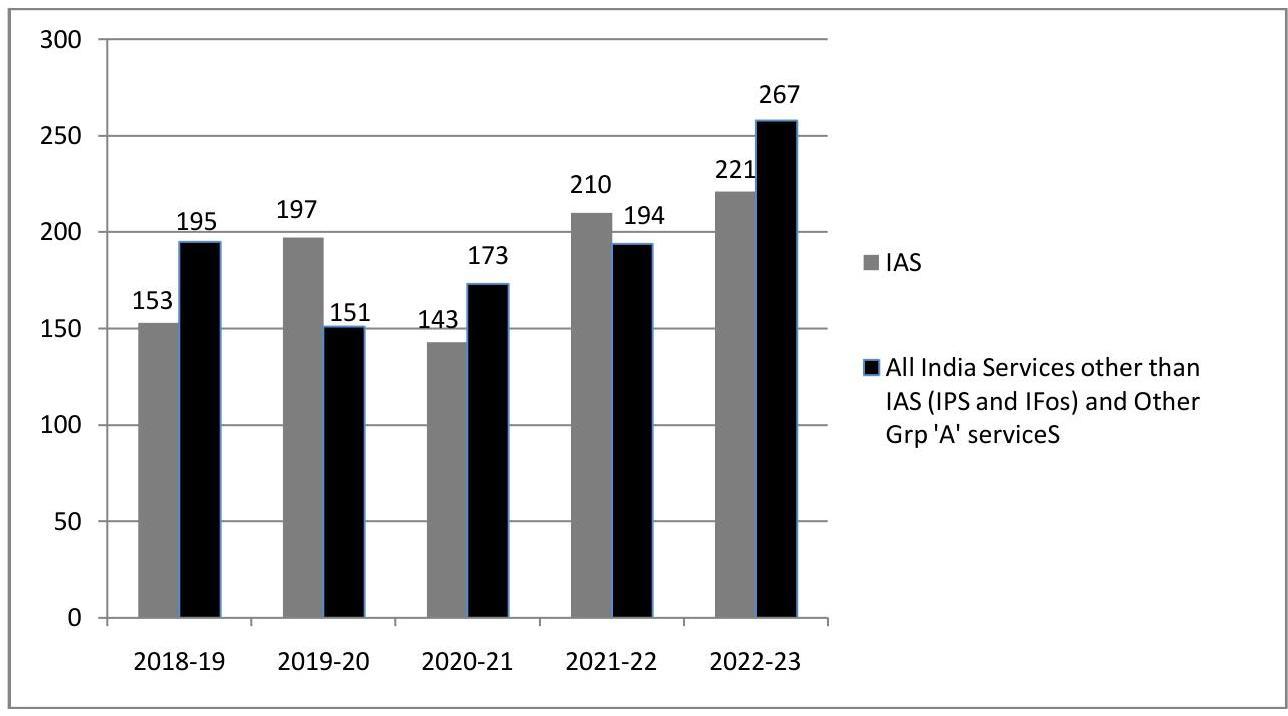
Figures for 2018-19 are up to 31/3/2019, for 2019-20 are up to 31/12/2019, for 2020-21 are up to $31 / 12 / 2020$ for $2021-22$ are up to $31 / 12 / 2021$ and for $2022-23$ are up to $31 / 12 / 2022$
CENTRAL DEPUTATION RESERVE
6.5 The Establishment Officers (EO) Division in the Department of Personnel & Training maintains an electronic database of the IAS officers \& of Group ‘A’ service officers working at the Centre under the Central Staffing Scheme. These records are maintained on the basis of orders/letters/notifications issued by the DOPT, various Central Ministries/Departments and the State Governments. The maintenance/updation of this database is significant, as it helps in providing readily available digitized information in respect of all officers and also processing of cases for foreign appointments/assignments and training etc.
6.6 The Central Deputation Reserve statement in respect of Indian Administrative Service summarizes the state wise number of officers that are on central deputation vis-a-vis senior duty posts. It also indicates the number of officers presently on central deputation from each cadre.
CENTRAL DEPUTATION RESERVE FIGURES AS ON (31/12/2022).
| Sr. | Cadre | Total Authorized Strength | Central Deputation Reserve | No. of Officers at Centre | Col. 5 as Percentage of Col. 4 |
|---|---|---|---|---|---|
| (1) | (2) | (3) | (4) | (5) | (6) |
| 1. | A G M U T | 540 | 117 | 50 | 42 |
| 2. | Andhra Pradesh | 239 | 52 | 11 | 21 |
| 3. | Assam Meghalya |
263 | 57 | 24 | 42 |
| 4. | Bihar | 342 | 74 | 26 | 35 |
| 5. | Chhattisgarh | 193 | 42 | 15 | 35 |
| 6. | Gujarat | 313 | 68 | 14 | 20 |
| 7. | Haryana | 215 | 46 | 13 | 28 |
| 8. | Himachal Pradesh | 147 | 32 | 8 | 25 |
| 9. | Jharkhand | 215 | 46 | 17 | 36 |
| 10. | Karnataka | 314 | 68 | 16 | 23 |
| 11. | Kerala | 231 | 50 | 16 | 32 |
| 12. | Madhya Pradesh |
439 | 95 | 31 | 32 |
| 13. | Maharashtra | 415 | 90 | 26 | 28 |
| 14. | Manipur | 115 | 25 | 13 | 52 |
| 15. | Nagaland | 94 | 20 | 10 | 50 |
| 16. | Odisha | 237 | 51 | 24 | 47 |
| 17. | Punjab | 231 | 50 | 16 | 32 |
| 18. | Rajasthan | 313 | 68 | 19 | 27 |
| 19. | Sikkim | 48 | 10 | 9 | 90 |
| 20. | Tamil Nadu | 376 | 81 | 20 | 24 |
| 21. | Telangana | 208 | 45 | 7 | 15 |
| 22. | Tripura | 102 | 22 | 12 | 54 |
| 23. | Uttar Pradesh | 621 | 134 | 25 | 18 |
| 24. | Uttarakhand | 120 | 26 | 7 | 26 |
| 25. | West Bengal | 378 | 82 | 8 | 09 |
| Total | 6709 | 1451 | 437 | 30 |
6.7 In addition to the appointments under the Central Staffing Scheme, 170 appointments as Chairman/ CMDs/ MDs/ Deputy Governor/ Chairman/ Vice Chairman/ Members/ Executive Directors/ Officers Employee Directors/ Workmen Employee Directors/ Functional Directors/ Non-Official Directors were made on the Boards of Public Sector Undertakings and Banks/ Financial Institutions during the period 01.04.2022 to 31.12.2022. During the same period, 155 appointment were made at the level of Chairman/ Financial Commissioner/ General Managers/ equivalent Members/ Additional Members/ Director General in the Railway Board/ Zonal Railways/ RCT and Promotion/ empanelment was carried out for appointments to Higher Administrative Grade Rs. 67,000-79,000/- and Rs. 75,500-80,000/- in various Group ‘A’ Services under the Ministry of Railways. Besides, proposals in respect of 155 Officers were also approved during the above period for additional charge/current charge/ extension of tenure/ nonextension of tenure/ ad-hoc/ rejection/ termination of services of GM/ DG/ VC/ CMDs/ MDs, Functional Directors, Non-Official Directors in the PSUs/ Banks/ Financial Institutions, and the
Ministry of Railways. Out of these $\mathbf{4 8 0}$ appointments/ Additional charge arrangements, 37 are female officers.
NUMBER OF APPOINTMENTS TO THE POST OF CHAIRMAN-CUMMANAGING DIRECTOR/MANAGING DIRECTOR ETC IN PSUs/BANKs
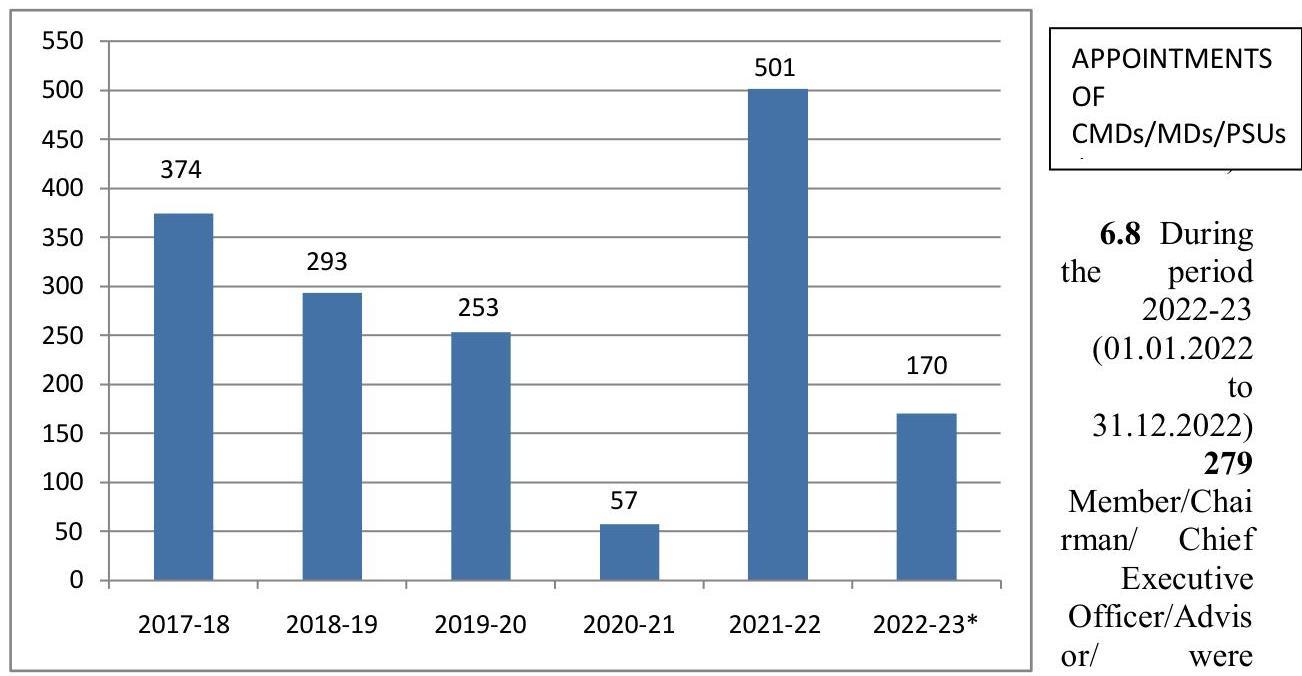
approved for appointment in various Autonomous Bodies, Administrative Tribunals, Labour Courts, Regulatory Bodies etc. Out of these, 26 were women officers.
6.9 A total of 2317 officers were approved for empanelment for promotion to posts of and above the level of Joint Secretary in various organized Central Services which are not included in the Central Staffing Scheme. Out of these, 341 were women officers. .
6.10 The Election Commission of India has been provided the names of $\mathbf{1 2 0}$ IAS officers falling within allotment year 1990-2014 for the General/ Bye Election to the State Legislative Assemblies of various States/UT. Also, names of 32 IAS officers in the rank of Additional Secretaries and Joints Secretaries have been provided to the Election Commission of India for appointment as Election Observers for the Presidential Election-2022. Out of this, 08 officers have been appointed by ECI as Election Observers for General/ Bye Election to the States Legislative Assemblies of various States/ UT and 06 officers have been appointed as Election Observers for Presidential Election-2022.
Chief Vigilance Officer
6.11 During the year 2022-23 (upto 31.12.2022), 47 officers have been appointed as Chief Vigilance Officers (CVOs) in various organizations and 31 officers have been given additional charge of the vacant posts of CVOs in various organizations. During the same period, 13 CVOs have been granted extension of tenure after completion of initial tenure and 05 officers have been debarred from Central Deputation for not joining the post after their selection and 02 case of premature repatriation has been finalized.
REPRESENTATION OF WOMEN
6.12 While taking up empanelment of officers to Joint Secretary rank, it is ensured that women get adequate representation.
6.13 A total of 94 women were appointed under Central Staffing Scheme during the period 2022-2023 including 55 women at Secretary/Addl. Secy. / Joint Secy. levels.
6.14 The appointments/ additional charge/ Extension of tenure /service as CMDs/MDs, Executive Directors, Functional Directors, Non-official Directors in PSUs/Banks, Financial Institutions, Railway Claims Tribunal (Indian Railways) include 37 female officers.
6.15 A total of 367 women officers were appointed as Member / Chairperson / CEO, etc. in various Autonomous Bodies, Administrative Tribunals, Labour Courts, Regulatory Bodies and promoted to posts of Joint Secretary Level and above in various organised central services excluding appointments under the Central Staffing Scheme.
6.16 26 women were approved for appointment as Member/Chairperson/CEO etc. in various Autonomous Bodies, Administrative Tribunals, Labour Courts, Regulatory Bodies etc.
CHAPTER 7
TRAINING POLICY AND PROGRAMMES
MANDATE
7.0 The Training Division of the Department of Personnel and Training is the nodal agency for training of government functionaries and is primarily responsible for formulating policies with regard to training. It also implements certain components of training directly. In the implementation of its mandate, the Division has set the following objectives:
- Administering Policy matters in training
- Identification of functional areas of training
- Designing and implementing training programs for officers involved in the priority development sectors
- Development of trainers and training capability
7.1 The goal of the Training Division is to attain “training for all,” which means that training would be imparted to all rungs of Civil Services, starting from the lowest and cutting-edge to the highest in policy making.
Major Activities
1) Post Graduate Programmes in Public Policy/Sustainable Development/Management
2) Mid-Career Training of IAS Officers
3) Training Support under Training For All (TFA) Scheme through the following components:
State Category Training Programme (SCTP)
Trainers’ Development Programme (TDP) & Faculty Development Scheme (FDS)
Comprehensive Online Modified Modules on Induction Training (COMMIT)
Augmentation of Capacity of Training Institutions (ACTI)
4) Overseas (Foreign) Training Programmes
5) In-service Training of IAS Officers
6) Advanced Professional Programme in Public Administration (APPPA)
7) Posting of IAS Officers as Assistant Secretary in Government of India
8) National Programme for Civil Services Capacity Building (NPCSCB) – Mission Karmayogi
9) e-Human Resource Management System (e-HRMS)
Long-Term Domestic Post Graduate programmes in Public Policy and Management
7.2 Training Wing, DoP\&T has been conducting the following four(4) Long Term Domestic Training Programmes (LTDP) in Public Policy/Management/Sustainable Development-
a) Indian Institute of Management- Bangalore (IIMB),
b) Indian School of Business – Hyderabad/ Mohali (ISB-H/M),
c) Management Development Institute- Gurugram (MDIG) and
d) TERI School of Advance Studies (TERI SAS)- New Delhi
7.2.1 These programmes were envisaged to enhance the competence of Mid-Career Civil Servants in Public Policy and Management by –
(i) Broadening awareness of the latest trends in policy approaches,
(ii) Developing technical, analytical and leadership skills for public policy,
(iii) Providing opportunity in specialization and
(iv) Exposing them to alternative systems of public management in other countries.
7.2.2 During 2022-23, $7^{\text {th }}$ Batch of One-year Advanced Management Programmer in Public Policy (AMPPP) commenced on 08.08.2022 at Indian School of Business- Hyderabad/ Mohali, which is being attended by 18 participants. $14^{\text {th }}$ Batch of Programme in Public Policy & Sustainable Development (PP \& SD) began on 10.10.2022 at TERI School of Advance Studies- New Delhi, is being attended by 9 participants. $15^{\text {th }}$ Batch of Post Graduate Diploma in Management-Public Policy and Management (PGDM-PPM) started on 14.11.2022 and is being attended by 9 participants.
Mid-Career Interaction between Armed Forces and Civil Services Officers
7.3 Mid-Career interaction programme (MCIP) between Armed Forces and Civil Services Officers are being organized at the Central Training Institutes/State Administrative Training Institutes and Defence Institutions in various parts of the country with the objective to benefit both the Armed Forces and Civil Services Officers by way of mutual learning from each other’s strength and also by imbibing the best points of each other’s work culture, ethos and customs. This, in the long run, is expected to help the participating officers to combat future challenges to national security in a better manner.
7.3.1 During the financial year 2022-23, 4 programmes have been planned- one by DoPT and three by M/o Defence i.e. each by Army, Navy \& Airforce. The MCIP have been scheduled at Goa Institute of Public Administration \& Rural Development (GIPA\&RD)- Goa (DoPT), Assam Regimental Centre- Shillong (Army), College of Air Warfare- Secunderabad (Air-Force) and Maritime Warfare Centre- Mumbai (NAVY), on the themes ‘Human Rights’, ‘Evolving Jt. functional Structures for Real time int sharing’, ‘Perception Management as a tool of National Security’, and ‘Unification of Maritime Domain to achieve synergy in National growth, Present and Future Maritime challenges of India \& Reinvigorating India’s Historical Maritime Prowess to Boost Growth and prosperity’. Out of these, two programme have already been conducted at GIPA\&RD- Goa and Assam Regimental Centre- Shillong, which were attended by 31 participants each respectively. The third MCIP was conducted at College of Air Warfare- Secunderabad (Air-Force) scheduled in the month of February, 2023. The fourth MCIP is scheduled to be held in the month of April, 2023.
Training Support under Central Sector Scheme “Training For All (TFA)”
7.4.0 “Training for All (TFA)” is a Central Sector Scheme sponsored by Department of Personnel \& Training. The Scheme has been in operation since 1992. The objective of the Scheme is capacity building of all the Government officials at National and State levels through training interventions to provide training for all viz. developing management skills and knowledge in different areas for senior and middle level officers of State Governments / State Public Sector Undertakings and State Autonomous Bodies; development of a cadre of professional trainers and resource persons in the country; improving functional knowledge, skill and attitudinal orientation of the frontline functionaries; imparting training, including training on soft skills, to the newly recruited cutting edge level functionaries of the State Governments in order to strengthen the public service delivery mechanism; providing
opportunity to trainers / faculty members of various Central and State Training Institutes to undergo short-term training programmes in the institutions of excellence within the country to supplement their knowledge and skills; augmenting the existing training mechanism with online module-based training, coupled with certification to government servants; and providing financial support to the State ATIs for augmenting infrastructure.
7.4.1 State Category Training Programme (SCTP): Under this component, support is provided to State / Union Territory (UT) Administrative Training Institutes (ATIs) by way of sponsoring training programmes in the areas accorded priority by the Central Government. The programmes are designed for senior and middle level officials of State / UT Governments / State Public Sector Undertakings and State Autonomous Bodies to develop management skills and knowledge in different areas and also to sensitize about new and important issues facing our society. The courses cover a large variety of subjects under broad thematic groups such as Ethics in Administration, Disaster Management, Right to Information, Gender Issues, Decentralized Planning, Role & Responsibilities of DDOs, Financial Management, Environment \& Climate Change, e-Governance, Cyber Security, Leadership \& Team Building, Disaster Management \& Climate Change, Legal Literacy for Government Servants, Training in Administrative Vigilance, Public Private Partnership, Revenue Resource Mobilization through VAT/GST/IT etc.
7.4.2 During the year 2022-23, this Department sponsored 500 SCTP courses to various State / UT ATIs on several thematic subjects.
7.5 Trainers’ Development Programme (TDP)\& Faculty Development Scheme (FDS): Recognizing the importance of trainers in the training function, the TDP was started in the early 1990s. Over a period of time, indigenous mechanisms were evolved for developing a cadre of professional trainers and resource persons in the country to create a cascading and multiplier effect by developing the Central / State / UT employees as Master Trainers and Recognized Trainers of various “Training of Trainers (ToT)” packages. The programme has gone a long way in embedding the Systematic Approach to Training (SAT) into the process of designing and imparting effective training to government officials. Under the component, financial assistance is provided to State / UT ATIs \& selected Central Training Institutes (CTIs) to develop a cadre of professional trainers and resource persons in various ToT packages.
7.5.1 The following ToT programmes are sponsored under the TDP component which are conducted by various training institutions across the country:
- Training Needs Analysis (TNA)
- Design of Training (DOT)
- Direct Trainer Skills (DTS)
- Evaluation of Training (EoT)
- Management of Training (MoT)
- Experiential Learning Tools (ELT)
- Mentoring Skills
- Facilitation Skills
- Introduction to SAT courses
7.5.2 During the year 2022-23, this Department sponsored 65 TDP courses to various Central / State Training Institutions.
7.5.3 This Department has been implementing the FDS with a view to broadening and honing the knowledge and skill base of the trainers/faculty members working in the training
institutes. All Master Trainers/Recognized Trainers (MTs/RTs) developed by this Department under Trainers Development Programme (TDP), faculty members working in Central Training Institutions (CTIs) and State Administrative Training Institutions (ATIs) for conducting domestic trainings are eligible for support under the Scheme. The trainers / faculty are sponsored to undergo training in domestic short duration programmes / correspondence courses conducted by premier Intuitions.
7.6 Comprehensive Online Modified Modules on Induction Training (COMMIT): a Blended Training Programme, COMMIT was conceptualized and launched in 2017 in the backdrop of the mandate of the National Training Policy. It stipulates that all civil servants from lowest level functionaries to the highest level will be provided training at the time of their entry into civil service and mandates that priority will be given to the training of frontline staff, including training on soft skills, so as to improve customer orientation as well as quality service delivery to the citizen. This programme has the potential to cover more than 3 lakh officials every year.
7.6.1 The programme is of 28 hours duration which includes e-Modules for 20 hours and face-to-face classroom training for 8 hours. The 20 hours e-training are imparted through specifically developed 12 Generic and 3 Domain specific e-Modules. The programme is implemented through State Administrative Training Institutes (ATIs).
7.6.2 The blended course allows officers and faculty to take advantage of flexibility and convenience of an online course while retaining the benefits of the face-to-face classroom experience. The mission and goal of COMMIT is to develop skills and attitude towards improving service delivery keeping the citizen at the core. The advantage of such a blended programme is requirement of limited classroom space; to infuse new opportunities to officers who have had limited or no training to build the requisite skills, knowledge and attitude; and offer the convenience of online learning combined with the social and instructional interaction that may not lend themselves to online delivery (e.g. motivational talk, understanding of the vision and proctoring assessments).
7.6.3 The COMMIT is in the process of being aligned with the Mission Karmayogi. The English and Telugu versions of the COMMIT Modules have been already onboarded onto the iGOT Platform. Hindi version of these Modules is being finalized and the same shall be onboarded onto the iGOT Platform.
7.7 Augmentation of Capacity of Training Institutions (ACTI): Under the ACTI component, support is provided to the State / UT ATIs for augmenting infrastructure in the form of hardware, software and courseware, networking of training institutions and consolidating the training ware. The Training Institutes are also supported and encouraged for developing case studies, e-learning packages, training films, organizing workshops, special programmes, seminars etc. The funds are released to those ATIs who seek financial assistance for up-gradation of their training capacity.
7.7.1 Keeping in view the changes taking place in technology etc., this Department has actively been considering revisiting the guidelines governing the assistance under the component.
Overseas (Foreign) Training Programmes
7.8 Department of Personnel and Training has been nominating officers for training programs abroad. In the past, these programs were funded by bilateral or multilateral assistance. Keeping in view the importance and benefits of providing international exposure
to the officers, a scheme of Domestic Funding of Foreign Training (DFFT) was started in 2001 with Government of India funding. This covers both long-term and short-term training in various universities/institutes in several countries. A scheme of “Partial Funding of Foreign Study” was also started in 2002-03 as another component of the scheme of DFFT under which Government of India provides limited financial assistance to such officers who secure admission in reputed universities and in programs relevant to their present or future career in the relevant field.
7.8.1 During 2022-23, the DFFT programs could not be conducted since there was restriction imposed on foreign training due to the outbreak of COVID-19. The Officers were nominated for programmes supported by foreign agencies under bilateral programmes – 14 officers have been nominated for Knowledge Co-Creation Program of Japan International Cooperation Agency (JICA) held in Japan under the Technical Cooperation Program of the Government of Japan and 3 officers were nominated for one year Master’s Degree Course in “School of Government” and “law” under Young Leaders Program (YLP) offered by Embassy of Japan held at the National Graduate Institute for Policy Studies, (GRIPS) Tokyo, Japan.
One-week In-Service Training (IST) Programme for Officers of All India Services, those working under Central Staffing Scheme and Officers of Central Secretariat Service (CSS) and Central Secretariat Stenographers Service (CSSS)
7.9 The Training Division sponsors ‘In-Service Training Programme’ of ‘one-week duration’ in various ATIs/CTIs/ Premier Training Institutes in the country by inviting proposals from them on relevant themes. These programmes provide middle and senior management level officers an opportunity to update their skills in areas of their choice in sectors they are currently working in, or in areas they are expected to work in the near future, or in areas they want to specialize in. These programs also provide a valuable platform for horizontal and vertical knowledge sharing.
7.9.1 The primary objective of the IST program is to sensitize the participants to national concerns and the values enshrined in the Constitution; to provide for exchange of experience and adequate discussions on issues of values, ethics and attitudes; to make the participants more confident to face problems in their work areas and attempt solutions; and to train the participants to look at problems in an integrated manner and develop a systematic approach.
7.9.2 These programs have been offered in diverse and broad thematic areas: such as Administrative Law, Agricultural & Rural Development, Climate Change (preparedness), Competition Law (policy formulation), Corruption (eradication strategy), Education (reforms \& challenges), E-governance (opportunities \& challenges), Environment \& Natural Resource (management), Environmental Impact Assessment (development projects), Ethics (Public Governance and Administration), Financial Markets (regulation), Fiscal Policy (Macroeconomic Management), Governance (IT management and improving through accountability), Infrastructure (Finance), Innovations (public service), Land Acquisition (rehabilitation \& resettlement), Leadership, Participatory Management (Community Mobilization), PPP (negotiating strategies and urban development), Procurement (procedure \& contracting), Project Analysis/Appraisal (risk analysis/management), Public Policy (management/governance), Quantitative Methods (management), Service Delivery (management), Social Policy (Governance), Social Sector (financing/marketing), Urban Development, Citizen Centric, Cyber Crime, Stress Management, etc.
7.9.3 During the year (2022-23), 12 programmes (Physical/Offline mode) were offered at 12 training institutions and 5 Online programs were offered at 5 training institutions. Out of
12 programmes, 6 physical/offline In-Service Training programmes were conducted, in which 128 officers participated. Out of 5 Online programmes, 1 programme was conducted, in which 3 officers participated.
Advanced Professional Programme in Public Administration (APPPA) At Indian Institute of Public Administration, New Delhi
7.10 The Training Wing has been sponsoring a ten-month Advanced Professional Programme in Public Administration (APPPA) at the Indian Institute of Public Administration (IIPA), New Delhi every year since 1975-76.
7.10.1 The objective of this programme is to prepare the participants to make greater contribution to better governance, develop attitudes that focus on citizen services and also to strengthen leadership qualities in the civil service. It provides an opportunity to the participants to analyze major contemporary issues in Governance, learn about recent developments in the social sciences and their application in administration; review their experiences by making a critical analysis of environmental and other factors, apply relevant concepts, skills and techniques relating to policy, behavioral and administrative sciences and to demonstrate their creative and analytical abilities individually and in groups. It also seeks to develop interpersonal skills and sensitivity to the needs of the people with a view to making administration more responsive and result oriented.
7.10.2 An officer with at least 10 years of Group ‘A’ (class-I) service and at least of the rank of Director/Deputy Secretary in the Government of India or holding an equivalent post is eligible for APPPA course. The Programme is also open for senior officers (Group ‘A’) from State Services.
7.10.3 This 10 -month programme includes three semesters, rural and urban field visits in India and a two-week foreign study tour. The $48^{\text {th }}$ APPPA course in this series commenced from 01.07.2022 and is scheduled to end on 28.04.2023 and 38 officers are attending the said course.
Indian Institute of Public Administration
7.11 Indian Institute of Public Administration (IIPA), New Delhi is an Autonomous Research and Training Institute of National Importance under Department of Personnel & Training (DoPT), Government of India. IIPA was established on 29th March 1954 for promotion of Public Administration in post-colonial era and changing the colonial mindset of the Civil Services.
7.11.1 Presently, the Hon’ble Vice President of India Shri Jagdeep Dhankhar, is the President of IIPA and Hon’ble Union Minister of State, Ministry of Personnel, Public Grievances and Pensions, Dr. Jitendra Singh is the Chairman of IIPA Executive Council. Shri Surendra Nath Tripathi, LAS (R), Former Secretary, Ministry of Parliamentary Affairs, Government of India is the present Director General of IIPA. IIPA Executive Council includes, among others, the CEO, NITI Aayog, Secretary (P), DoPT, Secretary (Expenditure) and Director, LBSNAA, Mussoorie.
7.11.2 The activities of IIPA include research, training, publication and dissemination of information in the field of Public Administration \& Governance. Every year IIPA conducts around 30-40 Research Studies which consist of evaluation of government schemes, policy advisory and policy analysis for different Ministries / Departments of Government of India, State Governments and International Organizations. IIPA Applied Research Wing gained a
qualitative upswing with specific governance areas of concern. IIPA faculty completed around 14 research studies for various Central Ministries and State Governments till December 2022.
7.11.3 IIPA conducts over 100 training programmes every year for officers of Government of India, State Governments, PSUs, Defence Forces and Foreign Governments. IIPA has been conducting training for Indian Revenue Service (Customs &Indirect Taxes), Capacity Building Emerging Technology for Governance (CTI \& ATI), Direct Trainer Skill (DTS) for Officers of NVS, Study Tour Programme for the Probationary (Group A) Officers of YASHADA Maharashtra, Judicial Officers of UP State, Foundation Training Programme of Department of Science \& Technology etc. IIPA has conducted 80 training programmes till December 2022.
7.11.4 Advanced Professional Programme in Public Administration (APPPA) is a 10 month long programme for Mid-Senior Civil Servants and Defence Forces Officers is the flagship programme of IIPA under the aegis of Department of Personnel and Training (DoPT), Government of India. The $48^{\text {th }}$ APPPA commenced on 01.07.2022. Hon’ble Union Minister Dr Jitendra Singh interacted with the participants on 01.07.2022. Total Thirty-Eight (38) participants are participating, majority of them being from all in- services of armed forces and others from ITS, Indian Postal Service, Military Engineer Services (MES) and Ministry of Environment, Forest and Climate Change (MoEF) and other Civilian Officers.
7.11.5 The Institute disseminates information, analyses viewpoints and knowledge related to public administration, governance, policy and public administration, governance, policy and development through its regular publications viz., monthly digital edition of IIPA Newsletter, quarterly editions of Indian Journal of Public Administration (IJPA) in association with Sage Publications, quarterly editions of Nagarlok, Documentation in Public Administration (DPA), biannual editions of Lok Prashashan (Hindi Journal) and quarterly editions of IIPA Digest. IJPA, Nagarlok and Lok Prakashan, all three are also listed in the UGC- Care List of Journals.
7.11.6 IIPA has prepared commendable Digital Infrastructure and it has now VC equipped eight Lecture Halls for conducting both online/offline programmes. In fact, IIPA has prepared all the Digital Material for APPPA and other Online Programmes. IIPA is an important cog in the wheel of Mission Karmayogi, the National Programme for Civil Services Capacity Building. IIPA has also prepared and uploaded several Capacity Building Programmes on “iGOT”. IIPA is an active partner of Capacity Building Commission (CBC) and holding several programmes in collaboration with CBC.
7.11.7 IIPA receives grant-in aid from DoPT, Govt. of India under Salary, General and Capital heads. During the financial year 2022-23, 3200.93 lakhs have been released to IIPA under three heads namely Grant-in-aid-General, Grants for Creation of Capital Assets and Grants-in-aid-Salaries.
Assistant Secretary Training Programme in Union Ministries
7.12 The Department of Personnel and Training is entrusted with the implementation of Assistant Secretary Programme to provide exposure to the young IAS officers to Government of India functioning at early stage(s) in their career on completion of their phase II Training at LBSNAA, Mussoorie.
7.12.1 This exposure helps them acquire a national perspective and appreciation of diversities in national policies. This also sensitize them to the larger perspective of policies & programmes of Government of India and the officers are likely to be an inspired Change Agents when they go back to their cadre States. As primary implementers of Programmes/Projects in the field (States), this exposure also facilitates a broader macro perspective.
7.12.2 The programme started in 2015 as per vision of Hon’ble Prime Minister when 2013 batch officers were posted in as Assistant Secretary in Ministries/Departments. The Assistant Secretaries are deputed for a total period of 13 weeks in Union Ministries and Departments in New Delhi. In the year 2022, 175 IAS Officers of 2020 batch were posted as Assistant Secretary in the Ministries/ Departments of Government of India from 11.07.2022 to 07.10.2022 on Central Deputation.
7.12.3 The Assistant Secretaries were allotted important Desks in the Ministries and placed below Under Secretaries, but reported to Deputy Secretaries/Directors. They were assigned following responsibilities:
i. Work relating to Flagship programmes/major initiatives of the Ministry/Department. This was an individual activity.
ii. Secretary of the Ministry/Department concerned gave a project work pertaining to the Ministry/Department. A Group activity.
iii. To review the implementation of projects/initiatives of Assistant Secretaries of previous 3 batches and take them to a logical conclusion. A Group activity.
7.12.4 Besides above, several Special interactive sessions/and other programmes were also organized on different topics in which a large number of dignitaries / Head of Departments /Head of Organizations / Senior Officers participated on Fridays/Weekends.
7.12.5 Among other activities, the Assistant Secretaries also made presentations on the works/initiatives they have undertaken in their respective Ministries/Departments, before the Sectoral Group of Secretaries (SGOSs). In this connection, all the ten Sectoral Groups of Secretaries provide guidance to the Assistant Secretaries in preparing their presentations/reports based on any subject or work done by them in their respective Ministry/Department.
7.12.6 Top 8 presentations were shortlisted out of the presentations made by Assistant Secretaries before the respective SGOSs. These top 8 presentations were then presented before the Hon’ble Prime Minister during the Valediction Ceremony: –
Matribhoomi, Geoportal-Integrated National Geoportal of India for governance
Corporate Data Management
Enabling Multi-lingual Voice Based Digital Access through Bhashini
POSHAN Tracker: tool for improved monitoring of Poshan Abhiyan
Changing the face of Indian Post Offices through IPPB
Tourism Potential of BRO
Development of Coastal Fisheries through Artificial Structures like Reefs
CBG – Fuel for the Future.
CHAPTER 8
TRAINING INSTITUTIONS
LAL BAHADUR SHASTRI NATIONAL ACADEMY OF ADMINISTRATION, MUSSOORIE (UTTARAKHAND)
Introduction
8.1.1 The Lal Bahadur Shastri National Academy of Administration (LBSNAA), Mussoorie, is Government of India’s premier institution for the training of higher civil services in the country. The Academy imparts induction level and in-service training. A common Foundation Course is held for entrants to All India Services and all Group ‘A’ services of the Union. The professional training to regular recruits of the Indian Administrative Services (IAS) and members of the Royal Bhutan Civil Service is conducted after the Foundation Course. The Academy also conducts in-service and Mid-Career Training Programmes (MCTP) for members of the IAS and Induction Training programmes for officers promoted to the IAS from State Civil Services, as well as workshops and seminars on various issues in public administration.
8.1.2 To ensure that the academic curriculum is relevant, it is constantly reviewed and updated through extensive consultations with the representatives of the state governments, the central government and other scholars and practitioners. Given the limitations of conventional classroom lectures, new pedagogical methods have been introduced to deliver training inputs in a more effective manner. Most courses operate on a modular structure whereby relevant themes are chosen and dealt with in a consolidated fashion to ensure that all aspects relating to them are covered comprehensively.
8.1.3 In order to promote all-round development of the personality, due emphasis is placed on outdoor and co-curricular events. Physical training, team games and tennis, badminton cross-country running, yoga, horse riding, and adventure sports like river rafting, paragliding, bungee jumping and rifle shooting are some of the activities that the officer trainees are involved in. Exposure to public speaking, theatre workshops, gardening, photography and music appreciation are some of the co-curricular activities offered to the young administrators.
8.1.4 To nurture the values of integrity, moral courage, empathy and respect for the underprivileged, and freedom from any sectarian prejudices based on religion, region, caste, class or gender, Officer Trainees are encouraged to participate in diverse social activities. Four Houses, viz. Nanda Devi, Stok Kangri, Namcha Barwa and Kangchenjunga have been formed to which the Officer Trainees are elected as office-bearers. They organize and take part in quizzes, debates, poetry competitions and numerous other activities after class hours. This lends a spirit of bonhomie and also promotes esprit de corps.
Induction Training Courses
8.1.5 The Academy conducts Induction training courses for direct recruits to the IAS and other senior civil services as well as officers promoted to the IAS.
1. IAS Professional Course Phase I (2021 Batch)
| Programme meant for / Target Group |
Professional Course for newly recruited IAS officer $(21.03 .2022$ to 19.08 .2022$)$ |
|---|---|
| Course Coordinator | Shri Shelesh Nawal, Deputy Director |
| (s) | Ms. Disha Pannu, Deputy Director Shri Hari Prakash, Professor Shri Romeo Vincent Tete, Assistant Director Shri Hari Lal Chauhan, Assistant Director |
| Inaugural Address by | Shri Rajiv Gauba, Cabinet Secretary, GoI (Online) |
| Valedictory Address by | Shri Srinivas R. Katikithala, Director LBSNAA |
| Total No. of Participants | 183 (180 OTs, 2021 Batch, 01 from 2021 Batch & 02 from RBCS) (Male- 121; Female- 62) |
8.1.6. Course Aims
- The Academy aims to make the young IAS Officer Trainees as real Karmayogis by inculcating the leadership qualities so as to make them Creative \& Constructive, Imaginative and Innovative, Proactive \& Polite, Professional \& Progressive, Energetic \& Enabling, Transparent \& Tech-Enabled along with the knowledge, skills and attitudes to become effective civil servants
- To create learning experiences regarding ethical and developmental administration
8.1.7. Course Objectives
- Acquire a pan-India perspective of emerging socio-economic, and politico-legal trends; an understanding of the emerging role of the IAS and its shared administrative responsibilities with other services.
- Acquire knowledge and skills needed to discharge administrative responsibilities in the first decade of their career in the following areas:
- Law and legal instruments
- Administrative rules, procedures and programme guidelines
- Modern management tools, and
- Economic analysis
- Demonstrate proficiency in the regional language of the allotted State to better appreciate its administrative and cultural ethos.
- Acquire an understanding on the cultural and socio-economic background of the allotted State
- Demonstrate effective written/ oral communication skills both in interpersonal and organizational context
- Exhibit right values and attitudes
- Maintain physical fitness
- Adhere to the spirit of ‘Sheelam Param Bhushanam \& Mission Karmayogi
8.1.8. Course Design
- The Course design of the Phase I programme was consciously liberal in spirit and content of the Mission Karmayogi. While seeking to provide the Officer Trainees with ample space to study, learn, experience, it strives to impart key competencies i.e. Domain Knowledge (Right Knowledge), Behavioral (Right Attitude) and Functional (Right skills) which would enable them to shoulder future responsibilities and to tackle not only the day to day working challenges but also the unforeseen and emergent crisis effectively. The 22-week IAS Professional Course, Phase-I for the 2021 batch, commenced on 21.03.2022 and concluded on 19.08.2022. It had two main components:
> India Study Tour cum Bharat Darshan (from 02.03.2022 to 12.06.2022)
> On-campus training inputs part 01 (from 21.03.2022 to 29.04.2022)
> On-campus training inputs part 02 (from 20.06.2022 to 19.08.2022) - The Phase-I is a full-time training programme with an eclectic mix of curricular and extra-curricular activities. A typical day commenced at 06:30 hours with physical exercises at the Happy Valley ground. The evenings were dedicated to programmes by Clubs and Societies including cultural programmes.
8.1.9. Academic Inputs
- The on-campus academic training commenced on 21.03 .2022 to 29.04 .2022 and 20.05.2022 to 19.08. 2022. While the syllabus prescribed under ‘The Indian Administrative Service (Officer Trainees’ Final Examination) Regulations, 1955′ is the basic framework, suitable modifications have been made to adapt it to the changing training needs of IAS Officers. Inputs were given in the faculties of Law, Public Administration, Political Science & Constitution and Management \& Economics. The Public Administration modules were structured around thematic inputs covering varied domains that IAS Officers have to deal with. These were interspersed with sessions in Languages and ICT.
- The training methodology being adopted in this course constituted a mix of lectures, case discussions, seminars, panel discussions, order writing exercises, moot courts and mock trials, management games and role plays, group exercises, films, field and outdoor visits, among others. Several experts and eminent persons from diverse backgrounds were invited to address the participants during the Course. These exposed the Officer Trainees to alternative perspectives and diversity of opinion, which were necessary for making any considered decision.
- The course began with deep dive learning about the ethos and logos of the service through the deconstruction module. In order to do away with misperceptions about the Indian Administrative Service prevalent in the minds of young IAS Officer Trainees, and to make them aware about the rapidly changing needs of Indian Administrative Service, for the first time, a 5 day intense module was done at the start of the IAS Professional Phase-I Course which has enabled previous un-learning, and to start learning afresh on the part of young IAS Officer Trainees.
- The certification courses from international organisations like in Macro-Economics from IMF, Data Analytics from CMU and Public Policy from LKU, helped OT’s gain domain
expertise with certification from best in domain international institutes. It also helped in broadening the learning perimeter and developing scholastic values.
- To sensitize about the ground level scenarios and develop the behavioural aspect of the trainees, interaction with grassroots level policy beneficiaries like SHG, farmers etc. had been organised. As the part of Amritotsova, the Officer Trainee were attached with respective cadre SHG entrepreneur, thereby enabling them to learn about their hardship and develop the vision of think global act local.
- The course has given emphasis on inculcating leadership qualities, managerial skills, communication skills, and soft behavioral skills through the Leadership Module and ferro assessment for self-improvement delivered by “Sardar Vallabhbhai Patel Leadership Centre” in the Academy.
- The module-wise approach to a specific matter has enabled to brought together and interconnect multiple issues to have holistic learning experience. The modules on economics, health, urban module, Nutrition, women and child, Communication, Election, Disaster Management, Entrepreneurship Development, Module on Geographical Indications & ODOP, e-Governance \& Media, Law \& Order, Water Management, Social Security, Public finance and accounting procedure have helped in developing a broader understanding of the issues that they have to deal with right after training in the field.
- The Officer Trainees have been given exposure on Evidence Based Policy Making and attached with the research support unit to develop the case studies from their own understanding in the field which can be used for training the next cohort. To better appreciate the Man-Environment \& Forest (Man-Animal Conflict) rehabilitation issues, the trainees were taken to the Gujjar colonies at Corbett National Park.
- As a part of using the experience and knowledge base of the Alumni and to provide cadre-specific inputs on the subject matter, remarkable and illustrious IAS Officers serving in the States were called as Adjunct Faculties for continuous guidance at the Academy.
- The course has also utilised the opportunities provided by Phase-2, Phase 4, JCM course and women and leadership course which were running concurrently and has harnessed the best of their experiences and wisdom via competitions and interactions.
- The course has shifted from the traditional exam-based evaluation methods, to the digital and concurrent, evaluation pattern based on the submission of Dissertations, Presentations, Debates and Discussion, etc. on the imparted module so as to generate new and innovative ideas.
- As an IAS Officer, Officer Trainees had to become thorough in the language of the cadre to which they are allotted. Statutory language examinations were held during the Phase I programme. Officer Trainees, who were already familiar with the cadre language were provided advanced instruction in administrative usage of the language and were also required to undertake alternative modules and activities. Office Trainees were required to present their State Paper in the cadre language. The ICT module for Phase-I had been designed specifically to familiarize the Officer Trainees with Information Technology Environment in districts, concepts/issues involved in computerizing a system, latest trends in technology. The inputs on IT proficiency including exposure to advanced tools like power BI and EXCEL has been given along with sensitising them with dashboard creation, data handling, AI, ET and IOT techniques, web design, client/server computing,
e-governance, and so on. The idea behind this input is not to make Officer Trainees “computer-professionals”, but to acquaint them with the capabilities of technology in their real-life working environments.
8.1.10. Assessed Academic Tasks: The course also incorporated elements of self-studybased learning into its design through a Book Review and the State Term Paper that was presented in the regional language of the allocated cadre in the Counsellor Group Meeting; Bharat Darshan: Group Presentations, Individual Bharat Darshan Diary and Travelogue along with House Journals.
8.1.11. Outdoor Activities: Career in the IAS is often sedentary and tension-filled. Sound physical and mental health is an essential pre-requisite for an Officer of the Service. In the Phase I programme, Officer Trainees were encouraged to cultivate and sustain the habit of regular physical exercises. The morning Physical Training was a compulsory activity. Physical exercises and outdoor activities were an integral part of the Course.
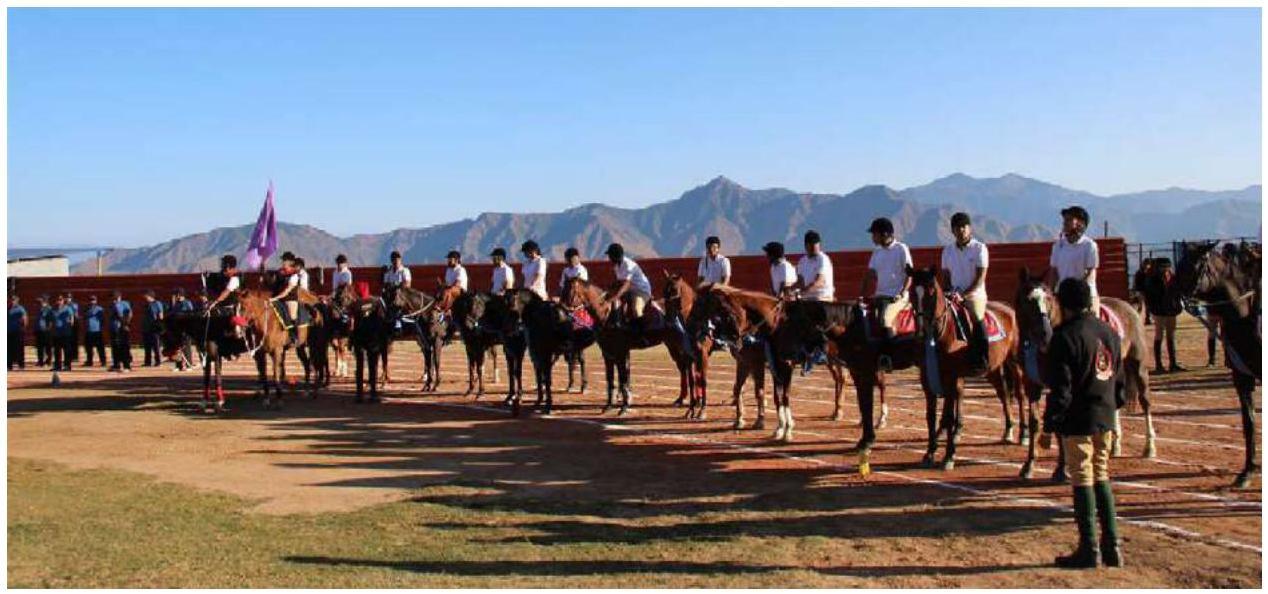
8.1.12. Extra-Curricular Activities:
- Maximum emphasis has been given on building physical fitness on the note of “Healthy Mind Resides in the Healthy Body”. Revised outdoor pedagogy wherein emphasis has given on outdoor health & fitness with the interests and hobbies of Officer Trainees apart from the official work are better equipped to handle the stress that the profession creates.
- In the Phase-I programme, Officer Trainees were encouraged to develop passion for creative activities through extra-curricular modules. To celebrate $75^{\text {th }}$ year of Independence, and being the “India @75 Batch”, IAS Phase-I 2021 batch had celebrated the “Azadi Ka Amrit Mahotsav” in the true spirit of fervour and enthusiasm. During the 22 weeks the Officer Trainees organised 75 cultural and extra-curricular events to commemorate the year which has not only broaden their knowledge base about the country, but also instilled the feeling of deep nationalism and respect for our nation. The AKAM folk art workshop had exposed them to 20 different art forms.
- The Pravah cultural fest between the IAS and IFoS had led to cementing of camaraderie among the services and in some cases had forged lifelong partnerships. The entrepreneurship skills were honed with the AKAM fete. The course had also given opportunities like:
> Interaction with the Members of Parliament
Library talks with eminent Authors
Talk by eminent personalities like rocket women, etc.
Teaching the students, counselling, contribution for the mess, donation box, etc.
8.1.13. Zonal Days: Officer Trainees organised Zonal Days during the Phase I programme. The purpose of organizing a Zonal Day is to acquaint the Officer Trainees with the culture and cuisine of their allocated cadres. The constitution of groups for each zone would be based on the State of allotment.
8.1.14. Awards for Meritorious Performance: Prizes and medals were awarded for outstanding performance by the IAS Officer trainees in academic and extra-curricular activities during the Professional Course Phase-I.
Participants in IAS Phase-I (2021 Batch)
| Participants from the State of | Male | Female | Participants |
|---|---|---|---|
| AGMUT | 09 | 05 | 14 |
| Andhra Pradesh | 07 | 01 | 08 |
| Assam-Meghalaya | 05 | 04 | 09 |
| Bihar | 05 | 05 | 10 |
| Chhattisgarh | 03 | 00 | 03 |
| Gujarat | 07 | 02 | 09 |
| Haryana | 06 | 01 | 07 |
| Himachal Pradesh | 02 | 01 | 03 |
| Jharkhand | 06 | 01 | 07 |
| Karnataka | 06 | 02 | 08 |
| Kerala | 06 | 02 | 08 |
| Madhya Pradesh | 06 | 02 | 08 |
| Maharashtra | 06 | 04 | 10 |
| Manipur | 01 | 00 | 01 |
| Odisha | 04 | 04 | 08 |
| Punjab | 02 | 03 | 05 |
| Rajasthan | 05 | 01 | 06 |
|---|---|---|---|
| Royal Bhutan Civil Service | 01 | 01 | 02 |
| Sikkim | 01 | 00 | 01 |
| Tamil Nadu | 06 | 07 | 13 |
| Tripura | 04 | 01 | 05 |
| Telangana | 04 | 03 | 07 |
| Uttar Pradesh | 08 | 07 | 15 |
| Uttarakhand | 01 | 02 | 03 |
| West Bengal | 10 | 03 | 13 |
| Total | $\mathbf{1 2 1}$ | $\mathbf{6 2}$ | $\mathbf{1 8 3}$ |
8.1.15. $97^{\text {th }}$ Foundation Course ( 15 Weeks)
The Lal Bahadur Shastri National Academy of Administration conducts its flagship training programme, the Foundation Course each year for the successful young recruits of the All India Services, Central Services and officers from the Royal Bhutan Civil Service.
The Foundation Course, as the nomenclature suggests, lays the basis on which the edifice of career of a Civil Servant in Government is built. The Foundation Course marks the formal induction of Civil Servants into the government, the beginning of a life dedicated to the service of people of India and our nation. It gives a glimpse of how the government functions, what are the values and ethos which drive it, what are the main challenges, opportunities and responses that arise in governance of a large, complex and diverse country like India.
The Course was inaugurated by Shri Srinivas R. Katikithala, Director, LBSNAA on 05.09.2022 and Course Valedictory was graced by the Hon’ble President of India, Mrs. Droupadi Murmu, on 09.12. 2022.
As the Officer Trainees are new entrants in the Government, the Academy sought to familiarize them with the environment of political, economic, social and administrative issues, through a well-defined syllabus. The fifteen-week long Foundation Course comprising of more than 15 services of the Indian Union and the three Royal Bhutan Civil Services sought to open the mind of civil servants to new learnings and adventures, immersive experiences in rural India, celebration of resilience, diversity and depth of our rich heritage, a trek of a lifetime amidst the mountains and valleys of Himalayas and a reverential visit to the Statue of Unity at Kevadia.
| Date of Program | 29.08 .2022 to 09.12 .2022 |
|---|---|
| Programme meant for / Target group | Newly recruited All India Services and various Central Service (Group- `A’) Officers [including Royal Bhutan Civil Services] |
| Course Coordinator | Ms. Anandhi, Deputy Director (Sr.) |
| Associate Course Coordinator(s) | Shri Abhiram G Sankar, Deputy Director Ms. Disha Pannu, Deputy Director Dr. Sanjay Joshi, Professor Dr. Anupam Talwar, Assistant Director Dr. Ekta Uniyal, Assistant Director |
| Course Inaugurated by | Shri Srinivas R. Katikithala, Director, LBSNAA |
| Valedictory Address by | Mrs. DroupadiMurmu, Hon`ble President of India |
| Total Participants | Total-455 (Gentlemen – 322; Ladies – 133) |
8.1.16. Course Aims
The $97^{\text {th }}$ Foundation Course primary aimed at developing officer-like qualities and attitudes in the 455 young Officer Trainees. One of the prime objectives of the Foundation Course was to inculcate esprit de corps in the Officer Trainees attached to different services of the country. The Academy also facilitated the training of officer trainees of the Royal Bhutan Civil Services, as a part of the $97^{\text {th }}$ Foundation Course.
The Foundation Course marks the transition from the academic world of the college and university to the structured system of government. Accordingly, for most of the course participants, the course was their first introduction to the process of governance, and the role of the government in a society. The course was designed in a manner to achieve the objectives outlined by arranging a combination of academic, outdoor, extra-curricular and cocurricular activities. The Academy intends to equip each of the Officer Trainees with a core set of values, skills and knowledge that would help them in their respective careers. They are given training inputs useful in understanding the basic concepts of governance and rules and regulations, necessary for effective performance in the government sector.
8.1.17. Course Objectives
- To orient Officer Trainees to the administrative, social, economic and political environment of the country.
- To make Officer Trainees aware of the challenges and opportunities within the Civil Services.
- To promote overall development of personality traits of the Officer Trainees. i.e. Intellectual, moral, physical and aesthetic.
- To foster greater coordination among the members of different Civil Services by building esprit de corps.
- To provide exposure to the best possible teaching material and resource persons to facilitate the Officer Trainees’ professional, intellectual and emotional growth.
- To provide the Officer Trainees with an environment that encourages enquiry and freedom of thought, yet imbued with discipline, to foster intellectual growth and all-round development.
8.1.18. Course Design
The course design in the $97^{\text {th }}$ Foundation Course made a significant departure from the past in more ways than one.
One, it was largely thematic, week by week. Each week had a central idea/subject, running through it to enable each Officer-Trainee to understand that topic deeply with all its nuances. The Assessment and Evaluation criteria had also been modified to accommodate these changes in course design beginning with Journaling, the essay and the oral presentation at the end.
Secondly, the course design was aligned with the principles of ‘Mission Karmayogi’ and indoor classroom experiences had been suitably balanced by outdoor visits which have been consciously designed to be immersive and experiential.
Out of 15 weeks which comprise the Foundation Course, almost five weeks were travel, tours and camping outside the Academy premises. With a longer than usual Field Study and Research Programme ( 12 days) to $75^{\text {th }}$ Freedom Fighter Districts of India to twelve days in Gujarat from Ahmedabad to Kevadia for Aarambh $4.0 &$ Bhuj to more than a week of
Himalayan trek, all of these had been consciously built in to not only expand and hone the intellectual capabilities but also foster qualities of conduct, fortitude, endurance, sharing, empathy and inclusion.
The course design had two ‘critical areas of focus and salience this year. One was the emphasis on communication, both oral and written and the other being emphasis on fitness. This was given the shape of a discipline to bring rigor and at the same time ample exercises and assessments around it were built. Experts from all across the world were gathered to deliver this module and this module ran through the entire Foundation Course constituting its back bone.
8.1.19. Academic Inputs
Academic inputs on a wide range of subjects were delivered through modules in:
- Oral Communication
- Written Communication
- Law
- Economics (Micro and Macro) with IMF
- Data Analytics with CMU
- India & its Neighbourhood with the MEA
- National Security Module
- Public Policy
- Management
- Ethics
- Information Technology
In addition, co-curricular inputs were also given by way of outdoor activities (physical training; yoga classes and horse riding), cultural activities, extra-curricular modules.
A number of medals and trophies were awarded to the Officer Trainees who excelled in various activities at the Academy.
8.1.20. The main activities organized during the Foundation Course were:
(i) Physical Fitness \& Sports: Physical fitness is not only one of the most crucial aspects to attain a healthy body; it is the foundation of a healthy mind as well. The Academy strove to provide an encouraging atmosphere to all the Officer Trainees wherein physical fitness was an inseparable and crucial component of the training and holistic personality development.
- Pre-course evaluation: As soon as Officer Trainees reported to the Academy, some essential health and fitness tests to assess parameters like flexibility, muscular strength, cardio-vascular fitness and balance were conducted. This provided the baseline of current fitness level, which the Academy encouraged every Officer Trainee to improve using the facilities available in the Sports Complex along with the advice of coaches and trainers.
- Morning Activities: The day began at 06:15 hrs. for all Officer Trainees with mandatory morning activities which included Physical Training, Yoga, Aerobics, Zumba and Un-Armed Combat. Self-defence through Krav Maga (a form of unarmed combat) had been identified as a critical skill and Officer Trainees were encouraged to master this with full enthusiasm.
(ii) Field Study and Research Programme: To assess the dynamics of the socio-economic-political situation existing in a village.
- Understand the problems faced by the rural people, especially, the socially disadvantaged sections and women.
- Evaluate the spatial and temporal changes that have occurred in the village in terms of quality of life as a result of Government and non-Governmental interventions or with the passage of time.
- Evaluate the working of various village level institutions, both formal and informal in terms of participation and effectiveness.
- Recognize the importance of the need to learn from the villagers in evolving people-based solutions to their problems.
- Study the physical environment of the village in relation to ecological imbalances and vulnerability to disasters.
The Officer Trainees proceeded for the Field Study and Research Programme in Freedom Fighter District in India from 24.09.2022 to 02.10.2022. The Field Study and Research Programme is a major component of the Foundation Course, not only because it exposes the Officer Trainees to the realities of rural India through a structured study, but, also because it provides them the opportunity to stay in villages and interact intensively with the rural populace to understand and appreciate their concerns and priorities. They were given inputs on Data Collection & Analysis, Rural development programs, Social sector, Role of NGOs, PRA techniques, etc. to equip them adequately for the visit. Officer Trainees also conducted a survey in the village as per the guidelines provided to them.
On return, they submitted individual as well as group reports of the activities, findings and recommendations and made group presentations, which was graded on both the data collected and the quality of analysis.
(iii) Sabka Vikas and Amritotsav Mela: The Academy had taken the initiative to curate a ‘Sabka Vikas’ event on 17.09.2022 showcasing the life, struggle and contribution of around dozen Padma Awardees who have selflessly rendered themselves to public good and made a meaningful impact on lives around them. The Officer Trainees engaged and interacted with the Padma Awardees in the forenoon. On the same weekend, the Officer Trainees conducted “Amritotsav Mela” in order to celebrate the successes and achievements of Self-Help Groups (SHGs) across the country who are striving to protect and promote the local traditional handicrafts. Officers Trainees were graced by the Smt. Anandiben Patel, Hon’ble Governor, UP to inaugurate the “Amritotsav Mela” and as Chief Guest for the Sabka Vikas event on 17.09.2022.
(iv) Athletics Meet: This is a major event during FC and participation of all Officer Trainees is mandatory. In this Meet, various track and field events like $100 \& 200$ meters relay races, high jump, long jump, shot-put throw etc. are organized. It is an occasion for Officer Trainees to test and display their athletic prowess. Some new level of records was made during this FC like 100 mt race \& High Jump (women) and High Jump (Men).
(v) Kevadia Visit: Aarambh
a. With the vision of making the civil service recruits capable of leading transformation and work seamlessly across departments and fields, common visioning and collaborative exercise named “Aarambh” was started as part of the $94^{\text {th }}$ Foundation Course in 2019 in which all these new entrants came together at Kevadia, Gujarat, to understand changing technology and its possibilities for governance with the help of experts from world class institutions. During
“Aarambh”, a theme relevant and important for the country in the current context is taken up for deeper understanding and analysis in the form of an exercise by the Officer Trainees.
b. In the $97^{\text {th }}$ Foundation Course, Aarambh 4.0 was held from 27.10.2022 to 31.10.2022 at Kevadia itself. The theme was “Digital Governance: Foundations & Frontiers” where experts who have undertaken local innovations, to global next-gen experiments interacted with the Officer Trainees on this theme. This programme concluded with an address of the Hon’ble Prime Minister to the Trainees.
(vi) India Day: The high point of the cultural activities was the celebration of “India Day”. On this day, the culture, customs, art \& craft and cuisine of different regions of the country were be put up on display – both through outdoor and indoor activities by the Officer Trainees. The event helped build pride in the country’s rich heritage besides sensitizing the Officer Trainees on the rich traditions from regions other than their own.
(vii) Meet with IMA: In addition, young cadets of IMA were invited to the Academy for exhibition matches between the mixed teams of LBS and IMA in Football, Basketball, Volleyball and Show jumping events during the Course. The main purpose of such events was to ensure desiloization and creating strong bonds amongst the committed and responsible future leaders of the Academy.
(viii) A K Sinha Memorial One Act Play: Late Shri Anirudh Kumar Sinha, an IAS Officer Trainee of 1976-78 batch (Rajasthan Cadre) was a very talented dramatist. He was on the verge of completing his District Training when he fell ill and succumbed to brain fever. To perpetuate his memory, his batchmates instituted the A.K. Sinha Memorial Trophy to be awarded to the best one-act play. Accordingly, every FC has an A. K. Sinha Memorial One Act Play competition. The quality of plays put up during this event has also gone up, making this a much awaited event over the years.
(ix) Annual Fete: This is put up by all Officer Trainees as per their Tutor Groups on one day of the course. Stalls of games, food, SHG products etc. are set up and people across Mussoorie are invited to the event. The main purpose of the Fete is to raise funds for the social service society and also support self-help groups. It is an important event in the calendar of Mussoorie and is looked forward to by Officer Trainees, faculty and people of the town with equal anticipation and excitement.
(x) Trekking: The Himalayan Trek (23.11.2022 to 02.12.2022) was the high point of the Foundation Course, both literally and metaphorically. It exposed the Officer Trainees to the natural grandeur and beauty of the Great Himalayas. It provided one of the most exhilarating experiences. It was a significant learning experience in group dynamics and brought out leadership qualities. The mighty Himalayas evoke a sense of respect for nature as well as humility in any person who makes the attempt to know them. It is also a test of endurance and courage.
(xi) Participants in $97^{\text {th }}$ Foundation Course
Service wise Break-up
| Service | Male | Female | Grand Total |
|---|---|---|---|
| Indian Administrative Service | 127 | 50 | 177 |
| Indian Audit And Accounts Service | 04 | 03 | 07 |
| Indian Civil Accounts Service | 05 | 00 | 05 |
| Indian Corporate Law Service | 02 | 02 | 04 |
| Indian Defence Accounts Service | 11 | 03 | 14 |
| Indian Defence Estate Service | 02 | 00 | 02 |
|---|---|---|---|
| Indian Foreign Service | 22 | 12 | 34 |
| Indian Forest Services | 45 | 05 | 50 |
| Indian Information Services | 01 | 00 | 01 |
| Indian Police Service | 65 | 33 | 98 |
| Indian Postal Service | 03 | 03 | 06 |
| Indian Revenue Service (Customs And Central Excise) |
10 | 10 | 20 |
| Indian Revenue Service(IT) | 15 | 11 | 26 |
| Royal Bhutan Civil Services | 02 | 01 | 03 |
| Royal Bhutan Forest Service | 02 | 00 | 02 |
| Royal Bhutan Police Services | 06 | 00 | 06 |
| Grand Total | 322 | 133 | 455 |
8.1.21 IAS Professional Course Phase II (2020 batch)
While theoretical concepts are sought to be imparted in the Foundation and Phase-I courses and ground level realities are studied during the District Training; Phase-II Professional Couse is the time to share experience gathered across the country when all the Officer Trainees return to the Academy from different Districts of India. The course content of Phase-II is designed for consolidation of the learning and assimilation of the district experiences gained by the Officer Trainees over a year in the State at the District training, as well as to put trainees on the path of Mission Karmayogi throughout the rest of their long career.
| Course Duration | 30.05 .2022 to 08.07 .2022 |
|---|---|
| Target group | IAS Officer Trainees, after District Training |
| Course Coordinator | Shri Abhiram G. Sankar, Deputy Director |
| Associate Course Coordinator(s) | Dr. Sanjay J. Joshi, Professor |
| Shri Nitesh Jha, Reader | |
| Dr. Ekta Uniyal, Assistant Director | |
| Valedictory Address by | Shri Suresh N. Patel, Central Vigilance Commissioner |
| Total No. of Participants | 180 Officer Trainees (177 IAS Officer Trainees and 3 Officer Trainees from Royal Bhutan Civil Services) |
8.1.22. Course Aim
The IAS Professional Course Phase- II is designed to hone trainees’ skill sets to function effectively in the field. The course is designed in a manner that is participative, interactive and at the same time reflective so that you can make sense of what you have observed and assimilated over the last 12 months with the benefit of hindsight. In contrast to the earlier Foundation Course and the Phase 1 Programme, the Phase II programme was intended to facilitate the Officer Trainees to reflect on their own learnings – which are actual first-hand experience – and have attempted to curate modules around this to the extent possible. Moreover, the trainees also have to understand that the Academy has undergone a massive shift in terms of pedagogy and content over the last six months.
Inspired by the Prime Minister’s exhortation to the Academy to transform into a capacitybuilding crucible for a technology-led, citizen-centric, progressive and responsive administration, Mission Karmayogi has become the core moving force behind each of the Academy’s actions and thoughts.
The Phase-II Course laid emphasis on acquiring all the core competencies prescribed by the Mission Karmayogi i.e. Functional (Right Skills), Domain Knowledge (Right knowledge) and Behavioural (Right attitude), as well as to imbibe in the Officer Trainees the values that the Academy stands for – Austerity, Anonymity and Ability.
8.1.23. Course Objectives
- To internalise the importance of an Officer’s role and responsibility during Amrit Kaal.
- To analyse individual and collective experiences of District Training through a process of structured reflection and experience-sharing.
- To understand the imperatives of working as field officer towards technology-led citizen-centric good governance.
- To improve administrative, managerial and ICT skills along with practical application of laws at the District level.
- To inculcate required leadership qualities and emotional intelligence to effectively manage the work-worker-workplace.
- To promote physical and mental fitness.
- To align with aims of “Mission Karmayogi” i.e. impart behavioral, functional and domain knowledge related competencies.
8.1.24. Course Design
The primary emphasis of this Course was on interactive, learning through experience sharing and analysis. Certain themes and topics were selected for presentation by OTs which were expected to contribute to the objective of the session, as drivers of discussion.
The assessment of the Officer Trainees was based on the quality of submission, classroom interaction and participation in course activities during and outside the classroom. Needless to say the attitude, discipline and general conduct of trainees formed the basis of the Director’s assessment in Phase-II. The presentation sessions were moderated by Faculty Members and/or external resource persons.
The Academy had designed this Course to include topics that were meaningful, relevant, and applicable in their immediate work situations after completion of training. There were inputs in Public Administration relevant to field administrators, Law, ICT and Language. The subject content drew upon beyond what trainees had learnt in the earlier phases of training. In this training programme, the Academy sought to consolidate the gains made by the trainees so far and facilitate further learning. Some specific sessions on soft skills like negotiation, regulation, leadership & communication were included based on the training needs analysis responses. The inputs were provided both by internal and external resource persons.
8.1.25. Course Coordinator’s Report
The IAS Professional Phase-II Course for the 2020 batch commenced on 30.05.2022 and stretched over six weeks, till 08.07.2022. A total of 181 Officer Trainees (178 IAS Officer Trainees and 2 Officer Trainees from Royal Bhutan Civil Services) participated in this final course that any IAS Officer Trainee undergoes at the Academy.
To respond to the vision of Hon’ble Prime Minister, the Academy had to reimagine the persona of an IAS officer. The Hon’ble PM called upon trainees to be reflective and evaluate the “rule context” – ascertain the ecosystem of the regulation and then apply it judiciously. He called for “National Vision, Local Action”. This mandates young IAS Officer Trainees to be Karmayogis of a difference. Each public service must adapt and interpret the principles of Karmayogi and imbibe them. So too, in the case of the IAS, we at LBSNAA have undertaken a cathartic visioning exercise, and now see the soul of the service in the image of a Mussooriewala-Karmayogi.
A Mussooriewala-Karmayogi is a Scholar-Administrator. A Mussooriewala is a civil servant whose soul is suffused with the foundational principles of “ability-anonymity-austerity”, and is dexterous with the multiple attributes of “domain-practice-mechanistic” skills governed by a deeply contextualised scholarly approach. This is what the PM referred to in his address as the “rule context”. An empathetic Mussooriewala-IAS Officer is an embodiment of that servant of the people, who is animated by Gandhiji’s talisman.
The pedagogy of the Academy shall now reflect these core components of the persona, and different cohort levels of varying seniority will be given inputs appropriate to their career and level needs. For instance, the needs of a younger officer will be higher on citizenship values, mechanical and practitioner skills; while the senior levels will require more of the scholastic skills. The curriculum recommended by the Boards of Studies and approved by the Academic Council reflects this approach.
To design this course and to take into consideration needs/priorities for field level IAS Officers during their first 8-10 years of service, the Academy conducted Training Need Analysis (TNA) Survey for Phase-II IAS officers during May 2022. This comprehensive survey was geographically spread out across the country and gave us many insights. These findings have informed the new pedagogy of your course.
During the Phase-II course, the Academy strove to make trainees reflect on their own journey so far, while at the same time impart key competencies as mandated by the Mission Karmayogi. This is expected to enable them to tackle not only the day to day working challenges but also the unforeseen and emergent crisis effectively. As we have now placed our faith in the adult-learning pedagogy, we wished to facilitate trainees in learning from their own experiences and from that of their peers. The memorable words of the Prime Minister animate us when he exhorted “ask oneself whether the spirit of service or the sense of duty is not ebbing’ and ‘there is a vast difference between the two methods of getting work done-by giving orders and motivating others with a sense of duty…that is a leadership quality that you must develop’. Thus, leadership skills were delivered through the newly setup Sardar Patel Leadership Centre, and its flagship “Learning to Lead” program.
As part of an enriched delivery, trainees got to interact with eminent leaders such as Shri Rajnath Singh, Hon’ble Raksha Mantri and Shri Pushkar Singh Dhami, Hon’ble Chief Minister of Uttarakhand.
The ecosystem of the Indian Administrative Service demands continuous “Learning, Delearning & Re-learning”. We began with an intense De-construction Module (a reorientation exercise for new entrants to the services) which is now an integral part of the Academy’s pedagogy. De-construction modules held during the $96^{\text {th }}$ Foundation Course and the IAS 2021 batch Phase-I Professional Course were not only very well received, but also left an indelible mark on the minds of the young Officer Trainees. A similar exercise was held in the first week of the Phase-II course that made trainees reflect upon their journey so far – the Foundation Course and Phase-I course in the Academy, the Winter Study Tour and
the year-long District Training. We endeavoured to guide trainees along the path of transitioning from a young student-citizen to a public servant – imbuing the values and ethos of the new role, while retaining the empathy and belongingness of an enlightened citizen.
During the De-construction exercise and throughout the Phase-II Course, we re-emphasised the three virtues which encapsulate the vision of the Academy and the spirit of the IAS i.e. Anonymity, Ability and Austerity. These three traits were nurtured as the keystone of the service ethos. The virtue of Anonymity in the face of a noxious social media environment is a survival need. Ability denotes competence of the IAS Officer to learn, de-learn and relearn tasks and skills relevant to the rapidly changing roles. Austerity not only indicates the understanding and assimilation of the concept of frugal and simple lifestyle but also refers to the judicious and effective management of public resources. Young members of the service were trained to be anonymous rather than pursue false publicity, to be austere and able, rather than aspire for glamour, to be grounded to earth rather than have false sense of entitlement.
We are confident that their interactions from eminent senior officers such as Shri Rajiv Mehrishi, Shri Govind Mohan, Shri Devesh Chaturvedi, Shri Ashok Kumar, DGP of Uttarakhand and Shri Ajay Bhatnagar, Additional Director CBI would have guided them to towards the expected outcomes as elaborated in the previous paragraphs.
The Hon’ble Prime Minister, while addressing the Valedictory Function of 96th Common Foundation Course in March 2022 said that “We should add courses on Artificial Intelligence and Data Governance at the Lal Bahadur Shastri National Academy of Administration for the future generations”. The Academy now houses the DigiTAG arena, set up as a response to this call, and is well-equipped to make trainees future-ready and acquaint them with higher level ICT tools such as Artificial Intelligence and Machine Learning. A ‘Conclave on Emerging technologies & Start-Up India’ was organised during the course by DiGitag along with NeGD. This is intended to lead officers and the institutions they will lead in the coming years, into the realm of transparent, efficient, and easily accessible citizen-centric eGovernance frameworks.
Further, the focus of Phase-II was on ‘Sensitisation to National Goals during Amrit Kaal’ as the central theme, that we attempted to cover under 5 Broad umbrellas – Supporting Livelihoods, Building Rural India, Towards Better HDI, Atmanirbharta @ 2047 and Transforming Urban India. In the spirit of SabkaPrayas, the Academy facilitated interaction and learning from a mix of awardee administrators, policy-makers, practitioners, innovators, individual achievers, industry and civil society organisations – all bound by a common cause of delivering public good.
Within the context of “Vocal for Local”, “Think National, Act Local” and “Atma Nirbhar Bharat”, we enriched trainees with insights on schemes like POSHAN Abhiyaan, Beti Bachao Beti Padhao, Aspirational Districts, MGNREGA \& NRLM, J-A-M Scheme (Jan Dhan-Aadhar-Mobile-based), Pradhan Mantri Garib Kalyan Anna Yojana (PM-GKAY), Geographical Indicators, Van Dhan Vikas Yojana for marketing of Tribal Produce, ODOP \& Invest India, PMAY – Urban, Smart Cities and AMRUT, Jal Jeevan Mission, Jal Shakti Abhiyan \& Doubling of Farmers’ Income.
Further, new academic inputs that characterise the renewed LBSNAA were delivered. Macroeconomics module by the South Asia Regional Training and Technical Assistance Center (SARTTAC)-IMF; Output-outcome Monitoring Framework \& Data Governance Quality Index by DMEO, NITI Aayog; Data Collection, Intervention Design and Preparation of Case Studies by IIM-Raipur; Commodity Markets by NCDEX; inputs on RERA Act \& IT
Act 2000; Hands-on module on Census by the Registrar General and Census Commissioner of India to name a few.
The focus on functional and domain knowledge realms was reinforced through session on practical administration such as Ethics in Public Administration, Handling law & order, Municipal Commissioners’ Seminar, Working in Difficult Areas (Ladakh, Arunachal \& LWE in Chhattisgarh), Handling Court Work, Handling unprecedented situations, How to prepare a Plaint, Service Matters and Regional language inputs.
In July 2022, they were expected to be posted as Assistant Secretaries in various Ministries of the Government of India, after the completion of the Phase-II course. We also tried to empower them with the tools that would enable them to deliver appreciably during their stints in the Ministries. These included skills on cabinet note preparation and noting and also the ability to crisply communicate and present matters of public policy.
8.1.26. Evaluation
The Academy has shifted from the traditional exam based evaluation methods to concurrent \& intensive evaluation patterns based on the submission of research papers, classroom presentations, debates and discussion etc. on the course modules. Trainees made presentations on each of the major national schemes and related sectors that was evaluated as part of the Course. This was done with an aim to ground learnings as well as generate new \& innovative ideas. With the new concept of Adjunct Faculties, the larger talent pool of eminent IAS Officers across the country was made available to trainees for their continuous guidance \& mentorship.
8.1.27. Physical fitness and the Outdoors
The entry-level fitness benchmarking that was introduced for the $96^{\text {th }} \mathrm{FC}$ was extended to the Phase-II trainees also. Physical fitness was enhanced through various physical activities including scientific flexibility training, pursuing adventurous sports to build extreme physical and mental endurance and maintaining strict discipline in the day to day schedule. These included inputs on Krav Maga, swimming apart from traditional sports and games. Interbatch sports competitions IAS 2020, IAS 2021 and IFS 2021 batches were held in the spirit of de-siloisation. Cultural programmes by trainees and other eminent national artists added colour and vibrance of our heritage to the course.
- Seminar on AKAM was organised for the IAS Trainees, and was inaugurated by the Hon’ble CM of Uttarakhand.
- AKAM was jointly celebrated as Amritotsav by the 2020 and 2021 IAS batches. More than $\square 1.20$ lakhs worth profit was made by the trainees’ stalls which were then contributed to the Social Service Society.
- SHGs were invited from 22 States (Annexure – 2) to showcase handicrafts and GI products. It was a matter of pleasure that these stalls had on display and for sale, GI products that IAS 2020 trainees had worked on during their District Training.
- An Exhibition on Role of districts in freedom struggle was organised in Indira Bhawan by the Ministry of Culture. Many of these stories were collected by trainees of the 2020 and 2021 batch, as part of the District Digital Repository Project. More than 500 school children from 4 major schools of Mussoorie, Officer Trainees, staff members and their families visited the exhibition.
- Mass tree plantation was taken up along with the Eco-task force battalion of the Indian Army, in a village near Mussoorie.
- Goal setting exercise on what one would achieve for the country by 2047 – this was undertaken by all IAS trainees of the 2020 batch for the Walkway of Service Time Capsule. These will be opened by August 2047 and provide a sense of reflection, pride and satisfaction for these very officers, who will then be donning very senior leadership roles.
The valedictory address was delivered by Shri Suresh Patel, Central Vigilance Commissioner on 07.07.2022. This was followed by a visit to the Statue of Unity on 09.07.2022. This served as a literal and metaphorical capstone event indicating a fruitful and intense Phase-II Professional Course.
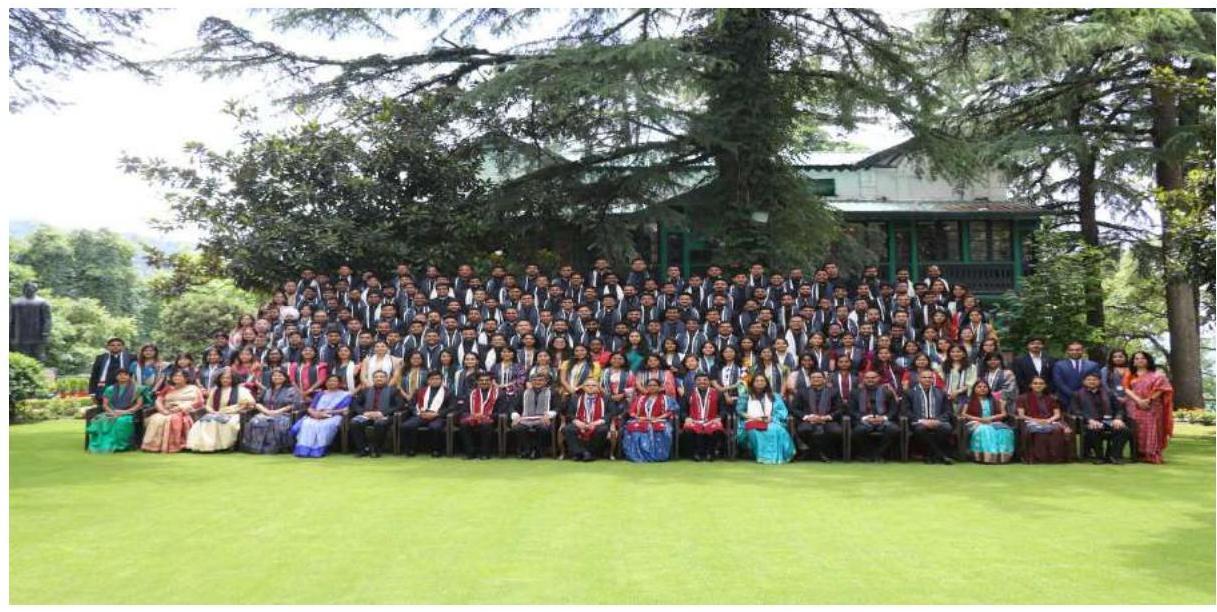
Valedictory of IAS Phase II (2022 Batch)
8.1.28. State-wise breakup of participants in IAS Phase II (2020 batch)
| Participants from the State of | Male | Female | Participants |
|---|---|---|---|
| AGMUT | 06 | 06 | 12 |
| Andhra Pradesh | 08 | 03 | 11 |
| Assam-Meghalaya | 04 | 04 | 08 |
| Bihar | 05 | 02 | 07 |
| Chhattisgarh | 04 | 03 | 07 |
| Gujarat | 04 | 04 | 08 |
| Haryana | 04 | 01 | 05 |
| Himachal Pradesh | 04 | 00 | 04 |
| Jharkhand | 05 | 01 | 06 |
| Karnataka | 07 | 01 | 08 |
| Kerala | 06 | 03 | 09 |
| Madhya Pradesh | 07 | 01 | 08 |
| Maharashtra | 07 | 03 | 10 |
| Manipur | 01 | 00 | 01 |
| Odisha | 04 | 01 | 05 |
| Punjab | 03 | 01 | 04 |
| Rajasthan | 04 | 02 | 06 |
| Royal Bhutan Civil Service | 02 | 01 | 03 |
| Sikkim | 00 | 01 | 01 |
| Tamil Nadu | 07 | 05 | 12 |
| Tripura | 04 | 00 | 04 |
| Telangana | 06 | 02 | 08 |
| Uttar Pradesh | 12 | 04 | 16 |
| Uttarakhand | 02 | 00 | 02 |
| West Bengal | 12 | 03 | 14 |
| Total | $\mathbf{1 2 8}$ | $\mathbf{5 2}$ | $\mathbf{1 8 0}$ |
8.1.29 Joint Civil Military Programme
| Course Name | $28^{\text {th }}$ Joint Civil Military Programme (08.06.2022 to 17.06.2022) |
|---|---|
| Course Coordinator | Ms. Disha Pannu, Course Coordinator |
| Associate Course Coordinator(s) | Shri Hari Lal Chauhan, Associate Course Coordinator |
| Programme inaugurated by | Shri Rajnath Singh, Hon’ble Defence Minister |
| Valedictory address by | Shri Srinivas R. Katikithala, Director, Lal Bahadur Shastri National Academy of Administration, Mussoorie |
| Composition of Group-Service represented and male/female breakup | Total $=47$ (Male- 45; Female- 02) |
| Programme meant for/Target Group | All India Services -IAS, IPS, IFoS, Central Civil Services- IFS, IC&CES, IRS, IRTS, IDAS, IDES Paramilitary Organizations- BSF, CRPF, NSG, ITBP, SSB Defence Services – Indian Army, Indian Navy, Indian Air Force, Coast Guard, Integrated Defence HQ, Raksha Sewa Staff College Intelligence-IB, Cabinet Secretariat Other Organizations – CBI |
| Seniority Level | Joint Secretary/Director to the Govt. of India Major General/Brigadier/Colonel in the Armed Forces |
8.1.30. Introduction of the Course
The Joint Civil-Military Training Programme on National Security is a flagship course of the Academy. It was introduced in 2002 consequent to the report of the Group of Ministers on reforming the National Security apparatus.
8.1.31. Objectives, Course Activities and Highlights
- To increase awareness levels about the different dimensions and elements of National Security and the various threats to the Indian state;
- To familiarize the participants with challenges to management of national security, external security environment and internal security environment;
- To create awareness on different dimensions of security (Cyber, Environmental, Economic, Energy) as well as threats to such security;
- To expose them to the imperatives of civil-military interface; and
- To provide an opportunity for the participants to interact and exchange ideas on the subject
The $28^{\text {th }}$ iteration of the JCM program was the first programme which infused the principles of “Mission Karmayogi”. The critical components of Mission Karmayogi are desiloization, inter-institutional collaborations and a shift from ‘rule’ to ‘role’. Accordingly, the main emphasis in the 28th iteration was on broadening the base and including more stakeholders in the training. Accordingly, officers from Indian Information Services and scientists from DRDO were also invited in the training for the first time. Widening the base of participants by inviting nominations from different sectors provided the requisite richness of experiences in the course and ensured a deeper understanding of the roles and challenges of other services
leading to breaking the silos. The presence of scientists from DRDO in the program also provided a platform for all stakeholders to engage with the Research and Development organization of the nation opening vistas for collaboration.
The instructional inputs comprised Ice-breaking sessions, lectures, Panel Discussions, Case Studies, Visit to Khalanga War Memorial, Treks, group discussions and films. The program attempted to juxtapose alternate view points on critical issues for deeper understanding of security challenges. It also aimed to harness the rich and diverse experience of the participants for more effective learning. The proximate objective of this program was to meet the perceived gaps in knowledge, skill and attitude in respect of comprehensive national security through appropriate training inputs. Besides the Academic inputs, ample opportunities were created for building camaraderie and life long bonds.
Group Photo of $28^{\text {th }}$ Joint Civil-Military Training Programme
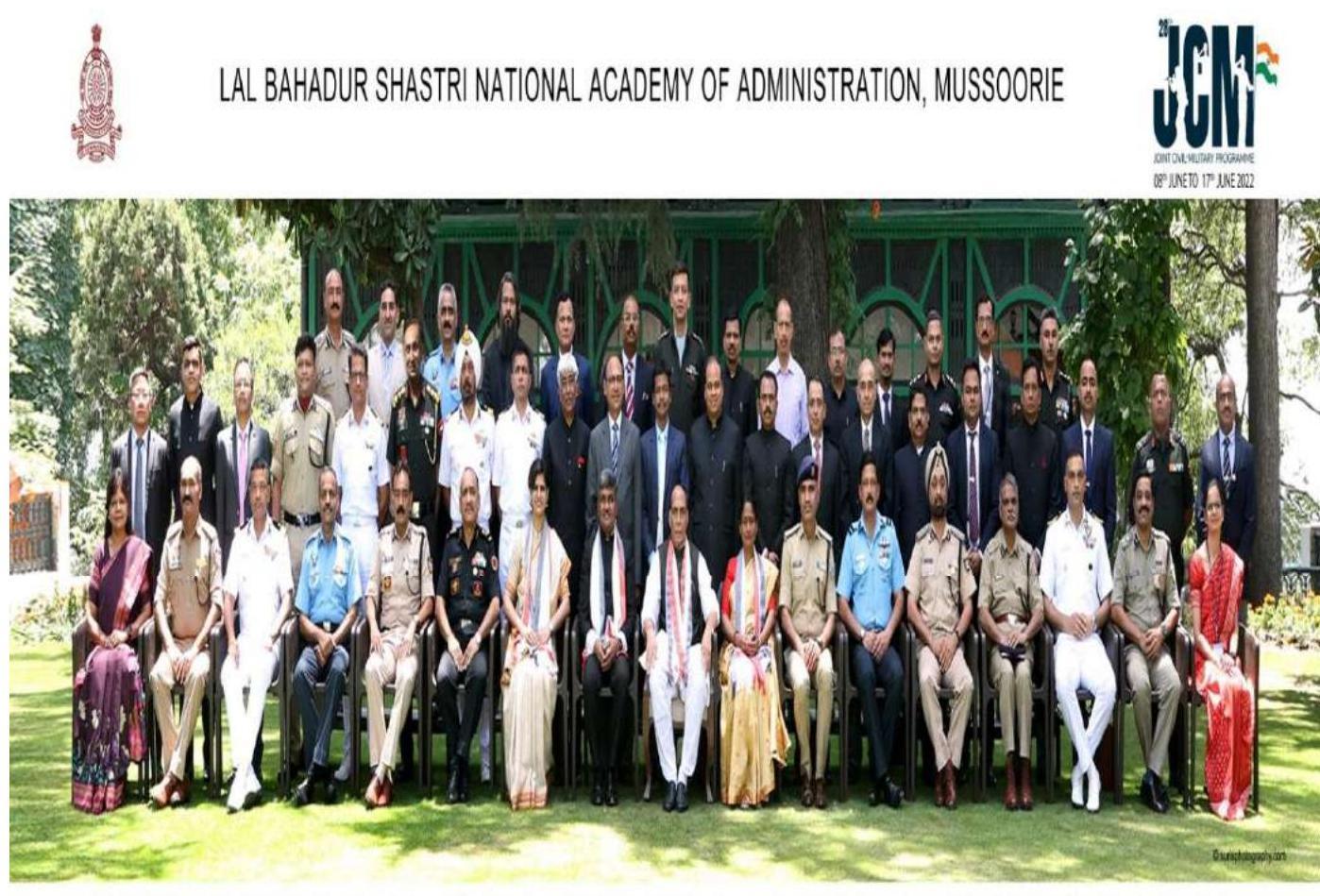
Service-wise breakup of participants in $28^{\text {th }} \mathbf{J C M}$
| Service | Female | Male | Total |
|---|---|---|---|
| BSF | 2 | 2 | |
| Cabinet Secretariat | 1 | 1 | |
| CRPF | 1 | 1 | |
| HQ IDS | 1 | 1 | |
| IAS | 2 | 2 | |
| IB | 1 | 1 | |
| IDAS/CBI | 1 | 1 | |
| IDES | 1 | 1 | |
| IFoS | 2 | 2 | |
| IFS | 1 | 1 | |
| IIS | 1 | 1 | |
| Indian Air Force | 3 | 3 | |
| Indian Army | 5 | 5 | |
| Indian Coast Guard | 2 | 2 | |
| Indian Navy | 3 | 3 | |
| IPS | 4 | 4 | |
| IRS (C&IT) | 4 | 4 | |
| IRS (IT) | 3 | 3 | |
| IRTS | 1 | 1 | |
| ITBP | 2 | 2 | |
| NSG | 1 | 1 | |
| SSB | 1 | 1 | |
| Scientist | 1 | 3 | 4 |
| Grand Total | 2 | 45 | 47 |
PART-B
8.1.32 Common Mid-Career Training Programme (CMCTP)
| Name of Course | $2^{\text {nd }}$ Common Mid-Career Training Programme |
|---|---|
| Duration | 27.10 .2022 to 31.10 .2022 |
| Course Coordinator | Ms. Radhika Rastogi, Special Director |
| Associate Course Coordinator | 1. Ms. Chhavi Bhardwaj, Deputy Director (Sr.) 2. Shri Abhiram G. Sankar, Deputy Director 3. Shri Romeo Vincent Tete, Assistant Director |
| Participants | Total: 130 – Male: 95; Female: 35 |
| Batches represented | 2002 batch officers from 18 services |
| Course inaugurated by | Shri Srinivas R. Katikithala, Director, LBSNAA |
| Valedictory address by | Joined the address by Hon’ble Prime Minister online who was addressing the Officer trainees of $97^{\text {th }}$ Foundation course. |
8.1.33. Course Aim
The Common MCTP aims at bringing together officers from different services who occupy important positions at senior levels in various government organizations, to promote collaboration and enhance leadership capacities. This programme strives to instill a sense of national pride, mission & camaraderie among the participants, who will lead their teams to learn, build \& deliver on national aspirations \& goals.
8.1.34. Course Objectives
- Discover and enhance next level leadership capacities;
- Strengthen the common understanding of national aspirations and challenges;
- Bring a stronger collaborative work ethic in their official functioning; and
- Ensure citizen centric efficient service delivery of the highest standard.
8.1.35. Course Design
The course was conducted by Dr. R. Balasubramaniam, Member, Capacity Building Commission. The theme of the course was ‘Exercising enlightened leadership’. The day wise topics were – Understanding Leadership and Authority, Understanding ‘Self’ and ‘Others’, Adaptive vs. Technical Challenges \& Enlightened leadership – A New Framework for Leadership. On the fifth day, a panel discussion on digital governance was organized with some of the participants as panelists.
The participants were required to complete the online course -“Digital Governance” before coming to the Academy. This provided a common platform to all the participants to approach a national challenge and to discuss various means and opportunities to achieve this goal.
The second Common Mid-Career Training Program was designed to de-siloize the senior leadership in government and create a shared national vision. It aimed to forge a strong Civil leadership at the policy making level equipped with the tools to lead their organization to learn and adapt to various challenges and pursue excellence.
This is the first attempt to introduce the idea of well-being into the training course at the Academy. The five day training programme was designed to focus on the physical and mental well-being of the participants. Each day began with yoga practice in the morning followed by a millet based pro-biotic drink. The menu was specially curated on the principles of Ayurveda and consisted of ‘satvik’ dishes to promote detoxification. The health parameters such as blood pressure, blood sugar, weight of the participants before and after the five day regime showed positive impact on the health of the participants especially for those suffering from disorders like diabetes, hypertension, and digestion. Nature Walk to George Everest was organized which was well received by the participants.
8.1.36. Mid-Career Training Programme Phase IV for IAS Officers
| Name of Course | $16^{\text {th }}$ Round of Phase-IV (MCTP) |
|---|---|
| Duration (Specify Dates) | 18.07.2022 to 12.08.2022 |
| Name of Course Coordinator | Ms. Radhika Rastogi |
| Names of other members of Course team | Shri Vizay B. Vasanta, Ms.Anandhi, Dr. Sunita Rani, Dr. Sanjay J. Joshi and Shri Romeo Vincent Tete |
| Number of participants | Total Male Female $94 \quad 78 \quad 16$ |
| Batches which participated | Officers of 2000, 2001, 2002, 2003, 2004, 2005, 2006 and 2007 Batches |
| Course inaugurated by | Dr. C. Chandramouli, Former Secretary to Government of India |
| Valedictory Address by | Shri Pema Khandu, Hon’ble Chief Minister, Arunachal Pradesh |
8.1.37. Course Aim
To equip officers who have completed 14 to 16 years of service and effective transition to policy formulation and better implementation.
8.1.38. Course Objectives
- Appreciate the role of political economy and institutions in public policy and governance;
- Understand the process of public policy formulation, analysis, implementation and evaluation;
- Apply tools of policy analysis to better understand and solve policy problems; and
- Strengthen individual leadership and negotiation skills.
8.1.39. Week-wise design of the Course
- Inputs based on previous three years’ End of Course Reports and Session-wise feedback
- Aimed at leveraging on participants experience and knowledge and peer to peer learning
- Interactive and participative
- Attempt to provide strategic and global perspective.
- Mix of speakers- academicians, senior officers, grassroots practitioners, industry: National and International.
Broadly, the course included the following thematic areas:
Week 1
- Economics for Public Policy
- The Last Mile-Turning Public Policy Upside Down
- Career Progression
- Maternal and Child Health & Nutrition
- Future Policy Making
- Urban Transport
- Urban Policy
- Procurement in Government – Policy Challenges
- Disaster Management
Week 2
- Rationale for Public Policy
- North-East Integration
- Economic Utility of Agro Commodity Derivatives
- Overcoming Challenges of the Active Borders of Jammu, Kashmir \& Ladakh
- Cyber Security
- Facilitated Conversation
- Final Lecture: Facilitated Conversations
- EPoD India – Policy Evaluation
- Importance of Art \& Culture
- Education
Week-3
- Disinvestment
- Environment and Climate Change
- Census
- Ethical Dilemmas of IAS Officers
- Engaging with Startups and Leadership
- Eat Right – Nutrition and well being
- Questionnaire
- Reflection Exercise
- Negotiation Module
- Policy Communication
- Ayush Integration
- Delhi EV Policy
- Maximizing the demographic dividend through National Education Policy 2020
- MSME
Week – 4
Though Phase -IV MCTP course typically has a week of Foreign Study Tour (FST), however, due to COVID related travel restrictions, physical travel to foreign Universities could not take place. In lieu of FST, to ensure that the participants do not lose out on learnings from global best practices in leadership, a Module on Leadership-Theory “U” was organized during the last week in collaboration with Presencing Institute, Cambridge, USA.
8.1.40. Evaluation of Participants
| Grade | No. of Participants |
|---|---|
| $\mathrm{A}+$ | 22 |
| A | 38 |
| $\mathrm{~B}+$ | 34 |
| Total | 94 |
8.1.41. Course Coordinator’s remarks
The Phase IV MCTP has been successfully completed which was scheduled from 18.07.2022 to 12.08.2022. The course was held completely in the Academy, and due COVID related precautions were taken.
Phase IV was designed with focus on public policy formulation and implementation. All the four weeks were spent by the participants at the Academy itself. There was no foreign study tour for the current programme.
The program sought to equip the participants with skills and attitude for continuous learning. Inputs were provided on various sectors, policy formulation and skills in negotiation, leadership and evidence-based policy design.
In addition to mandatory morning activity every day, the programme also included several cultural programs in which the trainees participated with great enthusiasm. Short Treks,
sports and games were also organised. The participants were evaluated based on the individual case studies written by them and Group presentations on various policy challenges.
8.1.42. Financial Statement of LBSNAA
Budget allocation of LBSNAA is made under “Demand No.074-Ministry of Personnel, Public Grievances & Pensions”. The provision includes establishment related expenditure under Non-Scheme (Revenue). Infrastructure related expenditure is provided under Scheme (Revenue) and Scheme (Capital). The budget allocation is made for various core activities of the Academy that include training programme such as the Foundation Course, Refresher Courses, Mid-Career Training Programmes, etc. Allocations are made under Scheme (Capital) and Scheme (Revenue) for improvement of Infrastructure and up-gradation of essential facilities at LBSNAA.
The details of actual expenditure for 2020-21, 2021-22, 2022-23 and allocation for financial year 2023-24 is as under.
(Figure in thousands)
| S.No. | Non-Scheme(Revenue) | Actual Expenditure | Budget Allocation |
||
|---|---|---|---|---|---|
| 2020-21 | 2021-22 | 2022-23 (As on 23.01.2023) |
2023-24 | ||
| 1. | Salaries | 1,62,877 | 1,62,235 | 1,49,963 | 2,15,080 |
| 2. | Wages | 33,495 | 36,498 | 37,840 | 46,000 |
| 3. | Overtime allowance | 0 | 0 | 0 | 50 |
| 4. | Medical Treatment | 4,480 | 5,145 | 4,977 | 6,000 |
| 5. | Domestic travel expenses | 5,996 | 5,725 | 3,413 | 6,600 |
| 6. | Foreign travel expenses | 84 | 0 | 40 | 500 |
| 7. | Office expenses | 88,950 | 85,528 | 87,727 | 90,000 |
| 8. | Rent, rates \& taxes | 1,998 | 1,964 | 1,574 | 3,000 |
| 9. | Publication | 350 | 636 | 382 | 650 |
| 10. | Other administrative expenses | 200 | 199 | 190 | 300 |
| 11. | Minor works | 1,500 | 1,500 | 0 | 2500 |
| 12. | Professional services | 1,22,500 | 1,48,796 | 1,55,242 | 1,70,000 |
| 13. | Grant-in-aid | 500 | 500 | 0 | 500 |
| 14. | Other Charges | 5,200 | 3,999 | 3,479 | 4300 |
| 15. | Salaries | 1,660 | 3,506 | 2,441 | 3920 |
| 16. | Overtime allowances | – | 0 | 0 | 50 |
| 17. | Medical treatment | 31 | 134 | 95 | 250 |
| 18. | Other Charges (Inf. Tech) | 597 | 596 | 560 | 600 |
| 19. | Swachhta Action Plan | 597 | 593 | 432 | 700 |
| 20. | Professional Services | 9,000 | 59,999 | 54,523 | 65,000 |
| Total (Non-Plan) | 4,40,015 | 5,17,553 | 5,02,878 | 6,16,000 |
| 21. | Scheme (Revenue) | $1,10,000$ | $1,14,000$ | $1,15,484$ | $1,20,000$ |
|---|---|---|---|---|---|
| 22. | Scheme (Capital) | $2,84,400$ | $2,45,000$ | $1,77,091$ | $3,67,900$ |
| Grand Total | $\mathbf{8 , 3 4 , 4 1 5}$ | $\mathbf{8 , 7 6 , 5 5 3}$ | $\mathbf{7 , 9 5 , 4 5 3}$ | $\mathbf{1 1 , 0 3 , 9 0 0}$ |
8.1.43. Research Centres in the Academy
The centres of the Academy have been established with an aim to provide an avenue for initiating research in key areas of governance both from policy as well as implementation perspectives. The research is supposed to feed into the training curriculum and provide it with fresh insights. These centres (like BNYCRS) are mostly funded either by line ministries, or are self-sustaining like the NGCC and CDM and collaborate with various national and international funding agencies. Various Research Centres have been set up for undertaking action-research on domains linked to Academy’s mandate and to feed into training inputs.
I. B. N. Yugandhar Centre for Rural Studies (BNYCRS)
Vision: “Help building and promoting an environment for training, research and policy debate on various issues of land, rural development, agrarian movement, livelihood, gender, and Panchayati Raj.”
Mission: “Develop training material and manuals for training of Officer Trainees, conducting research studies, organizing workshops and policy seminars, networking with partner organizations and professionals, ensuring publication of journals, research papers, reports etc. and disseminating research based knowledge with a view to help government agencies for policy initiation or changes, and exposing young professional to socio-economic realities of the country.”
Name of Centre Director Ms. Anandhi, IAS (Since 21.12.2020)
A Brief Background of the Centre
B. N. Yugandhar Centre for Rural Studies (BNYCRS), since its establishment in the Lal Bahadur Shastri National Academy of Administration, Mussoorie in the year 1989, has emerged as a leading resource/ establishment for training of Officer Trainees (OTs) of the Indian Administrative Service (IAS) and policy recommendations. It is mainly funded and supported by Department of Land Resources, Ministry of Rural Development, Government of India. Presently, it is registered as a scientific training and research society under the Indian Societies Registration Act, 1860. Director of the Academy is ex-officio Chairperson and he is authorized to appoint any Joint Director, Deputy Director or the Professor as the Centre Director.
The Centre conducts and promotes research, training and publications in the field of land reforms, land records management, wage employment, common property resources, displacement and rehabilitation, contemporary agrarian movements, and various issues of rural development, Panchayati Raj, etc. It fundamentally organises Field Study and Research Programme (Earlier known as Village-Visit Programme) for the OTs during the Foundational Course. Inputs on Participatory Rural Appraisal (PRA) Techniques are given to the OTs for assessing priorities of villagers to improve their socio-economic conditions. It is also involved in preparation and canvassing of schedules through OTs during their District Training. The data on tenancy, land ceiling, land records, land consolidation, wasteland management, homelessness, rural development programmes including poverty alleviation
programmes is captured and used by OTs for preparing socio-economic and land reform reports of assigned villages. Based on these reports the Centre has published a series of ‘Land Reforms in India’ and three series of ‘Socio-Economic Profile of Rural India.’ Other publications of the Centre include books, articles, research papers and most importantly the peer reviewed Journal of Land and Rural Studies, published by Sage Publications-New Delhi, is an international platform for disseminating and sharing opinions on the above-mentioned subjects. The Centre is also engaged in organizing workshops for regular exchange of views on land administration and rural development.
8.1.44. Activities during the Reference Year
A. Training Programme
The BNYCRS actively participates during the Foundation Courses and IAS Professional Courses organized by the Academy. During the reference year, the Centre undertook the following training activities:
i. IAS Professional Course Phase-I
Agriculture Module: The Centre designed and prepared a three-day ‘Agriculture Module’ for its introduction in the IAS Professional Course Phase-I of 2021 Batch. The reading material was finalized with support, guidance and directions received from the Director of the Academy, Additional Chief Secretary – Uttar Pradesh (Personal, Appointment & Agriculture Department, Lucknow), Country Director – India (ICRISAT, New Delhi).
The Module covered evolution of Agriculture in Post-Independence Era, the Green Revolution (GR), current issues of Climate Resilient Agriculture (CRA) \& Agro-biodiversity, administrative set-up of agriculture and allied sector departments in the States, Natural Resource Management (NRM), various schemes being run for development of agriculture and allied sectors, and issues in agriculture marketing. It was a complete package for practitioner administrators and a number of case studies were also included to help readers understand the problems, plausible solutions and strategic interventions needed for the development of agriculture in the country.
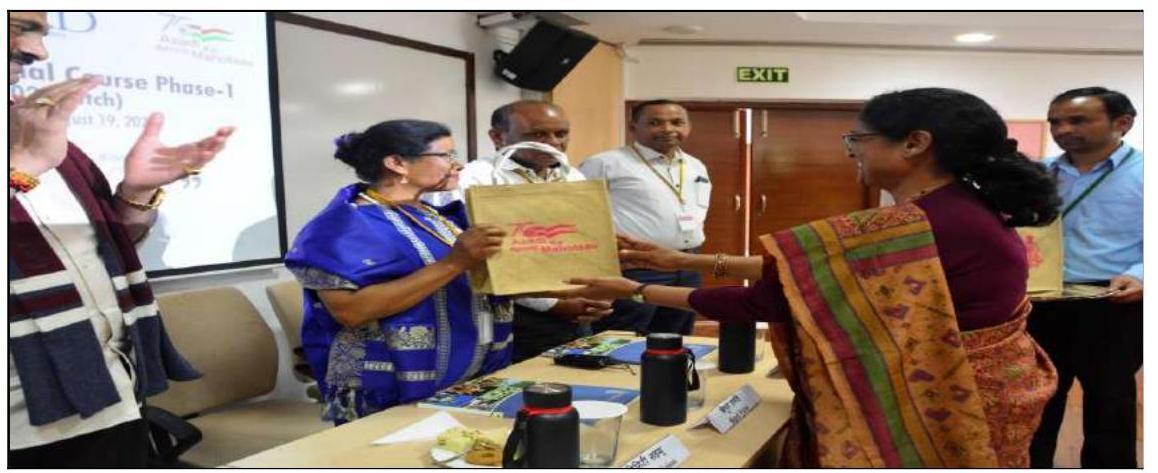
Special Director of the Academy felicitating the Padma-Awardees \& Progressive Farmers
Resource Persons from various States were invited for providing state-specific inputs related to agriculture and allied sector. Further, the Padma-Awardees and Progressive Farmers were invited for the first time for sharing their success stories and interventions they have made in the field.
Land Administration Module: The Centre revisited and revised the reading material conducted the Land Administration Module for Officer Trainees of IAS Professional Course Phase-I of 2021 Batch.

Secretary, DoLR delivering the Valedictory Address & OT of 2021 Batch felicitating him
Various topics of land administration and management were covered in this Module. Readings prepared for the Module gave a brief historical perspective of the land systems, land reforms \& related policy issues, and highlighted the land record system of the country. The current programme under which land records are being modernised in the country and the path that is to be traced in times-to-come for ease of citizen were thoughtfully included in this Module. Land acquisition that always need strategic thinking and action at the ground level was given due space duly incorporating the issues and complications of RFCTLARR. Similar topics related to FRA were gathered from the report of the Joint Committee formed by the MoEF and MoTA. The key-functions of revenue administration, and few important land revenue terms were covered as fundamentals. In fact, it was a good compilation for an officer going to handle land related issues in their professional career.
This time, the Centre also prepared the ‘Land Administration in States/ Union Territories History, Organizational Structure and Modernization of Records’ as a complement to the classroom sessions; thereby covering Andhra Pradesh, Bihar, Chhattisgarh, Goa, Gujarat, Karnataka, Kerala, Madhya Pradesh, Maharashtra, Manipur, Mizoram, Odisha, Punjab, Rajasthan, Sikkim, Tamil Nadu, Telangana, Tripura, Uttarakhand, Uttar Pradesh, West Bengal, Andaman \& Nicobar Island, Lakshadweep and Puducherry.
The Centre duly coordinated with the Survey of India, Dehradun and the District Survey and Settlement Office, Dehradun organised a ‘Hands-on Training on Survey Techniques’. This programme was focused on demonstrating traditional and modern survey equipment and their usability during revenue surveys.
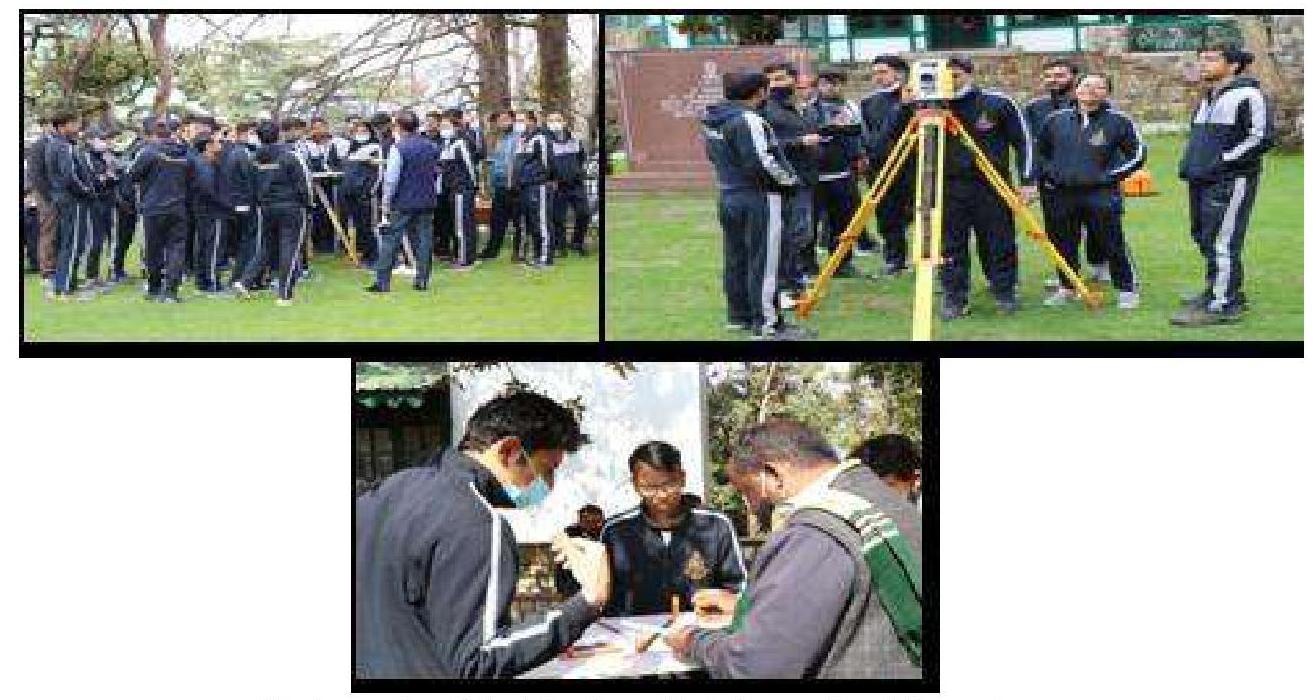
Photographs of the Hands on Training on Land Surveying
In order to ensure the successful conduct of the Module, the Centre invited Resource Persons from various States for ensuring that state-specific inputs are delivered to the OTs. This helped OTs to understand land related processes and procedure of respective cadre states in a comparatively more informed way. Shri Ajay Tirkey, IAS, Secretary, DoLR delivered the valedictory address.
8.1.45. IAS Professional Course Phase-II: District Training
Village Study Assignment (VSA): VSA is major part of the District Training Assignment given to IAS OTs during their training. During the reference period, the Centre had received 178 Socio-Economic (SE) and 177 Land Administration (LA) Reports from the IAS OT’s of 2020-22 Batch. These reports were scrutinised and evaluated by the Centre for coverage of existing situation, socio-economic & political analysis and poverty alleviation initiatives. These evaluations play a major role in identifying best reports for conferring awards. In times to come, these will be used for preparing ‘Socio-Economic Profile of Rural India’ and ‘Land Reforms in India’.
The District Training Manual on Village Study Assignment for the IAS OTs of 2021-23 Batch has been revised considerably.
Ethnographic Study of Rural Households (ESRH): Schedules executed and Reports/ Case Studies covered under the VSA not only present the development of village/ villagers as a community but also of select households. However, as most of the data is normally timepoint based, an Ethnographic Study is possible only when same villages and same households are covered at different time-points. It is with this vision, that the Centre has adopted and designed a research strategy from IAS Professional Course Phase-I of 2020 Batch onwards, thereby, allocating one OT per State the task of preparing an “Ethnographic Study of Rural Households (ESRH)”, instead of Case Study on “Poorest of the Poor”. Aim of this qualitative research is to capture ‘everyday lived realities’ of the households and understand the processes of change within the individual household and track ‘developmental’ changes in ‘community’ at large. Last year 15 OTs were assigned this study, and this year (i.e. during IAS Professional Course Phase-I of 2021 Batch) 12 OTs are chosen for ESRH.
iii. Foundation Course
Field Study \& Research Programme (FSRP): The Field Study and Research Programme (FSRP) comprises of three activities: classroom inputs, field study, and evaluation of reports and films submitted by the OTs. During the $97^{\text {th }}$ Foundation Course, following exercises were executed by the Centre:
Planning Phase of FSRP
- ‘Field Study and Research Programme Manual’ was redesigned as reference document for OTs.
- 75 villages of 75 districts (as per “Azadi se AntyodayaTak” Campaign) of 28 states (Andhra Pradesh, Arunachal Pradesh, Assam, Bihar, Chhattisgarh, Goa, Gujarat, Haryana, Himachal Pradesh, Jharkhand, Karnataka, Kerala, Maharashtra, Manipur, Meghalaya, Mizoram, Madhya Pradesh, Odisha, Puducherry, Punjab, Rajasthan, Sikkim, Telangana, Tamil Nadu, Tripura, Uttarakhand, Uttar Pradesh and West Bengal) were selected for the conduct of FSRP. Concerned District Magistrates were contacted and requested to coordinate the programme.
- Since Districts covered under ‘Azadi Se AntyodayaTak’ (ASAT) were chosen for conduct of FSRP, 17 schemes of ASAT were also allocated for a detailed study. Accordingly, the Centre prepared 17 booklets, thereby covering each of the schemes and facilitating OTs to study their implementation in saturation mode.
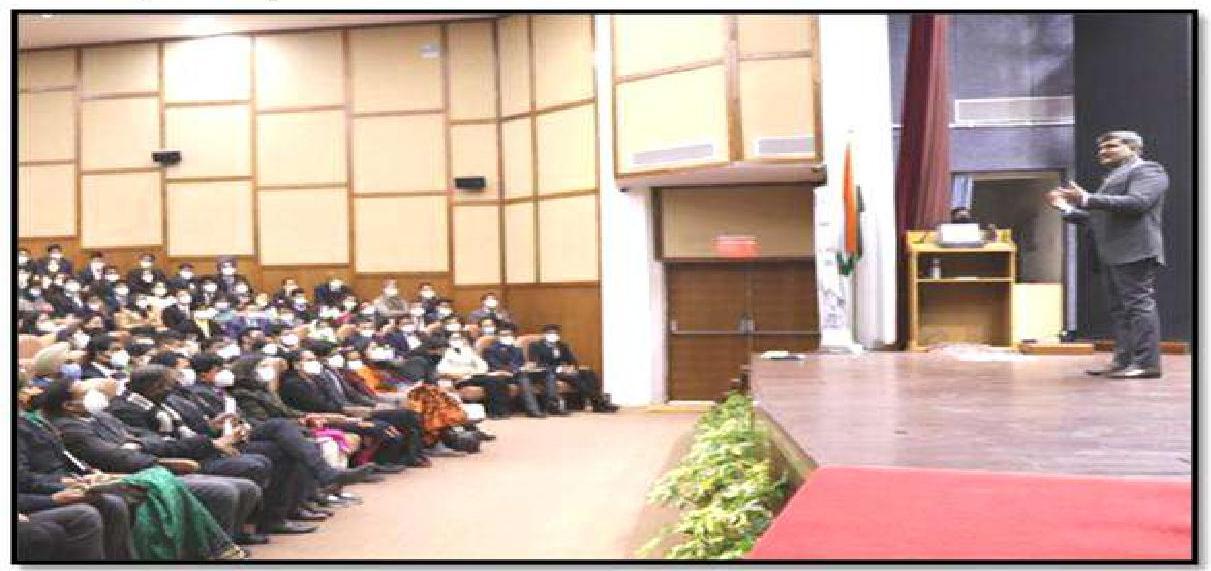
Director of the Academy addressing OTs during the Briefing Session of FSRP $\left(97^{\text {th }} F C\right)$
- Groups of OTs (6-8 members per Group) were formed with a Group Leader (GLs) for each District and respective village.
- OTs were given inputs on the Participatory Learning and Action (PLA) and Focus Group Discussions (FGD) techniques through class room teachings followed by mock exercises in the Academy itself.
Execution Phase of FSRP
It was ensured that during the conduct of FSRP, OTs would stay in respective villages, interact with villagers & grass-root functionaries and conduct PLA/ FGD exercises.
- An in-house control room was established to manage and coordinate the FSRP activities right from the departure of OTs from the Academy, during their stay and coming back.
- Each Group of OTs prepared a detailed Field Study and Research Report and a Film to depict activities performed with the villagers in the field and also to give an overview of rural life.
Completion Phase of FSRP
- All the Groups made presentations based on their field studies on ASAT schemes. These were evaluated by the Faculty of the Academy and experts from concerned Ministries/ Departments.
- The Field Study and Research Reports submitted by various Groups were evaluated by the Centre. These Reports are now part of the repository maintained by the Centre. Select Groups were awarded Gold Medal, Silver Medal and Bronze Medal on the basis of quality of their reports.
- Select Groups were also awarded suitable cash prizes on the basis of the quality and coverage in the Films produced by them. These Films were also evaluated by the Centre.
- A specially designed questionnaire on learning from the field study was also submitted by the OTs. The Centre coordinated this exercise as well. This has helped Academy to compile and prepare a Memoirs of Officer Trainees titled “Azadi Se AntyodayaTak: Through the Eyes of a Karmayogi”.
- While delivering the Valedictory Address to the OTs of $97^{\text {th }} \mathrm{FC}$, the Hon’ble President of India has appreciated the way FSRP was conceptualized, designed, organized and conducted in the field.
B. Research Studies – Proposed/ Worked on
| Sl. No. |
Title |
|---|---|
| 1. | Urban and Rural Land Management: Conflicts and Challenges in Karnataka and Tamil Nadu |
| 2. | Status of Land Ownership by Women after the enactment of the Hindu Succession (Amendment) Act, 2005 |
| 3. | Land Bank and Pending Issues: Maharashtra and Uttar Pradesh |
| 4. | Common Property Resources (CPRs): Practices, Laws and Challenges in Odisha & Madhya Pradesh |
| 5. | Land Governance in North-East States: Status and Impact of Policy Reforms and Regional Initiatives on Customary and Indigenous Laws (VI-th Schedule Areas) |
| 6. | Studying the Extent and Usage of Property Card as Legal Land Document |
C. Other Research Studies – Worked on
| Sl. No. | Title | Status |
|---|---|---|
| 1. | Status of Implementation of the Scheduled Tribes and Other Traditional Forest Dwellers (Recognition of Forest Rights) Act – 2006 \& Amendment Rule – 2012 in Maharashtra |
Draft report is under progress |
| 2. | Status of Implementation of the Scheduled Tribes and Other Traditional Forest Dwellers (Recognition of Forest Rights) Act – 2006 \& Amendment Rule – 2012 in Himachal Pradesh |
Draft report received. |
D. Workshops/ Seminar/ Exposure Programme – Proposed/ Worked on
Sl. No. Theme of the Workshops/Seminars/Exposure Programme
- Land Governance: Issues and Challenges
-
State-level Workshops on ‘Peer Learning of State Officials on Land Records Modernization: Status and Challenges and Exposure Visit to Learn from International Practice(s) on Land Titling’
Status: A letter has been sent to 17 States/ UTs informing them that the Centre is assigned the work of identifying best practices, challenges and capacity building of various states in land record modernization through inter-exchange of ideas. Thus, they need to appoint a Nodal Officer to carry forward this exercise. So far, Puducherry, Ladakh, Arunachal Pradesh, Daman and Uttarakhand have responded.
Meeting with officials of Uttarakhand is scheduled on $23^{\text {rd }}$ Jan 2022. Representatives from DoLR are very likely to attend the said meeting.
A discussion has already taken place with Department of Land Resources regarding International Exposure of high performing (DILRMP) States. A note is under preparation for selecting a country among Netherlands, Australia and Georgia.
3. National Workshop on ‘Role of Geospatial Technology in Improving Land Administration’
4. Regional Workshop on ‘Land Governance in North-East States: Status and Impact
of Policy Reforms and Regional Initiatives on Customary and Indigenous Laws (VI-th Schedule Areas)’
Status: The Centre has contacted various subject experts, and themes & subthemes of the workshop are almost finalized and tentative programme schedule (day-wise) has been prepared. Centre is in contact with various North-Eastern State Governments for deciding the venue. However, given the forthcoming elections in some of the States, requests from concerned States are being received to hold the workshop once the elections are over.
E. Publications: Current and Forthcoming
A long pending publication on ‘Land Survey’ could be completed. This publication has been given the title “Handbook on Land Survey in India”.
Hon’ble Prime Minister has released the above publication on 31.10.2022 at the Statue of Unity, Kevadia during ‘Aarambh 4.0’, a programme conducted under $97^{\text {th }} \mathbf{F C}$.
This edited publication covers the existing practices of land surveying and recording systems in 12 States (Andhra Pradesh, Assam, Bihar, Gujarat, Haryana, Karnataka, Kerala, Madhya Pradesh, Maharashtra, Rajasthan, Uttar Pradesh and West Bengal), and also highlights various models and technologies of modern methods of land surveying.
| Sl. No. | Title |
|---|---|
| Current Publications | |
| 1. | Hand Book on Land Survey in India |
| 2. | Journal of Land and Rural Studies (Vol. 10, Issue 2: July 2022) |
| Forthcoming Publications | |
| 1. | Impact Assessment of DILRMP of Punjab |
| 2. | Impact Assessment of DILRMP of Rajasthan |
| 3. | Impact Assessment of DILRMP of West Bengal |
| 4. | Impact Assessment of DILRMP of Kerala |
| 5. | Impact Assessment of DILRMP of Maharashtra |
| 6. | Impact Assessment of DILRMP of Mizoram |
| 7. | Impact Assessment of DILRMP of Goa |
| 8. | Impact Assessment of DILRMP of Lakshadweep |
| 9. | Socio-Economic Profile of Rural India (Series IV) |
| 10. | Impact Assessment of National Generic Document Registration System (NGDRS) in Punjab |
| 11. | Impact Assessment of National Generic Document Registration System (NGDRS) in Jharkhand |
| 12. | Journal of Land and Rural Studies (Vol. 11, Issue 1: Jan 2023) |
| 13. | Hand Book on Land Survey in India (Volume-2) |
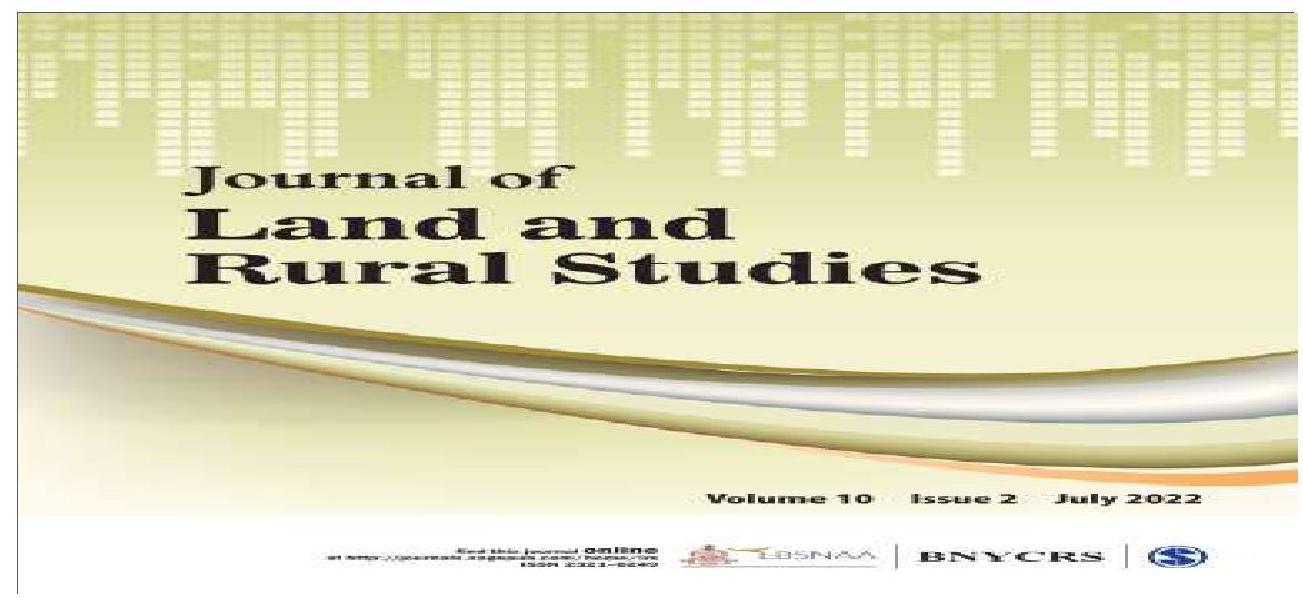
F. Journal of Land and Rural Studies (JLRS)
Journal of Land and Rural Studies, a peer reviewed journal, is being published by Sage Publications India Pvt. Ltd. on behalf of the Centre since 2012. This journal is a member of the Committee on Publication Ethics (COPE). It is available in Print (ISSN: 2321-0249) and Online (ISSN: 2321-7464). Its tentative circulation, national and international, is around 10,446 at present.
During the reference period the Centre has published Volume 10 Issue 2 (July, 2022) and selected papers/ articles for their publication in Volume 11 Issue 1 (January, 2023). Details of these are as follows:
Volume 10 Issue 2 (July, 2022): Article and book reviews included are:
- Impacts of Water and Energy Sector Reforms in Gujarat: The Case of Expansion of Micro Irrigation Schemes and Rationalisation of Agricultural by Power Tariff by P. K. Viswanathan, Chandra Sekhar Bahinipati and Bibhu K. Mohanty
- Magnitude and Determinants of Reverse Tenancy: A Study of Agriculturally Developed and Backward States by H. R. Sharma and Shakir Hussain Malik
- Dynamics of Land Use Trends and Patterns in Uttar Pradesh: A Sectoral Perspective by Shahab Fazal, Azharuddin S. K. and Deepika Vashishtha
- Socio-ecological Dynamics Within Rural Settlements: Evidence from Mbire District in Zimbabwe by Innocent Chirisa and Verna Nel
- A Study on ‘Dharani Portal’ and Its Transformative Impact in Khammam District, Telangana by K. Varun Reddy
- Reinforcing Exclusions: Caste, Patriarchy and Land Reforms in India by Prashant K. Trivedi
- Fostering Ecosystem Services for Mitigating Climate Change and Sustaining Food Production Systems in Developing Economies by Egbe B. Etowa, Emmanuel B. Effa, Ugochukwu I. Nzogbu and Evilla Olabiyi Badiru
- Book Review: Robert Home, Land Issues for Urban Governance in Sub-Saharan Africa by Taiwo Oladapo Babalola
Volume 11 Issue 1 (January, 2023): Article and book reviews selected for publication are:
- Land Alienation and Subversion Strategies on Land Rights: Perspectives from Attappady by K. A. Manjusha and Bipin Kishore Jojo
- Monitoring Culturable Wastelands Using Satellite Images in A Part of Tarai Region of Uttar Pradesh by Ranjeet Singh Verma, Amit Kumar Singh, Manisha Mishra and Alok Mathur
- From Colonial to Neoliberal Regime: Understanding the Paradigms of Land Dispossession in India by Animesh Roy
- Factors Influencing Farm-Level Climate Adaptation Strategies of Smallholder Farmers in Rural Ghana by Richard Kofi Asravor
- Agricultural Risk Management and Production Efficiency among Peasant Farmers in Taraba State, North Eastern Nigeria Maryanne by Odufa Egbeadumah, Elisha Apakeh Aboshi, Godiya Bulus and Mohammad N. Zarewa
- Native Land Right System About Tribal Women in Jharkhand: An Interpretative Analysis by Ambrish Gautam
- Book Review: Land Reforms to Land Titling; Emerging Paradigms of Land Governance in India by T. Prabhakar Reddy
Special Efforts: From 2021-22 onwards the Centre has started publication of Dissertations submitted by the Officer Trainees in partial fulfillment of the requirements for the completion of IAS Professional Course Phase-II. Awarded Dissertations are abridged and re-written by the concerned Officer Trainees in the form of research papers for their publication in the Journal. So far following papers based on Dissertations have been published:
- The Process and Shortcomings in Paddy Procurement: A Case Study of Bhandara District of Maharashtra by Minal Karanwal
- A Study on ‘Dharani Portal’ and Its Transformative Impact in Khammam District, Telangana by K. Varun Reddy
Dashboard and Digitization of Old Reports
During the reference year, the BNYCRS continued an IT Project with following objectives:
- Creating a single digital repository of the Socio-Economic (SE) Reports and Land Reforms (LR) Reports through digitization of the Reports and the filled-in Schedules submitted by Officer Trainees of various Batches.
- Creation of a well-structured user-friendly Dashboard and database; thereby facilitating administrators in decision making and encouraging researchers/ academicians to utilise it for future research
Idea is to facilitate Administrators in examining the impact of development schemes in their region (State/ District/ Village). They may like taking strategic decisions for better implementation (if needed). At the same time, individual researchers, academicians, data scientists, etc. across globe would find it easy to cull out data for future research, and Institutions/ Universities with whom Academy or its Centres has undergone an MOU may be requested to access the data, conduct research and come out with policy suggestions.
II. Centre for Disaster Management (CDM)
| Shri Abhiram G. | Deputy Director & Director, Centre for Disaster Management (CDM) Lal Bahadur Shastri National Academy of Administration (LBSNAA), Mussoorie |
|---|---|
The Centre for Disaster Management (CDM) is a research and training Centre and a unit of Lal Bahadur Shastri National Academy of Administration (LBSNAA), Mussoorie, Department of Personnel \& Training (DoPT), Government of India. It was established in the year 2003, and registered as autonomous society under Societies Registration Act (Reg.No-
199/2007-2008 Dt. 26.05.2007). The Centre is involved in training of civil service officers (the IAS and other Group-A civil services) at induction as well as at Mid-Career level in various aspects of disaster mitigation (policy, planning, programme formulation and implementation) through classroom sessions, case studies, experience sharing presentations, panel discussions, workshops, mock drills, besides undertaking action research projects. The Centre was also involved in publication activities such as documentation of best practices, development of case studies, books, and development of IEC materials in the area of Disaster and Emergency Management and Science and Technology.
Since 2007, the Centre is also engaged in conducting a number of tailor-made training programmes under the XI Five Year Plan for the Plan Scheme “National Programme for Training of Scientists & Technologists working in the Govt. Sector” in collaboration with the Department of Science \& Technology, Govt. of India, New Delhi. Hundreds of scientists and technologists across the country have got exposed to the training environment of this premier institute with its unique pedagogical approach. The Centre was supported by the ministry of Home affairs since 2012-13. The CDM has been receiving support from National Disaster Management Authority (NDMA), Government of India, and New Delhi under the Project entitled “Capacity Building on Disaster Management for IAS / Central Civil Services Officers”.
A. Inputs on major initiatives/ achievements of CDM for the development and management of Human Resources
CDM, LBSNAA has successfully conducted the following training programmes for IAS/ Central Civil Services Officers, Scientists \& Technologists working in the government sector.
1. 3 days Annual Joint Training Programme on “Disaster Risk Management” for officers belonging to the IAS/ IPS/ IFS (16.11.2022 to 18.11.2022)
| Programme meant for/ target group |
IAS/ Central Service Officers in India (Secretary/ Joint Secretary (DM department), District Magistrates/ Deputy Commissioners, Additional District Magistrates/ Additional Deputy Commissioners, Sub-Divisional Magistrates from multi-hazard prone districts) |
|---|---|
| Course coordinator |
Shri Abhiram G. Sankar IAS, Deputy Director \& Director, CDM, Lal Bahadur Shastri National Academy of Administration |
| Associate Course coordinator |
Dr. Pankaj Kumar Singh, Associate Professor, CDM, Lal Bahadur Shastri National Academy of Administration |
| Course Inaugurated by |
Shri Srinivas R Katikithala, IAS, Director, Lal Bahadur Shastri National Academy of Administration Shri Abhiram G. Sankar IAS, Deputy Director \& Director, CDM, Lal Bahadur Shastri National Academy of Administration |
| Valedictory Address by |
Smt. Radhika Rastogi, IAS, Special Director, Lal Bahadur Shastri National Academy of Administration Shri Abhiram G. Sankar IAS, Deputy Director \& Director, CDM, Lal Bahadur Shastri National Academy of Administration |
| Total no. of Participants |
Total: 15 (Gentlemen-15) |
The 03 (three) day Annual Joint Training Programme on “Disaster Risk Management” for officers belonging to the IAS/ IPS/ IFS was organised from 16 -18 November 2022, at Kalam Hall, Indira Bhavan, LBSNAA, Mussoorie. The programme was a part of the ‘Azadi
Ka Amrit Mahotsav’, commemorating 75 years of India’s Independence, designed especially for the IAS/IPS/IFS Officers the different states of India. The three-day training programme was organised by the Centre for Disaster Management (CDM), Lal Bahadur Shastri National Academy of Administration, Department of Personnel & Training (DoPT), Government of India in association with Odisha State Disaster Management Authority (OSDMA), Government of Odisha, under the National Disaster Management Authority (NDMA), Government of India scheme titled, “Capacity Building on Disaster Management for IAS/ Central Civil Services Officers”.
Aim and Objectives of the training programme:
The main aim of this training programme is to achieve the Vision stated in the National Disaster Management Plan, 2019 to “Make India disaster resilient across all sectors, achieve substantial and inclusive disaster risk reduction by building local capacities starting with the poor and decreasing significantly the loss of lives, livelihoods, and assets in different forms, including economic, physical, social, cultural, and environmental while enhancing the ability to cope with disasters at all levels”.
The specific objectives of this training programme are:
- To familiarize the participants with challenges and strategies to disaster risk management (focusing on heatwave, cloud burst, flash flood and forest fire, etc.).
- To provide an opportunity for the participants to interact and exchange ideas on the subject.
- To expose them to the imperatives of Inter-services synergy.
- To increase awareness of the different dimensions and elements of Disaster Management.
- Conforming to the national legal mandates – the DM Act 2005 and the NPDM 2009 .
- Coherence and Mutual Reinforcement for DRR of the Post-2015 Global Frameworks.
- Prime Minister’s Ten Point Agenda for DRR articulating contemporary national priories.
- Social inclusion as a ubiquitous and cross-cutting principle.
- Mainstreaming DRR as an integral feature.
Broad Themes:
The programme was designed to provide orientation to the officers on the following thematic areas through presentations on best practices and learnings in disaster risk mitigation and management by administrators, area experts, experience sharing.
- Prevention/Mitigation: Capacity Building; Understanding Risk; Tracking Risk Reduction Measures; Disaster Risk Reduction: Planning (Structural \& Non-structural measures); and Resource Management.
- Preparedness \& Planning: Risk Forecasting \& Forecast Based risk Communication: Early Warning; Evacuation; Perspective DMP Planning: Contingency Planning \& Resource Mobilization; and Monitoring.
- Response: Community Based Disaster Response; Search \& Rescue; Inter-Agency Coordination; Disaster Database; Loss \& damage assessment; Emergency Relief (Food, Water, Healthcare, Medicine, Shelter, Trauma Care); Restoration of Services.
- Build back Better in Recovery, Rehabilitation and Reconstruction: Mainstreaming Disaster Risk Reduction and Climate Change Risk Management; Community
Recovery (Psychological and Social & Economic Recovery); Effective Implementation; Investing in DRR- Structural \& Non-Structural Measures.
Outcome of the training programme:
This programme will be able to strengthen the existing system of disaster management by fostering structured interface between All India Services for a shared understanding of Disaster Risk Reduction and to improve coherence between field level administrators for better risk management and in striving to achieve the national goals and can also enhance the degree of camaraderie amongst the various services as well as improve cohesiveness in their functioning which would led to improve governance.
2. 4 day Specialized Training Programme on Disaster Risk Reduction \& Management (26.09.2022 to 29.09.2022) at Itanagar, Arunachal Pradesh
| Programme meant for/ target group | APCS officers, DDMOs and Nodal officers of other departments |
|---|---|
| Course coordinator | Shri Abhiram G. Sankar IAS, Deputy Director \& Director, CDM, Lal Bahadur Shastri National Academy of Administration |
| Inaugurated by | Shri Pema Khandu, Hon’ble Chief Minister of Arunachal Pradesh Sh. Tage Taki, Minister Agriculture, Horticulture, AH \&Vety, Dairy Development, Fisheries, Arunachal Pradesh Shri Srinivas R. Katikithala, IAS, Director, Lal Bahadur Shastri National Academy of Administration Shri Dharmendra, IAS, Chief Secretary of Arunachal Pradesh Shri Dani Salu, IDAS, Secretary of Disaster Management, Arunachal Pradesh Shri Abhiram G. Sankar IAS, Deputy Director \& Director, CDM, Lal Bahadur Shastri National Academy of Administration Shri KomkarDulom, Director, SDMA, Arunachal Pradesh Dr. Ekta Uniyal, Assistant Director, Lal Bahadur Shastri National Academy of Administration |
| Valedictory Address by | Shri Dani Salu, IDAS, Secretary of Disaster Management, Arunachal Pradesh. Shri KomkarDulom, Director, SDMA, Arunachal Pradesh. Shri Abhiram G. Sankar IAS, Deputy Director \& Director, CDM, Lal Bahadur Shastri National Academy of Administration. Smt C. Wanglet, Deputy Director, SDMA, Arunachal Pradesh. Dr. Ekta Uniyal, Assistant Director, Lal Bahadur Shastri National Academy of Administration. |
| Total no. of Participants | Total: 96 |
Objectives of the Training Programme:
- To sensitize participants towards various aspects of Disaster Mitigation.
- To provide exposure to various tools and techniques for enabling community level disaster mitigation.
- To provide exposure on effects of disasters on various socio-economic sectors and livelihoods integrating.
- To provide exposure on Role of Science and Technology in Community level Disaster Mitigation Planning.
- To facilitate peer and involved learning to achieve the objectives of Sustainable Development Goals (SDGs) and Sendai Framework for Disaster Risk Reduction (SFDRR 2015-2030).
Thematic Areas:
- Disaster Risk Reduction (DRR)
- Participatory learning and action (PLA)
- Community-based Disaster Risk Mitigation (CBDRM) Planning
- Role of Technology in Disaster Mitigation
- Office Disaster Management Plan
- $2^{\text {nd }}$ Customized Training programme on “Disaster Risk Reduction & Management” to be trained 49 officers (Civil Service Officers of Arunachal Pradesh (APCS Officer) at LBSNAA, Mussoorie duration on 05.12.2022 to 31.12.2022 and disaster session on dated 07 to 08.12 .2022 \& 28.12.2022.
| Programme meant for/ target group |
Officers (Civil Service Officers of Arunachal Pradesh (APCS Officer) |
|---|---|
| Course coordinator | Shri Abhiram G. Sankar IAS, Deputy Director \& Director, CDM, Lal Bahadur Shastri National Academy of Administration |
| Associate Course coordinator |
Dr. Pankaj Kumar Singh, Associate Professor, CDM, Lal Bahadur Shastri National Academy of Administration |
| Total no. of Participants |
Total: 49 (Gentlemen-29; Ladies- 20) |
Objectives of the Training Programme:
- To sensitize participants towards various aspects of Disaster Mitigation.
- To provide exposure to various tools and techniques for enabling community level disaster mitigation.
- To provide exposure on effects of disasters on various socio-economic sectors and livelihoods integrating.
- To provide exposure on Role of Science and Technology in Community level Disaster Mitigation Planning.
- To facilitate peer and involved learning to achieve the objectives of Sustainable Development Goals (SDGs) and Sendai Framework for Disaster Risk Reduction (SFDRR 2015-2030).
Thematic Areas:
- Disaster Risk Reduction (DRR)
- Participatory learning and action (PLA)
- Community-based Disaster Risk Mitigation (CBDRM) Planning
- Role of Technology in Disaster Mitigation
- Office Disaster Management Plan
- Role of Technology in Community Level Disaster Mitigation for Scientists \& Technologists (25.07.2022 to 29.07.2022)
| Programme meant for/ target group |
Scientists working in the Government sector |
|---|---|
| Course coordinator |
Shri Abhiram G. Sankar IAS, Deputy Director \& Director, CDM, Lal Bahadur Shastri National Academy of Administration |
| Associate Course coordinator | Dr. Pankaj Kumar Singh, Associate Professor, CDM, Lal Bahadur Shastri National Academy of Administration |
|---|---|
| Course Inaugurated by |
Shri Srinivas R. Katikithala IAS, Director & Chairman, CDM, Lal Bahadur Shastri National Academy of Administration Dr.Srivari Chandrasekhar, Secretary \& Chief Guest in Inaugural session, Dept. of Science \& Technology, GoI, New Delhi Shri Abhiram G. Sankar IAS, Deputy Director \& Director, CDM, Lal Bahadur Shastri National Academy of Administration Dr. Ekta Uniyal, Assistant Director, Lal Bahadur Shastri National Academy of Administration |
| Valedictory Address by |
Shri Upendra Tripathy, IAS (Retd.), Honorary Principal Advisor (Education) to Hon’ble CM, Odisha \& Adviser, Odisha Adasha Vidyalaya Sangathan, Government of Odisha, Qr. No -2, VIII MR, UnitVI, Bhubaneswar- 751003 Shri Abhiram G. Sankar IAS, Deputy Director \& Director, CDM, Lal Bahadur Shastri National Academy of Administration Dr. Ekta Uniyal, Assistant Director, Lal Bahadur Shastri National Academy of Administration |
| Total no. of Participants |
Total: 29 (Gentlemen-26; Ladies- 3) |
Objectives of the Training Programme:
- To sensitize participants towards various aspects of Disaster Mitigation.
- To provide exposure to various tools and techniques for enabling community level disaster mitigation.
- To provide exposure on effects of disasters on various socio-economic sectors and livelihoods integrating.
- To provide exposure on Role of Science and Technology in Community level Disaster Mitigation Planning.
- To facilitate peer and involved learning to achieve the objectives of Sustainable Development Goals (SDGs) and Sendai Framework for Disaster Risk Reduction (SFDRR 2015-2030).
Thematic Areas:
- Disaster Risk Reduction (DRR)
- Participatory learning and action (PLA)
- Community-based Disaster Risk Mitigation (CBDRM) Planning
- Role of Technology in Disaster Mitigation
- Office Disaster Management Plan
5. In-house sensitization for modules (Environment and Climate Change with Disaster) on for $18^{\text {th }}$ round of MCTP (IAS Phase-III) courses:
- to discuss Climate change and changing thresholds;
- to deliberate on the mechanisms (tools, frameworks, methodologies, action plans, guidelines);
- to discuss emerging issues, Challenges and policies;
- to examine the adequacy of existing legal, institutional frameworks and recent developments;
- to identify the policies, governance, planning and coordination mechanisms for inclusive climate resilience;
- to collate information and exchange technical knowledge/ experiences and information for climate change mitigation and adaptation;
- to discuss learnings and recommendations for future course of action;
- to suggest future strategies, policies and options; and
- to facilitate peer and involved learning to achieve the objectives of Paris Agreement, Sustainable Development Goals (SDGs) and Sendai Framework for Disaster Risk Reduction (SFDRR).
Thematic Areas:
- Water security
- Biodiversity Loss & Ecological Imbalances
- Food security
- Climate Refugees
- Tectonic shifts in geopolitics
- Role of Technology
- Disaster Risk Reduction
Film: “2040” documentary film by Damon Gameau
Course coordinator:
Shri Nand Kumarum, IAS, Deputy Director (Sr.) \& Course Coordinator; Phase-III, Lal Bahadur Shastri National Academy of Administration
CDM: Coordinating:
Shri Abhiram G. Sankar IAS, Deputy Director \& Director, CDM, Lal Bahadur Shastri National Academy of Administration
Dr. Ekta Uniyal, Assistant Director, Lal Bahadur Shastri National Academy of Administration
Dr. Pankaj Kumar Singh, Associate Professor, CDM, Lal Bahadur Shastri National Academy of Administration
Dr.Pasala E. Rao, Research Officer, Centre for Disaster Management, Lal Bahadur Shastri National Academy of Administration
6. In-house sensitization modules on Disaster management for various courses:
CDM inducted various capacity building modules on Disaster Prevention/Mitigation, Preparedness \& Planning, Response \& Build Back Better in Recovery, Rehabilitation and Reconstruction to sensitize Officer Trainees of $97^{\text {th }}$ Foundation Course (FC), IAS Phase- I (2021 batch), IAS Phase-II (2020 batch), $18^{\text {th }}$ round of MCTP Phase- III and $16^{\text {th }}$ round of MCTP Phase- IV during the F.Y. 2022-23. The officers of the Foundation Course and Phase I are being provided in-depth training in enforcing the Epidemic Diseases Act, 1897, and the Disaster Management Act, 2005, Public health emergency management strategies along with best practices in policy intervention in the country’s efforts to manage the outbreak of the COVID-19 pandemic.
8.2. Parvatmala Himalayan \& North-East Outdoors Learning Arena 01.06.2022
8.2.1. Brief Note on Parvatmala Himalayan \& North-East Outdoors Learning Arena:
The Lal Bahadur Shastri National Academy of Administration, Mussoorie has been training and moulding officer trainees for over six decades. The Academy now aspires to also act as a knowledge repository and as a point of dissemination of various kinds of information relevant to civil servants and trainees. The Himalayas are not just a geographical feature, but, also a powerhouse of spirituality, culture, biodiversity, water security, national security and a source
of national pride. Similarly, the North-East Indian region is poised for economic growth and greater development given the government’s sharp focus on the area. LBSNAA is uniquely situated to craft the convergence of knowledge on the Himalaya and North-East India and educate civil servants and administrators on the same, and shape them to be effective agents of development.
a. Aims and objectives of the Parvatmala Learning Arena:
- To curate exhibits around North East India & the Himalayas, on themes such as physical, human and geopolitical using audio-visual media, photographs, panoramic murals, cyclorama/diorama overlaid with QR codes for a rich user experience.
- To present information pertaining to the history, administrative traditions, culture, geopolitical issues and ecology of the North East \& Himalayan system along with narratives of past explorations and contemporary issues.
- To sensitise about India’s North-East \& Himalaya in the context of the Look East/ Act-East Policy and other international conventions like UNFCCC, Sendai Framework on Disaster Risk Reduction etc. that place a special focus on these regions.
- To act as the base for designing and executing the Outdoors activities of the Academy, like Himalayan trek, Bharat Darshan, etc.
- To play a central role in curation of North-East Focus Courses (like the Induction course for Arunachal Pradesh PCS Officers, etc.).
- To house a state-of-the-art multi-purpose learning facility with disabled friendly accessibility measures.
$1^{\text {st }}$ Workshop on Preparation of a Road Map for Parvatmala Himalayan \& North-East Outdoors Learning Arena 01.06.2022
On 01.06.2022, the Parvatmala Himalayan \& North-East Outdoors Learning Arena and Centre for Disaster Management, Lal Bahadur Shastri National Academy of Administration conducted the Workshop on “Preparation of a Road Map for Parvatmala Himalayan \& NorthEast Outdoors Learning Arena”. The workshop was held at the premises of the Lal Bahadur Shastri National Academy of Administration in Mussoorie.
The workshop brought together 22 decision-makers and experts from various fields, representing National Council of Science Museums, Indo-Tibetan Border Police; Survey of India; Bombay Natural History Society and Army Adventure Wing; Uttarakhand Forest Department, Govt. of Uttarakhand; Indian Mountaineering Foundation; Centre for Inner Asian Studies, Jawaharlal Nehru University; Nandankanan Zoological Park, Govt. of Odisha; Indian Institute of Public Administration (IIPA); Ministry of Social Justice \& Empowerment, Govt. of India; National Science Centre and non-governmental organizations like The Rhino Foundation for Nature in North-East India, Himalayan Institute of Alternatives, technical agencies like EkStep Foundation and several eminent experts also participated in the workshop.
8.2.2. The workshop covered, the vast domain of the Himalayas and the North-East under the following themes:
1. Natural History
a. Flora \& fauna
b. Art, Customs \& Culture
c. Geography and geology
d. Climate change
e. Natural Resource Management – soil/water conservation, ecosystem services, etc.
2. Adventure and the Outdoors
a. Curation of activities for trainees like trekking, hiking, rock-climbing, rafting, etc.
b. Regimens for improvement of mental and physical fitness and acumen.
c. Field skills – map reading, use of GPS/GIS tools, wilderness medicine, first-aid, etc.
d. Equipping trainees for long expeditions and technical mountaineering.
3. Governance, Development and National Security
a. Approaching the borders-understanding the wholesome context of our settled border positions and its ramifications on governance.
b. Development in the Himalayan & North- East region- Strategies for effective administrative interventions.
c. Look-east and Act-east policy.
d. Impact of geopolitics on Natural Resource Management \& Cross-border trade.
e. Law \& order and Insurgency.
f. Major government interventions – ongoing, short and long-term strategies.
g. Major Sector-wise inputs – agriculture, tourism, horticulture, etc.
h. Disaster management.
i. Challenges and opportunities for enhancing livelihood opportunities
j. Role of tribal councils and Autonomous District Councils
k. Cross border trade and international sharing of resources – water, hydro-power, waterways, highways etc.
Dignitaries
- Shri Srinivas R. Katikithala IAS, Director, Lal Bahadur Shastri National Academy of Administration
Organizing Team
1. Shri Abhiram G. Sankar, IAS
Deputy Director \& Director Centre for Disaster Management, Lal Bahadur Shastri National Academy of Administration
2. Dr. Ekta Uniyal
Assistant Director, Lal Bahadur Shastri National Academy of Administration
3. Dr. Pankaj Kumar Singh
Associate Professor, Centre for Disaster Management, Lal Bahadur Shastri National Academy of Administration
4. Dr. Pasala Eswara Rao, Research Officer, Centre for Disaster Management, Lal Bahadur Shastri National Academy of Administration
$2^{\text {nd }}$ Workshop of Parvatmala
Himalayan \& North-East Outdoors Learning Arena 12.08.2022
On 12.08.2022, the Parvatmala Himalayan \& North-East Outdoors Learning Arena and the Centre for Disaster Management, Lal Bahadur Shastri National Academy of Administration conducted the $2^{\text {nd }}$ Workshop of “Parvatmala Himalayan \& North-East Outdoors Learning Arena” to discuss various actionable suggestions submitted by the thematic groups as part of the $1^{\text {st }}$ workshop held on 01.06.2022. The workshop was held at the premises of the Lal
Bahadur Shastri National Academy of Administration in Mussoorie and inaugurated by the Shri Pema Khandu, Hon’ble Chief Minister of Arunachal Pradesh.
The workshop brought together 20 decision-makers and experts from various fields, representing Government of Arunachal Pradesh; Ministry of Development of North Eastern Region (MDONER); Uttarakhand Forest Department, Govt. of Uttarakhand; Bombay Natural History Society (BNHS); Himalayan Environmental Studies and Conservation Organization (HESCO); Nehru Institute of Mountaineering (NIM); Indian Mountaineering Foundation (IMF); Indo-Tibetan Border Police (ITBP); Himalayan Adventure Institute; Survey of India; and Army Adventure Wing; Centre for Inner Asian Studies-Jawaharlal Nehru University; Indian Institute of Management – Indore and non-governmental organizations like Himalayan Institute of Alternatives and several eminent experts also participated in the workshop.
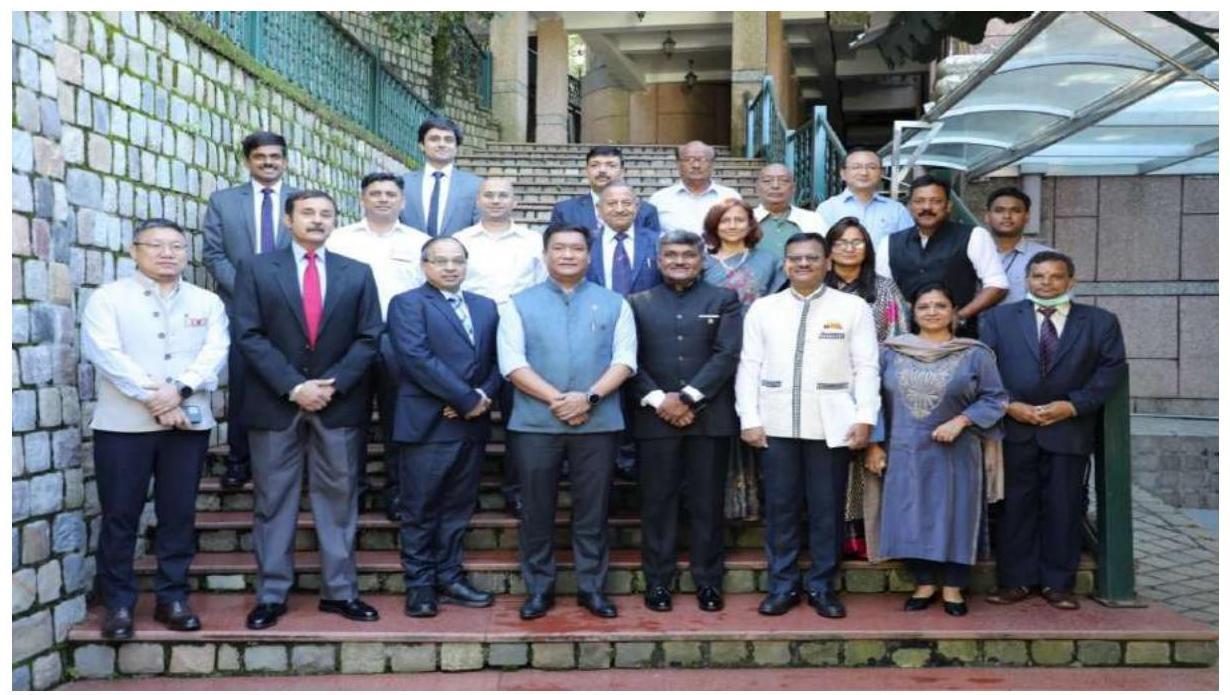
8.2.3. Agenda of the workshop
- The workshop structured around three themes specifically i.e., Natural History; Adventure and the Outdoors and Governance, Development and National Security.
Natural History
- Flora & fauna
- Art, Customs \& Culture
- Geography and geology
- Climate change
- Natural Resource Management – soil/water conservation, ecosystem services etc.
Adventure and the Outdoors
- Curation of activities for trainees like trekking, hiking, rock-climbing, rafting, etc.
- Regimens for improvement of mental and physical fitness and acumen
- Field skills – map reading, use of GPS/GIS tools, wilderness medicine, first-aid, etc.
- Equipping trainees for long expeditions and technical mountaineering
Governance, Development and National Security
- Approaching the borders-understanding the wholesome context of our settled border positions and its ramifications on governance.
- Development in the Himalayan & North- East region- Strategies for effective administrative interventions.
- Look-east and Act-East policy.
- Impact of geopolitics on Natural Resource Management \& Cross-border trade.
- Law \& order and Insurgency.
- Major government interventions – ongoing, short and long-term strategies.
- Major Sector-wise inputs – agriculture, tourism, horticulture etc.
- Disaster management.
- Challenges and opportunities for enhancing livelihood opportunities.
- Role of tribal councils and Autonomous District Councils.
- Cross border trade and international sharing of resources – water, hydro-power, waterways, highways, etc.
2. Follow-up of $1^{\text {st }}$ Parvatmala Workshop:
a. Discussion on how to make actionable, the suggestions submitted by the thematic groups as part of the $1^{\text {st }}$ workshop.
b. Identification and tabulation of resources like case studies, stories of success and failures from the field, technology-led innovations, movies, tool kits, books – digital and otherwise, that may be shared with course participants.
c. Identification of institutional resources who will work with the Academy on the above.
3. Learning opportunities for Phase-I IAS Trainees of 2021 batch:
a. The experts may frame questions for the Officer Trainees allotted to the Himalayan/N-E Cadres, for them to work upon and suggest solutions as a part of their district assignments.
b. Identification and sharing of resources to assist the Officer Trainees in this assignment during the next one year.
4. Activities during $97^{\text {th }}$ Foundation Course:
a. Key points to be addressed during the pre-trek \& village visit briefings.
b. Suggestions on modules related to wilderness medicine, first-aid, map-reading and plotting, survival skills, etc. to be provided in the form of pre-trek content.
c. Suggestions on outdoor pedagogy inputs (physical and mental) as part of trek preparation.
d. Designing a trek journal (to gain field administration perspectives in remote areas) that may involve:
i. Questionnaires for interaction with villagers and other government functionaries whom they may encounter in remote areas.
ii. Cataloguing of government schemes and initiatives that have yielded results in remote areas.
iii. Vulnerability mapping of villages, identification of potential hazards and probable solutions, local adaptations to disasters, etc.
iv. Creative spaces in the journal with maps, tables, etc. that trainees may use to sketch or plot the geographical/ biological information they gather during the field – such as the names of local communities, waterfalls, streams, landmarks, flora and fauna, monuments, etc.
v. Glossary of local terms.
vi. Glossary of information from District Digital Repository pertaining to freedom struggle \& AKAM of the concerned District.
e. Specific inputs on cultural orientation for the trainees going for village visits in the Himalayan/ N-E Districts.
5. Learning opportunities for Phase-I IAS Trainees 2022 batch (upcoming):
a. For the Bharat Darshan (Dec 2022 – Jan 2022), specific questionnaires have to be designed to collect data from the field visits that the trainees will undertake in Himalayan/N-E States, which in turn, can become long-term repositories of knowledge related to these States.
b. Eminent speakers on the regional issues to interact with Phase I Officer Trainees, especially, those allotted to Himalayan and N-E cadres – on topics such as the influence of geopolitics and cross-border happenings on day-to-day field administration within India, law & order, water management, welfare schemes, etc.
c. Celebrating culture of these States – identification of art forms, workshops on regional styles of painting/ sculpture, etc.
6. Induction Training of Arunachal Pradesh \& other N-E State PCS Officers:
a. Critical modules that are to be curated.
b. Assignments that may be given as part of evaluation to the trainees.
c. Suggestions for exposure visits to other parts of India.
Dignitaries
1. Shri Pema Khandu
Hon’ble Chief Minister of Arunachal Pradesh
2. Shri Dharmendra, IAS
Chief Secretary to the Government of Arunachal Pradesh, Itanagar
3. Shri Lok Ranjan, IAS
Secretary to the Government of India, Ministry of Development of North Eastern Region (M/o DONER), New Delhi
4. Shri Srinivas R. Katikithala, IAS
Director, Lal Bahadur Shastri National Academy of Administration
5. Ms. Radhika Rastogi, IAS
Special Director, Lal Bahadur Shastri National Academy of Administration
6. Shri Sonam Chombay, IRS
Commissioner-cum-Secretary to the Hon’ble Chief Minister of Arunachal Pradesh, Itanagar
Organizing Team
1. Shri Abhiram G. Sankar, IAS
Deputy Director \& Director, Centre for Disaster Management, Lal Bahadur Shastri National Academy of Administration
2. Dr. Ekta Uniyal
Assistant Director, Lal Bahadur Shastri National Academy of Administration
3. Dr. Pankaj Kumar Singh
Associate Professor, Centre for Disaster Management, Lal Bahadur Shastri National Academy of Administration
4. Dr. Pasala Eswara Rao
Research Officer, Centre for Disaster Management, Lal Bahadur Shastri National Academy of Administration
8.2.4. Inputs on initiatives taken for staff welfare, capacity building/ training
- Provided orientation to OTs on operation of wireless communication sets and GPS during Himalayan Study Tour $\left(97^{\text {th }} \mathrm{FC}\right)$.
- Conducted Fire Safety \& Search and Rescue Mock drill.
- COVID-19 State-wise Repository of Orders, Responses and Best Practices: During the COVID 19, the CDM played the steller role in being the central and nodal point for collection of best practices for mitigating COVID-19 and dissemination of learnings across the country through CARUNA (Civil Services Association to reach to support National Disasters) platform.
Publications
- Published case study books on Disaster Governance in India – ISSN: 978-81-928670-6-9, Series 8, 2023 (Progress)
- Published Journal on Disaster Response and Management – ISSN: 2347-2553, Volume-IX, Issue-1, 2023 (Progress)
- Published Toolkit on Disaster Risk Reduction for CIVIL SERVICE OFFICERS OF INDIA
- Developed Course Specific training and reading materials and distributed to the Officer Trainees of the above-mentioned training programmes:
a. Basics of Disaster Management
c. District Disaster Management Plan
d. Incident Response System
e. Public Health Emergency Management (COVID 19)
f. Role of Technology in Disaster Management
g. Role of Technology in Community Level Disaster Mitigation
h. Climate Change: Challenges and Response
Research/ Case studies
- Case study in Assam Flood 2022 (in progress)
- Lessons for Industrial Safety-A case of Vizag. Industrial Accident (LG Polymers Gas leakage), 2020 (in progress)
III. National Gender and Child Centre (NGCC)
The Centre was established in 1995, with the foremost aim of mainstreaming gender and child rights in policy, programme formulation and implementation in Government. NG&CC is a capacity-building centre under the aegis of the Academy, driven by the mandate of gender mainstreaming and its commitment to build synergies with different institutions, working on gender equality, child rights and women’s empowerment.
Working towards that end, the Centre, since its inception has been actively involved in designing and conducting thematic workshops, programmes and training including Training of Trainers for trainers and policy makers – both to enhance gender sensitization and also to increase capacities for gender analysis and gender planning. Since the Centre was established, the Centre has successfully ensured the mainstreaming of gender training into all courses at the LBSNAA viz. Induction training and in-service mid-career training programmes for IAS officers at all levels besides conducting programmes on myriad aspects for officers from All India/ Central Services.
In 2022-2023, the following projects/activities were undertaken by the Centre:
A. Workshop on “Gender Responsive Governance for Elected Women Representatives (MLAs)”- Under the AKAM Celebration, the Workshop on Gender Responsive Governance for Elected Women Representatives (MLAs) under “She is a Changemaker” Project (two rounds) for Women MLAs from Uttar Pradesh, Haryana, Himachal Pradesh, Uttarakhand, Jharkhand, Rajasthan, Odisha, Maharashtra, Chhattisgarh and Madhya Pradesh were organized by the National Gender and Child Centre (NGCC), Lal Bahadur Shastri National
Academy of Administration (LBSNAA), in collaboration with National Commission for Women, New Delhi. The workshops are designed with the thought of ‘Empowered Women Leadership, Empowered Democracy’. The primary objective of the workshop is to sensitize and assist the elected women representatives (MLAs) to build on their identified strengths, explore their values and increase their levels of self-awareness in a manner that would help them in managing diverse and challenging paths ahead. The aim is to enhance the leadership qualities and ensure ‘Sabka Saath, Sabka Vikas, Sabka Vishwas and Sabka Prayas’. The programmes were organized on:
- $22^{\text {nd }}-24^{\text {th }}$ June 2022 at Dharamshala.
- $21^{\text {st }}-23^{\text {rd }}$ September 2022 at Udaipur.
B. Ongoing Project:-
- Development of Online Course on Child Rights with a special focus on the Juvenile Justice Act- An online course is being designed and developed on the JJ Act for duty holders. Each week would cover one module, covering a specific dimension of the topic for the module. At the end of each week/module, there would be an evaluation to measure learning vis-à-vis the expected outputs of all modules that would be necessary for a certificate. The module will be hosted on the Gyan Portal of the Academy and going forward may be made available on the iGOT platform of the government as well.
- Development of an Online Course on Tackling the Nutrition Challenge in India with a focus on POSHAN Abhiyaan – To develop an online course module for policymakers and administrators to be uploaded on the iGOT platform. This course will help in the capacity building of policymakers and administrators for use of data and evidence to address the issue of malnutrition among women and children in India. NG&CC will develop the nutrition course module which will take participants through understanding the nature, causes and consequences of malnutrition among women and children and exploring ways of addressing malnutrition in all its forms. The course will highlight the gender-related causes of malnutrition throughout the life course.
- Social Experiment – Assessing Gender FRIENDLY Environment at Workplaces through the Gender Situational Analysis Toolkit- The National Gender and Child Centre (NGCC), Lal Bahadur Shastri National Academy of Administration (LBSNAA), is developing the Gender Situational Analysis tool to assess and check the institutionalization of gender equality and inclusivity into organizations, including in their policies, programs, projects and/or provision of services, structures, proceedings and budgets. This is a participatory approach, which will help to identify how gender inclusive the workplace/organization is. The objective of this exercise is to gauge the existing environments/ areas and deep dive into the granular aspects to analyze, identify and address issues of office design, recruitment, safety mechanisms and management practices, which may be facilitating gender-insensitive issues and stereotypes in office.
- Capacity Building Training Programmes for Elected Women Representatives:National Gender and Child Centre, Lal Bahadur Shastri National Academy of Administration, will be organizing a series of Capacity Building programmes for elected women representatives in collaboration with the National Commission for Women. The objective of the programme is to enhance the knowledge and understanding of women political members on gender mainstreaming. The $3^{\text {rd }}$ workshop is being organized in February 2023.
IV. Sardar Patel Leadership Centre (SPLC)
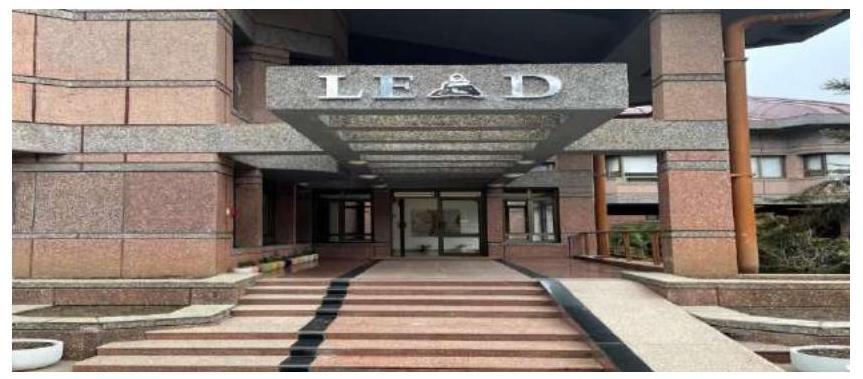
Sardar Patel Leadership Centre was inaugurated on $31^{\text {st }}$ October, 2021 by Hon’ble Union Minister of State for Science & Technology; Minister of State in the Ministry of Earth Sciences; MoS PMO, Personnel, Public Grievances, Pensions, Atomic Energy and Space, Dr. Jitendra Singh, and dedicated this centre to the nation at Lal Bahadur Shastri National Academy of Administration on the occasion of Rashtriya Ekta Diwas, marking the birth anniversary of Sardar Vallabhbai Patel.
The Centre aims to lay the foundation capacity building for future generations of Civil Servants so that they learn from the best practices of leadership across the world, while at the same time, they remain connected with their cultural ethos, values and roots. He added that Good governance needs good leadership skills among the field officers as well as officers at the policymaking level. The Sardar Patel Leadership Centre aims to be Resource Centre to provide continuous study and learning opportunities to Civil Servants of India
The objective behind this centre’s establishment is to enable a civil servant to constantly remain in touch with Sardar Patel Leadership Center, an entity that can provide them with upgraded skills and guidance for their own personal pathways.
The following leadership modules were conducted during the mentioned courses:
- $8^{\text {th }}-9^{\text {th }}$ June, 2022: A Leadership Module for Phase II of 2021 batch officers was conducted. There were 181 participants participating in the module. The objective of this leadership module was to provide inputs on basic negotiation skills to the participants. During this program, the participants learned about importance of negotiation skills in their professional life as a civil servant, assessment of their own style of conflict resolution, its strength and weaknesses, various types of negotiations and strategies to handle them.
- $18^{\text {th }}-22^{\text {nd }}$ July, 2022: As a part of the main objective of the Sardar Patel leadership Centre (SPLC), LBSNAA conducted a ‘Women in Leadership’ training programme for Women officers in Government. SPLC conducted the first exclusive leadership programme for Women Officers. The programme was based on the premise that Women in leadership can support inclusive development through numerous pathways. A total of 41 women officers from All-India Services, Central Civil Services, Armed Forces, Scientific Institutes and reputed Academic Institutions participated in this programme.
- $27^{\text {th }}$ July, 2022: A leadership module for Phase I of 2021 batch was conducted. 183 Officer Trainees participated in this module. The objective of this module was to help the participant learn about the importance of interpersonal relationships at work and handling various stakeholders in implementation of programs. They learned about the various ways of influencing different types of stakeholders.
- $22^{\text {nd }}-23^{\text {rd }}$ September, 2022: The Leadership Module was conducted for the 455 Officer Trainees of $97^{\text {th }}$ Foundation Course by outside experts and in-house faculty at the Academy. The objective of this module was to expose the trainees to basic leadership skills including understanding of the concept of leadership, impact of role models in our life, how to give effective feedback, role of an officer as a team member, importance of listening and verbal communication, etc.
- $27^{\text {th }}-31^{\text {st }}$ October, 2022: The third round of Common Mod-Career Training Programme (CMCTP), 2022 for 2002 batch officers was held for five days from October 27-31. The primary objective of the CMCTP is Leading to Learn, an opportunity to explore yourself “leader in you”. The programme is designed to desiolize Leadership to create a shared national version. There were 130 participants who participated in the five days long programme from the different services including the Indian Civil Services and Central Civil Services.
8.2.5. Facilities at the Academy
The Academy is well-equipped with good training infrastructure in terms of academic buildings, classrooms, hostels and other support infrastructure. The Academy has the following Academic and Administrative Blocks:
- Karmashila
- Dhruvshila
- Gyanshila
- Aadharshila
The Gandhi Smriti library is a treasure trove of resources containing over 1.90 documents, including books- 1.63,534, bound volumes of journals- 8679, audio cassettes-2109, video cassettes 1708 and CDs/DVDs- 8496 [contains lecture recordings, documentaries, movies (English, Hindi, regional)] and digital rare and old books – 6259 from the $19^{\text {th }}$ century. Accordingly, for accommodating the trainees and participants of various training programmes the Academy has seven hostels namely, Ganga, Narmada, Kaveri, Silverwood, Mahanadi, Happy Valley, Valley View and Monastery Complex with a total capacity of 375 rooms.
The Officers’ Mess can cater to around 500 people at three different locations. To encourage the trainees to take up physical activities, the Academy has a well-equipped Officers Club, Riding Ground and Shooting Range. The Medical Centre and AYUSH Centre are also functioning in the Academy to cater to the requirements of officers, staff and participants of different training courses.
In 2022, the following works were being undertaken through CPWD under the Capital scheme of the Academy to enhance the ambience of the LBSNAA campus to facilitate a better learning environment for the Officer Trainees & participants of senior courses:
- Construction of New Sports Complex: (Approved Budget: 1524.10 Lakh) (Work Completed) Inaugurated by Hon’ble Prime Minister of India on $17^{\text {th }}$ March, 2022 (Through Video Conference).
- Construction of Executive Hostel: Monastery Complex: (Approved Budget: 3348.57 Lakh) (Work Completed) Inaugurated by Hon’ble President of India on 09.12.2022.
- Construction of New Auditorium: (Approved Budget: 5376 Lakh).
8.3. INSTITUTE OF SECRETARIAT TRAINING AND MANAGEMENT
Introduction
8.3.1 The Institute of Secretariat Training and Management (ISTM) is imparting training to the officers of the Central/State Governments, Public Sector Undertakings & Autonomous Bodies. Originally set up with the objective of conducting foundational and in-service training programmes for Assistants and Section Officers of the Central Secretariat, the range of the activities of the Institute has increased exponentially over the last seven decades. In addition to the in-house training programmes, the Peripatetic Training provided by the Institute to the officials of State Governments and Union Territories in Behavioral Skills, Management Techniques, Financial Management and Office Management, is of particular significance. On specific request from Central Government Departments, Autonomous Bodies, Public Sector Organizations, the Institute also organizes special programmes addressed to the specific customer needs in different areas.
8.3.2 From the year 2007-08, ISTM is also involved in implementation of the Central Secretariat Service Cadre Training Plan (CSS-CTP) and from 2011 onwards Central Secretariat Stenographer’s Service Cadre Training Plan (CSSS-CTP), which envisages mandatory training programmes having linkages with career progression up to Director level officers.
E-learning Content Development
8.3.3. To reach a large number of Civil Servant of Central Secretariat Service and Central Secretariat Stenographers Services, ISTM has undertaken a task of creating high quality elearning content on core behavioural and functional competencies. The contents so created are being used in asynchronous, synchronous, and blended formats both in online and offline formats.
8.3.4. Status of e-learning courses developed and under development as on date is indicated below:
- Contents already published and available on iGOT platform: 90 hours
- Contents uploaded to iGoT and under review: 6 hours
- Contents under development by KDLL: 8 hours
- Contents developed through M/s FCS: 40 hours
- Contents under development through M/s FCS: 20 hours
- Contents developed in ISTM e-LMS: 162 hours
Organizing Courses/ Programmes on iGOT Karmayogi Platform
8.3.5. During the year 2022-23, more programmes have been organized under mandatory and demand driven categories of training, as compared to 2021-22.
| SN | Programme | Organized in iGOT Karmayogi Platform | |
|---|---|---|---|
| $2021-22$ | $2022-23$ | ||
| 1. | Mandatory in-service Cadre Training Programmes for Central Secretariat Service (CSS) |
37 | 48 |
| 2. | Mandatory in-service Cadre Training Programmes for Central Secretariat Stenographers’ Service (CSSS) |
18 | 43 |
| 3. | Demand-driven DAKSHTA Programmes | 2 | 21 |
Revised Pattern of Annual Training Plan 2022-23
8.3.6. The emphasis for Annual Training Programmes 2022-23 was to have more short duration and online training programmes to give wider coverage in core functional areas of administration. Accordingly, all non-cadre calendar training programmes, except some behavioural and ICT related topics, were conducted in online mode. This resulted in larger coverage and more participation. Against a target of 5700 participants for 2022-23, ISTM has already achieved 8216 by the end March, 2023 ( 525 Weeks 4 Days).
8.3.7. Details of Courses conducted during 2022 – 2023.
| Sl. No. |
Course Category | Number of Courses |
No of Participants |
No of Training Weeks & days (1 Training week $=5$ days) |
|---|---|---|---|---|
| 1 | CSS-CTP | 48 | 1696 | $256 \mathrm{~W} / 1280$ Days |
| 2 | CSSS-CTP | 43 | 1280 | $130 \mathrm{~W} / 650$ Days |
| 3 | DAKSHTA/RCBP | 22 | 472 | $22 \mathrm{~W} / 110$ Days |
| 4 | Calendar Courses | 85 | 2469 | 61 W 2 Days/ 307 Days |
| 5 | Non-Calendar Courses (OSP/CSP/PT) |
88 | 2299 | 55 W 4 Days/ 274 Days |
| Total | 286 | 8226 | 525 W 1 Days/ 2626 Days |
Number of Training Programmes Planned, Conducted and No. of Participants Trained during the Last three years
| Training Calendar Year (April-March) |
Target Planned (No of courses planned) |
Target Achieved (No of courses conducted) |
Number of Participants Trained | ||
|---|---|---|---|---|---|
| Group-A | Group B \& C | Total | |||
| $2019-20$ | 230 | 272 | 1431 | 6106 | 7537 |
| $2020-21^{*}$ | 224 | 100 | 284 | 3242 | 3526 |
| $2021-22 *$ | 226 | 232 | 1215 | 6640 | 7855 |
| $2022-23^{* *}$ | 241 | 286 | 1034 | 7192 | 8226 |
- Due to COVID-19 pandemic, less no. of courses were conducted during first quarter for the year 2021-22 and no courses were conducted during first quarter for the year 2020-21.
** No. of courses conducted as on 31.03.2023.
Addition of New Courses
8.3.8. ISTM has already been conducting workshops on important areas of functional competencies. New courses were introduced in the areas of Behavioral Competencies as well as data driven decision making in government. Workshops were also included in specific areas like Disaster Management and sensitization on issues relating to socio-religious minorities as per the directions of concerned authorities. ISTM conducted six courses on Vigilance Administration for PSUs and Autonomous Bodies at the behest of Central Vigilance Commission during the year. Following new courses were introduced during the year 2022-23:-
- Data Analytics using MS-Excel
- Workshop on Artificial Intelligence and Machine Language
- Handling Government Dashboards
- Anxiety Management & Mental Health at Workplace
- Workshop on Public Private Partnership
- Handling Social Media and Information Retrieval
- Sensitization of Govt. Functionaries on Social, Economic and Educational Conditions of Socio-Religious Communities (SRCs)
- Disaster Management and Crises Management
8.3.9 ISTM conducted five capacity building programmes of two days duration for liaison officers from different Ministries/Departments regarding preparation and maintenance of Reservation Roster. The first course was inaugurated by Secretary (Personnel) on 27.08.2022. The course was well received by the participants and ISTM is planning for another set of training on the subject.
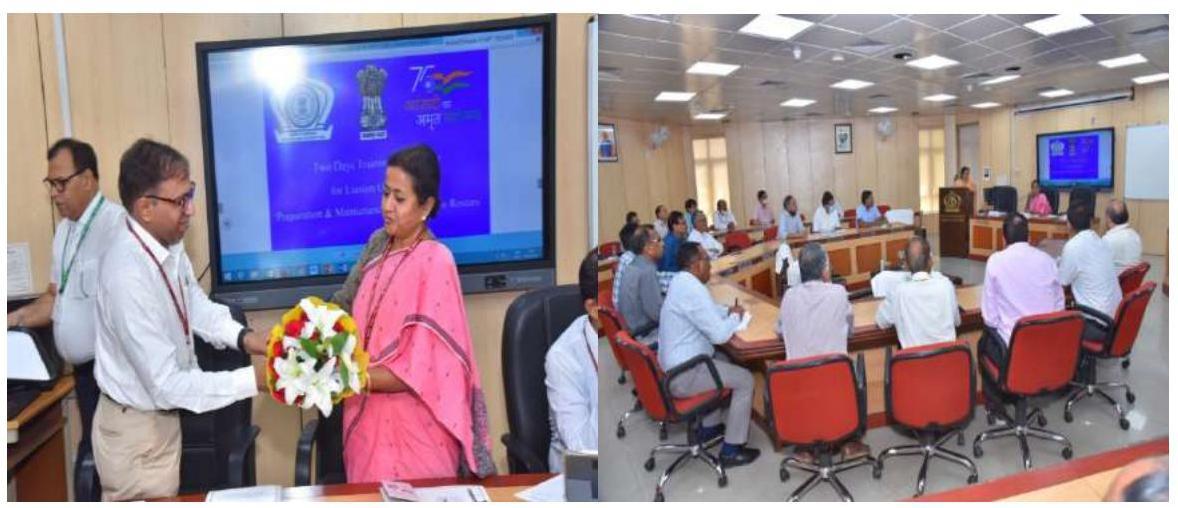
Centre of excellence/Competency Mapping
8.3.10. ISTM has been identified as the Centre of Excellence in the area of Competency Mapping of Government servants. ISTM leadership in collaboration with Training Division of DoPT remained instrumental in a launch of pre-competency mapping tool by Secretary, DoPT on 26.08.2021.
8.3.11. ISTM has organized twenty (20) one-hour handholding session with as many divisional heads and Officers working under them requesting tabulation of their roles, activities, competencies and knowledge resources. ISTM is leading a team of professionals and working with Capacity Building Commission to workout competency mapping in phased manner.
DAKSHTA Programme
8.3.12 Capacity Building Commission (CBC) has been setup as part of National Programme for Civil Service Capacity Building (NPCSC). The Commission has prepared Capacity Building Plans for selected MDOs and approached Institute of Secretariat Training and Management (ISTM) for conducting capacity building programmes, called DAKSHTA (Development of Attitude, Knowledge and Skills for Holistic Transformation of Administration) Programme.
8.3.13 ISTM has conducted 17 DAKSHTA programmes covering a total of 383 Group A and Group B officers. A large number of such programmes for other Ministries/Departments are scheduled to be conducted in the days to come. The Programme covers areas of core functional competencies for CSS officers including Noting \& Drafting, Preparation of
Cabinet Note, Public Procurement, advanced MS-Words and MS-Excel, Code of Conduct among others. Input on Behavioural Competencies required for being an effective and contributing team member are also provided.
8.3.14. All CSS Officers of SO/ASO Grades with more than three years of service completed will attend DAKSHTA programme. For this, the participants will have to first complete two-week online training in iGOT and consume ten topics of functional competency and one MS Office course. Thereafter, they will undergo one-week physical training at ISTM in which, in addition to doubt clearing sessions, topics of functional competencies will be covered through case studies and exercises. ISTM will provide training to over 6000 eligible ASOs/SOs of CSS cadre by conducting two DAKSHTA courses simultaneously every week.
Assistant Section Officers (Direct Recruit) Foundation Training Programme
8.3.15. The ASOs (DR) Foundation Training Programme aims to develop identified set of competencies, focusing especially on personality development as well as functional readiness of the ASOs to handle responsibilities in the Central Secretariat Following activities were organized at ISTM for ASO Probationers of 2019 Batch:
(i) INTERACTIVE SESSION OF MOS(PP) WITH ASO PROBATIONERS OF 2019 BATCH Date: 17.08.2022
An interactive session with Dr.Jitendra Singh, Minister of State (PP) was organized at ISTM, for ASO Probationers of 2019 Batch to encourage the newly joined entrants and familiarize them with the working of Government machinery. MoS (PP) interacted with the probationers and gave insights about work ethics, commitment to the organization and dedication towards service delivery.

(ii) ATTACHMENT WITH PARLIAMENTARY RESEARCH AND TRAINING INSTITUTE FOR DEMOCRACIES (PRIDE) Date of Visit: 01.09.2022 to 02.09.2022
Approximately 145 Assistant Section Officers (Probationers) of 2019 Batch attended a 2-day workshop on ‘Parliamentary Work Management’ during the Foundation Training Programme organized by Parliamentary Research and Training Institute for Democracies (PRIDE).

(iii) BLOOD DONATION CAMP Date: 14.09.2022 to 28.09.2022
Donating blood is an act of solidarity & generosity. Therefore, under the aegis of ‘Azadi Ka Amrit Mahotsav’, blood donation camp was organized with the help of AIIMS, New Delhi. Around 100 participants donated blood and contributed for this noble cause.

(iv) ESSAY / PRECIS WRITING COMPETITION
Date: 14.09.2022
Approximately 145 Assistant Section Officers (Probationers) of CGLE 2019 Batch participated in essay/ precis writing competition. The main objective of the competition was to hone the writing skills of the trainee officers by offering extra-curricular activities in order to make their Foundation Training interesting, engaging \& competitive.
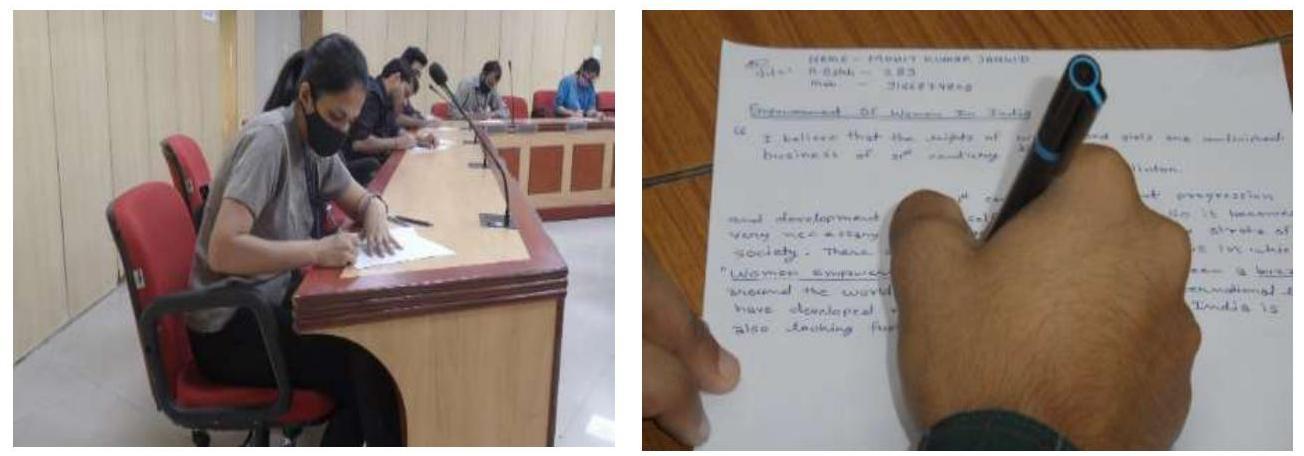
(v) ATTACHMENT WITH NATIONAL ARCHIVES OF INDIA (NAI) Date of Visit: 28.09.2022 to 29.09.2022
Approximately 145 Assistant Section Officers (Probationers) of 2019 Batch visited National Archives of India, New Delhi to attend a half-day workshop on ‘Records Management’ during the Foundation Training Programme. The workshop consisted of a lecture by an eminent archivist, visit to National Archives Museum, Conservation Research Laboratory, Record room/ storage etc.
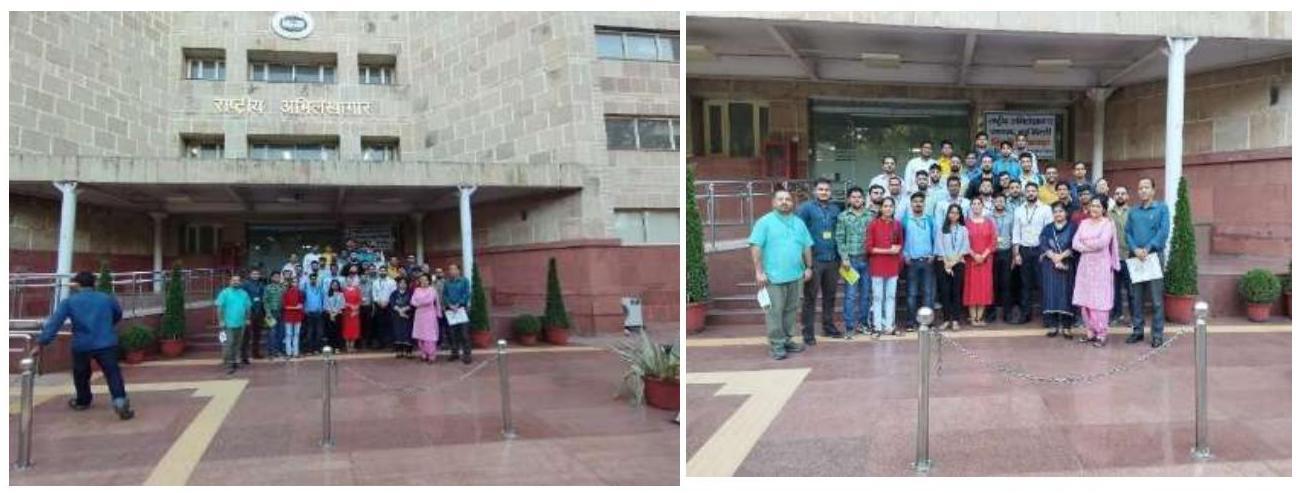
(vi) ADVENTURE SPORTS ACTIVITY CONDUCTED BY DOPT (CCSCSB) Date: 11.10.2022 to 16.10.2022
For the first time ever, Adventure Sports Expedition Tour was organized by DoP&T/ISTM in collaboration with Youth Hostel Association of India for the ASO Probationers. The main objectives of the Adventure Sports Activity more as under-
- To familiarize the trainees with unfavourable situations by providing exposure to the environment, wildlife, flora \& fauna.
- To improve the efficiency and morale of employees, foster a spirit of risk taking, inculcate cooperative team work, enhance stamina and endurance, time management, management of crisis, create environmental awareness and for inculcating quick response to challenging situations.
- To familiarize with the developmental activities being taken up in the mountains/ hilly areas and to expose the trainees to research and development work being done by organizations like BRO in the mountain areas like Atal Tunnel etc.

(IIP) and (vii) COLLABORATION WITH INDIAN INSTITUTE OF PUBLIC ADMINISTRATION (IIPA)
Date: 17.10.2022 to 21.10.2022
IIPA is a training Institute which has been set up to equip the public servants with domain knowledge, functional skills, and behavioural competencies required for managing the task of governance. A one-week attachment was organized with Indian Institute of Public Administration (IIPA) for imparting specialized training on selected competencies for the ASO Probationers of CGLE 2019 Batch. A module on ‘Excellence in Public Service Delivery’ was imparted by the notable faculty of IIPA.
(viii) INTERACTION OF MINISTER OF STATE (PP) & SECRETARY (P) WITH ASO PROBATIONERS
Date of Visit: 31.01.2023
Minister of State (PP), Dr. Jitendra Singh interacted with the newly appointed Assistant Section Officers (Probationers) of 2020 Batch. He briefed the ASOs about the working of Government machinery, roles \& responsibilities of a public servant and challenges faced by a government servant and how to overcome it. Secretary (P) cleared the doubts of the new entrants regarding the Central Secretariat Service.
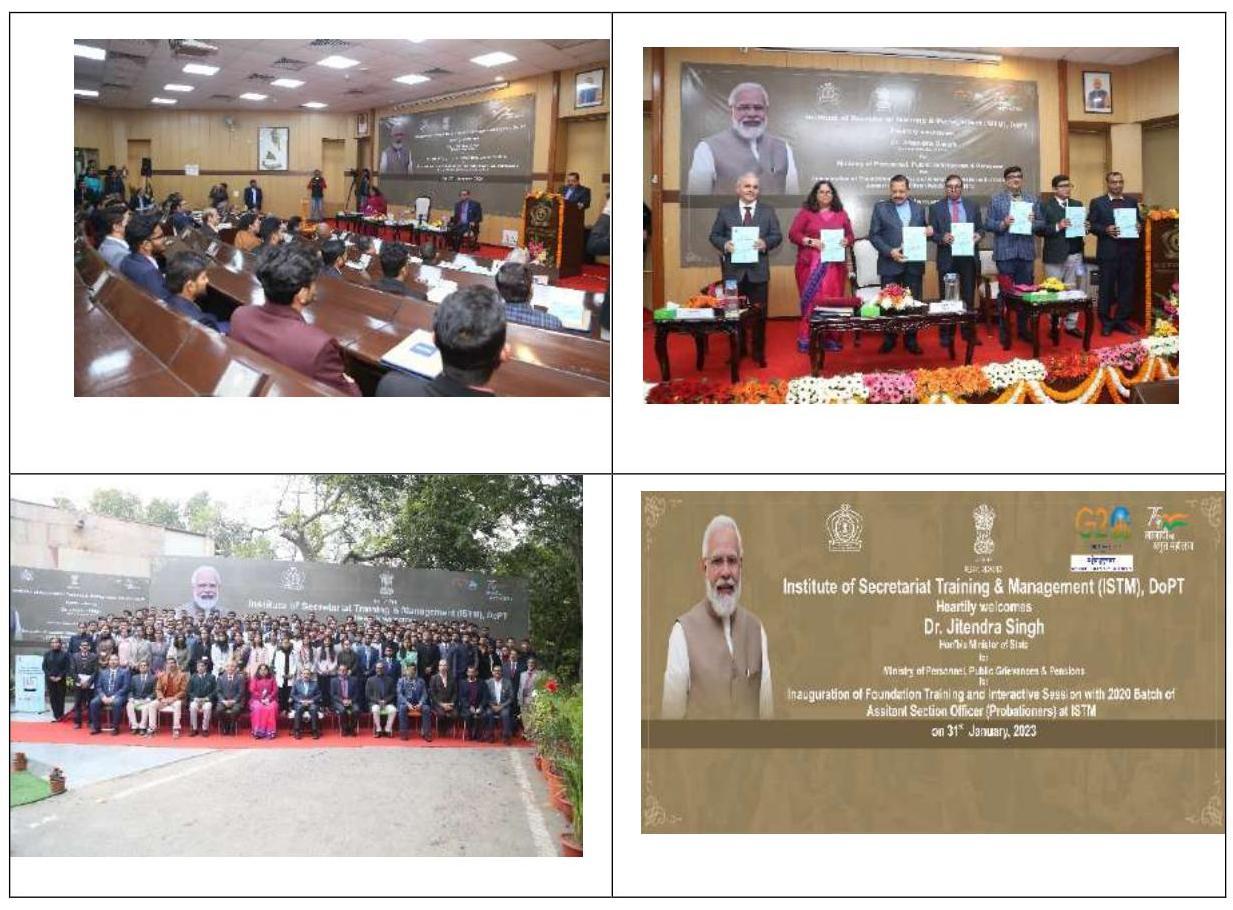
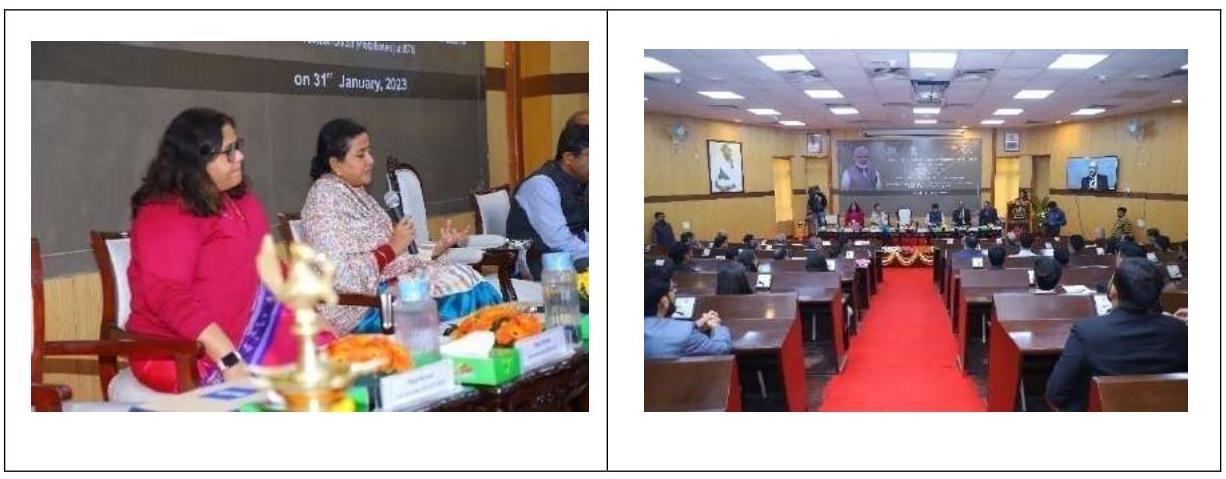
(ix) ESSAY / PRECIS WRITING COMPETITION
Date: 28.02.2023
Approximately 138 Assistant Section Officers (Probationers) of 2020 Batch participated in essay/ precis writing competition. The main objective of the competition was to hone the writing skills, promote critical thinking, enhance research skills, platform for self-expression and creativity. It was one of the extra-curricular activities organized in order to make the Foundation Training interesting, engaging & competitive.

(x) ONE-WEEK ATTACHMENT WITH INDIAN INSTITUTE OF PUBLIC ADMINISTRATION (IIPA)
Date: 13.03.2023 to 17.03.2023
A one-week attachment on ‘Excellence in Public Service Delivery’ with Indian Institute of Public Administration (IIPA) was held for ASO Probationers of 2020 CGLE Batch under ISTM Phase-1 Training. The Institute is well-known for equipping the public servants with domain knowledge, functional skills, and behavioural competencies required for managing the task of governance. The key objectives of the one-week attachment on ‘Excellence in Public Service Delivery’ was to enable the newly inducted officers to:
i. Understand the key enablers of public service deliveries,
ii. Augment digitalization in citizen centric services,
iii. Learn and apply financial concurrence procedures,
iv. Include and apply digital resources for timely public service outreach,
v. Boost the roadmap for the inclusive service deliveries,
vi. Scale up quality in women friendly workplaces, and
vii. Develop a sense of ‘belongingness’ to promote Atmanirbharta.
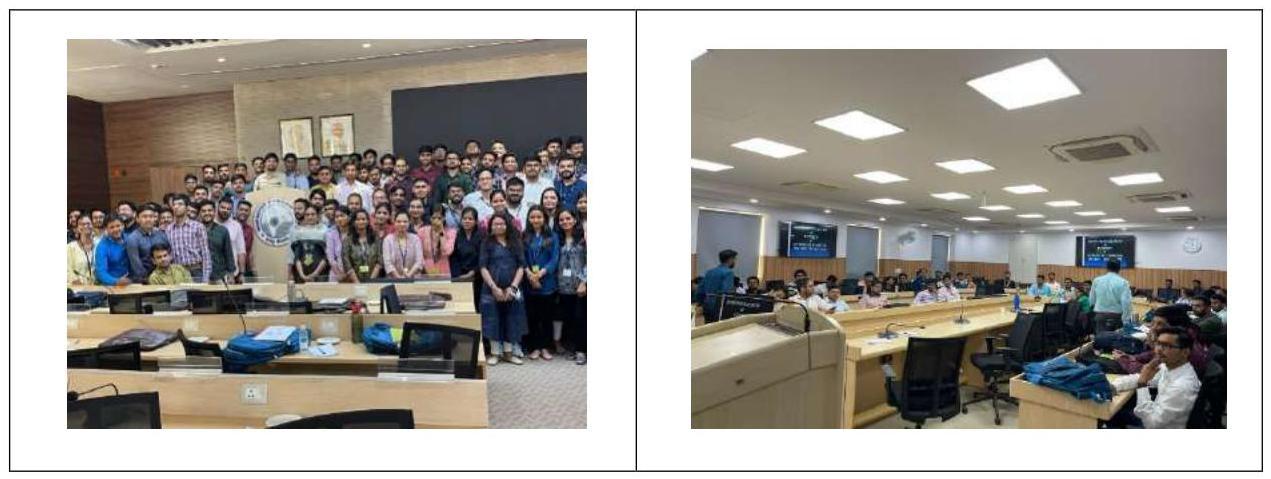
(xi) VISIT TO NATIONAL ARCHIVES OF INDIA (NAI) Date of Visit: 21.03 .2022 to 22.03 .2023
Approximately 138 Assistant Section Officers (Probationers) of 2020 Batch visited National Archives of India, New Delhi to attend a half-day workshop on ‘Records Management’ during the Foundation Training Programme. The key features of the visit were to educate them about the conservation and preservation of records, archival research, digital initiatives, etc. The visit consisted of lecture by eminent archivist, visit to National Archives Museum, Conservation Research Laboratory, Record room/ storage etc.
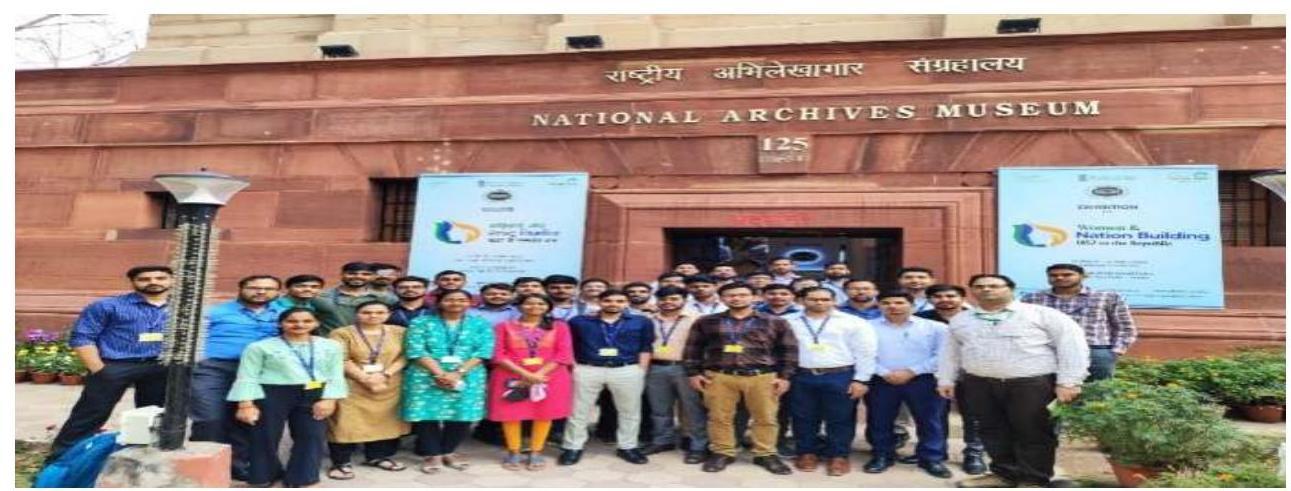
(xii) BLOOD DONATION CAMP
Date: 24.03.2023
Blood donation is a selfless act that has a profound impact on saving lives and improving the health of individuals in need. It is a simple yet powerful gesture that embodies compassion, empathy, and humanity. The act of donating blood not only benefits the recipient but also brings a sense of fulfilment and satisfaction to the donor, Therefore, under the aegis of ‘Azadi Ka Amrit Mahotsav’, blood donation camp was organized with the help of AIIMS, New Delhi. Around 65 participants donated blood and contributed in this divine donation.
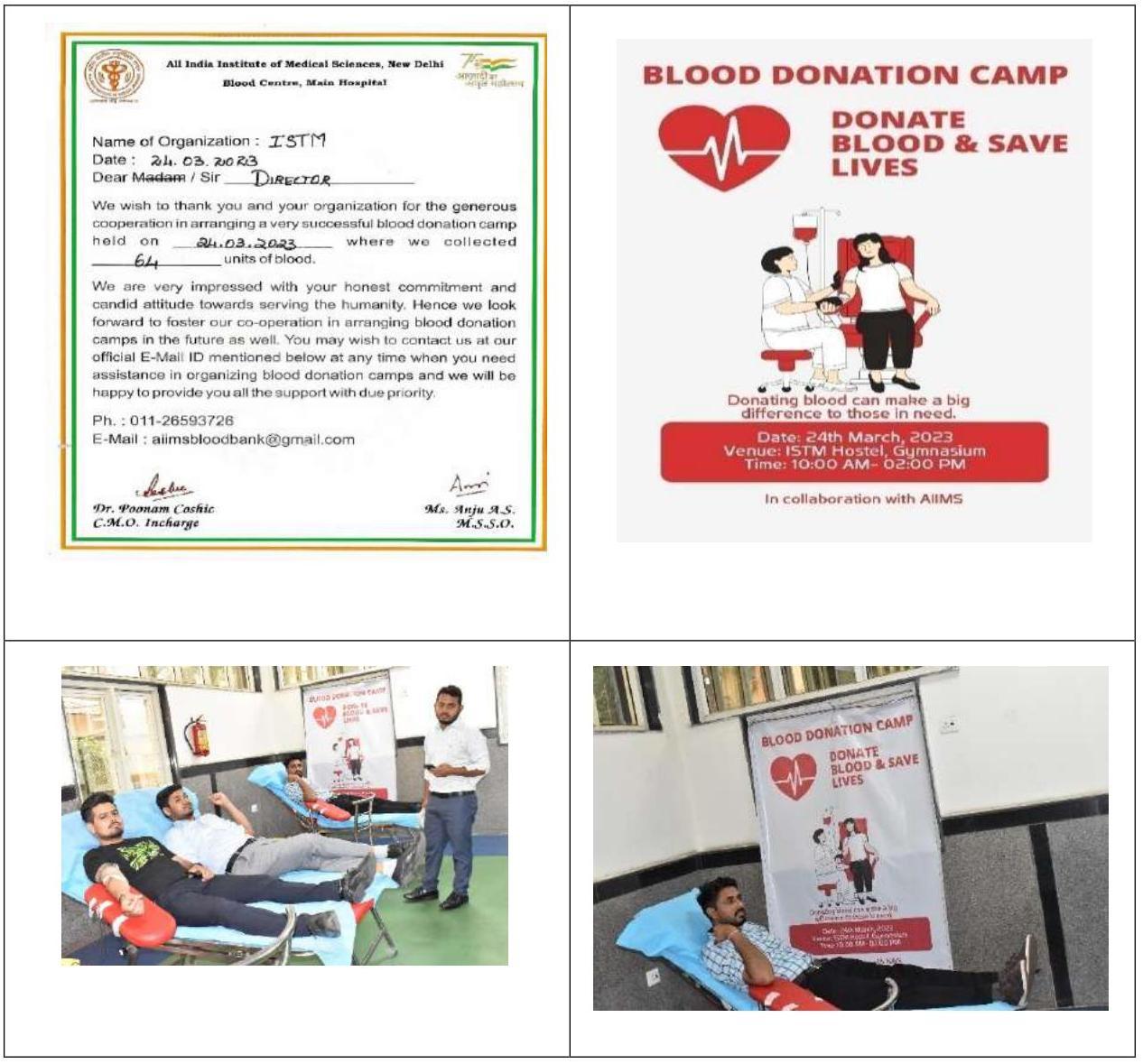
(xiii) VISIT TO PARLIAMENTARY RESEARCH AND TRAINING INSTITUTE FOR DEMOCRACIES (PRIDE)
Date of Visit: 27.03.2023 to 28.03.2023
Approximately 138 Assistant Section Officers (Probationers) of 2020 Batch visited Parliamentary Research and Training Institute for Democracies (PRIDE) to attend a 2-days workshop on ‘Parliamentary Work Management’ during the Foundation Training Programme.
(xiv) SPORTS MEET, 2023
Date of Visit: 10.03.2023
Approximately 100 Assistant Section Officers (Probationers) of 2020 Batch participated in Sports Meet, 2023 during the Foundation Training Programme. The event allows individuals to showcase their physical prowess and skills. Engaging in sports activities not only enhances physical fitness but also boosts mental well-being, concentration, and productivity. It provides a platform for employees to interact, collaborate, and develop strong professional relationships outside the confines of their work environment. Sports Day also instils a sense of unity and pride within the institution, as participants compete in friendly matches, cheering each other on and celebrating collective achievements.
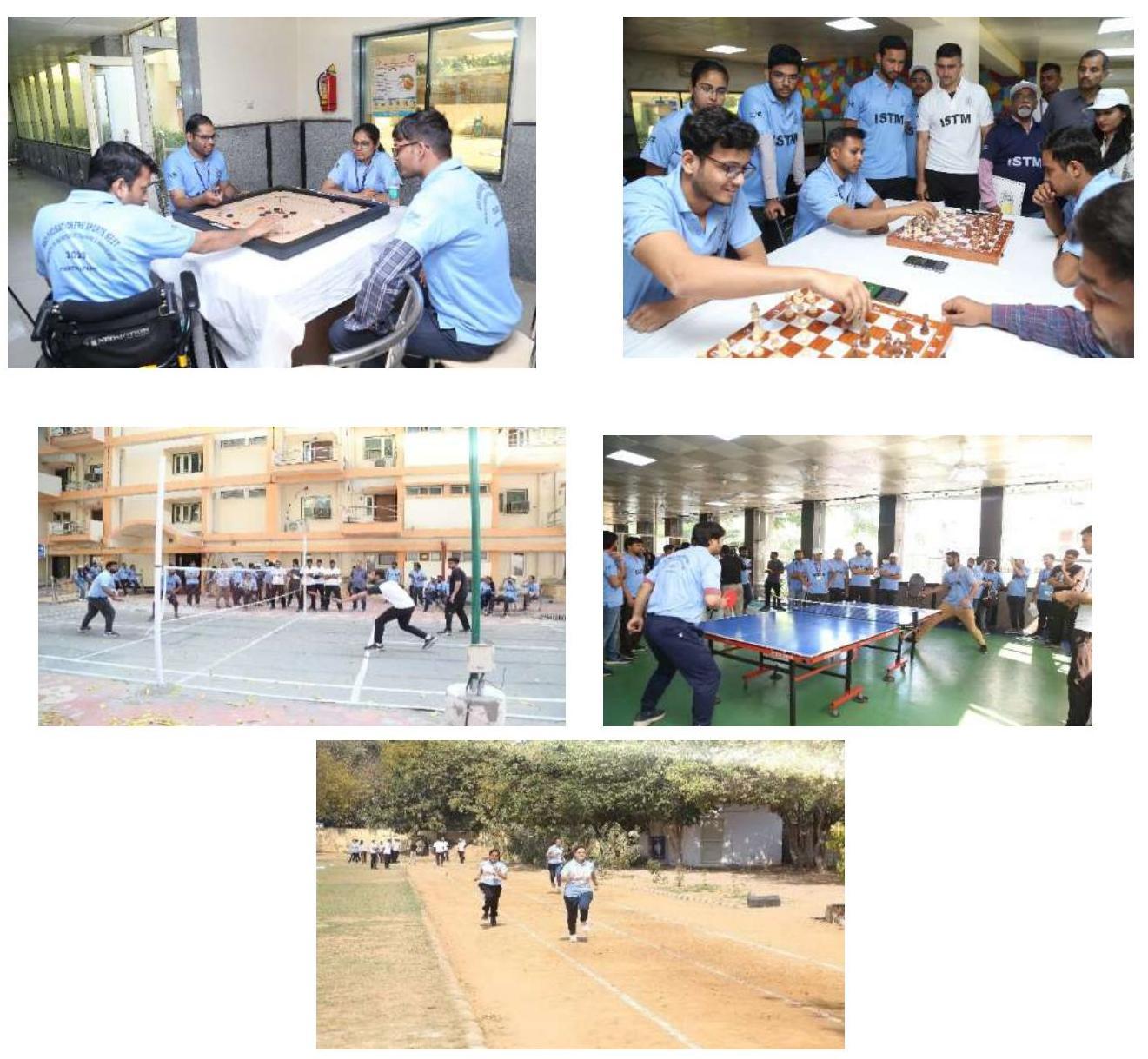
Development of Question Bank
8.3.16 It has been decided to conduct online examination for all the training courses having an element of summative test at the end of the course. Previously, physical examinations were conducted for all the CTP courses and courses like Cash and Accounts, etc. After it was decided by the Management to conduct examination through online mode only, there was a need to develop a question bank having questions of different levels.
8.3.17. Accordingly, a question bank of different types viz. fillin the blanks, true/false, multiple choice question, short answer question etc. has been developed during 2022-23 from which unique sets of question papers are being prepared for different examinations. The Proctored, Independent Authorized Assessment of the examination process and questions in Question Bank have been carried out to ensure effectiveness of the online examinations and proper evaluation of the competencies being assessed.
Online Examination
8.3.18 ISTM Conducts summative examination in all Cadre Training Programmes, Cash and Account Course and other courses as per requirement of the client organisations. Traditionally, summative examinations were being conducted on paper requiring lots of
manhour of printing and photocopy work. During 2022-23, it was decided to conduct all summative examination in online mode only. ISTM has developed an application for conducting online examination. This also includes conducting Entry and Exit Tests for DAKSHTA Programme. ISTM has a state of art ICT lab with more than 120 computers. As a practice now all CTP courses and other programmes having element of examination as qualifier are being conducted in ICT Lab in online mode only.
8.3.19 The online examinations are easy to be conducted and more importantly, the results are instantly prepared saving on the man hour earlier used on this account. During 2022-23, 110 examinations covering 4314 participants have been conducted. The number will increase during the next calendar year.
Issue of e-Certificates for ISTM Courses
8.3.20. Two types of certificates are being issued for different types of training conducted by the Institute. In all courses in which there is an evaluation at the end of the training a certificate of ‘Successful Completion of Training’ is provided while in other courses ‘Course Participation’ certificates are being provided. On an average 7000-8000 certificates are being prepared annually for all categories of training. Besides putting strain on the resources of the Institute to print large number of certificates, it also creates a problem of loss of certificate at the end of the training. They approach the Institute for issue of duplicate certificate which adds to existing work. In order to obviate the issue, it has been decided to issue e-Certificates only to all the participants for CTP and other courses.
8.3.21. An application has been developed and integrated in existing TMIS of the Institute which will be later integrated with i-GOT platform. This will cover issue of e-Certificates for Cadre Training Courses, Organization Specific Courses, DAKSHTA Programmes and other Calendar Courses. The software is secure and ensures easy access to the e-Certificate by all stakeholders. By the end of the year 2022-23, it is expected more than 1200 e-Certificates will be issued.
Revision of Guest Faculty Penal
8.3.22. In addition to regular faculty members, ISTM has a panel of guest faculty members who are specialist in various areas in which training is imparted at the Institute. In an academic year, normally $25 %-30 \%$ of the sessions are taken by the guest faculty members. The panel of guest faculty was last revised in 2017, necessitating a thorough review and updation. Accordingly, a massive exercise was undertaken to attract best talent to be part of ISTM by inviting applications from working professionals, academicians and retired specialists by advertisement in leading newspaper and also through online publicity in various Government websites. As a result, a large number of professionals/specialists filled in the application. After detailed scrutiny of the applications by an Expert Committee, a panel of 163 guest faculty and 58 ex-ISTM faculty members has been finalized and uploaded in ISTM website.
Release of a publication titled “Transforming India – Governance for Aatmanirbhar Bharat”
8.3.23. “Transforming India – Governance for Aatmanirbhar Bharat” – the book has been curated and is released by the Honorable Minister of State for Personnel Public Grievances and Pensions Dr. Jitendra Singh on 17.08.2022. This book has thirty-three (33) articles on various topics ranging from Aatmanirbhar Bharat, Ease of Doing Business, Data, Technology and their Management, Infrastructure Reforms to Sustainable Development and many other
areas. Dr. R Balasubramaniam – Member (HR), Capacity Building Commission, Dr. BibekDebroy – Chairman, Economic Advisory Council and many other luminaries in the related fields, along with a handful of young professionals and industry captains, have contributed with their articles.
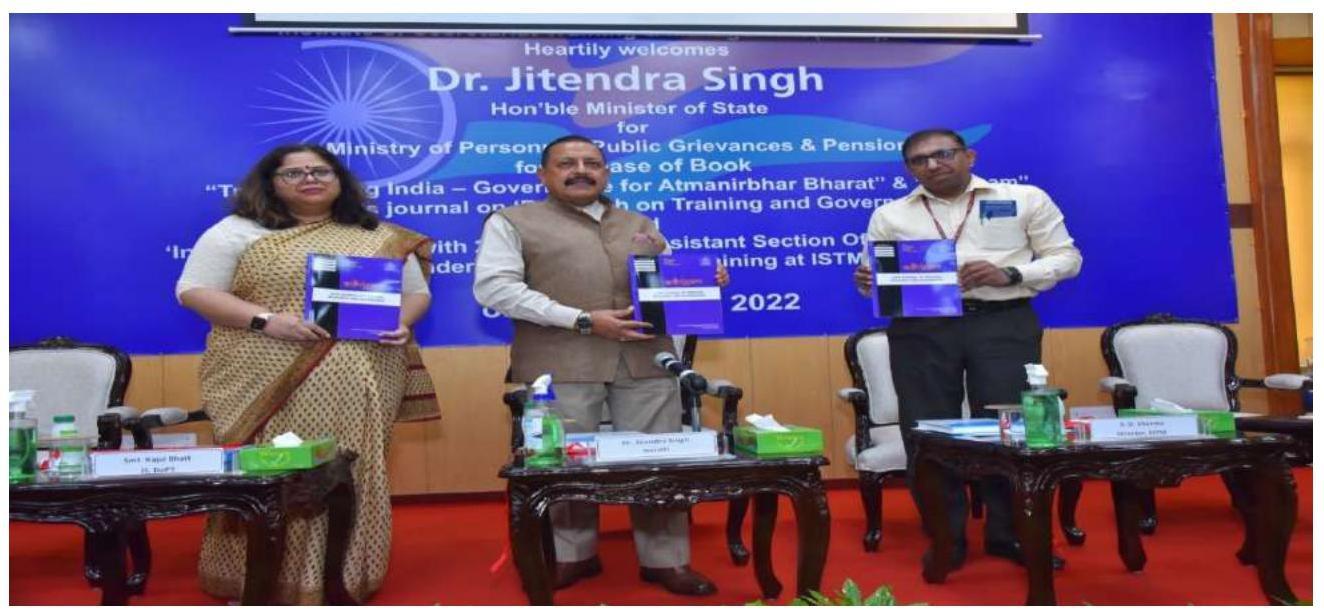
Release of ISTM Journal “Adhigam”
8.3.24. “Adhigam”- the latest issue of the biannual ISTM Journal of Training Research and Governance is released by the Secretary, DoPT Smt. S. Radha Chauhan on 17.08.2022. This Journal covers various angles and discourses in the field of Governance, Policy, Training, Research and Management. The contributors of this Journal span writings, articles, and compilations from senior government officers, scholars, industry experts and academia. The volume covers the topics ranging from next-generation administrative reforms during AmritKal period to various other topics related to civil service competencies and their assessments.
Inauguration of Little Open Library at ISTM campus
8.3.25 The library is providing an extension service through Little Open Library (LOL) inside the ISTM Campus. The LOL is an open-access, free-to-use, and zero-expenses initiative. The LOL works on the give-and-take concept. The users may take a book from LOL by donating another book. The Director, ISTM on the occasion of National Librarian’s Day 12.08.2022, has inaugurated the service.
8.3.26. Apart from the above-listed achievements library is continuously taking various initiatives to provide better competitive services to its users. During the year, Library Day was celebrated in which several competitive events were organized to attract and inculcate reading habits among officials and training participants.
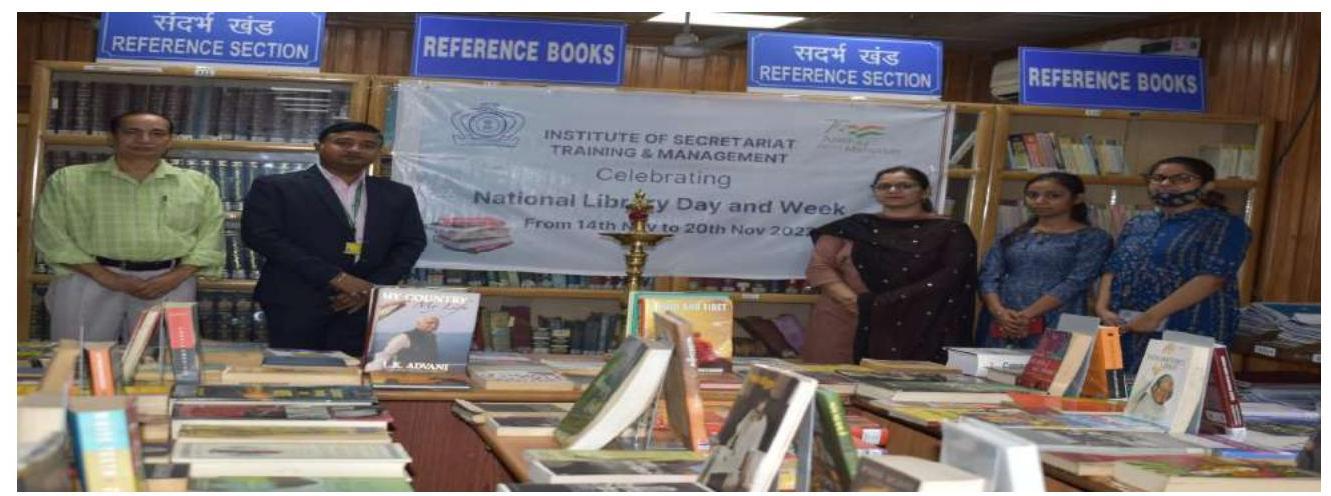
Launch of Rozgar Mela in ISTM (DoPT)
8.3.27. Hon’ble Prime Minister Shri Narendra Modi launched the mega recruitment drive, the ‘Rozgar Mela’ on 22.10.2022 via video conferencing for distributing appointment letters to over 75,000 participants all over India for joining Government jobs. The event was launched from ISTM premises by Hon’ble Minister of State(PP) Dr. Jitendra Singh on 22.10.2022 and other dignitaries, including Smt. Meenakshi Lekhi, Hon’ble Minister of State(External Affairs and Culture), Shri Adesh Gupta, President, Delhi Unit (BJP), Smt. S. Radha Chauhan, Secretary(P), Shri V. Srinivas, Secretary (DARPG), Smt. Rashmi Chowdhary, Addl.Secretary, DoPT, Smt. Rajul Bhatt, Joint Secretary (Trg.), Shri S.D. Sharma, Director, ISTM were present during the event. 22 Ministries / Departments / Organizations participated in the event held at ISTM and appointment letters were distributed to approx. 565 participants, who were physically present at ISTM.
8.3.28. During this recruitment drive, 10 lakh personnel are expected to be recruited. In the first tranche of this drive, appointment letters were given to over 75,000 candidates selected across the country for various Departments and Ministries of the Government by various recruitment agencies of Govt of India. Hon’ble Prime Minister addressed/congratulated these appointees on the occasion.
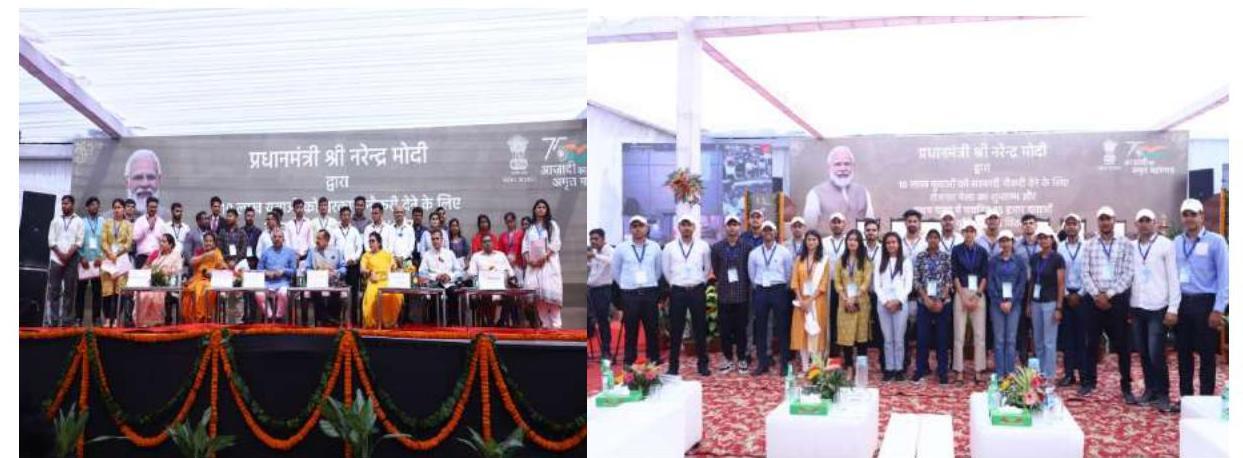
Infrastructure Development
8.3.29. A piece of land measuring 7.07 acre has been allotted by L&DO/MoHUA to Ministry of Personnel, PG \& Pensions for ISTM for construction of integrated building. The total cost of the land $\square 40,52,66,540 /-$ has been paid during previous financial year. An Integrated training complex for ISTM and office accommodation for DOPT has been planned. In addition, a state-of-the-art Hostel accommodation will also be developed
alongwith office accommodation for Capacity Building Commission (CBC) and SPV for Mission Karmayogi.
8.3.30. The project is located in prime location. The facility under integrated structure developed will significantly enhance capacity of ISTM to provide training to approx. 14000 CSS and 7000 CSSS officials.
8.3.31 It is proposed to develop `Centres for Excellence’ for various themes as part of new infrastructure and digital labs in line with emerging technologies. An Immersive Lab for Emerging Technology (iLET) will be housed in the new complex to give all the trainees a first-hand experience of use of technology in their respective domain areas. Presently, there is a constraint in conducting training for larger groups. The project will provide larger training halls and upgraded training infrastructure. There shall be training halls of different trainee capacity, catering facilities, state of the art Labs, smart class rooms, webinar rooms, server rooms auditoria, area for physical and mental well-being in the form of Yoga Room and Indoor Games Room. The building will also have exhibition areas and Committee rooms to facilitate exchange of ideas in training and development field. The complex will also house all administrative offices of ISTM and will provide office space for DoPT.
8.3.32 The proposed training capacity of new complex will be as under: –
| Infrastructure | Number of Training halls |
Training Capacity per day |
Annual Training Capacity |
|---|---|---|---|
| Existing | 12 | 480 | 7500 |
| Proposed | 22 | 840 | 21000 |
8.3.33 Other infrastructure related activities during the year. ISTM had undertaken various infrastructure developments works under the Scheme – Augmentation of Training Facilities in ISTM for the year 2022-23 to enhance the ambience of ISTM campus to facilitate better learning environment for the trainee particulars. During 2022-23, following works have been proposed for implementation through CPWD: –
| S.No. | Name of the Item |
|---|---|
| 1 | Upgradation of class rooms (purchases of furniture items) |
| 2 | Upgradation of ICT Laboratories with latest systems including replacement of furniture /minor civil works |
Occasions of Celebration
8.3.34 The Union Cabinet approved $15^{\text {th }}$ November as Janjatiya Gaurav Divas to commemorate the brave tribal freedom fighters as part of the year-long celebrations of 75 years of India’s Independence. On this occasion, ISTM conducted a talk with focus on recognizing efforts of the tribals in the preservation of cultural heritage and promotion of Indian values of national pride, valour, and hospitality. The talk was given by Shri Raj kumar, a journalist, writer and consultant in National Commission for Scheduled Tribe which was attended by participants as well as faculty members of the Institute.

8.3.35. ISTM celebrated Constitution Day, International Women’s Day, International Yoga Day and Good Governance week during the period.
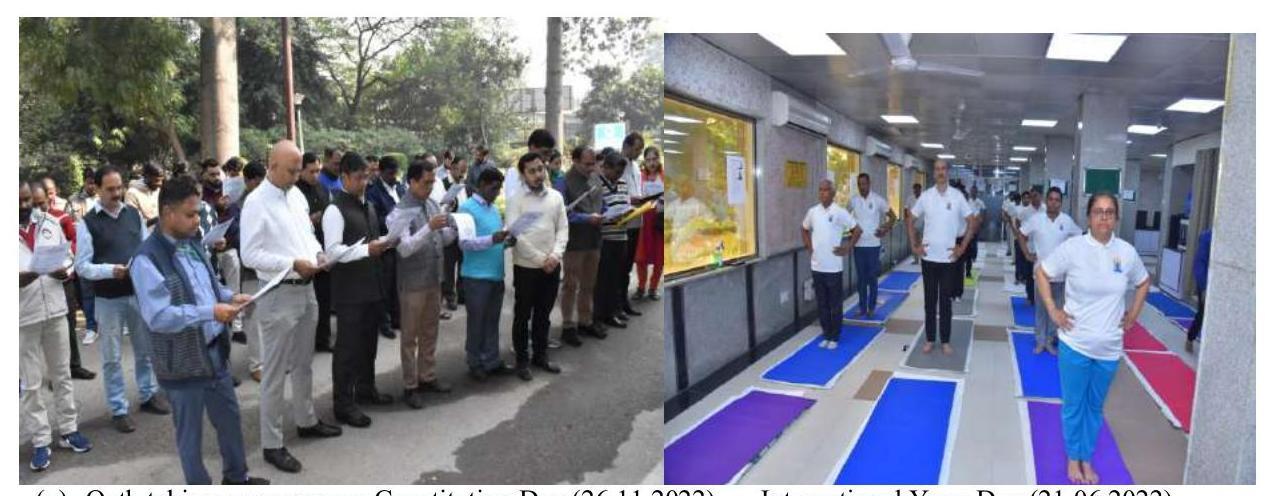
(v) Oath taking ceremony on Constitution Day (26.11.2022) International Yoga Day (21.06.2022)
CHAPTER 9
MISSION KARMAYOGI & e-HRMS
A. National Program for Civil Services Capacity Building (NPCSCB) – Mission Karmayogi
9.0 Union Cabinet on 02.09 .2020 approved the National Program for Civil Services Capacity Building (NPCSCB) – Mission Karmayogi with goal of securing efficient and effective public service delivery for citizens through a targeted approach of role specific capacity building of all civil service officials across the Centre and States, regardless of their ranks, cadre and geographies, transitioning from a ‘rule-based’ system to a ‘role-based’ system.
9.1.1 Under NPCSCB, DoPT is taking steps to calibrate civil services tasks to a framework of Roles, Activities and Competencies (FRAC) to identify the behavioural, functional and domain needs of each individual position in the government. An online learning platform (iGOT-Karmayogi) is also being developed that will allow the Departments to provide competency linked training resources and opportunities to their employees.
9.1.2 NPCSCB has an overall budget of $\square 510.86$ crore (including Taxes) to be spent over a period of 5 years (2020-2025) including technical assistance from the World Bank Group to the tune of $\square 350$ crores (approx.) in the form of loan.
Objective
9.1.3 Civil services are at the centre of all government activities – they are agents of policymaking and the executive hand that delivers on the ground. The skillsets and capacity of the civil servants play a vital role in service delivery, program implementation and performing core governance functions. Recognising this crucial responsibility, the National Programme for Civil Services Capacity Building (NPCSCB) aims to create a professional, well-trained and future-looking civil service that is imbued with a shared understanding of India’s developmental aspirations, national programs and priorities.
9.1.4 The focus of NPCSCB is on promoting ease of living and ease of doing business, by considerably enhancing the citizen-government interface. This involves creation of both functional and behavioural competencies among the civil servants.
NPCSCB – Pillars \& Philosophy
9.1.5 NITI Aayog, in its report on India@75, has highlighted the need for reforms in training. The experience gained during the Covid-19 pandemic also brought forth the need for the civil service to be agile, capable of partnering with diverse stakeholders and to be up to date with new competencies. The NPCSCB is carefully crafted to lay the foundation for capacity building for future generations of the civil servants so that they learn from the best practices across the world, while remaining connected to their roots.
9.1.6 The key philosophy of NPCSCB is to create an ecosystem of competency driven training and Human Resource (HR) management by transitioning from a ‘rules-based’ system to the ‘roles-based’ system.
9.1.7 The National Programme for Civil Services Capacity Building has six key pillars i.e.
a) Policy Framework
b) Institutional Framework
c) Competency Framework
d) Digital Learning Framework iGOT-Karmayogi (Integrated Government Online Training Karmayogi Platform)
e) The electronic Human Resource Management System (eHRMS) and
f) The Monitoring and Evaluation Framework.
9.1.8 The NPCSCB will cover all civil servants across different Ministries, Departments, Organisations (MDOs) of the Union Government. The willing State Governments will also be enabled to align their capacity building plans on similar lines.
Policy Framework
9.1.9 A competency-based HR policy requires assignment of right person to the right role at the right time. NPCSCB aims to create a robust policy framework towards implementation of such an HR policy in the Government. The policy framework will also enable adoption of modern technological tools such as a digital platform, artificial Intelligence, machine learning and data analytics for monitoring and evaluation of the entire programme especially quality of the learning content, assessment of user feedback and competency assessment.
9.1.10 Key principles of the proposed policy framework are:
a) To complement Physical Capacity Building with an Online Training framework.
b) Focus on ‘On-Site learning’ to complement ‘Off-Site learning’ whereby the civil servant learns in her job environment and only higher order learning is delivered through training institutions.
c) To create an ecosystem of shared training infrastructure including teaching material and personnel.
d) To harmonise the functioning of all civil services training institutions (such as Central Training Institutions etc.) and enable them to partner with domestic and global institutions.
e) To calibrate all civil service tasks to a Framework of Roles, Activities and Competencies including skills (hereinafter referred to as FRACs)
f) To partner with all content creators including in-house sources, as well as the private sector to build a content marketplace on iGOT-Karmayogi.
g) To make available to all civil servants, agnostic to their geographical location and their position in the hierarchy, an opportunity to access training content in Hindi, English and other Indian languages.
h) To enable the individual learners to follow self-decided as well as mandated learning paths.
i) To make Mid-Career Training Programme (MCTP) mandatory for all services, including horizontal and combined programs, amongst services.
Competency Framework
9.1.11 The exercise for defining the Framework for Roles, Activities, and Competencies including skills (FRACs) is envisaged to be carried out by each Ministry / Department / Organisation of Union Government and integrated with the i-GOT-Karmayogi Platform. FRACs exercise aims to define the roles, activities and competencies required at each position in the government. Thereafter, work-allocation, notifications of vacancies etc. will be done through the i-GOT-Karmayogi platform following the FRACs model. Further, capacity building content appropriate to the FRACs model will be provided by participating organisations on the 70:20:10 rule (an indicative $70 %$ training online, $20 \%$ on-the-job and $10 \%$ physical).
Digital Learning Framework (iGOT-Karmayogi Platform)
9.1.12 An online learning platform, i-GOT-Karmayogi, has been developed as an integral part of the Digital India stack for capacity building of all government employees. It provides anytime-anywhere-any device learning with the potential to train about 2.0 crores users which was hitherto not achievable through traditional measures. The Platform is also available as a mobile app on popular platforms for easy access
9.1.13 Content Curation: The content is being curated by individual government ministries or organizations in-house or through knowledge partners. Carefully crafted and vetted content from best-in-class institutions, universities, private content providers and individual resources is also being made available as training modules. The platform is envisioned to eventually evolve into a vibrant and world class marketplace for content modelled on FRACs, supported by a robust e-learning content industry.
e-Human Resource Management System (e-HRMS)
9.1.14 Department of Personnel and Training (DoPT) introduced the Electronic Human Resource Management System (e-HRMS) with effect from 25.12.2017 to digitize the service records of Central Government employees and for providing certain HR processes in a digital working environment.
9.1.15 On 25.12.2022, the Hon’ble Minister of State for Personnel, Pensions and Public Grievances launched e-HRMS 2.0 – the new revamped version of e-HRMS.
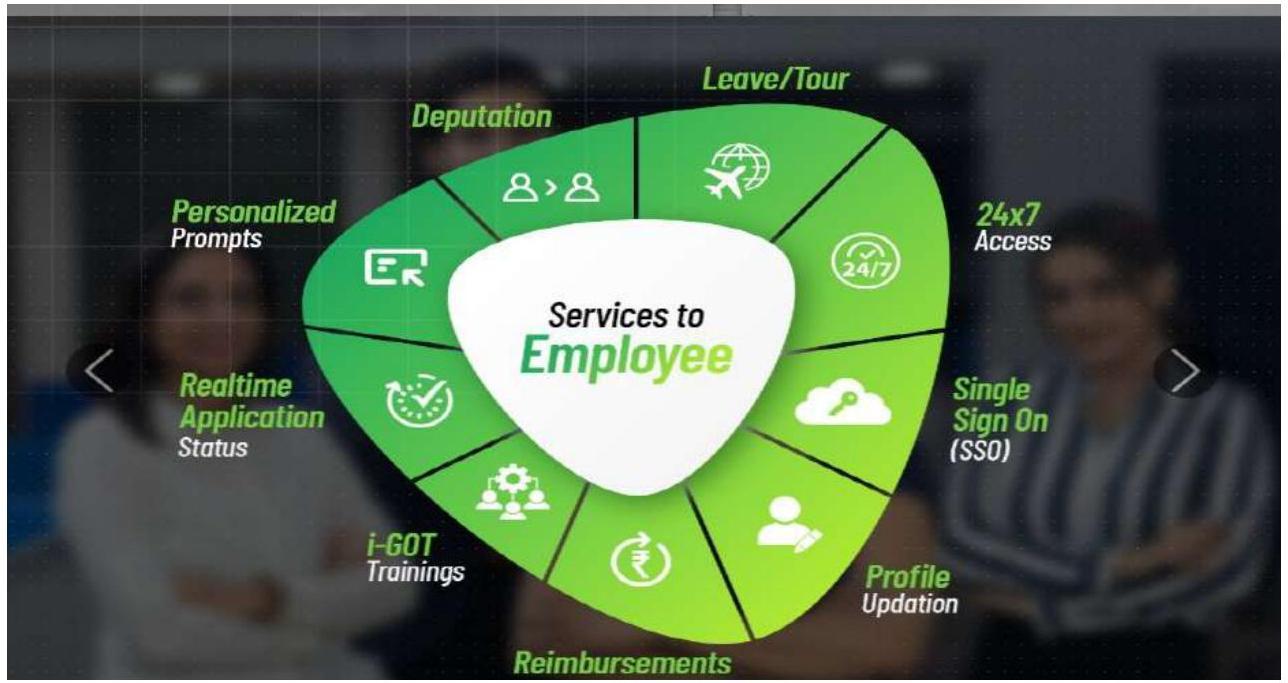
Services on eHRMS 2.0
9.1.16 e-HRMS 2.0 has been modelled to provide all major employee related HR Services like Transfer/Postings, Deputation, Rotation Transfer, and integrating the Annual Performance Appraisal Report (APAR), Immovable Property Returns (IPR). eHRMS 2.0 is also developing integrated module for effecting Promotions with AI enabled features for
vacancy determination, creation of Reservation Rosters, eligibility list, Vigilance clearance etc.
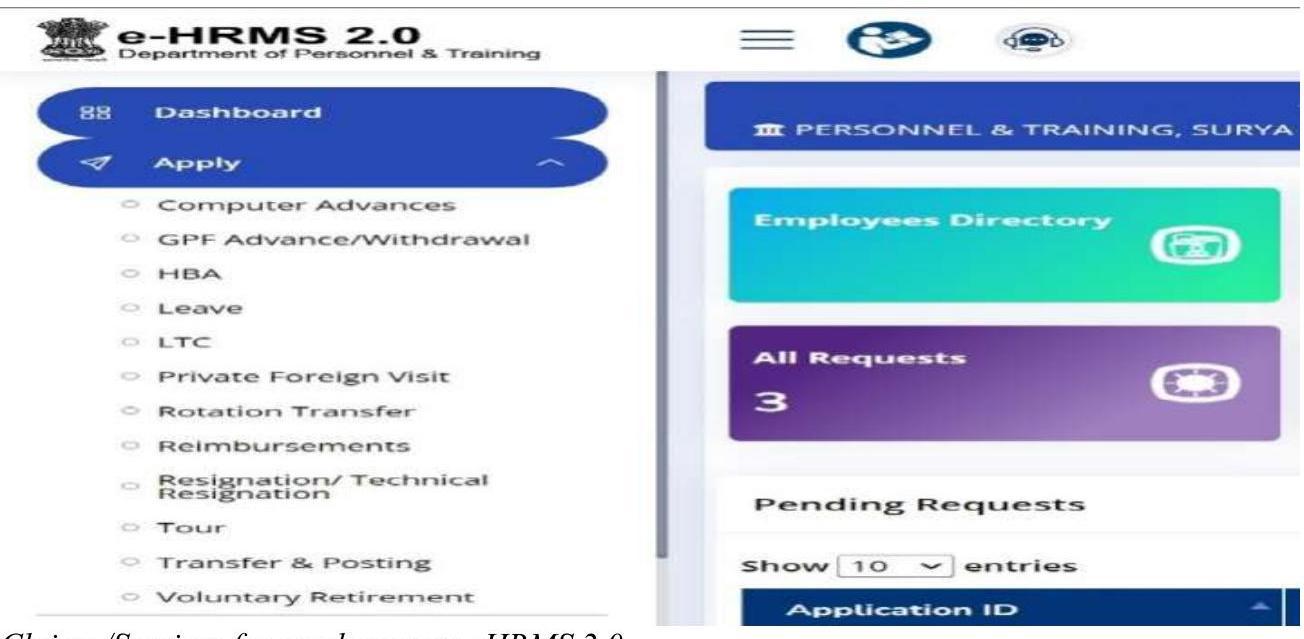
Claims/Services for employees on eHRMS.2.0
9.1.17 Deputation module for CSS and CSSS is operational in e-HRMS 2.0. Deputation module leverages AI based features to alert employees about the opportunities available to them according to their qualification/experience. e-HRMS 2.0 has also developed linkages with iGOT-Karmayogi platform to offer training programmes and record and store competency development history of officers and leverage the power of AI to automatically suggest suitable training opportunities for individual officers, based on their assigned role and preferred career path.
9.1.18 e-HRMS will provide analytics to the Senior Administration in Policy formulation and implementation. e-HRMS has built in tools and capabilities to bring together dispersed data to generate automated clearances in respect of Transfer, Promotion, Deputation, Training, Competencies etc.
Salient Features of e-HRMS
| 1. | Single source of authentic employee data | 6. | 24X7 access and availability |
|---|---|---|---|
| 2. | Common document repository of employees |
7. | Ease of sharing information among stakeholders |
| 3. | MIS reports analytics | 8. | e-sign facility |
| 4. | Standardization of master data | 9. | Alerts/notification functionality |
| 5. | Minimizes manual entry of data | 10. | Integrated with other applications like iGoT Karmayogi, SPARROW etc. |
A Comprehensive dashboard has been developed providing various analytics to senior administration for decision and policy making.
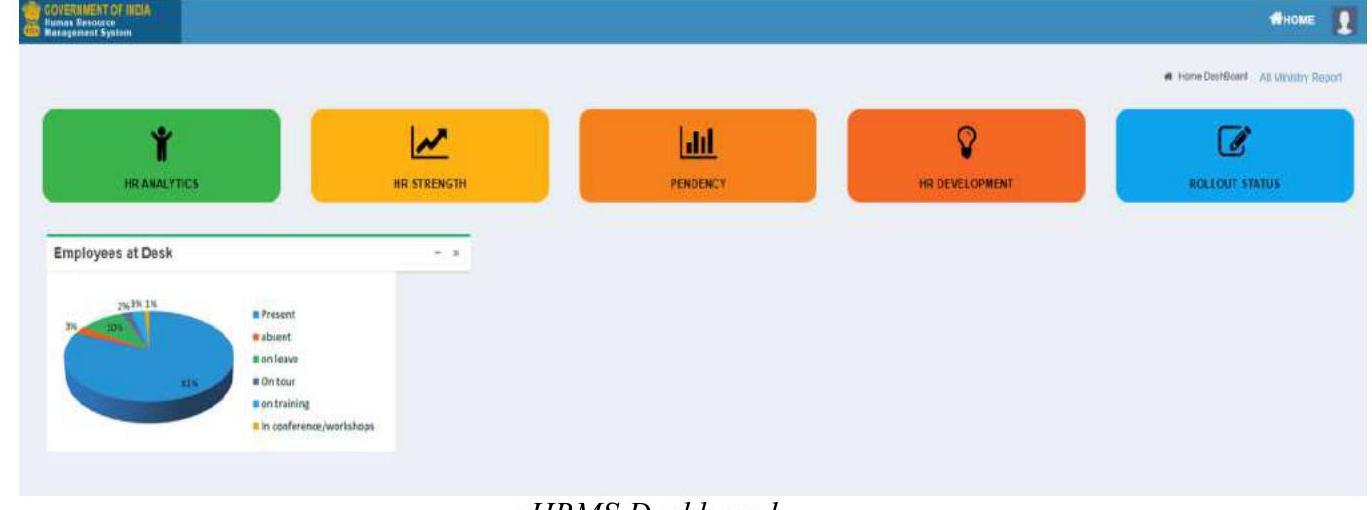
eHRMS Dashboard
Achievements
a. As per e-HRMS Dashboard report, 159 Ministries /Departments/ Organisations (MDOs) have been on-boarded onto the e-HRMS platform (covering approx. 70,000 employees). Admin Authentication is the benchmark for e-HRMS implementation. As per the dashboard report, 76 MDOs have achieved more than $70 %$ admin Authentication.
b. In order to firmly put e-HRMS on the path of full utilization, DoPT has adopted a ‘Systems only HR Management Approach’.
c. Fields/data from the e-HRMS system has been used to on-board officials onto the iGOT Karmayogi training platform as part of the ‘Learner-On-boarding’.
d. A master circular containing consolidated guidelines for on-boarding all the Ministries/Departments and their Attached & Subordinate Offices onto the e-HRMS platform has been issued vide DOPT’s OM No. 01/01/2019-eHRMS dated 05-052022.
e. A Standard Operating Procedure (SOP) for onboarding all Cadre Controlling Authorities (CCAs) onto e-HRMS 2.0 has been prepared and circulated.
Institutional Framework
9.1.19 At present, the NPCSCB has operationalized the following institutional framework to manage the Programme and oversee its execution:
(i) Cabinet Secretariat Coordination Unit: A coordination unit has been set up on 27.01.2023 under the Chairmanship of the Cabinet Secretary to monitor the implementation of the NPCSCB. It will align all stakeholders and provide mechanism for overseeing capacity building plans.
(ii) Capacity Building Commission – The Capacity Building Commission (CBC) has been made operational from April 2021 with the mandate to make policy recommendations on Personnel/HR and oversee the systematic development of the training ecosystem including various Civil Service Training Institutes (CSTIs).
(iii)Karmayogi Bharat- A not-for-profit company incorporated in the name of Karmayogi Bharat under the administrative control of DoPT as a $100 \%$ government owned entity for owning, managing and maintaining the digital assets, i.e., i-GOT-Karmayogi- the digital/ e-learning platform, including the IPR of all software, content, process etc. on behalf of Government.
(iv)A Programme Management Unit (PMU)- This unit in DoPT provides interface with support agencies. This unit has been set up to provide program management
and support services to the department for rolling out and managing different aspects of NPCSCB.
Monitoring and Evaluation framework
9.1.20 The performance of all users of the iGOT – Karmayogi platform -the individual learner, the supervisor, the organization, the peer group, the content provider, the content creator, and the technology service providers etc. will be monitored and evaluated on Key Performance Indicators (KPIs).
Initiatives under the Mission Karmayogi during FY 2022-23
9.1.21 The major activities during the financial year 2022-2023 under Mission Karmayogi are highlighted below:
i. Special Purpose Vehicle (SPV) – Karmayogi Bharat (KB)
The Special Purpose Vehicle (SPV), Karmayogi was incorporated on 31.01.2022 under Section 8 of the Companies Act, 2013 as a $100 %$ Government owned not for profit Company to own and manage the iGOT Karmayogi platform and any other digital assets pertaining to the NPCSCB. The SPV-KB, started functioning from July 2022 with the appointment of its CEO and the Board of Directors.
ii. Composition of the Board of SPV – Karmayogi Bharat
a) Shri Subramanian Ramadorai, Former Advisor to the Prime Minister in the National Council on Skill Development:- Non-executive Director and Chairperson, Karmayogi Bharat.
b) Ms. Debjani Ghosh, President, National Association of Software & Services Companies (NASSCOM):- Non-executive Director Karmayogi Bharat.
c) Mr. Pankaj Bansal, Co-Founder and Group CEO of PeopleStrong:- Nonexecutive Director Karmayogi Bharat.
d) Dr. SantruptMisra, Group Director, Birla Carbon \& Group Human Resources for the Aditya Birla Group:- Non-executive Director Karmayogi Bharat.
e) Dr. Nirmaljeet Singh Kalsi IAS (retd), Chairperson of National Council for Vocational Education and Training:- Non-executive Director Karmayogi Bharat.
f) Shri Govind Iyer (Consultant, Egon Zehnder):- Non-executiveDirector, Karmayogi Bharat.
g) Secretary, Ministry of Electronics and Information Technology, Government of India (Ex-officio): Non-executive Director Karmayogi Bharat.
h) Secretary, Department of Personnel and Training, Government of India (Exofficio) Director, Karmayogi Bharat.
i) Secretary, Capacity building Commission (CBC) (Ex-officio), Director Karmayogi Bharat.
j) Shri Abhishek Singh, CEO, \& Director Karmayogi Bharat.
k) CFO, Karmayogi Bharat \& Director Karmayogi Bharat.
iii. The Karmayogi Bharat has hit the ground running and immediately started engaging in activities aimed at advancing its mandate to develop the i-GOT-Karmayogi, platform into a comprehensive resource for the Capacity Building of Civil Services in India.
iv. Important Developments on the platform are –
a. The portal has accumulated more than 390+ courses totaling 750 plus hours of content time and more than $\mathbf{4 , 0 0 , 0 0 0}$ learners have been on-boarded on the portal in FY2022-23, with more than 50 lakh learning minutes on the iGOT Karmayogi platform.
b. The iGOT mobile Application has been launched on 25.12.2022 by Dr. Jitendra Singh, Hon’ble Minister of State for Personnel, Public Grievances and Pensions.
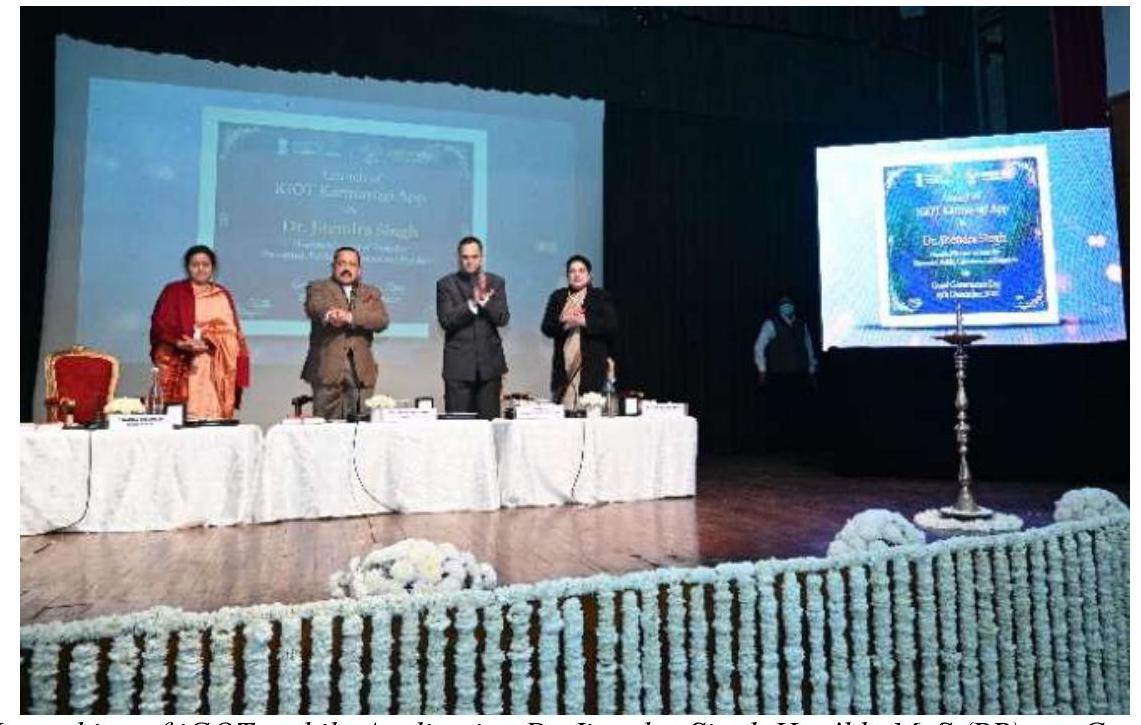
Launching of iGOT mobile Application Dr Jitendra Singh Hon’ble MoS (PP) on Good Governance Day – 25.12.2022
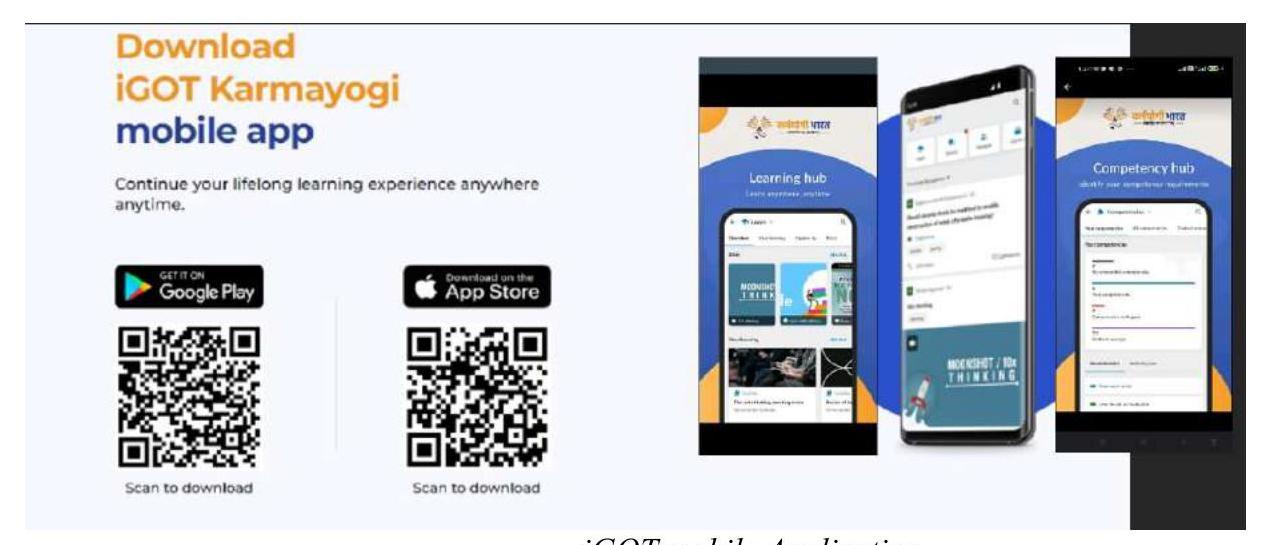
iGOT mobile Application
c. Self-registration and Parichay Single Sign On enabled for seamless onboarding of government officials
d. Mobile OTP based login enabled on iGOT Karmayogi Platform
e. Karmayogi.in domain developed to address user on-boarding for officials with non-government IDs after authentication by the concerned Ministry or Department
f. Feature of Bulk Uploading of users by the MDO Administrator made available on the portal
g. Dashboards on users and available content displayed on the landing page
h. Featured courses made available on the landing page for a glimpse of some of the best content on the platform
i. Course completion certificates have been initiated for high-demand courses.
v. Orientations and Consultative meetings were conducted with the Ministries/ Departments/ Organisations, States and Private Knowledge Partners about Mission Karmayogi and the iGOT Karmayogi Platform to familiarize about Karmayogi Bharat, the features of iGOT platform, the published courses and process to on board users. Karmayogi Bharat has conducted more than 65 virtual sessions and around 20 in person meetings to on-board various Ministries/Departments/Organizations on the platform and resolve their queries.
vi. Review of all the courses published on the iGOT platform were done to assess the consistency and compliance with iGOT platform. Thereafter, formal feedback and suggestions were sent to all providers highlighting the strengths and gaps in the course structure.
vii. Competency mapping done for the courses to ascertain the key skills that a course provides to the learners in a systematic and organized approach. Regular coordination is done with Capacity Building Commission (CBC) to update the revised version of Competency Mapping of the Courses and update Database. Presently, the Functional competency is identified through 21 themes and Behavioural competency is identified through 17 themes.
viii. Karmayogi Prarambh, an induction module for the newly appointed government employees through Rozgar Mela was launched by the Honourable Prime Minister on 22.11.2022. It comprises of 8 courses on behavioural and functional skills namely, Code of Conduct for Government Employees, Prevention of Sexual Harassment of Women at Workplace, Understanding Motivation, Self-Leadership, Stress Management, Effective Communication, Microsoft Word Beginners and Microsoft Excel for Beginners.
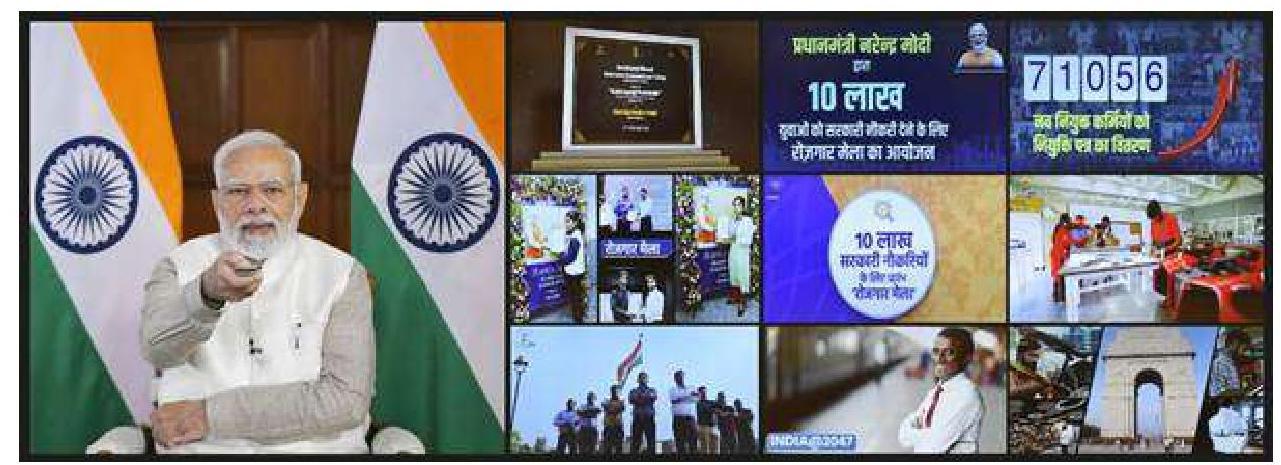
Launch of Karmayogi Prarambh by Hon’ble PM on 22.11.2022
ix. Karmayogi Prarambh modules have also been developed for newly appointed Deputy Secretary/Director and Joint Secretary as an induction module on behavioural and functional skills suitable for Director and JS positions respectively. This comprises courses such as parliamentary procedures, procurement, self-leadership, stress management etc.
x. Development of Attitude, Knowledge and. Skills for Holistic Transformation of Administration (DAKSHTA) a compilation of 11 courses by ISTM in collaboration with CBC, for the Central Secretariat Services/Central Stenographer Secretariat Services cadres is now available on the iGOT Karmayogi platform. So far 17 batches of SOs and ASOs have been trained under DAKSHTA.
xi. Karmayogi Bharat published an Expression of Interest (EoI) for Selection of Agency for providing Managed Services and an Request for Proposal (RFP) for the same has been published on $9^{\text {th }}$ December, 2022. Procurement process is underway.
xii. Karmayogi Talks Series was launched by Karmayogi Bharat on 02.01.2023, as a forum for all learners on iGOT Karmayogi to engage and interact with renowned experts/professionals across the government, industry and private entities. Several sessions have been conducted till date – first eminent speaker for the series, Dr. R Balasubramaniam, Member-HR, Capacity Building Commission who spoke on ‘the transition journey of any government official from a ‘Karamchari’ to a ‘Karmayogi’ through the iGOT platform’ and second session by Shri R Chandrashekhar, former Secretary MEITY and Telecom on New and Emerging Technologies in Governance). The third session of Karmayogi Talks was given by the famous Nobel Laureate Prof Micheal Kremer on ‘Driving Innovation in Indian Agriculture and Water Resources by leveraging India’s Digital Infrastructure’.
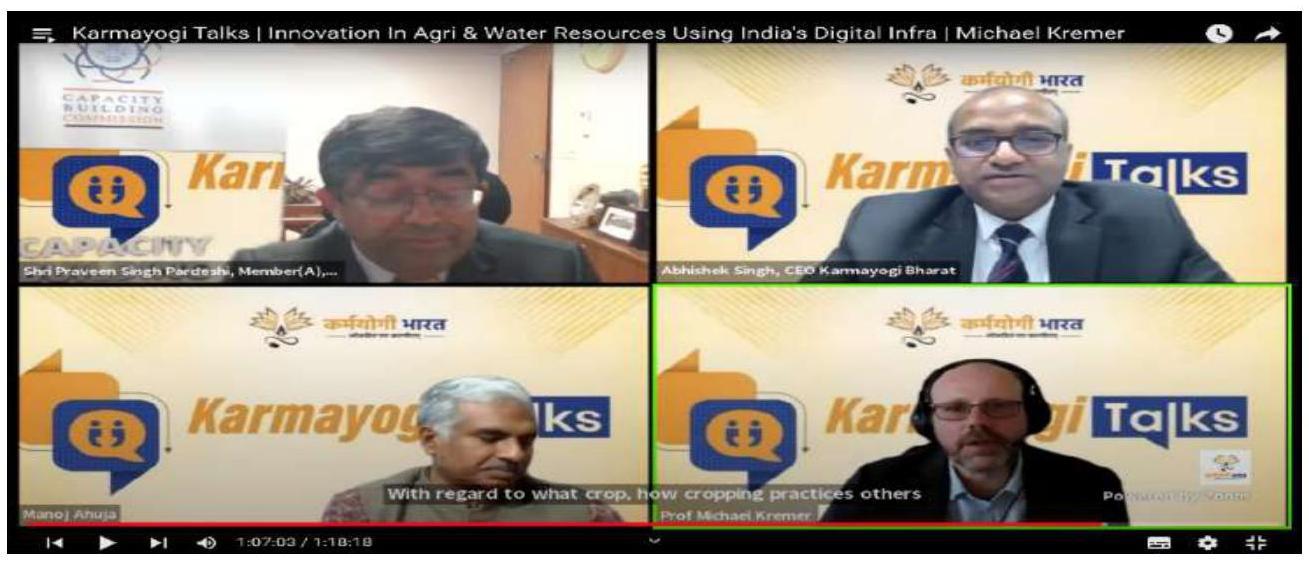
Karmayogi Talks Series iGOTkarmayogi.gov.in
xiii. Top 5 learners of Karmayogi Prarambh Module got a chance to interact with Hon’ble Prime Minister during the Rozgar Mela held on 20.01.2023.
B: Achievements of Capacity Building Commission
i. Capacity Building Commission (CBC), an Attached Office of DoPT, has been functioning under the aegis of Mission Karmayogi, with the goal to make policy recommendations on Personnel/HR, formulate annual capacity building plans for all Ministries/Departments/Organizations (MDOs) to systematically develop the demand for training and transform and elevate the supply side of the Capacity Building ecosystem, by reviewing, benchmarking and targeted upgradation of the various Civil Service Training Institutes (CSTIs). The composition of CBC is as under:
a. Shri Adil Zainulbhai, Chairman
b. Shri R. Balasubramaniam, Member (HR)
c. Shri Praveen Pardeshi, Member (Admin)
d. Shri Hemang Jani, Secretary
ii. Key activities taken up by the Capacity Building Commission are as under:
a) Capacity Building Commission is coordinating the preparation of Annual Capacity Building Plans (ACBPs) of Ministries, Departments and participating organisations (MDOs). The ACBPs will help in identifying the demand for capacity building at individual, organizational and institutional level in each MDO. A workshop chaired by
Cabinet Secretary was also held on 01.12.2022 with all the Ministries and Departments, to facilitate the preparation of the ACBPs.
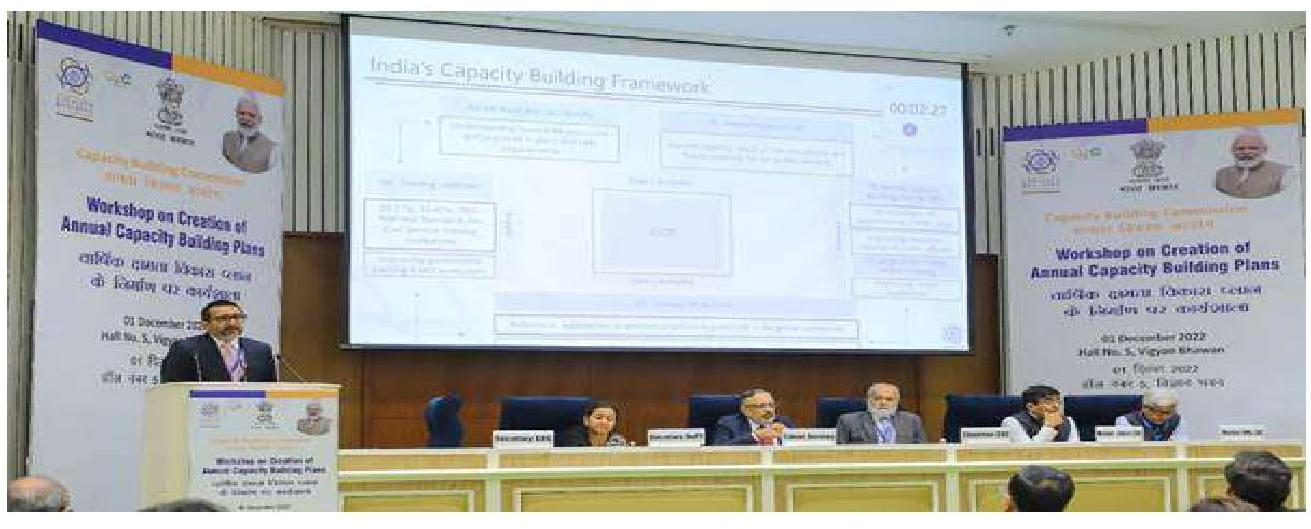
Workshop on creation of $A C B P s$
b) CBC is closely collaborating with the Civil Services Training Institutions (CSTIs) for standardization of training and capacity building, pedagogy and methodology. This initiative caters to the supply side of the capacity building ecosystem. CBC has undertaken the work of accreditation of CSTIs after the launch ‘National Standards for Civil Service Training Institutions’ portal. The NSCSTI framework aims to introduce benchmarks on key parameters for CSTIs as a means for continuous improvement of these Institutions. This portal will help the Government of India to set common standards of excellence and promote organizational improvement through continuous self-assessment of Training Institutes. This would also institutionalize a forum to highlight best-practices and facilitate collaborative learning, and give direction for longterm strategic planning.
c) CBC is entering into partnership with competent Indian institutions with enhanced capabilities for faculty training to run faculty development programmes for CTIs. CBC has entered into knowledge partnerships with institution like ID-Insight; ISB; Nation First; IIT-Madras; National Law School, Bangalore; Flame University, Pune; IIMCalcutta; India School of Public Policy, New Delhi; Indian Institute of Sciences, Bengaluru for capacity building of civil servants via leveraging expertise of academic & other institutions. The partnership is further being explored with other National/ International institutions/ Think tanks etc.
d) The Commission is piloting large scale training with various citizen-facing agencies like Railways; Dept. of Post; Ministry of Home Affairs, Ministry of Youth Affairs (MoYA); BSNL; UT Police Forces and Delhi Police to co-develop short, self-paced digital modules focused on building behavioral competencies. The objective of this exercise is to help citizen facing staff in Ministries/Departments to be proactive \& customer-oriented.
e) CBC launched the programme “Innovation in Public Administration” requesting all Govt. employees across Central, State or Local Govts. (including A, B or C) to share innovative practices that they have undertaken in public Administration. CBC will use these submissions as case studies for Capacity Building of present and future civil servant, and to assist in developing a knowledge Repository that can be accessed by all, to scale-up innovation in the country.
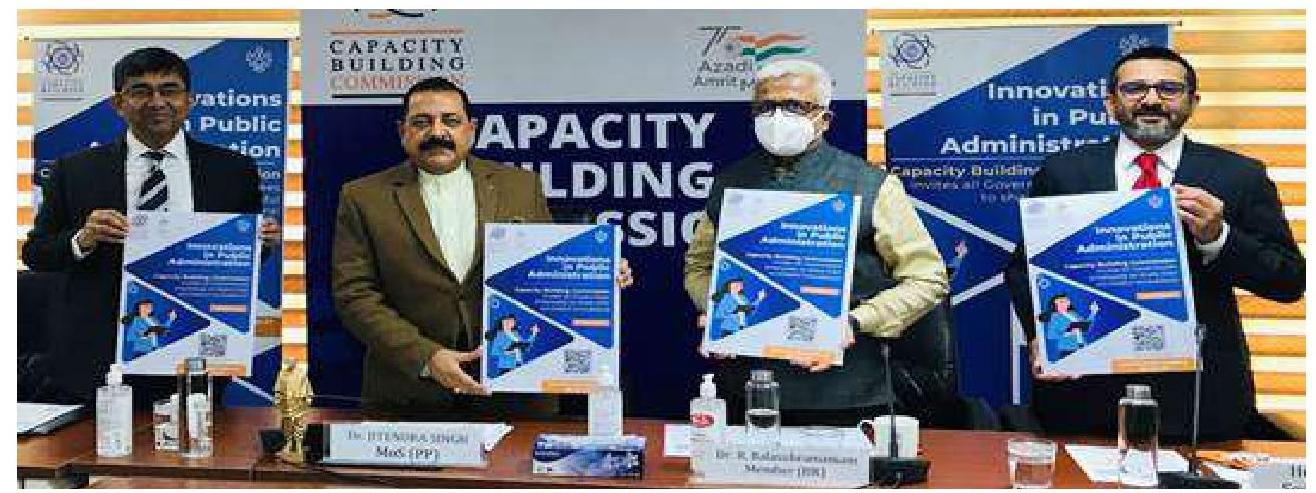
Dr Jitendra Singh Hon’ble MoS (PP) at the launch of “Innovation in Public Administration” Programme of CBC
f) CBC has launched CBC-MyGov portal for ‘Documenting Indian History of Public Administration’ in association with Nehru Yuva Kendra Sangathan and in collaboration with Flame University. This portal is helping in documenting local administrative histories from documented histories and oral traditions.
g) Capacity Building Commission is working with Urban Local Bodies (ULB) level to develop an integrated approach for enhancing capacity of Urban Local Bodies.
h) An online training for NYKS India volunteers was developed by CBC in collaboration with UNITAR and was launched by Hon’ble Minister of Youth Affairs & Sports and Information \& Broadcasting.
i) The Physical course on ‘Emerging Technologies’ developed by Capacity Building Commission (in partnership with Indian Institute of Public Administration (IIPA) and Wadhwani Institute of Technology and Policy) was launched by Hon’ble MoS, Shri Rajeev Chandrasekhar. It is designed as an introduction on key emerging technologies for civil servants, wherein the online part of the course is available on iGOT and is required to be completed by 2 days offline program at IIPA.
j) CBC has engaged 06 agencies for development of e-learning contents by Ministries/Departments/Organizations.
k) CBC has been working with Central Board of Direct Taxes (CBDT) on evolving a training program on Grievance redressal of taxpayers as part of its large-scale intervention.
1) CBC is also engaged in preparing its annual report of civil services in India by analysing the capacity of the civil services at three levels i.e. at individual level (of the civil servants), at Departmental level and across different civil service functions. The report would lay down the vision for high-capacity civil services, assess the capacity needs of the civil services and lay down its vision for transforming state capacity through Mission Karmayogi programme.
CHAPTER 10
ADMINISTRATIVE VIGILANCE DIVISION
10.0 Administrative Vigilance Division-I is responsible for examination of disciplinary cases and vigilance matters in respect of Indian Administrative Service officers working under the Central Government and State Governments under the All India Services (Discipline and Appeal) Rules 1969 and All India Services (Death-Cum-Retirement Benefits) Rules, 1958. Administrative Vigilance Division-I is also responsible for examination of disciplinary cases received from the Ministries / Departments in respect of Group ‘A’ officers of the Central Secretariat Service (CSS) and Central Secretariat Stenographers Service (CSSS) for initiation of disciplinary proceedings under Rule 14, Rule 16, Rule 19 of CCS (CCA) Rules, 1965 and under Rule 9 of CCS (Pension) Rules 1972.
10.1 The Division processes cases referred by the State Governments and Ministries / Departments under Government of India on the following issues:
- Proposals from the State Governments seeking to impose major penalty of dismissal / removal / compulsory retirement on members of IAS.
- Proposals from the State Governments seeking permission under the AIS (DCRB), 1958 Rules to initiate action against retired members of IAS.
- Proposals from the State Governments for imposing penalty of cut in pension against retired IAS officers.
- Proposals to initiate disciplinary proceedings / suspension of IAS officers working under the Government of India.
- Appeal against suspension submitted by IAS officers serving in the States.
- Memorial submitted by IAS officers against the orders passed by the Central Government or the State Governments in disciplinary proceedings in which the officer is aggrieved.
- Requests for sanction for prosecution against IAS officers under the Prevention of Corruption Act, 1988.
- Requests for sanction for prosecution under the Prevention of Corruption Act, 1988 against Group ‘A’ officers of the Central Secretariat Service (CSS) and Central Secretariat Stenographers Service (CSSS) cadres.
- Handling of Privilege Notices from the Members of Parliament received from the Lok Sabha / Rajya Sabha Secretariat as well as complaints against IAS Officers.
- Examination of vigilance status of IAS officers for purposes of empanelment/ training/ posting on deputation and other purposes as per extant guidelines. To facilitate this function, a Computerized Vigilance Information System is in operation with a central data base which can be accessed by the requisitioning Divisions concerned of this Department.
- Examination of vigilance status of all Group ‘A’ officers of the Central Secretariat Service (CSS) and Central Secretariat Stenographers Service (CSSS) cadres for various purposes viz. promotion, empanelment, deputation, VRS, etc as per extant guidelines.
- Advice / clarification to the State Governments / Central Ministries/ Departments on the procedural aspects of disciplinary proceedings.
10.2 Disciplinary Proceedings:
- Final orders in disciplinary proceedings against IAS officers were issued in four cases during 01.04.2022 to 31.12.2022.
- Two suspension cases against IAS officers serving in the State Governments were reviewed by the Central Review Committee and suspension period in these cases was extended. In six cases, suspension of IAS officers while serving in State Governments were confirmed and further extension of suspension period beyond thirty days was approved.
- Three appeals received under Single Window System, were examined and disposed of.
- One order deciding the memorial submitted by an officer against the penalty imposed by an earlier order was issued during 01.04 .2022 to 31.12 .2022 .
- During the period 01.04 .2022 to 31.12 .2022 , eight final orders in five disciplinary cases against Group ‘A’ officers of CSS was issued. In one case, charge sheet was issued against Group ‘A’ officers of CSS cadre.
- In one case, suspension against Group ‘A’ officer of CSS cadre were reviewed from time to time.
10.3 Sanction for Prosecution and Monitoring of Proposals of Sanction for Prosecution under provisions of Prevention of Corruption Act, 1988:
- Sanction for prosecution against IAS Officers was decided in twelve cases under Prevention of Corruption Act, 1988. Order of Sanction for prosecution was issued in respect of twelve IAS officers.
- No orders of sanction for prosecution was issued or denied under Prevention of Corruption Act, 1988 in respect of Group ‘A’ officers of CSS cadre.
10.4 Privilege Notices from Members of Parliament and Complaints against IAS officers:
- During the period 01.04.2022 to 31.12.2022, 25 Privilege notices against officials of Districts Administration for protocol violation were received from the Lok Sabha / Rajya Sabha Secretariat and processed during the period. 25 Privilege notices were finally disposed of.
- During the period from 01.04 .2022 to 31.12 .2022 , no complaints were received from Hon’ble Members of Parliament against IAS officers.
- During the period 01.04.2022 to 31.12.2022, 612 complaints against IAS officers were received and processed, and 552 complaints were finally disposed of.
- During the period 01.04 .2022 to 31.12 .2022 , 60 complaints against Group “A” officers of CSS/CSSS cadres were received and processed, and 60 complaints were finally disposed of.
Disagreement cases in disciplinary matters:
10.5 In order to bring about greater uniformity in existing disciplinary cases on behalf of the President, in cases where the President is the disciplinary authority and there is a difference of opinion between the CVC and the concerned Department, the Departments are required to consult the DoPT before taking a decision on not to accept the CVC’s advice. Similarly, disciplinary cases where Central Vigilance Commission advises major penalty and the UPSC favours a minor penalty or recommends exoneration, before the Disciplinary Authority takes a final view, the matter is to be referred to this Department for resolving the
disagreement. This Division has disposed of 01 such case, between 01.04.2022 and 13.02.2023.
Disagreement in the matter of Prosecution Sanction cases:
10.6 Similarly, the cases of disagreement between the CVC/ CBI and Sanctioning/Disciplinary Authority in the matter of Prosecution sanction cases are required to be referred to DoP&T for a final decision in terms of this Department’s OMs dated 01.03.2019 and 18.07.2019. As per these OMs, before taking a final decision for grant or denial of sanction for prosecution, the Competent Authorities shall obtain views of DoPT, in cases where they decide to differ with CVC’s advice. Accordingly, the views of DoP\&T may be taken into account while passing final speaking order. This Division has disposed of 11 such case, between 01.04.2022 and 13.02.2023.
Appointment of Central Vigilance Commissioner and Vigilance Commissioner
10.7 In terms of Section 4(1) of the Central Vigilance Commission Act, 2003, the President vide Warrant of Appointment dated $21^{\text {st }}$ July, 2022 has appointed Shri Suresh N. Patel, former MD \& CEO, Andhra Bank recommended by the Committee under the Chairmanship of Hon’ble Prime Minister as Central Vigilance Commissioner in the Central Vigilance Commission.
Further, in terms of Section 4(1) of the Central Vigilance Commission Act, 2003, the President vide two Warrants of Appointment dated $21^{\text {st }}$ July, 2022 has appointed Shri Praveen Kumar Srivastava, IAS (AM:1988) and Shri Arvinda Kumar, IPS (AM:1984) recommended by the Committee under the Chairmanship of Hon’ble Prime Minister as Vigilance Commissioners in the Central Vigilance Commission.
Central Vigilance Commission
Introduction
10.8 The Central Vigilance Commission (CVC) is the apex integrity institution mandated to combat corruption and ensure integrity in public life. It is a statutory body vested with superintendence over vigilance administration of various Ministries of the Central Government or corporations established by or under any Central Act, Governmentcompanies, societies and local authorities owned or controlled by that Government.
With its outreach measures, CVC also endeavours to create awareness for achieving transparency, accountability, probity and corruption free system of administration.
Statutory Provisions
10.9 CVC was set up by the Government of India through Resolution No. 54/7/64 dated 11.02.1964. Later on, it was accorded statutory status through the Central Vigilance Commission Act, 2003 (No. 45 of 2003) passed by the Parliament.
10.10 The role and functions of CVC include exercising superintendence over the functioning of DSPE (CBI) and monitoring progress of cases registered for investigation by DSPE under PC Act, 1988.
10.11 CVC also reviews the progress of cases pending with the competent authorities for grant of sanction for prosecution of employees of the organizations covered under its advisory jurisdiction, especially those in which sanction has been delayed.
10.12 CVC can inquire or cause inquiry into complaints/offences alleged to have been committed under the PC Act 1988 by employees as specified in Section 8 of the Central Vigilance Commission Act, 2003 (45 of 2003).
10.13 As part of superintendence over vigilance administration of organizations covered under its jurisdiction, CVC tenders advice in disciplinary matters having vigilance angle, involving officers covered under its advisory jurisdictions.
10.14 CVC is the designated agency to receive and act on complaints or disclosure on any allegation of corruption or misuse of office from whistle blowers under the “Public Interest Disclosure and Protection of Informers’ Resolution” (PIDPI), 2004. CVC, as the designated agency under PIDPI Resolution is empowered to take appropriate steps if the complaint is found to be motivated or vexatious.
10.15 Each organization covered under the advisory jurisdiction of the CVC has a vigilance unit headed by the Chief Vigilance Officer (CVO). The CVOs act as extended arms of the CVC andare responsible for timely action on advice tendered by the Commission, apart from ensuring proper implementation of the guidelines issued by CVC. One of the important functions of CVOs is to advise the authorities in the organizations for establishing effective systems and procedures and to periodically monitor compliance of the same to minimize systemic failures/loopholes, which provide opportunities for malpractices/irregularities.
10.16 As per Section 14 of the CVC Act, 2003, CVC submits an Annual Report of its activities to the President within six months of the close of the year under report. On receipt of such report, the President shall cause the same to be laid before each House of Parliament.
Multi-Pronged Strategy to combat Corruption
10.17 CVC has adopted a multi-pronged strategy to fight and eliminate corruption, which stresses not only on punitive vigilance but also on preventive mechanism and participative measures.
Punitive Vigilance
10.18 The Commission is of the firm view that time-bound and effective punitive action resulting in award of exemplary and adequate punishment acts as a deterrent to committing wilful misconduct. The Commission on its part tenders appropriate advice in respect of cases referred to it by various organisations. It reviews the progress of departmental actions periodically, through the mechanism of review meetings. The Commission seeks investigation report from the organizations concerned, in respect of those complaints where a specific issue with perceptible vigilance angle is found.
10.19 The advisory role of Commission extends to the specified categories of employees of the Central Government, corporations established by or under any Central Act, Government companies, societies and local authorities owned or controlled by the Central Government and for matters connected therewith or incidental thereto. Commission’s advisory role consist of a two-stage mechanism i.e. first stage advice, after completion of investigation but before initiating disciplinary action and Second Stage Advice(SSA), i.e after issuance of charge sheet to delinquent employee. On completion of the inquiry proceedings,
if the competent authority holds a view, which is different from Commission’s first stage advice, the Commission is to be approached for obtaining its second stage advice.
Preventive Vigilance
10.20 Central Vigilance Commission, the apex institution for vigilance administration in the country uses various tools for effective vigilance administration. Preventive Vigilance measures are amongst the most important tools to eliminate corruption as it improves upon existing systems, procedures and establishes in-built checks within the system to bring about standardisation, transparency, accountability and probity in Public administration.
10.21 The Commission, based on the inputs provided by the Stake-holders and on consideration of the Vigilance matters brought before it, advises systemic improvement measures.
10.22 The Systemic improvement measures in various fields, ranging from Human Resources Management, Banking and Financial Services, improvements in Contracts and Inventory Management, Project Management and Policy Initiatives, Automation of Operations to Transport & Infrastructure Management System etc. have been compiled in a booklet titled “Initiatives on Preventive Vigilance” released during VAW 2022.
Participative Vigilance
10.23 Commission endeavours to promote integrity in every day functions of citizens and elicits participation of all stakeholders in the fight against corruption. One of the major initiatives taken in this regard is the observance of Vigilance Awareness Week every year, to coincide with the birthday of Sardar Vallabhbhai Patel.
10.24 The theme of Vigilance Awareness Week(VAW) 2022 was “भ्रष्टाचारमुक्तभारतविकसितभारत” “Corruption free India for a developed Nation”. This was observed from $31^{\text {st }}$ October to $6^{\text {th }}$ November, 2022.
10.25 The observance of Vigilance Awareness Week commenced with the taking of the pledge by public servants in the Ministries/ Departments/ Central Public Sector Enterprises (CPSEs)/ Public Sector Banks (PSBs) and all other organizations, on $31^{\text {st }}$ October, 2022.
10.26 In the Vigilance Awareness Week 2022, in a move towards inculcating the true spirit of participative vigilance, Commission had issued instructions detailing a three-month campaign period ( $16^{\text {th }}$ August, 2022 till $15^{\text {th }}$ November, 2022) in which six different preventive vigilance measures were to be taken up as focus areas by all the Ministries/ Departments and Organizations. The different preventive vigilance cum internal house keeping activities taken up as focal areas by all the Ministries/ Departments/ Organizations included the following:
(i) Property Management;
(ii) Management of Assets;
(iii) Record Management;
(iv) Technological Initiatives comprising two parameters;
a) Website Maintenance \& updation;
b) Identification of new areas for service delivery for customers / staff to be brought on online portal and initiation of steps for creating online platform;
(v) Updation of guidelines / circulars / manuals wherever found necessary, and
(vi) Disposal of complaints outstanding as of 15/08/2022.
10.27 During Vigilance Awareness Week a function was held at Vigyan Bhavan on $03^{\text {rd }}$ November 2022. The Hon’ble Prime Minister of India, Shri Narendra Modi was the Chief Guest at the function which was attended by Dr. Jitendra Singh, Hon’ble Minister of State for Personnel, Public Grievances and Pensions and other senior serving / retired functionaries of various constitutional and statutory bodies, senior officers of various Ministries, Departments and other Central Government Organisations, Central Public Sector Enterprises, Principals, Heads of Educational Institutions as well as Students.
Integrity Pact
10.28 Public procurement being vulnerable area has been a priority concern of the Commission. In order to ensure transparency, equity and competitiveness in public procurement, the Commission has recommended adoption and implementation of Integrity Pact (IP) by Ministries / Departments / Public Sector Enterprises, Public Sector Banks, Insurance Companies, Financial Institutions and Autonomous Bodies, etc. The Integrity Pact involves signing of a Pact (Agreement) between the procuring organisation and the bidders that they will not indulge in corrupt practices in the tendering, award and execution of the contract. An Independent External Monitor (IEM) is nominated by the Commission to monitor the adherence to the Pact by the two sides. At the instance of Commission, the Ministry of Finance, Department of Expenditure vide OM No. 14(12)/2008-E-II(A) dated 19.07.2011 has also directed all the Ministries / Departments, attached / subordinate offices and Autonomous organisations for implementation of Integrity Pact in respect of Request for Proposal/ Procurement Transactions/ Contracts. The DPE has also vide its OM No. DPE/13(12)/11-Fin dated 09.09.2011 issued similar instructions for CPSEs. Further, in view of the increasing procurement activities of Public Sector Banks (PSBs), Insurance Companies (ICs) and Financial Institutions (FIs), the Commission vide Circular No. 02/02/2015 dated 25.02.2015 has advised them to adopt and implement the Integrity Pact. The Commission issues guidelines on Standard Operating Procedure (SOP) for implementation of Integrity Pact from time to time and also prepares the panel of IEMs.
10.29 Central Vigilance Commission from time to time has not only recommended for adoption of Integrity pacts but has also devised a Standard Operating Procedure for adoption and implementation of the Integrity Pact. The Standard Operating Procedure has been extensively revised and updated by Commission, vide Circular No. 05/01/22 dated 25.01.2022 bringing out more clarity about the methodology, role and responsibilities of IEMs.
Training and Capacity Building
Training of Inquiry Officers (IOs) and Presenting Officers (POs)
10.30 With a view to reduce the time taken in finalization of Departmental Inquiries; Commission has initiated a 3-day uniform Training Programme for Inquiry Officers (IO) and Presenting Officers (PO) of the Government organizations including PSUs and PSBs. Initially training was conducted through five Training Institutes, namely Institute of Secretariat Training & Management (ISTM), Central Academy for Police Training (CAPT), CBI Academy, HPCL Academy, National Productivity Council (NPC). Looking at the large number of nominations from the Banking and Insurance Sectors, Commission has separately identified Indian Institute of Bank Management (IIBM), Guwahati specifically for the IOs/POs of Banking and Insurance Sector.
10.31 Since the launch of the 3-day IO/PO training in August 2021, Commission has successfully organised training of 58 batches of IO/PO covering over 2166 officers. The
focus of Commission is to train adequate of potential IO and PO across the country. It is expected that the organizations will assign work only to the trained officers as IO and PO for conducting the departmental inquiries henceforth.
Induction Training for CVOs
10.32 The Commission has successfully organized a 5-day offline “Induction Training Programme” for CVOs from $20^{\text {th }}$ to $24^{\text {th }}$ June, 2022 at CBI Academy, Ghaziabad. Total 29 CVOs in Government Departments, CPSEs and Public Sector Banks etc. participated in the Induction Training Programme.
10.33 The Commission has initiated a 2-day Induction Training programme for newly appointed CVOs. First such Induction Training was held in the Commission on $15^{\text {th }} & 16^{\text {th }}$ December 2022 for 25 newly joined CVOs. This training programme would be organized once every quarter in the Commission.
Advanced Training on Vigilance Investigation
10.34 The Commission has organized a 3-day advanced training on Vigilance Investigation for CVOs from $12^{\text {th }}$ to $14^{\text {th }}$ December 2022 at Sardar Vallabhbhai Patel National Police Academy (SVPNPA), Hyderabad for 23 CVOs.
Training on Preventive Forensics
10.35 The Commission has considered the utility of Forensic Science in investigation of vigilance cases and designed a training programme to suit to all the CVOs/ Vigilance Officers across all the organizations for orienting them on preventive side of Forensics. From April, 2022, Commission is regularly organizing 3-day offline training on “Preventive Forensics” at National Forensic Sciences University, Gandhinagar. Total 258 participants from Government Departments, CPSEs and Public Sector Banks etc. have participated in these training programmes, so far.
Training on Public Procurement
10.36 Department of Expenditure in consultation with the Commission has recently released Manuals for Procurement of Goods, Works, Consultancy and other services. Considering the importance of understanding the procurement procedure in better appreciation of vigilance cases, Commission has organized two days training of CVOs on Public Procurement in batches. The first such training was conducted in the Commission on $29^{\text {th }}$ to $30^{\text {th }}$ September, 2022 for 33 CVOs . The second batch training was held on $1^{\text {st }} \& 2^{\text {nd }}$ December 2022 at NDMC Convention Centre, New Delhi for 63 CVOs.
10.37 The Commission has formulated a 3-day training programme for officers handling procurement in organizations under the jurisdiction of the Commission. This training 3-day programme on Public Procurement would be conducted in batches at Arun Jaitley National Institute of Financial Management (AJNIFM), Faridabad. First such training has been held at AJNIFM from $12^{\text {th }}$ to $14^{\text {th }}$ December 2022 for 31 participants.
Lokpal \& Lokayuktas Act, 2013 (No. 1 of 2014) \& related matters
10.38 In order to establish a more effective mechanism to deal with complaints relating to allegations of corruption against public servants, the Government of India enacted Lokpal and Lokayuktas Act, 2013, which came into force with effect from 16.01.2014. Further, the Lokpal and Lokayuktas (Amendment) Act, 2016 has been brought into force w.e.f. 16.01.2014.
The institution of Lokpal has been operationalized with the appointment of its Chairperson and Members in March, 2019.
Permanent office space for the Lokpal at the World Trade Centre, Nauroji Nagar, New Delhi is likely to be available for possession in the second half of 2023.
Rules made under the Act
10.39 The Central Government, in exercise of powers conferred by Section 59 of the Lokpal and Lokayuktas Act, 2013, have notified three sets of rules under clauses (a), (b), (g) and (h) under sub-section (2) thereof.
10.40 In terms of section 10(3) read with section 59 of the Act, the Government have also notified three sets of Recruitment Rules for appointment of officers and staff in the Lokpal.
All these rules have also been laid on the Table of the two Houses of Parliament.
Thus, the rules which are necessary for effective and efficient functioning of the Lokpal have already been framed and notified. The exercise to frame other Rules will be taken up as and when the need therefor is projected by the Lokpal.
10.41 The Prevention of Corruption (Amendment) Act, 2018:
(a) The Prevention of Corruption (Amendment) Act, 2018 brought in amendments aimed at use of uniform phraseology to facilitate clear and unambiguous interpretation.
(b) The amended law is more stringent and also ensures that adequate protection is provided to honest public servants for discharge of their duties without fear of any frivolous or vexatious investigation/ prosecution.
(c) The amended law consolidates all offences relating to receiving of bribe by a public servant under a single umbrella provision – Section 7, by incorporating the element of ‘mens rea’ for establishing an offence.
(d) The act of giving bribe has been expressly criminalized active bribery while also providing recourse for the bribe giver where he is forced to give bribe under compelling circumstances. The law also creates a specific offence for corrupt acts of commercial organisations and creating vicarious liability in case of consent or connivance of senior management.
(e) The amended law also lays down specific time lines for administrative processes for giving prior approval for inquiry/ investigation or prior sanction for prosecution, as also binds the judicial processes of conclusion of trial within a total period of 4 years to ensure speedy delivery of justice.
(f) Further, with a view to achieving uniform and effective implementation for prior approval processes, at the inquiry and investigation stages, a set of Standard Operating Procedures (SOPs) have been put in place to standardize and operationalize procedures under section 17A of the PC Act, while also ensuring that the statutory timelines are not compromised at the relevant stages.
(g) The Whistle Blowers’ Protection Act, 2014 (No. 17 of 2014) on $12^{\text {th }}$ May, 2014 was notified. However, the said Act requires amendments aimed at safeguarding against disclosures affecting sovereignty and integrity of India, security of the State, etc., before it is brought into force.
(h) Prevention of Bribery of Foreign Public Officials and Officials of Public International Organisation Bill, 2011 lapsed with the dissolution of the $15^{\text {th }}$ Lok Sabha.
CHAPTER 11
INTERNATIONAL COOPERATION
11.0 Brief: The International Cooperation Division deals with the matters pertaining to implementation of the review of United Nations Convention against Corruption (UNCAC), G20 Anti-Corruption Working Group (G20 ACWG) and BRICS Anti-Corruption Working Group (BRICS ACWG). The primary tasks of this Division emanate from the follow up to the ratification of the United Nations Convention against Corruption (UNCAC) and the other consequential international collaborative efforts on global platforms. This Division acts in conjunction with specialized agencies like the Central Vigilance Commission, Central Bureau of Investigation, Enforcement Directorate and other line Ministries entrusted with the specific tasks within their respective administrative domain, viz. combating corruption, extradition matters, prevention of money laundering, mutual legal assistance treaties, etc.
11.1 UNCAC: The United Nations Convention against Corruption (UNCAC) is a universally binding international legal Instrument to fight corruption at both domestic and global level and was adopted by the United Nations General Assembly in October 2003. The convention aims to bring in rationalization and uniformity in legal frameworks and in the approaches in the fight against corruption. The provisions contain both mandatory and non mandatory obligations. India signed the Convention in December 2005 and ratified the same in May 2011, after being satisfied of substantial compliance status of its domestic laws with the tenets of the Convention.
11.2 The Convention provides for a detailed mechanism for peer review of the status of implementation of its provisions by the Member States. This Department, in coordination with Ministry of Home Affairs, Ministry of Corporate Affairs, Ministry of External Affairs, Department of Legal Affairs; Constitutional bodies like CVC and UPSC; and other organizations like Central Bureau of Investigation, Enforcement Directorate, finalized the Executive Summary of $1^{\text {st }}$ cycle review on Chapter III (Criminalization and Law Enforcement) and Chapter IV (International Cooperation) of UNCAC in 2020. The second cycle review of implementation of Chapter-II (Preventive measures) and Chapter-V (Asset Recovery) of UNCAC has been initiated in November 2015.
11.3 Details of interactions held on various global platforms specific to UNCAC related issues during the period from April 2022 to March 2023 are indicated below:
| S. No. |
Description | Period | Organized by | Venue/Mode |
|---|---|---|---|---|
| 1. | $13^{\text {th }}$ Session of the Implementation Review Group | $\begin{aligned} & 13.06 .2022 \ & 17.06 .2022 \end{aligned}$ | UNODC | Vienna |
| 2. | $13^{\text {th }}$ Session of the Working Group on Prevention | $\begin{aligned} & 15.06 .2022 \ & 17.06 .2022 \end{aligned}$ | UNODC | Vienna |
| 3 | First resumed $13^{\text {th }}$ Session of the Implementation Review Group | $\begin{aligned} & 08.09 .2022 \ & 09.09 .2022 \end{aligned}$ | UNODC | Vienna |
| 4. | Second resumed $13^{\text {th }}$ Session of the Implementation Review Group | $\begin{aligned} & 07.11 .2022 \ & 11.11 .2022 \end{aligned}$ | UNODC | Vienna |
| 5. | $16^{\text {th }}$ Session of the Working Group on Asset Recovery | $\begin{aligned} & 07.11 .2022 \ & 11.11 .2022 \end{aligned}$ | UNODC | Vienna |
| 6. | $11^{\text {th }}$ session of Expert Meeting on International Cooperation | $\begin{aligned} & 07.11 .2022 \ & 11.11 .2022 \end{aligned}$ | UNODC | Vienna |
11.4 G20 ACWG: India is also a Member of G-20 Anti Corruption Working Group (ACWG). The focus of this Group is towards the global financial system, particularly from the point of view of denial of entry or visa to corrupt officials, providing measures to protect whistle blowers, promote effective functioning of anti corruption bodies and association of private and business sector in combating corruption. India has been participating in ACWG meetings. Three G 20 ACWG meetings are held every year. In the year 2022, Indonesia was the G 20 Chair, with Australia as Co-Chair. In the year 2023, India is chairing the G20 ACWG with Italy being the Co-Chair. The $1^{\text {st }}$ ACWG meeting will be held in Gurugram from $1^{\text {st }}$ to $4^{\text {th }}$ March, 2023.
11.5 India kept its focus on the topic of Fugitive Economic Offenders in continuation to the efforts on the same from previous years in G20 ACWG meetings of 2022. The basic objective behind this was to place the concern of India and other developing countries on the issue of black money and the need for deliberation in the anti-corruption group for enhanced international cooperation. India’s participation in this forum from 01.04.2022 till 31.03.2023 is as follows:
| S. No. |
Description | Period | Venue/Mode | |
|---|---|---|---|---|
| 1. | $1^{\text {st }} \mathrm{G} 20 \mathrm{ACWG}$ meeting of 2022 | 28.03 .2022 31.03 .2022 |
to | Virtual |
| 2. | $2^{\text {nd }} \mathrm{G} 20 \mathrm{ACWG}$ of 2022 | 05.07 .2022 08.07 .2022 |
to | Nusa Dua, Bali (Hybrid) |
| 3. | $3^{\text {rd }} \mathrm{G} 20 \mathrm{ACWG}$ of 2022 | 26.09 .2022 29.09 .2022 |
to | Virtual |
| 4. | $1^{\text {st }} \mathrm{G} 20 \mathrm{ACWG}$ meeting of 2023 | 01.03 .2023 04.03 .2023 |
to | Gurugram |
11.6 BRICS ACWG: BRICS Anti Corruption Working Group (ACWG) holds its meeting on the margins of G20 ACWG meetings at least twice every year to discuss strategies for presenting a united front for anti-corruption in G20 Anti Corruption Working Group meetings. Under China’s Chairmanship of BRICS ACWG in 2022, the $1^{\text {st }}$ BRICS ACWG meeting, $2^{\text {nd }}$ BRICS ACWG meeting & $3^{\text {rd }}$ BRICS ACWG meeting of 2022 were held on 22.03.2022 to 23.03.2022 (Virtual Mode), 30.06.2022(Virtual Mode) and 21.09.2022 (Virtual Mode) respectively on the sidelines of G20 ACWG meetings. South Africa is the President for 2023 BRICS ACWG meetings and $1^{\text {st }}$ BRICS ACWG meeting of 2023 will be held in Gurugram on 28.02.2023.
11.7 Other miscellaneous activities: Apart from the direct participations by the Department of Personnel and Training, the concerned Ministries/ Departments/ Organizations are representing the Government of India in respect of specialized areas. The role of DoPT in such cases is towards providing overarching support and inputs on global platforms include participation in FATF, SAARC, Stolen Asset Recovery (StAR) initiative etc.
CHAPTER 12
CENTRAL BUREAU OF INVESTIGATION CONSTITUTION, ORGANIZATION AND EVOLUTION OF CBI
A. Setting-up of Special Police Establishment
12.1 During the early stages of World War-II, the then Government of India realized that the enormously expanded expenditure for purposes connected with the war had brought about a situation in which unscrupulous and antisocial persons, both officials and non-officials, were enriching themselves dishonestly at the cost of the public and the Government. It was under these circumstances, that the setting up of a separate organization to investigate offences connected with these transactions was conceived. Consequently, the organization known as the Special PoliceEstablishment (S.P.E.) was created by the Government of India in 1941, by an Executive Order.
12.2 The functions of the S.P.E. were to investigate cases of bribery and corruption in transactions with which the War and Supply Department of the Government of India was concerned. The superintendence of the S.P.E. was vested in the then War and Supply Department. Towards the end of 1942, the activities of the S.P.E. were extended to include cases of corruption in the Railways also, presumably, because the Railways were strategically concerned with the movement and supply of war material.
12.3 An Ordinance No. XXII of 1943 was issued by the Government of India, by which a Special Police Force for the investigation of certain offences committed in connection with departments of the Central Government and with powers to investigate such offences, wherever committed in British India, was constituted. This Ordinance lapsed on $30^{\text {th }}$ September, 1946 and was replaced by the Delhi Special Police Establishment Ordinance No. 22 of 1946, which was subsequently replaced by the Delhi Special Police Establishment Act, 1946 (Act XXV of 1946). After the promulgation of the Delhi Special Police Establishment Act (DSPE Act, 1946), the superintendence of the Special Police Establishmentwas transferred to the then Home Department (later Ministry of Home Affairs) and its functions were enlarged to cover all Departments of the Government of India.
12.4 In 1953, an Enforcement Wing was added to the Special Police Establishment to deal with the offences under the Import and Export Control Act. With the passage of time, more and more cases under various laws other than Prevention of Corruption Act and violations of Import and Export Control Act were also entrusted to SPE. By 1963, SPE was authorised to investigate offences under 91 different sections of Indian Penal Code and 16 other Central Acts, besides offences under the Prevention of Corruption Act, 1947.
12.5 In 1963, the Delhi Special Police Establishmenthad 14 Branches, each under the charge of a Superintendent of Police. There were also two other Branches called the Central Investigating Agency comprising 2 squads, situated at Delhi, both having pan- India jurisdiction. At the Head Office of the CBI, the Delhi Special Police Establishment Division was under the direct charge of an Additional InspectornGeneral of Police under the overall control of the Inspector General of Police. The Branches of the Delhi Special Police Establishment were divided into two Zones, each under the charge of a Deputy Inspector General of Police.
B. Establishment and Evolution of CBI
12.6 The Central Bureau of Investigation (CBI) was established vide Resolution No.4/31/61-T dated 1st April, 1963 of the Ministry of Home Affairs, Government of India, which reads as follows:
“The Government of India have had under consideration the establishment of a Central Bureau of Investigation for the investigation of crimes at present handled by the Delhi Special Police Establishment including specially important cases under the Defence of India Act and Rules particularly of hoarding, blackmarketing and profiteering in essential commodities, which may have repercussions and ramifications in several States: the collection of intelligence relating to certain types of crimes; participation in the role of the National Central Bureau connected with the International Criminal Police Organization; the maintenance of crime statistics and dissemination of information relating to crime and criminals; the study of specialized crime of particular interest to the Government of India or crimes having all India or interstate ramifications or of particular importance from the social point of view; the conduct of Police research; and the coordination of laws relating to crime. As a first step in that direction, the Government of India have decided to set up with effect from $1^{\text {st }}$ April, 1963, Central Bureau of of Investigation at New Delhi with the following six Divisions, namely:-
I. INVESTIGATION AND ANTI-CORRUPTION DIVISION (DELHI SPECIAL POLICE ESTABLISHMENT)
II. TECHNICAL DIVISION
III. CRIME RECORDS AND STATISTICS DIVISION.
IV. RESEARCH DIVISION.
V. LEGAL & GENERAL DIVISION.
VI. ADMINISTRATION DIVISION.
The Charter of functions of the above said Divisions will be as given in the Annexure. The assistance of the Central Bureau of Investigation will also be available to the State Police Forces on request for investigating and assisting in the investigation of interstate crime and other difficult criminal cases.
12.7 Hence, CBI has evolved out of the Delhi Special Police Establishment (DSPE) with an enlarged Charter of functions. In fact, with the establishment of CBI on $1^{\text {st }}$ April, 1963, the Delhi Special Police Establishment was made one of its Divisions, viz. ‘Investigation and Anti-Corruption Division’.The Investigation \& Anti-Corruption Division (Delhi Special Police Establishment) was entrusted with the following mandate in the Resolution although it continued to derive its jurisdiction and powers from DSPE Act, 1946:
- Cases in which public servants under the control of the Central Government are involved either by themselves or along with State Government servants and/or other persons.
- Cases in which the interests of the Central Government or of any public sector project or undertaking, or any statutory corporation or body set up and financed by the Government of India are involved.
- Cases relating to breaches of Central Laws with the enforcement of which the Government of India is particularly concerned, e.g.:
(a) Breaches of Import and Export Control Orders.
(b) Serious breaches of Foreign Exchange Regulation Act.
(c) Passport frauds.
(d) Cases under the Official Secrets Act pertaining to the affairs of the Central Government.
(e) Cases of certain specified categories under the Defence of India Act or Rules with which the Central Government is particularly concerned. - Serious cases of cheating or fraud relating to the Railways, or Posts & Telegraphs Department, particularly those involving professional criminals operating in several States.
- Crime on the High Seas.
- Crime on the Airlines.
- Important and serious cases in Union Territories, particularly those by professional criminals.
- Serious cases of fraud, cheating and embezzlement relating to Public Joint Stock Companies.
- Other cases of a serious nature, when committed by organised gangs or professional criminals, or cases having ramifications in several States, including Union Territories, serious cases of spurious drugs, important cases of kidnapping of children by professional interstate gangs, etc. These cases will be taken up only at the request of or with the concurrence of the State Governments/Union Territories Administrations concerned.
- Prosecution of cases investigated by this Division.
C. Enlarging Role for Preventive Vigilance
12.8 To ensure probity, integrity, fairness and transparency in public life, MHA, vide Office Memorandum No. 130/1/66-AVD dated 5.5.1966, entrusted Central Bureau of Investigation (CBI) with several Anti-Corruption and Preventive Vigilance functions in respect of the Central Government Departments, Central Public Sector Undertakings etc., such as:-
(a) Preparation of Agreed List of Suspect Officers of Gazetted status.
(b) Preparation of list of Officers of Doubtful Integrity.
(c) Preparation of Agreed List of Points and Places of Corruption.
(d) Preparation of list of Undesirable Contactmen.
(e) Provide inputs to Departments, Undertakings or Administrations for preparation of the list of Unscrupulous Contractors, Suppliers, Firms and Clearing Agents.
(f) Preparation of Appreciation Reports regarding modes of corruption in various Government Departments and Public Sector Undertakings.
(g) Conducting Joint Surprise Checks and Special Drives.
(h) Provide inputs on Vigilance Status of officers for appointment to key positions.
(i) Discreet Verification \& Scrutiny of Complaints and Source Information Reports.
D. Jurisdiction of CBI vis-a-vis State Police
12.9 In order to secure cooperation between the Special Police Establishment and the Ministries/Departments of the Central Government, separate directives had been issued by
the Ministry of Home Affairs, Railway Board and the Army, Naval and Air Headquarters and Defence Production Organisation. Subsequently, these separate directives were replaced by one single directive, vide Minsitry of Home Affairs Office Memorandum No. 371/13/66AVD(III) dated 25.06.1969. Thereafter, amendments were issued by the Government of India from time to time, with the last revised version of the Directive incorporating all amendments issued vide, Office Memorandum No. 371/13/87-AVD.III dated 19.09.1988 by DOPT.
12.10 It was provided that Special Police Establishment enjoys with the respective State Police Force, concurrent powers of investigation and prosecution under the Criminal Procedure Code. However, to avoid duplication of effort, an adminstrative arrangment was arrived at with State Governments which mainly prescribed:-
a) The cases which substantially and essentially concern the Central Government employees or the affairs of the Central Government, even though involving certain State Government employees, are to be investigated by the Special Police Establishment. The State Police is, however, kept informed of such cases and will render necessary assistance to the Special Police Establishement during investigation; and
b) The cases which substantially and esentially involve the State Government employees or relating to the affairs of a State Government, even though involving certain Central Governmnet employees, are investigated by the State Police. The Special Police Establishment is informed of such cases and it extends assistance to the State Police during investigation, if necessary.
E. Expanding Role and Restructuring
12.11 The Economic Offences Division (EOD) in CBI was created vide Resolution No. 24/66/64-AVD, dated June 29, 1964. The scope of EOD was expanded from time to time to cover various economic offences mainly pertaining to serious frauds in Banks, Stock Exchanges, Financial institutions, Joint Stock Companies, Public Limited Companies, misappropriation of public funds, misallocation of national natural resources like Coal, criminal breach of trust, cheating of small investors through Ponzi Scheme and Chit fund Scams, Cyber Crime, IMPEX Laws, counterfeiting of currency, narcotics, drug trafficking, offences related to antiques, arts & treasures, piracy, forgery of travel documents/ identity papers, fraud in overseas job rackets, Wildlife crimes etc.
12.12 With the passage of time, requests were made by various quarters for CBI to take up investigation even in conventional crimes like homicide, kidnapping, large scale Banks and Insurance Frauds, complicated matters etc. Constitutional Courts also reposed faith in CBI and started referring cases to it for enquiry/investigation on the basis of petitions filed by the aggrieved persons in serious matters. This led to multi-dimensional growth of the agency.
12.13 In 1987, internal work distribution in agency broadly categorised Investigation work into Anti- Corruption Division and Special Crimes Division, the latter dealing with cases of conventional crimes as well as Economic Offences. Subsequently, in the wake of Secruties scam of 1992, a separate Banking Frauds and Securities Cell was created.Even after the establishment of separate divisions, creation of Special Cells was necessitated to take up investigation in important \& sensational cases of conventional nature like Special Investigation Team (SIT) was constituted in 1991 to investigate the case relating to the assassination of Shri Rajiv Gandhi, Special Investigation Cell was created in 1992 to investigate cases relating to the demolition of Babri Masjid in Ayodhya and Special Task Force was created in 1993 to take up investigation relating to Bomb blasts in Bombay.
12.14 A comprehensive internal work distribution was done in 1994 and divisions were given tasks as under:-
(a) Anti-Corruption Division – To deal with the cases of corruption and fraud committed by public servants of all Central Government Departments, Central Public Sector Undertakings and Central Financial Institutions.
(b) Economic Crimes Division-To deal with bank frauds, financial frauds, Import Export & Foreign Exchange Violations, large-scale smuggling of narcotics, antiques, cultural property and smuggling of other contraband items etc.
(c) Special Crimes Division – To deal with the cases of terrorism, bomb blasts, sensational homicides, kidnapping for ransom and crimes committed by the mafia/underworld.
12.15 The Legal Division of CBI was reconstituted as Directorate of Prosecution by Government of India, Ministry of Personnel, Public Grievances and Pensions, Department of Personnel \& Training, vide its OM No. 201/5/2000-AVD.II dated 9.7.2001. This was in pursuance to the direction of Hon’ble Supreme Court of India in Vineet Narain v/s Union of India case[(1998) 1 SCC 226]. The Directorate of Prosecution, CBI mainly performs the following functions:-
(i) Tendering Legal Advice in cases investigated by CBI.
(ii) Conducting and monitoring prosecution of cases investigated by CBI
(iii) Matters relating to the appointment of CBI Retainer Counsels and Special Counsels.
(iv) Matters relating to the notifications regarding appointment of CBI Prosecuting Officers under sections 24(2), 24(8) and 25(1-A) of the Code of Criminal Procedure, 1973 (Act No. 2 of 1974)
(v) Processing legal matters pertaining to the conferences and meetings.
(vi) Matters relating to interpretation of laws, statutory rules and regulations and amendments thereof.
(vii) Matters relating to notification under sections 3, 5(1) and 6 of the Delhi Special Police Establishment Act, 1946 (Act No. 25 of 1946).
(viii) Examination of Letter Rogatories.
12.16 In order to further improve the organisational efficiency, the organization was restructured with effect from 1.1.2009. The Organisation, with a view to increase efficiency, was divided into Branches supervised by the Zones. A new zone, namely, “Technical Forensic \& Coordination Zone” (TFC) was created at CBI Head Quarters, New Delhi. This zone is responsible for Technological up-gradation of CBI including functioning of Technological and Forensic Support Units (TAFSU) and strengthening inter-branch, interstate and international cooperation and coordination.
F. Interface with Central Vigilance Commission
12.17 In pursuance of the directions of the Hon’ble Supreme Court in the Vineet Narain case, the Central Vigilance Commission (CVC) was accorded statutory status by enactment of the Central Vigilance Commission Act, 2003. The Commission was vested with superintendence over DSPE, in terms of Section 4 of the DSPE Act as far as it relates to the investigation of cases under the Prevention of Corruption Act, 1988.
12.18 The appointments in CBI (including extension or curtailment of tenure) to the posts of the level of Superintendent of Police and above (except the Director) are to be done by the Central Government, on the recommendation of a Committee consisting of:-
(a) The Central Vigilance Commissioner
Chairperson;
(b) Vigilance Commissioners Members;
(c) Secretary to the Government of India in Member;
Charge of the Ministry of Home Affairs
(d) Secretary to the Government of India in charge of Member.
the Department of Personnel & Training
Provided that the Committee shall consult the Director before submitting its recommendation to the Central Government.
(2) On receipt of the recommendation under sub-section (1), the Central Government shall pass such orders as it thinks fit to give effect to the said recommendation.
12.19 The function and powers of the Commission, laid down in Section 8 of CVC Act, 2003 are as under:-
(a) exercise superintendence over the functioning of the Delhi Special Police Establishment in so far as it relates to the investigation of offences alleged to have been committed under the Prevention of Corruption Act, 1988 or an offence with which a public servant specified in sub-section (2) may, under the Code of Criminal Procedure, 1973, be charged at the same trial;
(b) give directions to the Delhi Special Police Establishment for the purpose of discharging the responsibility entrusted to it under sub-section (1) of Section 4 of the Delhi Special Police Establishment Act, 1946:
Provided that while exercising the powers of superintendence under clause (a) or giving directions under this clause, the Commission shall not exercise powers in such a manner so as to require the Delhi Special Police Establishment to investigate or dispose of any case in a particular manner;
(c) inquire or cause an inquiry or investigation to be made on a reference made by the Central Government wherein it is alleged that a public servant being an employee of the Central Government or a corporation established by or under any Central Act, Government company, society and any local authority owned or controlled by that Government, has committed an offence under the Prevention of Corruption Act, 1988 or an offence with which a public servant may, under the Code of Criminal Procedure, 1973, be charged at the same trial;
(d) inquire or cause an inquiry or investigation to be made into any complaint against any official belonging to such category of officials specified in sub-section (2) wherein it is alleged that he has committed an offence under the Prevention of Corruption Act, 1988 and an offence with which a public servant specified in subsection (2) may, under the Code of Criminal Procedure, 1973, be charged at the same trial;
(e) review the progress of investigations conducted by the Delhi Special Police Establishment into offences alleged to have been committed under the Prevention of Corruption Act, 1988 or the public servant may, under the Code of Criminal Procedure, 1973, be charged at the same trial;
(f) review the progress of applications pending with the competent authorities for sanction of prosecution under the Prevention of Corruption Act, 1988;
(g) tender advice to the Central Government, corporations established by or under any Central Act, Government companies, societies and local authorities owned or controlled by the Central Government on such matters as may be referred to it by that Government, said Government companies, societies and local authorities owned or controlled by the Central Government or otherwise;
(h) exercise superintendence over the vigilance administration of the various Ministries of the Central Government or corporations established by or under any Central Act, Government companies, societies and local authorities owned or controlled by that Government.
Provided that nothing contained in this clause shall be deemed to authorise the Commission to exercise superintendence over the Vigilance administration in a manner not consistent with the directions relating to vigilance matters issued by the Government and to confer power upon the Commission to issue directions relating to any policy matters;
12.20 The persons referred to in clause (d) of sub-section (1) are as follows:
(a) members of All-India Services serving in connection with the affairs of the Union and Group ‘A’ officers of the Central Government;
(b) such level of officers of the corporations established by or under any Central Act, Government companies, societies and other local authorities, owned or controlled by the Central Government, as that Government may, by notification in the Official Gazette, specify in this behalf.
(c)On the reference made by the Lokpal under proviso to sub-section (1) of section 20 of Lokpal and Lokayuktas Act, 2013, the persons referred to the clause (d) of sub-section (1) shall also include:
(i) Members of Group B, Group C and Group D services of the Central Government;
(ii) Such level of officials of staff of the corporation established by or under any Central Act, Govt. companies, societies and other local authorities, owned or controlled by the Central Government, as that Government may, by notification in the official Gazette, specify in this behalf.
Provided that till such time a notification is issued under this clause, all officers of the said corporations, companies, societies and local authorities shall be deemed to be the persons referred to in clause (d) of sub-section (1).
12.21 CVC exercises superintendence over the functioning of the DSPE in respect of investigation of offences under the PC Act. Issues discussed /reviewed during the Director, CBI and CVC Monthly Review Meetings are as under:
- Review of Under Investigation Cases under PC Act against Senior Govt. officers/ Politicians.
- Pendency of Under Trial cases under PC Act & their mode of disposal.
- Review of pending sanctions for prosecution under PC Act.
- Review of Under Investigation cases \& RDA against CBI Personnel
- Review of Vigilance Clearance for senior level govt. appointments.
- Review of Complaints referred by the CVC.
G. LOKPAL AND LOKAYUKTAS ACT, 2013
12.22 With the Lokpal and Lokayuktas Act, 2013 (Act No. 1 of year 2014), the Delhi Special Police Establishment Act, 1946 has been amended providing for selection of Director, CBI on the recommendation of a Committee consisting of the Prime MinisterChairperson, the Leader of Opposition recognized as such in the House of the People or where there is no such Leader of Opposition, then, the Leader of the single largest Opposition party in that House – Member and the Chief Justice of India or Judge of the Supreme Court nominated by him – Member.
12.23 The Act of 2013 further provides for a Directorate of Prosecution in CBI headed by a Director who shall be an officer not below the rank of Joint Secretary to the Government of India, for conducting prosecution of cases under this Act. The Director of Prosecution shall function under the overall supervision and control of the Director,CBI. The Central Government shall appoint the Director of Prosecution on the recommendation of the Central Vigilance Commission and the Director of Prosecution shall notwithstanding anything to the contrary contained in the rules relating to his conditions of service, continue to hold office for a period of not less than two years from the date on which he assumes office.
12.24 As per the Act, the Lokpal on receipt of a complaint, alleging commission of an offence punishable under PC Act, 1988 by a Public Servant, may order:-
(a)Preliminary inquiry against any public servant by the DSPE (CBI) to ascertain whether their exists a prima facie case for proceedng in the matter; or
(b)Investigation by DSPE (CBI) when there exists a prima facie case.
12.25 The Lokpal shall, notwithstanding anything contained in section 4 of the Delhi Special Police Establishment Act, 1946 and section 8 of the Central Vigilance Commission Act, 2003, have the powers of superintendence over, and to give direction to the Delhi Special Police Establishment in respect of the matters referred by the Lokpal for preliminary inquiry or investigation to the Delhi Special Police Establishment under this Act. Provided that while exercising powers of superintendence or giving directions as above, the Lokpal shall not exercise powers in such a manner so as to require the Delhi Special Police Establishment to investigate or dispose of any case in a particular manner.
H. CBI AS NATIONAL CENTRAL BUREAU (NCB)- NODAL POINT FOR INTERPOL IN INDIA
12.26 CBI has been the representative of the Country, since 1966, with International Criminal Police Organisation (ICPO), popularly known as INTERPOL. Director, CBI is the ex-officio Head of National Central Bureau of India (NCB-India).
12.27 NCB-India, also known as INTERPOL Wing of CBI, provides police-to-police communication and intelligence network for both State Police Agencies and Foreign Police Agencies. It also provides an interface to these agencies to seek assistance in criminal investigation that extends beyond their national boundaries.
12.28 Keeping in view the multifarious role being performed by NCB-India and to make it a vibrant and useful Support unit for CBI, State Police Forces, other Law Enforcement Agencies, MHA and MEA in the area of international police cooperation, an integrated unit by the name International Police Cooperation Unit (IPCU) consisting of two distinct though interlinked sub-units called NCB-India and International Police Cooperation Cell (IPCC), was set up.
12.29 NCB- India maintains I-24X7 communication network, processes requests for issuance of Notices including Red Notice and also processes the requests received from Law Enforcement Agencies of different countries through their NCBs, gather information through Interpol Liaison Officers (ILOs) of different States and transmits the same after due analysis, collates data from various enforcement and investigating agencies and provides the same to Interpol Database and retrieves and makes available data relevant to the Law Enforcement Agencies of India. It has also been providing support to the Ministry of Home Affairs, Ministry of External Affairs and DoPT in handling incoming and outgoing Requests for investigation as well as outgoing Extradition Requests, negotiation of Mutual Legal Assistance Treaties, Conventions, Extradition Treaties with other countries and various other arrangements.
12.30 International Police Cooperation Unit (IPCU), CBI holds Conferences acting as the nodal point for law enforcement agencies in the country. It coordinates with States, primarily, through Interpol Liaison Officers (ILOs) in pending matters of Extradition, Letters Rogatory (LRs), Mutual Legal Assistance / Requests in Criminal Matters, issuance of Notices and guidance for International aspect of Investigation.
I. SPECIALISED UNITS WITHIN CBI
12.31 Realizing the ominous trend of exponential growth of Cyber Crimes early, the Cyber Crime Investigation Cell was setup in CBI in 1999. The Ministry of Home Affairs, vide U.O.No.22011/1/2001-PMA dated 09.02.2001, nominated Cyber Crime Investigation Cell (CCIC) of the CBI as the nodal agency for developing national capabilities for fighting cyber-crime and to develop training courses for cyber-crime investigation for state police officers. In addition, Cabinet Secretary, vide DO letter no.281/29/6/2000 dated 03.06.2002, has designated this unit as the nodal point for investigating cases of hacking/defacement of Government Websites. CBI is Contact Point for G-8 24/7 Network for making requests for preservation of electronic data.
12.32 Cyber & Hi-Tech Crime Investigation \& Training (CHCIT) Centre has been set up at CBI Academy in June 2010 by Ministry of Information Technology, Government of India for capacity building in the areas of investigation of cyber-crime, through training and
providing tools and technology. The Centre aims to upgrade Cyber/Hi-Tech Crime investigation capabilities of CBI and also to provide world-class training to the investigators of CBI, State Police and Law Enforcement Agencies of South Asia and Asia Pacific Region.
12.33 Economic Intelligence Unit (EIU) was created in CBI in the year 2007 for collection, collation and dissemination of intelligence with regard to economic crimes. The specialized unit also coordinates with other stakeholders like Central Economic Intelligence Bureau (CEIB), Financial Intelligence Unit (FIU) etc.
12.34 Some units under the Economic Offences Divisions have been designated to handle the offences related to Narcotics & Drugs, Arms smuggling, Antique Theft and Smuggling and Wild Life Crimes and Counterfeiting and Fake Indian Currency Notes (FICN).
12.35 In addition, specific units have been dedicated in Economic Offences Divisions to specialize in investigation of niche areas of Narcotics \& Drugs, theft of Arts/Antiquities, Counterfeiting Fake Currency Notes (FICN) and Wildlife Crimes.
12.36 A Sports Integrity Unit has been established in CBI in the year 2014 forinvestigation/enquiry of matters concerning corruption in sports including sports bodies, match fixing, doping, illegal betting and any other offences related to sports by individual sportsmen or/their agents or /and the role of organized crime syndicates.
12.37 An exclusive MAC \& Linux Forensic Lab is also functioning at CBI Academy. This lab is a first of its kind in India and is equipped with the latest Apple workstations and Forensic data recovery software from Apple devices such as iMAC, MAC BookPro, iPhone, iPad, iPod etc. as well as from Linux devices. Forensic tools for cloning / imaging, password recovery, forensic analysis, internet artefacts recovery etc. are also available. Ministry of Home Affairs, in 2014, has identified CBI Academy as Centre of Excellence in the field of Cyber Forensics.
12.38 A new specialized Unit, namely, “On-Line Child Sexual Abuse and Exploitation (OCSAE) Prevention/Investigation Unit” has been created in CBI to collect, collate and disseminate information regarding publication, transmission, creation, collection, seeking, browsing, downloading, advertising, promoting, exchanging, distribution of information relating to online child sexual abuse and exploitation; and investigation of offences covered under the provisions of the Indian Penal Code (IPC) 1860, the Protection of Children from Sexual Offences (POCSO) Act, 2012 (32 of 2012) and the Information Technology Act, 2000 (21 of 2000) and under various Laws of the land, as applicable, which are in force.
12.39 With increasing number of Bank Fraud complaints, a need was felt to have a single point for receiving the same so that Bank Fraud cases are taken up earnestly, without delay. Accordingly, a cell has been created under BS\&F Zone in September, 2019 to deal with the complaints of Bank Frauds.
J. INTERNAL VIGILANCE
12.40 Members of Central Bureau of Investigation, the premier investigating agency fighting corruption, are required to maintain the highest standards of probity. As public, Constitutional courts and the Government repose so much faith in the CBI, it jealously guards its standards of integrity. Therefore, a very robust internal vigilance system has been put in place, which is constantly reviewed and upgraded. The policy of Zero Tolerance towards any questionable conduct on the part of any CBI officer deviating from the organisation’s motto of Industry, Impartiality and Integrity, is followed. The complaints
pertaining to the integrity, high handed behaviour or moral turpitude of any CBI personnel are dealt with, promptly, firmly and as per the laid down procedure.
K. TECHNOLOGICAL UPGRADATION
12.41 Set-up of Network for Evidence Tracing, Research and Analysis (NETRA) Lab for improving forensic capabilities of CBI
With the Vision to further strengthen investigative processes of CBI in the digital domain, System Division has set up NETRA (Network for Evidence Tracing, Research and Analysis) Lab. The lab has been equipped with state-of-the-art digital forensic tools like Magnet Axiom, Magnet Outrider, UFED 4PC, Nuix, etc. for the analysis of electronic evidence including, but not limited to, mobile devices, cloud storage and eDiscovery. The manpower deployed at NETRA includes both Technical Officers and Executive staff. It is envisaged that, with regular training and on-field exposure, CBI will be able to develop a sizeable pool of skilled digital investigators, equipped with domain expertise and skill-set to navigate the manifold challenges facing investigators in the digital era. NETRA’s Mission is to extract data from the electronic footprints, process it into actionable intelligence and aid investigation process.
12.42 Development of SAMADHAN Portal
SAMADHAN is an online portal for technical assistance to CBI Branches. Developed in-house by system division’s team, SAMADHAN Web Portal is a one-stop solution for all technical matters pertaining to forensic assistance, network issues, crime database related matters and all day-to-day issues including email, VPN, internet, website etc. It has been designed with a very user-friendly interface. Any CBI officer/official can lodge requests and get their resolution in transparent and efficient manner. The portal does not only provide an efficient channel for resolution of requests and providing technical assistance, but also provides relevant datasets to understand the nature of issues and frame necessary evidence based policies to improve efficiency and productivity in organization.
12.43 Measures to improve Cyber security of organization
Various measures have been taken to improve cyber security of organization. It includes the following:-
(i) Ensuring full scale organization wise deployment of end point security system with centralised maintenance and security policy implementation.
(ii) Inventory of all computer devices with their configuration, IP address, MAC address etc. has been prepared using in-house developed application, called EPICS(End-Point Information Capturing System). It provides better and quick identification of devices in case of possible security incidents and hence enables the security team to take timely remedial measures.
(iii) Internal Capacity has been developed for analysis and monitoring of logs to take timely pro-active measures. Tool has been developed for graphical visualization of logs. Efforts are underway to develop it as a full-fledged Security Operation Centre.
12.44 Integrated Complaint Management System (ICMS)
Web-based internet application, named ICMS is being developed for end-to-end tracking of each and every complaint received. The complaints received from various sources
viz. physical, email, CBI website etc. can be managed centrally and its different stages can be tracked to ensure disposal of complaints in efficient manner.
12.45 Development & Deployment of SAKSHAM
Saksham is an in-house developed portal which contains two modules i.e. Case Diary Management Module and Bank Fraud PoA Module. CD Management module is being used for effective monitoring of case diaries submitted by the investigating officers in the cases which are pending under investigation or further investigation. The POA module helps investigating officers in preparing and finalizing a standardized and uniform Plan-of-Action for the bank fraud cases. In this module, most commonly encountered bank fraud allegations have been identified to offer the to-do list of proposed activities to prove such allegations. Relevant reports can also be generated using the portal.
12.46 E-Governance project related development
(i) Integration of ICJS with CBI CAS Application to make CBI as one pillar of ICJS. It helps investigation officers to get access to the entire database including that of ecourts, Prison, CCTNS, IVFRT.
(ii) Development \& Implementation of various modules:-
- Budget Module to monitor and manage the expenditure under different heads efficiently.
- Vigilance Module to automate the process of seeking vigilance clearances from concerned branches of CBI.
- Auto-forward feature of APAR to ensure strict adherence to APAR timelines and also implementation of NRC feature to ensure the application caters entire process of APAR submission and review.
- ID Card Module to enable end-to-end processing of ID card applications.
- Grievance Module to provide efficient channel to the CBI employees for lodging their grievances and seek redressal.
- Library Module to enable management of books, records, publications etc. of library in efficient manner.
L. FUNCTIONING OF CBI
12.47 CBI derives its power to investigate from DSPE Act, 1946. Section 2 of the Act vests DSPE with jurisdiction to investigate offences notified under section 3 of the Act in the Union Territories only. However, the jurisdiction of the DSPE Act can be extended by the Central Government to other areas, including Railway areas and States under Section 5(1) of the Act, provided a State Government accords consent under Section 6 of the Act. The Executive Officers of CBI of the rank of Sub-Inspector and above exercise all powers of a Station Officer-in-charge of the Police Station for the concerned area for the purpose of investigation. As per Section 3 of the Act, Special Police Establishment is authorised to investigate under those sections of law, which are notified by the Central Government from time to time. The Hon’ble Supreme Court of India and the Hon’ble High Courts also entrust matters for Investigation or Enquiry to CBI. These may be new cases or cases which are already registered by the State Police or other investigating agencies. In the cases entrusted to CBI by the Hon’ble Supreme Court or the Hon’ble High Courts, there is no requirement for any notification under section 5 or 6 of the DSPE Act, 1946.
12.48 The superintendence of the Delhi Special Police Establishment in so far as it relates to investigation of offences alleged to have been committed under the Prevention of Corruption Act, 1988, vests in the Central Vigilance Commission. The superintendence in all other matters vests in the Central Government.
12.49 The administration of Delhi Special Police Establishment vests in an officer appointed in this behalf by the Central Government (referred to as the Director), who shall exercise in respect of that police establishment, such of the powers exercisable by an Inspector-General of Police in respect of the police force in a State as the Central Government may specify in this behalf.
12.50 The Director CBI heads the organization and is assisted by Special Director(s) and Additional Director (s). The organization is divided into Zones, each headed by a Joint Director. The Zones may be classified into Investigating Zones and Support Zones/Divisions.
12.51 CBI has 18 investigative Zones and 67 investigative Branches spread across India. The Investigating Zones, comprise of Branches, which are headed by DIG/SP and report to Joint Directors, who report to Director, CBI through a Special Director/ Additional Director. Some of these Zones have Ranges under them, which are headed by DIG. They supervise the branches falling within their jurisdiction.
12.52 Each Branch is primarily specialized in nature and belongs to one of the three categories – Anti Corruption; Economic Offence; Special Crime. Some of these Branches have territorial jurisdiction over a particular area, while some branches have all India jurisdictions and are centrally located. Some of the Zones are central zones comprising of specialized nature of Branches, having all India jurisdiction; whereas, the others are Territorial Zones, which comprise of Branches of different nature, falling within its territorial jurisdiction.
12.53 At the Headquarter, there are Support Zones/Divisions viz. Administration Division, Policy Division, Training Division and Technical Forensic Coordination (TFC) Zone. Besides, there is a Directorate of Prosecution under the Director of Prosecution, which functions under the overall supervision and control of the Director, CBI.
12.54 Over the years, the Central Bureau of Investigation has emerged as a Premier Investigating Agency of the country, which enjoys the trust of the people, Parliament, Judiciary and the Government. The organisation has evolved from an Anti-Corruption Agency to a Multifaceted, Multi-Disciplinary Police Investigative Agency with capability, credibility and legal mandate to investigate and prosecute offences. As on date, offences under existing 105 Central Acts, 48 State Acts and 286 offences under the Indian Penal Code have been notified under section 3 of the DSPE Act, 1946.
M. HUMAN RESOURCE AND INFRASTRUCTURE UPGRADATION
12.55 CBI derives its strength from its multi-disciplinary character which is ensured by getting officers from various services, professions and streams.
12.56 The total sanctioned strength of CBI as on 31.12.2022 was 7295 against which 5600 officers were in position and 1695 posts were vacant. The vacancies existed in the ranks of Special/Additional Director (01), Joint Director (02), Deputy Inspector-General of Police (11), Senior Superintendent of Police (09), Superintendent of Police (54), Additional Superintendent of Police (01), Deputy Superintendent of Police (65), Inspector (360), SubInspector (204), Assistant Sub-Inspector (51), Head Constable (123), Constable (281). The
posts of (71) Law Officers, (52) Technical Officers, (367) Ministerial Staff and (43) Canteen staff at various levels were lying vacant.
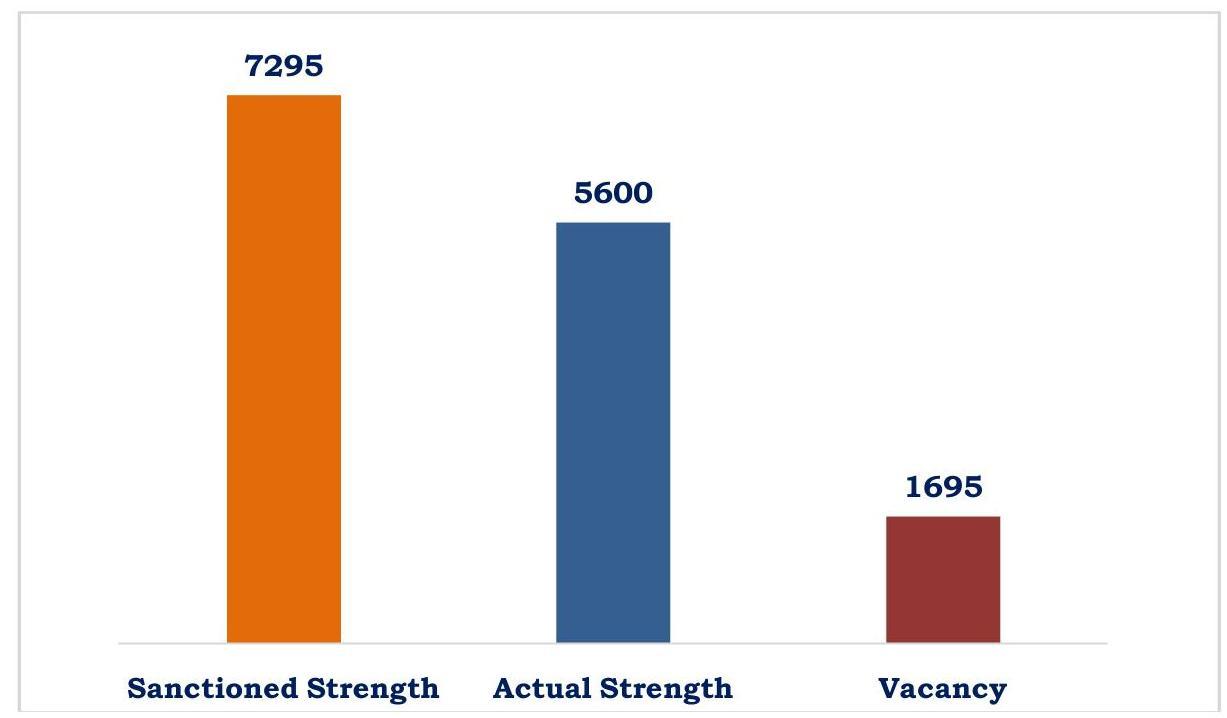
12.57 To provide better office-cum-residential environment, various projects relating to construction of office/residential buildings/quarters in various CBI branches areunderway as part of the scheme- “Comprehensive Modernization and purchase of land and construction of office/residence buildings for CBI” under which funds to the tune of Rs. 39.06 Crore were allocated in the Revised Estimates for 2022-23.
Induction
12.58 During the year 2022, total 308 Officers/Officials were inducted on deputation in CBI in different ranks comprising of Joint Director (1), Deputy Inspector General of Police (4), Superintendent of Police (9), Deputy Superintendent of Police (11), Inspector [(State Police/CPOs/other Central Govt. org./Bank Officer- (55)], and Constable (228).
Extension in Deputation Tenure
12.59 During the year 2022, deputation tenure of 133 personnel was extended in the different ranks comprising of Joint Dierctor (5), Deputy Inspector General (5), SP (3), DSP (3), Chief Informaton Officer (1), Deputy Advisor (1), Inspector (20) and Constable (95).
Direct Recruitment
12.60 During the year 2022, 175Officers/Officials were recruited in different ranks under direct recruitment quota comprising of Public Prosecutor (38), Assistant Public Prosecutor (26), Sub-Inspector (47), Steno Grade-II (5), Junior Hindi Translator (2) Lower Division Clerk (36), MTS (20) and Wash Boy (1).
Departmental Promotion Committee
Promotion
12.61 During the year 2022, 39 meetings of DPCs/Review for Promotions of Executive and Ministerial Staff were held and 779 officers/ officials were promoted in different ranks comprising of DIG(7), Sr.SP (12), SP(30), ASP(67), DSP(76), Inspector (137), Sub-Inspector (28), ASI(91), Head Constable (78), DLA(16), Sr.PP (28), PP (2), OS(14), CA(26), UDC (52), LDC (4), Sr.PS(14), PS (10), SG-I (86) and SSA(1).
Grant of MACP
12.62 During the year 2022, total MACP were granted to 294 Officers/Officials of different ranks comprising of ASP(1), DSP(5), Inspector (13), ASI (6), Head Constable (43), Constable (78), Sr.PP (4), PP(2), PS(2), SG-I(5), SG-II (69), Programmer (1), Assistant Programmer (8), CA (8), UDC (13), LDC (28), Data Entry Operator (2) and MTS & Canteen Staff (6).
N. CRIME STATISTICS
Registration
12.63 Criminal Cases viz. Regular Cases (RCs) or Preliminary Enquiries (PEs) were registered by the CBI on the basis of references received from Government Departments, Statutory authorities like Central Vigilance Commission, Constitutional Courts (Hon’ble Supreme Court and High Courts) and references received from the State Governments and also on the basis of its own information. CBI is not the first responder and has limited manpower and resources. So, due care is taken to ensure that only good cases are registered.
12.64 During the year 2022, 946 Regular Cases/Preliminary Enquiries [RCs-829, PEs117] were registered. Out of these 946 cases, 107 cases were taken up on the directions of the Constitutional Courts and 30 cases on the requests of State Governments/Union Territories. Other than these, 28 references received from Hon’ble Lokpal were taken up.
DISPOSAL FROM INVESTIGATION/ENQUIRY
12.65 The investigation in cases was expedited in the year 2022 and as a result, investigation was completed in 905 cases comprising of 819 Regular Cases (RCs) and 86 Preliminary Enquiries (PEs).The investigation is analyzed with the assistance of Law Officers so as to present the best evidence in admissible form before the court of law. Other than these, 09 Lokpal references in form of Inquiry/Status Report filed were also completed.
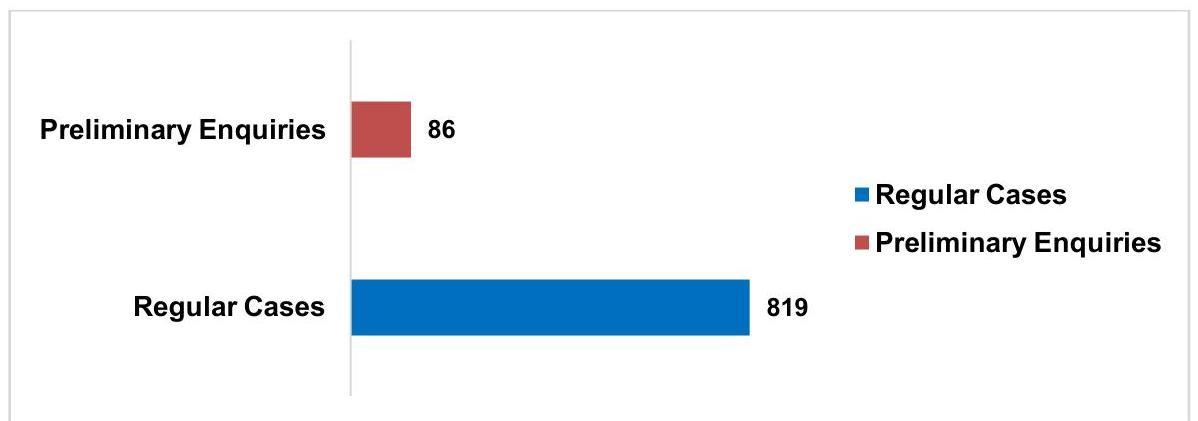
12.66 MODE OF DISPOSAL
12.66.1 Mode of disposal of RCs
Out of 819 Regular Cases [RCs], Prosecution, Prosecution & RDA was recommended in 730 cases, only RDA was recommended in 4 cases. The break-up of the disposal of 819 RCs from investigation, is depicted as under:-
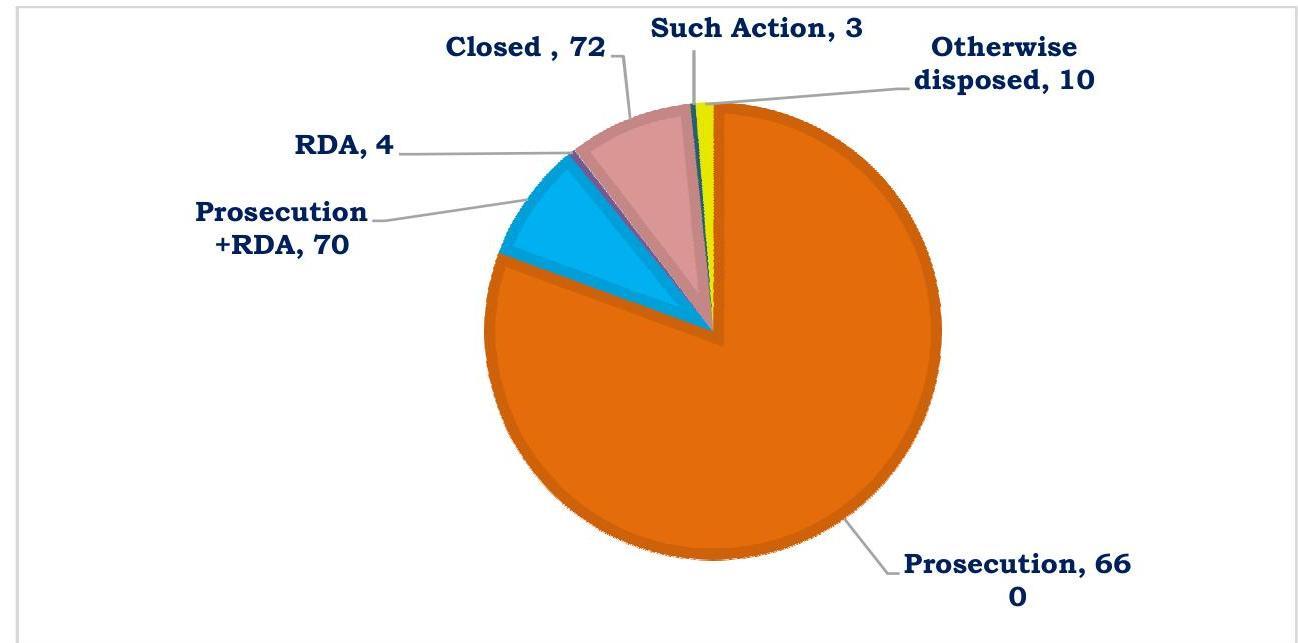
12.66.2 Mode of disposal of PEs
Out of 86 PEs, 32 PEs were converted into Regular Cases (RCs) and RDA was recommended in 3 PEs. The break-up of the disposal of 86 Preliminary Enquiries (PEs), is depicted as under:-
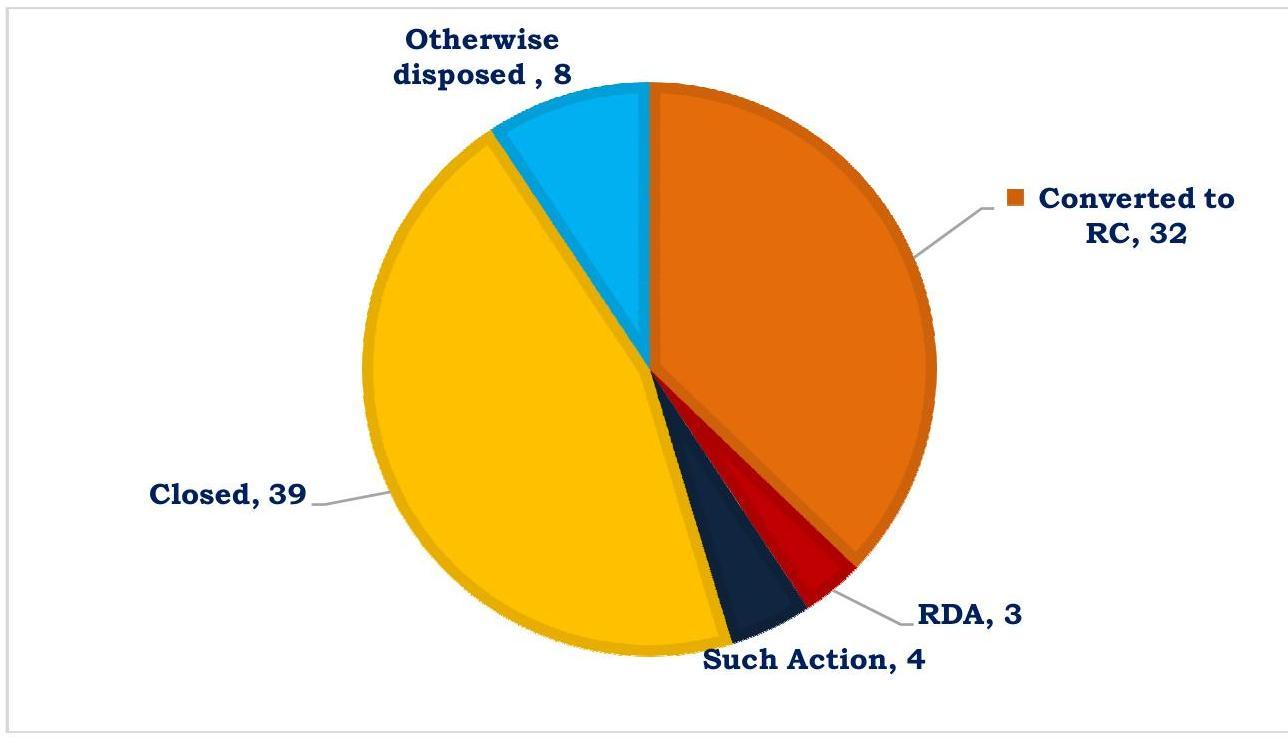
12.67 CASES PENDING UNDER INVESTIGATION/ENQUIRY
A total number of 1025 of cases(RCs 943, PEs 82) were pending under investigation/ enquiry at the end of the year. Other than this, 23 Lokpal references were pending at the end of year. Out of 943 RCs, 447 RCs were pending under investigation for more than one year. Similarly, out of 82 PEs, 60 PEs were pending under enquiry for more than three months.
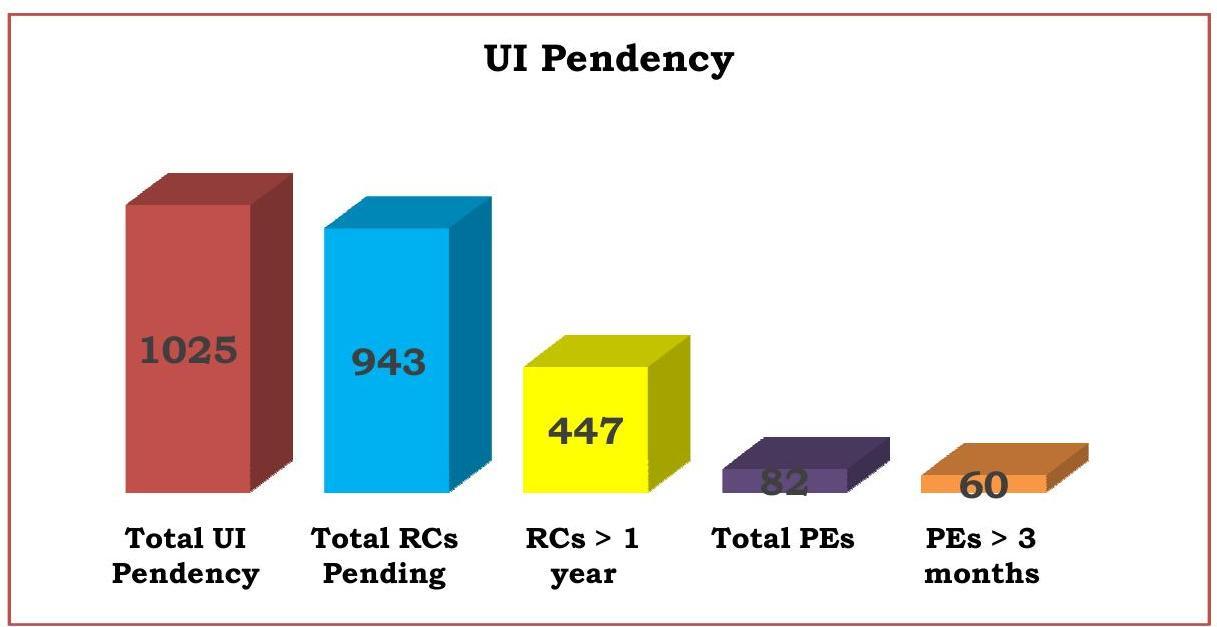
12.68 TRIAL
During the year 2022, Courts delivered Judgements in 557 Court Cases of CBI. Out of these, 364 cases resulted in Conviction, 111 in Acquittal, 13 in Discharge and 69 cases were disposed of for other reasons. The conviction rate was $\mathbf{7 4 . 5 9 %}$.
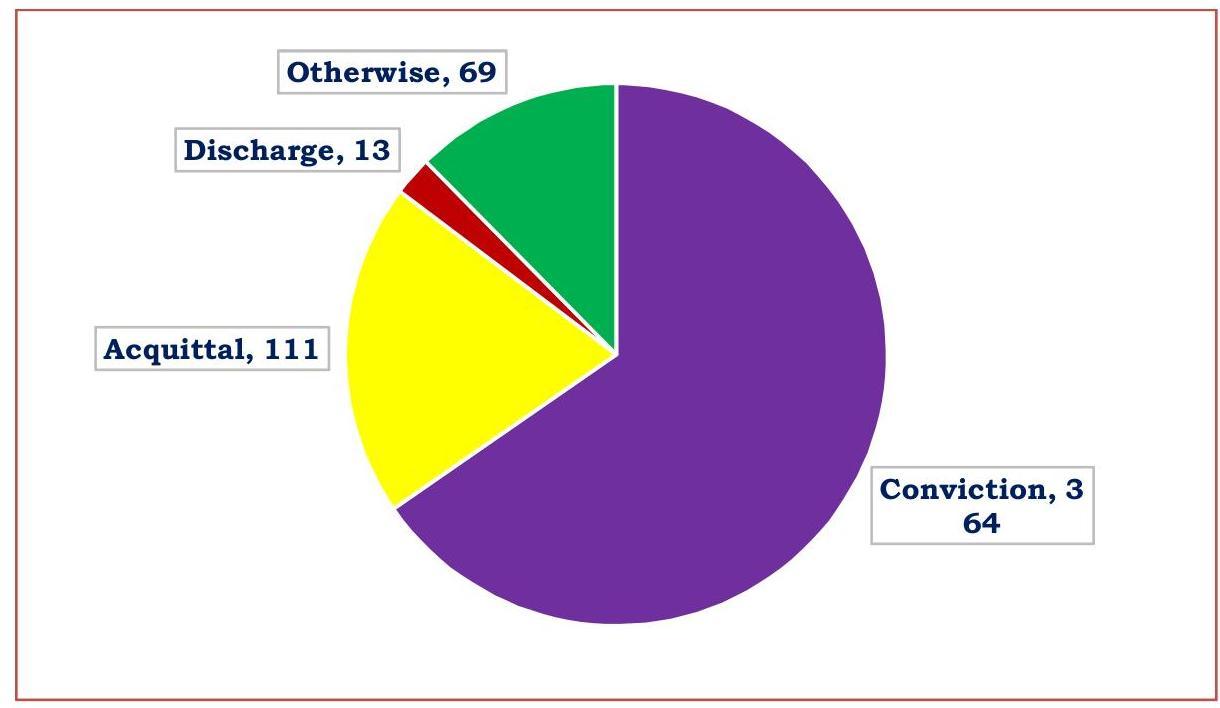
A total numberof 10732 Court Cases were pending under trial in various Courts as on 31.12.2022.
O. COORDINATION
Coordination with Law Enforcement/State/Union Territory
12.69 CBI plays a key role in facilitating improved coordination between State/UT Police agencies. Tackling interstate crimes and organized crime requires enhanced coordination, information exchange and communication between police agencies across the country. CBI has been active in providing common platform for bringing together police professionals from across the country. Going forward, CBI strives to create more robust and institutionalized platforms for enhanced interstate coordination among police agencies.
$90^{\mathrm{TH}}$ INTERPOL GENERAL ASSEMBLY
12.70 INDIA hosted the $90^{\text {th }}$ INTERPOL General Assembly during $18^{\text {th }}-21^{\text {st }}$ October, 2022 coinciding with Azadi ka Amrit Mahotsav, commemorating 75 years of India’s independence. CBI, being the National Central Bureau (NCB) of INTERPOL in India, played the pivotal role in the successful orchestration of the esteemed event. The General Assembly was attended by delegation of 166 member countries comprising more than 700 delegates including Ministers, Police Chiefs of countries, Heads of National Central Bureaus (NCBs) and senior Police officers. To mark the glorious occasion, the Government of India has released commemorative stamp and coin.
12.71 The Hon’ble Prime Minister of India, while inaugurating the INTERPOL General Assembly, highlighted the connection of Interpol philosophy with Indian culture and underlined the similarity between the INTERPOL’s motto of ‘Connecting Police with a Safer World’ with quote from the Vedas stating “Aano Bhadra Krtavo Yantu Vishwatah” i.e. let noble thoughts come from all directions, elaborating it as a call for universal cooperation to make the world a better place. It was also emphasized that the pace of change of globalized threats such as Terrorism, corruption, drug trafficking, poaching and organized crime, is faster than earlier. It was felt that it is the high time that the world comes together to defeat these threats.
12.72 The Assembly adopted Resolution for strengthening INTERPOL’s collaborative response to disrupting financial crime and corruption. The resolution strongly echoed India’s firm commitment to combat financial crimes and corruption. The Assembly also adopted Resolution for supporting countries in their efforts to identify and investigate online child sexual exploitation. INTERPOL’s first-ever Global Crime Trend report was also presented to delegates during 90th INTERPOL General Assembly.
12.73 On the sidelines of 90th INTERPOL General Assembly, the delegation from India had bilateral meetings with delegations from several countries to discuss matters related to police cooperation inter alia for enhancement of criminal intelligence sharing; geolocation of fugitives and criminals; combating terrorism, terror financing and online radicalization; coordinating efforts to prevent cybercrimes and online child sexual exploitation.
12.74 In the last 100 years, INTERPOL has become a comprehensive and effective forum of 195 countries, which is playing a vital role in cracking down on crimes around the world. Terrorism, being the biggest violation of human rights, is appropriately placed at the first and most important of the 7 global policing goals of INTERPOL for the period 2020-2025.
12.75 The Government of India and Law Enforcement Agencies appreciate the meaningful efforts and contributions of INTERPOL for public security, world peace and stability.
$8^{\mathrm{TH}}$ INTERPOL LIAISON OFFICERS CONFERENCE ORGANIZED BY CBI ON $22^{\mathrm{ND}}$ MARCH, 2022
12.76 The $8^{\text {th }}$ INTERPOL Liaison Officers conference was organized on 22nd March, 2022 on a virtual platform. The theme of the conference was “Tracking Crime and Criminals Globally”. The Conference was inaugurated by Shri Ajay Kumar Bhalla, Home Secretary to the Govt. of India and addressed the gathering through the virtual platform.
VISIT OF DELEGATION FROM BANGALADESH
12.77 A delegation led by Dr. Benazir Ahmed, IGP, Bangladesh visited CBI HQ during the 2nd National Conference on Cyber Crime Investigation and Digital Forensics on 04.04.2022.
COLOMBO SECURITY CONCLAVE: VIRTUAL EVENT ON ORGANIZED CRIME: REGIONAL TRENDS AND CHALLENGES $3^{\text {RD }} & 4^{\mathrm{TH}}$ AUGUST, 2022.
12.78 Colombo Security Conclave (erstwhile Trilateral Maritime Cooperation between India, Sri Lanka and Maldives) has been established with a Secretariat in Colombo, Sri Lanka. As a part of the Colombo Security Conclave’s activity pillar ‘Combating Trafficking and Transnational Organized Crime’, an Expert Roundtable (virtual) of experts on ‘Organized Crime: Regional Trends and Challenges’ was organized on $3^{\text {rd }} \& 4^{\text {th }}$ August, 2022 in virtual mode by CBI in concurrence with NSCS. The event was inaugurated by Shri S.K. Jaiswal, Director, CBI.
WORKSHOP OF INTERPOL LIAISON OFFICERS ON “LRS/MLAT AND EXTRADITION MATTERS”
12.79 Interpol Liaison Officers Workshop was organised by CBI on $27^{\text {th }}$ December, 2022 on the subject “LRs/MLAT AND EXTRADITION MATTERS”. Shri Ajay Kumar Bhalla, Union Home Secretary inaugurated the workshop. The participants including Interpol Liaison
Officers (ILOs) from States, Union Territories, other Law Enforcement Agencies (LEAs) & officers from CBI attended the Workshop.
VISITS OF FOREIGN DELEGATES TO CBI HEADQUARTERS
VISIT OF MR. STEPHEN KAVANAGH, EXECUTIVE DIRECTOR POLICE SERVICES, INTERPOL
12.80 Mr. Stephen Kavanagh, Executive Director Police Services of INTERPOL visited CBI Headquarters along with Mr. M.M. Oberoi, Director, Cyber Crime Directorate IGCI, Singapore on $1^{\text {st }}$ August, 2022.
VISIT OF MR. CRAIG JONES, CYBER CRIME DIRECTOR, INTERPOL TO CBI HQ ON $16^{\mathrm{TH}}$ AUGUST, 2022
12.81 Mr. Craig Jones, Cyber Crime Director, INTERPOL visited CBI Headquarter on $16^{\text {th }}$ August, 2022 and interacted with senior officers of Cyber Crime Investigation Division of CBI on their recent investigations and cases and legal framework in India for combating cybercrimes.
12.82 LETTERS ROGATORY (OUTGOING)
During the year 2022, 62 Letters Rogatory (LRs) were sent abroad, out of which, 46 LRs pertain to CBI cases and 16 pertain to State Law Enforcement and Central Law Enforcement agencies. It was confirmed by Indian Law Enforcement Agencies including CBI that 19 LRs are fully executed. These 19 LRs include 17 LRs of CBI and 2 LRs of State Police and other Law Enforcement Agencies. During 2022, 7 LRs were also treated as closed/ withdrawn. Out of these 7 LRs, 3 relate to CBI and 4 relate to other Law Enforcement Agencies.
As on 31.12.2022, a total of 538 LRs are pending with other countries out of which 299 pertain to CBI cases and 239 pertain to State Police and other Central Law Enforcement Agencies.
Further in the year 2022, for the purpose of sending/executing LR/MLA, the Ministry of Home Affairs has developed a portal which is available at the URL: https://mlat.mha.gov.in w.e.f. $1^{\text {st }}$ December, 2022.
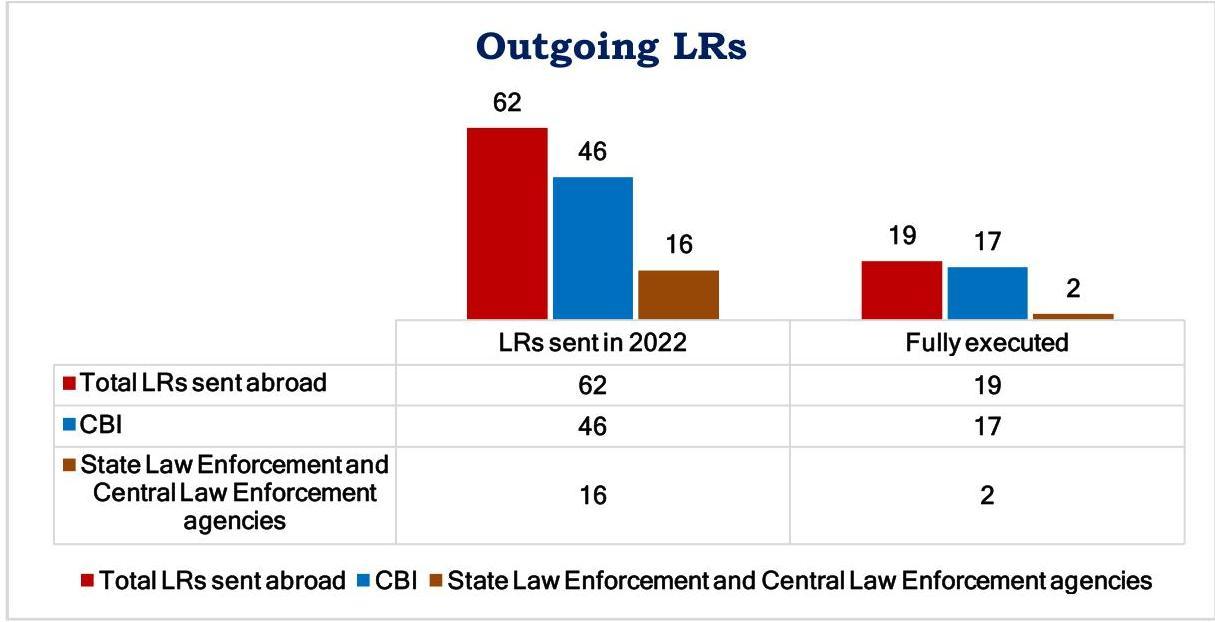
12.83 LETTERS ROGATORY (INCOMING)
During the year 2022, as many as 114 Letters Rogatory (LRs)/Treaty Based Requests were received from various countries requesting to provide assistance in the investigation of criminal matters. Besides these, 04 LRs/MLA requests were received as Addl./Supplementary requests. Execution Reports in 112 cases were sent to MEA/ MHA, after receiving the same from Indian Investigating Agencies, for onward transmission to the law enforcement agencies of the requesting countries. Besides these, 13 LRs/ MLA requests were otherwise disposed off as closed or withdrawn. As on 31.12.2022, 137 LRs/ MLA Requests are pending for execution.
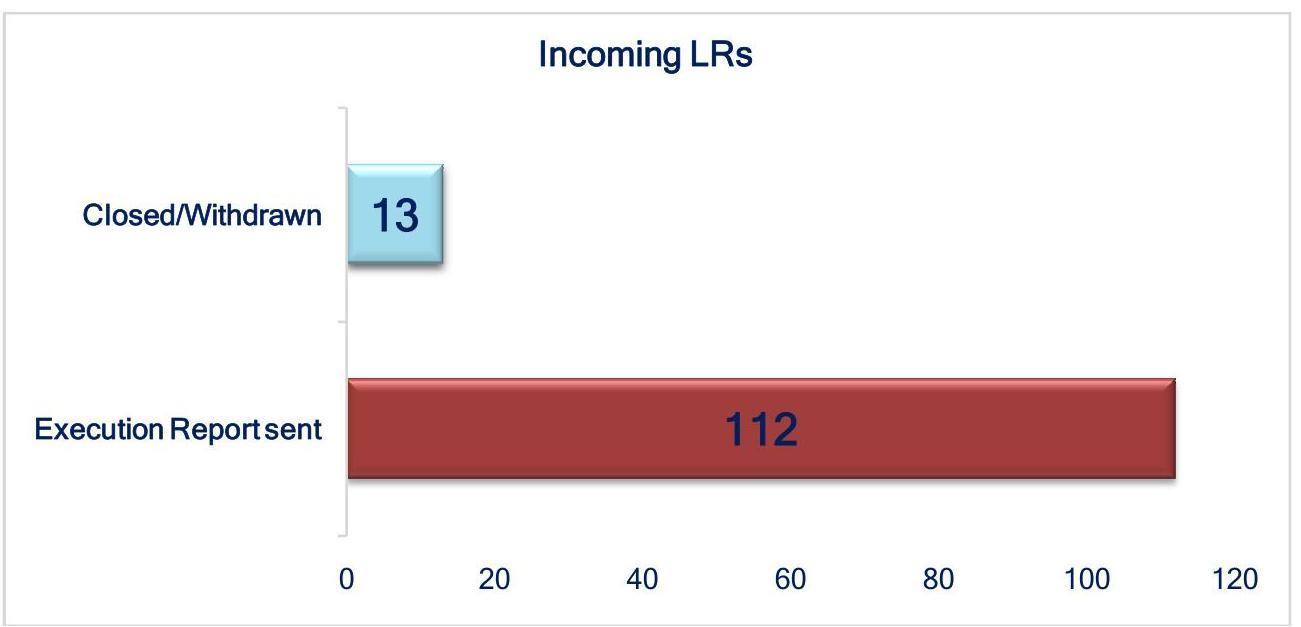
P. INTERPOL NOTICES
12.84 During 2022, notices as per details below, were published by NCB-India:-
| Red Notices | $\mathbf{4 0}$ |
|---|---|
| Blue Notices | $\mathbf{6 9}$ |
| Yellow Notices | $\mathbf{1 7}$ |
INTERPOL NOTICES ISSUED BY NCB-INDIA
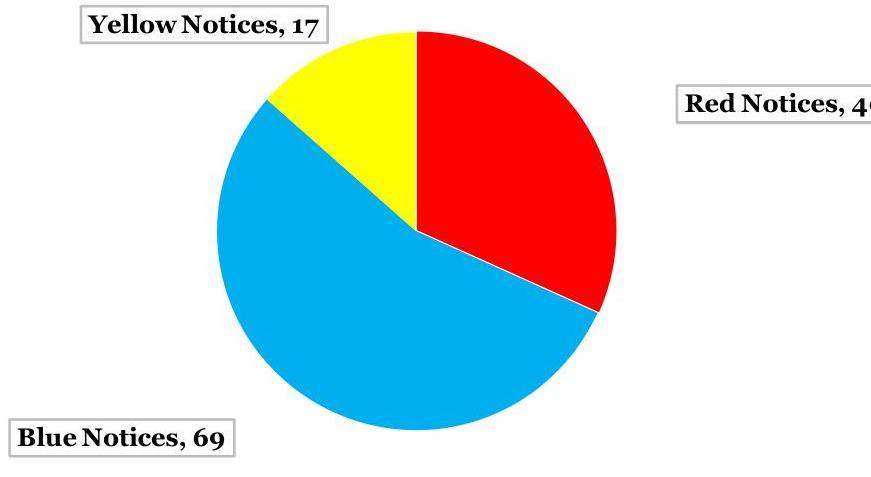
Extradition / Deportation
12.85 The following numbers of fugitives were extradited/ deported/ arrested/ located: –
| Wanted Persons/Fugitives wanted by India located abroad | $\mathbf{3 0}$ |
|---|---|
| Wanted Persons/Fugitives wanted by other countries, detected/ located in India |
$\mathbf{2 7 8}$ |
| Wanted Persons/Fugitives returned to India from abroad/arrested/ located in India on the basis of LoC |
$\mathbf{2 4}$ |
Interpol Stolen and Lost Travel Documents (SLTD) Database
12.86 NCB, India has uploaded data relating to lost/stolen/revoked Indian passports into the INTERPOL SLTD Database being maintained by IPCU Branch. Till 31.12.2022, data of 2249822 Stolen/Lost/Revoked Indian Passports has been uploaded in the SLTD Database. Upto 31.12.2022, 1333 cases of use of STLD recorded Indian passports have been reported/detected by various other NCBs.
Interpol Global Communication System [IGCS] Messages Received During 2022
12.87 The five Regional Desks received 8955 requests/IGCS message/ letters from January 2022 to December 2022 from various NCBs, PLOs and Indian Law Enforcement agencies/authorities regarding various matters on police-to-police cooperation basis. The five regional desks of NCB-India also worked in close coordination with other NCBs and rendered necessary guidance to them on various issues.
FOREIGN TERRORIST FIGHTERS (FTF)
12.88 INTERPOL maintains a database of suspected foreign terrorist fighters. Data is analysed and insights are shared with INTERPOL’s membership, for example, intelligence on the capabilities, means and emerging trends of foreign terrorist fighters. All FTFs Inputs/reports, as received from INTERPOL’s Counter Terrorist/ Terrorist Networks SubDirectorate, are forwarded to the MAC & NIA for further necessary action as deemed appropriate. During 2022, 304 such reports have been shared.
12.89 CBI Joined GlobE (Global Operational Network of Anti-Corruption Law Enforcement Authorities) Network. GlobE is a global network for the purpose of building and enhancing direct contact between anti-corruption law enforcement authorities. It brings together Anti-Corruption agencies across the world and provides a platform for peer-to-peer information exchange and informal cooperation to better identify, investigate and prosecute cross border corruption offences. The GlobE Network is open to specialized authorities as referred to in Article 36 of the Convention (anti-corruption law enforcement authorities) from all UN Member States and States parties to the UN Convention against Corruption (UNCAC).
Q. CAPACITY BUILDING
12.90 In the year 2022, CBI Academy and the three Regional Training Centres (functioning at Kolkata, Mumbai and Chennai) conducted a total of 135 courses and trained 4901 Officers/Officials.
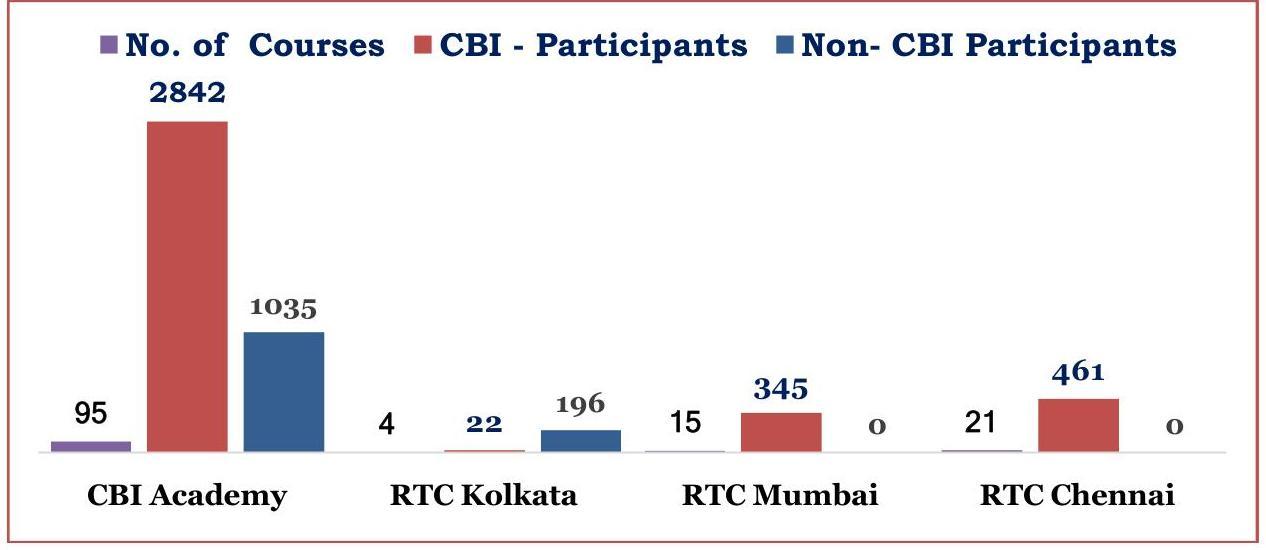
Rank/Organisation wise Break-up of the Participants
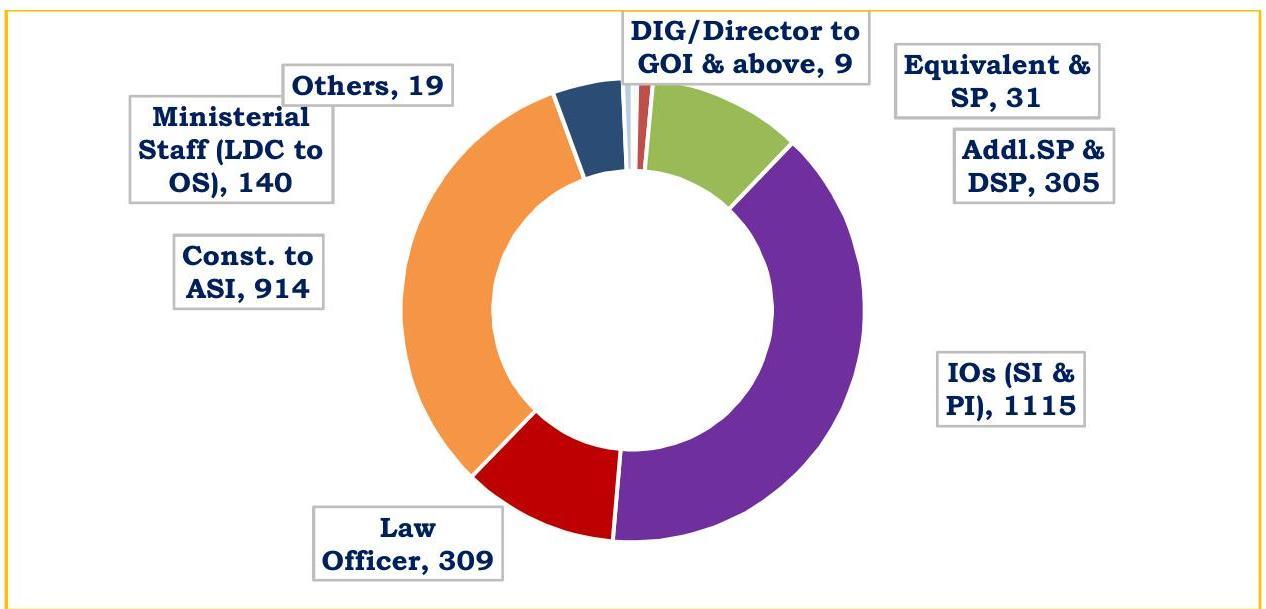
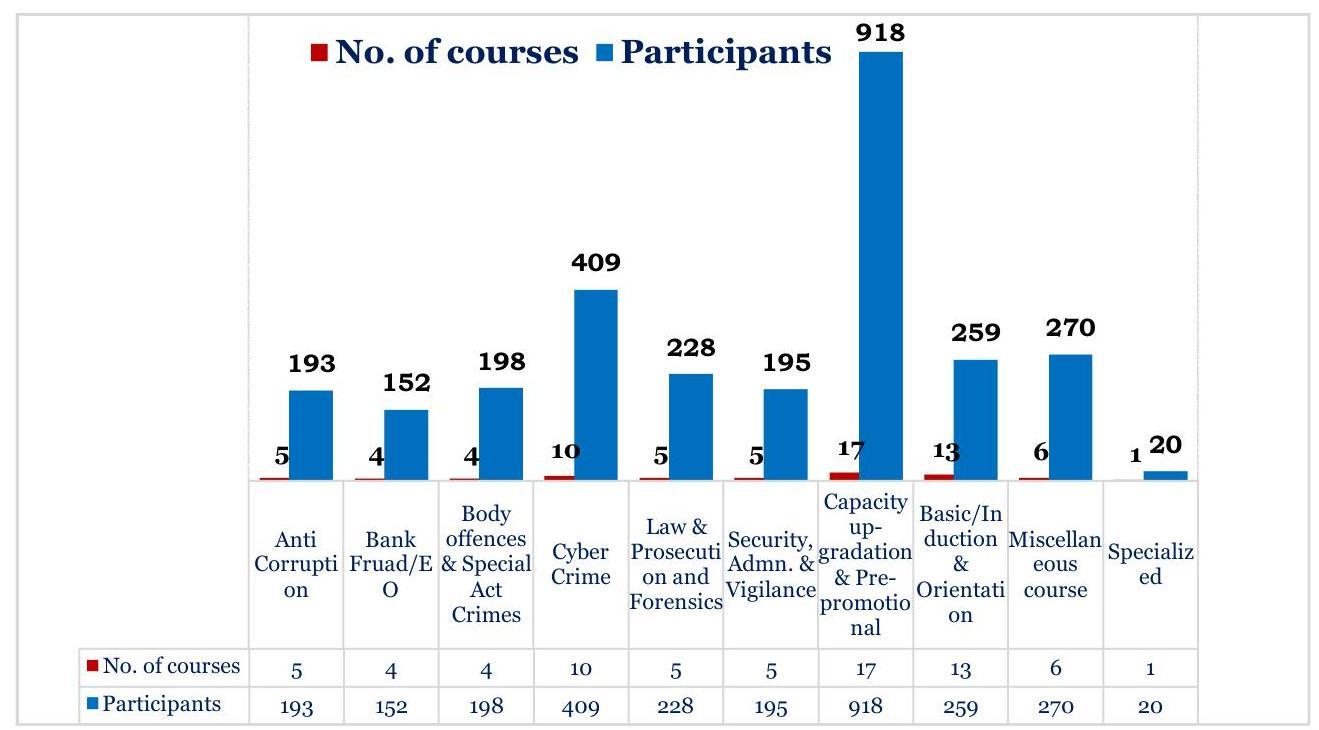
12.92 TRAINING TO STATE POLICE AND OTHER ORGANIZATIONS
These courses were conducted exclusively for the requesting organization or police agency. Some of these were:-
- 05 Training courses for Inquiry/Presenting officers under the jurisdiction of the CVC
- Vigilance Course for officers of SAIL Vigilance
- Vigilance Course for officers of IOCL Vigilance
- Induction Training course for NCB Officials (IOs/JIOs)
- Induction Training program for NCB Senior Officers
- Appreciation Course for IRTS Probationary officers
- 02 visits of UP Police DSP(Probationers), PTC, Moradabad
- Vertical Interaction Course [VIC] on Investigation of Abroad & MLAT for IPS \& Senior Officers
- VIC on Investigation of Economic Offences for IPS \& Senior Officers
- One day educational visit of officers of Indian Postal Service
R. AWARDS AND ACCOLADES TO CBI OFFICERS DURING 2022
12.93 PRESIDENT’S POLICE MEDAL \& POLICE MEDAL
During the year 2022, twelve [12] officers of Central Bureau of Investigation were awarded President’s Police Medals (PPM) for Distinguished Services and forty-seven [47] officers of Central Bureau of Investigation were awarded Police Medal (PM) for Meritorious Services on the occasions of the Republic Day, 2022 and the Independence Day, 2022.
12.94 UNION HOME MINISTER’S MEDAL FOR EXCELLENCE IN INVESTIGATION AWARDED TO CBI PERSONNEL
During the year 2022, fifteen [15] officers were awarded Union Home Minister’s Medal for Excellence in Investigation for the year, 2022.
12.95 ASADHARAN AASUCHANA KUSALATA PADAK
During the year 2022, three [03] officers were awarded ‘Asadharan Aasuchana Kusalata Padak’ for exceptional courage and skill in intelligence service.
12.96 CBI GOLD MEDAL FOR BEST INVESTIGATING OFFICER FOR THE YEAR 2020 & 2021
During the year 2022, two [02] officers were awarded ‘CBI Gold Medal for Best Investigating Officers’ for the years 2020 and 2021 respectively.
S. FUTURE ROADMAP
12.97 Perspective Future Plan
CBI strives for excellence in investigation and prosecution of offences by bench marking its standards with the best law enforcement institutions in the world. Accordingly, there is a constant endeavor to understand the changes in national and global scenario, identified perspective future plans as under: –
- Expediting Investigation by Multidisciplinary Teams with greater technical support.
- Enhancing operational capabilities so as to detect crime, especially cases of Collusive Corruption.
- Making comprehensive investigation, using the various data fields and opensource information.
- Enhanced coordination with State Police and liaison with INTERPOL.
- Achieving greater specialization in niche areas like On-line child Sexual Abuse offences, Cyber Crime, Arts and Antiquities etc.
- Focus on Training and re-Training.
- Emphasis on Preventive Vigilance and intelligence collection so as to check corruption at the origin.
- Coordinating with Private Sector for promoting integrity.
CHAPTER 13
JOINT CONSULTATIVE MACHINERY
13.0 The Scheme for Joint Consultative and Compulsory Arbitration for the Central Government Employees was introduced in the year 1966 on the lines of the Whitely Councils in the U.K. The scheme provides a platform for constructive dialogue & discussion between the representatives of the staff side and the official side for peaceful resolution of all disputes between the Government as employer and the employees. The scheme was introduced with the objectives of promoting harmonious relations and securing the greatest measure of cooperation between the Central Government as the employer and the employees in matters of common concern and further increasing the efficiency of the public service combined with the well being of those employed.
13.1 The JCM Scheme provides for three-tier machinery:
i. The National Council as the apex body; (chaired by the Cabinet Secretary);
ii. Departmental Councils at the level of individual Ministries / Departments including their attached and subordinate offices and (chaired by respective Secretaries); and
iii. Regional / Office Councils to deal with mainly the local problems at the level of each individual office, depending on its structure. (Chaired by Head of office of respective organizations).
13.2 The scope of the JCM Scheme includes all matters relating to:
conditions of service and work;
the welfare of the employees; and
improvement of efficiency and standards of work,
Provided, however that in regard to recruitment, promotion and discipline, consultation is limited to matters of general principles only and individual cases are not considered.
13.3 National Council (JCM)
The National Council is the apex body under JCM, Chaired by the Cabinet Secretary. It comprises members both from staff side and official side. The official side of the National Council consists of 25 members and the staff side consists of 60 membersNational Council may have two Standing Committees; i) for the Non- Industrial employees, ii) Industrial employees. So far, 48 meetings of the National Council (JCM) have been heldsince its inception in 1966.
13.4 Standing Committee Meeting of the National Council (JCM):
Standing Committee meeting of the National Council (JCM) was held on $22^{\text {nd }}$ September, 2022 under the Chairpersonship of the Secretary, DoPT. In the meeting 40 Agenda Items were deliberated upon.
13.5 ARBITRATION
An important feature of the JCM Scheme is the provision for arbitration in cases where there is no agreement between the Official Side and the Staff Side on matters relating to:-
pay and allowances;
weekly hours of work; and
leave, for a class or grade of employees.
13.6 BOARD OF ARBITRATION (BOA)
A Board of Arbitration (BOA) comprising three Members; a Chairman (an independent person) and two Members, nominated, (one each by Staff Side and Official Side), functions under the administrative control of the Ministry of Labour& Employment. Award of the Board of Arbitration is binding on both sides, subject to the over-riding authority of Parliament to modify or reject the Award.
CHAPTER 14
ADMINISTRATIVE TRIBUNALS
14.0 The Administrative Tribunals Act, 1985 owes its origin to Article 323-A of the Constitution of India which empowers Central Government to set up Administrative Tribunals by an Act of Parliament for adjudication of grievances and disputes arising out of the conditions of service of an employee appointed to the public services and posts in connection with the affairs of the Union and the States. In pursuance of the provisions contained in the Administrative Tribunals Act, 1985, the Administrative Tribunals, set up under it, exercise original jurisdiction in respect of service matters of employees covered by the Act. As a result of the Supreme Court’s judgment dated 18.03.1997 in the case of L. Chandra Kumar & Others Vs UOI, the appeals against the orders of an Administrative Tribunal shall lie before the Division Bench of the concerned High Court.
14.1 The Administrative Tribunals are distinguishable from the ordinary courts with regard to their jurisdiction and procedure. They exercise jurisdiction only in relation to the service matters of the litigants covered by the Act. They are also free from many of the procedural technicalities of the ordinary courts. The procedural simplicity of the Act can be appreciated from the fact that the aggrieved person can also appear before it personally. Government can also present its cases through its departmental officers or legal practitioners. Further, only an affordable and nominal fee of $\square 50$ is to be paid by the applicants for filing the original application before the Tribunal. Thus, the objective of the Tribunal is to provide speedy and affordable redress to the aggrieved applicants arising out of employment or conditions of service.
14.2 The Central Administrative Tribunal was set up on 01.11.1985. As on date, it has 19 regular Benches, 17 of which operate at the principal seats of High Courts and the remaining two at Jaipur and Lucknow. A statement showing the location of Central Administrative Tribunal Benches, the dates of their establishment and the number of courts in each of these Benches along with a list of places where they hold Circuit Sittings is given in Appendix-I.
14.3 The Tribunal consists of a Chairman and Members. It has also been the constant endeavour of this Ministry to ensure that the posts of Chairman and Members are filled up well in time and no post remains vacant for long time. The Members of Central Administrative Tribunal (CAT) and State Administrative Tribunals (SATs) are drawn from judicial as well as administrative streams, so as to give the Tribunal the benefit of domain expertise both in legal and service matters. The sanctioned strength of Members of Central Administrative Tribunal is 70 (including Chairman, CAT), out of which 35 are Judicial Members and 35 are Administrative Members. As per Tribunals Reforms Act, 2021, the Chairman can be a Judicial Member or an Administrative Member.
14.4 The appointment of Members in CAT is made on the basis of the recommendations of a Search-cum-Selection Committee ( ScSC) chaired by Chief Justice of India or a sitting Judge of Supreme Court (nominated by the Chief Justice of India). After receipt of recommendations of ScSC, appointments are made with the approval of Appointments Committee of the Cabinet.
14.5 State Administrative Tribunals (SATs) were also set up in the following States:
i. Karnataka
ii. Maharashtra
iii. West Bengal
iv. Kerala
v. Haryana (not functional)
14.6 The appointments to the vacancies in SATs are made on the basis of proposals sent by the State Governments. Thereafter, their appointments undergo the same process as the one in respect of Central Administrative Tribunal.
14.7 Since its inception in 1985 and upto 31.03.2023, the Central Administrative Tribunal received $9,01,897$ cases for adjudication (including those transferred from High Courts), out of which $8,23,872$ cases have been disposed of, leaving a pendency of 78,085 cases. On an average, about $91 %$ of the cases instituted are disposed of. A statement indicating the institution, disposal and pendency of cases since inception of CAT is at Appendix-II.
14.8 Section 14(2) of the Administrative Tribunals Act, 1985 empowers the Central Government to extend the provisions of the Act to local or other authorities within the territory of India or under the control of Government of India and to Corporations or Societies owned or controlled by Government of India. In exercise of these powers, the Central Government had extended the provisions of the Act to 219 organizations so far.
14.9 In order to familiarize the newly appointed Members of CAT with the functioning of the Tribunal, a short Orientation Programme / Training is held from time to time. So far, five such Orientation Programme / Training have been held, recent one was organized at Indian Institute of Public Administration, New Delhi from 27.01.2023 to 28.01.2023.
14.10 Further, for maintaining absolute integrity and promoting fair practices in the professional court dealings and keeping in view the general directions of the Hon’ble Supreme Court, the designated Selection Committee, in its one meeting decided that a Judicial Member of CAT, who earlier practiced as Advocate in a Court in that station, should not normally be considered for posting in the CAT Bench of the same station.
14.11 It has been the constant endeavour of the Government to strengthen the infrastructure in all the Benches of CAT for their smooth functioning. For this purpose, allocation of funds for purchase of land and construction of building during the period 2019-20 to 2022-23 is as under.
| Year | Allocation (Rs. In crore) |
|---|---|
| $2019-20$ | 9.98 |
| $2020-21$ | 8.00 |
| $2021-22$ | 10.00 |
| $2022-23$ | 4.06 |
| $2023-24$ | 12.91 |
14.12 Hon’ble Shri Justice Ranjit Vasantrao More is the Chairman of CAT. He was appointed as Chairman with effect from 30.07.2022. Before his appointment as the Chairman, CAT, Justice More was the Chief Justice of Meghalaya High Court.
NAME, DATE OF SETTING, NO. OF COURTS AND LOCATION OF VARIOUS BENCHES OF CENTRAL ADMINISTRATIVE TRIBUNAL
| S.No. | Name of the Bench | Date of setting |
No. of courts |
Location |
|---|---|---|---|---|
| 1. | PRINCIPAL BENCH |
01.11 .1985 | 6 | NEW DELHI |
| 2. | AHMEDABAD | 30.06 .1986 | 1 | AHMEDABAD |
| 3. | ALLAHABAD | 01.11 .1985 | 3 | ALLAHABAD |
| 4. | BANGALORE | 03.03 .1986 | 2 | BANGALORE |
| 5. | CHANDIGARH | 03.03 .1986 | 2 | CHANDIGARH |
| 6. | MADRAS | 01.11 .1985 | 2 | CHENNAI |
| 7. | CUTTACK | 30.06 .1986 | 1 | CUTTACK |
| 8. | ERNAKULAM | 01.09 .1988 | 2 | ERNAKULAM |
| 9. | GUWAHATI | 03.03 .1986 | 1 | GUWAHATI |
| 10. | HYDERABAD | 03.06 .1986 | 2 | HYDERABAD |
| 11. | JABALPUR | 30.06 .1986 | 1 | JABALPUR |
| 12. | JAIPUR | 15.10 .1991 | 1 | JAIPUR |
| 13. | JODHPUR | 30.06 .1986 | 1 | JODHPUR |
| 14. | CALCUTTA | 01.11 .1985 | 2 | KOLKATA |
| 15. | LUCKNOW | 15.10 .1991 | 1 | LUCKNOW |
| 16. | MUMBAI | 01.11 .1985 | 2 | MUMBAI |
| 17. | PATNA | 30.06 .1986 | 1 | PATNA |
| 18. | JAMMU | 08.06 .2020 | 2 | JAMMU |
| 19. | SRINAGAR | 23.11 .2021 | 2 | SRINAGAR |
STATEMENT SHOWING THE NAME OF BENCH AND PLACES WHERE CIRCUIT SITTINGS ARE HELD
BENCH
- ALLAHABAD BENCH
- CALCUTTA BENCH
- CHANDIGARH BENCH
- MADRAS BENCH
- GUWAHATI BENCH
- JABALPUR BENCH
- BOMBAY BENCH
- PATNA BENCH
- ERNAKULAM BENCH
PLACES
- Nainital
- Port Blair, Gangtok
- Shimla
- Pondicherry
- Shillong, Itanagar, Kohima, Agartala, Imphal, Aizwal
- Indore, Gwalior, Bilaspur
- Nagpur, Aurangabad, Panaji
- Ranchi
- Lakshadweep
APPENDIX-II
STATEMENT SHOWING THE POSITION OF INSTITUTION, DISPOSAL AND PENDENCY OF CASES IN THE CENTRAL ADMINISTRATIVE TRIBUNAL SINCE INCEPTION UPTO 2022.
(As provided by Central Administrative Tribunal, Principal Bench from time to time)
| S.NO. | PERIOD | INSTITUTION | DISPOSAL | PENDENCY AT THE END OF THE YEAR |
|---|---|---|---|---|
| 1. | 1985 | 2,963 | 30 | 2,933 |
| 2. | 1986 | 23,177 | 8,934 | 17,176 |
| 3. | 1987 | 19,410 | 15,084 | 21,502 |
| 4. | 1988 | 19,425 | 13,769 | 27,158 |
| 5. | 1989 | 18,602 | 13,986 | 31,774 |
| 6. | 1990 | 19,283 | 15,495 | 35,562 |
| 7. | 1991 | 21,623 | 17,552 | 39,633 |
| 8. | 1992 | 25,184 | 23,782 | 41,035 |
| 9. | 1993 | 27,067 | 28,074 | 40,028 |
| 10. | 1994 | 26,230 | 26,409 | 39,849 |
| 11. | 1995 | 25,789 | 23,668 | 41,970 |
| 12. | 1996 | 23,584 | 20,667 | 44,887 |
| 13 | 1997 | 23,098 | 21,981 | 46,004 |
| 14. | 1998 | 21,911 | 18,394 | 49,521 |
| 15. | 1999 | 22,944 | 24,566 | 47,899 |
| 16. | 2000 | 25,146 | 31,398 | 41,647 |
| 17. | 2001 | 25,977 | 31,953 | 35,671 |
| 18. | 2002 | 25,398 | 29,514 | 31,555 |
| 19. | 2003 | 25,089 | 28,076 | 28,568 |
| 20. | 2004 | 23,825 | 27,735 | 24,658 |
| 21. | 2005 | 21,528 | 22,408 | 23,778 |
| 22. | 2006 | 18,722 | 17,774 | 24,726 |
| 23. | 2007 | 17,725 | 18,674 | 23,777 |
| 24. | 2008 | 18,287 | 20,352 | 21,712 |
| 25. | 2009 | 24,496 | 23,681 | 22,527 |
| 26. | 2010 | 26,620 | 25,477 | 23,670 |
| 27. | 2011 | 25,869 | 24,750 | 24,789 |
| 28. | 2012 | 27,733 | 24,206 | 28,316 |
| 29. | 2013 | 27,442 | 21,654 | 34,104 |
| 30. | 2014 | 27,913 | 24,739 | 37,278 |
| 31. | 2015 | 29,089 | 25,150 | 41,217 |
| 32. | 2016 | 26,984 | 26,266 | 41,935 |
| 33. | 2017 | 25,402 | 20,055 | 47,282 |
| 34. | 2018 | 26,309 | 23,538 | 50,053 |
| 35. | 2019 | 24,998 | 26,040 | 49,011 |
| 36. | 2020 | 25,888 | 12,616 | 62,283 |
| 37. | 2021 | 29,679 | 17,395 | 74,567 |
| 38. | 2022 | 25,465 | 19,487 | 80,545* |
| 38. | Total | 8,95,874 | 8,15,329 |
CHAPTER 15
STAFF WELFARE
15.0 The Central Government is the largest single employer in the country and bears the major responsibility for looking after the welfare of a large number of employees spread all over the country. Realizing that improvement in the working and living conditions of the employees and their families leads to efficiency and high morale, the Department of Personnel and Training supports various staff welfare measures. A brief account of various welfare measures dealt with by the Welfare Division is given below.
RESIDENTS’ WELFARE ASSOCIATION
15.1 In order to foster a spirit of mutual help and goodwill among residents of Government colonies and to promote social, cultural and recreational activities, Department of Personnel & Training (DoPT) has been encouraging formation of Central Government Employees Residents’ Welfare Associations (CGERWAs). Every CGERWA seeking reorganization and grants-in-aid from Government is required to adopt Model Constitution prescribed by DOPT. The members of the Managing Committee of these Associations are elected every two years under the Provisions of a Model Constitution framed by the Department of Personnel \& Training. This Department Sanctions grants-in-aid only to recognized Associations, subject to a maximum of Rs. 10,000/- per annum for an Association.
AREA WELFARE OFFICERS
15.2 The Area Welfare Officers (AWOs) are nominated in residential colonies having a large number of Central Government employees. The AWOs serve as a link between the Government and residents in matters relating to the welafare of the Government employees living in various colonies. They also work as field officers in coordinating and maintaining liaison with various agencies of Government such as CPWD, CGHS, Police etc. Applications are invited from Gazetted officers working in various Ministries/Departments for being nominated as Area Welfare Officers for a period of two years. Officers desirous of being nominated as AWOs on voluntary and honorary basis are required to apply through their respective Ministries/ Departments.
CENTRAL CIVIL SERVICES CULTURAL \& SPORTS BOARD (CCSCSB)
15.3 The Central Civil Services, Cultural \& Sports Board, a society registered under the Societies Registration Act, 1860 is the Central agency for promotion of Cultural \& Sports activities amongst the Central Government employees in the country. The Board was set up in 1964 as Central Secretariat Club in the Ministry of Home Affairs. Initially, the objective of the Board was to promote cultural and sports activities amongst the Central Government Employees located in Delhi only. Subsequently, Regional Sports Boards were set up in various states. Financial grants in-aid is sanctioned every year by the Board to the Regional Boards.
ACTIVITIES OF THE BOARD INTER MINISTRY TOURNAMENTS 2022-23
15.4 The Board organizes lnter-Ministry Tournaments in 18 disciplines of sports. Till date CCSCSB has successfully organized inter ministry tournament in Carrom, Chess, Cricket, Football, Basketball, Kabaddi, Table Tennis, Lawn Tennis, Swimming, Athletics,
Volleyball, Badminton, Power lifting, Weightlifting & Best Physique, Hockey, Shooting Ball, Wrestling and Dance \& Music. CCSCSB introduced two new games i.e. Kho-Kho and Yoga and organized inter-ministry Tournament in Kho-Kho and Yoga for first time in the year 2022-23.
All INDIA CIVIL SERVICES TOURNAMENTS HELD DURING THE YEAR 2022-23
15.5 These tournaments, which are open to Central and State Government employees, aim to give an opportunity to the civil servants to meet and interact with each other and compete. AICS Tournaments are being organized in collaboration with different States/UTs.
NEW ACTIVITIES UNDERTAKEN BY THE BOARD IN 2022-23
15.6(1) Second Women’s Meet was organized in the year 2022-23 on $11^{\text {th }}$ January,2023.
15.6(2) Organized inter-ministry Tournament in Kho-Kho and Yoga for first time in the year 2022-23.
SCHEME FOR PROMOTION OF ADVENTURE SPORTS \& SIMILAR ACTIVITIES AMONGST CENTRAL GOVERNMENT EMPLOYEES
15.7 As a welfare measure, the CCSCSB launched a Scheme for promotion of adventure sports and similar activities amongst Central Government Employees working in the Ministries/Departments. The Scheme includes up to 10 days programme having components of environmental awareness, disaster management, team spirit, capacity building, and Swachh Bharat Campaign and activities like Trekking, Mountaineering, Rock-Climbing, Cycling in a difficult terrain, Skiing, Rafting, Para Sailing, Jungle Safari and Environmental Awareness Camps etc.
15.8 It is expected that participation by Central Government Employees in adventure sports and similar activities will give them a platform where they would learn lessons from nature and use the knowledge acquired for welfare of the society. It would also foster spirit of risk-taking, cooperative team work, and capacity of readiness, vital response to challenging situations, endurance and environmental awareness.
15.9 CCSCSB provides financial assistance up to Rs.20, 000/- including to and fro travel charges to the Central Govt. employees.
PARTICIPATION OF GOVERNMENT EMPLOYEES AND THEIR FAMILIES IN SPORTING ACTIVITIES CONDUCTED IN COLLABORATION WITH SAI
15.10 The Board has Introduced Scheme for Swimming for Central Government Employees and their children in collaboration with Sports Authority of India at Major Dhyanchand National Stadium \& Talkatora Stadium New Delhi. Under the Scheme, Government employees and their dependents/families avail the facility of Swimming at nominal charges. Badminton, Table tennis and Fitness Centre facilities are also extended to Government Employees under “Come and Play” scheme of Sports Authority of India to the employees and their families. Under this scheme, the amount charged by SAI is reimbursed to the beneficiary after deduction of nominal fee.
15.11 The Board is affiliated to a number of sports associations/federations at the National level. Board’s teams participate in the National Tournaments organized by these Associations/Federations in Kabaddi, Hockey, Football, Carrom, Cricket and Chess.
SPORTS FACILITIES IN DELHI
15.12 The Board has a sports complex at Vinay Marg, New Delhi which has facilities for Football, Hockey, Cricket, Athletics, Lawn Tennis, Basketball, Volleyball and practice pitches for Cricket. The Board also maintains lawn Tennis Courts at Brassy Avenue, Bharti Nagar, Pandara Road and R.K.Puram Sector 13, New Delhi, Brassy Avenue has facilities for Cricket practice pitches also. There is facility for Indoor games such as Table Tennis, Carrom and Chess at Nirman Bhawan, New Delhi. Open Gym facilities are available at Vinay Marg, Bharti Nagar, Pandara Road and R.K Puram Sector 13.
COACHING FOR CHILDREN DEPENDENTS OF GOVERNMENT EMPLOYEES
15.13 The Board also conducts regular coaching in Cricket, Football and Lawn Tennis for the children/ dependents of Government employees at Vinay Marg Sports Complex, New Delhi. Coaching in Lawn Tennis is also available at Bharti Nagar, Pandara Road and R.K. Puram Sector-13.
15.14 The Board also organizes Summer Coaching camp in Basketball, Cricket, Football, Volleyball, Self-defence and Lawn Tennis for children/dependents of government employees.
GRIH KALYAN KENDRA
15.15 Grih Kalyan Kendra (GKK) is a registered Society under the Societies Registration Act, 1860 and functioning under the aegis of Ministry of Personnel, Public Grievances & Pensions.
15.16 The basic objectives of the Kendra in brief are: –
a) To promote social, economic, cultural and educational activities for the welfare of Central Government Employees and their families.
b) To impart technical and vocational training in home crafts and other household arts for useful utilization of leisure time and better and efficient housekeeping.
c) To organize and promote economic activities that may provide opportunities for gainful employment to families of Central Government employees for supplementing the family income.
15.17 The GKK is administered by GKK Board.
The Board, which has the Secretary (P) or his nominated officer as the President, is responsible for the organization and administration of GKK.
15.18 In pursuance of its objectives, GKK has been conducting the following activities:
a) Training classes in cutting, tailoring and embroidery for the housewives and grown-up girls during their leisure hours.
b) Nursery education for children in the age group of 3 to 5 years.
c) Creches or Day Care Centres for children between the age of 90 days to 10 years.
d) Recreational facilities like Health Club/Gym, Badminton and Tennis, etc.
e) Coaching classes in Martial Arts, Yoga, Music, Dance, Computer, Brain Development, Fine Artsetc.
15.19 The welfare activities run by Grih Kalyan Kendra are indicated in the table given below:
| Place | Number of Samaj Sadans/ Centres |
Craft Centres |
Nursery Schools |
Creche Centres |
Health Clubs/ Gyms |
|---|---|---|---|---|---|
| Delhi | 32 | 4 | – | $5^{*}$ | 1 |
| Mumbai | 4 | – | 4 | – | – |
| Chennai | 3 | – | – | – | – |
| Jaipur | 2 | 1 | – | 1 | – |
| Dehradun | 2 | – | – | – | – |
| Nagpur | 2 | – | – | – | – |
| Bangalore | 3 | – | – | – | – |
| Faridabad | 1 | 1 | – | 1 | – |
| Kolkata | 1 | – | – | – | – |
| Ghaziabad | 1 | – | – | – | – |
| Total | 51 | 6 | 4 | 7 | 1 |
- Staff has been provided by GKK to Crech Centre run by Lok Sabha Secretariat, Parliament Annexe.
15.20 The Grih Kalyan Kendra has undertaken the following activities during year 2021.
i) Due to COVID-19 pandemic, the Samaj Sadans/Centres of Grih Kalyan Kendra in Delhi and outstations were closed and all the activities viz. Nursery/KG classes, Craft centres, Creches, Yoga and Health Clubs/fitness centres etc. being conducted were suspended w.e.f 17.3.2020. Online (distance learning) classes for Nursery/KG were started in GKK Mumbai w.e.f. 5.2.2021. Physical classes wre conducted in GKK Mumbai during the year 2022-23. Approx 744 Students were benefitted during 2022-23. Martial Art and Gym/Crossfit activity, Music and Dance, Computer classes, Fine Art & Craft Activity on outsource basis have also been resumed in GKK, Delhi during 2022-23. Yoga classes have also been resumed in GKK Delhi and outstation from August, 2020.
ii) DOPT launched a Yoga training scheme w.e.f. 01.04.2015 in association with Morarji Desai National Institute of Yoga, New Delhi for the benefit of Central Government employees and their dependants free of cost. The training sessions are conducted in 25 locations in Delhi and 12 Samaj Sadans of Grih Kalyan Kendra outside Delhi. Yoga Trainers have been selected by Morarji Desai National Institute of Yoga (MDNIY), New Delhi. These trainers have been engaged by Grih Kalyan Kendra on contract basis. Government has allocated Rs. 2 crores for the scheme of Yoga Training sessions under the Non-Plan Head in 2019-20 and Rs.1.74 Crore for the year 2022-23.
iii) International Yoga Day, 2022 was celebrated on 21.6.2022 and 1844 approx sadhak participated in the event.
KENDRIYA BHANDAR
OBJECTIVES OF THE ORGANISATION
15.21 The Central Government Employees Consumer Cooperative Society Ltd., New Delhi, operating in the name of KENDRIYA BHANDAR was set up in 1963 in pursuance of Cabinet decision as a Welfare Project for the benefit of the Central Government Employees. The society endeavours to serve the Central Government Employees and the general public at large by providing quality goods of daily needs at reasonable prices through its retail stores. The range of items which Kendriya Bhandar provides includes consumer goods, grocery items, stationery and medicines etc.
MULTI-STATE COOPERATIVE SOCIETY
15.22 The Society is registered under MSCS Act 2002, as a Multi-State Co-operative Society and operates in Delhi and other States of the country.
NETWORK
15.23 The Society operates a network of 149 stores/branches in Delhi, Maharashtra, Tamilnadu, Andhra Pradesh, Karnataka, Cochin, Daman, Gujarat, Uttar Pradesh, Uttaranchal, Rajasthan, Madhya Pradesh, West Bengal, Jharkhand, Assam, Haryana, Jammu & Kashmir, Punjab and Chandigarh etc.
15.24 At Delhi, Kendriya Bhandar has a chain of 101 nos. self service grocery consumer retail stores beside the Institutional Sales Unit (ISU) and 05 Pharmacy shops(inclusive of three JAN Aushadhi Generic Drug Shops). In addition, 08 stores are operating in Delhi-NCR under franchisee system. At Grocery/Consumer stores, all items of consumer goods, grocery items and certain stationery items are being sold. Through its Institutional Sales Unit, Kendriya Bhandar continues to provide goods to institutions like Tihar Jail, JNU/IIT Hostels, Janpath/Samrat Hotel, Hyderabad House, President House, Vigyan Bhawan, Homes of Social Welfare Department of Govt. of Delhi, Govt. Hospitals etc. In addition, Kendriya Bhandar has exclusive counter at East Block and West Block, R.K. Puram, New Delhi for sale of stationery and other products.
15.25 Furthermore, Kendriya Bhandar is supplying medicines and related items to CGHS Dispensaries and Hospitals in Delhi-NCR through its existing chemist shops. Jan Aushadhi Generic Drug Shops have been opened in GTB Hospital, DDU Hospital and Shastri Bhawan as a part of Jan Aushadhi project of the Department of Pharmaceuticals, Govt. of India.
15.26 Kendriya Bhandar has also opened Stationary Counter at Jamia Hamdard University. At Stationery Division Kendriya Bhandar had opened a separate Counter for COVID -19 related items. Kendriya Bhandar has opened new retail stores at NSG Sahkari Avas Samiti Limited, Greater Noida, Niharika Community Centre, Sector-31 Noida, AIIMS Deoghar, Ranchi and Bihar Institute of Public Administration \& Rural Development (BIPARD), Gaya, Bihar.
SHARE CAPITAL
15.27 As on $31^{\text {st }}$ March 2022 Kendriya Bhandar had a paid-up capital of Rs. 100.39 lakhs of which Rs. 68.18 lakhs have been subscribed by the Central Government and the rest by individual members.
MODERNISATION/AUTOMATION EFFORTS
15.28 Activities such as billing to customers, purchase, inventory etc. of Stationery division of Kendriya Bhandar, located at R.K. Puram East & West Blocks are computerized through Local Area Network. Further, in Head Office, purchases \& stocks of Consumer items, pulses and spices are computerized. All retail stores have already been computerized and also inventory has been computerized.
15.29 Debit/Credit Card swiping machines have been installed in all stores of Kendriya Bhandar for the convenience of customers.
SALES AND FINANCIAL PERFORMANCE
15.30 Kendriya Bhandar has achieved sales of Rs. 4043.06 crores during the financial year 2021-22 against the sale of Rs. 2911.41 crores in Financial year 2020-21 and also achieved a net profit of Rs. 4.95 crores in the F.Y 2021-22 (after making provision of Rs. 0.75 Crores for wage Revision) against the net profit of Rs. 4.73 crores during the F.Y.2020-21.
Kendriya Bhandar has declared a dividend of $10 %$ for the year 2020-21. There is no financial assistance from Govt. to Kendriya Bhandar. Source of income of Kendriya Bhandar is trading of products, interest on FDRs etc.
BENEFITS TO CUSTOMERS
15.31 The Society has been able to maintain competitive prices for various products sold by it as compared to those prevailing in the market. In fact, selling prices prevailing in Kendriya Bhandar now are deemed as the benchmark in the market.
15.32 For better quality control, full-fledged Quality Control Department is in place for monitoring the product quality and for making improvements on an ongoing basis. Packed grocery items are sold after pre-testing in the laboratory. On the shelf, post-testing is done periodically. The goods sold in the manufacturers packing carry the warranty of the manufacturer. Complaints books are provided in all the stores for the customer to enter their complaints/suggestions which are acted upon from time to time.
15.33 It is pertinent to mention that the Society has been involved in welfare activities and has always assisted the Central Government and the Govt. of NCT of Delhi in arresting the price rise at the time of crisis. At present, Kendriya Bhandar is selling Bharat Atta at the instance of Govt. of India @ Rs. 27.50 per kg against market price of minimum Rs.32-33/-per kg. Kendriya Bhandar came to the aid of Delhi Government and other State Governments and supplied items of their need in record time and in huge quantity during Pandemic.
15.34 CCTV cameras have been provided in a large number of stores as a preventive measure against shoplifting, theft etc.
The Civil Service Society (Sanskriti School)
Introduction
15.35 The Civil Services Society is a society registered under the Societies Registration Act. The Society was set up in February 1995, by the wives of the officers of the All India and Allied Civil Services. The wife of serving Cabinet Secretary is the Chairperson of the Civil Services Society. The office of the Society is at Dr S Radhakrishnan Marg, Chanakyapuri, New Delhi – 110021.
Aims and Objectives
15.36 The aims and objectives of the society, inter alia, are as under: –
- To establish progressive schools or other educational institutions in Delhi or outside Delhi, open to the children of officers of the All India and Central Services. Depending on the availability of seats, children of officers of the Public sector (Non government servants) may also be admitted, at the discretion of the Governing Body.
- To impart sound and liberal education to boys and girls during their impressionable years – a type of education that will lay stress on character building, team work, esprit de corps, physical development and will infuse in school children a spirit of adventure, fair play and justice.
- To develop among its students a feeling of pride in Indian culture and to produce citizens who will truly be global and rise above social, communal, religious and provincial prejudices.
15.37 The Society started its first school with the strength of 32 students, the Sanskriti School, in New Delhi, in the year 1998. The Chairperson of the Society is also the Chairperson of the School. Sanskriti School is a recognized integrated co-educational school, affiliated to the CBSE, offering education from Nursery to Class XII.
15.38 The Society believes that every child can and must realize his/her full potential, and towards this end, must be enabled through appropriate means. With this in mind, the School has a Learning Centre with Special Educators and Counselors guiding children who have special needs, through an Individual Education Program (IEP).
15.39 Likewise, for those from the relatively less privileged sections of society, the Society runs a parallel school Umang in the afternoon. Efforts are also made to mainstream some of the children. These children from the economically weaker sections are admitted through the admission process under the Delhi Education Act.
15.40 The Civil Services Society has set up a Centre for Excellence to promote teacher training initiatives. It has instituted the Sanskriti Lecture Series to motivate students by exposing them to the thought processes of eminent persons.
Management
15.41 The general management of the affairs of the Society is vested in its Executive Committee.
15.42 The general management of the affairs of Sanskriti School is also guided by the Managing Committee.
Activities
15.43 Sanskriti School has well stocked libraries, smart classrooms, laboratories, a gymnasium, a football field and a swimming pool. Apart from the prescribed curriculum, Sanskriti School offers its students a choice of sports and games, like cricket, football, basketball, table tennis, swimming and wide ranging co – curricular activities like yoga, chess, theatre, music, dance, quiz, public speaking, paper craft, etc.
Finance
15.44 The Society has no income of its own other than the annual subscription of the members. For Sanskriti School, the source of income is the fees collected from the students.
CIVIL SERVICES OFFICERS INSTITUTE (CSOI)
INTRODUCTION
15.45 The Civil Services Officers’ Institute is a registered society under the Societies Registration Act and was set up in February 1998. CSOI was allotted a building at K.G Marg, M.S. Apartments complex in 1998 which was later re-appropriated by CPWD to provide facilities of an Institute. Subsequently, the land was allotted to CSOI in 2002 at Vinay Marg, Chanakyapuri measuring 4.23 acres by Ministry of Urban Development, GOI. The new building was constructed by NBCC at a cost of Rs. 44.33 crore and it became operational with effect from December 2012. The Governing Council of CSOI decided to run both the Institutes at their respective locations in view of increased membership.
AIMS AND OBJECTIVES
15.46 The aims and objectives of the CSOI inter alia include:-
(i) To promote the welfare of the officers of the Civil Services and bring them together under one umbrella to secure complete integration of the services and to build a corps of officers imbibed with the spirit of co-operation in all aspects of Civil Services.
(ii) To hold, organize, arrange and conduct seminars, symposiums, talks, debates, workshops, lectures and other means of dispensing education to meet the needs and challenges of modern-day Civil Administration.
(iii) To print and publish journals, periodicals and manuals to keep the civil servants abreast with modern-day development.
(iv) To acquire and promote modern skills of Civil Administration and harmonize between different fields of Civil Administration by disseminating or exchanging knowledge thereof and by providing such other facilities as would lead to their Universal application.
(v) To establish and maintain libraries and information system to facilitate the study of Civil Administration at International level and spreading information in regard thereto.
(vi) To organize and maintain, on no-profit-no loss basis, limited residential accommodation for the members of the Society coming to participate in the activities of the Association and of other bodies with cognate objectives, as well as non-members, invited to participate in the activities of the Association.
MANAGEMENT
15.47 CSOI is managed by a Governing Council headed by Cabinet Secretary, an Executive Committee headed by Secretary (P), DoPT and a Working Committee headed by Additional Secretary (DoPT). Various sub-committees comprising of members to assist the Working Committee in its day to day smooth functioning, viz:
a) Finance subcommittee
b) Food & Beverages subcommittee
c) Arts \& Events subcommittee
d) Building Maintenance subcommittee
e) IT subcommittee
f) Library subcommittee
g) Sports subcommittee.
Events
(a) Stage Play -‘Babu Ke Sapne’ by Mr. Deepak Gurnani.
(b) Dance Drama- Remembering the HEROES by Mr. Raja Anand.
(c) A Talk on ‘Secrets of Healthy Hearts and Happy Mind’ by Dr. Mohit Gupta.
(d) Interactive Session on ’75 Years of Independence’ with a 30 minutes Presentation and Exhibition of Stamps and Coins by Mr. Miglani.
(e) Health Talk on ‘Dental Hygiene’ by Dr. Pravesh Mehra and screening by the Dental Team.
(f) Ghazal Singing programme by Ustad Vaqar Ahmed Khan.
(g) William Shakespeare’s Stage Play ‘Hamlet’ (in Hindi) by Mr. Saif Ansari.
(h) Book \& Authors Session- ‘Turmoil in Punjab’ by Mr. Ramesh Inder Singh.
DEPARTMENTAL CANTEENS
15.48 As a measure of Staff Welfare, Departmental Canteens/Tiffin Rooms have been set up in the Central Government Offices/Establishments to make available. Beverages, snacks and meals prepared in hygienic conditions, to the employees at reasonable rates. At present, about 1,000 Departmental Canteens/Tiffin rooms are functioning in various Central Government Offices all over India. It is stated that Canteen Section DoP\&T is nodal agency for framing policies, guidelines/instructions for canteen staff of Non-Statutory Departmental Canteen functioning from the Central Government Offices.
2. With a view to providing good quality of service in clean \& hygienic environments, this Department has introduced a scheme for modernization of Departmental Canteens in 2015. Under the scheme, one time grant is given to canteens for their modernization to maintain hygiene and high standards of service.
3. Scholarship Scheme for children of employees of Non-Statutory Departmental Canteen was instituted in 1998 out of the funds in the discretionary fund of Director of Canteen. The scheme was introduced to encourage higher studies among the children of the canteen staff.
CHAPTER 16
RIGHT TO INFORMATION
MANDATE
- Administration of the RTI Act, 2005 including examination of matters related to amendments to the Act.
- $\quad$ Framing of Rules under the RTI Act, 2005 and amendment to the existing Rules made under the RTI Act.
- Issue/framing guidelines and orders to remove difficulties arising in giving effect to the provisions of the RTI Act.
- Appointment of Chief Information Commissioner and Information Commissioners in the Central Information Commission.
- $\quad$ Major policy issues relating to Right to Information Act, 2005.
- Laying of Annual Report of Central Information Commission before the Parliament.
- Action on recommendations of the Central Information Commission and Parliamentary Committee.
- Issue of guidelines and clarification on the strengthening and implementation of RTI Act.
- Implementation of the Annual Programme titled ‘Improving Transparency and Accountability in Government through Effective Implementation of RTI Act’.
- Management of RTI Online web portal.
- Administrative matters of Central Information Commission.
SALIENT FEATURES OF THE RIGHT TO INFORMATION ACT, 2005
16.1 To set out a practical regime for securing information by citizens from the Public Authorities and to promote transparency and accountability in the working of all Public Authorities, the Parliament enacted the Right to Information Act in 2005.
16.2 The Act is comprehensive and covers disclosure of information by public authorities on matters of governance. It is applicable to Government at all levels- Union, State and Local and also to the bodies owned, controlled or substantially financed directly or indirectly by the Government. It covers legislative bodies, the judiciary, the executive and Constitutional bodies.
16.3 The Act casts an obligation on public authorities for suo-motu disclosure/publication of information held by them. It also requires the public authorities to
supply information called for by any citizen and to permit him to inspect the documents and collect samples of various works. The procedure for seeking information is very simple. A person seeking information has to make a request to the concerned Public Information Officer indicating the information required. The request may be sent either by post, or be submitted in person or online if such facility exists with the public authority. It can be made in Hindi or English or in the official language of the area in which the application is made.
16.4 The Act creates the machinery to ensure supply of information, which consists of Public Information Officers, Assistant Public Information Officers, Departmental Appellate Authorities, independent Central and State Information Commissions etc.
16.5 The Act requires information to be provided in time bound manner. A Public Information Officer is required to send information called for at the specified address within 30 days. In case the information concerns the life or liberty of a person, it has to be provided within forty eight hours. The Act provides for imposition of stringent penalty on the Public Information Officer, if the information is not provided within the prescribed period which could be Rs.250/- per day of delay subject to a maximum penalty of Rs. 25,000/-
16.6 The Act has created a system of two appeals. On not being provided information within the stipulated period or on not being satisfied with the reply provided, an applicant can make first appeal within 30 days to the departmental appellate authority, who is generally the next superior officer to the Public Information Officer. If not satisfied with the decision of the first appellate authority, the applicant can file a second appeal to the Central Information Commission or the State Information Commission, as the case may be, within 90 days.
16.7 However, certain types of information pertaining to security of the country, scientific or economic interest of the country and information on trade secrets etc. are exempted from disclosure. Certain security or intelligence organizations have been exempted from disclosing any information except that pertaining to allegation of corruption or violation of human rights. Such organizations are required to designate Public Information Officers and First Appellate Authorities to deal with applications and appeals relating to information pertaining to corruption or violation of human rights.
16.8 With a view to create a brand for the Right to Information, a logo as given below had been adopted for the RTI on 28th October, 2010. The logo is very simple and iconic. A sheet of paper with information on it, and the authority figure behind it – providing the information. This represents the two key stakeholders in the process of sharing information under the RTI Act.

CENTRAL INFORMATION COMMISSION
16.9 The Government of India has constituted a Central Information Commission. Further, all the 28 States to which the Act applies, have constituted State Information Commissions. These Commissions are high powered independent bodies which, inter-alia, can look into the complaints made to them and decide the appeals. The Commissions have
power to impose penalty on the defaulting Public Information Officers. Central Information Commission entertains complaints and appeals in case of offices, financial institutions, public sector undertakings, etc. under the Central Government and the Union Territories while the State Information Commissions entertain appeals pertaining to offices, financial institutions, public sector undertakings, etc. under the concerned State Government.
16.10 The Central Information Commission, when constituted initially, had five Commissioners including the Chief Information Commissioner. With the last appointment of the Chief Information Commissioner and three Information Commissioners on 7th November, 2020, the Commission has now SEVEN Information Commissioners apart from the Chief Information Commissioner in position.
RIGHT TO INFORMATION RULES, 2012
16.11 In supersession of the Central Information Commission (Appeal Procedure) Rules, 2005 and the Right to Information (Regulation of Fee and Cost) Rules, 2005, the Right to Information Rules, 2012 have been notified in the Gazette of India on $31^{\text {st }}$ July, 2012.
16.12 The Right to Information Rules, 2012 provide inter-alia that a request for obtaining information shall be accompanied by an application fee of rupees ten by way of cash against proper receipt or by demand draft or bankers’ cheque or Indian Postal Order payable to the Account Officer of the public authority. The applicant may have to pay fee in addition to application fee for obtaining documents or for inspecting the documents. The persons below poverty line are not required to pay any fee for seeking information.
16.13 The RTI Rules, 2012 also prescribe the procedure for deciding appeals by the Central Information Commission, covering the following aspects:
(i) Documents to be enclosed with the appeal;
(ii) Return of Appeal
(iii) Process of Appeal
(iv) Procedure for deciding appeals
(v) Presence of the appellant before the Commission
(vi) Presentation by the Public Authority
(vii) Service of notice by Commission
(viii) Order of the Commission
RIGHT TO INFORMATION RULES, 2019
16.14 RTI Amendment Bill, 2019, passed by the Lok Sabha on 22.07.2019 and Rajya Sabha on 25.07.2019, received the assent of the President on $1^{\text {st }}$ August, 2019.
16.15 The RTI (Amendment) Act, 2019 was notified, by the Legislative Department, in the Gazette of India on $1^{\text {st }}$ August, 2019.
16.16 Notification to bring into force the provision of the RTI (Amendment) Act, 2019 has been published in the Gazette of India, Extraordinary under Part II, Section 3, SubSection (ii) on 24.10.2019.
16.17 Consequently, ‘The Right to Information (Term of Office, Salaries, Allowances and Other Terms and Conditions of Service of Chief Information Commissioner and Information Commissioners in the Central Information Commission, State Chief Information Commissioner and State Information Commissioners in the State Information Commission)
Rules, 2019′ were notified in the Official Gazette of India, Extraordinary under Part II, Section 3, Sub-Section (i) on 24.10.2019.
RTI WEBSITE
16.18 There is a dedicated website on RTI www.rti.gov.in, which contains valuable information including circulars, notifications and Guides on RTI, search facility for locating CPIOs and Appellate Authorities in Central Government etc. It has links with other RTI related sites as well. Further, there is an RTI online web portal where by Right to Information (RTI) applications can be filed online by Indian citizens, including those who are living abroad. An Indian citizen can file RTI application online through RTI online web-portal, having url www.rtionline.gov.in. The prescribed fee for RTI application can also be paid online through a payment gateway of State Bank of India by way of internet banking of State Bank of India, debit/ credit cards of Master/Visa and RuPay cards. This facility at present is available for 2539 Public Authorities of Government of India (as on 01.02.2023).
ANNUAL PROGRAMME ON RIGHT TO INFORMATION
16.19 The Government has launched a Centrally Sponsored Plan Scheme “Improving Transparency and Accountability in Government through Effective Implementation of the Right to Information Act” in August, 2010 to undertake activities in the area of awareness generation and capacity building. Under the scheme, the State Administrative Training Institutes and State Information Commissions are supported through release of grants for awareness generation and training programmes of all stakeholders. The total outlay of the scheme under XII th Five Year Plan was Rs. 110.36 crores. Now, the Scheme is continued as an Annual Programme and under this, an expenditure of Rs. 2.81 crore has been incurred during the last financial year i.e., 2021-22. During the F.Y 2022-23, an amount of Rs 1.36 crores has been released till 01.02.2023 and an expenditure of Rs.1.32 crore is in pipeline.
TRAINING:
16.20 The above Annual Programme has components of training of Public Information Officers / First Appellate Authorities of Centre as well as States. For the training of State PIOs, a sum of Rs. 89.49 Lakhs has been released to Administrative Training Institutes by 01.02.2023.
AWARENESS GENERATION FOR RTI:
16.21 The component of awareness generation includes Organization of Workshops, RTI Week Celebration, Innovative Awareness Generation Programmes and Publication of Guidebooks. An expenditure of Rs. 44.50 lakhs has been released to Administrative Training Institutes under these components by 01.02.2023.
INTERNSHIP ON RTI:
16.22 Considering the need to consolidate and document the experiences of the Ministries / Departments of Government of India in the implementation of RTI, its successes, constraints in implementation, to identify the areas which need more attention, to address the gap areas and to see what more needs to be done to help achieve the objectives of the RTI Act, 2005. DOPT provides Short Term Internships to Undergraduates pursuing the five year integrated course in Law and pursuing Graduation in Law to conduct an analysis of applications received under RTI Act in Select Public Authorities. During the current F.Y. 2021-22, this Short Term Internship on RTI could not be provided due to the ongoing pandemic.
RTI FELLOWSHIP:
16.23 The RTI fellowship of 3-month duration is awarded every year to four fellows in the age group of 25-40 years from the field of Media/Journalism/Civil Society Organizations associated with RTI/RTI Trainers to conduct field based research on themes relating to RTI with the aim that the research output will enhance our understanding of the status of the implementation of the Act, including its success, constraints in its implementation and how those are being/could be overcome and what more needs to be done to help achieve the objectives of the Act. During the fellowship period each fellow is granted a total stipend of upto Rs.2.00 lakhs. The fellowship has been started from 2010.
RTI CELLS IN MINISTRIES / DEPARTMENTS
16.24 Department of Personnel & Training provides a one-time grant of Rs.50,000/- under the Annual Programme for setting up RTI Cells in the Central Ministries / Departments to streamline receipt and disposal of RTI applications / appeals and orders. So far, 39 Central Public Authorities have received grants for setting up RTI Cells since inception of the scheme.
RTI ONLINE PORTAL
16.25 A web portal namely ‘RTI Online’ has been launched to provide the facility for the Indian Citizens to file online RTI applications and first appeals and also to make online payment of RTI fees. The prescribed fee can be paid by the applicant through internet banking of the State Bank of India as well as by Credit/Debit cards of VISA / Master, through the payment gateway of SBI, which is linked to RTI Online portal.
16.26 The RTI online portal provides for sending online replies to applications and appeals, though reply can be sent by regular post also. For a successful implementation of this facility, extensive training to the CPIOs / FAAs has been provided by DOPT, with the help of NICAs on 01.02.2023, 2539 Public Authorities have been aligned with this portal.
SUO MOTU / PROACTIVE DISCLOSURE
16.27 Section 4(1)(b) of the RTI Act lays down the information which should be disclosed by Public Authorities on a suo-motu or proactive basis. Sections 4(2) and 4(3) of the Act prescribe the method of dissemination of this information. In order to improve the proactive disclosure, Government of India constituted a Task Force on Suo motu disclosure in May, 2011. After considering the recommendations of the Task Force, the Government of India has issued guidelines to Central Ministries / Departments for Proactive Disclosure under section 4 of the RTI Act on 15.4.2013 and the same were reiterated on 07.11.2019. These guidelines envisage –
(a) Suo motu disclosure of more items under section 4 ;
(b) guidelines for digital publication of proactive disclosure;
(c) detailing of certain clauses of section 4(1)(b) to make disclosure more effective;
(d) compliance mechanism for suomotu disclosure; and
(e) personal information of an individual not to be disclosed
16.28 As per the guidelines, Pubic Authorities may publish information relating to procurement, public private partnerships, transfer policy and orders, RTI applications, CAG and PAC paras, citizens’ charter, discretional and non-discretionary grants, foreign tours of Prime Minister and Ministers.
16.29 The guidelines further provide that each Central Ministry/ Public Authority should get its proactive disclosure package audited by a third party every year and that such audit should be communicated to the Central Information Commission annually through publication on their own websites along with the names of the third party auditors. Under these guidelines it is mandatory that a senior officer of the level of Joint Secretary in the case of Ministry/Department and Additional HoD in the case of attached/subordinate offices, is nominated as nodal officer for ensuring compliance with the proactive disclosure guidelines.
16.30 The above guidelines have been reiterated duly incorporating a slight revision to Para 4.4 of the above guidelines allowing for third party audit by any Government Training Institute, in cases where no Training Institute exists under the concerned Ministry/Department/Public Authority. In course of a relaxation to the Central Public Authorities in aforesaid guidelines, it has been further provided that if any Training Institute, under any Ministry/Department/Public Authority, is recognized and functions as a separate Public Authority in terms of provisions of RTI Act, 2005, it may get third party audit of its proactive disclosure package done by any Government Training Institute. In course of the further relaxation, on the requests of various public authorities, the requirement of respective Government training institute was dispensed with by providing that the task of undertaking transparency audits may be given to any Government Training Institutes by Ministry/Department Public Authority, under the Central or State Governments.
16.31 The Government of India has also issued circular/guidelines on 10.07.2020 in the wake of Covid-19 pandemic advising all Ministries/Departments that all the Public Authorities dealing with essential services should widely disseminate information regarding the government relief, rescue and other welfare actions, in the media as well as on their official websites in accordance with Section 4 of the RTI Act, 2005.
16.32 State Governments have also been requested to consider issuing similar guidelines, along with templates for disclosure at various levels, for better implementation of suomotu disclosure at State level. Four areas have been identified for development of templates viz. Public distribution system, Panchayats, MGNREGA and Primary and Secondary Schools.
16.33 A facility to upload the reply of RTI applications and first appeals on the respective website of the Ministry/Department has been started from $31^{\text {st }}$ October, 2014. All the Ministries/Departments of Govt. of India have been requested to upload the reply to RTI application and first appeal on their respective websites, except the replies relating to the personal information of an individual, if they do not serve any public interest.
CHAPTER 17
PUBLIC GRIEVANCE REDRESSAL MECHANISM & CITIZENS’ CHARTER
Citizens/ Client’s Charter and Sevottam Compliant Public Grievance System of the Department:
17.1 The Citizens’/Clients’ Charter of the Department contains the services provided by the various Divisions, name and contact, details of the responsible officer, service standards and time taken, the process involved and documents required. The charter also contains the name and contact details of public grievance officer. The services included in the citizens’/clients’charter are:
i. Processing of proposals for ACC approval.
ii. Allocation of Service based on the result of the Civil Services Examination (Display on the website of this Department)
iii Nomination of the candidate to whom service allocated for Foundation Course (Display on the website of this Department)
iv Release of holiday list for the Government Department/organisations.
v. Release of Grants-in-aid to staff side Secretariat of National Council (JCM).
vi. Grant of advice on disagreement cases with UPSC on disciplinary matters.
vii. Clarification on ACRs/APARs.
viii. Processing for extension of ad-hoc appointment /Grant of approval.
ix. Processing of proposals for framing/amendment/relaxation of RRs (including proposals received online on RRFAMS).
x. Cadre Clearance for Deputation.
xi. NOC for filling up of posts in Government organisation.
xii. Nomination of officers under domestic Funding of Foreign Training- Long Term Training Programmes ( 6 months- 1 year) \& Short Term Training Programmes (up to 6 months).
xiii. Nomination of officers for Advanced Professional Programme in Public Administration (APPPA).
xiv. Advice/clarification to Ministries/Departments on the issue of Reservation in services to SC, ST, OBC, PWD and Ex-Servicemen.
xv. Payment to vendors for invoices submitted, except air bills, submitted complete in all respects.
17.2 Review of implementation of Citizens’/Clients’ Charter is a continuous process and the Department is committed to include more services and improve service standards.
Public Grievances Redressal System
17.3 The Department is implementing the Centralized Public Grievances Redressal and Monitoring System (CPGRAMS), an online grievance redressal mechanism, developed and monitored by the Department of Administrative Reforms and Public Grievances (DARPG).
17.4. The Department received online grievances from various sources in CPGRAMS portal with the majority of grievances lodged directly by the common public. In addition to this, the Department also received grievances forwarded by the higher authorities namely PMO, President Secretariat, DARPG and DoP\&PW(pension) in CPGRAMS portal, for their timely redressal. During the period from January 2022 to December 2022, the Department has received 36750 grievances in CPGRAMS portal, out of which, 34060 grievances have been disposed of by the concerned Divisions/Subordinate org./Attached Offices of DoP\&T.
During the year, the Department received a total of 845 COVID-19 related grievances, out of which 807 grievances have been disposed of.
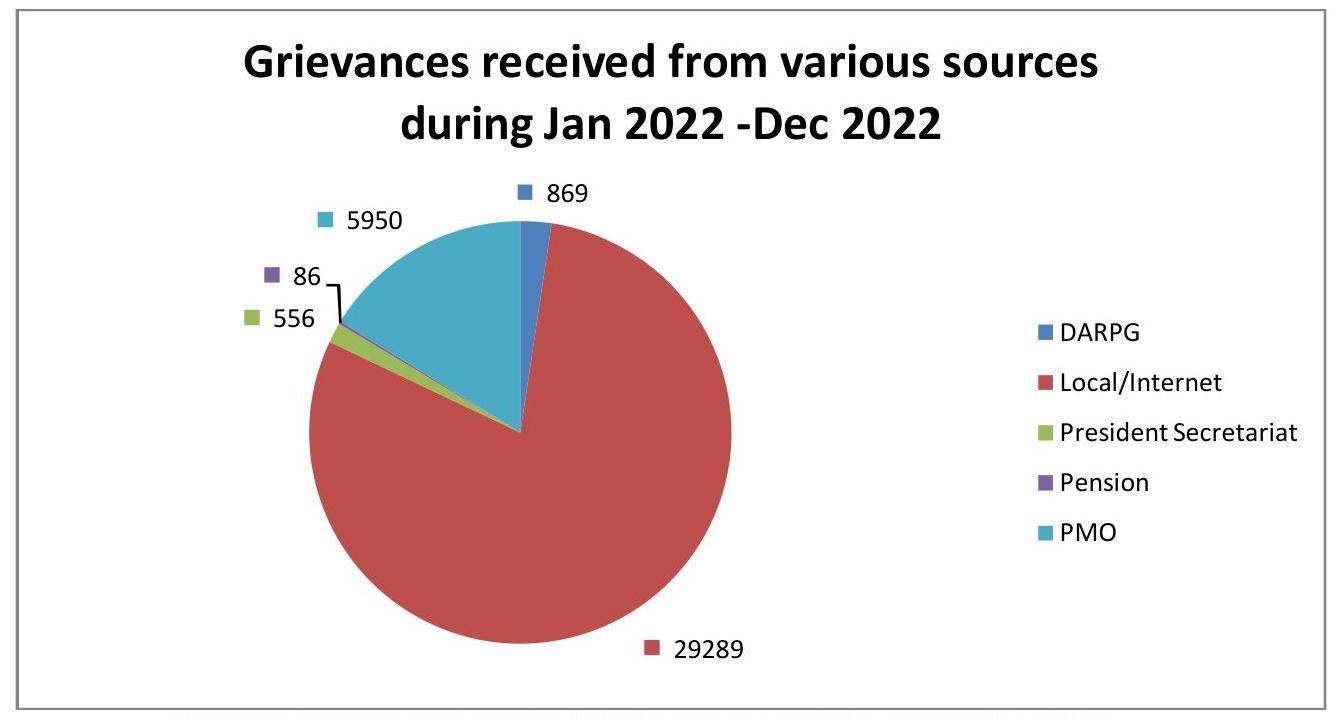
Figure 1: Grievances received during January 2022 – December 2022
17.5. Besides, the Department received 2364 grievances in physical form through letters written by the general public as well as forwarded by other Ministries/ Departments/organizations of the Government of India. These Grievances were forwarded to concerned Divisions in DoPT for examination and redressal. The grievances which do not pertain to this Department were forwarded to the Ministries/ Departments concerned and the petitioners were informed, accordingly.
17.6. The Deputy Secretary (Coord., PG), DoP&T, is the Nodal Officer of Public Grievances in DoP\&T. As per the instructions of the Department of Administrative Reforms and Public Grievances, Wednesdays are observed as meeting-less day so that the citizens can meet the officers concerned with their grievances.
Grievance Redressal Mechanism \& Citizen’s Charter
17.7 During the year 2022-23 a total of 20206 RTI applications were received and 19362 RTI applications were disposed of in DoPT. In addition, 1465 RTI First Appeals were received and 1345 RTI First Appeals were disposed of during the year 2021-22.
17.8 Third Party Audits on suo-moto disclosures under the RTI Act, 2005 in respect of DoPT for the year 2022-23 was conducted by ISTM through online mode. In the audit report, it has been stated that substantial information is available in the website and to a large extent information has been provided by Public Authority in the manner as required under provisions of RTI Act, $2005 \&$ extant instructions on this behalf. However, there is scope for improvement and the following observations were made by ISTM for consideration.
i. Vision \& Mission of the organisation may be placed prominently under the head “About Us”. Such information is available on the website elsewhere i.e. under citizen acharter tab. However, it may be placed appropriately in a more citizen friendly manner.
ii. DoPT is not only one of the most important departments of the Government of India, it is also the nodal department relating to RTI. Therefore, it is important that all PIOs $&$ AAs in DoPT must be trained properly. PA needs to take special care about this. Educational/ training programmes to advance understanding of RTI may be organised on regular basis.
iii. The Information Manual/ Handbook on RTI may be prepared in vernacular Languages \& uploaded on the website. The printed material may also be made available to citizens at convenient outlets.
iv. The details of STQC certificate along with its validity should be shown on website.
NOTE: Necessary follow up action on the observations is being taken.
Information and Facilitation Centre
17.9 Information and Facilitation Centre (IFC) of this Department is functioning with a Help Desk for providing information to the citizens both at North Block and Lok Nayak Bhawan, New Delhi. Apart from facilitating and guiding the citizens, the IFC disseminates information regarding the Department of Personnel and Training and its activities. IFC has been set up to facilitate easy accessibility for the citizen.
CHAPTER-18
PROGRESSIVE USE OF HINDI IN OFFICIAL WORK
18.0 The Ministry continued to make concerted efforts to promote the use of Hindi in official work and to ensure compliance of the provisions of the Official Language Act, 1963 as amended in 1967 and Official Language Rules, 1976 framed thereunder. Various orders/instructions issued from time to time by the Department of Official Language with a view to ensure proper implementation of the Official Language Policy of the Union are also implemented in the Ministry.
18.1 MACHINERY FOR IMPLEMENTATION AND TRANSLATION
18.1.1 The Ministry has a full-fledged Official Language Division headed by a Joint Director (OL) with one (01) Deputy Director (OL) and two (02) Assistant Directors (one post vacant) and other supporting staffs. This Division caters to the needs of the Department of Personnel and Training. There is a separate Official Language Section under a Deputy Director (OL) with necessary supporting staff in the Department of Administrative Reforms and Public Grievances. Likewise, there is a separate OL Section headed by one (01) Assistant Director (OL) with necessary supporting staffs also in the Department of Pension and Pensioners’ Welfare. Besides monitoring the implementation of the Official Language Policy and the Annual Program, the Official Language Division arranges in-service training for the staff for learning Hindi Language, Hindi Stenography and Hindi Typewriting. It also undertakes translation of the material received from various sections/desks of the Department from English to Hindi and vice versa such as General Orders, Standard forms, Notifications, Resolutions, Cabinet Notes (except the annexure relating to other Ministries/Departments), Administrative and other Reports, Press Releases and Periodic Statements/Summaries etc. referred to in section 3(3) of the Official Language Act, 1963 in addition to Parliamentary and Budgetary matters.
18.2 VARIOUS COMMITTEES FOR EFFECTIVE IMPLEMENTATION OF OFFICIAL LANGUAGE POLICY
18.2.1 Kendriya Hindi Samiti
Kendriya Hindi Samiti headed by the Hon’ble Prime Minister suggests various ways and means to the Ministries/Departments to promote the use of Official Language Hindi in the official work. Last meeting of the committee was recently held on 06.09.2018 under the chairmanship of the Hon’ble Prime Minister. The directions and follow up actions of the Committee are being implemented in the Department.
18.2.2 The Committee of Parliament on Official Language
The Committee of Parliament on Official Languagewas to be constituted under section 3 of the Official Languages Act 1963 after ten years of the promulgation of the Act. This Committee was set up in 1976 under section 4 of the Act.
This is a high-level committee comprising of 30 members of Parliament, 20 from Lok Sabha and 10 from Rajya Sabha. The Chairman of the Committee is elected by the members of the Committee. As a convention, the Union Home Minister (HM) has been elected as Chairman of the Committee from time to time.
The Committee of Parliament on Official Language inspected Department of Personnel and Training (DoPT) on 10.10.2020. The Committee reviewed the implementation of the provisions of Official Language Act and suggested various ways and means to the Ministry/Department to promote the progressive use of Official Language Hindi in the official work by creating a conducive and facilitative environment for the personnels of the Department.
18.2.3 Hindi Salahakar Samiti (Hindi Advisory Committee)
As per the guidelines from Department of Official Language, Ministry of Home Affairs, Hindi Advisory Committees are constituted in Ministries/Departments to put their advice regarding proper implementation of the official language policy of the Government of India. The minister concerned of the office chairs the committee.
This is a high-level committee consisting of 30 members. The committee is constituted for three years and advises the Ministry and its subordinate offices regarding implementation of the directions issued by Department of Official Language regarding provisions made under the Constitution, Official Language Act and Rules. The Hindi Salahakar Samiti of the Ministry has been reconstituted vide the Resolution No. E-11015/1/2019-Hindi dated 26.10.2020 after the constitution of the $17^{\text {th }}$ Lok Sabha. The first meeting of the newly constituted the Hindi Advisory Committee as the overall $13^{\text {th }}$ meeting was held at CSOI, New Delhi on 25.11.2021 under the chairmanship of Hon’ble MoS(PP), Dr. Jitender Singh. The next meeting is to be organized in the upcoming month of March, 2023.
18.2.4 Kendriya Rajbhasha Karyanvayan Samiti
Kendriya Rajbhasha Karyanvayan Samiti is headed by the Secretary, Department of Official Language which reviews the ongoing progress of the use of Hindi in all the Ministries/Departments of Government of India. The last meeting ( $44^{\text {th }}$ meeting) of the said committee was held on 15.11.2022 under the chairmanship of Secretary, Department of Official Language. The directions of this Committee are being complied with in the Department.
18.2.5 Official Language Implementation Committee (OLIC)
The meetings of the Official Language Implementation Committee (OLIC) of the Department of Personnel and Training are held periodically in the Department to discuss the Quarterly Progress Reports and suggest various measures for progressive use of Official Language Hindi in the Department. The meetings of Official Language Implementation Committee (OLIC) are being held regularly in the Department. The last meeting was held on 12.12.2022 and the next meeting will be held in the upcoming month of March, 2023. The Quarterly Progress Reports related to Official Language Hindi are reviewed in the meetings of Official Language Implementation Committee (OLIC) and various measures are taken for progressive use of Official Language Hindi in the Department.
18.2.6 Official Language Implementation Committee (OLIC) of Attached Offices
All the attached/subordinate offices of the ministry have their own Official Language Section and they have their own Official Language Implementation Committee (OLIC). The meetings of Official Language Implementation Committee are held regularly in these offices and the representatives of the Department also attend these meetings.
18.3 SPECIFIC MEASURES TAKEN FOR PROMOTING THE USE OF OFFICIAL LANGUAGE HINDI
18.3.1 Quarterly Progress Report and Annual Assessment Report
To assess the work done in Hindi by the personnel of the Department in their official work, a Quarterly Progress Report (QPR) is compiled after collecting relevant and real-time data from various Divisions/Sections in a prescribed proforma and sent to the Department of Official Language, Ministry of Home Affairs on regular basis. Similarly, Annual Assessment Report (AAR) is also sent to the Department of Official Language, Ministry of Home Affairs.
18.4 CASH AWARDS AND INCENTIVE SCHEMES
Various incentive schemes of the Department of Official Language to encourage officers and employees to do their official work in Hindi are in vogue in all the government departments. One such scheme is in vogue in this Department under which cash awards are given to staff members who carry out their official work (Noting & Drafting) in Hindi. During the year 2021-2022 total seven (07) officials have participated and all the winners have been provided with cash prizes and commendation certificates after the declaration of the results for the same.
18.5 HINDI WORKSHOPS
Hindi Workshops are organized in the Department to remove the hesitation among the officers and employees to do their official work in Hindi in which all the participants are given practical training of Rajbhasha Hindi and relevant rules and procedures thereof. The last Hindi Workshop was held on 22.06.2022 in 2 sessions and a total 21 participants benefitted from it.
18.6 ORGANISING HINDI MONTH/FORTNIGHT/DIWAS
Hindi fortnight was organized in the Department from 14.09.2022 to 29.09.2022. During the fortnight nine (09) competitions namely; Hindi Noting \& Drafting (Hindi Speaking and Non-Hindi Speaking), Hindi Essay Writing (Hindi Speaking and NonHindi Speaking), Official Language Hindi and General Knowledge, Translation, Hindi Story Writing, Extempore and Hindi Typing etc. were organized. On this occasion a large number of officers and employees of the Department enthusiastically participated in these competitions. The participants who secured first, second and third positions and also those who performed well were awarded with cash prizes. Commendation certificates are to be distributed to the winners at the earliest.
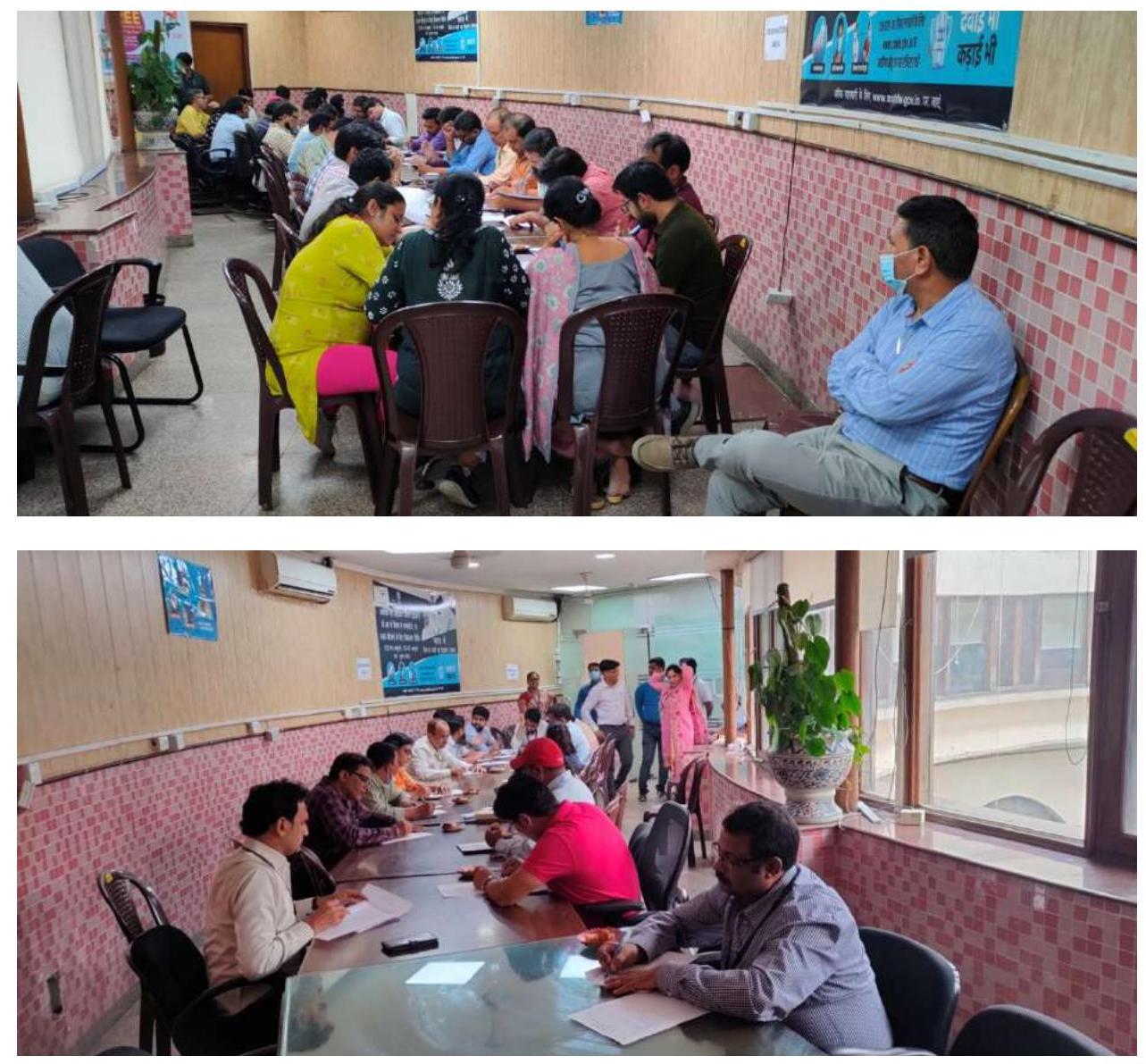
# Stills from competitions held during Hindi Fortnight 2022.
18.7 HINDI IN TRAINING INSTITUTIONS
The two Training Institutions under the Ministry viz. Lal Bahadur Shastri National Academy of Administration (LBSNAA), Mussoorie and the Institute of Secretariat Training and Management (ISTM), New Delhi have made considerable progress in providing the training material in Hindi. In LBSNAA, the teaching material of main subjects are provided in book form and translation of the lecture notes of the topics taken by the faculty members is provided immediately on the demand of trainee officers. Institute of Secretariat Training and Management (ISTM) also has its all the training material available in bilingual form.
18.8 MONITORING AND INSPECTION
The progress made in Hindi for effective implementation of the Official Language Policy is reviewed on the basis of Quarterly Progress Report (QPR) and Annual Assessment Report (AAR). The progress made in the progressive use of Hindi is discussed at length in the quarterly meetings of internal Official Language Implementation Committee in which remedial measures are suggested to remove the shortcomings found.
Besides, Divisions/Sections and the Attached Offices of the Ministry are inspected by Official Language Section of the Department of Personnel and Training in a phased manner and necessary measures are taken and directions are given to overcome the practical difficulties experienced in the course of implementing the Official Language Policy of the Union.
During inspection ways for doing away with the problems faced by the officials in carrying out their works in Hindi are also suggested to give the much needed fillip and thrust to progressive use of official language Hindi. During the year 2022-23 inspections of 17 internal sections and 02 subordinate offices were carried out to take the stock of the progressive use of Official Language.
18.9 RAJBHASHA SHIELD YOJANA
With a view to promote cooperative and competitive feeling and synergy among subordinate offices and headquarters for promoting progressive use of Rajbhasha Hindi in the official work of the Department, an ambitious shield scheme consisting of two parts entitled as Rajbhasha Shield Yojana was launched. The first part is meant for the sections located at Headquarters under which Rajbhasha Shield would be given to the section using Hindi in its official work at premium with other sections and the officers and employees working there in Hindi would be rewarded. The second part of the scheme is meant for the Subordinate Offices in which provisions have been made to give the Rajbhasha Shield to the Subordinate Office doing its official work in Hindi at premium with any of the Subordinate Offices. During the year under review Rajbhasha Shield results are scheduled to be declared in the upcoming month of March, 2023. The yojana has created a spirit of competition and dynamism for progressive use of Official Language Hindi among the officers and employees of the Department.
18.10 $3^{\text {rd }}$ Edition of e-Magazine “KAUSHAL” (A Covid Special Issue)
In a first of its kind initiative the Department of Personnel and Training started an emagazine christened as “KAUSHAL” to provide a platform to the officers and employees of the Department to make a creative, conducive and positive environment for progressive use of Hindi Language in official work in the year 2019. The initiative is leading to a keen desire among the officers and employees to give vent to their creative urge in Hindi language. Hence, this ambitious initiative is helping create a positive synergy among the officers and employees to do their official work in Hindi which in turn will make public administration more citizen-centric and decentralized with greater active participation of the citizens. It would also make public administration more responsive and accessible with increased popular participation and two-way communication between the Government and the citizens.
This is a progressive step to make Official Language Hindi more popular among the officers and employees of the Department which would go a long way in translating the vision of ‘New India-Atmanirbhar Bharat’ of Government of India into reality by rendering public administration and public service delivery mechanism more inclusive.
Owing to some unforeseen causes and unavoidable circumstances the $3^{\text {rd }}$ edition of the magazine could not be published in 2021-2022. Therefore, the publication of the $3^{\text {rd }}$ edition of the magazine is in the wings and the link of the same would be made available on the website of the Department shortly. Now, the E-Magazine is all set to be launched in the month of March, 2023.
CHAPTER 19
FINANCIAL MANAGEMENT
19.1 The provision is for expenditure of the Ministry of Personnel, Public Grievances & Pensions in respect of:
a) Department of Personnel \& Training which is entrusted with the work relating to framing / interpretation of rules and regulations; recruitment, promotion and reservation policy; induction, training and refresher courses for all levels / grades of Civil Services posts; service conditions, career and manpower planning, vigilance, discipline and welfare activities of Central Government servants; investigation and prosecution in corruption cases and other serious crimes; redressal of grievances of public servants.
b) Department of Administrative Reforms \& Public Grievances which is entrusted with matters relating to Administrative Reforms, O\&M and policy, coordination and redressal of grievances including those pertaining to Central Government Agencies; hosting of Civil Service Day, PM’s Award, Chief Secretaries Conference etc.
c) Department of Pension \& Pensioners Welfare which administers all activities relating to retirement benefits including Gratuity, Pension, fringe benefits to pensioners, etc.
19.2 The provision is for establishment-related expenditure of the Central Bureau of Investigation which is entrusted with investigation and prosecution in corruption cases against public servants, private persons, firms and other cases of serious crimes. This also includes provision for various projects such as Modernization of Training Centres of CBI, Establishment of Technical and Forensic Support Units, Comprehensive modernization \& purchase of land/ construction of office/ residence buildings for CBI.
19.3 The provision is for establishment-related expenditure of the Staff Selection Commission including expenditure on the conduct of examinations for recruitment of staff in Central Ministries/ Departments etc.
19.4 The provision is for establishment-related expenditure of the Central Administrative Tribunal which is entrusted with the redressal of grievances exclusively of public servants. This also includes provision for Purchase of Land and Construction of Building for various Benches of CAT.
19.5 The provision includes establishment related expenditure of Institute of Secretariat Training \& Management (ISTM), Lal Bahadur Shastri National Academy of Administration (LBSNAA) \& Training Division, DOPT. These Organizations arrange several training programmes including foundation courses, refresher courses, mid-career training, etc. so as to equip all levels / grades of Secretarial functionaries with adequate exposure to the latest rules and regulations, aptitude etc., expenditure on domestic / overseas travel, course fees etc. in respect of CSS / CSSS officials who are to undergo mandatory training at ISTM as a pre-condition for consideration for promotion to next higher grade have also been included centrally in the budget of this Ministry.
19.6 The provision is for establishment related expenditure of Public Enterprises Selection Board and Central Information Commission.
19.7 The provision is for establishment and construction related Charged expenditure for Lok Pal.
19.8 The provision is meant for reimbursement to State Governments towards House Building Advances paid to All India Service Officers.
19.9 This also includes provision for Training schemes like Training for All, Domestic Funding for Foreign Training, Upgradation of LBSNAA to a Centre of Excellence, Augmentation of Training Facilities at ISTM.
19.10 This provision is meant for National Programme for Civil Services & Capacity Building – Mission Karmayogi.
19.11 This also includes Scheme provision for Department of Administrative Reforms \& Public Grievances scheme for Modernisation of Government Offices, Pilot projects on Administrative Reforms which consists of promotion of e-governance, fostering of good governance, learning from success, sevottam etc.
19.12 This includes scheme provision for Department of Pension’s scheme “Pensioners Portal”.
19.13 This also includes Scheme provision for Integrated Building for Institute of Secretariat Training and Management and other Institutes of Department of Personnel and Training.
19.14 This also includes Grants in Aid allocations to Indian Institute of Public Administration and National Centre for Good Governance.
19.15 The provision includes Grants-in-aid assistance to Grih Kalyan Kendra, Central Civil Services Cultural \& Sports Board and National Recruitment Agency.
19.16 This includes fund allocations in respect of DOPT’s Propagation of RTI Act.
19.17 Organisation Wise RE 2022-23 \& BE 2023-24 Allocations
Demand No-74, Ministry of Personnel, Public Grievances \& Pensions
(Rs. in crore)
| Sl. No. |
Organisation | Budget Estimates 2022-23 |
Revised Estimates 2022-23 |
Expenditure upto 31.01.2023 |
Budget Estimates 2023-24 |
|---|---|---|---|---|---|
| $\mathbf{1}$ | M/o PPG\&P | 2337.18 | 2320.37 | 1753.15 | 2207.74 |
| $\mathbf{2}$ | DoPT | 2245.18 | 2219.82 | 1685.51 | 2102.52 |
| $\mathbf{3}$ | D/o AR\&PG | 80.00 | 86.45 | 58.16 | 92.37 |
| $\mathbf{4}$ | D/o Pensions | 12.00 | 14.10 | 9.48 | 12.85 |
Organisation wise details:
(Rs. in crore)
| Sl. No. |
Head | Budget Estimates 2022-23 |
Revised Estimates 2022-23 |
Expenditure upto 31.01.2023 |
% of utilization |
Budget Estimates 2023-24 |
|---|---|---|---|---|---|---|
| 1 | DOPT Estt. | 136.97 | 137.53 | 106.08 | 77.13 | 144.43 |
| 2 | National Programme for Civil Services and Capacity Building (NPCSCB) |
120.01 | 93.13 | 42.19 | 45.30 | 105.69 |
| 3 | Training for All (TFA) |
13.00 | 13.00 | 2.90 | 22.31 | 13.83 |
| 4 | Domestic Funding of Foreign Training (DFFT) |
5.00 | 0.50 | 0.02 | 4.00 | 1.00 |
| 5 | LBSNAA | 115.14 | 130.21 | 91.05 | 69.93 | 110.39 |
|---|---|---|---|---|---|---|
| 6 | ISTM | 33.99 | 37.20 | 18.74 | 50.38 | 58.46 |
| 7 | IIPA | 24.50 | 27.01 | 18.38 | 68.05 | 24.50 |
| 8 | CBI | 911.87 | 906.59 | 720.97 | 79.53 | 946.51 |
| 9 | CAT | 159.00 | 140.62 | 106.94 | 76.05 | 163.42 |
| 10 | SSC | 263.00 | 500.03 | 384.36 | 76.86 | 399.73 |
| 11 | NRA | 396.00 | – | – | – | 10.10 |
| 12 | PESB | 5.70 | 6.50 | 4.31 | 66.31 | 5.70 |
| 13 | CIC | 27.00 | 30.00 | 24.16 | 80.53 | 26.76 |
| 14 | LOKPAL | 34.00 | 197.50 | 165.41 | 83.75 | 92.00 |
| DoPT& its offices | $\mathbf{2 2 4 5 . 1 8}$ | $\mathbf{2 2 1 9 . 8 2}$ | $\mathbf{1 6 8 5 . 5 1}$ | $\mathbf{7 5 . 9 3}$ | $\mathbf{2 1 0 2 . 5 2}$ |
19.16 Capital Allocations
(Rs. in crores)
| Sl. No. |
Head | Budget Estimates 2022-23 |
Revised Estimates 2022-23 |
Expenditure upto $\mathbf{3 1 . 0 1 . 2 0 2 3}$ |
% of utilization |
Budget Estimates 2023-24 |
|---|---|---|---|---|---|---|
| 1. | CBI Projects | 109.96 | 64.63 | 26.88 | 41.59 | 70.14 |
| 2. | CAT Project | 25.00 | 12.91 | 2.81 | 21.77 | 17.75 |
| 3. | Augmentation of Training facilities in ISTM |
8.31 | 8.32 | – | – | 5.00 |
| 4. | Integrated Building for ISTM and other Institutes of DoPT |
– | – | – | – | 20.00 |
| 5. | Improvement of infrastructure and upgradation of essential facilities at LBSNAA |
50.00 | 50.00 | 26.55 | 53.10 | 36.79 |
| 6. | National Programme for Civil Services \& Capacity Building: NPCSCB (SPV) |
20.01 | 20.00 | 20.00 | 100 | 05.01 |
| 7. | Lokpal | 10.00 | 175.46 | 152.27 | 86.78 | 69.42 |
| 8. | HBA to AIS Officers |
2.00 | 2.00 | 1.22 | 61.00 | 2.00 |
| Total | 225.28 | 333.32 | 229.73 | 69.00 | 226.11 |
19.17 AUDIT OBSERVATION IN RESPECT OF MINISTRY OF PERSONNEL, PUBLIC GRIEVANCES \& PENSIONS
19.17.1 Public Accounts Committee
No PAC para is pending in this Ministry.
19.17.2 Comptroller \& Auditor General of India
One C\&AG paras is pending in r/o D/o ARPG.
19.17.3 Statutory Audit Paras
| S.No. | Name of the office | No. of Outstanding paras as on $31 / 12 / 2021$ |
No. of Outstanding paras as on $31 / 12 / 2022$ |
|---|---|---|---|
| 1 | Department of Personnel & Training |
$\mathbf{3 0}$ | $\mathbf{2 6}$ |
| 2 | Staff Selection Commission | $\mathbf{5 0}$ | $\mathbf{4 8}$ |
| 3 | Union Public Service Commission | $\mathbf{8}$ | $\mathbf{1 4}$ |
| 4 | Institute of Secretariat Training \& Management |
$\mathbf{1 5}$ | $\mathbf{1 5}$ |
| 5 | Department of AR \& PG | $\mathbf{1 7}$ | $\mathbf{0}$ |
| 6 | Deptt. of Pensions \& Pensioners’ Welfare |
$\mathbf{0}$ | $\mathbf{0}$ |
| 7 | Lal Bahadur Shastri National Academy of Administration |
$\mathbf{2 0}$ | $\mathbf{9}$ |
| 8 | Central Administrative Tribunal | $\mathbf{3 7}$ | $\mathbf{4 0}$ |
| 9 | Central Vigilance Commission | $\mathbf{2 3}$ | $\mathbf{2 3}$ |
| 10 | Central Information Commission | $\mathbf{1 8}$ | $\mathbf{1 8}$ |
| 11 | Central Bureau of Investigation | $\mathbf{2 0 9}$ | $\mathbf{1 6 7}$ |
| Total | M/o PPG\&P | $\mathbf{4 2 7}$ | $\mathbf{3 6 0}$ |
All the concerned authorities have been instructed to take steps for early settlement of the audit objections.
DEPARTMENT
OF
ADMINISTRATIVE REFORMS
PUBLIC GRIEVANCES
CHAPTER 20
DEPARTMENT OF ADMINISTRATIVE REFORMS AND PUBLIC GRIEVANCES
Vision
Excellence in governance for the benefit of all citizens.
Mission
To foster excellence in governance and pursuit of administrative reforms through:
- Improvements in government policies, structures and processes.
- Promoting citizen-centric governance with emphasis on grievance redressal.
- Innovations in e-Governance; .
- Awards and Documentation & dissemination of Best Practices.
Objectives
- Promoting administrative reforms in government policies and processes.
- Formulation of policy and coordination of issues relating to redress of grievances.
- Dissemination of governance knowledge and best practices.
- Promoting reforms through e-Governance.
EXECUTIVE SUMMARY
20.0 The Department of Administrative Reforms and Public Grievances is the nodal agency of the Government of India for administrative reforms as well as redressal of public grievances relating to the States in general and those pertaining to Central Government agencies in particular. The Department endeavours to document and disseminate successful governance practices by way of audio-visual media and publications. The Department also undertakes activities in the field of international exchange and cooperation to promote public service reforms. There are 8Divisions in the Department namely Administrative Reforms, Organization \& Methods, e-Governance, Documentation \& Dissemination, International Exchange \& Cooperation, Administration \& Coordination, Public Grievances and Administrative Reforms Commission (ARC)/e-Office.
20.1 The Department is headed by the Secretary, Department of Administrative Reforms \& Public Grievances and Pensions \& Pensioners’ Welfare. Available Staff Strength is one Secretary, one Additional Secretary, 2 Joint Secretaries, 7 Directors/Deputy Secretaries and 14 Under Secretary level officers in the Department. An organizational chart of the Department is at Annexure-V. Incumbency position of Under Secretary and above level officers is at Annexure-VI. Information regarding steps taken by this Department for Prevention of sexual harassment of women at workplace and welfare of SC, ST, OBC and Persons with Disability (PWD) are at Annexure-VII and Annexure-VIII respectively.
20.2 As per the Government of India Allocation of Business Rules, the following subjects have been allocated to the Department of Administrative Reforms \& Public Grievances:
- Administrative Reforms, including e-governance and dissemination of best practices.
- Organization and Methods.
- Policy, coordination and monitoring of issues relating to –
(a) Redress of public grievances in general; and
(b) Grievances pertaining to Central Government agencies.
(c) Monitoring of implementation of e-Office in Central Ministries / Departments
4. (a) Research in public management;
(b) Liaison with State Governments, professional institutions etc. in public management matters.
5. Administration of Central Secretariat Manual of Office Procedure:
PERFORMANCE (2022-23)
| S1.No. | Objective | Targeted Activities |
|---|---|---|
| 1. | Formulation of policy and coordination of issues relating to redress of grievances. | (1.1) Review of pendency of grievances in Ministries / Departments / Organizations as well as States and UTs (1.2) Training of CPGRAMS to Ministries/Departments. |
| (1.3) Capability building of Administrative Training Institutes for improved service delivery in their respective State Government Departments through capacity building. | ||
| (1.4) Universalization of CPGRAMS Reforms version 7.0 in Central Ministries for user friendly and faster grievance redressal. | ||
| (1.5) Integration of State Government portals with CPGRAMS | ||
| (1.6) The Appeal functionality in CPGRAMS on recommendation of Department related Parliamentary Standing Committee in its $100^{\text {th }}$ Report has been introduced in CPGRAMS. | ||
| (1.7) Process for Setting up permanent Feedback call centre for seeking feedback from the Citizens on disposed of Grievances and also help citizens to file/track their grievances if such help is needed by them. | ||
| (1.8) To leverage strength of Common Service Centres (CSC) to take the facility of CPGRAMS to unconnected rural population and make awareness about CPGRAMS. | ||
| (1.9) To introduce CPGRAMS in all regional languages, to expand its outreach specially among the rural population. | ||
| (1.10) Introduction of Artificial Intelligence (AI)/Machine Learning (ML) tools in the system in partnership with IIT, Kanpur to categories grievances and assess quality of resolution. | ||
| (1.11) To develop a new format of Action Taken Report (ATR). This would provide a matrix for assessment of quality of resolution. |
| 2. | Dissemination of governance knowledge and best practices | (2.1) Providing financial assistance to States/ UTs/ CTIs for professional documentation and dissemination of Good Governance practices. (2.2) Production of documentary films on good governance practices. (2.3) Publishing of books containing articles on shortlisted and awarded initiatives. (2.4) Publication of biannual e-magazine ‘Minimum Government-Maximum Governance’. (2.5) Organizing of Regional Conferences |
|---|---|---|
| 3. | State Collaboration Initiative | (3.1) DARPG has sanctioned 55 projects till date in various States/UTs. |
| 4. | Redress of public grievance | (4.1) Total no of public grievances disposed of as on $31.12 .2022-21,35,923$. |
| 5. | Promoting reforms through e-Governance | (5.1) Organizing National Conference on eGovernance and presenting National Awards for eGovernance (5.2) Publishing of Compendium of select papers on issues of e-Governance, a booklet on excellence in eGovernance, a booklet on citations for National eGovernance Award Winners, and a compilation of conference papers. (5.2.1) Development of case studies on eGovernance initiatives. (5.2.2) Publishing of National e-Governance Service Delivery Assessment report (NeSDA). |
| 6.* | Transparency/Service delivery in the Department | (6.1) The Citizens’ Charter of Ministries/Departments as well as States/UTs is available on goicharters.nic.in. Review meetings held for updation of Citizens Charters. |
| 7.* | Administrative Reforms | (7.1) Prime Minister’s Awards for Excellence in Public Administration. (7.2) Organising Civil Services Day. (7.3) Development of case studies on best practices. (7.4) Promotion of Administrative Reforms through |
| simplification of procedure such as abolition of affidavits and promotion of self certification. (7.5) Designing, Developing & publishing Good Governance Index, recommended by Sectoral Group of Secretaries on Governance to present a state-wise comparative picture about the strong and weak areas of service delivery, which would help them in generating performance improvement mechanism. (7.6) Developing District Good Governance Index of States/UTs. |
||
|---|---|---|
| 8.* | Improving Internal Efficiency/Responsiveness. | (8.1) Update departmental strategy to align with Plan priorities/objectives of the Scheme. |
| 9.* | Ensuring compliance to the Financial Accountability Framework | (9.1) Timely submission of Action Taken Notes on Audit paras of C\&AG. (9.2) Timely submission of Action Taken Reports to the PAC Sectt. on PAC Reports. |
| 10. | e-Office Progress | (10.1) 56 Central Ministries and Departments have already achieved the target of complete e-Office. As on 28.02.2023, all Central Ministries/ Departments have migrated on e-Office Version 7.0. |
| 11. | National Centre for Good Governance (NCGG) | (11.1) The Centre is envisaged to be the apex thinktank that would guide the Government and help in implementing Good Governance Reforms. |
| 12. | Special Campaign on Disposal of Pendency | (12.1) During the campaign about 64.92 lakh records were reviewed and 37.27 lakh records were weeded out. Rs. 370.00 cr . was earned from the disposal of scrap. |
| 13. | Good Governance Week, 2021 | (13.1) During the event 380 citizen charters were updated, 621 new services have been added in Citizen Charters, 6.67 lakh public grievances were attended to and 2.89 cr . applications under service delivery were disposed of. |
- Mandatory objectives
20.3 FUNCTIONS
(i) Matters relating to administrative reforms.
(ii) Organization of Civil Services Day and Prime Minister’s Awards for Excellence in Public Administration.
(iii) Capacity building, change management and Government Process Re-engineering to provide reform through e-Governance.
(iv) e-Office Mission Mode Project under NeGP.
(v) Organisation of National Conference on e-Governance and National awards on eGovernance.
(vi) Management of Public Grievance Redressal Mechanism.
(vii) Documentation and dissemination of Good Governance Practices – innovations, adaptation and replication.
Important events/achievements of the Department
20.4 Prime Ministers’ Awards for Excellence in Public Administration
20.4.1 Government of India has instituted a scheme “Prime Minister’s Awards for Excellence in Public Administration” in 2006 to acknowledge, recognize and award the extraordinary and innovative work done by the Districts/ implementing units and organizations of Central and State Governments.
20.4.2 Since its inception and till 2015, the awards were conferred in three categories, viz., individual, group and organizations. The structure of the Awards Scheme was changed in 2015-16 to focus on excellence in implementation of identified Priority Programmes wherein the States were grouped in three categories namely; (i) North Eastern and Hilly States; (ii) Union Territories and (iii) Other States. The PM Awards Scheme was restructured in 2020 to recognize the performance of District Collectors towards economic development of the District. The Scheme for Prime Minister’s Awards for Excellence in Public Administration was again revamped in 2021 with the objective to encourage Constructive Competition, Innovation, Replication and Institutionalization of Best Practices.
20.4.3 Prime Minister’s Awards are presented on Civil Services Day (CSD) held on $21^{\text {st }}$ April of every year. This is an occasion for Civil Servants of the Country to rededicate themselves to citizens and renew their commitment to public service and excellence in work. So far 14 Civil Services Day have been celebrated.
20.5 PUBLIC GRIEVANCES
20.5.1 An online system for grievance redress, called the ‘Centralized Public Grievance Redress and Monitoring System (CPGRAMS) has evolved since 2007. During the year, the Department has extensively used the System to forward public grievances to both the Central Government Ministries/Departments/Organisations as well as the State Governments concerned. The inflow of both centre and State related grievances is in two forms (i) through the CPGRAMS and (ii) through post. The grievances received by post are digitized and sent online through the System as well as by post to the Central Ministries/Departments/Organisations/State / UT Government concerned.
20.5.2 For better monitoring, analytical reports are generated through CPGRAMS as per requirement. The format includes receipts, disposal and $%$ disposals with reference to cases pending for 2-6 months, 6-12 months and more than one year.
20.5.3 Public Grievance Mechanism of PMO available on website www.pmoindia.gov.in has been integrated with the pgportal.gov.in. This enables transfer of grievances lodged to the PMO to the Central Ministries/Departments/Organisations and State Governments and online monitoring of public grievances through CPGRAMS.
20.5.4 The Public interface of CPGRAMS has also been duly integrated with the pensioners’ portal and an option has been provided to the users to lodge pension related grievances to the pensioners’ portal by clicking the relevant option on the pgportal.gov.in.
20.5.5 Public grievance mechanism of PMO, the President’s Secretariat, the Directorate of Public Grievances (Cabinet Secretariat), Department of Administrative Reforms & Public Grievances (DARPG) and that of Department of Pensioners’ portal have been duly integrated through CPGARMS thus enabling grievances lodged to any of these
entities to be transferred to the Central Ministries/Departments and State / UTs Governments online through CPGRAMS.
20.5.6 Operational trainings on Centralized Public Grievance Redress and Monitoring System (CPGRAMS) are being held regularly by the Department on last Thursday of every month for Officials of various Ministries /Departments and their sub-ordinate organisations. A system for online registration for this training has been put in place by the Department for the purpose. The training imparted relates to new features and improvements in CPGRAMS. Problems which are being faced by the nodal Public Grievance Officers during the redressal of grievances are also taken up and resolutions on the same imparted during the training sessions.
20.5.7 During the period from 2022, 06 intensive review meetings have been held for reviewing the status of pending public grievances in Ministries/Departments/Organisations and expediting action on them.
20.5.8 Introduction of an Appeal Mechanism/functionality in CPGRAMS- The Appeal Mechanism/functionality in CPGRAMS in line with the Department related Parliamentary Standing Committee Recommendations in its $100^{\text {th }}$ Report has been introduced in CPGRAMS. The recommendations were communicated to all Central Ministries/Departments with the request to nominate a Nodal (Appellate) authority. The Appeal provision has been made for redressal of dis-satisfied grievances identified through a mandatory feedback rating to be given by the Citizen on disposal of the grievance by the Nodal Grievance Officers.
In 2022 a 10 -step CPGRAMS reforms process was adopted by DARPG for improving quality of disposal and reducing the time lines.
The 10 -step reforms include:
- Universalization of CPGRAMS 7.0-Auto-routing of grievances to the last mile.
- Technological Enhancements- Automatic flagging of urgent grievances leveraging AI/ ML.
- Language Translation-CPGRAMS Portal in 22 scheduled languages along with English.
- Grievance Redressal Index- Ranking of Ministries/ Departments on their Performance.
- Feedback Call Centre- 50 -seater call centre to collect feedback directly from every citizen whose grievance is redressed.
- One Nation One Portal-Integration of State Portal and other GoI portals with CPGRAMS.
- Inclusivity and Outreach-Empowering the remotest citizen to file grievances through CSC’s.
- Training and Capacity Building- Conducted by ISTM and State ATIs under SEVOTTAM scheme for enabling effective grievance resolution.
- Monitoring Process – Monthly reports for both the Central Ministries/ Departments and States/ UTs.
- Data Strategy Unit – Established at DARPG for insightful data analytics.
This 10 Step process adoption has resulted in remarkable decrease in the average time of disposals of Public Grievances. In 2022, Ministries/ Departments have disposed 1.14 lakh PG cases in August, 1.17 lakh PG cases in September, 1.19 lakh PG cases in October and
1.08 lakh PG cases in November and 1.27 lakh cases in December, 2022. This is the first time since inception of CPGRAMS that PG case redressal has crossed 1 lakh cases/ month. The disposal in State PG cases on CPGRAMS portal has crossed 50,000 cases/ month since September2022.
10StepCPGRAMSReform
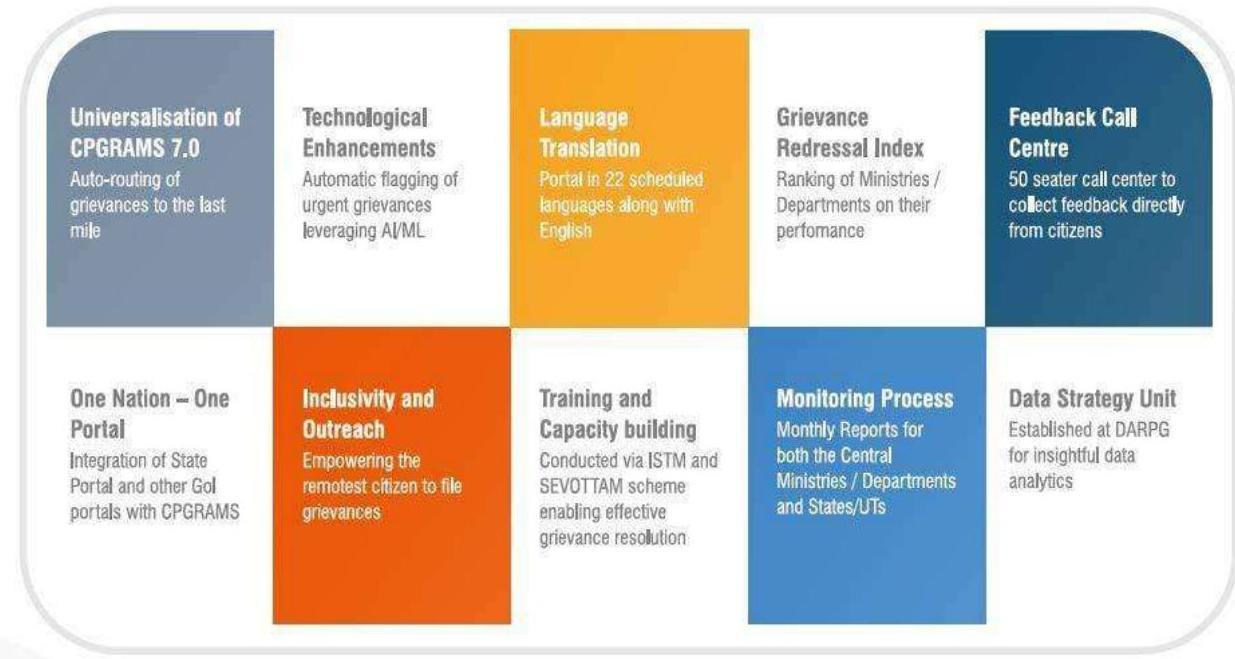
20.6 Citizens’ Charter
20.6.1 The Department of Administrative Reforms and Public Grievances in its efforts to provide more responsive and citizen-centric governance coordinates the efforts of Ministries / Departments to formulate and operationalize Citizen’s Charters in Central Government Ministries / Departments as well as State Governments and UT Administrations. It provides guidelines for formulation and implementation of the Citizen’s Charters. The Citizen’s/Client’s Charter (CC) was first introduced simultaneously in Central Government Departments and in all State Governments in May, 1997. The Citizen’s Charter of DARPG is being reviewed and the updated version will be uploaded website of the Department as well as on the “goicharters.nic.in”.
20.7 Sevottam
20.7.1 Sevottam is a generic framework for achieving excellence in public service delivery. It comprises of 3 modules namely, Citizen’s Charter, Grievance Redressal Mechanism and Capability Building for Service Delivery. As part of the Strategic plan for Capability Building towards implementing Sevottam Quality Management System, a Scheme for Strengthening of Administrative Training Institutes has been implemented during the 12th Five Year Plan 2012-2017 in Training Institutions in 10 States. This Scheme was extended for a further period of 3 years till 31.03.2021.
20.8 INTERNATIONAL EXCHANGE AND COOPERATION:
20.8.1 The Department works as the nodal point in respect of matters relating to international cooperation in the field of Public Administration and Governance, which includes organizing programmes and visits of the foreign delegations to India and visits of Indian delegations abroad as part of projects / bilateral measures taken up in accordance with the Memorandum of Understandings (MOUs) / Agreements signed between India and other countries (bilateral or multilateral).
20.09 Minimum Government Maximum Governance Initiatives (implementation of eOffice-Mission Mode Project)
e-Office is one of the Mission Mode Projects (MMPs), under the National eGovernance Plan (NeGP). The project is aimed at significantly improving the operational efficiency of Central Government Ministries and Departments through improvement in the workflow mechanisms and associated with office procedure manuals. The DAR&PG is the nodal agency for implementing the project “e-Office”. Effective steps have been taken to expedite implementation of e-office in Central Government Ministries/Departments. 56 Central Ministries and Departments have already implemented e-Office fully and other Central Ministries/Departments have also started showing improving trends. As on 28.02.2023 all Central Ministries/ Departments have migrated on e-Office Version 7.0.
20.10 Promoting Documentation and Dissemination of Good Governance Initiatives
The Documentation and Dissemination Division of the Department primarily carries out the activities of documentation and dissemination of good governance practices of Central and State Governments and Union Territory Administration with a view to facilitate sharing of experience with one another and replication elsewhere.
This Department brings out its e- Magazine titled ‘Minimum Government – Maximum Governance’ (MGMG) as an e-Book in its endeavors to document and disseminate successful good governance practices. In the e- Magazine, write-ups based on the shortlisted initiatives of PM Awards and National e- Governance Awards instituted by DARPG have been compiled and published on the website of the Department in e-Book form biannually.
20.11 Promoting e-Governance (National Conference on e-Governance and National eGovernance Awards)
The Department of Administrative Reforms \& Public Grievances along with the Ministry of Electronics and Information Technology, in association with one of the State Governments, has been organizing the National Conference on e-Governance every year since 1997. This conference provides platform for the senior officers of the Government including IT Secretaries of State Governments, IT Managers of the Central Government, and resource persons, experts, intellectuals from the industry and academic institutions, etc. to discuss, exchange views and experiences relating to various e-Governance initiatives. National Awards on e-Governance are also presented during the Conference for excellence in e-Governance.
20.12 Summary of important Audit Observations on Report No. 24 of 2022 of the Comptroller and Auditor General of India-Union Government (Civil).
Tabled in the Parliament on 20th December, 2022
Report No. 24 of 2022 of the Comptroller and Auditor General of India – Union Government (Civil), contains significant audit findings arising from the compliance audit of financial transactions under 54 grants relating to 28 Civil Ministries/ Departments/ Constitutional Bodies of the Union Government under the General and Social Services sectors and Central Public Sector Enterprises under their administrative jurisdiction as also Union Territories without Legislatures.
Ministry of Personnel, Public Grievances and Pensions
Department of Administrative Reforms and Public Grievances hired office space from State Trading Corporation of India Limited, which required extensive renovation works to make it fit to occupy. Though the space was hired w.e.f. December 2020, the initiation of renovation process started only in September 2021. This resulted in infructuous expenditure aggregating 13.26 crore towards rent for nine months from December 2020 to August 2021.
CHAPTER 21
ADMINISTRATIVE REFORMS
Civil Services Day and Prime Minister’s Awards Scheme for Excellence in Public Administration
21.1 The Government of India celebrates April, 21 every year as ‘Civil Services Day’ for the civil servants to rededicate themselves to the cause of citizens and renew their commitment to public service and excellence in work. The first such function was held in VigyanBhavan, New Delhi on $21^{\text {st }}$ April, 2006. On the occasion, the Hon’ble Prime Minister conferred “Prime Minister’s Awards for Excellence in Public Administration” to acknowledge, recognize and award the extraordinary and innovative work done by officers of the Central and State Governments including Districts. This date coincides with the date when the first Home Minister of Independent India SardarVallabhbhai Patel addressed the first batch of Indian Administrative Services Officers at Metcalf House New Delhi. Technical sessions on governance related subjects of contemporary, exhibition, release of books and documentaries are part of the event, which is attended by Ministers and senior bureaucrats of the country.
21.1.1 In 2022, the $15^{\text {th }}$ Civil Services Day function was held in Vigyan Bhawan, New Delhi on $20^{\text {th }}-21^{\text {st }}$ April, 2022, on the theme “Vision India @2047-Bringing Citizens and Government closer”. The Hon’ble Prime Minister graced the occasion on $21^{\text {st }}$ April and conferred the Prime Minister’s Awards for Excellence in Public Administration 2021 for effective implementation of identified Priority Programmes and Innovation to districts/ implementing units and other Central/ State organizations. In addition, the Prime Minister’s Awards for Excellence in Public Administration for the years 2019 and 2020 were also conferred by the Hon’ble Prime Minister.
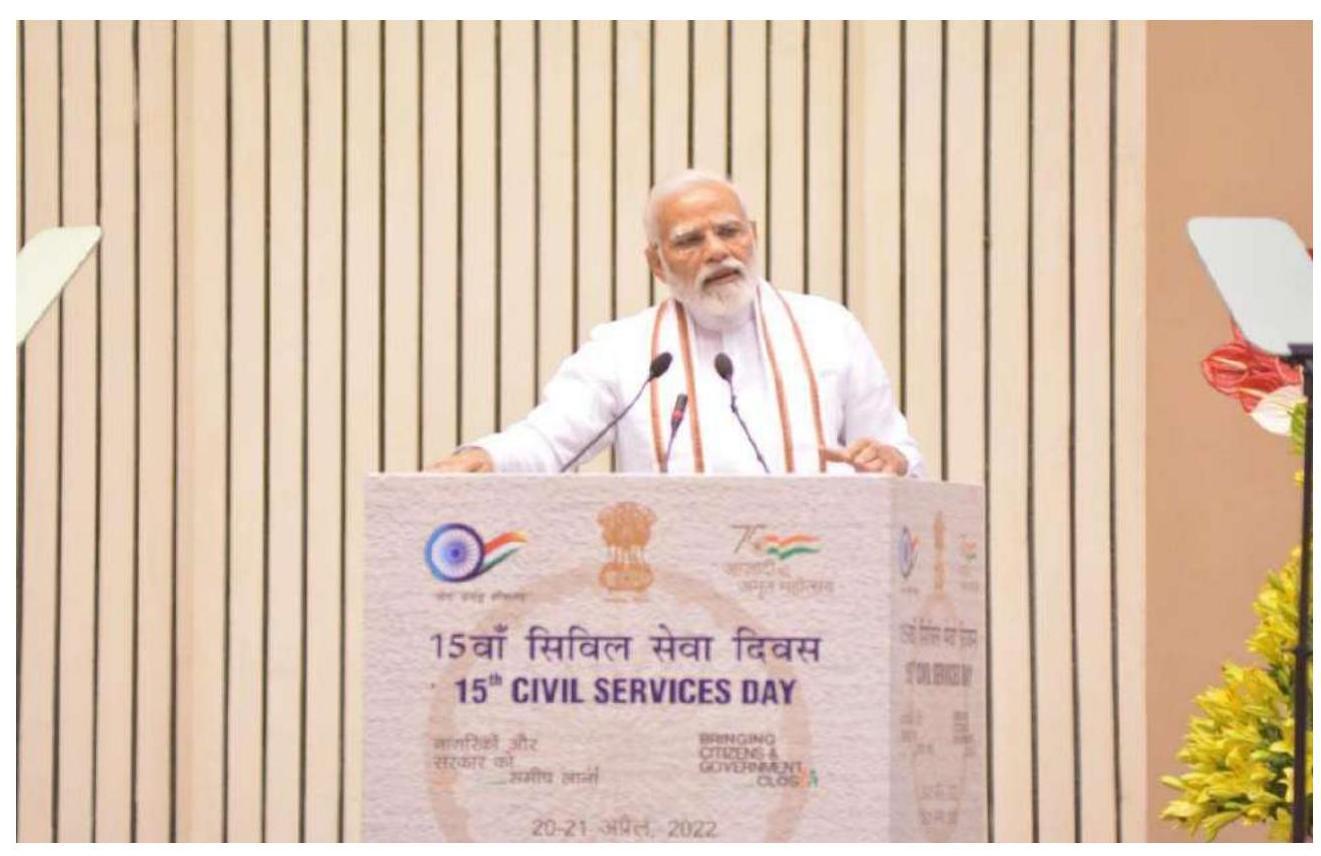
Hon’ble Prime Minister addressing the CSD 2022 event
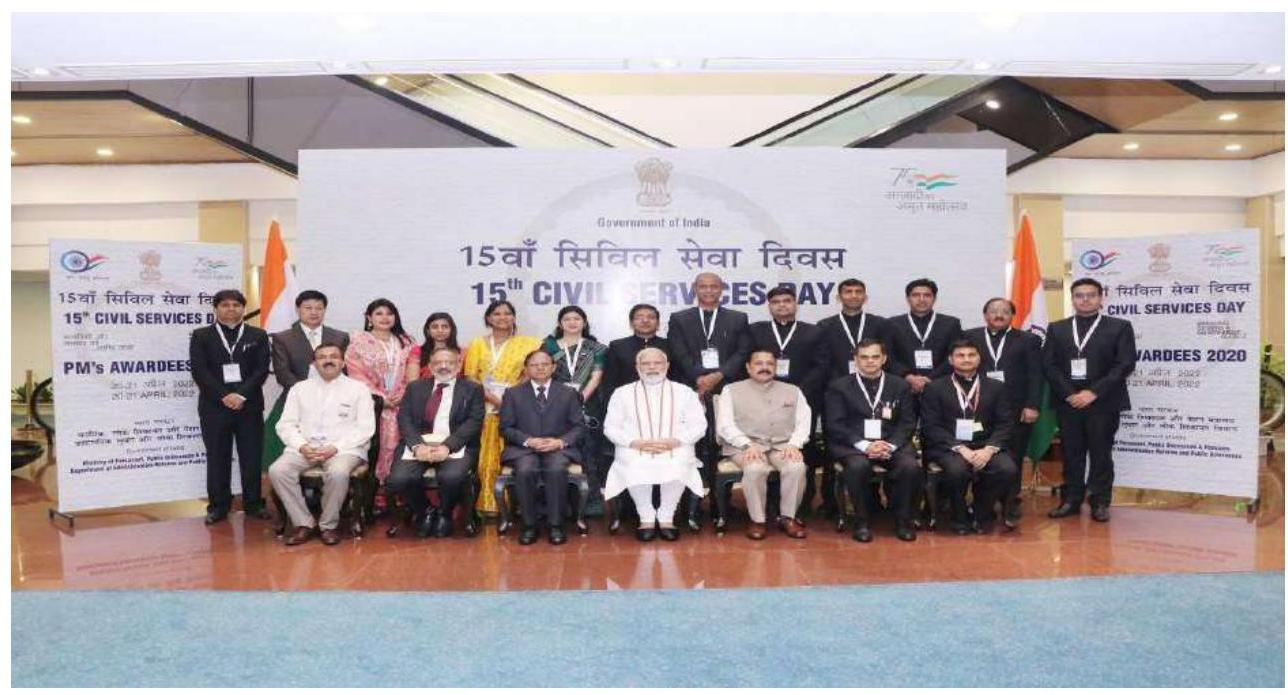
Ceremonial Photographs of the recipients of Prime Minister’s Awards 2020 with Hon’ble Prime Minister
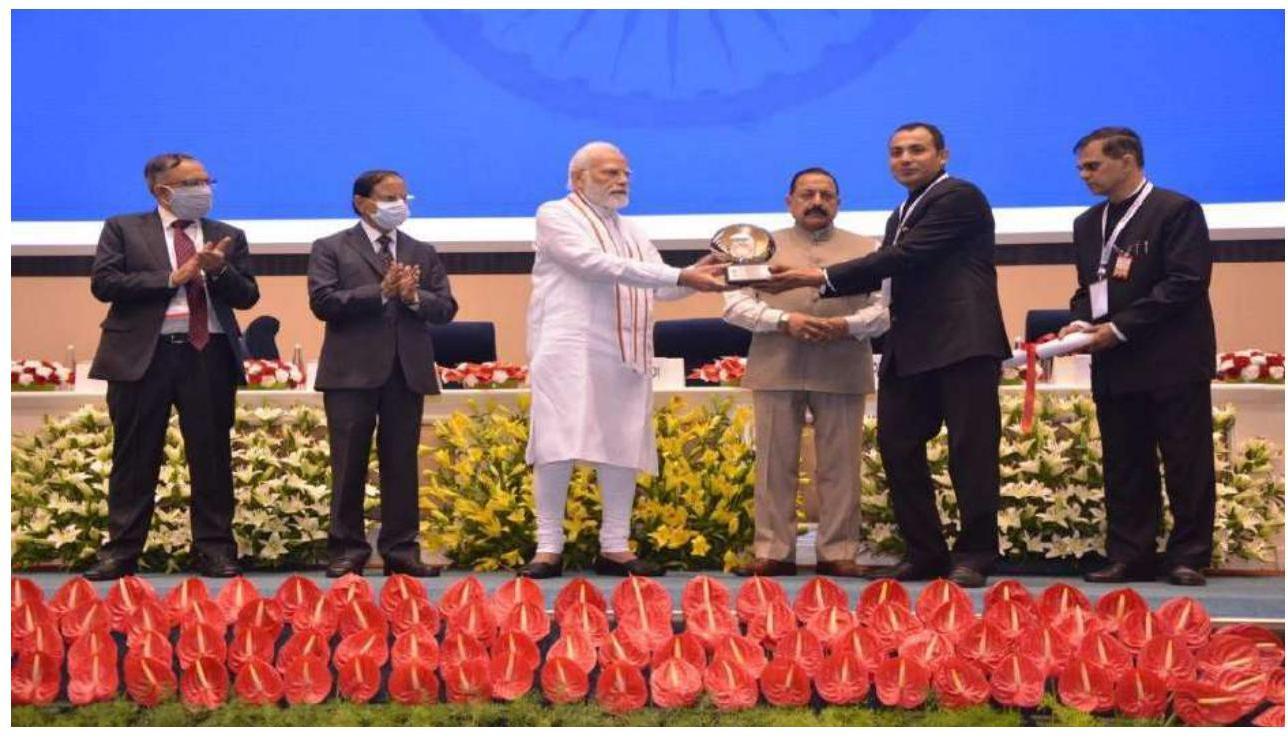
Hon’ble Prime Minister conferring the Prime Minister’s Awards-2021 to the UT of Ladakh for the initiative “Building of efficient Greenhouse to grow crops” under Innovation (State)
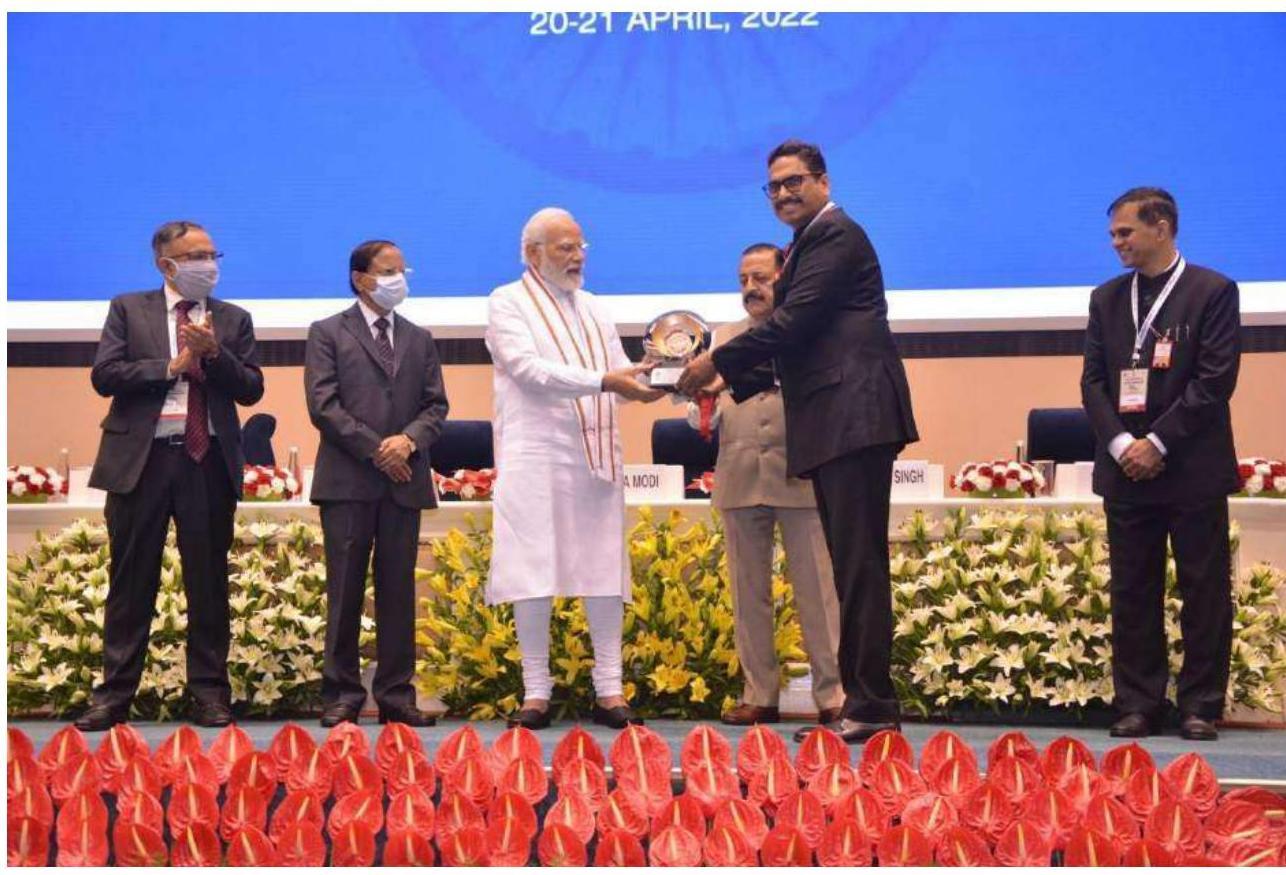
Hon’ble Prime Minister conferring the Prime Minister’s Awards-2021 to Department of Defence Production for the initiative “iDex” under Innovation (Centre)
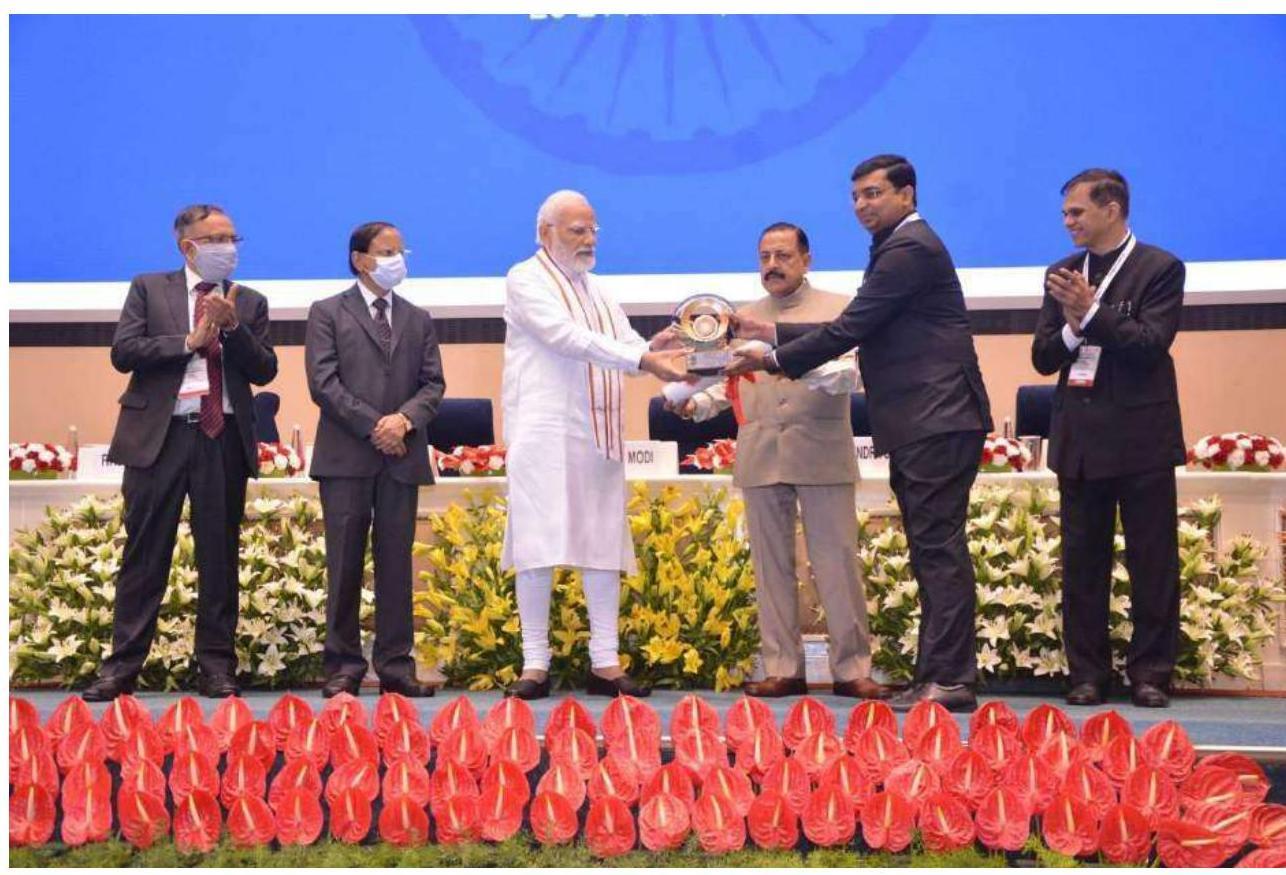
Hon’ble Prime Minister conferring the Prime Minister’s Awards-2021 to District West Champaran, Bihar for the initiative “Navpravartan Startup Zone Chanpatia” under Innovation (District)
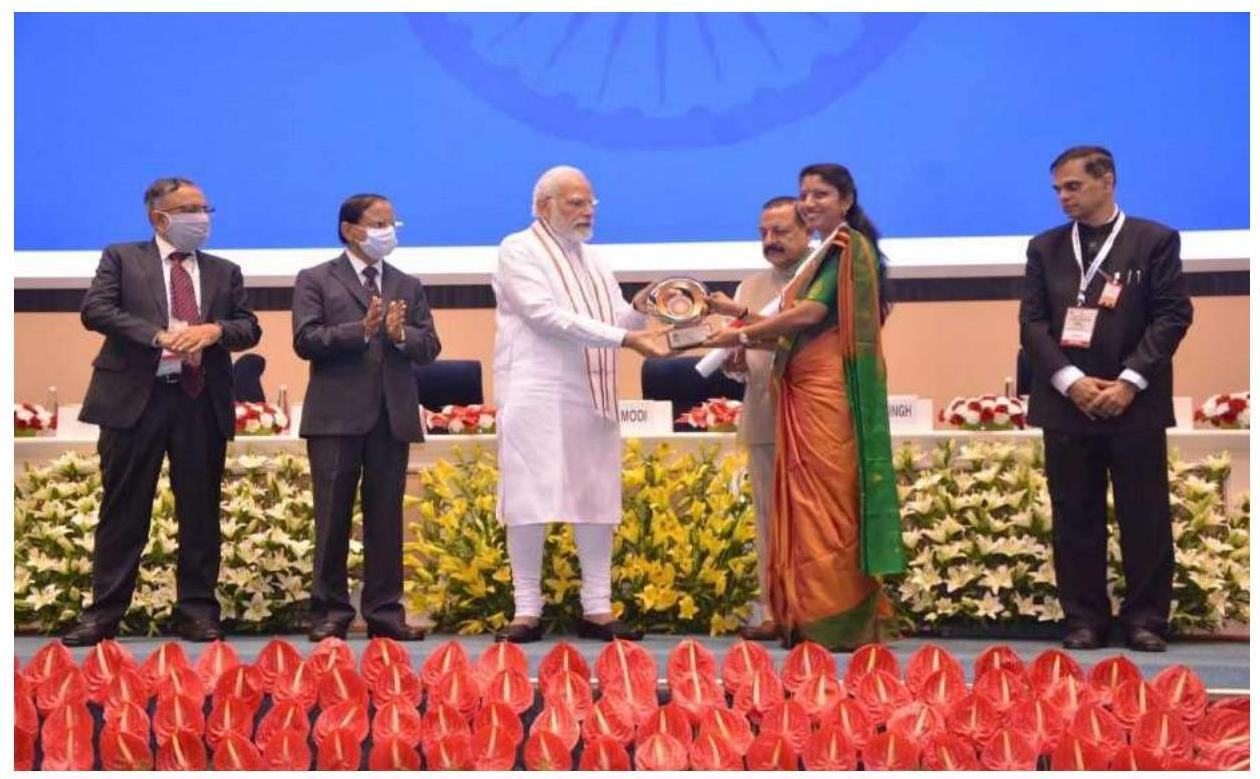
Hon’ble Prime Minister conferring the Prime Minister’s Awards-2021District Bongaigaon, Assam for the initiative “Sampoorna” under Innovation (District)
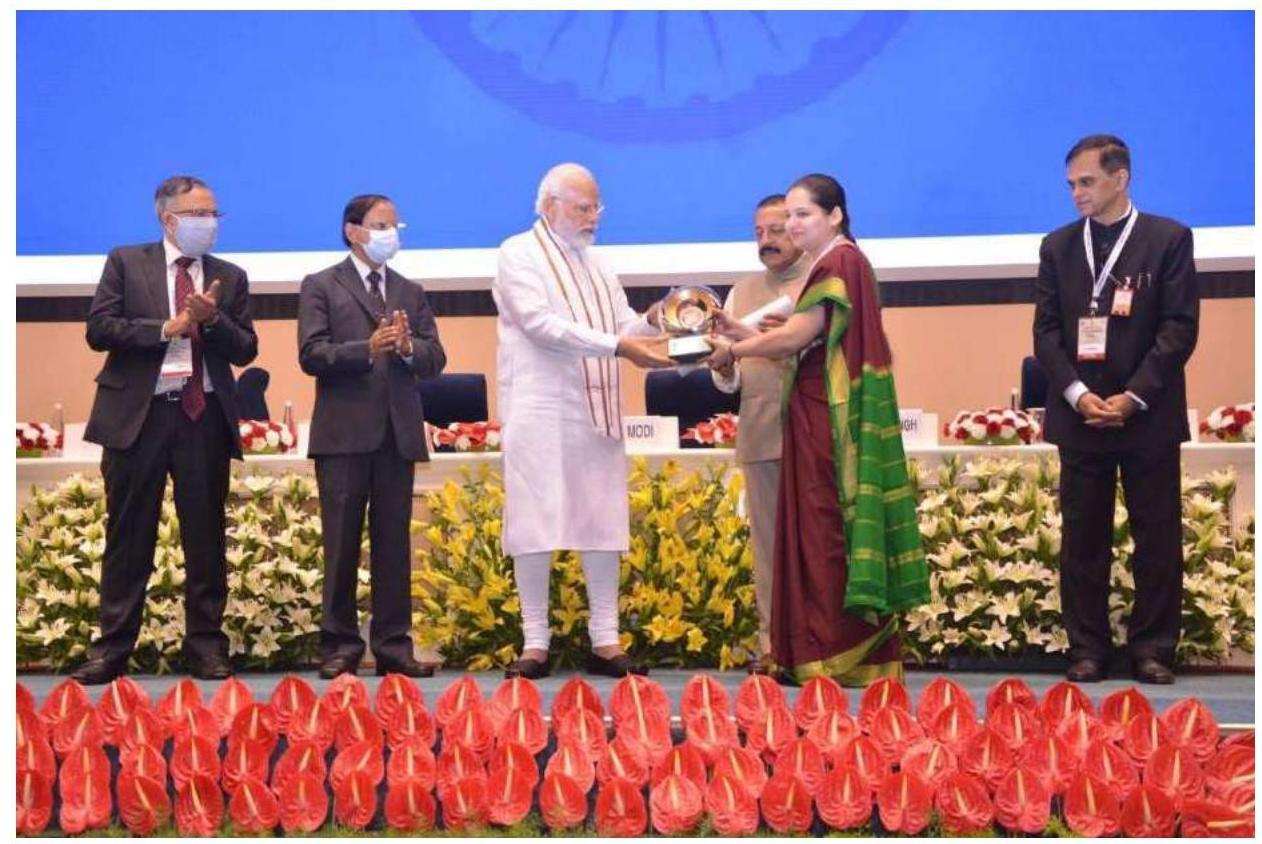
Hon’ble Prime Minister conferring the Prime Minister’s Awards-2021 to the state of Karnataka for the initiative “Seva Sindhu” under ‘Seamless, End to End Delivery of Services without Human Intervention’ Scheme
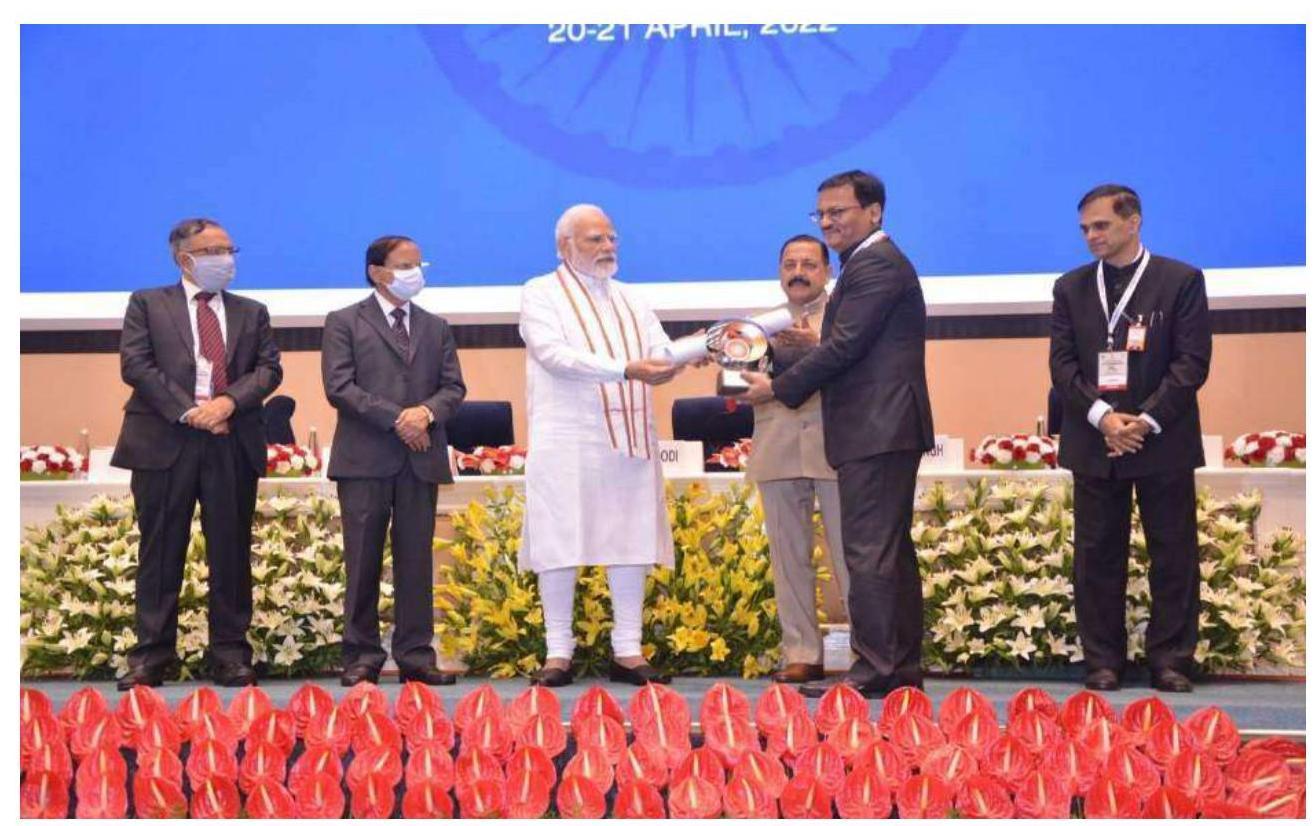
Hon’ble PrimeMinister conferring the PrimeMinister’s Awards-2021 to NDMC for the initiative “NDMC-311 Appunder ‘Seamless, End to End Delivery of Services without Human Intervention’ Scheme
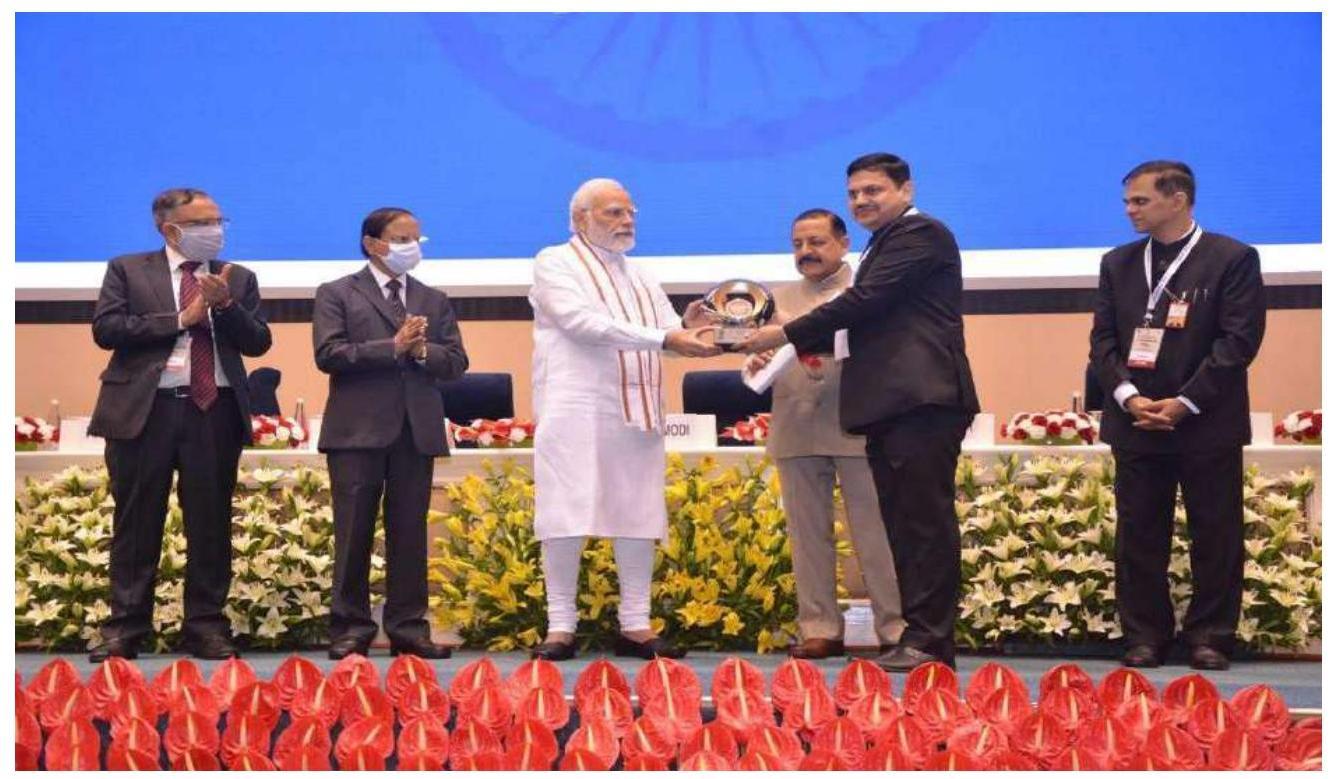
Hon’ble Prime Minister conferring the Prime Minister’s Awards-2021 to District Varanasi, Uttar Pradesh for the “PM SVANidhi Yojana” scheme
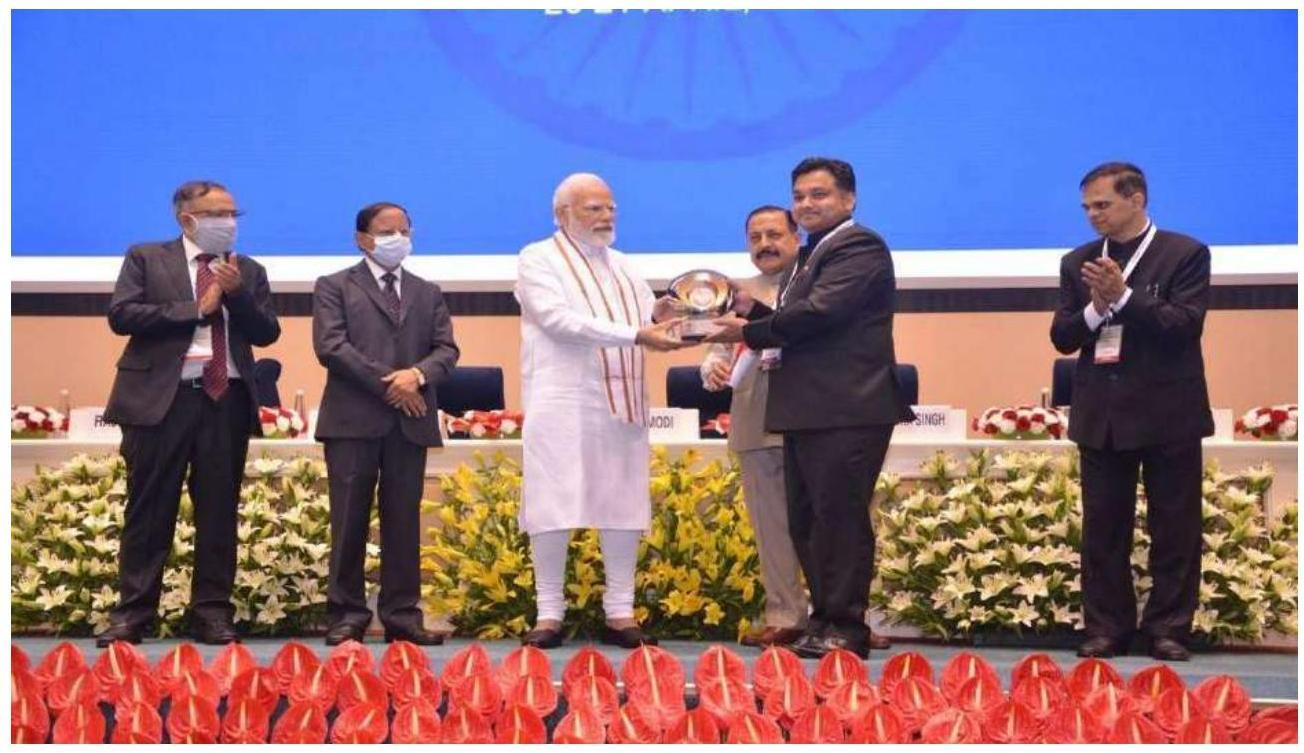
Hon’ble Prime Minister conferring the Prime Minister’s Awards-2021 to District Anantnag, Jammu and Kashmir for the “PM SVANidhi Yojana” scheme
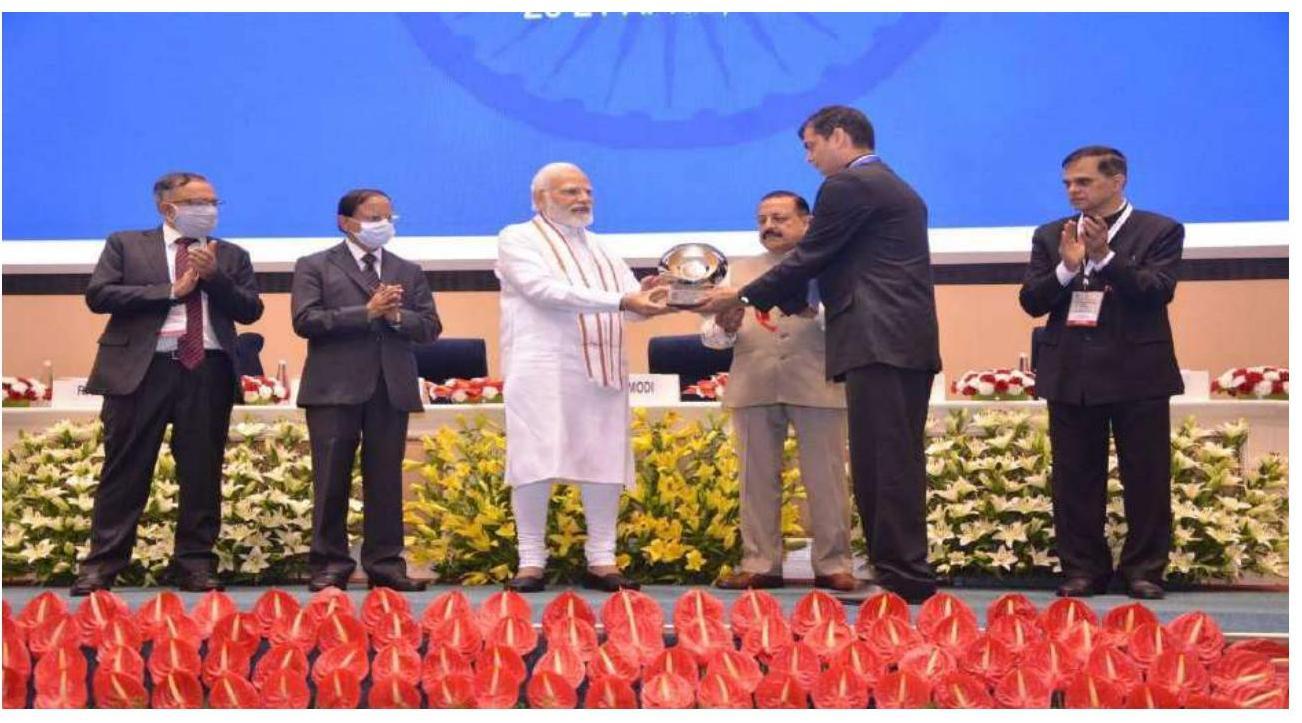
Hon’ble Prime Minister conferring the Prime Minister’s Awards-2021 to District Darbhanga, Bihar for the Initiative ‘Makhana’ under ‘Holistic Development through One District One Product’ scheme
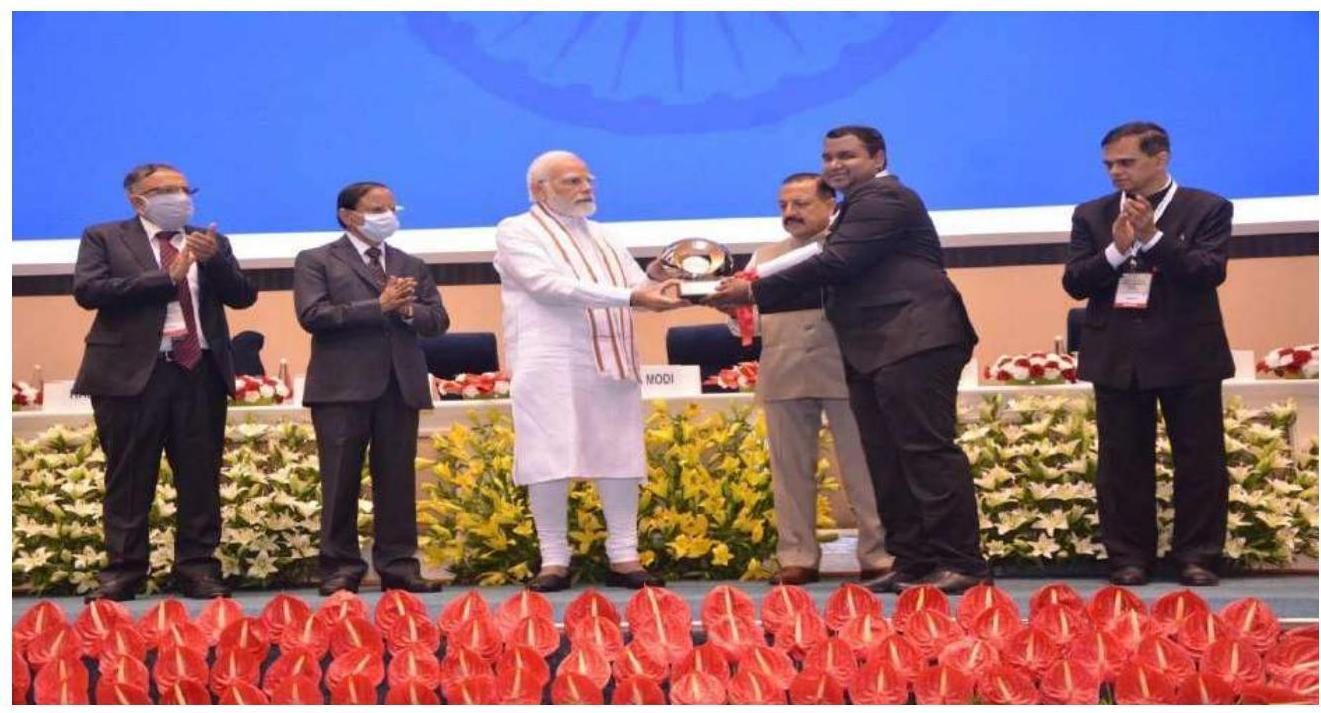
Hon’ble PrimeMinister conferring the PrimeMinister’s Awards-2021 to District Asifabad, Telangana for “Promoting “JanBhagidari” or Peoples’ participation in Poshan Abhiyan” Scheme under Innovation (District)
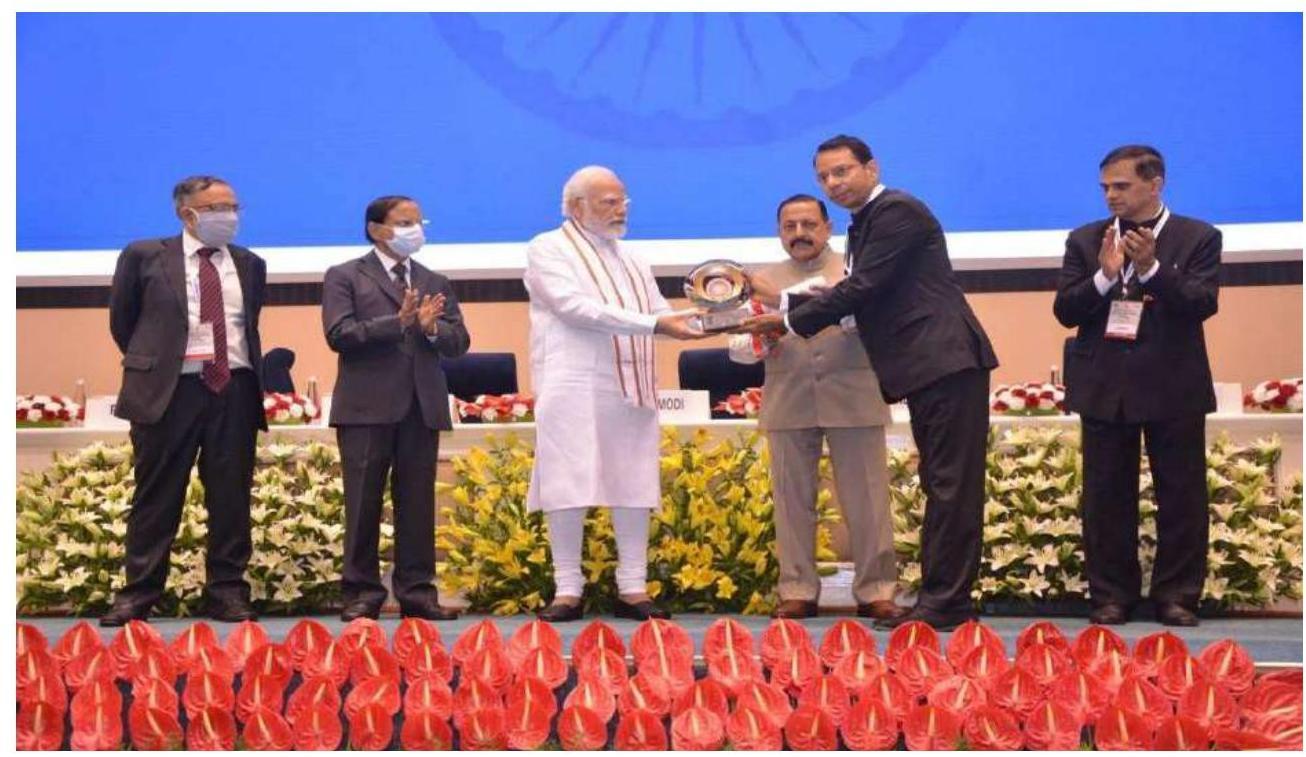
Hon’ble Prime Minister conferring the Prime Minister’s Awards-2021 District Datia, Madhya Pradesh for “Promoting”Jan Bhagidari” or Peoples’participation in Poshan Abhiyan”scheme under Innovation (District)
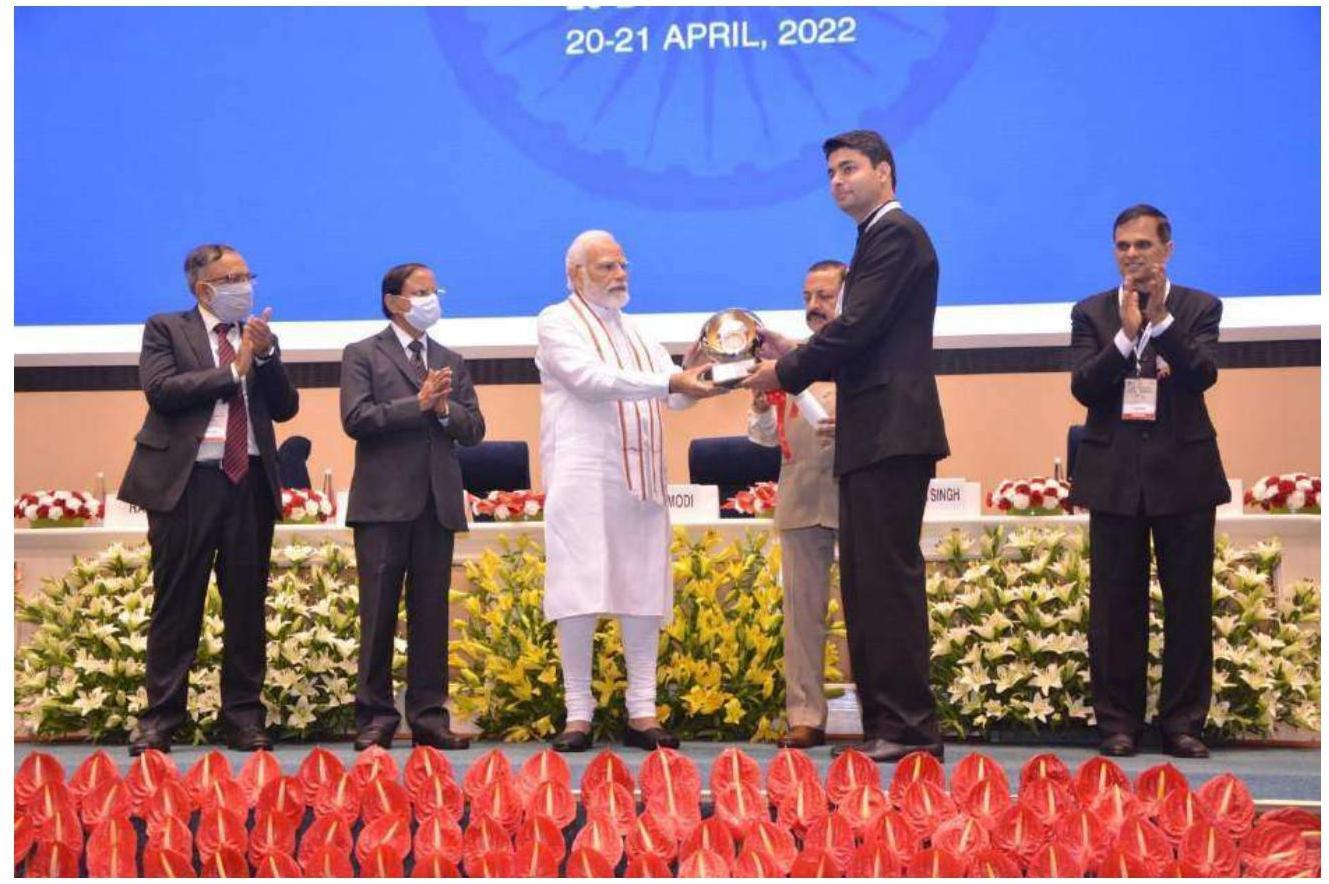
Hon’ble Prime Minister conferring the PrimeMinister’s Awards-2021 to District Churu, Rajasthan for the “Khelo India” scheme
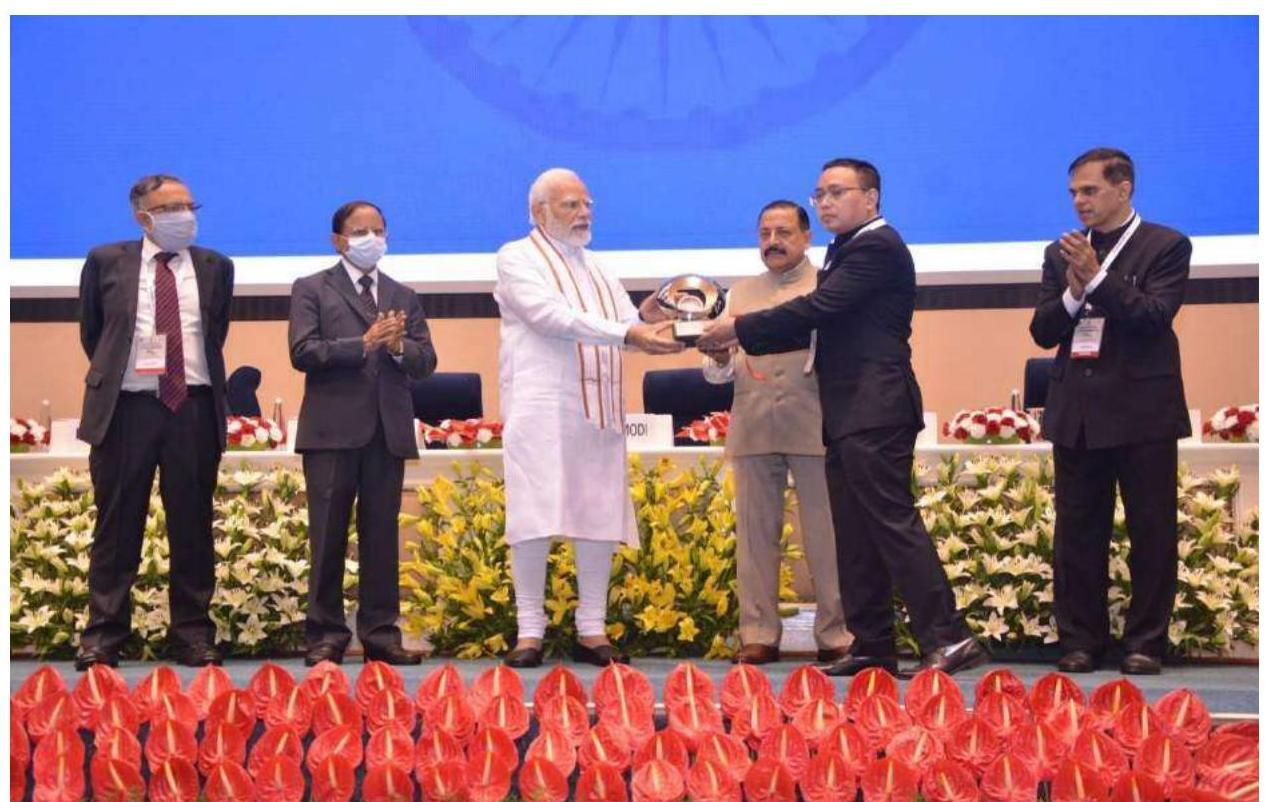
Hon’ble Prime Minister conferring the Prime Minister’s Awards-2021 to District Bishnupur, Manipur for “Khelo India” Scheme
21.2 Prime Minister’s Awards for Excellence in Public Administration’ 2022:
21.2.1 The Scheme for Prime Minister’s Awards for Excellence in Public Administration has been revamped in 2021 with the objective to encourage Constructive Competition, Innovation, Replication and Institutionalization of Best Practices. The PM’s Awards 2022 will be awarded under the following five categories:
i. Promoting Swachh Jal (Clean Jal) through Har Ghar Jal Yojana.
ii. Promoting Swasth Bharat (Healthy Bharat) through Health & Wellness Centres.
iii. Promoting quality education with an equitable and inclusive class room environment through Samagra Shiksha.
iv. Holistic Development through Aspirational District Program-overall progress with special focus on saturation approach.
v. Innovations.
21.2.2 Awards – The total number of awards under the Prime Minister’s Awards for Excellence in Public Administration 2022 is 16 and the Award consists of a (i) trophy, (ii) scroll and (iii) an incentive of Rs. 20 lakh to the awarded District/organization to be utilized for implementation of project/ programme or bridging resource gaps in any area of public welfare. There are two awards each under the category (i) to (iv) mentioned above. Under category (v), a total of eight Awards will be presented, two awards each for Central and State organisations and four awards for Districts.
21.2.3 Applications for Prime Minister’s Awards are received online on a designated portal and are evaluated by three hierarchical Committees. The shortlisting of applications is done by Screening Committees chaired by the Additional Secretary level officers, Expert Committee chaired by Secretary, Department of Administrative Reforms \& Public Grievances and the Empowered Committee chaired by the Cabinet Secretary. The Empowered Committee then makes its recommendations for the consideration of the Hon’ble Prime Minister for final selection of the Awards.
21.2.4 There has been an overwhelming participation in the Prime Minister’s Awards 2022 and a total of 763 Districts of the country, 743 Districts have applied for the Prime Minister’s Awards, with a total of 3240 nominations made and till the last date 2520 completed applications received on the PM Awards portal.
21.2.5 The Prime Minister’s Awards for the year 2021 will be conferred on the Civil Services Day, 2022 function scheduled to be held on 20th -21st April, 2022. The Prime Minister’s Awards, 2019 and 2020 shall be given to the Awardees before the Civil Services Day, 2022.
21.2.6 The Prime Minister’s Awards for the year 2022 will be conferred by the Hon’ble Prime Minister on the Civil Services Day, 2023 function scheduled to be held on 20th -21st April, 2023.
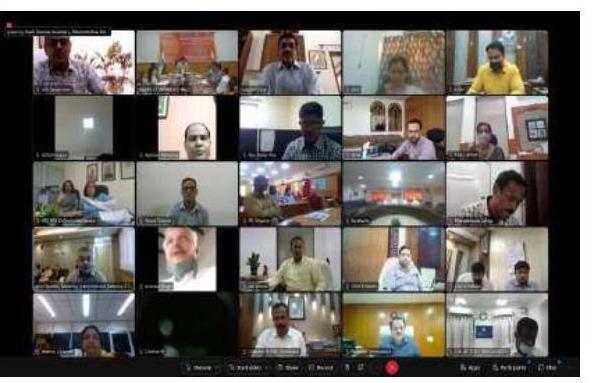
To encourage replication of good governance practices, DARPG is conducting a series of 13 National Good Governance Webinars, one Webinar a month, over the year 2022-23, commencing from $28^{\text {th }}$ April, 2022. The 13 webinars are planned on different themes under the good governance initiatives that have been felicitated with the Prime Minister’s Award for Excellence in Public Administration, since its inception in 2006. The themes selected for the Webinars cover various sectors like health, education, environment, disaster rmanagement, priority programmes, Jal/water management, public grievance redressal, service delivery etc. The awardees present their exemplary work in these National Webinars, the purpose being to highlight the best practices adopted by the award-winning initiatives for replication by other States/Districts. District Collectors, Secretaries in-charge of Administrative Reforms in the States/Union Territories, trainees from national and state level administrative training institutes and senior officials from the concerned line department in theStates/UTs/ Districts are invited to attend the webinars.
21.4 State Collaboration Initiatives
DARPG provides funds to the State Governments under the scheme “State Collaboration Initiatives” with a purpose to build collaboration with State Governments for improving public service delivery. The scheme was revised in 2015-16 to include funding for replication of PM awarded and National e-Governance awarded initiatives.
The objective of the State Collaboration Initiative is to promote and support improvement in public administration for improving service delivery through a programmatic approach which will:
i. Develop collaborative relationships with Central Ministries, States and other stakeholders.
ii. Develop a coherent programme of initiatives which will support and encourage administrative reform and put citizen at centre stage, particularly the poor.
iii. Build capacity at district, state and centre to ensure optimal use of systems and resources.
21.5 National Centre for Good Governance (NCGG)
21.5.1 The National Centre for Good Governance (NCGG) was set up in the year 2014 by the Government of India as an apex-level autonomous institution under the aegis of Ministry of Personnel, Public Grievances and Pensions. The Centre traces its origin to the National Institute of Administrative Research (NIAR), which was set up in 1995 by the Lal Bahadur Shastri National Academy of Administration (LBSNAA). NIAR was subsequently
rechristened and subsumed into NCGG. DARPG is the administrative department for NCGG since 08.11.2017.
21.5.2 NCGG deals with a gamut of public policy and governance issues from local, state to national levels, across all sectors. The Centre is mandated to work in the areas of good governance, policy reforms, capacity building and training of civil servants and technocrats of India and other developing countries. It also works as a think tank.
21.5.3 The affairs of the NCGG are managed under the overall superintendence and direction of the Governing Body, which is headed by the Cabinet Secretary. It has Secretaries of 9 Ministries/ Departments and provision of 5 eminent persons viz. academicians, eminent administrators, specialists, eminent innovators, and heads of reputed institutions as members. The Director General who is the Chief Executive of NCGG acts as the Member-Secretary of the Governing Body. The 3rd Governing Body meeting was held on September 9, 2022. There is a Management Committee headed by the Secretary, DARPG to guide the NCGG in its work to achieve the stated objectives.
21.6 Mandate of NCGG
(i) Promote policy reforms and evidence-based policy making;
(ii) Design and conduct capacity building and training programmes for civil servants;
(iii) Conduct extensive research and analysis to generate practical solutions to governance issues;
(iv) Collaborate with several developing countries to foster the exchange of information, knowledge, ideas, and expertise in governance;
(v) Publish reports, case studies, monographs, and best practices in various important sectors; and
(vi) Tap into modern communication technologies and outreach for citizen-centric governance.
21.7 Activities of the NCGG
Capacity Building Programmes: Over the years, NCGG has created a niche for itself in the field of capacity building and leadership development programmes. The Ministry of External Affairs has identified NCGG as a key institution for developing and conducting highly customized capacity development programmes for the civil servants and technocrats of other developing countries. Similarly, NCGG is asked by the Government of India to organize specialized programmes for domestic civil servants and technocrats. The capacity building programmes conducted by NCGG are in the following two categories:
A. International programmes: During the year, NCGG developed and imparted customized capacity building programmes to 618 civil servants of 3 countries in 19 batches.
i.) Maldives: During the official state visit of Hon’ble Prime Minister Shri Narendra Modi on June $8^{\text {th }}$, 2019, India and Maldives signed a memorandum of understanding (MoU) to implement a Capacity Building Training Programme (CBTP) for 1,000 civil servants of Maldives over the next 5 years. Since then, 22 capacity building
programmes have been conducted including a one-week study visit for a high-level delegation from the Republic of Maldives to India.
During the year 2022-23, 360 civil servants from the Republic of Maldives have received training in 12 batches, taking the total number of civil servants trained up to March 2023 to 635 .
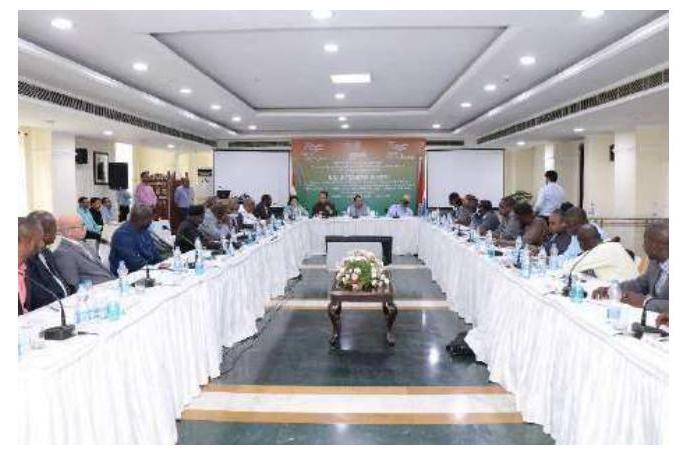
ii.) Bangladesh: In 2013, NCGG was mandated to train 1,500 civil servants of Bangladesh by the Ministry of External Affairs. Following the successful training of 1,500 civil servants, the Ministry of Public Administration, Government of Bangladesh signed an MoU with the National Centre for Good Governance on February $11^{\text {th }}, 2019$, to train another 1,800 civil servants of Bangladesh in next six years. Under this agreement, NCGG has conducted Capacity Building Programmes for 11 batches, so far. During the year 2022-23, six batches comprising 234 civil servants from the Republic of Bangladesh received training, taking the total number of civil servants trained up to March 2023 to 382 .
iii.) Gambia: The National Centre for Good Governance, in collaboration with the Department of Administrative Reforms & Public Grievances and the Ministry of External Affairs, conducted a one-week capacity-building programme on public policy and governance for 24 senior civil servants of Gambia from May $16^{\text {th }}-21^{\text {st }}, 2022$, taking the total number to 49 . The programme was specially designed to equip decisionmakers in Gambia’s civil service, such as Permanent Secretaries, their deputies, Secretaries, and Generals, with the latest knowledge, skills, and tools to create effective public policy in an increasingly complex and interdependent world. The training aimed to promote good governance and sustainable development while providing crosscountry exposure to avoid duplicating efforts.
National programmes: During 2022-23, capacity building programmes for 4 batches of 118 officers from Jammu \& Kashmir and Arunachal Pradesh was organized by the NCGG. Details are as under:
i.) Jammu \& Kashmir
In pursuance of the decisions announced by the Union Minister of State (Independent Charge) Development of North Eastern Region (DoNER), MoS PMO, Personnel, Public
Grievances, Pensions, Atomic Energy and Space, Dr. Jitendra Singh during the Regional Conference on Replication of Good Governance Practices held on $1^{\text {st }}-2^{\text {nd }}$ July, 2021 at Srinagar, an MoU has been signed between J&K Institute of Management, Public Administration \& Rural Development (J\&KIMPARD) and NCGG to train 2,000 senior officers of Jammu \& Kashmir on public policy \& good governance.
During the year 2022-23, 67 civil servants in 2 batches from Jammu \& Kashmir received training at NCGG, taking the total number of civil servants trained up to March, 2023 to 158.
ii.) Arunachal Pradesh
On $18^{\text {th }}$ August 2022, an MoU was signed between the Department of Administrative Reforms \& Public Grievances, Government of India; the Department of Administrative Reforms, Government of Arunachal Pradesh, and the National Centre for Good Governance to train 500 senior officers of the Government of Arunachal Pradesh. During 2022-23, NCGG imparted training to 51 officers of Arunachal Pradesh in 2 batches.
22 National Good Governance Webinar Series (NGGWS)
In the year 2022-2023, the Department of Administrative Reforms and Public Grievances, in collaboration with NCGG, organized a series of 12 National Good Governance webinars. These webinars focused on various themes under the good governance initiative, which had been recognized with the Prime Minister’s Award for Excellence in Public Administration. The webinars encompassed a range of areas such as health, education, environment, disaster management, and social sectors, where states had been awarded for their exceptional work. The primary objective of these webinars was to disseminate best practices and awardwinningachievements as examples for other states to emulate.
Table: PM’s Award-Winning Initiatives Webinar
| S. No. |
Categories/ Initiatives | Date |
|---|---|---|
| 1. | Improving service delivery- Sakala \& e Seva | $28^{\text {th }}$ April, 2022 |
| 2. | Sickle cell anemia control programme (Gujarat) and making medicines affordable (Rajasthan) |
$27^{\text {th }}$ May, 2022 |
| 3. | Aspirational districts program | $24^{\text {th }}$ June, 2022 |
| 4. | Redressal of public grievances | $29^{\text {th }}$ July, 2022 |
| 5. | Environment | $26^{\text {th }}$ August, 2022 |
| 6. | Public service delivery | $30^{\text {th }}$ September, 2022 |
| 7. | ‘Jan Bhagidari’ through Swachh Bharat Mission | $28^{\text {th }}$ October, 2022 |
| 8. | Innovation- Centre \& State | $25^{\text {th }}$ November, 2022 |
| 9. | Har Ghar Jal Yojana | $30^{\text {th }}$ December, 2022 |
| 10. | Innovation- District Level | $27^{\text {th }}$ January, 2023 |
| 11. | Aspirational districts program | $24^{\text {th }}$ February, 2023 |
| 12. | Namami Gange | $31^{\text {st }}$ February, 2023 |
SHRI V. SRINIVAS, SECRETARY OF DARPG & DPPW, PRESIDED OVER THE 6TH NGGWS WEBINAR, WHICH FEATURED MR. LOH KHUM YEAN, PERMANENT SECRETARY OF THE PUBLIC SERVICE DIVISION IN THE GOVERNMENT OF SINGAPORE, AS THE KEYNOTE SPEAKER.
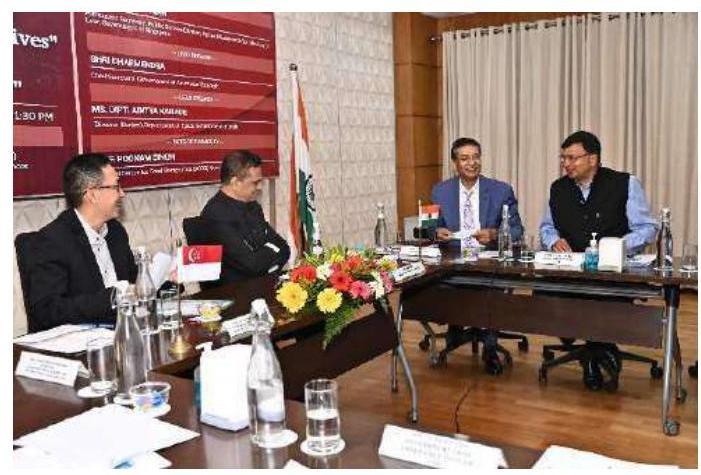
23.1 Books
During 2022-23 NCGG team has been working on a book titled ‘Public Policy and Governance: Theory and Practice in New India’ that comprises 26 articles written by experienced senior administrators, academicians, researchers, and experts. It encompasses a wealth of knowledge, wisdom, and experience from different fields.
The Centre also published a book on ‘Good Governance Practices in a Pandemic’ to assess, review, and catalog the practices employed by national, state and local level officials to tacklethe health crisis.
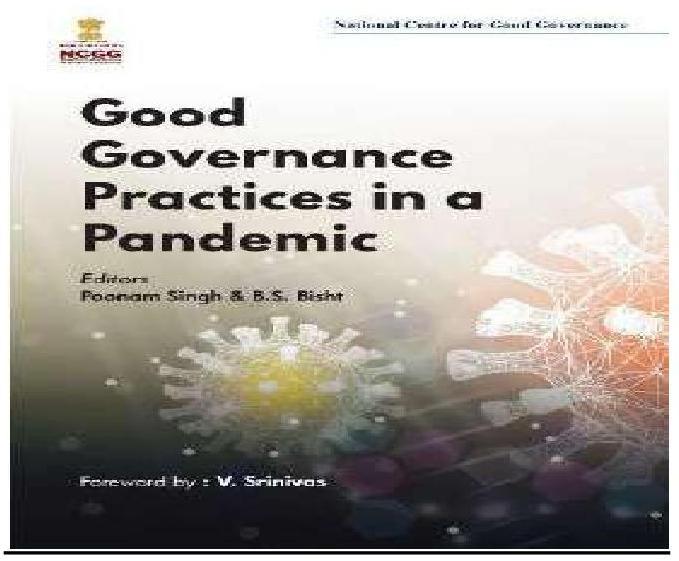
24. Collaborations
NCGG places great importance on collaboration to facilitate the exchange of information, knowledge, ideas, and expertise in the areas of governance, reforms, capacity building, change management, and more. To address issues related to public policy and governance, NCGG has signed MoUs with various countries and institutes.
i.) On July 8th, 2021, the Department of Administrative Reforms \& Public Grievances of the Government of India and the Public Service Commission of the Office of the President of the Republic of Gambia signed an MoU for a duration of 3 years. The primary goal of this agreement is to encourage mutual collaboration in enhancing
personnel administration and governance reforms in the public sectors of both countries.
ii.) On January 3rd, 2022, the Centre for Innovations in Public Systems (CIPS) and the National Centre for Good Governance (NCGG) signed an MoU for a duration of 3 years. The purpose of this agreement is to promote intellectual interaction between NCGG and CIPS through various initiatives such as exchanging knowledge and sharing innovative models that have the potential for replication, hosting and visiting delegations, collaborating on joint assignments, sharing infrastructure facilities, and exchanging relevant publications,
iii.) On March 11th, 2022, the IC Centre for Governance, located in New Delhi, and the National Centre for Good Governance (NCGG) signed an MoU for a duration of 5 years. This agreement pertains to areas such as creating case studies on the best practices in administration and disseminating them for wider adoption and replication, as well as conducting research studies on administrative reforms with the aim of enhancing the qualityof public governance.
iv.) On July 29th, 2021, the Indian Institute of Management, Visakhapatnam, and the National Centre for Good Governance (NCGG) signed an MoU for a duration of 5 years. The purpose of this agreement is to jointly explore academic title granting programmes, collaborate on resource sharing, involve faculty experts in joint consulting and research projects as per their respective institutional guidelines, promote and encourage joint research activities in fields of mutual interest, collaborate on joint activities, and facilitate the exchangeof academic faculty and researchers.
v.) On August 9th, 2021, the Indian Institute of Management, Indore, and the National Centre for Good Governance (NCGG) signed an MoU for a duration of 3 years. The objective of this agreement is to promote and encourage the exchange of academic staff and students, explore degree-granting programmes, collaborate and share resources, involve faculty experts in joint consulting and research projects as per the guidelines of both institutions, design and conduct joint training programmes in public administration and good governance, promote and encourage joint research activities in fields of mutual interest, facilitate collaboration in joint social initiatives, policy formulation, Good Governance Index ranking, and exchange research and educational data to be used for education and training purposes.
vi.) On July 1st, 2021, the J&K Institute of Management, Public Administration \& Rural Development (J\&KIMPARD), under the Government of Jammu \& Kashmir, and the National Centre for Good Governance (NCGG) signed an MoU for a duration of 5 years. The purpose of this agreement is to establish, maintain and enhance academic and intellectual interaction between the two institutions. The MoU also includes training activities for 2000 senior officials, aimed at promoting excellence in capacity building programmes and practices related to good governance, the General Financial Rules (GFR) of 2017, public-private partnerships (PPP), and e-procurement, with a particular focus on GeM. This training is intended to enhance the mid-career training program in line with the IAS training program of the Department of Personnel and Training (DoPT), Government of India.
vii.) On January 17th, 2022, the National Institute of Rural Development and Panchayati Raj (NIRD&PR) in Hyderabad, and the National Centre for Good Governance (NCGG) signed an MoU for a period of 3 years. The objective of this agreement is to share experiences and gain synergy for the effective implementation and management of development programs in the area of service delivery and good governance. The collaboration also includes capacity building programmes, joint projects, externally aided projects, exchange of resource persons, hosting and visiting delegations, sharing of infrastructure facilities, and exchange of relevant publications.
CHAPTER 22
Public Grievances
The Public Grievances Division is responsible for issuing policy guidelines and coordinating & monitoring of issues regarding redress of public grievances for the Central Government. In accordance with federal principle of governance, the grievances relating to States are forwarded to concerned State Government for appropriate action. To provide a more responsive and citizen-centric governance, the PG Division coordinates efforts to formulate and operationalize the Citizen’s Charters of various Ministries/Departments and State and UT Governments. The PG Division also handles Sevottam which is a part of a citizen-centric quality management framework for better service delivery.
22.1 The Allocation of Business Rules, 1961, allocates to DARPG inter alia, the responsibility for Policy, Coordination and Monitoring of issues relating to (a) Redress of Public Grievances in general and (b) Grievances pertaining to Central Government Agencies, in particular. The Public Grievance Division is responsible for this activity since December 1987. From 1997, the Division has also been made responsible for several Citizen-Centric Initiatives under the platform of ‘Responsive Government’. These include Citizens’ Charter, and Sevottam, for bringing improvement in public service delivery on a continuous basis.
22.2 The management of Public Grievances today envisages reduction in grievances, by bringing continuous improvement in Public Service Delivery and in the Public grievance redressal system.
22.3 The Public Grievances Division has undertaken various activities during the year, some of which are on-going activities from the previous years, to improve the grievances redressal mechanism and to provide citizen-centric governance.
22.3.1 CPGRAMS – An online system for grievance redress, called the ‘Centralized Public Grievance Redress and Monitoring System’ (CPGRAMS) has evolved since 2007. CPGRAMS facilitates forwarding of public grievances received online from the citizens to both the Central Government Ministries / Departments / Organisations as well as the State Governments concerned. The inflow of these Centre and State related grievances are in two forms (i) online registered grievances through CPGRAMS and (ii) offline grievances received through post. The grievances received through post are digitized, uploaded on CPGRAMS and forwarded online through the System as well as by post to the Central Ministries/Departments / Organisations / State Government concerned. At present, the Department has undertaken CPGRAMS Reforms in the top grievance receiving Ministries / Departments. The CPGRAMS reforms envisages to ensure user friendly lodging of grievance by a citizen and enable navigation of the grievance to reach the field office responsible for resolution of the same. CPGRAMS Reforms will streamline grievance redressal mechanism so that the grievances reach the rightful redressal Office, surpassing the line offices. The broader salient features of the CPGRAMS Reforms 7.0 are that it is citizen friendly as there is a questionnaire guided registration process. Besides, there is a provision of lodging a grievance which will be automatically forwarded to field level directly. The system has also improved grievance redress time and lodging of grievance is done through drop down menus.
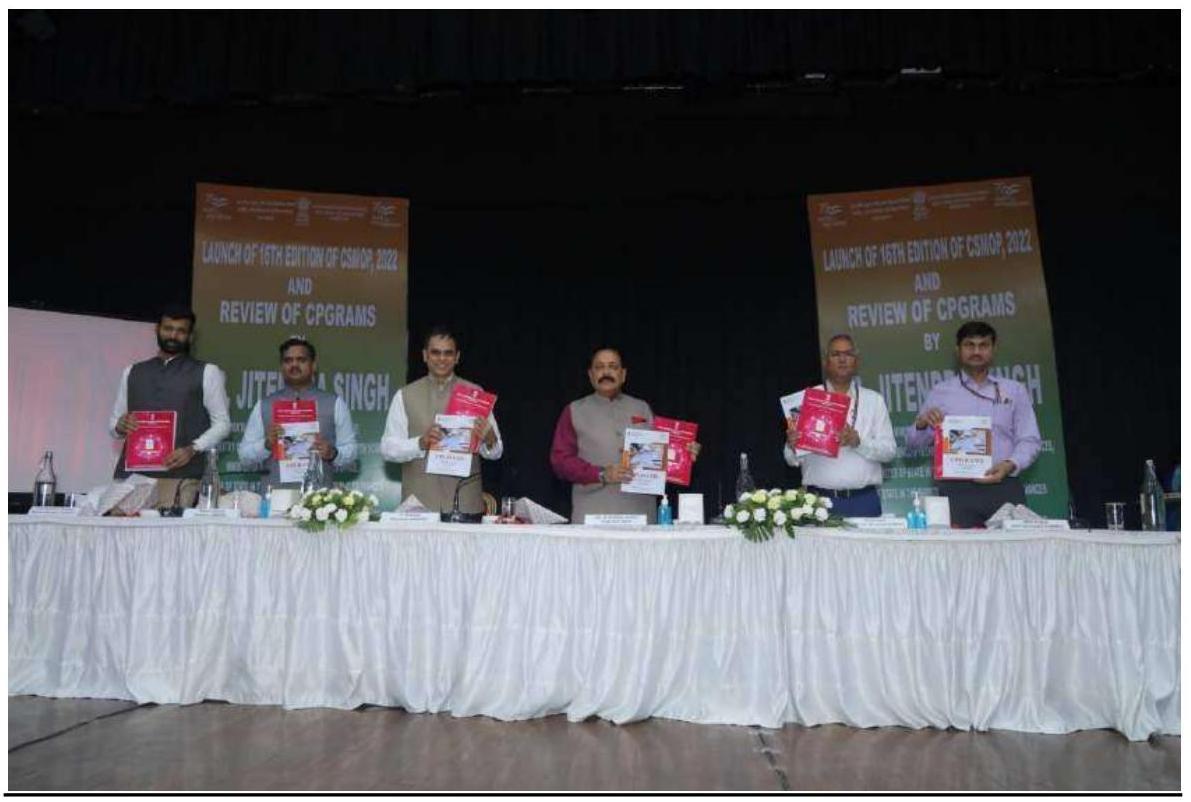
Launch of CPGRAMS Monthly Report – July 2022 by Hon’ble MOS at CSOI, Delhi
22.3.2 CPGRAMS Reformed version 7.0 was launched on 25.09 .2019 for auto routing of grievances to last mile, wherein it was implemented in Department of Post. Thereafter, it was implemented in Department of Telecommunications and Department of Financial Services (Banking & Insurance Division). Now, CPGRAMS Reformed Version 7.0 has been implemented in all Ministries/Departments of Government of India.
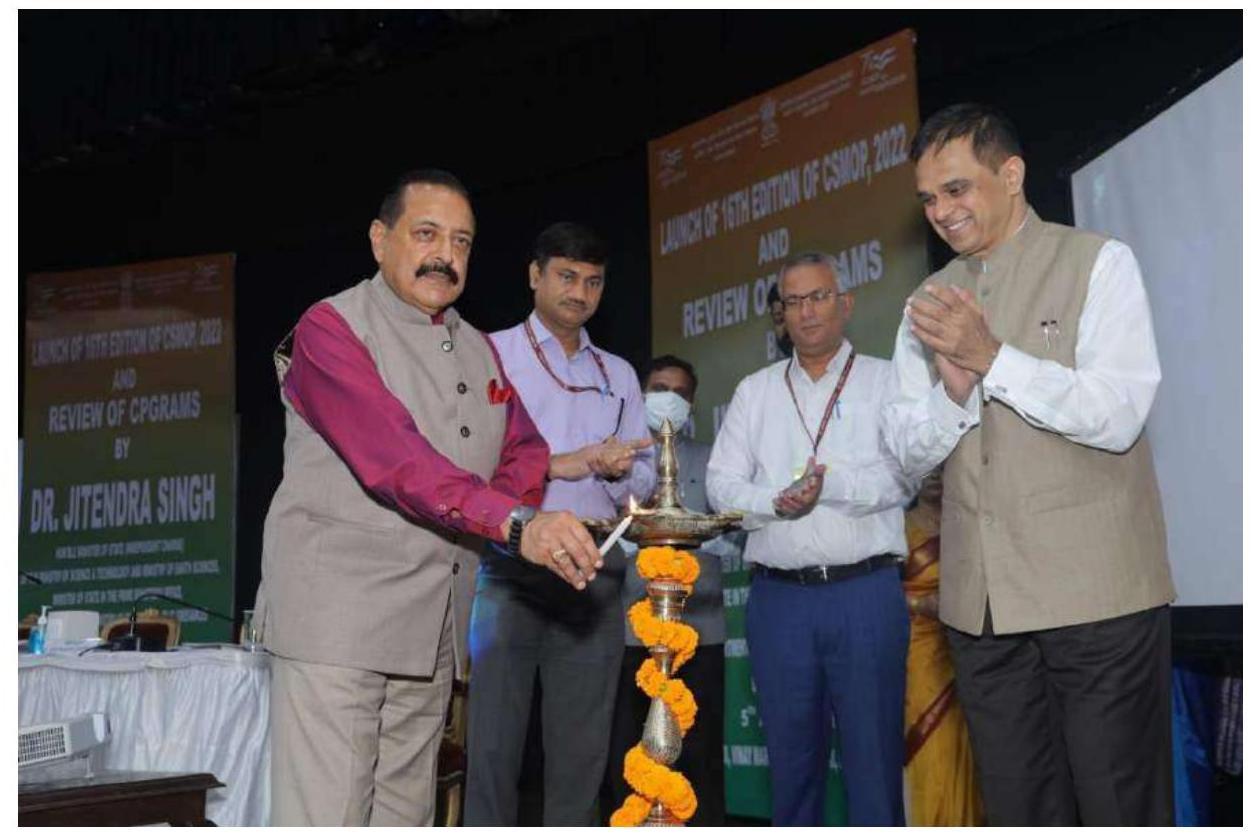
22.3.3 Citizens can use a Mobile App for lodging of public grievances and the action Status can also be viewed on the mobile itself. This mobile app is integrated with Unified Mobile Application for New-age Governance (UMANG). The app is available in both Android and iOS versions. A new mobile app called My Grievance is also available which is independently for CPGRAMS.
22.3.4 Public grievance mechanism of PMO, the President’s Secretariat, the Directorate of Public Grievances (Cabinet Secretariat), Department of Administrative Reforms & Public Grievances (DARPG) and the Pensioners’ portal has been duly integrated through CPGRAMS thus enabling grievances lodged to any of these entities to be transferred to the Central Ministries / Departments and State Governments online through CPGRAMS. The CPGRAMS interlinks 90 Central Ministries/Departments / Organisations and 36 States /UTs. There are more than 76,000 sub-ordinate users listed on CPGRAMS.
Year wise Receipts / Disposal graph on grievances received on CPGRAMS Receipt / Disposal graph of Total receipts in CPGRAMS, as on 31.12.2022
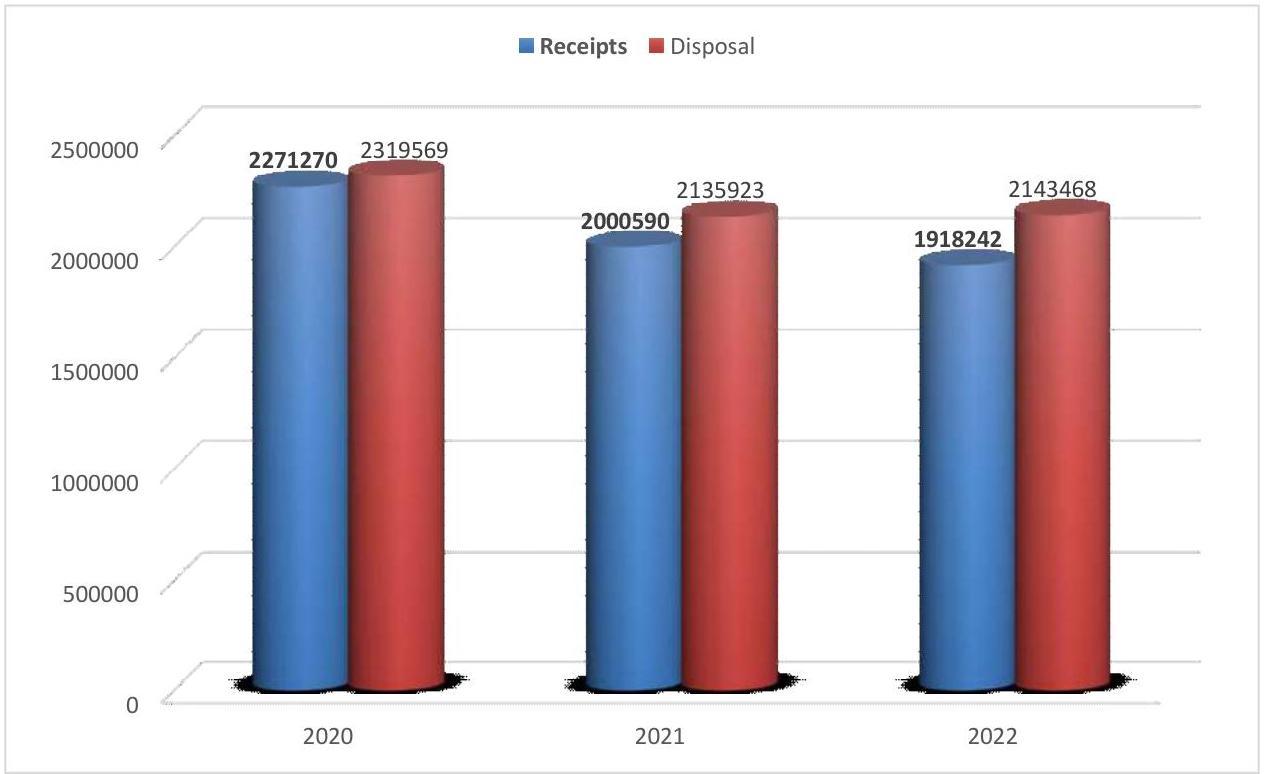
Receipt / Disposal graph of GOI Organizations in CPGRAMS, as on 31.12.2021
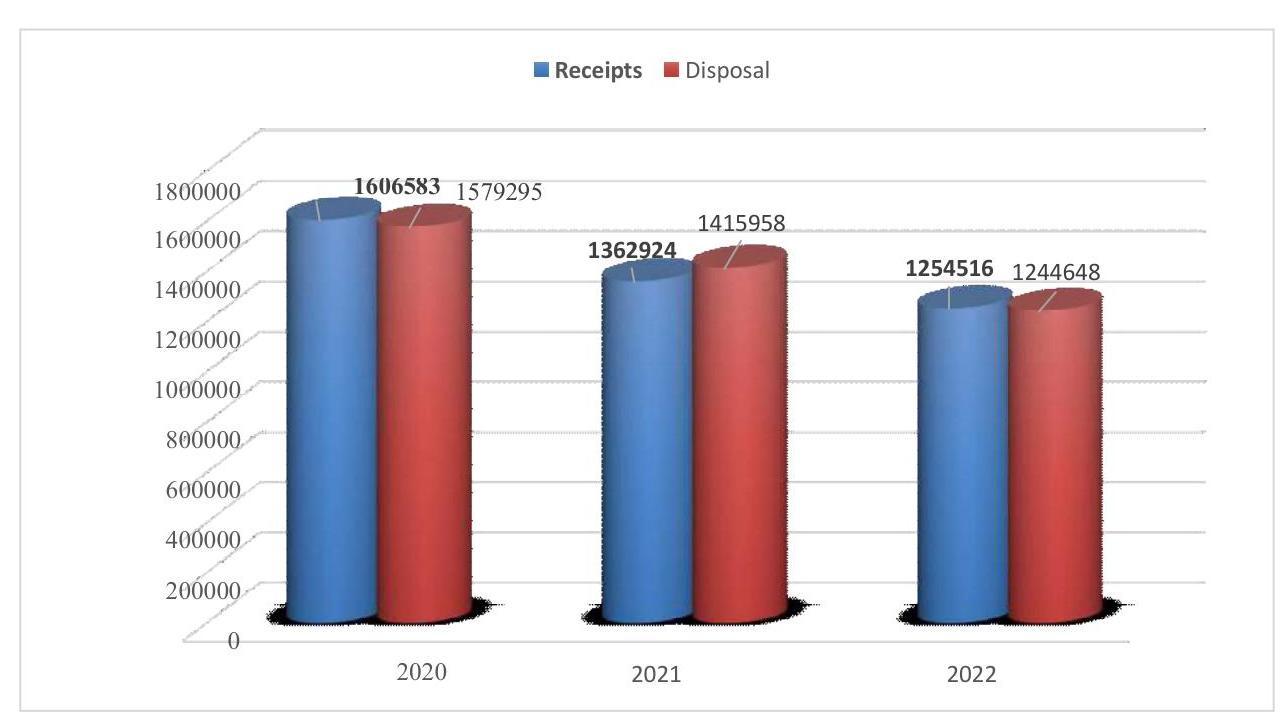
Total No of Organizations registered in CPGRAMS : 95244
Total Ministry / Departments : 90
Total / States / UTs 36
Details of Grievances Received in DARPG during 01.01.2022 to 31.12.2022
Total Receipts : 52220
Received by Post / Physical : 3080
Received online : 49140
Forwarded to States : 25531
Forwarded to Centre : 24447
Receipt / Disposal graph of grievances received in States on CPGRAMS, as on 31.12.2021
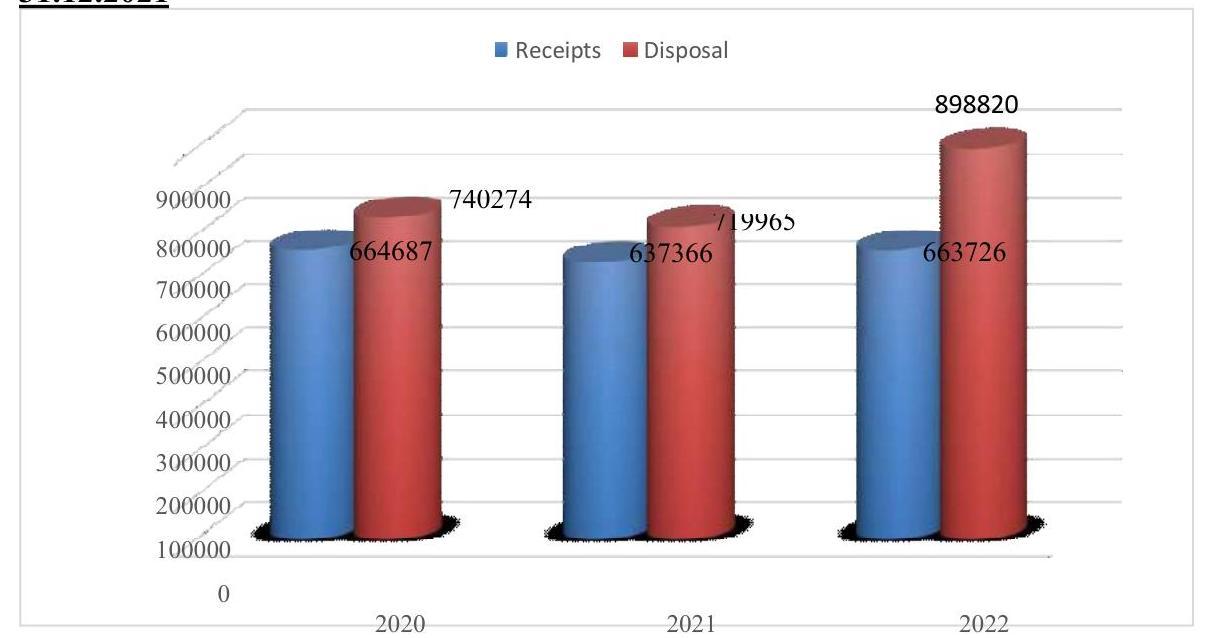
22.3.5 During the year, the Division has extensively used the System to forward public grievances to the State Governments. The inflow of State related grievances is in two forms
(i) through the CPGRAMS and (ii) through post. The grievances received by post are digitized and sent both through the System as well as by post to the State Government concerned. During 2022 a total of 25531 grievances have been sent to State Governments by Department of AR&PG.
22.3.6 DARPG had undertaken One Nation – One Portal Digital platform across Govt. of India and State Governments for seamless digital processing of Grievances adopting a whole of Government approach. As on date, total 34 States / UTs have been integrated with CPGRAMS
22.3.7 As a pioneer of district level integration with CPGRAMS, the JK-IGRAMS integrates the grievances from the Centralized Public Grievance Redress and Monitoring System (CPGRAMS) at the top with the last mile district level offices in the UT of Jammu \& Kashmir at the bottom. Earlier only the Jammu \& Kashmir Secretariat Departments and their Directorates were linked. However, now the Offices at District level have been linked and mapping up to Tehsil level and Block level has been done. The Union Territory of J\&K consists of 20 Districts and all these 20 Districts of the UT of Jammu \& Kashmir have been mapped and integrated with the grievance redressal portal of JK-IGRAMS as well as the Central Government grievance redressal portal of CPGRAMS
22.3.8 The Department holds regular meetings to monitor and review the pendency of grievances and for expediting action on them.
Over the years CPGRAMS has become more responsive with high rates of disposal and progressive reduction in average disposal time. In this regard a circular No.S-15/21/2021-O/o DS(PG)-DARPG(7085) dated 27.07.2022 was issued reducing the maximum time limit for disposal of grievances from existing 45 days to 30 days.
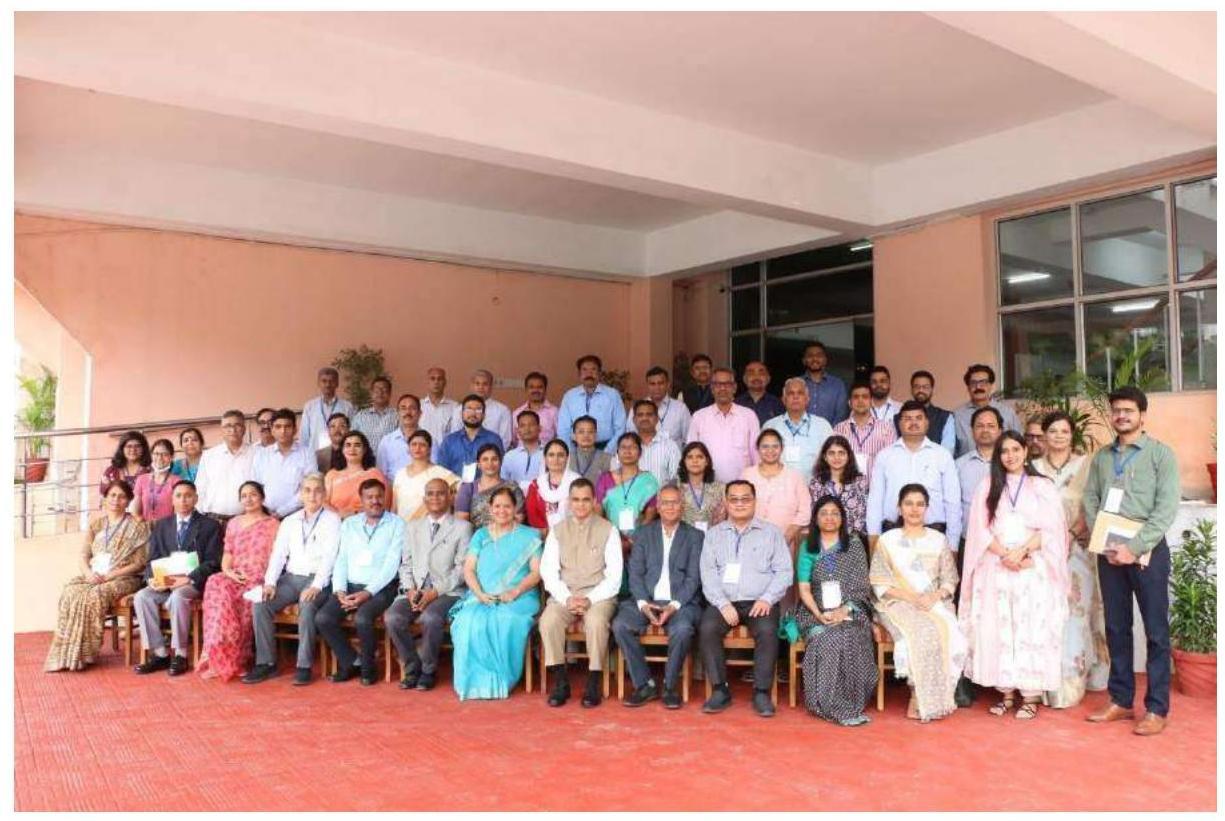
(Training of States / UTs officers held at HIPA, Gurgoan)
Introduction of an Appeal Mechanism/functionality in CPGRAMS –
The Appeal Mechanism / functionality in CPGRAMS in line with the Department related Parliamentary standing Committee Recommendations in its $100^{\text {th }}$ Report has been introduced. The recommendations were communicated to all Central Ministries / Departments with the request to nominate a Nodal (Appellate) authority. The Appeal provision has been made for redressal of dis-satisfied grievances identified through a mandatory feedback rating to be given by the Citizen on disposal of the grievance by the Nodal Grievance Officers.
22.3.9 A separate workflow and functionality for escalation of grievances to appeal authorities in CPGRAMS has been operationalized by the Department of Administrative Reforms and Public Grievances. The time line for resolution of an Appeal by the Nodal Appellate Authority is 30 days of receipt of the same. The Appellate Authority to whom a dis- satisfied Complainant can raise / escalate a public grievance is one level above the existing designated Nodal Grievance Officers. As of now the details of the nominated Nodal Appellate Authorities of 84 Ministries / Departments are available on the website at pgportal.gov.in. The Appeal Module is being operationalized by NIC in two inter-faces.
22.3.10 In the Citizens Interface, a complainant can file an appeal if he / she is not satisfied with the redress / reply of the grievance. Once the grievance is closed / disposed of, the complainant can view the details of final disposal which includes the feedback section and the complainant needs to mandatorily provide the feedback on the redressal of his/her grievance. The option of feedback is also available in the dashboard of the complainant. Five ratings will be available to the Citizen namely, Excellent, Very Good, Good, Average and Poor. It is under ‘Poor’ rating only, the option to file an appeal will be enabled to the petitioner. The petitioner will be asked whether he/she wants to raise their concern with Nodal Appellate Authority and if ‘Yes’ option is pressed then the ‘Reason for Appeal’ would be sought from the Complainant. After providing of the requisite information the complainant can successfully file an appeal. The Status of the Appeal can also be tracked by the petitioner with the grievance registration number.
The motive is to build trust with the citizen through effective and speedy redress of the grievances which would pave the way for good governance.
22.3.11 Operationalisation of Feedback Call Centre:-
DARPG has setup a permanent Feedback call Centre w.e.f. 01.7.2022. Call Centre is taking direct feedbacks from the citizens regarding the resolution provided to their grievances by Ministries / Departments and the States / UTs. The call centre also assist the citizen in filing appeal if they are not satisfied with the disposal. The calls are made in 12 different languages (English, Hindi, Gujarati, Marathi, Bangala, Telgu, Assamese, Odiya, Tamil, Malayalam, Kannada & Punjabi). Till December, 2022 total 2.51 lakh successful calls were made to the Citizen.
22.3.12 Introduction of Artificial Intelligence (AI) / Machine Learning (ML) tools:-
A MoU have been signed with IIT, Kanpur to Introduction of Artificial Intelligence (AI) / Machine Learning (ML) tools in the system in partnership with IIT, Kanpur to categories grievances and assess quality of resolution. An AI / ML bashed dashboard is also being developed with IIT Kanpur, which will enable deeper analysis of CPGRAMS grievances by Ministries / Departments to help them bring about systemic change and policy introversions.
22.3.13 Redressal of Public Grievances during Special Campaign and GoodGovernance Week:-
A special campaign 2.0 was launched on disposal of pending matters including Public Grievances and cleanliness drive was undertaken from 2nd October to $31^{\text {st }}$ October, 2022 in every Ministry / Department of government of India including their attached / subordinate offices and autonomous organizations across the country and abroad. During the Special Campaign total 436855 Grievances were addressed.
Further, Government of India celebrated Good Governance Week (GGW) under the auspices of Azadi Ka Amrit Mahotsav during 20-25 December, 2022. Hallmark event of GGW 2022 was a weeklong Nation-wide campaign ‘Prashasan Gaon Ki Ore 2022’ from December $19^{\text {th }}-24^{\text {th }}, 2022$, aimed at resolving public grievances and delivery of services to the people at their doorstep. The campaign witnessed redressal of over 54 lakh public grievances, disposal of over 314 lakh service delivery applications
22.3.14 Setting of Data Strategy Unit (DSU) in DARPG:-
DARPG has engaged NISG through contact dated 24.12.2021 for setting up a Data Strategy Unit (DSU) initially comprising 7 members. The PMU is expected to perform all the activities required for DARPG, ranging from software development, managing front end, backend, API integration, data analysis data visualisation, develop AI/ML algorithms & scripts and management of CPGRAMS \& other IT applications of DARPG including eOffice.
22.3.15 leverage strength of Common Service Centres (CSC)
CPGRAMS has been integrated with Common Service Centres (CSC) from $7^{\text {th }}$ June, 2022 to leverage its strength to take the facility of CPGRAMS to rural population. In 2022 (June to December) a total of 17,717 grievances have been registered through the Common service Centres.
22.3.16 Capacity building of stakeholders for effective redressal of grievance:- Capacity building of stakeholders for effective redressal of grievance has been undertaken under the Sevottam Scheme. The training module has been developed and training sessions have been conducted through ISTM.
22.3.16.1 Total four Trainings of Trainers Programmes on Public Grievance handling and CPGRAMS 7.0, to sensitize the grievance resolution officers of Ministries / Departments in Government of India, were conducted by ISTM. Total of 106 officers participated in these programmes.
22.3.16.2 Further, more than 400 modules of Capacity building programmes conducted under Sevottam by state ATIs. Presently, 21 states / UTs are on-boarded on Sevottam.
22.3.16.3 A One day National Seminar/workshop on Sevottam on 16.12.2022 was organized, wherein ATIs of States / UTs had participated. The objective of the workshop was to create synergy amonst all ATI’s for streamling the curriculum and pedagogy as also the training modules for capacity building of Grievance officers of States / UTs under the Sevottam Schme.
22.4 PUBLIC SERVICE DELIVERY
22.4.1 One of the citizen-centric initiatives that were taken by this Department was to develop a Quality Management System (QMS) framework called ‘Sevottam’ for bringing
excellence in service delivery by Government organizations. This has institutionalized an assessment-improvement framework for improving the quality of service delivery on a continuous basis through the involvement of Ministries / Departments and citizens. Sevottam comprises of 3 modules in relation to a public service organization viz., (a) Citizens’/ Clients’ Charter that specifies the service delivery standards (b) Grievance Redress Mechanism that gets activated if the service delivery is not as per standards in the charter, and (c) Service Delivery Capability of the organization to delivery service as per standards in the charter.
22.4.2 As part of the Strategic Plan for Capability Building towards implementing Sevottam Quality Management System (QMS), a Scheme for Strengthening of Administrative Training Institutes (ATIs) was implemented during the $12^{\text {th }}$ Five Year Plan 2012-2017 in Govt. approved Training Institutions in 10 States. State ATIs which are being funded under the Scheme are Punjab, Haryana, Rajasthan, NCT Delhi, Karnataka, Tamil Nadu, Uttar Pradesh, Madhya Pradesh, Himachal Pradesh and Jharkhand. The Scheme has resulted in capacity building of the ATI by enabling conducting of training programmes and workshops by the ATIs for sensitizing the officers of the State Government for implementation of Citizens’ Charter and Grievance Redress Mechanism. Under the Scheme, an amount up to Rs. 20 lakh can be released annually to the ATIs based on the UC received for the funds released during the previous years and the performance of the concerned ATIs during the previous yea(s) in which funds have been released.
During the year 2022 total 14 States/UTs have been released Rs. 20 Lakhs each under Sevottam Scheme.
22.5 CITIZENS’/ CLIENTS’ CHARTERS
22.5.1 In view of decision taken in Conference of Chief Ministers held on $24^{\text {th }}$ May, 1997 presided by Hon’ble Prime Minister, formulation of Citizen’s Charter by Central & State Governments began. The process started with sectors having large public interface (e.g. Railways, Telecom, Posts, Public Distribution Systems). Charters were required to include (i) standards of service (ii) time limits for public service delivery (iii) avenues for grievance redress. Guidelines for formulating the Charters as well as a list of do’s and don’ts were communicated to various government departments / Organisations by DARPG to enable them to bring out focused and effective charters. A comprehensive Website of Citizens’ Charter, www.goicharters.nic.in was launched by the DARPG on 31 May, 2002 which apart from guidelines contains the Citizens’ Charters existing in Ministries / Departments / States / UTs / Organisations.
CHAPTER 23
ORGANISATION AND METHODS DIVISION
Mandate
- Formulation and simplification of office procedures.
- Publication and updating of the paper based Central Secretariat Manual of Office Procedures (CSMOP), electronic based Central Secretariat Manual of e-Office Procedure (CSMeOP).
- Aiding and advising the Central Ministries / Departments and States / UTs Government on O&M aspects.
Central Secretariat Manual of Office Procedure (CSMOP)
23.1 The Department of Administrative Reforms and Public Grievances brought out the Sixteenth Edition of the Central Secretariat Manual of Office Procedure, 2022 (CSMOP, 2022) on $5^{\text {th }}$ August, 2022. Hindi version was also released on 31.10.2022. In this edition of the Manual the Procedures laid down in the Central Secretariat Manual of Office Procedure, 2022 was updated in light of advances made in digital governance. The salient features of CSMOP 2022 are as under:
- The Manual have 16 Chapters. Definitions have been categorized as Glossary and given at the end of the CSMOP 2022.
- Decision making in Government, Knowledge Management, and e-Office Digitization Framework are three new Chapters.
- Provision for officers of the rank of DS and above to obtain Virtual Private Network(VPN).
- Provision for officers of the rank of ASO and above to obtain Digital Signature Certificate (DSC).
- The e-office procedure has been incorporated in the form of e-boxes in the chapters wherever applicable.
23.2 Increasing Efficiency in Decision making
Efficient decision making is fundamental to a responsive and accountable governance. The Central Secretariat Manual of Office Procedure (CSMOP) has been a guiding framework for effective functioning of the Central Secretariat offices. The Sixteenth edition of the Manual i.e. CSMOP-2022 was brought out with the aim of bringing simplicity, efficiency and transparency in government processes and procedures. With a view to increase efficiency in decision making in Central Secretariat it was decided to reiterate the provisions of CSMOP. Accordingly a workshop was 261 organized by DARPG under the Chairpersonship of Cabinet Secretary on 23 December, 2022. The key action points emanating from the workshop were as under:
- To make implementation procedures thorough and efficient by removing mundane procedures and older norms
- Comprehensive review for delayering and delegation for greater ownership and decision making to lower order of offices.
- Parallel/simultaneous physical and digital should be discouraged as it defeats the whole purpose of digitization.
- Optimal use of digital tools including e-Office for faster decision making through new features on e-office 7.0 like multiple screens usage, inter departmental movement of files, usage in regional language etc.
- Effective use of Desk Officer System.
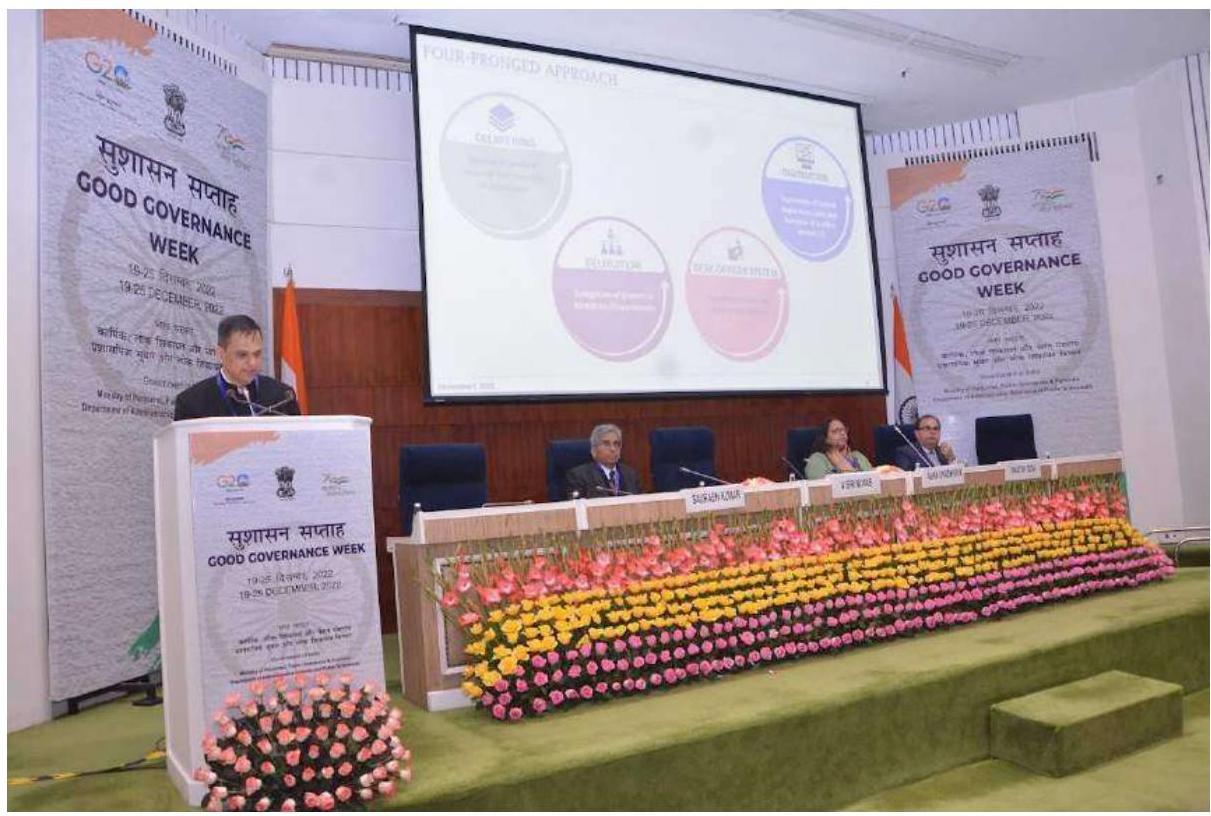
Information Sharing Session by Secretary DARPG on ‘Increasing Efficiency in Decision Making’ – Good Governance Week 22
The Government’s campaign for Increasing Efficiency in Decision Making was adopted in almost all Ministries / Departments of the Central Secretariat. The campaign represents one of the most complicated and far-reaching administrative reforms witnessed in the Central Secretariat. The initiative for increasing efficiency in decision making has transformed work culture, reduced hierarchies and resulted in significant adoption of new technology. It has also enabled responsive communication and enhanced efficiency in processing receipts. Reduction in paper consumption was also witnessed.
23.3 Special Campaign 2.0 on Disposal of Pendency ( $2^{\text {nd }}$ October, 2022 to $31^{\text {st }}$ October, 2022)
The Special Campaign 2.0 on Swachhata and reducing pendency in Government offices was organized from 2nd-31st October 2022 in all Central Ministries / Departments and their attached / subordinate offices / PSUs / autonomous organizations. DARPG issued the guidelines and coordinated the campaign across the Central Ministries and their offices through real-time monitoring on a dedicated portal www.pgportal.gov.in/scdpm22. A total of $1,01,582$ Government office sites participated in this campaign. 89.47 lac sq. ft space was cleared from scrap and outlived records and INR 370.83 Cr was earned
The government offices having maximum citizen centricity were given special attention. Department of Posts has conducted the cleanliness campaign in 24,000 Post Offices, Ministry of Railways has covered 10,716 sites covering all railway stations, Ministry of Shipping has covered all major ports, Ministry of Road Transport & Highways conducted cleanliness drive at about 780 Toll Plazas and way side amenities. 1170 Krishi Vigyan Kendras, 613 Pradhan Mantri Kisan Samriddhi Kendras (PMKSKs) and 441 Indian Missions and Posts abroad also participated in the Campaign. Government offices at remote locations such as Dras, Changthang (Ladakh), Anantnag (J\&K), Port Blair participated in the Special Campaign 2.0. About 300 best practices emerged during the Campaign which were documented and disseminated
Special Campaign 2.0 was 17 times larger in terms of Campaign sites, 7 times larger in terms of Space Freed and 6 times larger in terms of Revenue Earned than the Special Campaign of 2021. The Campaign was successful in institutionalizing Swachhata and reducing pendency in government offices. About 4.56 lakh public grievances were disposed of and about 37.27 lakh files which had completed their retention schedule were weeded out during the campaign. Several Ministries were able to achieve $100 %$ disposal against the target during the campaign.
The monitoring mechanism instituted during the special campaign 2.0 is being continued and Ministries / Departments are being monitored against pendency on monthly basis.
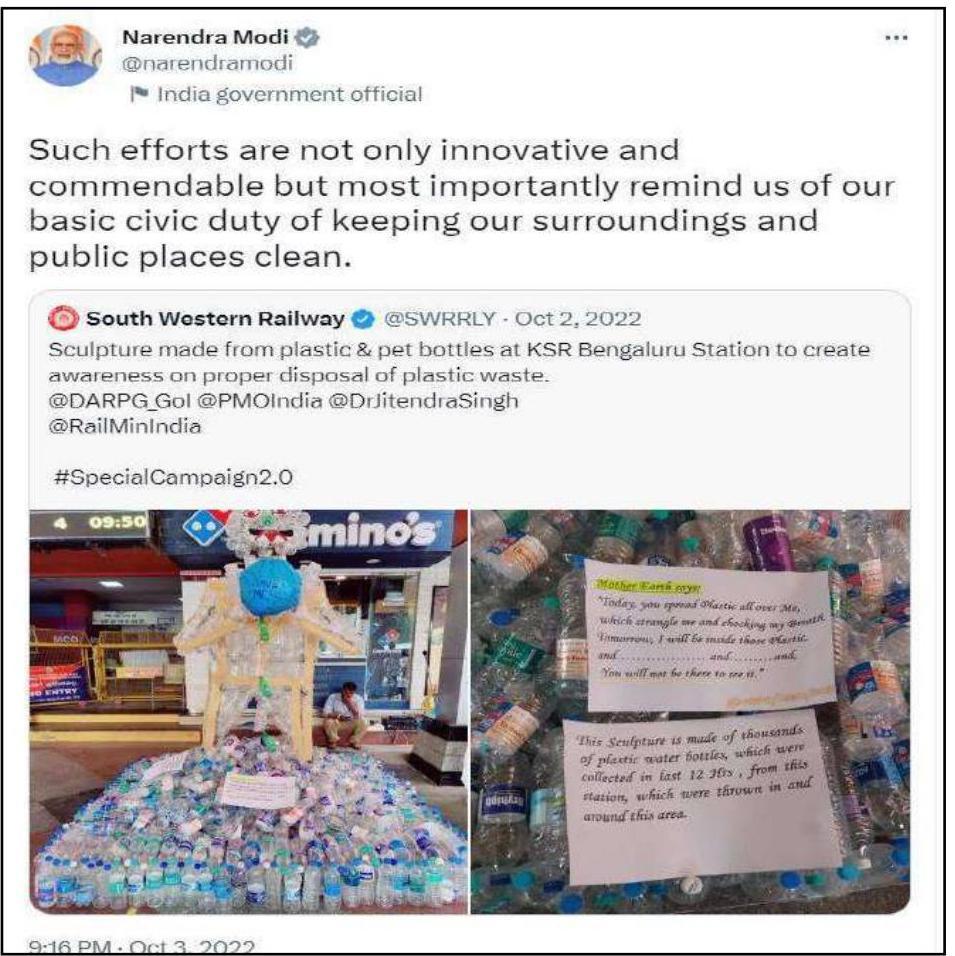
Hon’ble PM tweeted on best practice under Special Campaign 2.0
Before – After Pictures
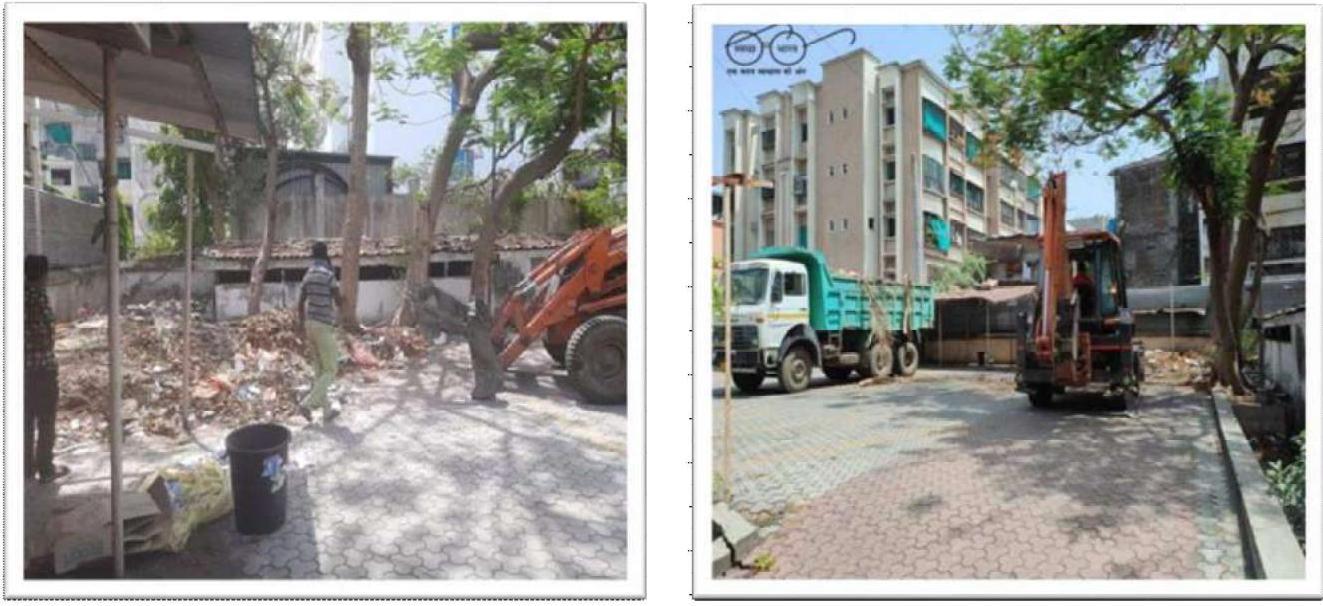
Before
After
Department of Financial Services; Cleaning Activity done under Cleanliness Campaign, LIC Nagpur Divisional Office
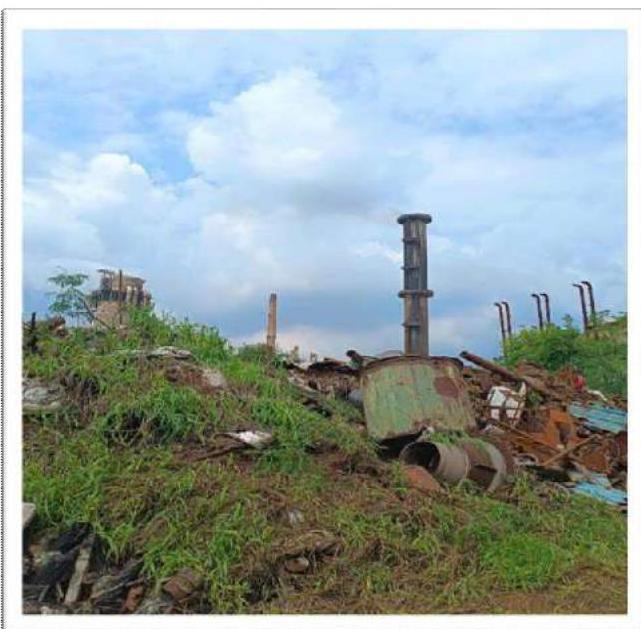
Before
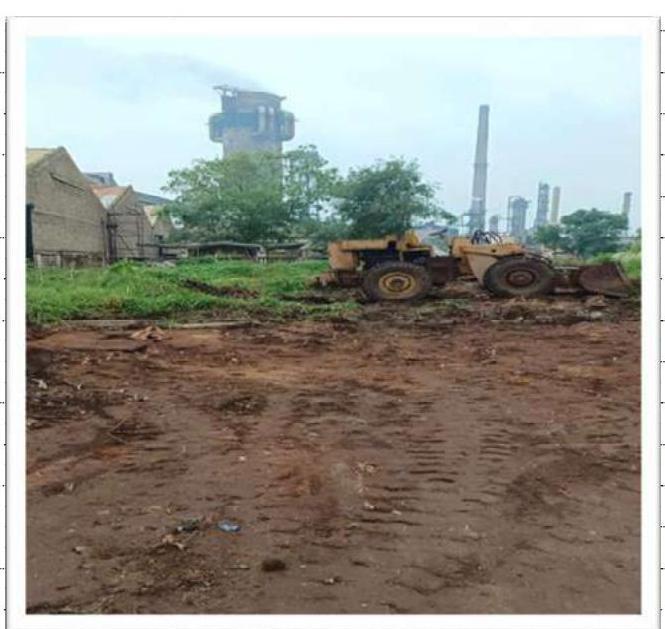
After
Department of Chemicals and Fertilizers; Removal of 10 MT of metal scrap at Madras Fertilizers
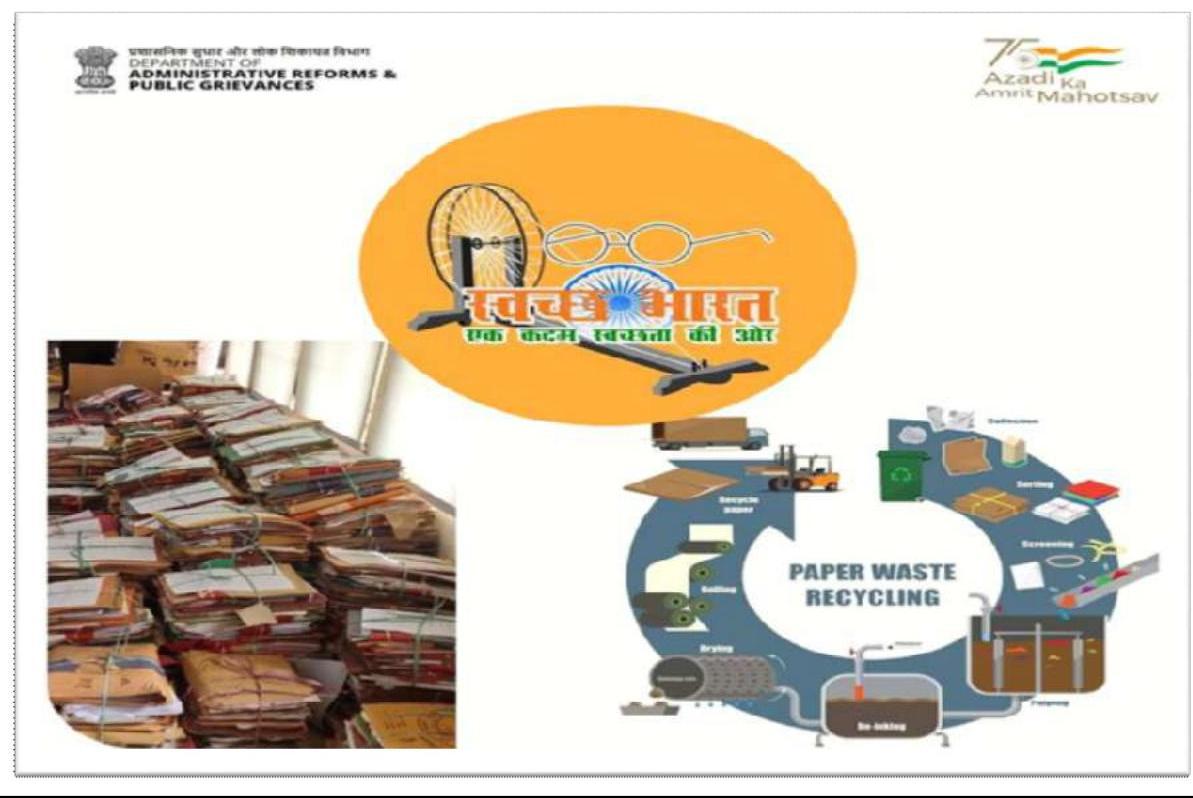
Waste paper sent for recycling to Kalyanmayee NGO for recycling; Department of Administrative Reforms and Public Grievances
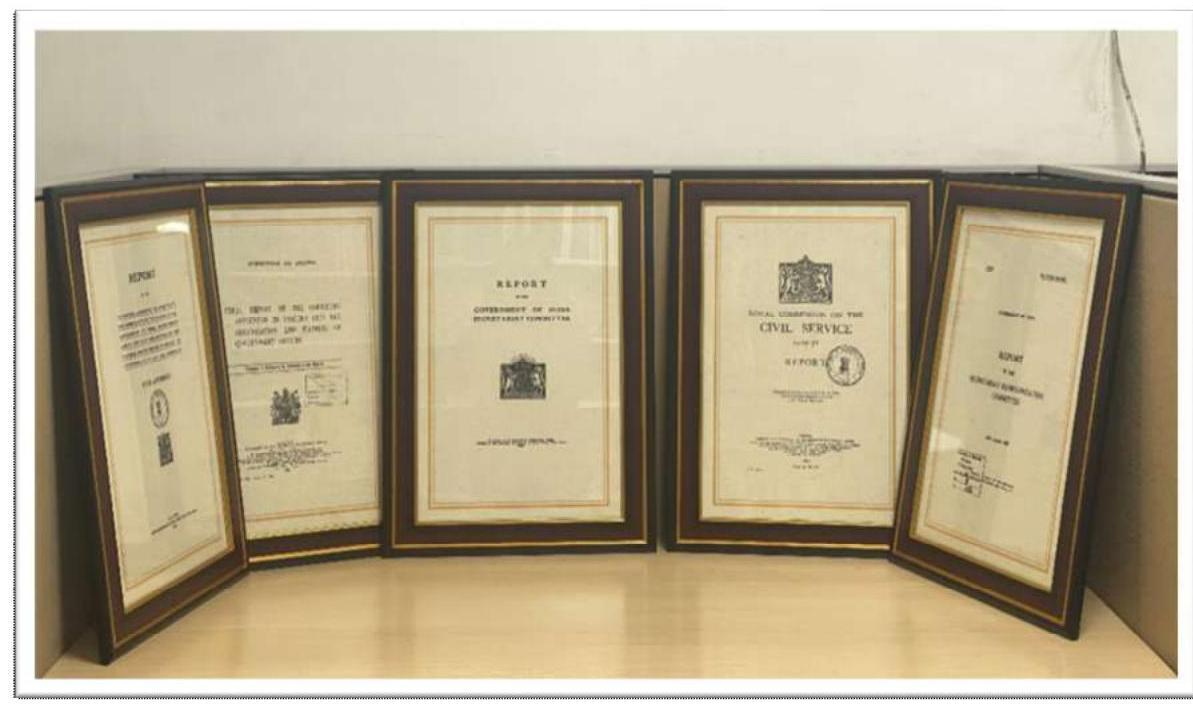
Preservation of records with high archival value at Sardar Patel Bhawan; Department of Administrative Reforms and Public Grievances
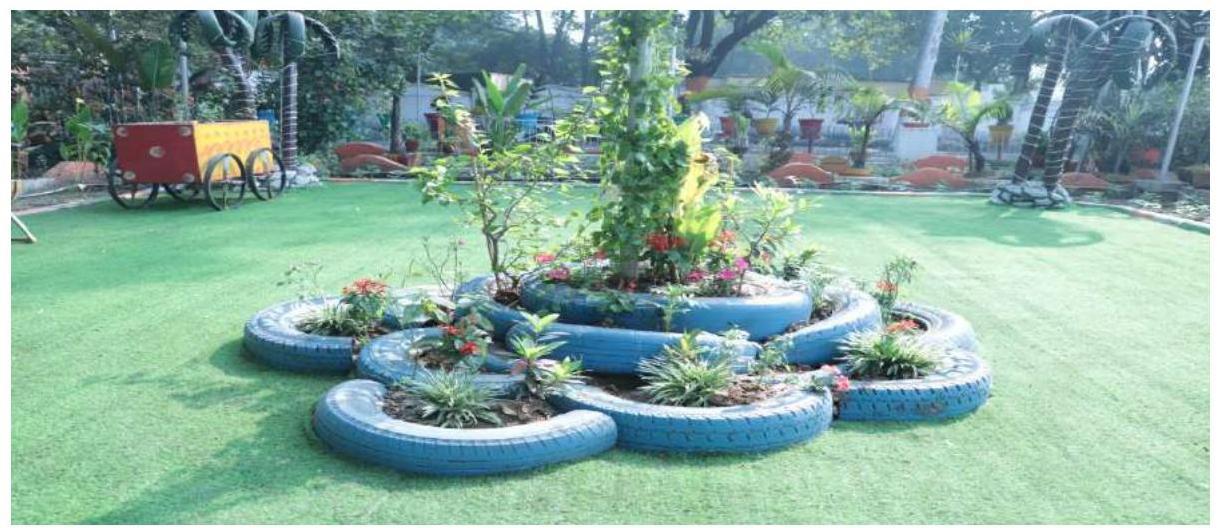
“Kachara Udyan” created by CCL in Bokaro and Kigali area from waste pipes, tyres, cart; Ministry of Coal
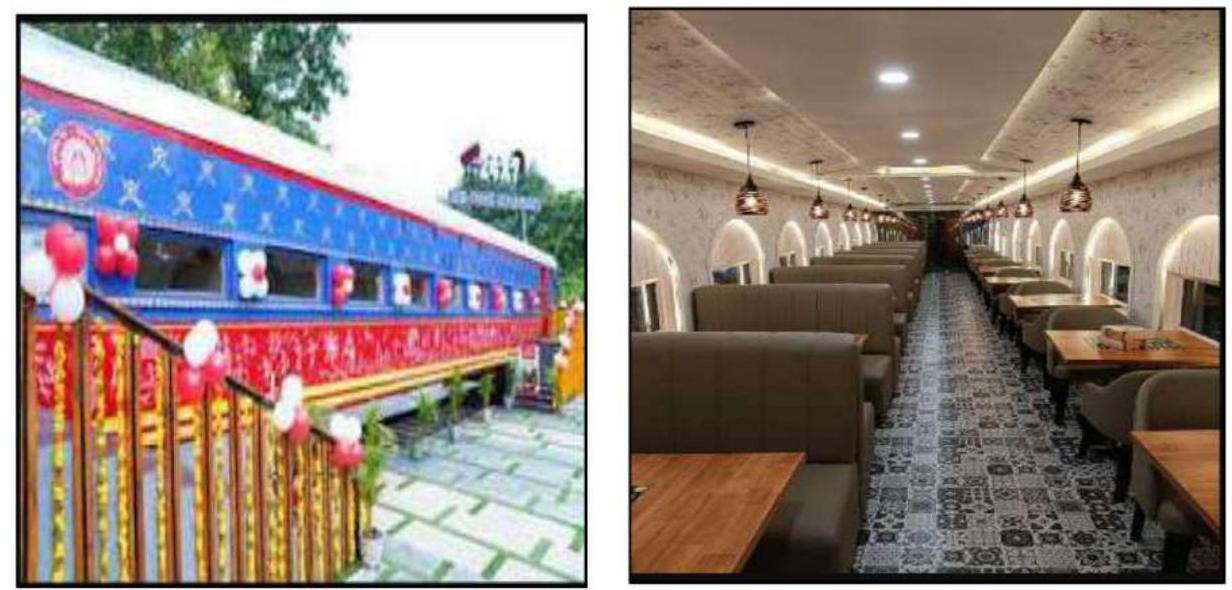
New rail coach restaurant has been started at Guntur Railway Station; Ministry of Railways
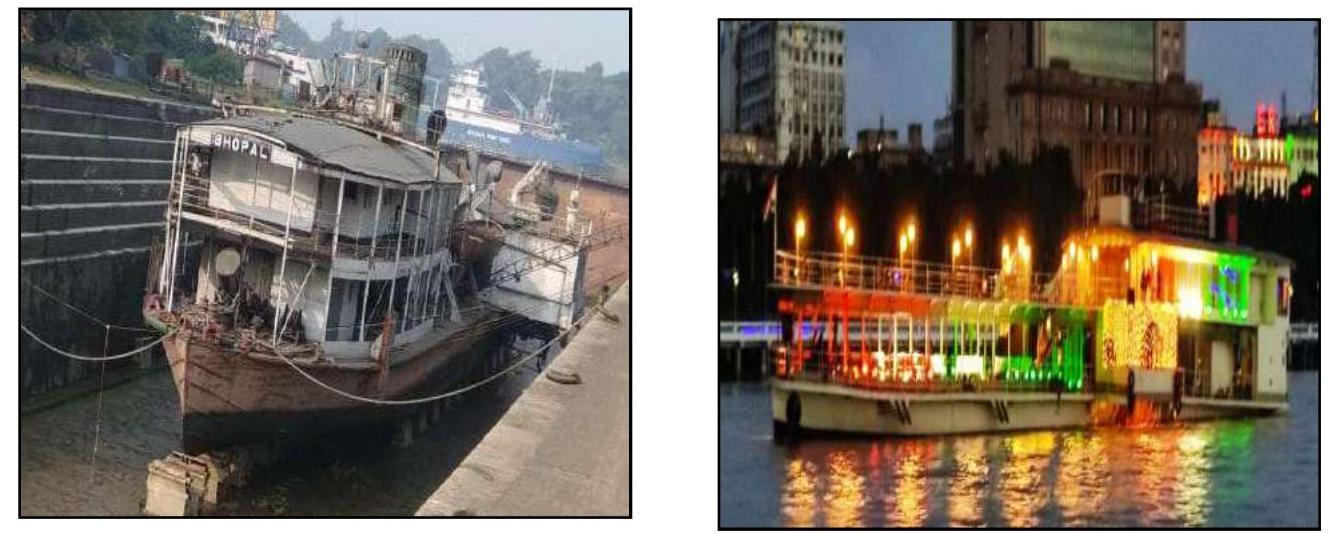
Shyama Prasad Mukherjee Port Authority, Kolkata (SMPA) turned the paddle steamer into a unique showcase for cruise tourism, with an under-deck museum, floating restaurant / conference; Ministry of Ports, Shipping and Waterways
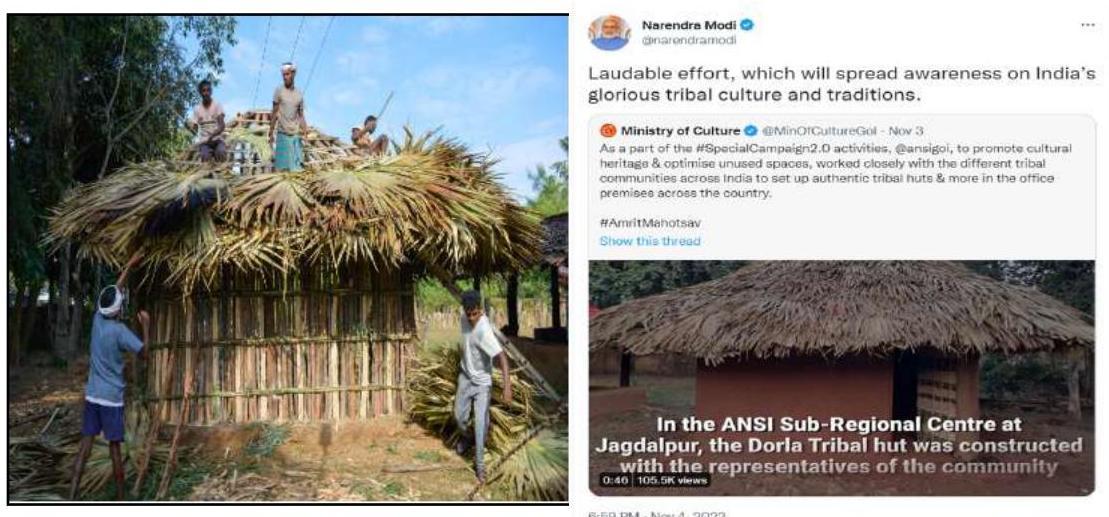
Jarawa Tribal Hut in A&N Islands as center for dissemination of Information and Knowledge on bio-cultural aspect of the region; Ministry of Culture
Vision India@2047
The DARPG is amongst the Ministries / Departments of Government that is formulating its Vision India@2047. The DARPG constituted an Advisory Group under the chairmanship of Minister of State for PMO, Personnel, PG and Pensions with Chief Secretaries of States/UTs, 15 Sector Specialists with National Experts from Senior Civil Servants, IIT’s, IIM’s Central and State Universities, and Public Policy Research Organizations. A working group under the chairmanship of Secretary DARPG along with AR Secretaries of States / UTs is also constituted for formulation of the Vision India@2047 under the overall supervision of the Advisory Group. The Indian Institute of Public Administration served as the Knowledge Partner of DARPG in formulating its VisionIndia@2047.
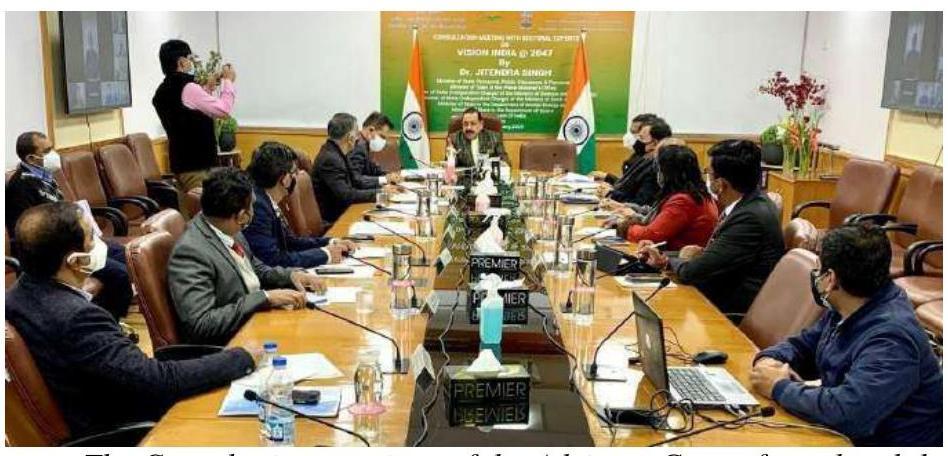
The Consultation meetings of the Advisory Group formulated the broad contours ofIndia’s futuristic governance plan.
The Working Group held 7 rounds of meetings. A 3-day workshop between young civil servants-academia-start-ups was held at IIT Madras from 7th – 9th March 2022 which was attended by 400 delegates. The Working Group studied the gamut of governance reforms undertaken from 2014-2022 in creating digital institutions and enabling infrastructure.
Based on deliberations of working group and Advisory group DARPG prepared a Vision India @ 2047 document with the theme of Bringing Citizens and Government together.
DARPG’s Vision for 2019-2024
1 PM’s Awards Scheme & Civil Services Day and National Good Governance
2 Webinar Series
3 Reforms of Central Public Grievance Redressal and Monitoring System (CPGRAMS)
4 Implementation of e-Office under Secretariat Reforms
5 Developing Good Governance Index:
6 National Conferences on e-Governance and National e.Governance Award’s
7 Scheme
8 Regional Conferences
9 Good Governance Day / Special Campaign for Disposal of Pending Matters / Swachhata campaign / Secretariat Reforms
10 Initiative for Increasing Efficiency in Central Secretariat
11 National Centre for Good Governance as an apex Institute for Good Governance
DARPG’s Vision for 2024-29
- Focus on Young Civil Servants
- Digital Transformation of Governance / National e-Governance Service Delivery Assessment (NeSDA)
- Benchmarking Governance
- Developing Universal District Good Governance Index (UDGGI)
- Deepening Secretariat Reforms, Swachhta Campaign
- Redressal of Public Grievances \& Improving Service Delivery/Public Grievance Redressal.
- Special Campaign for Disposal of Pending Matters:
- Initiative for Increasing Efficiency in Central Secretariat
CHAPTER 24
e-GOVERNANCE
24.0 24 th National Conference on e-Governance
The $25^{\text {th }}$ National Conference on e-Governance was held on 26.11.2022 – 27.11.2022 in Shri Mata Vaishno Devi University (SMVDU), Kakryal, Katra, UT of Jammu & Kashmir. The theme of this Conference was “e-Governance-Bringing Citizens, Industry and Government Closer.”
The Conference was inaugurated by the Chief Guest, Dr. Jitendra Singh, Union Minister of State (Independent Charge), Ministry of Science and Technology, Ministry of Earth Sciences, Minister of State in the Prime Minister’s Office, Minister of State of Personnel, Public Grievances \& Pensions, Department of Atomic Energy and Department of Space, Government of India. Shri Manohar Lal, Hon’ble CM of Haryana and Shri Manoj Sinha, Hon’ble Lieutenant Governor, J\&K also graced the Conference with their presence in the valedictory session.
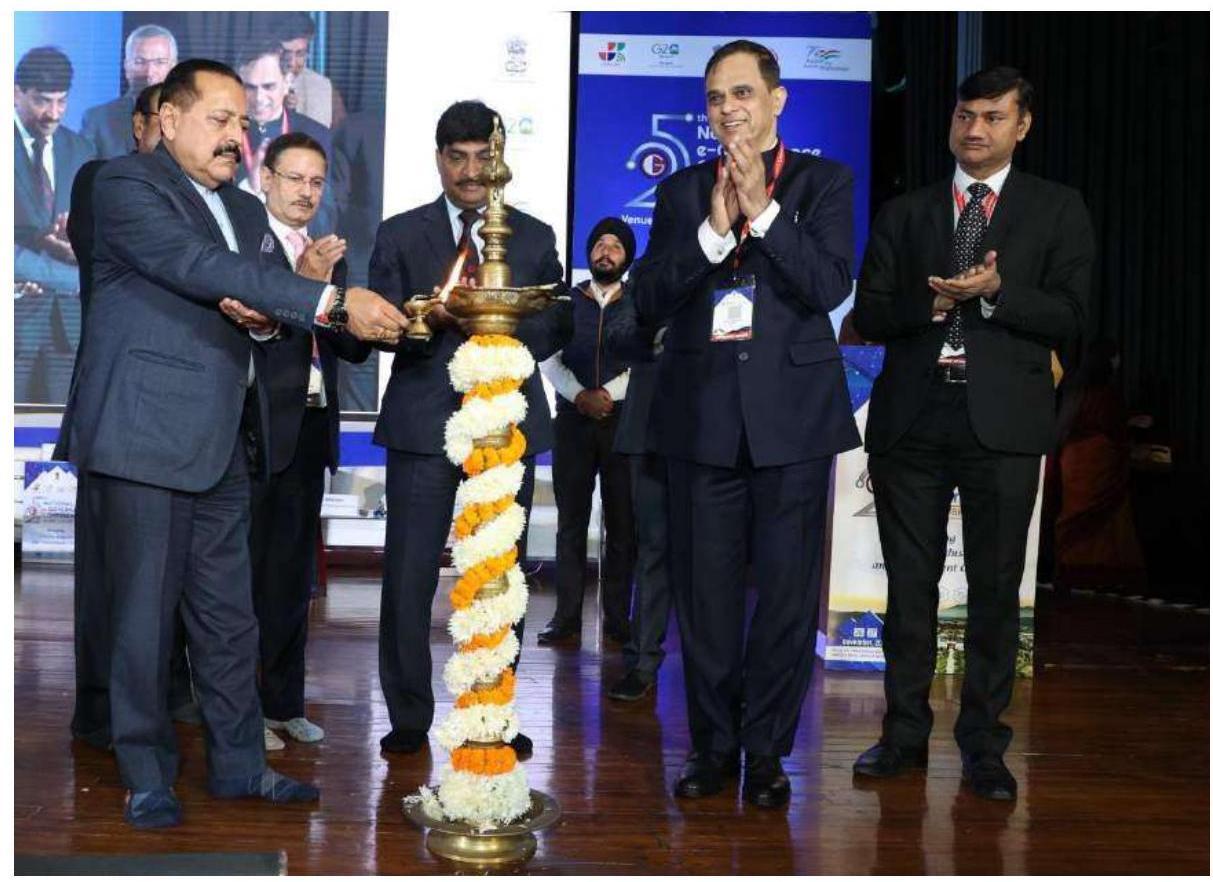
Lighting of Lamp by Dr. Jitendra Singh, Hon’ble MoS (PP)
The Conference was attended by over 1600 delegates which included delegates from Government of India, State/UT Governments, Industry, Academia, and Private Sector.
An Exhibition including Wall of Fame showcasing the awarded and other best practices of the country was also organized during the Conference.
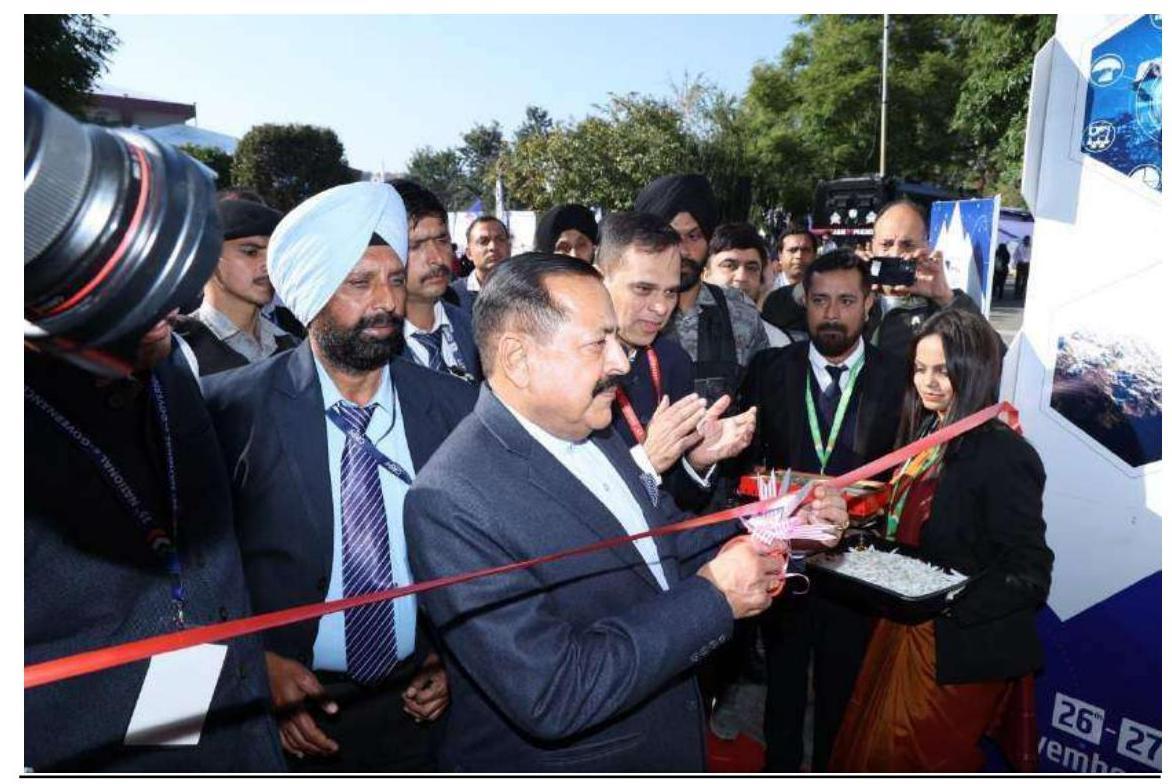
Inauguration of Exhibition by Dr. Jitendra Singh, Hon’ble MoS (PP)
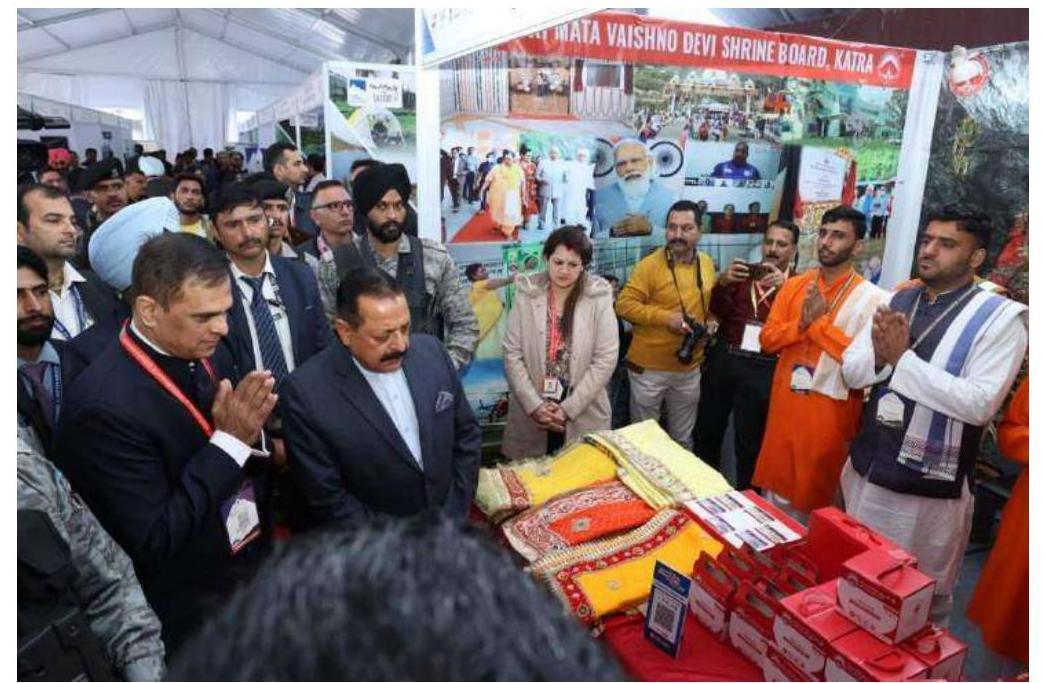
Stall of Shri ata Vaishno Devi Shrine Board, Katra
A film was released during the event. Four books namely, (i) Citations for National e-Governance Award Winners 2022, (ii) Excellence in e-Governance, (iii) Background Papers and (iv) e-Governance: Bringing Citizens, Industry and Government CloserCompendium of e-Governance Initiatives were also released in the Inaugural Session of the 25th NCeG.
The $25^{\text {th }} \mathrm{NCeG}$ represented a platform for constructive exchange of ideas on some of the latest technologies for promoting e-Governance. 49 Distinguished speakers shared their
knowledge and insights in 10 plenary sessions on the following contemporary subjects/issues:
i. Digital Governance across Whole-of-the-Government
ii. Digital Economy Strengthening Start-up Ecosystem and Employment Generation
iii. Modern Laws to Promote National Growth and to Secure Citizen’s Right
iv. Transparent and Real-Time Grievance Management System
v. $21^{\text {st }}$ Century Digital Infrastructure for Next-Generation Services and Security in Cyber Space
vi. Shifting the Gear on Emerging Technologies from Exploration to Population ScaleSolutions
vii. Silver Awardees: Digital Governance for enhancing Ease of Doing Business andEase of Living
viii. Gold Awardees: The role of e-Governance in Bridging the Digital Divide
ix. J&K State: Digital Transformation in J\&K
x. e-Governance Initiative in J\&K
The roadmap for e-Governance of the country for the next year was drawn up during the Conference. The key takeaways from the 25th NCeG are – Closer synergy amongst researchers, academia, industry and start-ups in the field of e-Governance is the way forward for India; The policy maxim of Maximum Governance-Minimum Government is best reflected in a Digitally Empowered Nation – Digitally Empowered Citizen – Digitally Transformed Institution; Citizen Centricity as an important area of focus and Digital Transformation of Institutions.
24.1 National Awards for e-Governance
To recognise the implementation of e-Governance initiatives, the National Awards for eGovernance 2022 were presented during the Inaugural Session of the Conference. Total 18 awards, which included 9 Gold and 9 Silver were presented to Central Ministries / Departments, State / UT Governments, Districts, Local Bodies, Public Sector Undertakings and Academic \& Research Institutions, under the following 5 categories / sub- categories of the National Awards for e-Governance Scheme – 2022:
I. Excellence in Government Process Re-engineering for Digital Transformation
i. Central level initiatives
ii. State / UT level initiatives
II. Excellence in providing Citizen Centric Delivery
i. Central level initiatives
ii. State / UT level initiatives
III. Excellence in District level initiative in e-Governance
i. North-East and Hill States;
ii. UTs (including Delhi);
iii. Other States
IV. Outstanding research on Citizen Centric Services by Academic/Research Institutions
V. Excellence in Adopting Emerging Technologies
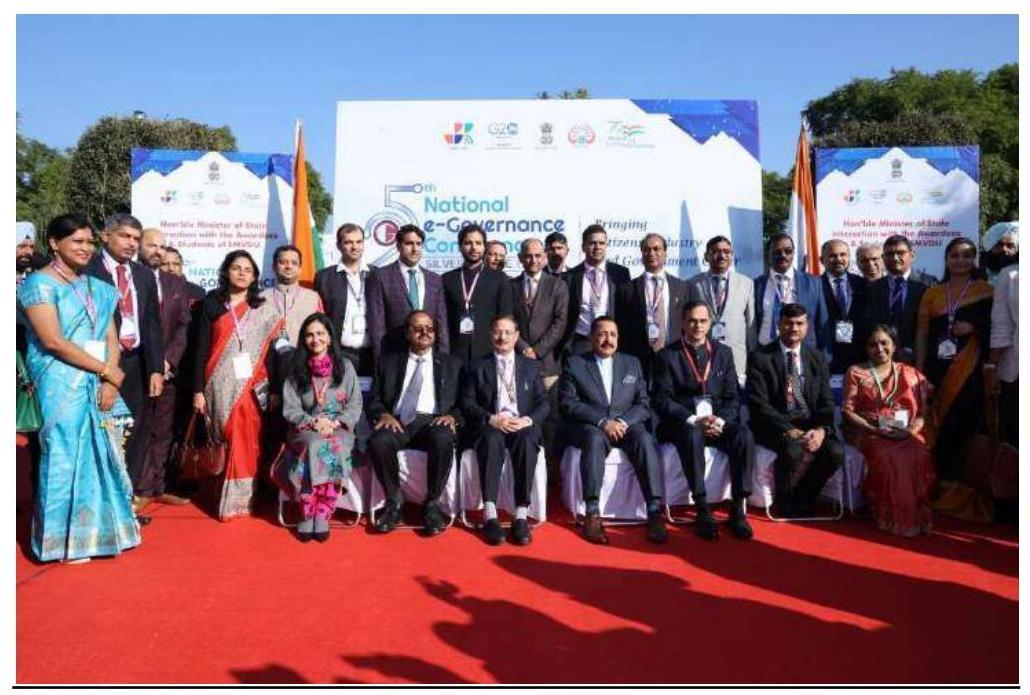
The Project Heads of the awarded projects with Dr. Jitendra Singh, Hon’ble MoS (PP) and other dignitaries
The list of awardees are attached at Annexure-I.
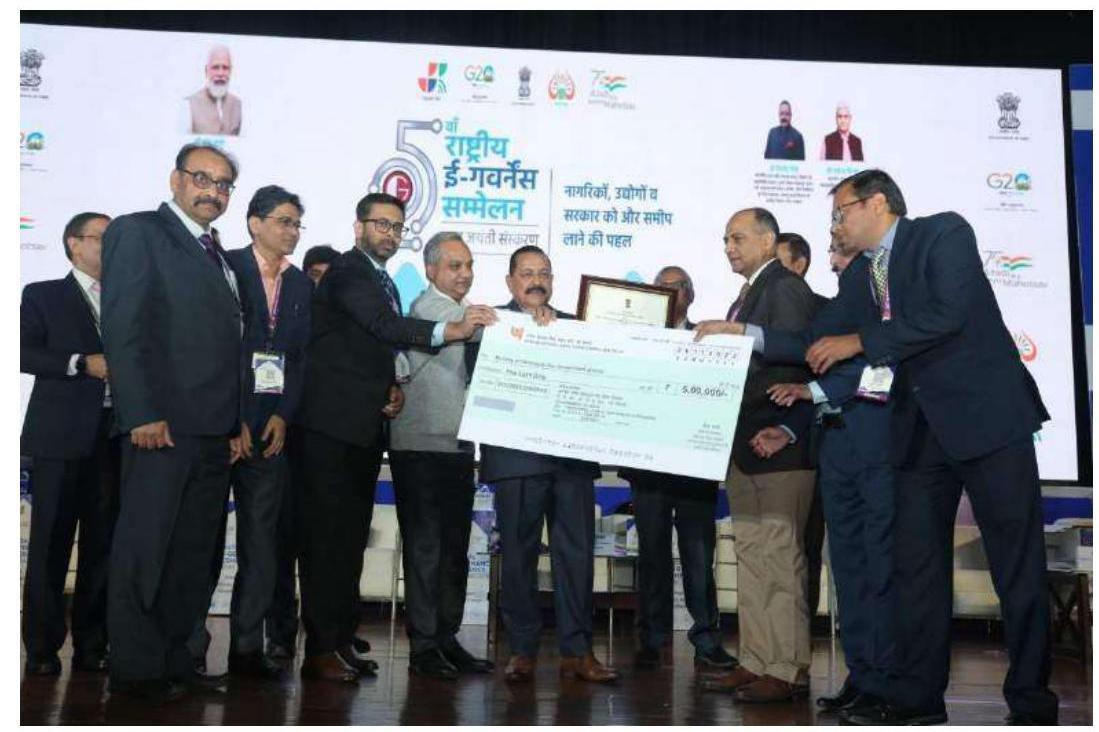
e-Panchayat Mission Mode Project (eGramSwaraj & Audit Online) Project team led by ShriAlok Prem Nagar, Joint Secretary, Ministry of Panchayati Raj, Govt. of India accepting the Gold award for category-I- Excellence in Government Process Re-engineering for Digital Transformation
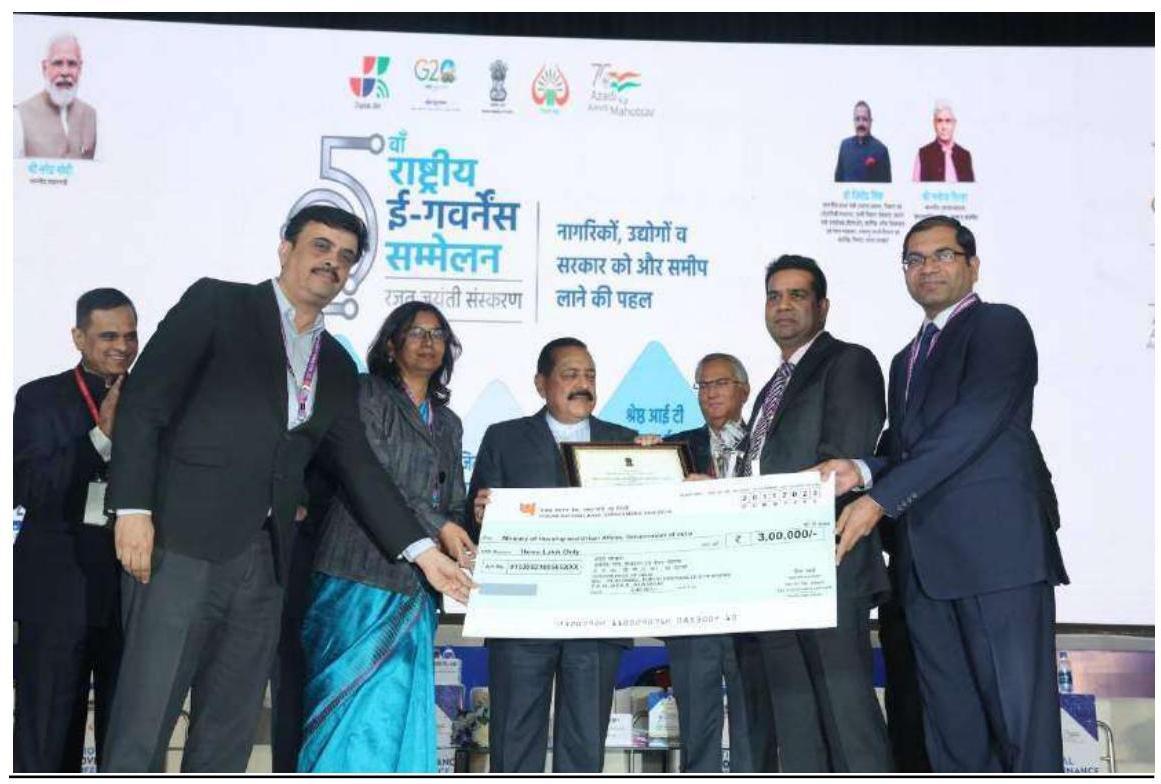
PM Street Vendors AtmaNirbhar Nidhi (PM SVANidhi) Project team led by Shri Sanjay Kumar, Additional Secretary, Ministry of Housing and Urban Affairs, Government of India accepting the Silver award for category- I- Excellence in Government Process Reengineering for Digital Transformation
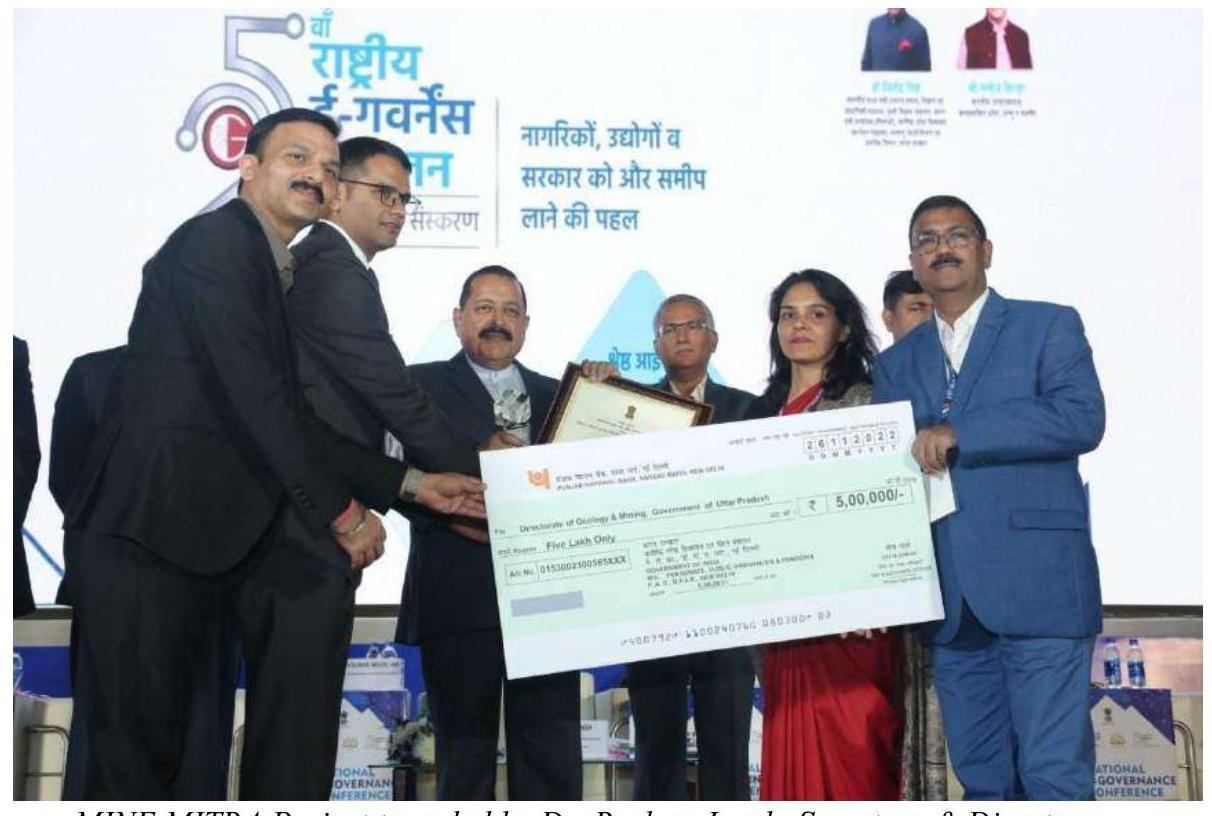
MINE MITRA Project team led by Dr. Roshan Jacob, Secretary & Director, Directorate ofGeology \& Mining, Govt. of Uttar Pradesh accepting the Gold award for Category I – Excellence in Government Process Re-engineering for Digital Transformation
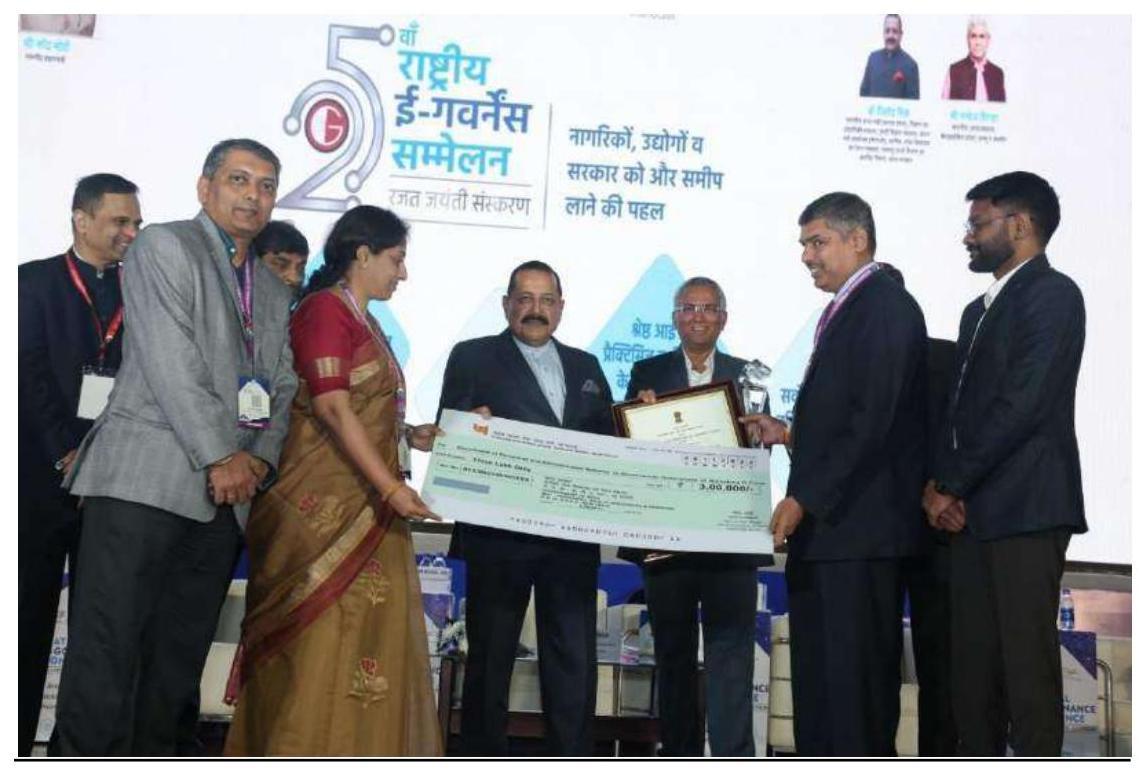
Kutumba – An Entitlement Management System Project team led by Shri V Ponnuraj, Secretary, DPAR (e-Governance), Govt. of Karnataka accepting the Silver award for Category I – Excellence in Government Process Re-engineering for Digital Transformation
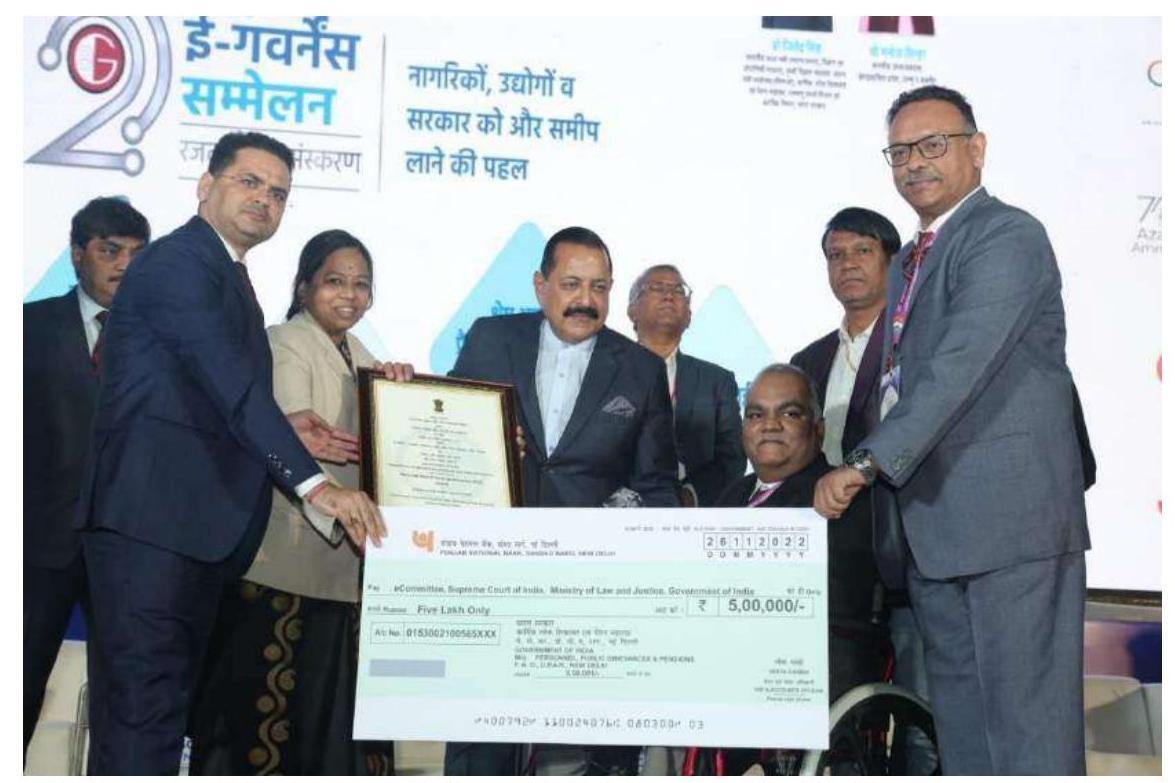
Judgement & Orders search Portal (High Courts of India) Project team led by Shri Ramesh Babu, Member (Project Management), eCommittee, Supreme Court of India, Ministry of Law \& Justice, Govt. of India accepting the Gold award for Category II – Excellence in Providing Citizen Centric Delivery
Bharat Skills Project team led by Dr. Jayaprakasan, Director, IT, Directorate General of Training, Ministry of Skill Development and Entrepreneurship, Govt. of India accepting the Silver award for Category II – Excellence in Providing Citizen Centric Delivery
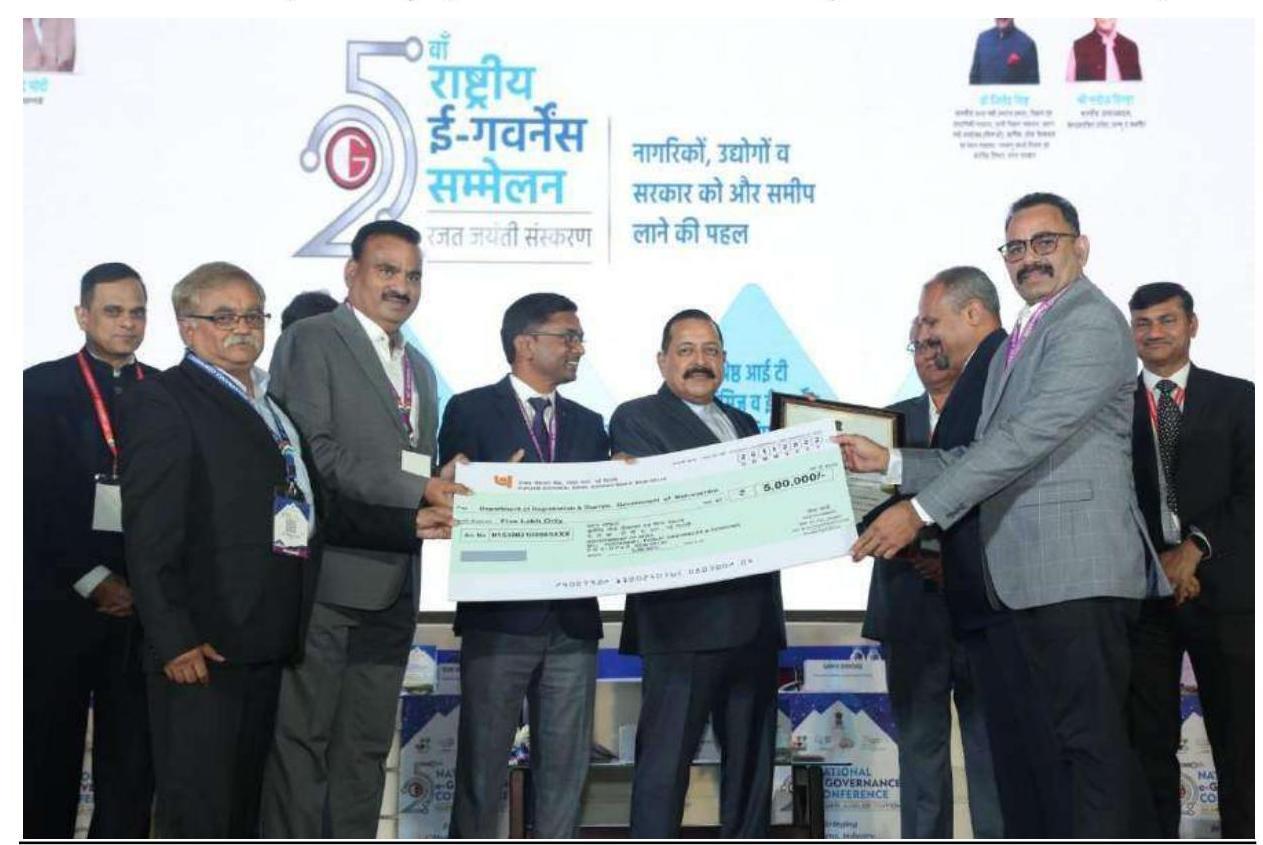
eRegistration (Self Help Portal) for document registration Project team led by Shri Shravan Hardikar, IGR, Department of Registration & Stamp, Govt. of Maharashtra accepting the Gold award for Category II – Excellence in Providing Citizen Centric Delivery
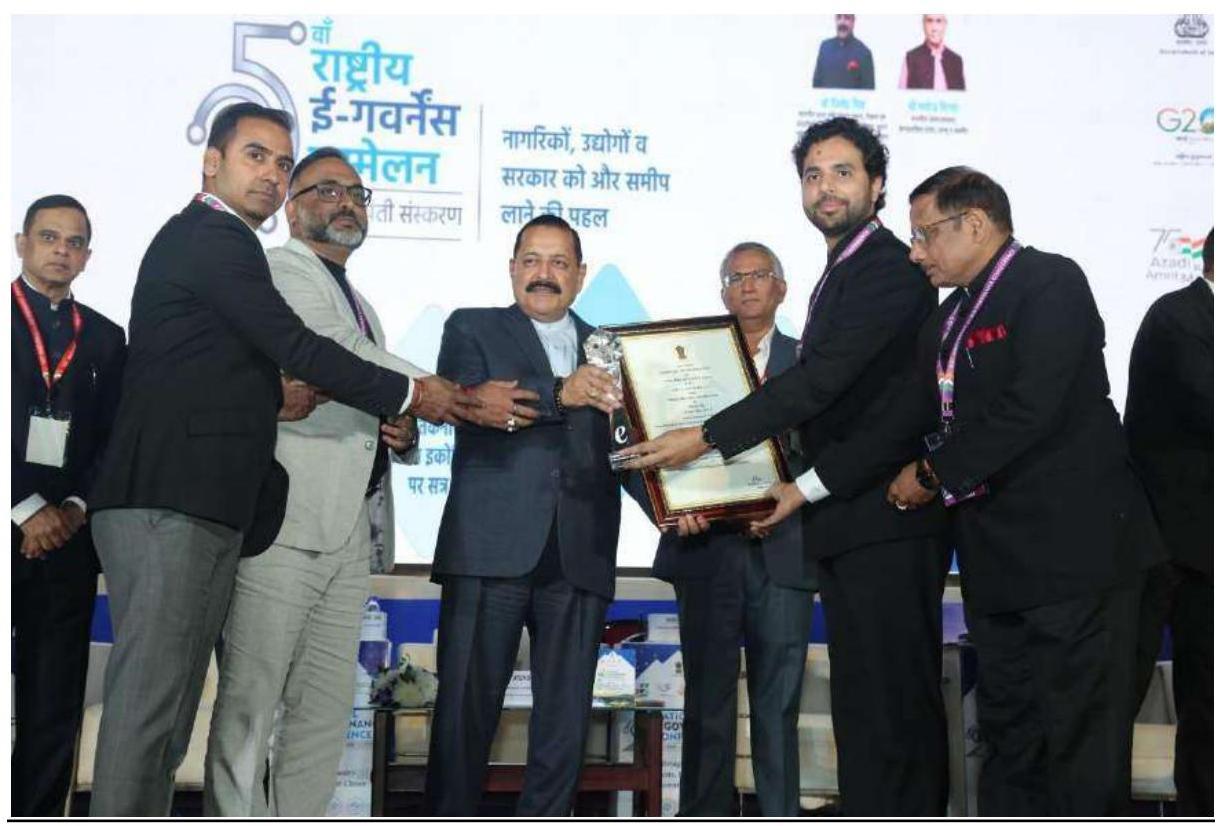
ChikitsaSetu Project team led by Shri Prashant Sharma, Special Secretary, Medical Education Department, Govt. of Uttar Pradesh accepting the Silver award for Category II Excellence in Providing Citizen Centric Delivery
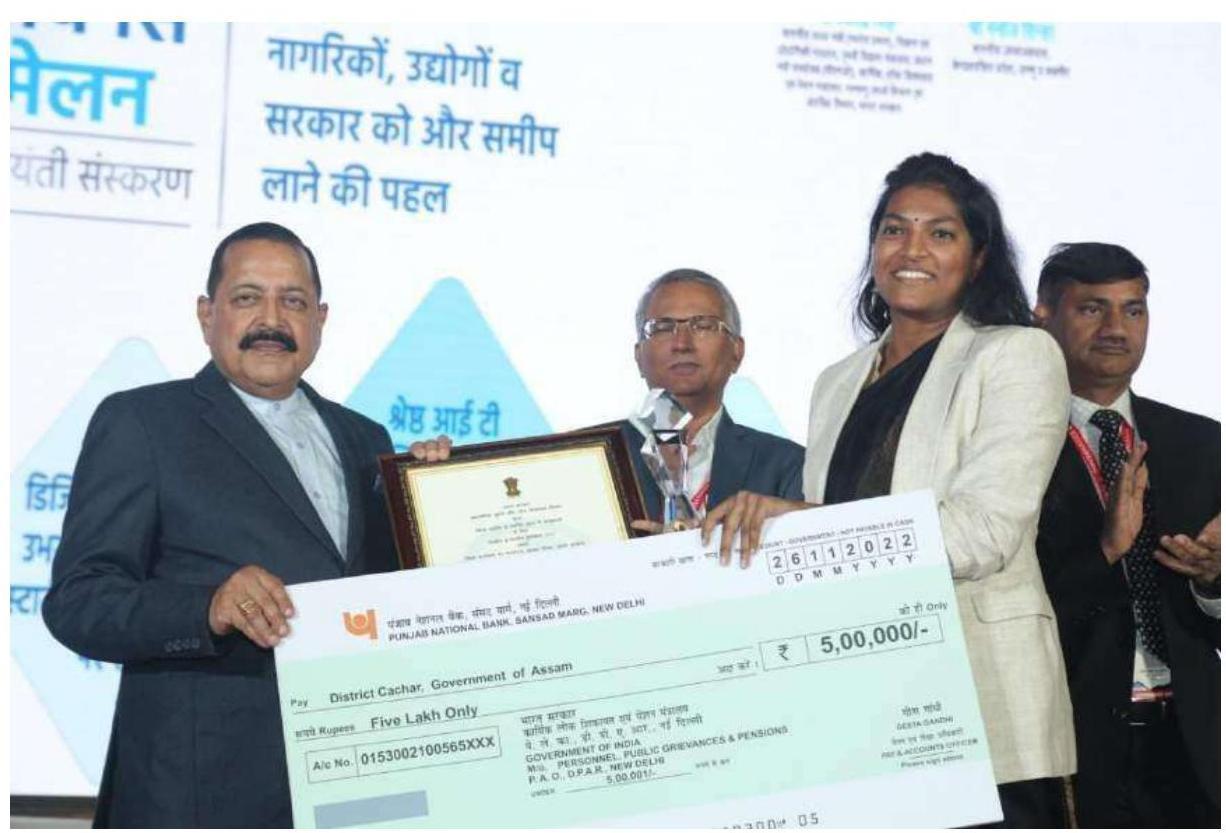
Parvarish (A step Towards Kuposhan Mukta Bharat)Project team led by Smt. Keerthi Jalli,Deputy Commissioner, District Cachar, Govt. of Assam accepting the Gold award for Category III – Excellence in District level initiative in e-Governance
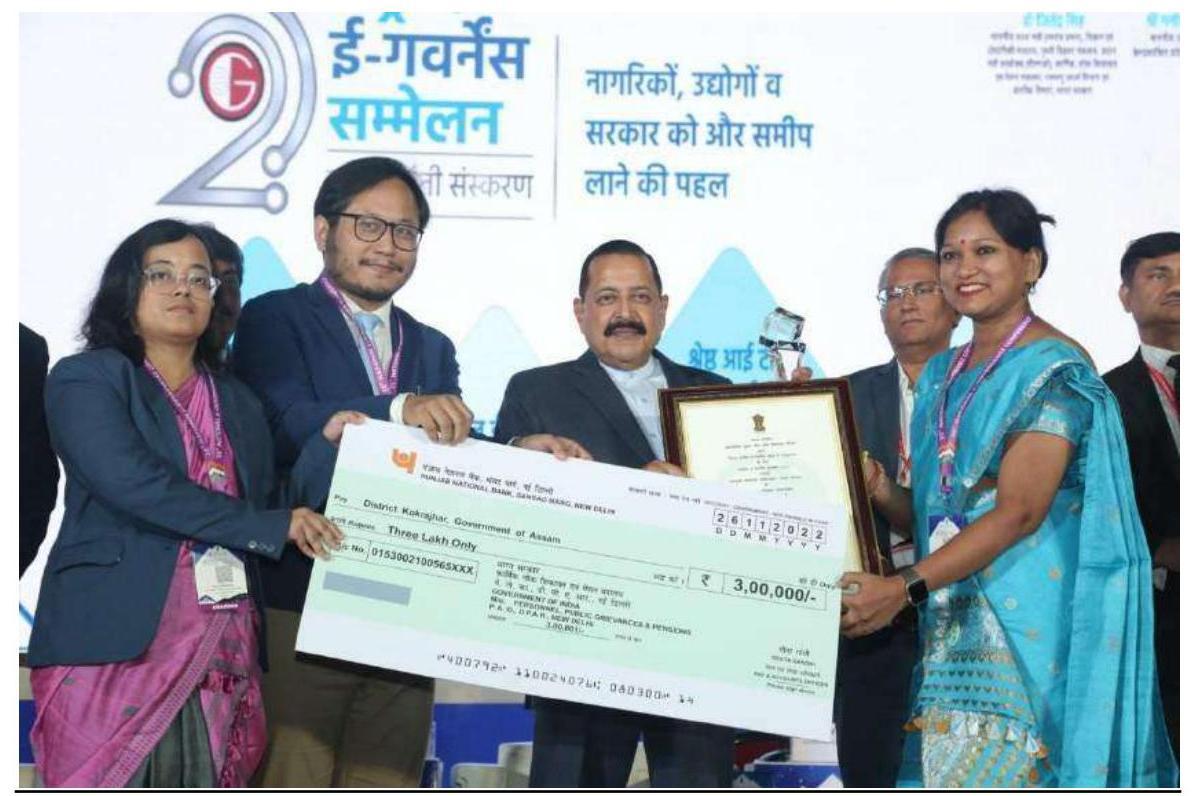
Infrastructure Snapshot Kokrajhar Project team led by Smt. Varnali Deka, Deputy Commissioner, District Kokrajhar, Govt. of Assam accepting the Silver award for Category III – Excellence in District level initiative in e-Governance
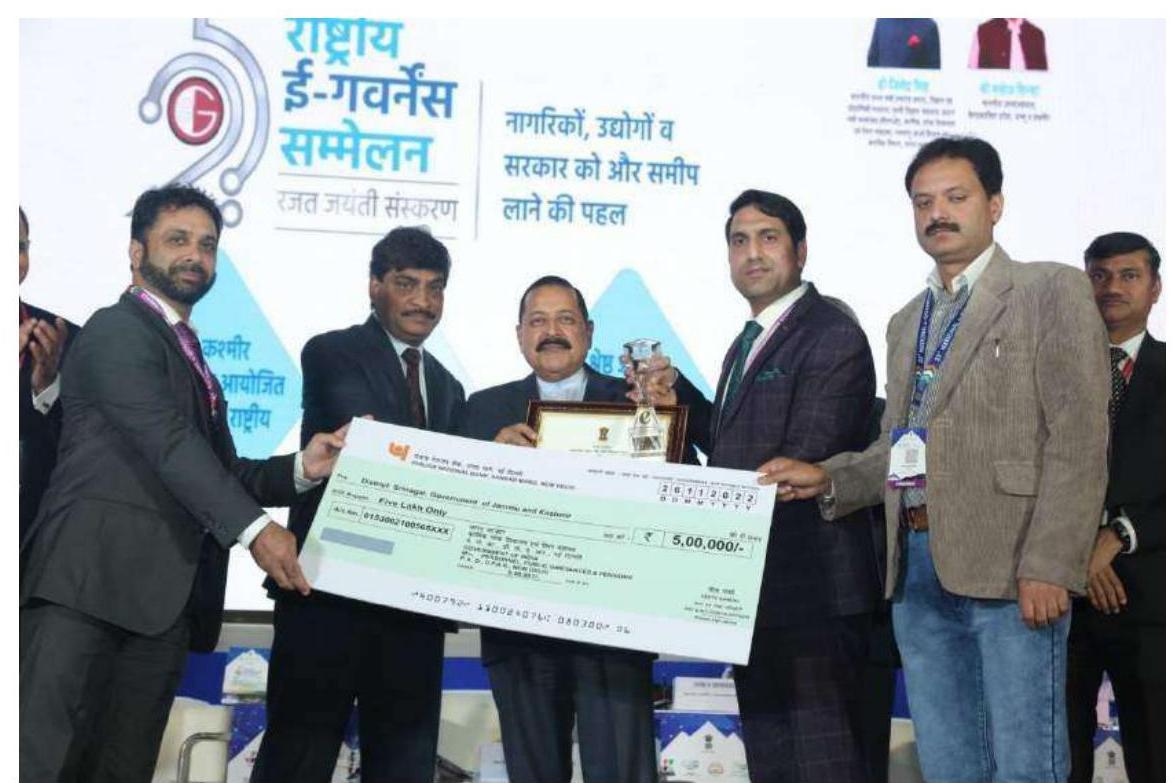
GAASH Project team led by Shri Mohammad Aijaz, Deputy Commissioner, Srinagar, Govt.of Jammu & Kashmir accepting the Gold award for Category III – Excellence in District level initiative in e-Governance
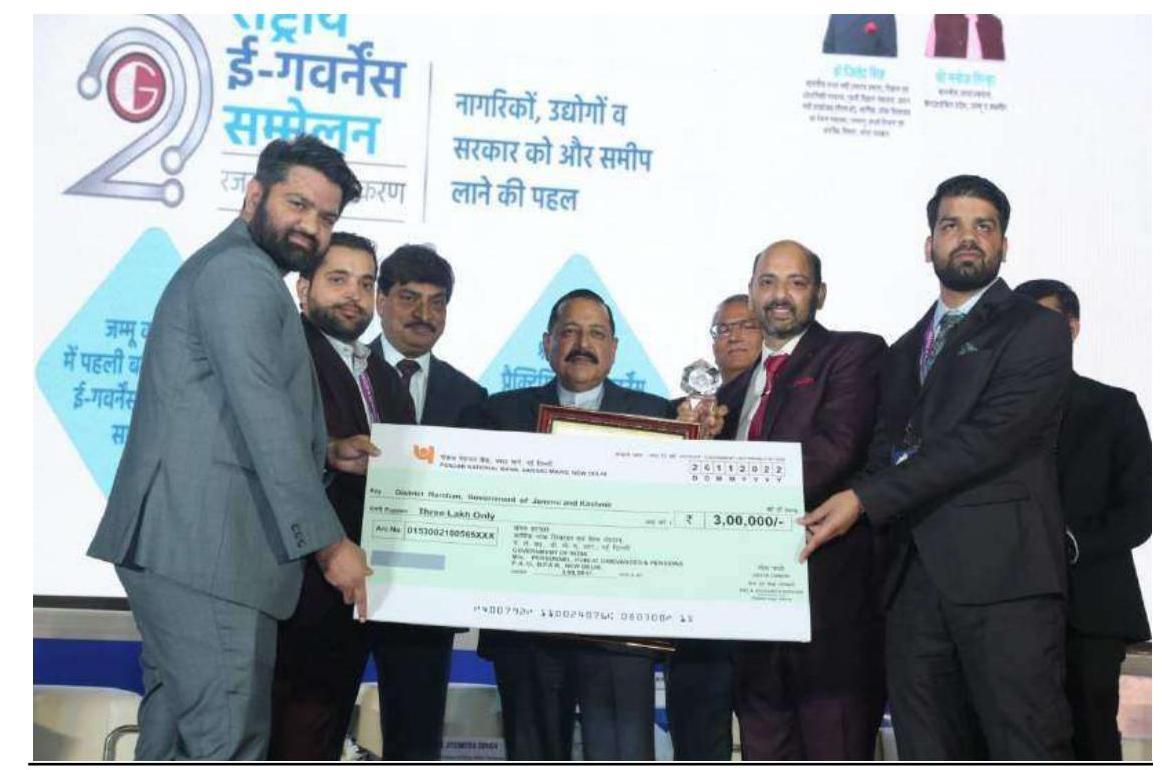
e-Suvidha Project team led by Shri Mussrat Islam, Deputy Commissioner, District Ramban, Govt. of Jammu & Kashmir accepting the Silver award for Category III – Excellence in District level initiative in e-Governance
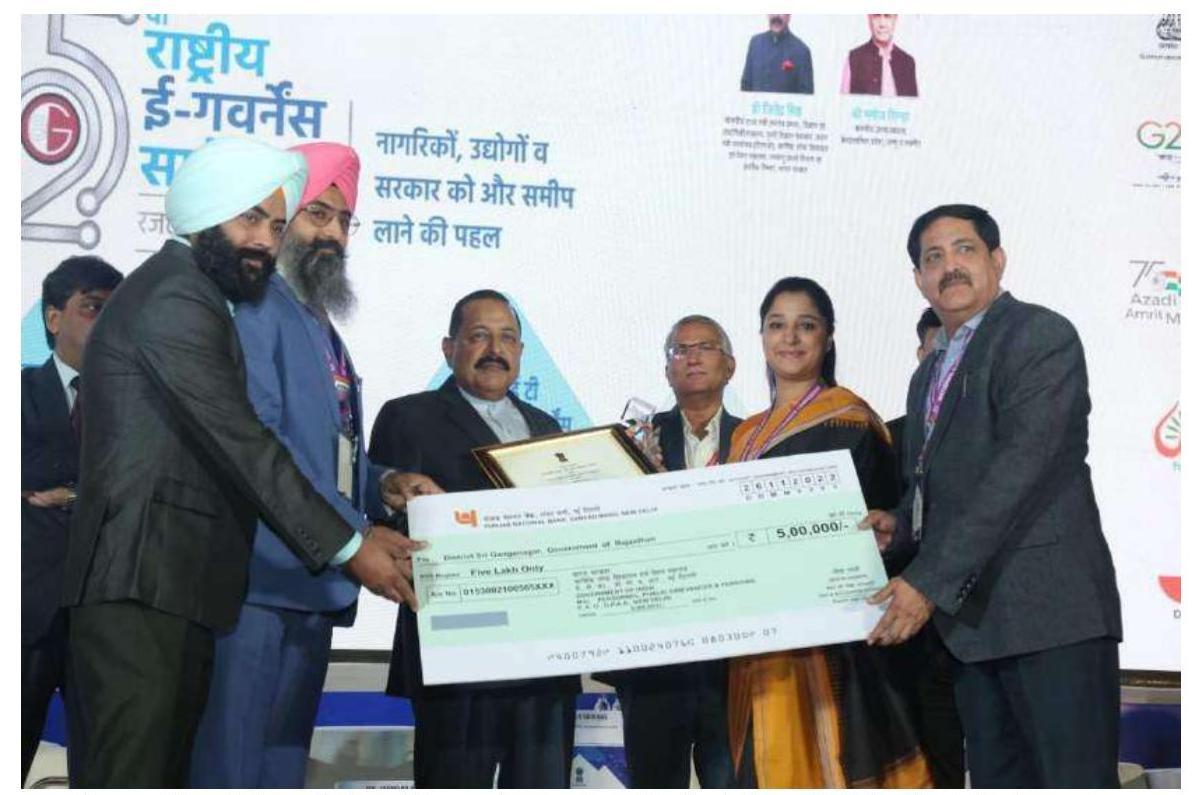
Gang Canal Regulation Computerization Project team led by Smt. Rukmani Riar Sihag, District Collector, District Sri Ganganagar, Govt. of Rajasthan accepting the Gold awardfor Category III – Excellence in District level initiative in e-Governance
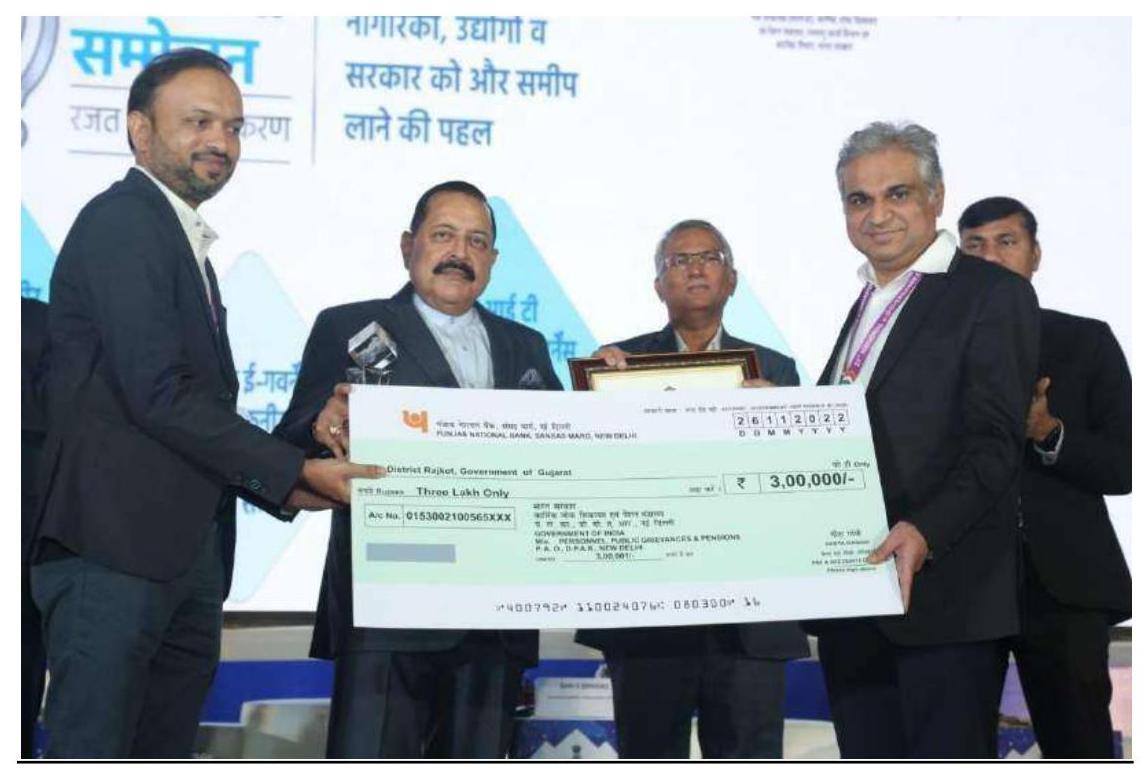
OTP and Feedback Based Public Grievance Redressal System Project team led by Shri AmitArora, Municipal Commissioner, District Rajkot, Govt. of Gujarat accepting the Silver award for Category III- Excellence in District level initiative in e-Governance
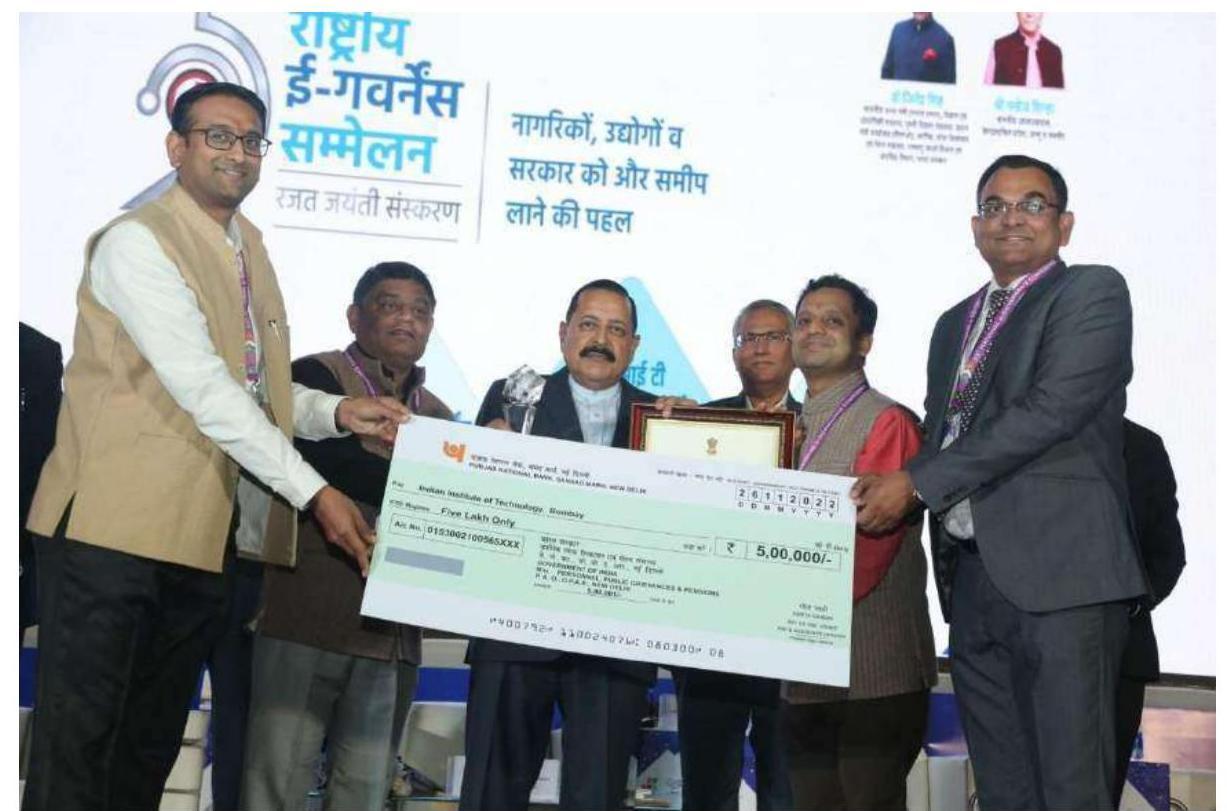
Video Analytics for Safety and Compliance Applications Project team led Prof. GaneshRamakrishnan, Dept. of CSE, IIT Bombay accepting the Gold award for Category IV- Outstanding research on Citizen Centric Services by Academic / Research Institutions
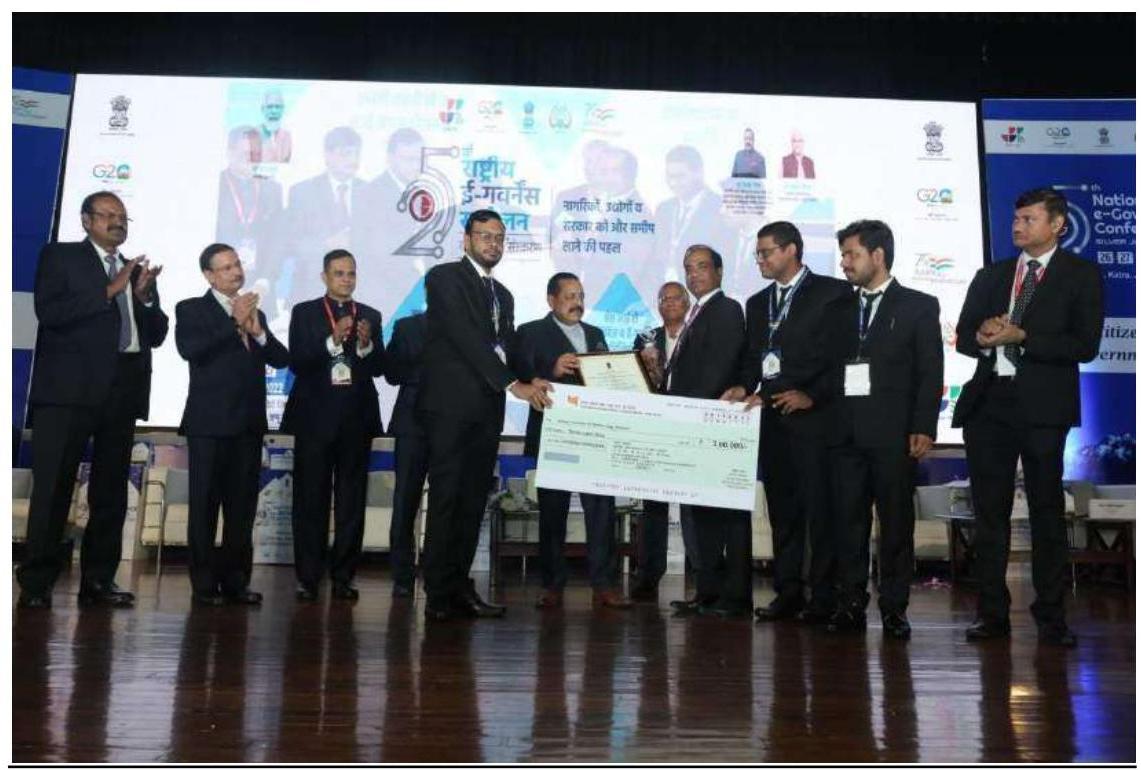
Analysing Public Grievances using Artificial Intelligence Project team led by Prof. Shalabh,Department of Mathematics & Statistics, IIT Kanpur accepting the Silver award for Category IV-Outstanding research on Citizen Centric Services by Academic / Research Institutions
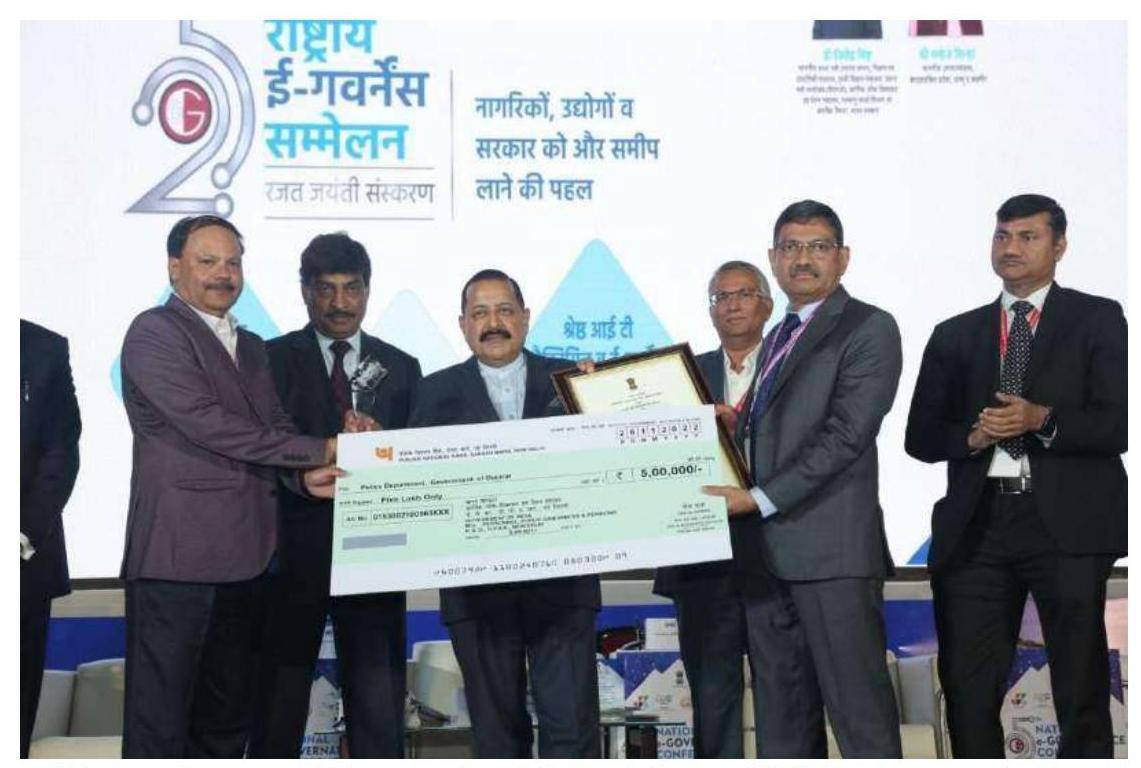
Trinetra: Integrated Command and Control Center (i3C) Project team led by Mr. Narasimha Komar, Chairman Task Force on VISWAS \& Addl. DG of Police (Law \& Order), Police Department, Govt. of Gujarat accepting the Gold award for Category V – Excellence in Adopting Emerging Technologies
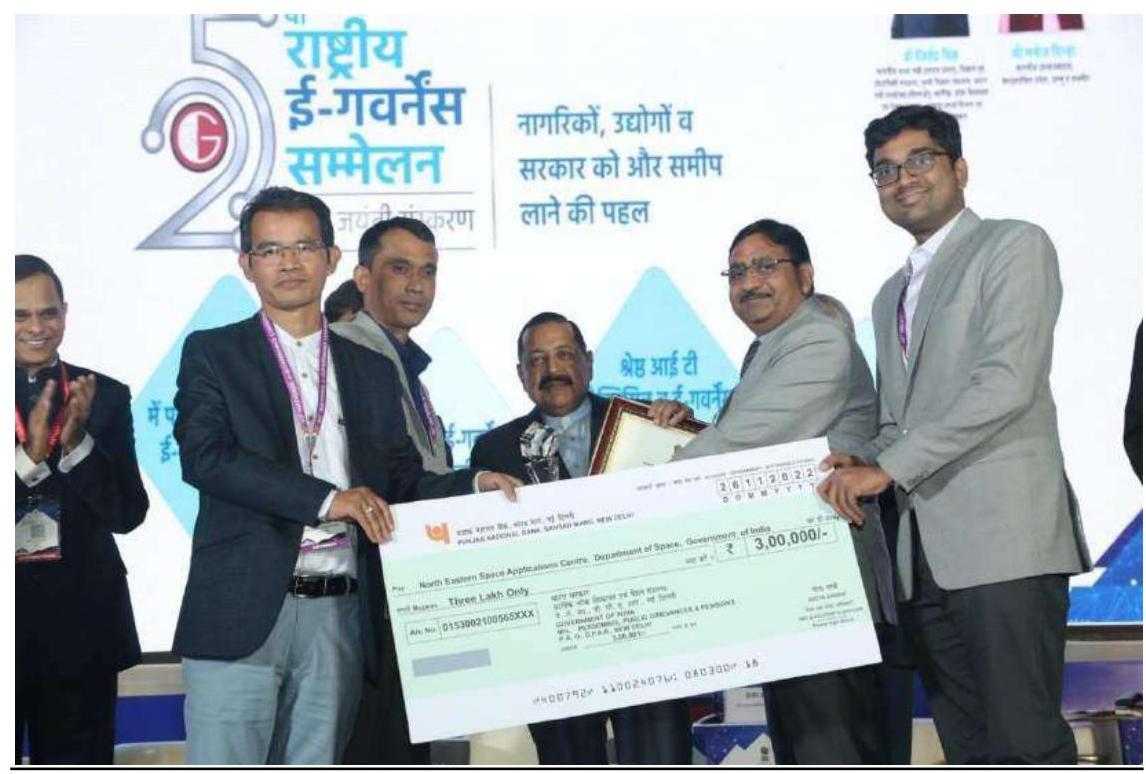
North Eastern Spatial Data Repository (NeSDR) Project team led by Dr. S.P. Agarwal, Director, North Eastern Space Applications Centre, Department of Space, Government ofIndia accepting the Silver award for Category V – Excellence in Adopting Emerging Technologies
24.2 National e-Governance Service Delivery Assessment (NeSDA)
The Department of Administrative Reforms & Public Grievances (DARPG) had constituted the National e-Governance Service Delivery Assessment (NeSDA) in 2019 as part of its mandate to boost the e- government endeavors and drive digital government excellence. The study assesses States, Union Territories (UTs), and focus Central Ministries on the effectiveness of e-Governance service delivery. NeSDA helps the respective governments to improve their delivery of citizen centric services and shares best practices across the country for all States, Uts and Central Ministries to emulate.
Under the biennial study of NeSDA, the Department has undertaken NeSDA 2021 and in June 2022, Minister of State for Personnel, Public Grievances and Pensions had released the NeSDA 2021 report which assessed 1400 e-Services across States and UT’s and reported that India’s e- Services had grown by 60 percent in the period 2019-2021. 69 percent of the mandatory e-services have been delivered by States/ UT’s in 2021 up from 48 percent in NeSDA 2019. 74 percent of the respondents of the Nation wide Citizen survey are satisfied/ very satisfied with the e-services. Now the Department is in the process of undertaking NeSDA, 2023.
Further DARPG will collaborate with States and Union Territories to ensure timely implementation of the recommendations of the NeSDA 2021 and for rolling out of all mandatory e-services by States and Union Territories in a time bound manner. The DARPG will coordinate with States and Union Territories to strengthen the State Portals and Service Portals to enhance the ease of living of citizens. The objectives of the monitoring / collaboration are to adopt the 56 mandatory services and to saturate e-service
delivery by all the States/Uts as a way forward for timely implementation of recommendations of NeSDA, 2021.
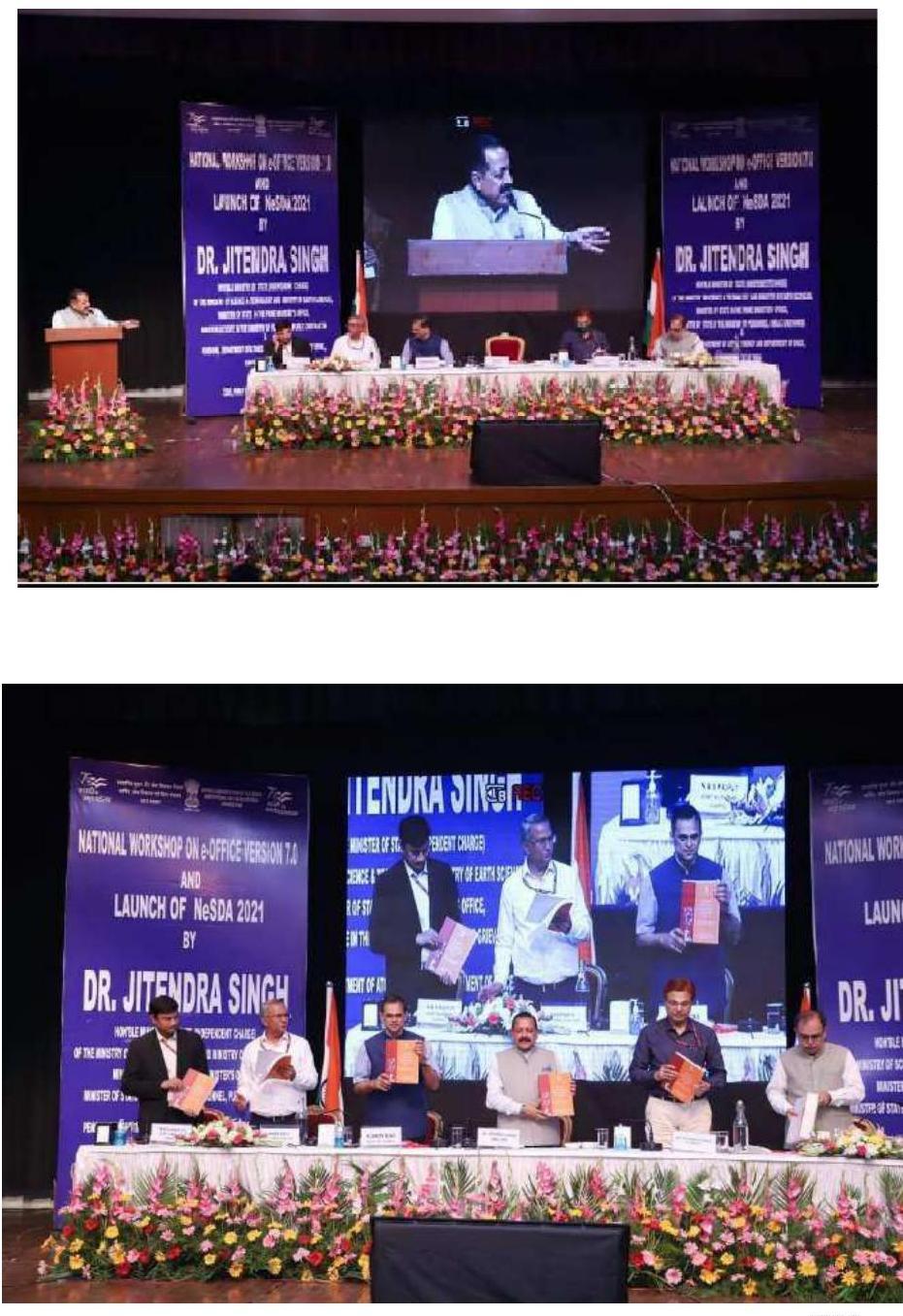
NeSDA, 2021 Launch by Hon’ble MOS(PP) on $13{ }^{\text {TH }}$ JUNE2022
CHAPTER 25
INTERNATIONAL EXCHANGE AND COOPERATION
25.1 The Department of Administrative Reforms & Public Grievances (DARPG) deals with matters relating to international exchange and cooperation in the field of Public Administration and Governance, which includes, among other things, organizing programmes and visits of Indian delegations to foreign countries and visits of foreign delegations to India as part of projects / bilateral measures in furtherance of activities included in the Memorandum of Understandings (MOUs) / Agreements signed between India and other countries (bilateral or multilateral).
The aim of international exchange and cooperation component is to share information, best practices and personnel across national governments. Presently bilateral MoUs in the areas of Public Administration and Governance have been signed with Portugal, United Kingdom, Singapore and Australia, The Gambia and trilateral MoU with Brazil and South Africa (IBSA).
The following activities were held during the year 2022-23:
25.2 India – Singapore Cooperation
25.2.1 The MoU for cooperation in the field of ‘Personnel Management and Public Administration’ was signed by the Department with the Public Service Division (PSD) of the Republic of Singapore on $1^{\text {st }}$ June, 2018.
25.2.2 The areas of cooperation under the MoU include (i) Workforce, Workplace and Jobs; (ii) Public Service Delivery; (iii) Human Resource Management; (iv) Public Sector Reform; (v) Leadership/Talent Development; and (vi) E-Governance/ Digital Government.
25.2.3 The first bilateral meeting under the aegis of the MoU was held on $6^{\text {th }}$ July, 2021. The Second bilateral meeting on “Personnel Management and Public Administration” was held on 29th September, 2022 in New Delhi under the aegis of MoU. The bilateral meeting was led by Shri V.Srinivas, Secretary, DARPG from Indian side and Mr. Loh Khum Yean, Permanent Secretary, PSD, Singapore from Singapore side. Both sides identified areas of collaboration which include Capacity Building, participation in the ASEAN Benchmarking Study on e-Governance and future reforms to explore in governance.
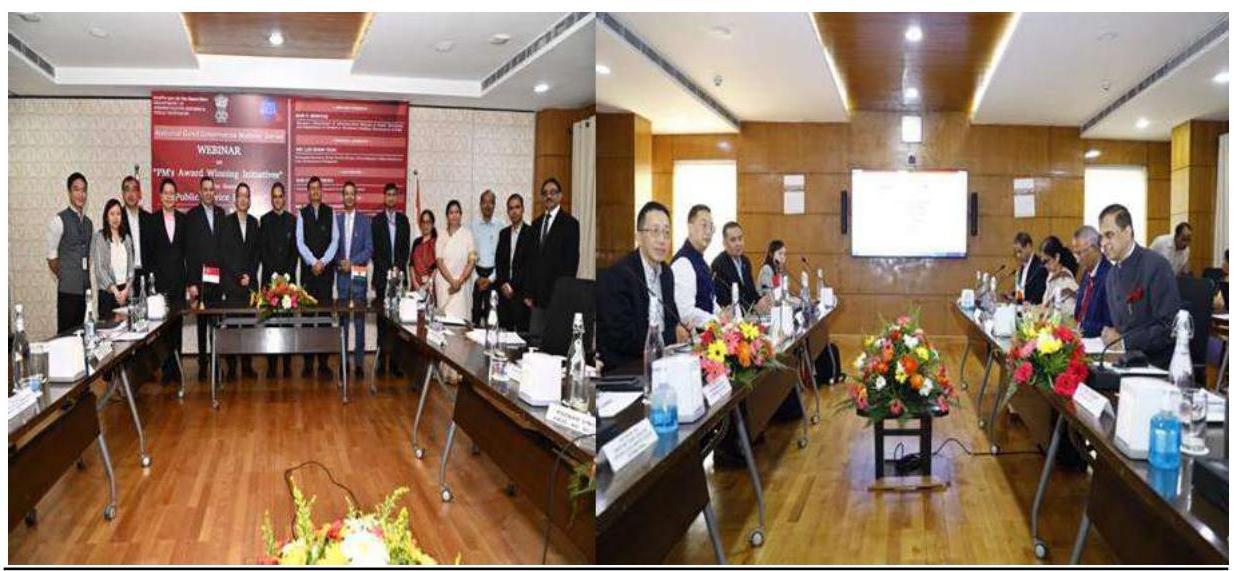
Mr. Loh Khum Yean, Permanent Secretary, PSD also addressed inaugural session of National Good Governance webinar jointly with Secretary (DARPG) on the theme ‘Public Service Delivery held on 30th September, 2022 which was attended by more than 850 participants from all over India.
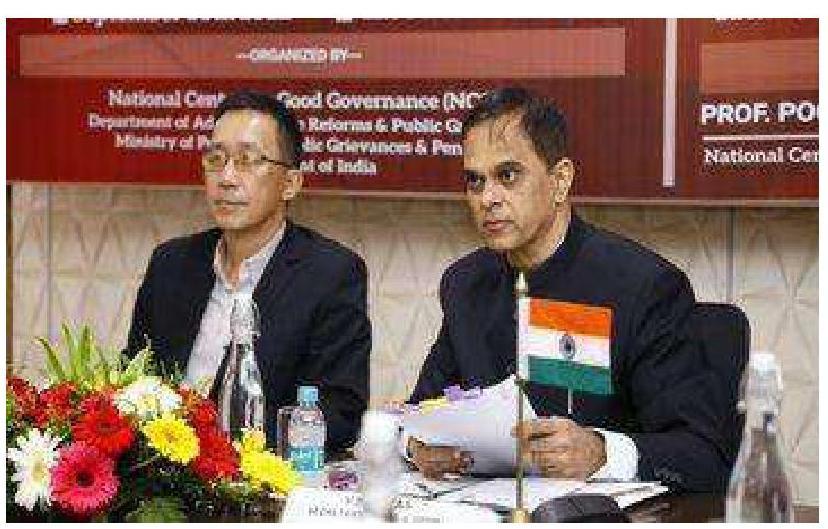
25.3 India Australia Cooperation
25.3.1 A Memorandum of Understanding (MoU) on cooperation in the field of Public Administration and Governance Reforms was signed by the Department with the Australian Public Service Commission (APSC) during India-Australia Virtual Summit held on $4^{\text {th }}$ June, 2020 held between the Prime Ministers of both sides.
25.3.2 The areas of cooperation under the MoU include (i) Promoting transparency and accountability in delivery of public services; (ii) Building effective service delivery in the public service; (iii) Recruitment and promotion in the public service; (iv) Developing a framework for values and competencies; (v) Training and capacity building of the public service; (vi) Public Sector Management and Reform; (vii) Public Grievance Redress Mechanism; (viii) Facilitating short-term foreign training programmes for officers of Government of India or Australia; and (ix) Promoting and utilizing potential of retired government servants.
25.3.3 As part of implementation of MoU, both sides jointly organized a webinar on ‘Work Force Initiatives’ on 24.2.2022 which focused on the following:
a. Workforce up-skilling for core data and digital capabilities, including new ways ofworking.
b. Building data and digital technical talent through up-skilling and re-skilling programs, with a case study on digital career pathways.
25.3.4 First DARPG-APSC Joint Working Group (JWG) meeting under the aegis of the MoU signed between DARPG and APSC, Australia was held on 13-14 October, 2022 in Canberra, Australia
The Indian delegation also visited (a) the Office of the National Data Commissioner which is responsible for overseeing Australia’s Data Availability and Transparency Act 2022 and (b) Services Australia Centre at Belconnen, Canberra to see the implementation of various government services to the Australian citizens.
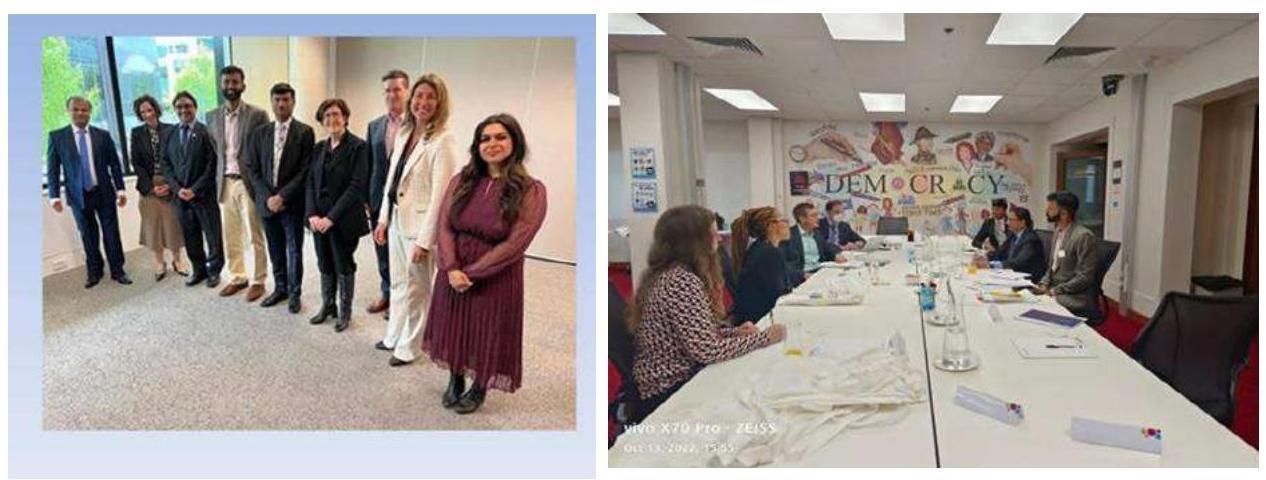
25.4 India-The Gambia Cooperation
A Memorandum of Understanding (MoU) between the Department and the Public Service Commission, Office of the President, The Gambia was signed on $08^{\text {th }}$ July, 2021 on ‘Refurbishing Personnel Administration and Governance Reforms’.
25.4.1 The First meeting of India-The Gambia Joint Working Group (JWG), formed under the MoU, was held virtually between the Department of Administrative Reforms & Public Grievances and the Public Service Commission (PSC) of The Gambia on 22nd November, 2021.
25.4.2 As part of collaboration under the MoU, DARPG successfully organized a oneweek capacity building programme on Public Policy \& Governance for the 25 Senior Civil Servants of the Gambia from 16-17 May, 2022 in New Delhi in collaboration with MEA under the ITEC programme.
25.4.3 Secretary (DARPG) held bilateral meetings with the Vice President H.E. Mr. Badara A. Joof and Mr, Baboucarr O. Joof, Minister of Public Service Administrative Reforms, Policy Coordination and Delivery of the Gambia in New Delhi on 21.07.2022. During the bilateral meetings the Ministers requested for support to their Government in the areas of Capacity Building Public Grievances Portal, Implementation of e-Office/e-HRMS, Pensions Scheme-Bhavishya Portal, e-Recruitment, Sectorial Reforms and Performance Monitoring and e-Governance and Improving Service Delivery.
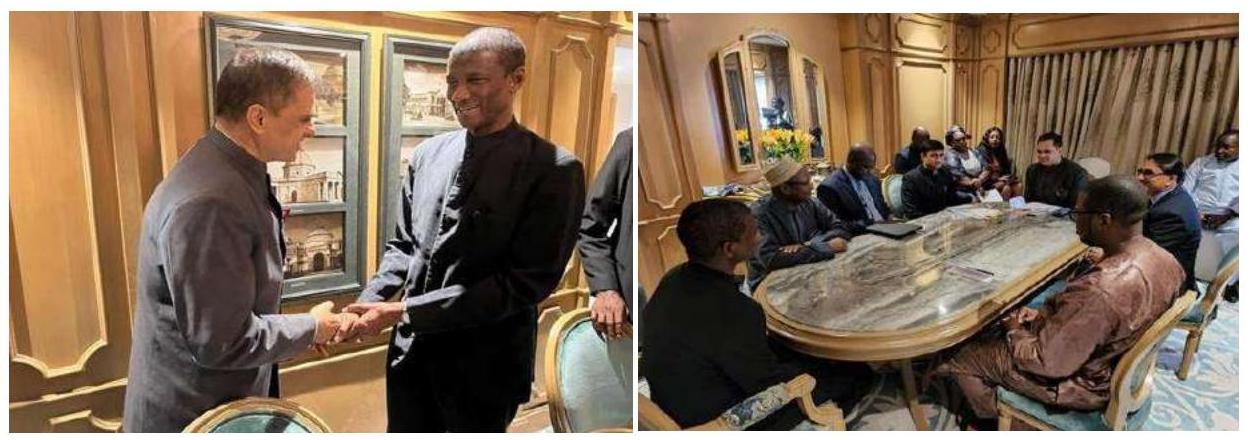
Apart from the above engagements under the MoU, a 12-member Nigerian delegation led by Dr. Folasade Yemi-Esan, Head of Civil Service of Federation met Secretary (DARPG) on 17.6.2022. The meeting was held at the request of the Nigerian Mission in New Delhi received through the Ministry of External Affairs. During the meeting the High Commissioner conveyed their interest in signing an MoU with the Department of Administrative Reforms & Public Grievances for cooperation in areas which include capacity building, sharing of e-governance practices and grievance redressal mechanism.
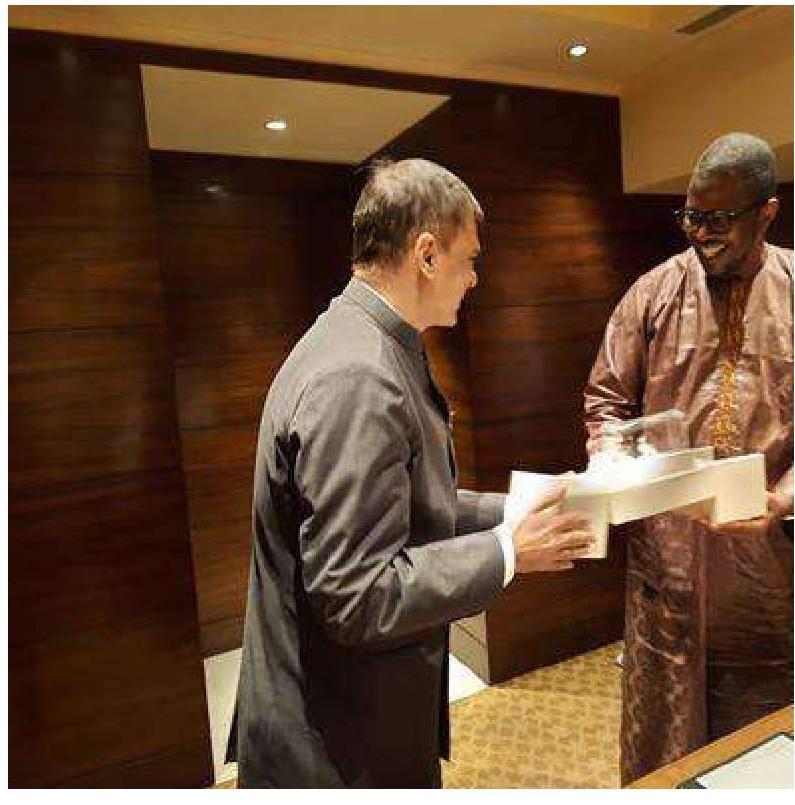
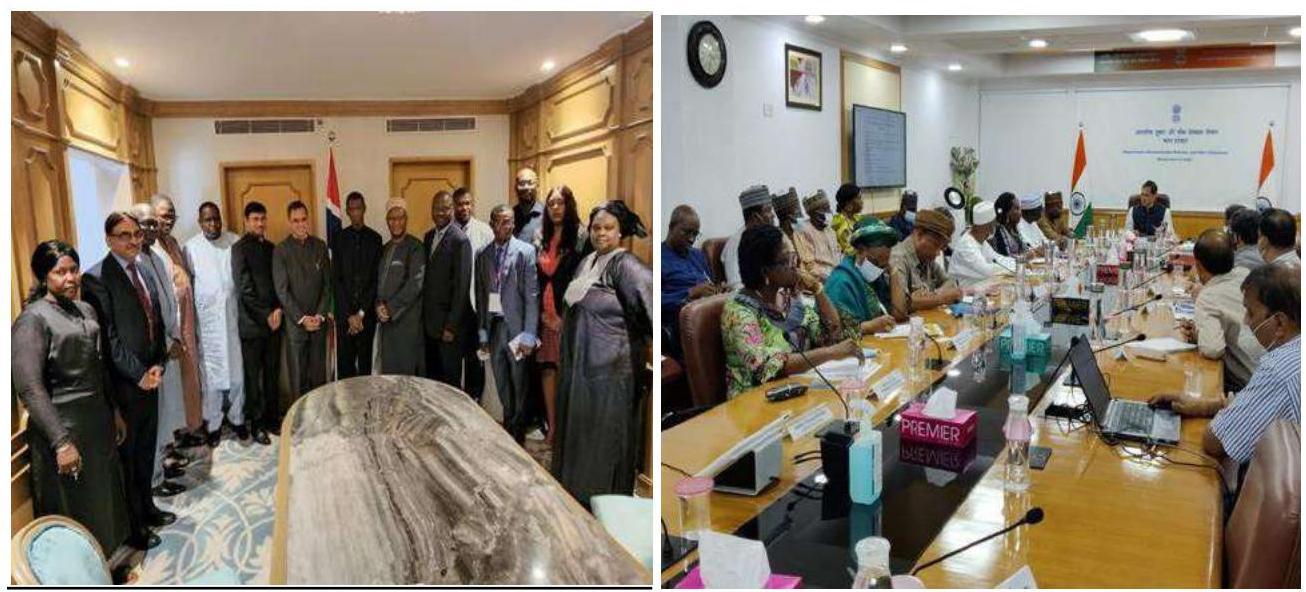
A delegation led by Ms. Kouakou Y. Bécanty Virginie Epse Souame, Communications Administrator from Ivory Coast visited DARPG on 14.12.2022 during which Secretary, DARPG held a talk on ‘e-Governance’ initiatives.
The delegation from Ivory Coast was on a visit to India from 5th Dec to 11th Dec 2022 to attend a development programme under the ITEC programme of MEA.
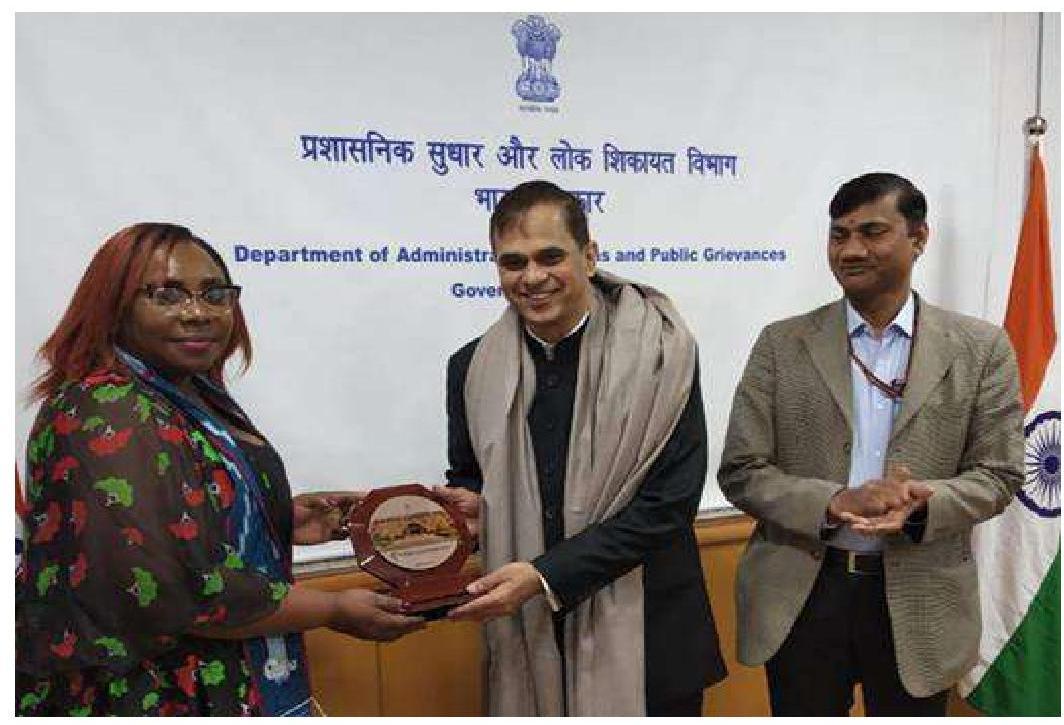
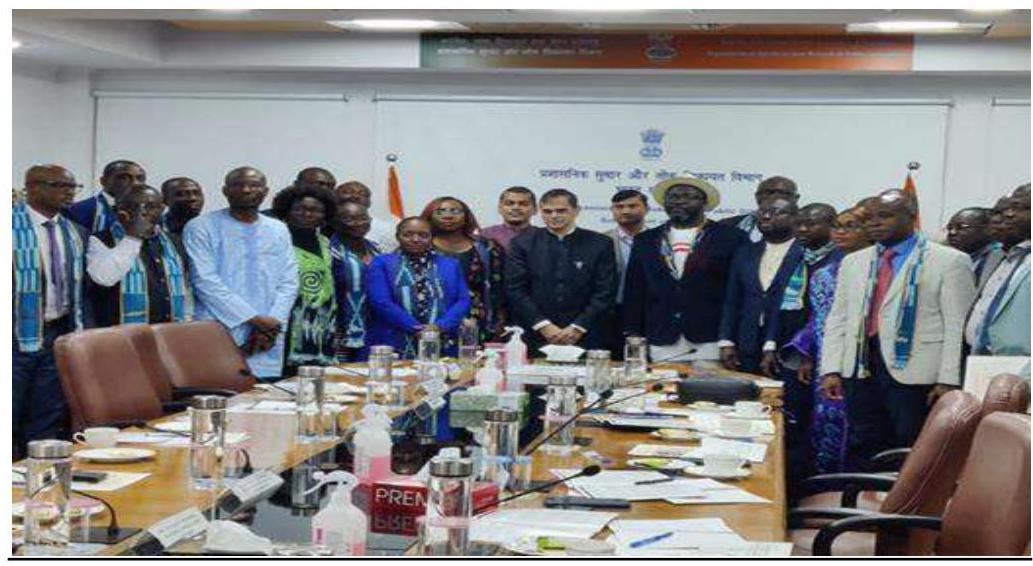
ASSOCIATION WITH MULTILATERAL ORGANIZATIONS IN THE FIELD OFPUBLIC ADMINISTRATION
25.5 Cooperation with International Institute of Administrative Sciences (IIAS)
25.5.1 The Department is an institutional member of the International Institute of Administrative Sciences (IIAS), Brussels, Belgium since 1998. IIAS was established for the purpose of promoting the development of Administrative Sciences, better organization and operation of public administrative agencies, improvement of administrative matters and techniques and for the progress of International Administration. Secretary (DARPG) is presently a member of Council of Administration of IIAS, the highest body in IIAS which ensures the management and direct control of the affairs of the Institute. He is also member of the Finance Committee of IIAS. He was re-elected unopposed as member of the Council of Administration for the second term i.e from 2022-2025 during the meeting of the Council of Administration held on 10.2.2022.
CHAPTER 26
DOCUMENTATION AND DISSEMINATION DIVISION
26.1 The Documentation and Dissemination Division of the Department primarily carries out the activities of documentation and dissemination of good governance practices of Central and State Governments and Union Territory Administration with a view to facilitate sharing of experience with one another and replication elsewhere.
- The Department of Administrative Reforms and Public Grievances organized the Civil Services Day, 2022 at Vigyan Bhawan, New Delhi on $20^{\text {th }}$ and $21^{\text {st }}$ April, 2022. This was the $15^{\text {th }}$ Civil Services Day. The main theme of the event was “Vision India @ 2047Governance: Bringing Citizens and Government Closer”.
During the event, Hon’ble Prime Minister of India also released two e-coffee table books on select initiatives of Priority Programmes and Innovations under the scheme of ‘Prime Minister’s Awards for Excellence in Public Administration 2021.
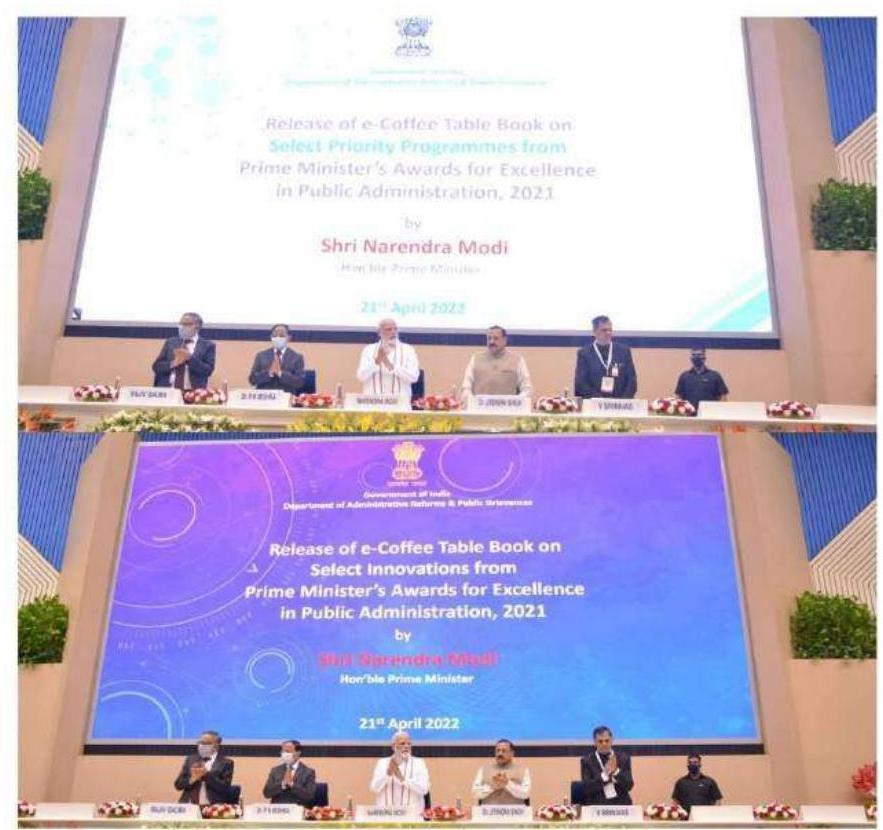
Two documentary films (duration of 10 minutes both) and citation films for Prime Minister’s Awards for Excellence in Public Administration 2019 and 2020 were also showcased in the exhibition during the aforesaid event.
Four Coffee Table Books were also uploaded on the website of DARPG on the select initiatives from Prime Minister’s Awards for Excellence in Public Administration 2019 and 2020.
2. REGIONAL CONFERENCES
The DARPG organizes Regional Conferences (RCs) in collaboration with the State Governments to provide a platform to the officers of the Central and State Governments to share their experiences in the formulation and implementation of good governance initiatives. 4 Regional Conferences held in the different parts of country since Jan, 2022 to till date: –
i. A Symposium on ‘Imagining India @2047 through Innovation’ at Research Park, Chennai was held in collaboration with IIT Madras on 7-9th MARCH, 2022. The symposium was an effort to bring the Government and Citizens together by use of digital technology pursuing next generation reforms and innovations with policy objective of “Maximum Governance, Minimum Government”, entailing Government process Re-Engineering, Universal access to e-services, excellence in digital initiatives at district level and excellence in adopting emerging technologies and use of ICT management. The Government of India is formulating “Vision India@2047” to identify long terms goals and corresponding short term defined outcomes for this decade with timelines and milestones. The vision is being developed without being constrained by current institutional framework and suggests appropriate structural and institutional reforms to attain the envisaged vision.
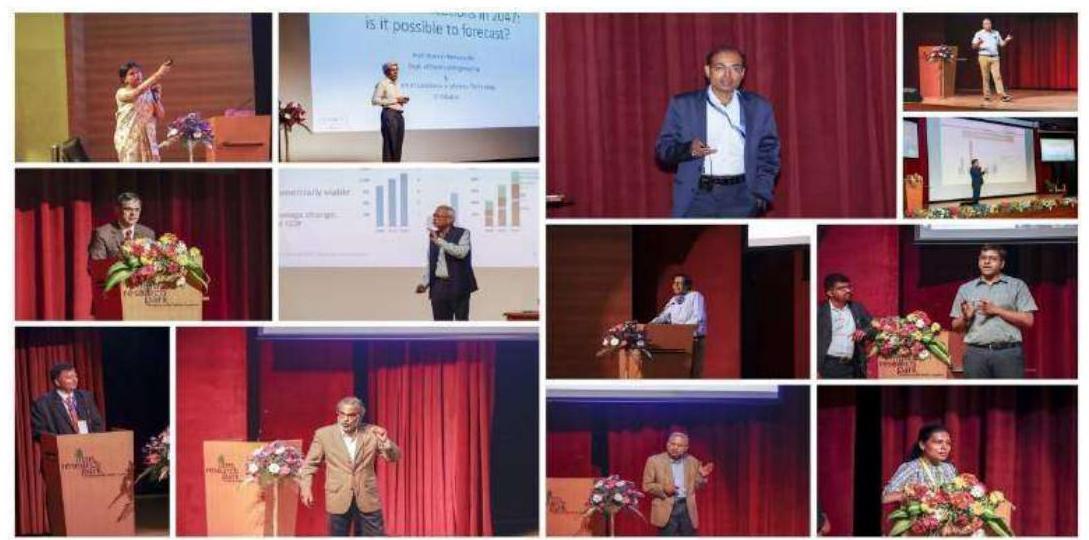
ii. Department of Administrative Reforms & Public Grievances in collaboration with UT of Jammu \& Kashmir organized a two-day Regional Conference on the theme “Bringing Citizens and Government Closer – Through Administrative Reforms” at Srinagar on May $16-17^{\text {th }}, 2022$.
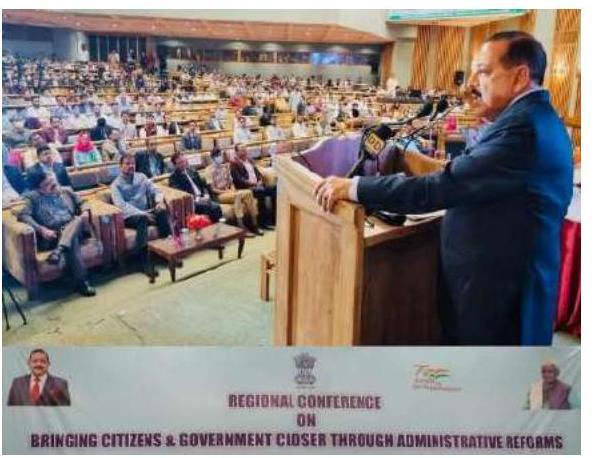
iii. Department of Administrative Reforms & Public Grievances in collaboration with Government of Karnataka organized a 2 day Regional Conference on the theme “Bringing Citizens, Entrepreneurs And Government Closer For Good Governance” involving at Bengaluru on July 11-12, 2022.
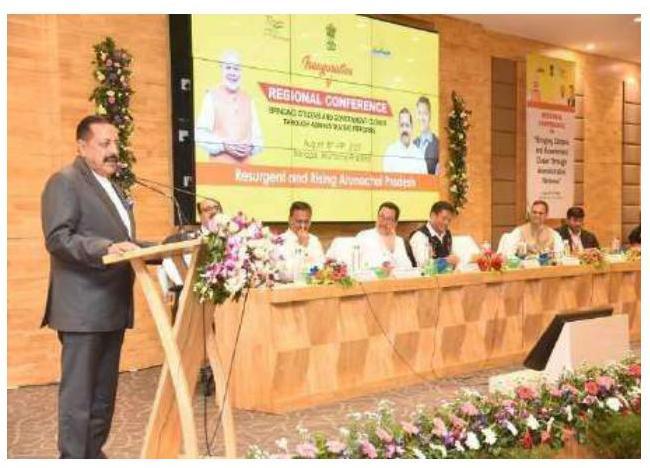
3. DARPG made 3 short films on Special campaign 2.0. These films were telecasted 4 times on DD NEWS and also on Regional Language channels. The Special Campaign 2.0 was given coverage on All India Radio also. Two Panel discussions on Special campaign were also telecasted on DD NEWS: –
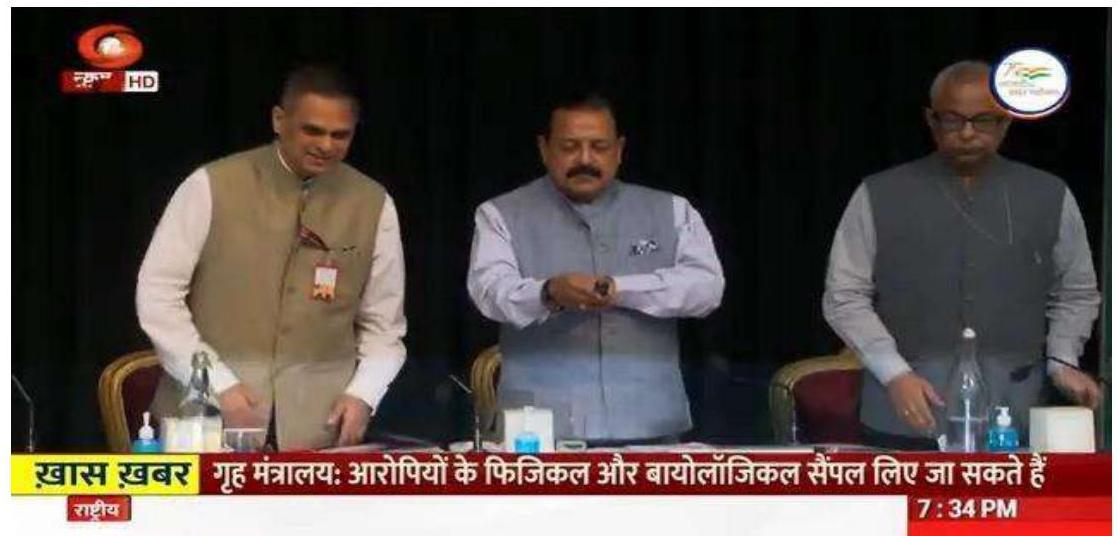
i. First Panel Discussion Telecasted on DD News on 20.09.2022 with Secretaries of $\mathrm{M} / \mathrm{o}$
Women & Child Development, M/o Road Transport \& Highways and Department of Administrative Reforms \& Public Grievances
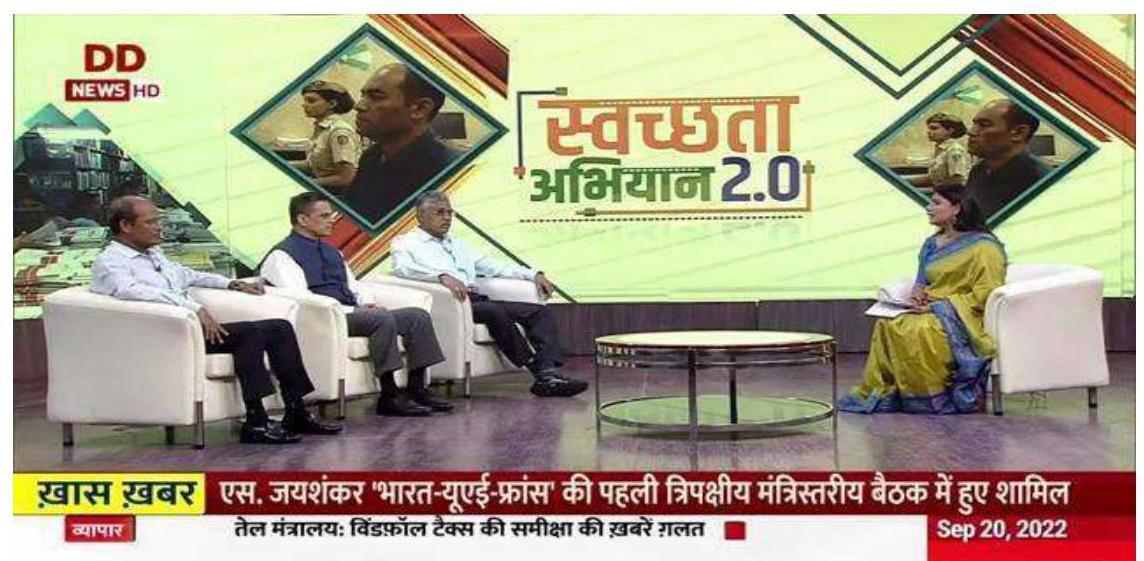
ii. Second Panel discussion telecasted on DD News on 20.10.2022 with Secretaries of Department of Agricultural Research and Education, Posts and Railway Board.
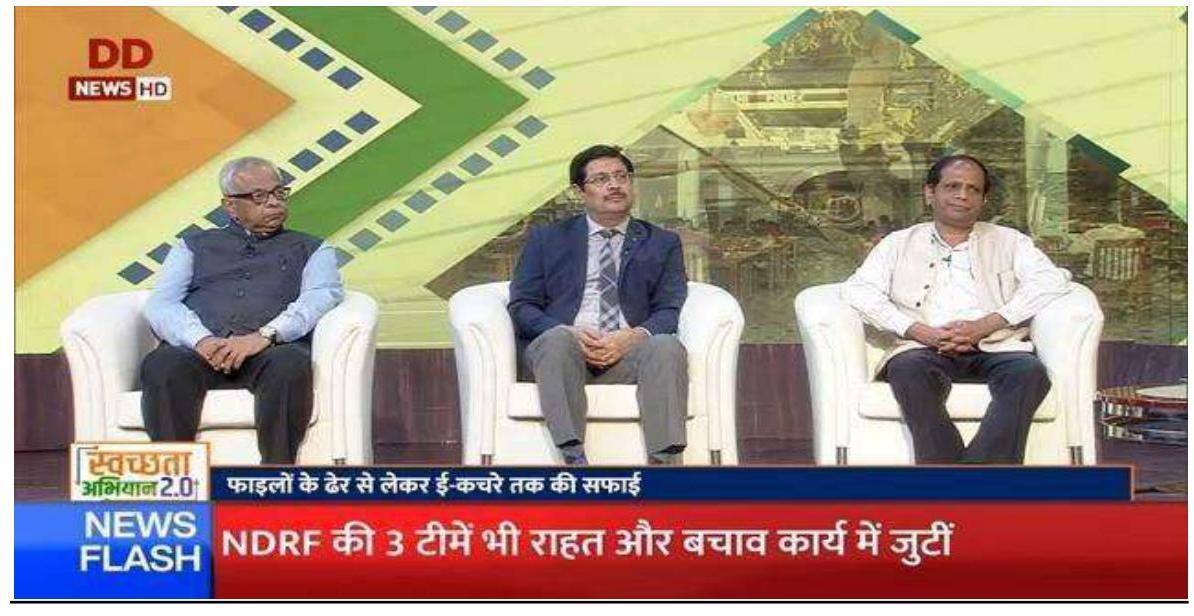
4. One documentary film of 5-7 minute duration in Hindi language on Special Campaign
2.0 were produced and screened.
5. One documentary film of 5-7 minute duration in Hindi language and citation films (18) of duration 30-45 seconds each in Hindi language were produced and screened during 25th National Conference on e-Governance on 26-27th November, 2022 at Katra, Jammu.
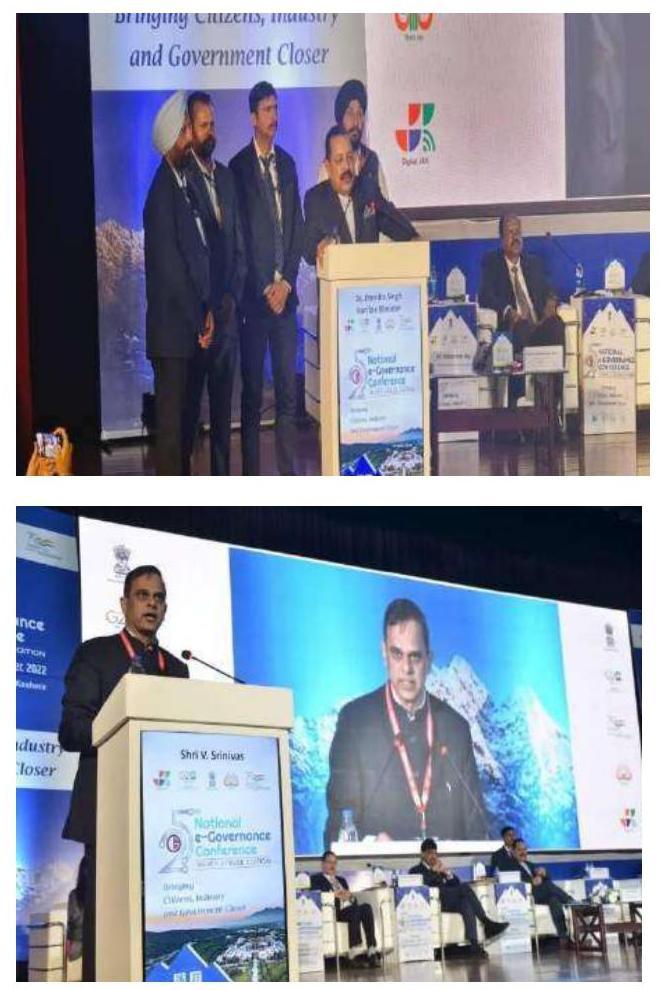
6. One documentary film of 5 minute duration in Hindi language on Good Governance Week was produced and screened on $19^{\text {th }}$ Dec, 2022.
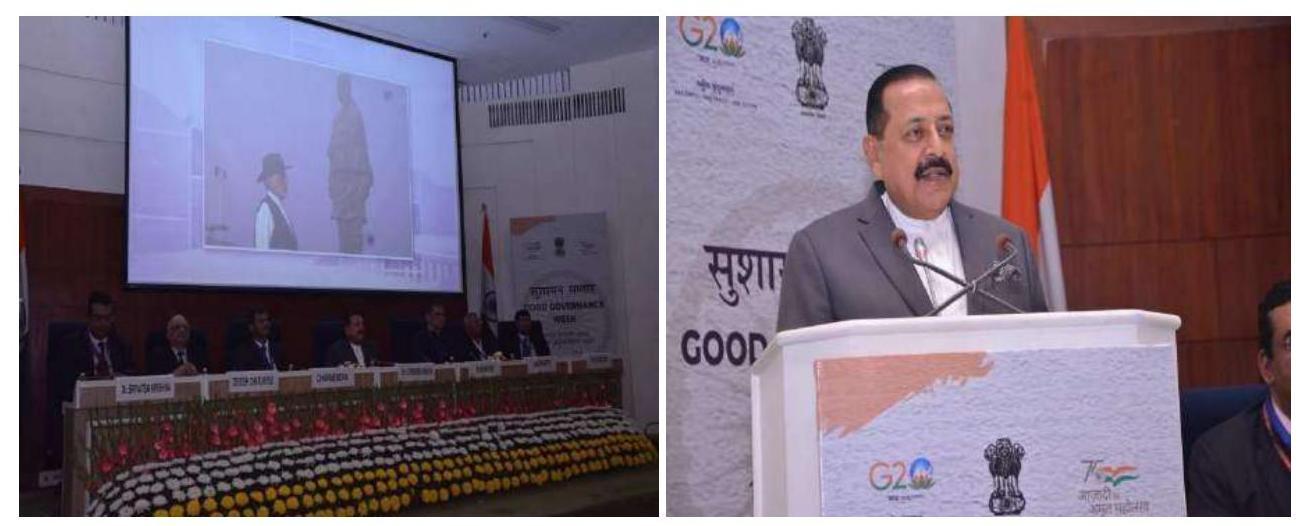
6) Good Governance Week- 2022:
The Government celebrated the week December 19-25, 2022 as the Second Sushasan Saptah (Good Governance Week) in Amrit Kaal Period. Hon’ble Prime Minister extended his greetings and best wishes to everyone associated with the initiative. The Hon’ble Prime Minister said that “It is heartening to note that this year too, the Prashasan Gaon ki Ore campaign continues to be a part of the Good Governance Week.”
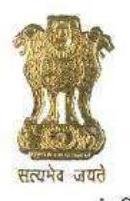
प्रधान मंत्री
Prime Minister
MESSAGE
It is heartening to learn about the Second Sushasan Saptah (Good Governance Week) being observed from December 19-25, 2022. Greetings and best wishes to everyone associated with this initiative.
It is particularly pleasing to note that this year too, the ‘Prashasan Gaon Ki Ore’ campaign continues to be a part of Good Governance Week.
Guided by the principle of ‘Citizen-First’, our Government is striving tirelessly to make the ecosystem transparent and faster by simplifying procedures and processes at every level.
We have undertaken various citizen-centric initiatives including redressal of public grievances, online services, disposal of service delivery applications and good governance practices. Our vision is to expand the outreach of service delivery mechanisms, making them more effective.
Technology has immense potential to bring the government and citizens closer. Today, technology has become a powerful tool to empower citizens, as well as a medium to optimise transparency and accountability in day-to-day functioning.
Through various policy interventions, we are strongly marching ahead towards digital empowerment of citizens and digital transformation of institutions.
It has always been our endeavour to increase the impact of governance, but reduce the interference of the government in every citizen’s life. The scrapping of thousands of unnecessary compliances, repealing of thousands of outdated laws and decriminalisation of many kinds of minor offences are major steps towards this end.
The people have resolved to build a glorious and self-reliant India during Amrit Kaal of next 25 years. The government’s role is to complement the people’s resolve by being an enabler in their efforts. Our role is to increase opportunities and remove obstacles from their path.
I am sure that the Second Sushasan Saptah will help in furthering good governance at every level. May the Good Governance Week celebration succeed in its endeavour.
New Delhi
अग्रहायण 21, लक संवत् 1944
$12^{\text {th }}$ December, 2022
Hallmark event of GGW 2022 was a weeklong Nation-wide campaign ‘Prashasan Gaon Ki Ore 2022’ from December $19^{\text {th }}-24^{\text {th }}, 2022$, aimed at resolving public grievances and delivery of services to the people at their doorstep. On December 19, 2022, Dr. Jitendra Singh, Minister of State for Personnel, PG and Pensions, launched the second Nation-wide campaign “Prashasan Gaon Ki Ore”, in an event attended by District Collectors, ChiefSecretaries / Additional Chief Secretaries and AR Secretaries of 36 States / UT’s and Senior Officials from Central Ministries / Departments,
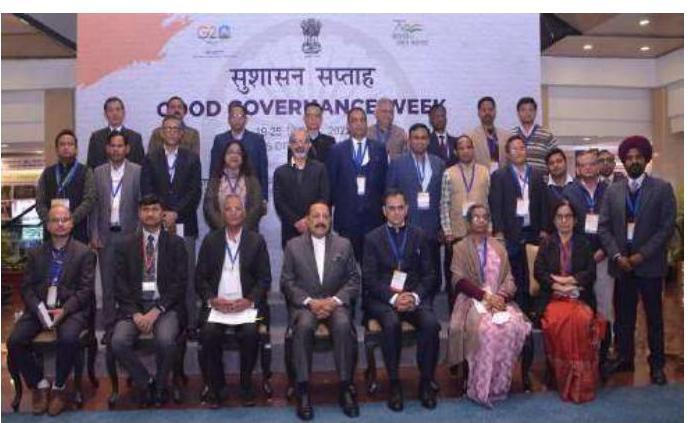
During the Prashasan Gaon Ki Ore Campaign District Collectors organized special camps / events at Tehsil Headquarters / Panchayat Samitis to resolve public grievances and for improved service delivery. The campaign witnessed redressal of over 54 lakh public grievances, disposal of over 314 lakh service delivery applications and documentation of 982 innovations in governance by the Districts of all States and UTs. The campaign was monitored centrally on a real time basis through a Dashboard created for this purpose on the ‘Prashasan Gaon Ki Aur’ Portal (URL: www.pgportal.gov.in/GGW22).
An exhibition on the theme “Shasan Ki Badalti Tasveer” was also organized to showcase achievements of the Government in promoting good governance including achievements made during Special Campaign 2.0. Booklet on achievements of Good Governance Week
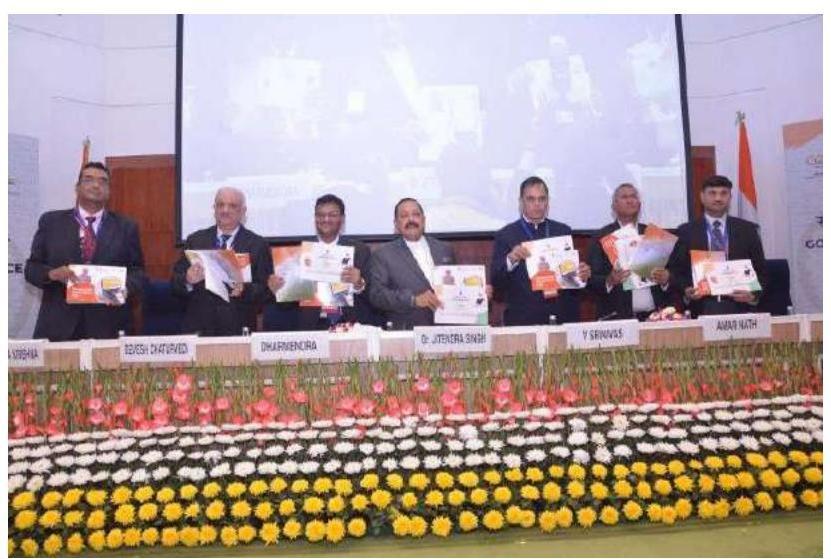
2021 and Annual Report of CPGRAMS 2022 were also released on this occasion.
On December 23 rd , 2022, District Level Workshops were held in all States/UTs to deliberate on best good governance practices in the District / innovations and vision India@2047. The District level workshops were chaired by a senior retired IAS officer who had served as District Collector in that District. Chief Ministers of States/ LG’s of UT’s also supported the Prashasan Gaon ki Ore Campaign with regular messages and tweets. The Parliamentary Standing Committee of Ministry of Personnel, PG and Pensions in its $121^{\text {st }}$ Report has also commended the phenomenal success of Prashasan Gaon Ki Ore Campaign held in the year 2021 and recommended that such campaigns should be held more
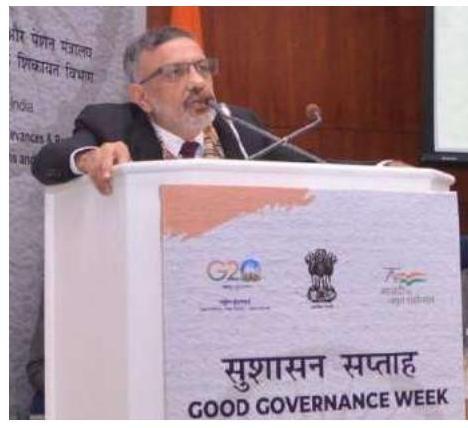
frequently.
On $23^{\text {rd }}$ December, 2022, Cabinet Secretary chaired a workshop on Good Governance Practices in Vigyan Bhawan, with an experience sharing session on Special Campaign 2.0 and the Initiative for Increasing Efficiency in Decision Making in which more than 500 senior Officers from all Ministries / Departments participated. The Workshop deliberations envisaged accelerated efforts across Ministries / Departments in
creation of fully digital Central Secretariat, effective delayering / delegation / adoption of desk officer system. Cabinet Secretary complemented all Ministries / Departments for the inspirational work undertaken in implementation of Special Campaign 2.0 and recommended that the best practices may be shared with States.
CHAPTER 27
HINDI SECTION
27.1 Hindi Section of the Department of Administrative Reforms and Public Grievance is committed to comply with various guidelines issued by the Department of Official Language to promote the usage of Hindi language in the office.
27.2 The main function of the Section is to render Hindi translation of the works relating to implementation of the official language Policy. These mainly pertain to collating of quarterly reports from various sections of the Department consolidating and furnishing to the D/o Official Language; translation and typing of Parliamentary related work Cabinet / CoS Notes etc. In addition, all the officers / sections are made aware of the guidelines issued from time to time by the D/o Official Language relating to promotion of usage of Hindi and ensure their compliance in the Department as and when required.
27.3 Hindi Pakhwara was organized during September $14^{\text {th }}-28^{\text {th }}, 2022$ in the Department. During this period, various competitions on Essay writing, Noting drafting, Hindi Dictation, etc., were conducted for which the winners were awarded cash prizes.
27.4 The Department has attended meetings organized by Department of Official Language, Ministry of Home Affairs on various topics regarding implementation of Official Language policy for Ministries/Departments.
27.5 The website of Department of Administrative Reforms and Public Grievances has been updated and made bilingual.
27.6 Two Workshops were organised in the Department on 17.06.2022 and 11.11.2022 to promote the usage of Hindi language in the office.
CHAPTER 28
DEPARTMENT OF PENSION AND PENSIONERS’ WELFARE
28.0 The Department of Pension & Pensioners’ Welfare was set up in 1985 as part of the Ministry of Personnel, Public Grievances and Pensions to formulate policy and coordination of matters relating to retirement benefits of Central Government employees. Being the nodal Department for pension and pension related matters, the Department receives a large number of references from Ministries/ Departments and also renders advice on interpretation of Pension Rules. In 2007, the Department initiated a web-based scheme entitled – Pensioners’ Portal- which has now been expanded to run all pension welfare activities of Central Government Pensioners.
28.1 The Allocation of Business Rules broadly allocates the following areas of working to the Department:- Formulation of policy and co-ordination of matters relating to retirement benefits to Central Government employees. The Central Civil Services (Pension) Rules, 2021; the Central Civil Services (Implementation of National Pension System) Rules, 2021; the Central Civil Services (Payment of Gratuity under National Pension System) Rules, 2021; the Central Civil Services (Commutation of Pension) Rules, 1981; the Central Civil Services (Extraordinary Pension) Rules, 1939; any other scheme relating to Central Government pensioners, entrusted to the Department; pension structure and relief to pensioners; new facilities of fringe benefits to the Central Government pensioners; matters relating to amendment to or relaxation of Pension rules or any other rule concerning retirement benefits; Policy and co-ordination relating to welfare of Central Government Pensioners. Matters with financial implication shall be subject to the concurrence of Ministry of Finance. Action in respect of other matters involving recurring financial implications by way of relaxation or liberalization of any rule shall be subject to guidelines as agreed to between the Department of Pension and Pensioners’ Welfare and the Ministry of Finance, Department of Expenditure.
28.2 The approximate number of Central Government Pensioners as on $31 / 12 / 2022$ is as follows:
| S. No. | Pensioner/Family Pensioner | Number of Pensioners including Family Pensioners |
|---|---|---|
| A. | Pensioners (incl Family Pensioners) of all Ministries/ Departments under the Accounting jurisdiction of Controller General of Account, M/O Finance. (Central Pension Accounting Office (CPAO), Department of Expenditure, Ministry of Finance is responsible for maintaining the pensioners’ data and incurring expenditure on accounts payment of pension/family pension. Civil Ministries include all the CAPFs viz. BSF, CRPF, Assam Rifles, SSB, CISF, ITBP under MHA as well.) |
$11,28,441$ $(3,40,549)$ |
| B. | Defence Pensioners (incl Family Pensioners) (The data and accounts etc. of these pensioners are maintained by Controller General of Defence Accounts (CGDA), Ministry of Defence. |
$\begin{aligned} & 36,03,609 \ & (2,92,769) \end{aligned}$ |
|---|---|---|
| C. | Railway Pensioners (incl Family Pensioners) (The data and accounts etc. of these pensioners are maintained by Ministry of Railways) |
$\begin{aligned} & 14,82,223 \ & (6,40,000) \end{aligned}$ |
| D. | Telecom Pensioners (incl Family Pensioners) (The data and accounts etc. of these pensioners are maintained by Department of Telecommunication) |
$\begin{aligned} & 4,32,968 \ & (1,06,952) \end{aligned}$ |
| E. | Postal Pensioners (incl Family Pensioners) (The data and accounts etc. of these pensioners are maintained by Department of Posts) |
$\begin{aligned} & 3,28,999 \ & (1,05,869) \end{aligned}$ |
| GRAND TOTAL OF PENSIONERS (incl Family Pensioners) | $69,76,240$ | |
| GRAND TOTAL OF FAMILY PENSIONERS ONLY | $14,86,139$ |
- As per the data received from the CPAO, Defence, Railways, Telecom & Posts
28.3 Pensioners’ Portal:
The scheme, ‘Pensioners Portal’ was started with an objective to serve as a one stop information source for the pensioners of Government of India and also facilitate redressal of their grievances online. With the passage of time, new activities were added under the ‘Pensioners Portal’ which now includes CPENGRAM, Bhavishya, Anubhav and Sankalp etc. with an objective to create a single window system for civil pensioners.
Pensioners’ Portal through its website provides pensioners with updated information on pension rules, personalized pension road map, online calculator for calculation of pension/family pension and redressal of Pensioners’ grievances through CPENGRAM. With effect from 01.01.2017, for ensuring transparency and accurate and timely settlement of pension dues it was made mandatory for all Ministries/ Departments to process pension cases on Bhavishya. Experiences of retirees while working in the government are being preserved in Anubhav which has become a treasure-house of information pertaining to various departments. Sankalp aims to prepare employees for post-retirement life.
28.4 BUDGET –
In the year 2022-23, Department has been allocated Rs 1250.00 Lakhs to meet its expenses.
| Secretariat General Service | RE (Rs. in lakhs) |
|---|---|
| Salaries | 700.00 |
| Wages | 1.00 |
| Over Time Allowances | 1.00 |
| Medical Treatment | 10.00 |
| Domestic Travel Expenses | 10.00 |
| Foreign Travel Expenses | 15.00 |
|---|---|
| Office Expenses | 135.00 |
| Publication | 10.00 |
| Other Administrative Expenses | 5.00 |
| Minor Works | 56.00 |
| Professional Services | 12.00 |
| TOTAL | $\mathbf{9 5 5 . 0 0}$ |
| Pensioners Portal (Scheme ) | RE (Rs. in lakhs) |
| Salaries | 1.00 |
| Domestic Travel Expenses | 20.00 |
| Office Expenses | 90.00 |
| Advertising &Publicity | 140.00 |
| Professional Services | 167.00 |
| Grants-in-Aid | 35.00 |
| Other Charges | 2.00 |
| TOTAL | $\mathbf{4 5 5 . 0 0}$ |
28.5 Strengthening Pensioners’ Grievance Redressal Machinery (CPENGRAM)
- The Department of Pension \& Pensioners’ Welfare (DOPPW) being the nodal department for formulation of policies relating to pension also provides a platform to redress grievances pertaining to pensioners through CPENGRAMS which is an online grievance registration and redressal portal.
- On this portal the pensioners can register their pension related grievances pertaining to any of the Central Government Departments/Ministries, which is then forwarded to the concerned Ministry/Department for redressal within a time frame of 30 days.
- Earlier, pensioners had the option to their grievancesregistered by sending a mail, post or getting it registered online in the CPENGRAMS Portal. In 2019, Pensioners’ grievance redressal system was expanded with the objective to provide easy access to pensioners in registering their grievances. For ease of lodging grievances, voice call was the simplest of options for many aged pensioners. Especially family pensioners were not conversant with online technology. Therefore,an Integrated Grievance Cell \& Call Centre was inaugurated on $20^{\text {th }}$ June, 2019 for pensioners so that they could register their grievances by calling on the toll-free number 1800-11-1960. The Call Executives register the grievance on CPENGRAMS, after taking inputs from pensioners, and thereafter it is forwarded to the concerned Ministry/Department online for redressal.
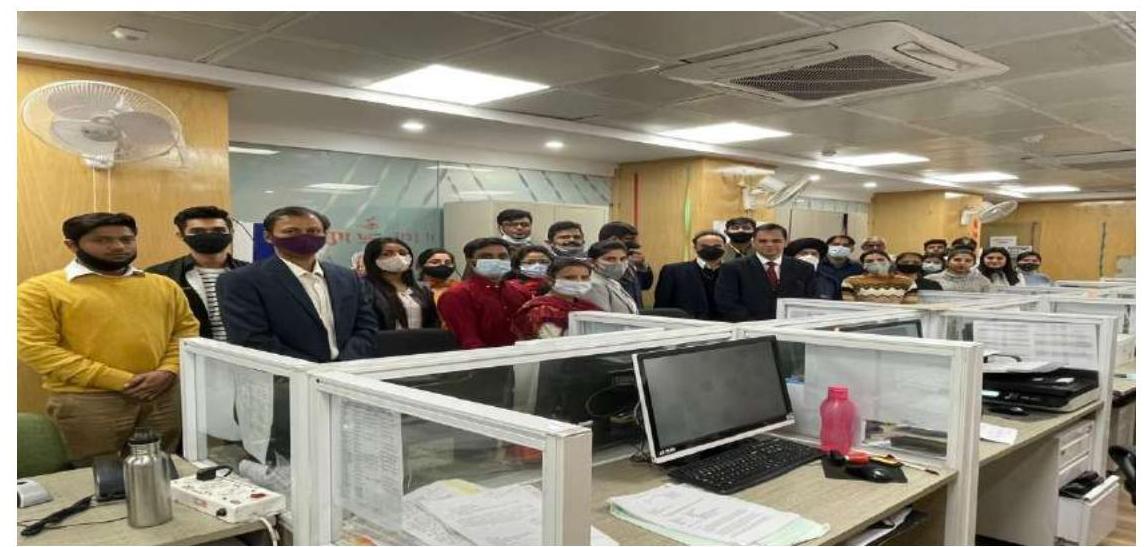
Visit of Secretary (Pension&PW) to DoPPW Integrated Grievance Cell \&Call Centre at Janpath Bhawan, New Delhi.
- This Centre also coordinates with different Ministries/Departments to resolve the problems of the elderly pensioners and keep the pensioners informed about the progress of their grievances.
- It is pertinent to mentioned that the DOPPW Toll free call center was functional from home during lockdown due to Covid-19 Pandemic. Although the inflow of pension grievances in physical form/postal mail now $\mathbf{6 . 7 7 %}$ in overall receipts, the number of pensioners/family pensioners using the facility of Call-Centre is increasing continuously and as on 31.12.2022 more than 27616 grievances have been registered by Call Executives since its inception.
- Total number of grievances registered were 40115 from 01.04.2022 to 31.12.2022, out of which 36964 grievances were disposed of ( $92.14 \%$ ). During the period 01.04.2022 to 31.12.2022, $91.21 \%$ grievances were disposed of within 45 days. Out of total registered grievances $74.03 \%$ (approx.) were received online, $18.15 \%$ through call center via the toll free no of DOPPW 1800-11-1960 and $6.77 \%$ by post. Considering, the popularity of the toll-free number and ease of registering grievances, it was felt prudent to continue and expand this facility in future too.
– Anubhav Portal
Anubhav Award
On the directions of the Prime Minister of India, Department of Pension \& Pensioners’ Welfare (DoPPW) had launched an online platform entitled ‘Anubhav’ in March 2015. It is a means for retiring employees to showcase significant achievements made during their service period. It also provides them with an opportunity to convey information related to their contribution in enhancing the effectiveness of the various Government policies. Anubhav Portal provides a Platform to retiring Government Employees for sharing their experiences while working in different Ministries/Departments of the Government of India.
92 Ministries/ Departments/ Organizations have registered on Anubhav Portal of this Department and 8722 write-ups have been published as on 30.09.2022. The retiring employees submit a write-up voluntarily of up to 5000 words along with appropriate attachments, if needed, on the portal. The retiring employees can submit the write-up on any
of the 20 defined areas. The Anubhav Awards ceremony was started from 2016 as an annual feature to encourage retiring government employees to share their government experience on their retirement. The awards constitute a Medal, a Certificate and a cash prize of Rs. 10,000. Earlier Four Anubhav Award ceremony held on 2016, 2017, 2018 and 2019 and DrJitendra Singh, Hon’ble Minister of State (PP) conferred Anubhav Awards to 35 awardees.
This year DrJitendra Singh, Hon’ble Minister of State(PP) conferred Anubhav Awards to 15 awardees (5 Awards each for year 2019-2020, 2020-2021 & 2021-2022) in a Anubhav Award ceremony held on 18.10.2022 at VigyanBhawan, New Delhi. The awardee are from Ministry of Defence (DRDO), Department of Post, Department of Pension \& PW, Department of Space, MHA(CRPF).
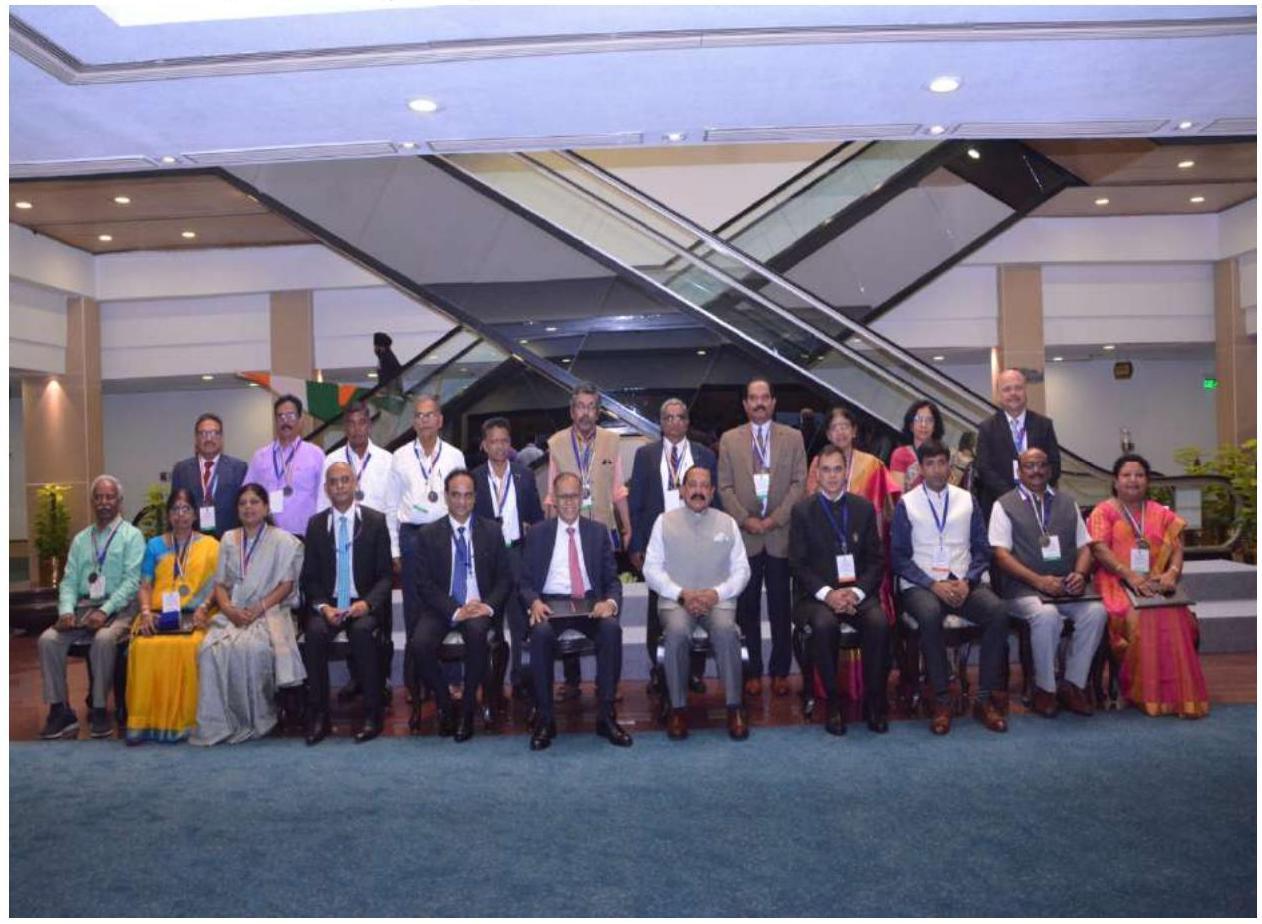
– Nationwide “Anubhav Awardees Speak” Webinar Series
The webinar series aims to facilitate experience sharing with relevant stakeholders and concerned Ministries/Departments/Organizations. It is envisaged that this culture of leaving notes by retirees will become the foundation stone of good governance and administrative reforms in future.
So far two webinars have been held. The inaugural webinar was held on 22.11.2022. Sh. Santeppa K, Scientist – H, DRDS [Anubhav Awardee, 2020] and Ms. Helen Basil, Scientist, D/o Space [Anubhav Awardee, 2022] shared their experience. The Second Webinar of the series was held on 22nd of December, 2022 featuring Dr. T Sekar, CAPF, Inspector General of Police [Anubhav Awardee, 2021] and Ms. Nagalakshmi N, P\&TAFS, D/o Posts [Anubhav
Awardee, 2021] as lead speakers. About 1180 participants have already attended the webinars.
Subsequent webinars will take place on a monthly basis. The webinar series will feature two previous Anubhav Awardees as speakers to share their experience and to motivate/raise awareness among retiring employees on filling up their own experiences on the Anubhav Portal.
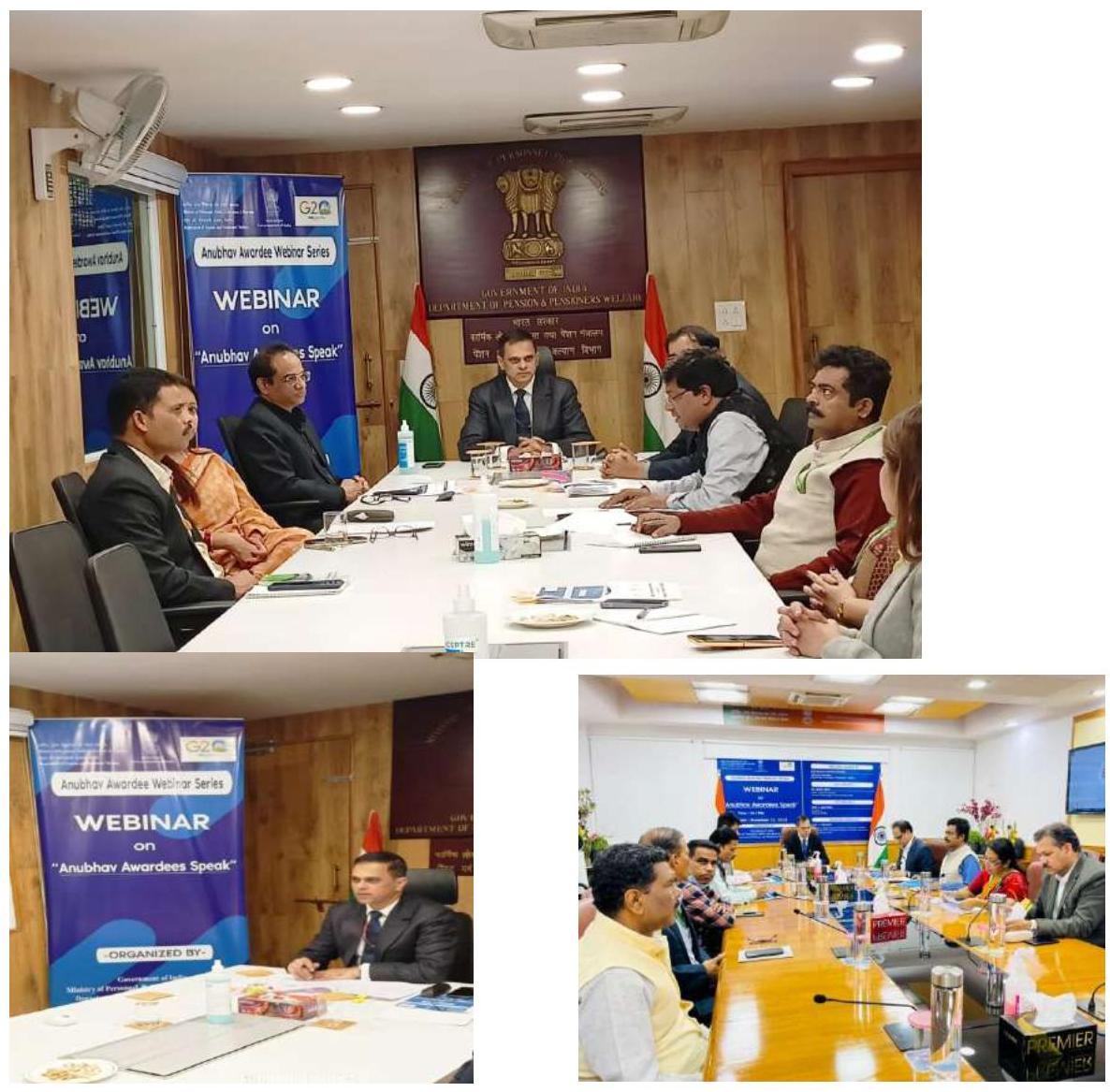
28.6 Pension Adalat:
- Pension Adalat is a concept to provide a single platform where the concerned stake holders, viz., ministry/departments/organization/CPAO /bank could be brought together for expeditious resolution of long pending grievances to the satisfaction of the petitioner.
- The concept of All India Pension Adalat was introduced in 2018 wherein Pension Adalats were conducted across Ministries/Departments on a single day throughout the country including all the Central Armed Police Forces as well as non-Civil Ministries viz., defence, railways, telecom and posts. This was one of the largest pensioner grievance resolution exercises ever undertaken in the Country. In $7^{\text {th }}$ All India Pension Adalat which was held on first week of May, 2022, by leveraging technology through Video Conferencing. Out of 1732 cases taken up in the Pension Adalat, 1112 cases were resolved on the spot by the different Ministries/Departments/ Organisation which participated in this initiative.
Till date seven Pension Adalats have been conducted by DoP&PW and out of 22000 taken up in the Pension Adalat, 16000 grievances were resolved by the different Ministries/Departments/ Organisation which participated in this initiative.
28.7 Digitization of Pension Sanction and Payment Tracking System
- During the analysis of grievances registered at CPENGRAMS, it is found that around substantial number of grievances are received due to delay in release of first pension/family pension. Therefore, DoPPW took initiative to achieve complete digitalization of the pension payment process from start to finish, wherein the start is online filling of pension forms by the retiree and the finish is to issue of e-PPO which reaches the Digi-locker of the Pensioner and credit of the first pension in pensioner’s account.
The ‘Bhavishya’ System
- To overcome the problems of delay \& clerical errors in processing the pension cases, duplication as well as financial loss and harassment to the pensioners, the DOPPW introduced, on a pilot basis, a unique innovative centralized pension processing software called ‘Bhavishya’ for all central government Ministries/Departments.
- After a successful pilot, Bhavishya’ was made mandatory for all central civil Ministries and Departments w.e.f 01.01.2017. At present, 97 Ministries/ Departments, 817 Offices and 7920 DDOs are on Board. The ‘Bhavishya’ software was indigenously made by the Department of Pension \& Pensioners’ Welfare and was meant to be a common platform for processing of pension cases by all civil Ministries/Departments of Government of India.
- At a Glance (on 01.12.2022):
| S. No. | Items | Numbers |
|---|---|---|
| 1. | No. of Ministries/Departments on-board | 97 |
| 2. | No. of Attached/Subordinate Offices on-board | 817 |
| 3. | No. of DDOs registered | 7920 |
|---|---|---|
| 4. | No. of pension cases under process | 38412 |
| 5. | No. of cases processed/PPO issued | 179764 |
| 6. | No. of Training programmes | 316 |
| 7. | No. of Participants attended the Training | 7479 |
- This software brought all the stakeholders who were till date decentralized on a single platform. The system laid down a common methodology incorporating all the rules and regulations of CCS Pension Rules, 1972 (now, CCS (Pension) Rules, 2021) and automatic calculation of pension and other retirement dues.
- From the pay roll/EIS, the ‘Bhavishya’ software was integrated and would auto fill all the data of the retiring employees and at the beginning of the year provide the necessary MIS to the various departments as well as to the DOPPW the number of employees due to retire in the coming year.
- The software has laid down strict timelines for various stages of pension processing across all stakeholders involved. The process starts online 15 months prior to retirement and the pensioner has to fill up a single form once. The system on its own keeps throwing up alerts to the pensioner as well as to the stakeholder for meeting out the deadlines prescribed for various stages.
- Due to the system being digital, there is no duplication of entries and the retiring staff need not leave his office work and run from desk to desk chasing his case. The pension calculation cutting across all Ministries/Departments is accurate since it removes manual intervention. Through this system, any office can directly contact the DOPPW for any clarification, if necessary. It has resulted in saving of huge manpower and time cutting across all Ministries.
- Every department through this software can assess in the beginning of the year the number of retirees and this feature is also visible to DOPPW for all retiring central civil pensioners across Government of India. The system is capable of giving real time data of pension processing of central civil retirees up to the stage of first credit of pension in their respective bank’s accounts.
- The ‘Bhavishya’ process have also been integrated with the PFMS module of CGA and due to this it has now become possible to issue electronic PPOs (e-PPO). At present, the Data from Bhavishya is being provided/ transferred to PFMS for 489 PAOs. 1, 13,807 e-PPOs have been issued till 01.12.2022. The e-PPO is transmitted by the concerned Ministry/Department’s PAO to CPAO from where it goes to the Bank. The paying branch can view e-PPO online. Intimation of credit of first Pension $&$ subsequent monthly Pension is done electronically on real time basis and is also communicated to Pensioner via email/SMS alerts. A link has been incorporated in the Bhavishya system to download the e-PPO by the retirees as well as HOO.
- Integration of Bhavishya with Digi Locker – Pensioners have to face innumerable hardship at various stages of their retired life due to misplacement of the original copies of their Pension Payment Order (PPO). Therefore, Bhavishya was upgraded to create a permanent record of PPO in Digi Locker of pensioners. This was a technological leap since now the Central Government Pensioners can store their PPOs in their Digi lockers as a permanent record. 3928 retirees have pushed their e-PPOs in DigiLocker till 01.12.2022.
- The ‘Bhavishya’ system has also been made available on a Mobile App, thereby making it simples specially for those Para Military Forces who are out in the fields to keep track of their pension cases.
- As another step towards ‘Ease of Living’ for pensioners, D/o Pension and Pensioners’ Welfare has introduced the facility to download Electronic Special Seal authority (eSSA). Now the Retiree as well as the Head of Office (HOO) can download the e-SSA from the Bhavishya system. It will save Pensioners from undue hardship in getting a copy of their SSA at the time of retirement.
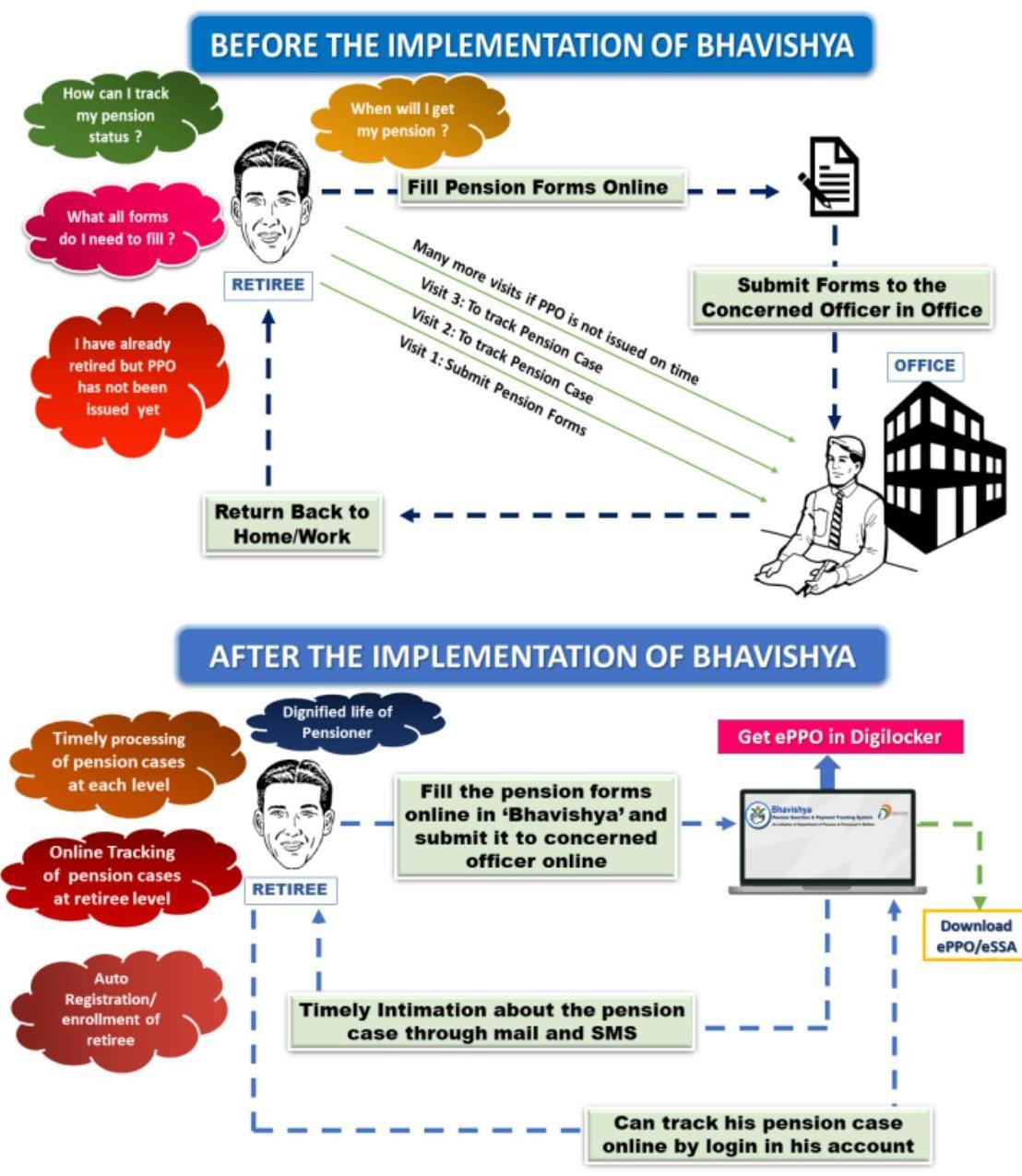
- Coordination with Defence, Railways, Post and Telecom to automate their Pension processing system on the lines of Bhavishya: As per directives of Parliamentary Standing Committee, DoPPW is regularly pursuing with Defence, Railways, Post and Telecom for getting their pension processing system digitized on the pattern of ‘Bhavishya. As of now, digitization has taken momentum in these establishments. M/o Defence after introduction of SPARSH Portal, DoT with SAMPANN Portal, Railways with ARPAN software and D/o Posts have made considerable headway in digitization of the pension settlement of their
employees. DoPPW is also working towards bringing the Defence, Railways, Post and Telecom on the Department’s Dashboard in order to get regular updates on the number of retiring persons in their respective establishments.
- Real-time monitoring for settlement of family pension claim in CAPF: All the CAPFs viz. BSF, CRPF, CISF, ITBP, Assam Rifles and SSB come under MHA and CCS (Pension) Rules, 1972 (now, CCS (Pension) Rules, 2021) are applicable to them. With a view to curtail the time lag between the date of death in any CAPF and settlement of family pension, a real-time monitoring Dashboard was made functional w.e.f. February 2020 through which the status of delay in family pension can be monitored and reminders sent to MHA to take action on expeditiously starting the family pension.
- To the commemoration of Bharat ke Azadi ke Amrut Mahotsav India@75, the Department of Pension and Pensioners’ Welfare has imparted training on Bhavishya (online Pension Sanction Module) to 75 Government of India offices.
- National e-Governance Service Delivery Assessment (NeSDA)-2021: Department of Pension & Pensioners’ Welfare has bagged the $3^{\text {rd }}$ Rank for BHAVISHYA (An online tracking system for pension sanction and payment developed by DOPPW) as per the NeSDA Assessment 2021 among all the Central Government e-Governance Service Delivery Portals with an overall compliance of more than $85 %$ across all assessment. The ranking is based on Accessibility, Content Availability, Ease of Use, Information Security \& Privacy, End Service Delivery, Integrated Service Delivery, Status \& Request Tracking.
- Integrated Pensioners Portal (https://ipension.nic.in): The Integrated Pensioners’ Portal (https://ipension.nic.in) has been launched by Hon’ble MOS(PP) Dr.Jitendra Singh on $18^{\text {th }}$ October, 2022 in VigyanBhavan, New Delhi. Keeping inview the rationalefor integrating portals viz. Ease of Living for the Pensioners at large all pension relates services portals i.e Pension Disbursing Bank portals, ANUBHAV, CPENGRAMS, CGHS etc. will be integrated in the newly created “Integrated Pensioners Portal” which will finally become a single window for all Central Government Pensioners.
Services available on IPP:- At present, the pension portals of State Bank of India (SBI) and Canara Bank have been integrated. The pensioners can now get their pension slip, the status of submission of Life Certificate and Form-16 through the Integrated Pensioners’ Portal (IPP).
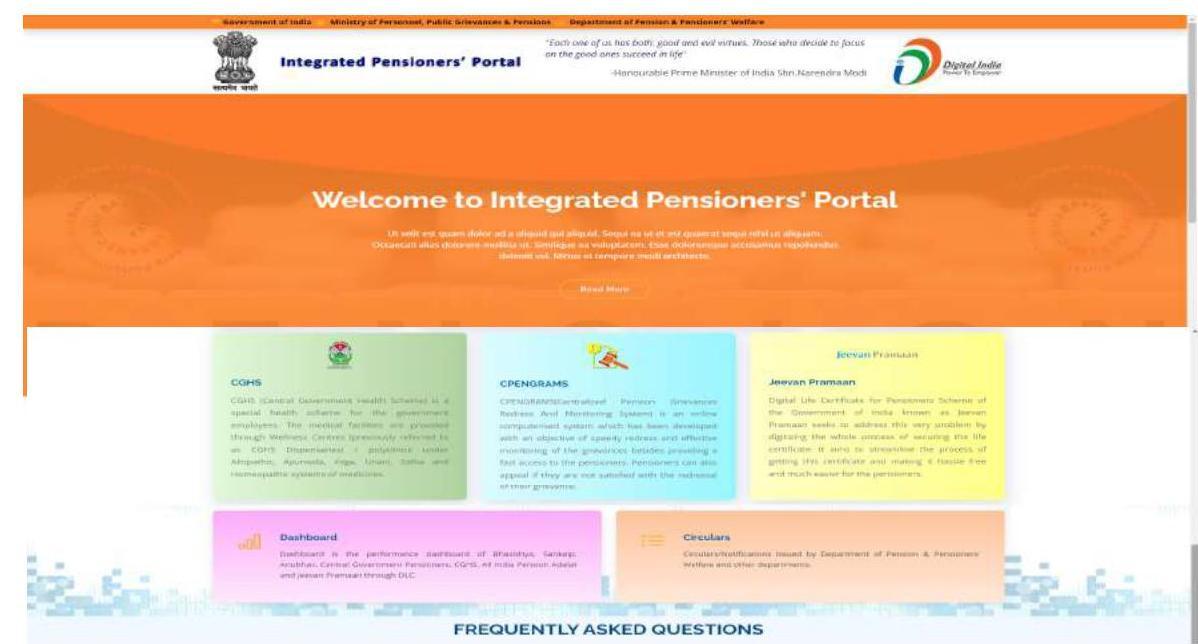
28.8 Creating awareness on pensioner’s entitlements and Rules:
Providing access to information is an important tool to empower the people, therefore, DoPPW has adopted a policy of spreading awareness amongst the targeted groups on instructions issued time to time and entitlements through workshop and various available medium such as electronic, print and social media. Since Social Media has emerged as a powerful participatory medium of communication in recent times, therefore, DoPPW has adopted a gradual shift towards spreading awareness amongst the targeted groups through social media such as Facebook, Twitter and Documentary films, YouTube etc. The Department has also been creating awareness through SMSs which are sent directly on the Mobile Phone of pensioners. This has resulted in creating greater awareness in the targeted group at minimal costs.
| Number of Tweets on Twitter 674 | Number of Impressions on Twitter 324,400 |
|---|---|
| Number of Facebook posts 424 | Number of reach on Facebook 42,232 |
YouTube (Year 2022)
| S. No | DD/MM/YY | Name of video | No. of Videos | Views |
|---|---|---|---|---|
| 1 | 13-Jan | Procedure to download Face Authentication App of JeevanPramaan. | 1 | 12,332 |
| 2 | 1-Nov | Digital Life Certificate submission through Face Authentication Technology by JeevanPramaan App. | 1 | 324418 |
| 3 | 5-Nov | जीवन प्रमाण ऐप द्वारा फेस ऑथेटीकेशन तकनीक के माध्यम से डिजिटल जीवन प्रमाण पत्र जमा करना | 1 | 10771 |
| Total | 3 | 347,521 |
*Total no. of Subscribers 26,917, we have gained $+17,400$ subscribers in year 2022
*Total no. of views from April, 2022 to till date on our channel 704,604 views
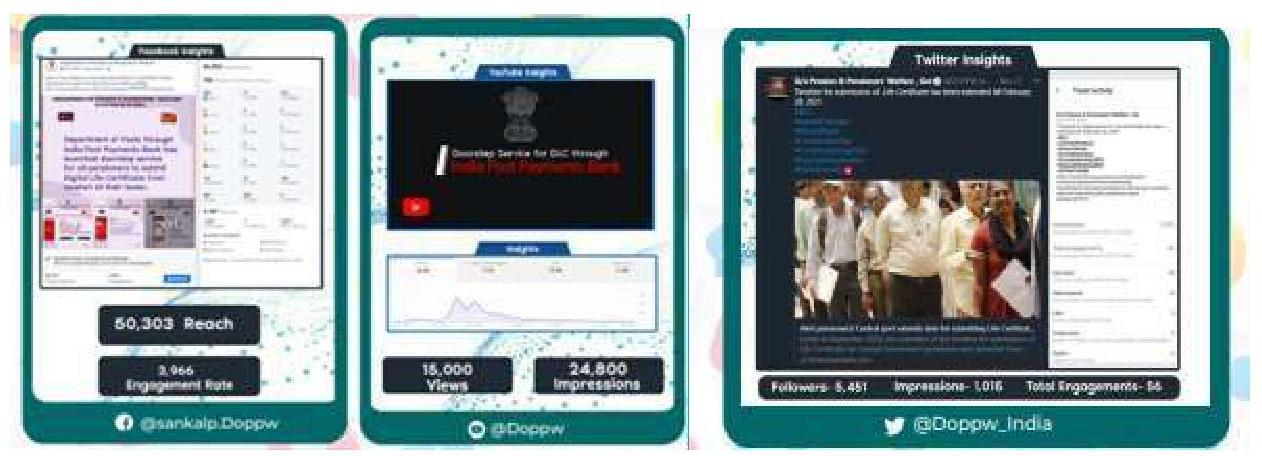
28.9 JEEVAN PRAMAAN:
- Every year in the month of November a pensioner is required to produce life certificate for further continuation of his pension. Pensioners can submit life certificate by physically presenting themselves before pension disbursing authority i.e banks or can send a certificate issued by gazetted officer or the other designated authorities.
- Due to infirmity or other ailing elements of pensioners in old age, this manual system needed improvements. Pensioners have to wait outside the bank branches in long queues for submission of Life certificate. Sometimes due to non -updating of Life Certificate record in the banking system by the concerned staff, the pension is stopped even though the pensioner had visited the bank branch or submitted Life Certificate. There was no mechanism for pensioners to get updated status and abruptly the pension stopped on account of non- receipt of Life Certificate.Keeping in view the concerns of senior pensioners and discomfort faced by them in the manual process, it was felt necessary to streamline the process and initiate Door Step Service for submission of Life Certificate.
- In November, 2014 an Aadhar based scheme for online submission of digital life certificate JeevanPramaan was launched by the Hon’ble Prime Minister with the object to facilitate pensioners to submit life certificate anytime and from anywhere.
- In 2018, DoPPW started a Pilot Programme DLC from home campaign with the assistance of Pensioners’ Associations. The objective of the campaign was to extend support to the aged and infirm pensioners in submission of Life certificate digitally from home. Around 2500 DLC were successfully created by pensioners Associations in 7 cities.
- In October-November 2019, this project was expanded to cover 24 cities i.e.Hyderabad, Ranchi, Bhuvneshwar, Jaipur, Thrissur, Kolkata, Cuttack, Chennai, Guwahati, Madurai, Balasore, Jalandhar, Ahmedabad, Prayagraj, Pune, Dehradun, Mumbai, Bengaluru, Vadodara, Trivandrum, Mysore, Chandigarh, Noida, Delhi. In year 2019, around 4100 DLCs have been collected from such pensioners by the above Pensioners Associations.
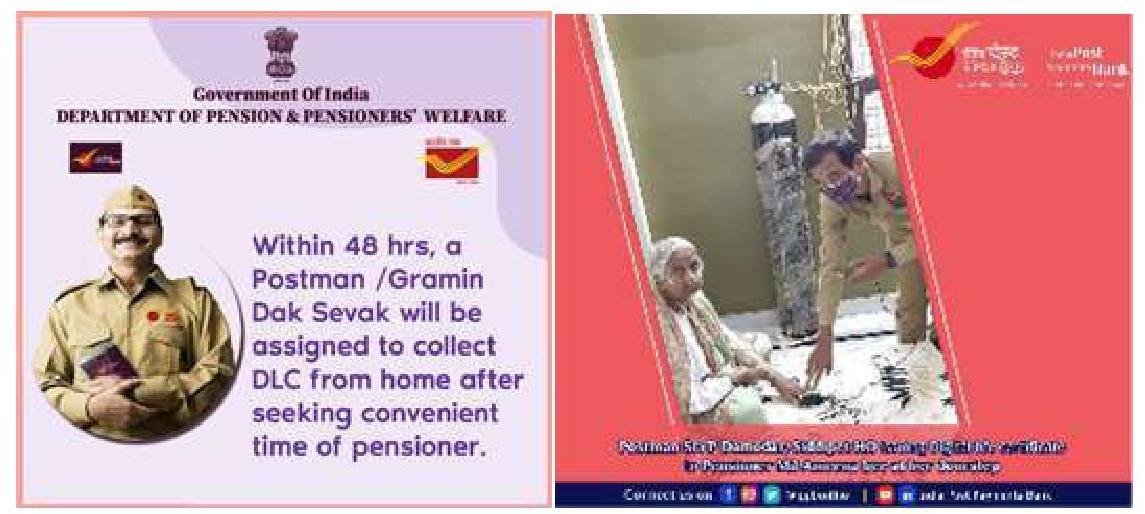
- With a view to make Doorstep Services for submission of Life Certificate available to all pensioners across the country, DoPPW roped in the India Posts and Payment Bank (IPPB) under the Department of Posts for Digital Life Certificate. The IPPB has started Doorstep Service in November, 2020 through its huge network of 1,89,000 Postmen &GraminDakSevaks. Thus the major initiative of DoPPW, viz. DLC from Home has reached every nook and corner of the country. This has come as a source of great comfort to Pensioners, especially those residing in rural areas.
- After the coordination with Public Sector Bank Alliance (PSB), the service for collection of Life Certificate has been brought under the umbrella of Doorstep Banking Service. Now pensioners can submit Life Certificate by calling Banking agents at their home. This facility is presently available in 100 cities.
- In order to address the inconvenience faced by senior pensioners in submission of Life Certificate digitally due to non-capturing of their finger bio-metrics, DoPPW issued OMs dated 11.09.2020 and 23.11.2020, DoPPWand advised all the Pension Disbursing Banks to adopt the Video based Customer Identification Process (V-CIP) as an additional facility for obtaining a Life Certificate from the pensioners, within permissible RBI guidelines. UCO Bank has become a pioneer in this area and started video-based life certificate for their pensioners. Most of the Banks viz State Bank of India, Punjab National Bank have adopted video-bases life certificate for their pensioners.
- Face Authentication Technologyhas been launched by the Hon’ble Minister of State (PP) on $29^{\text {th }}$ November 2021 with a view to enhance ease of submission of Digital Life Certificate by pensioners. Through this App any Pensioner can submit a Digital Life Certificate from the comfort of home using any Android mobile without attaching any biometric device or other device. The above technology is a milestone in leveraging technology for the purpose of Life Certificate. As per this facility, the identity of a person will be established through face authentication technique. Pensioners can capture their live photo using any Android Bases smart phone and submit it online. It authenticated by the UIDAI server, the DLC will get generated. This Technology will reduce the dependence of pensioners on external bio-metric and make the process of LC submission more affordable by enabling pensioners to submit their LCs from the comfort of their homes.
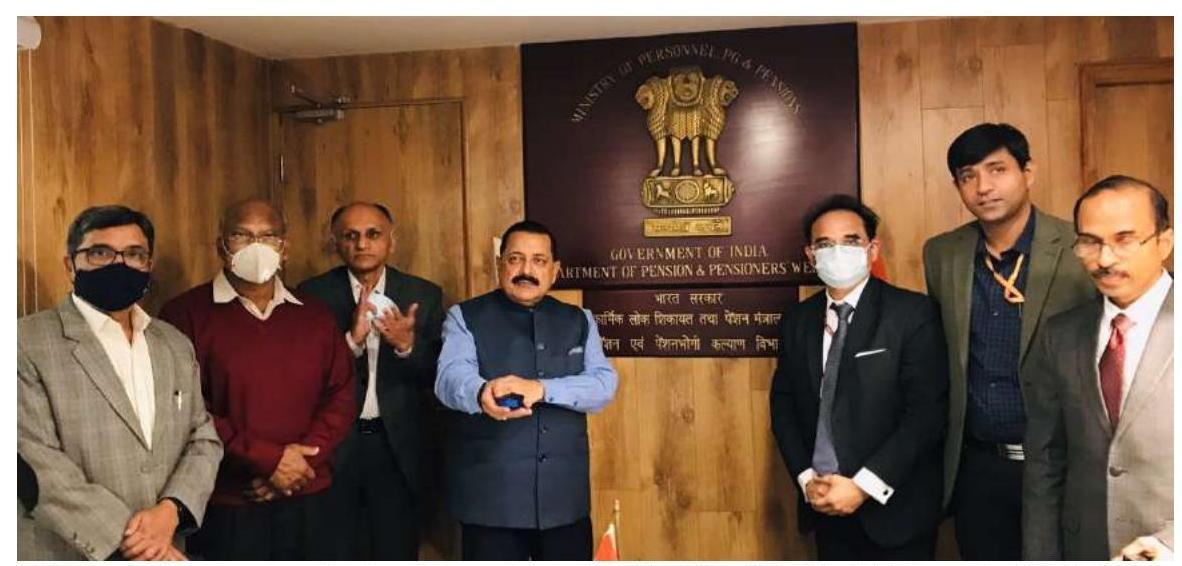
Face Authentication Technology – Launched by Hon’ble MoS(PP) at DoPPW, Lok Nayak Bhawan, New Delhi.
- The Face Authentication Technology has been given wide publicity on social media viz. Youtube, Facebook, Twitter etc. Now, a proposal has been initiated to advertise this technology through print media in English, Hindi and Regional languages newspapers for the benefit of pensions especially for those who are residing in semi-urban and rural areas, the advertisement of this technology will be beneficial to them.
- In addition, the Department tackled a small but often neglected percentage of Pensioners living abroad and gave instructions to the Ministry of External Affairs, that all the Indian Embassies/High Commissions/Consulates devise a methodology for endorsing Life Certificates and also to the International Banking Divisions of Pension Disbursing Banks to facilitate Life Certificate of such Pensioners.
- Keeping in view the difficulties faced by very senior citizens aged 80 years and above, an exclusive window from October 1 onwards, has been provided to them to avoid the major rush from 1st November onwards.
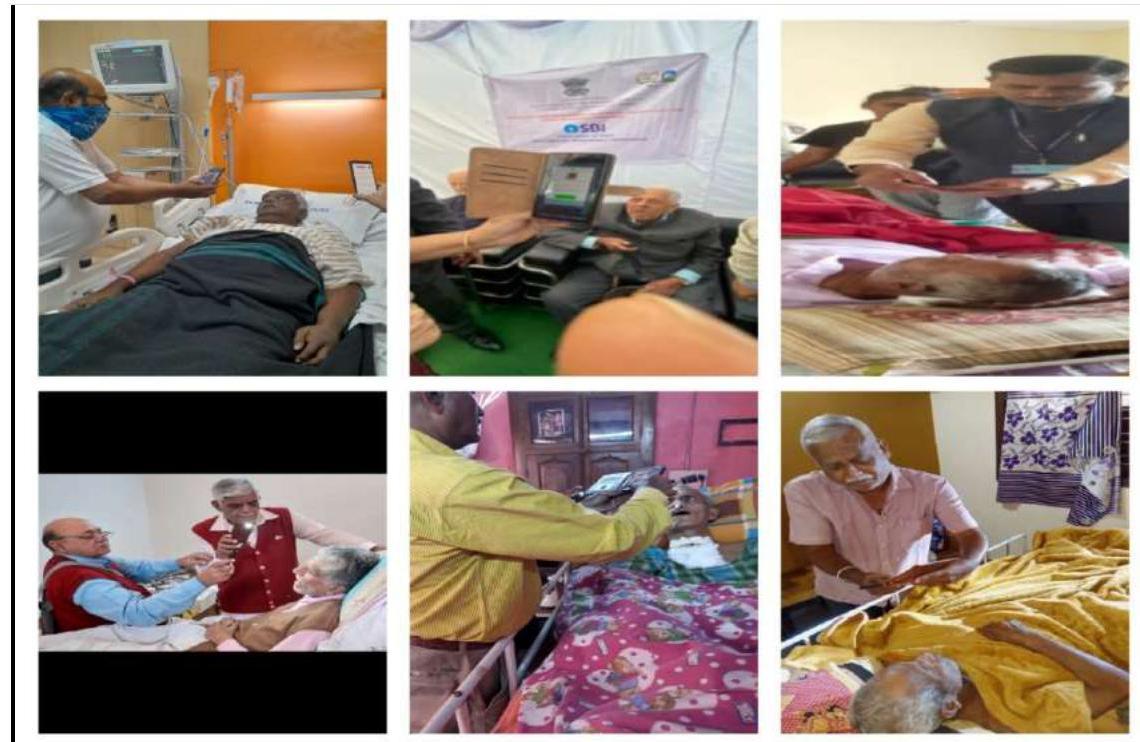
Pensioners’ Association facilitating DLC of Aged/Sick pensioners from their home.
- Nation-wide Campaign for Submission of Digital Life Certificate (DLC) by Face Authentication Application all over India during $1^{\text {st }}-30^{\text {th }}$ November, 2022
The Department of Pension & Pensioners’ Welfare, Ministry of Personnel, Public Grievances and Pensions has launched this year a Nation-wide Campaign for promotion of Digital Life Certificate (DLC) for Central Government pensioner during 1st – 30th November, 2022. The objective of this Nation-wide Campaign was to promote the use of DLC within special emphasis on the milestone technology of Face Authentication thereby ensuring transparency and Ease of Usage. All the registered Pensioners’ Associations, Pension Disbursing Banks, Ministries/Departments of Government of India and CGHS Centers had been directed to promote the Digital Life Certificate/Face Authentication Technique for giving Life Certificate by organizing special camps for ‘Ease of Living’ of pensioners.
For increasing awareness, the Face Authentication Technic was promoted \& it gain popularity and has been able to provide a huge relief especially to the aged and infirm elderly population. Till 30th November, 2022, a total of 30.85 lakh central government pensioners have used DLC successfully, in which 2.88 lakh DLC has been created through Face authentication.
To promote the campaign, State Bank of India and in certain cities the Punjab National Bank \&Canara Bank joined hands with the Department and provided the Camp venues in different cities. Registered Pensioners Associations of the Department played a pivotal role in informing pensioners about the Camps in different cities. Officials of DoPPW were nominated at different cities all over India from Srinagar in the North to Nagercoil (Kanyakumari District) in the South and from Guwahati in the East to Ahmedabad in the West to oversee the progress of the Campaign. The cities covered in this Campaign were Delhi (Hauzkhas, Pankha Road, Chanakyapuri, Jangpura), Noida, Chandigarh, Mohali, Srinagar, Nagpur, Pune, Allahabad, Jammu, Jalandhar, Gwalior, Thrissur, Madurai, Nagercoil, Vadodara, Ahmedabad, Guwahati, Hyderabad, Ambernath, Mumbai, Bhubaneshwar, Balasore, Cuttack, Thiruvananthapuram, Jaipur, Chennai, Karaikal, Puducherry, Dehradun, Jagadari, Hoogly, Howrah, Kolkata, Ranchi, Bangalore, Gulbarga and Mysuru.
The campaign was widely appreciated by the pensioners residing in different parts of country. Based on the feedback received of the Face Authentication App, NIC was quick to respond and incorporate the same. For example, the life certificate could be opened in the App after receiving an OTP and downloading the same. But because of feedback received from pensioners, the Life Certificate can be accessed immediately after entering the OTP.
The State Bank of India officials at all locations came out in full strength to promote the campaign and their officials were seen enthusiastically participated even on holidays. Similarly, the participation by the registered Pensioners’ Associations was exemplary and their representatives helped in spreading awareness about the Face Authentication technique of LC. The campaign saw the active participation of registered Central Government Pensioner Associations, the representatives of IPPB, UIDAI, NIC as well as CGDA in every city.
In order to publicize the Nation-wide campaign for promoting DLC this Department sent approx 1.4 crore SMSs to pensioners on their mobile phones, roped in 50 registered
pensioners’ associations and also through the Department’s Tweeter handle and PIB & participating Banks.
The campaign was widely covered by the newspapers and Doordarshan all over the country. During 1-30 November, 2022, Department of Pension \& Pensioners’ Welfare has disseminated 532 tweets from its Twitter account during the period. Beside this, other stakeholders of this campaign have re-tweeted 605 tweets during the period. Five videos were uploaded by the Department on its YouTube page. Two videos in Hindi and English have been uploaded on the official youtube channel of the Department (DOPPW_INDIA OFFICIAL) explaining the process of submitting the Life Certificate through Face Authentication Technique in simple language.
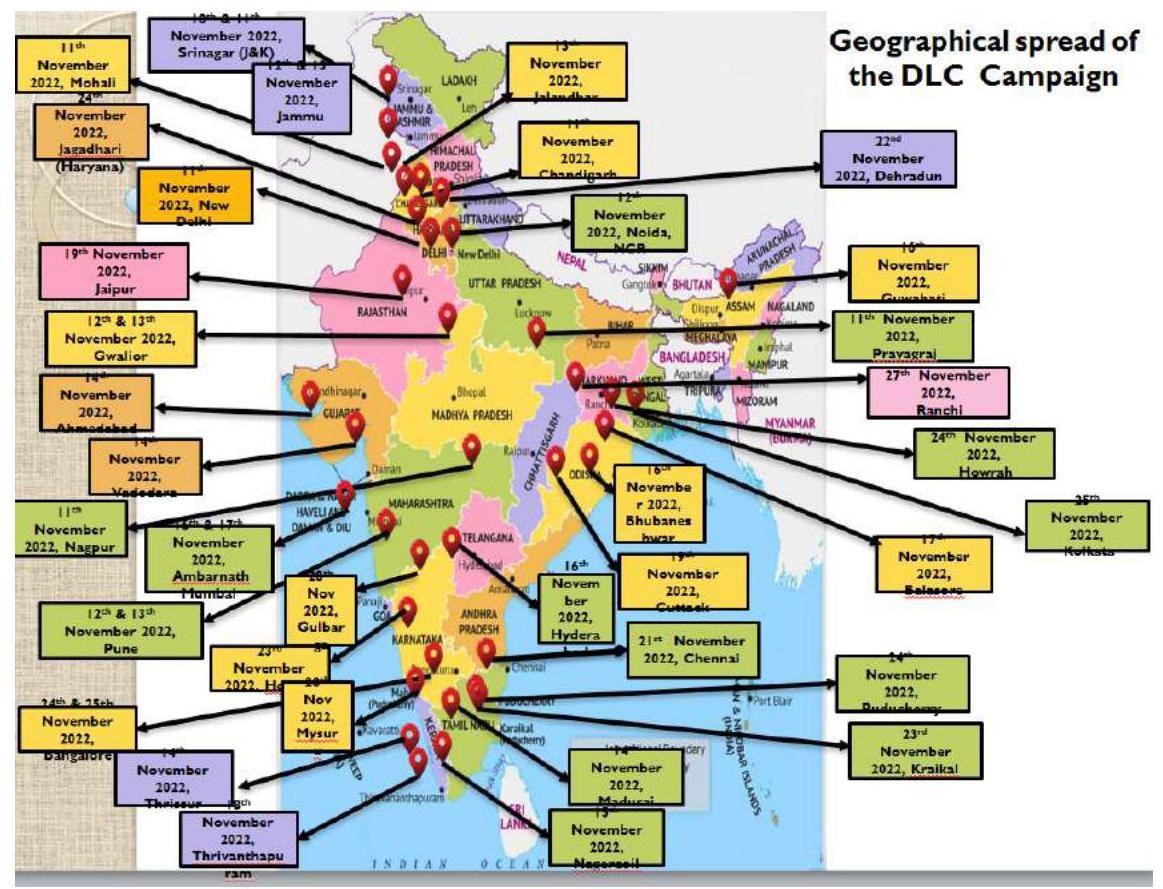
DLC Status : Bank-wise
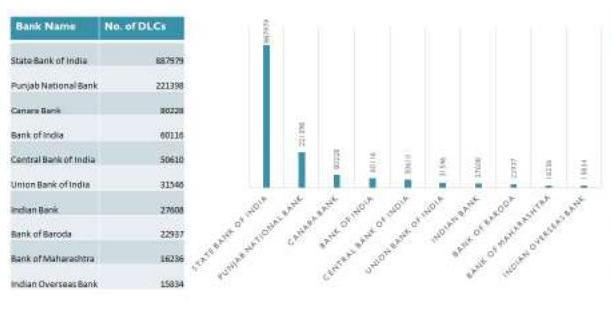
DLC Status : State-wise
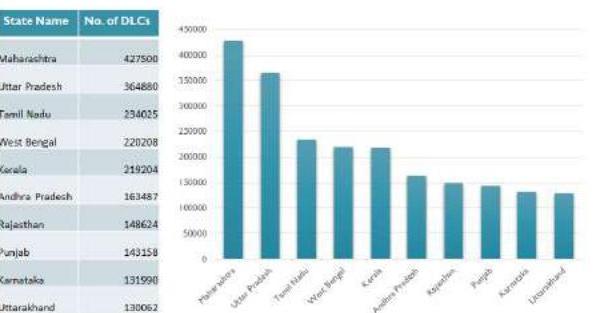
कैद् सरकार के पेशनभोगियों के लिए डिजिटल जीवन प्रमाणपत्र को बढ़ावा देने के लिए एक राष्ट्रव्यापी अभियान शुरू किया
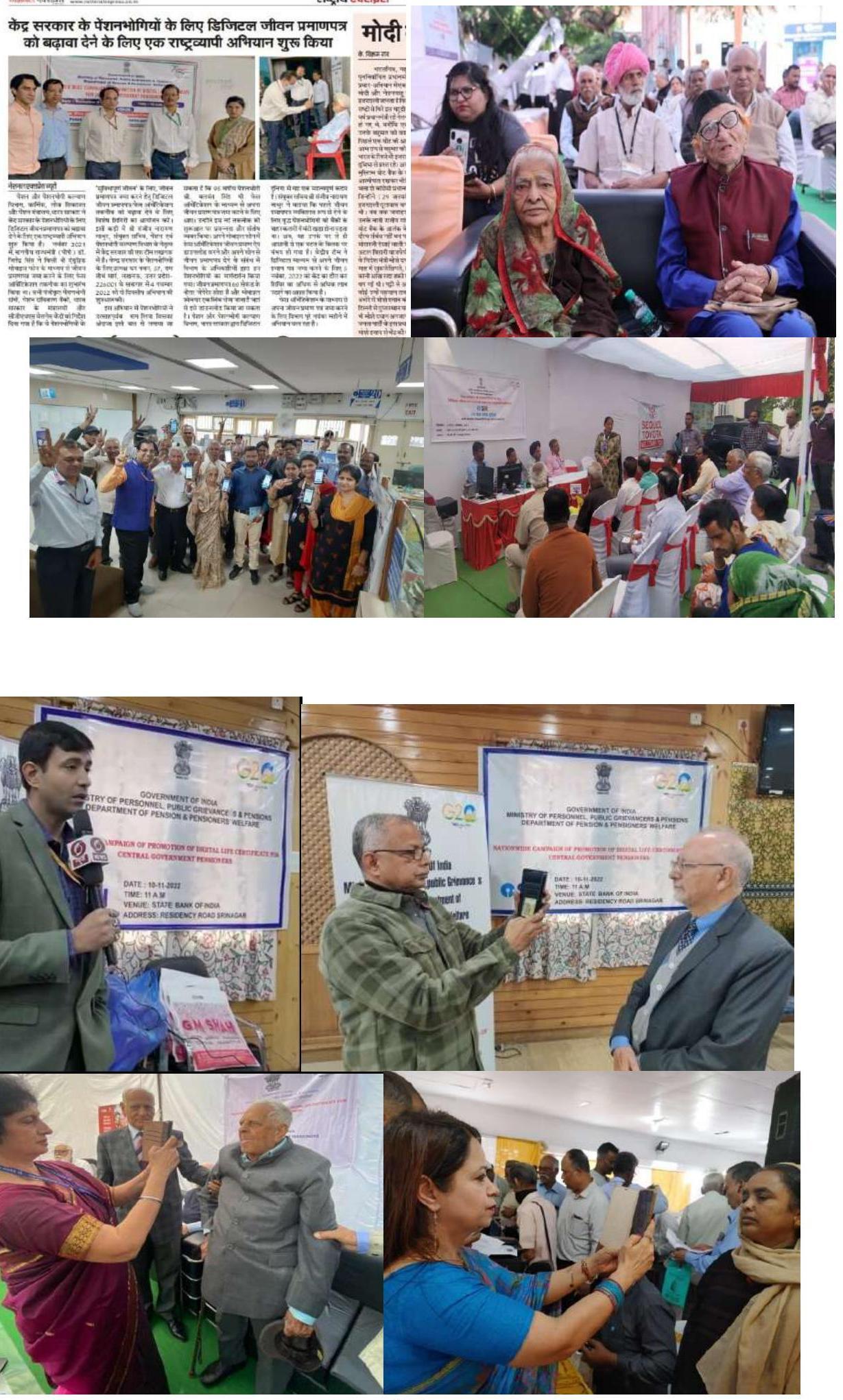
- Media interaction programme at National Media Centre, New Delhi to “launch of special campaign for Submission of Digital Life Certificate through Face Authentication App” in the auspices of Hon’bleDr.Jitender Singh, MoS (PP).
A media interaction programme was conducted by Department of Pension & Pensioners’ Welfare at National Media Centre, New Delhi on $21^{\text {st }}$ November, 2022 at 12.00 PM to “launch of special campaign for Submission of Digital Life Certificate through Face Authentication App” in the auspices of Hon’ble Dr. Jitender Singh, MoS (PP).
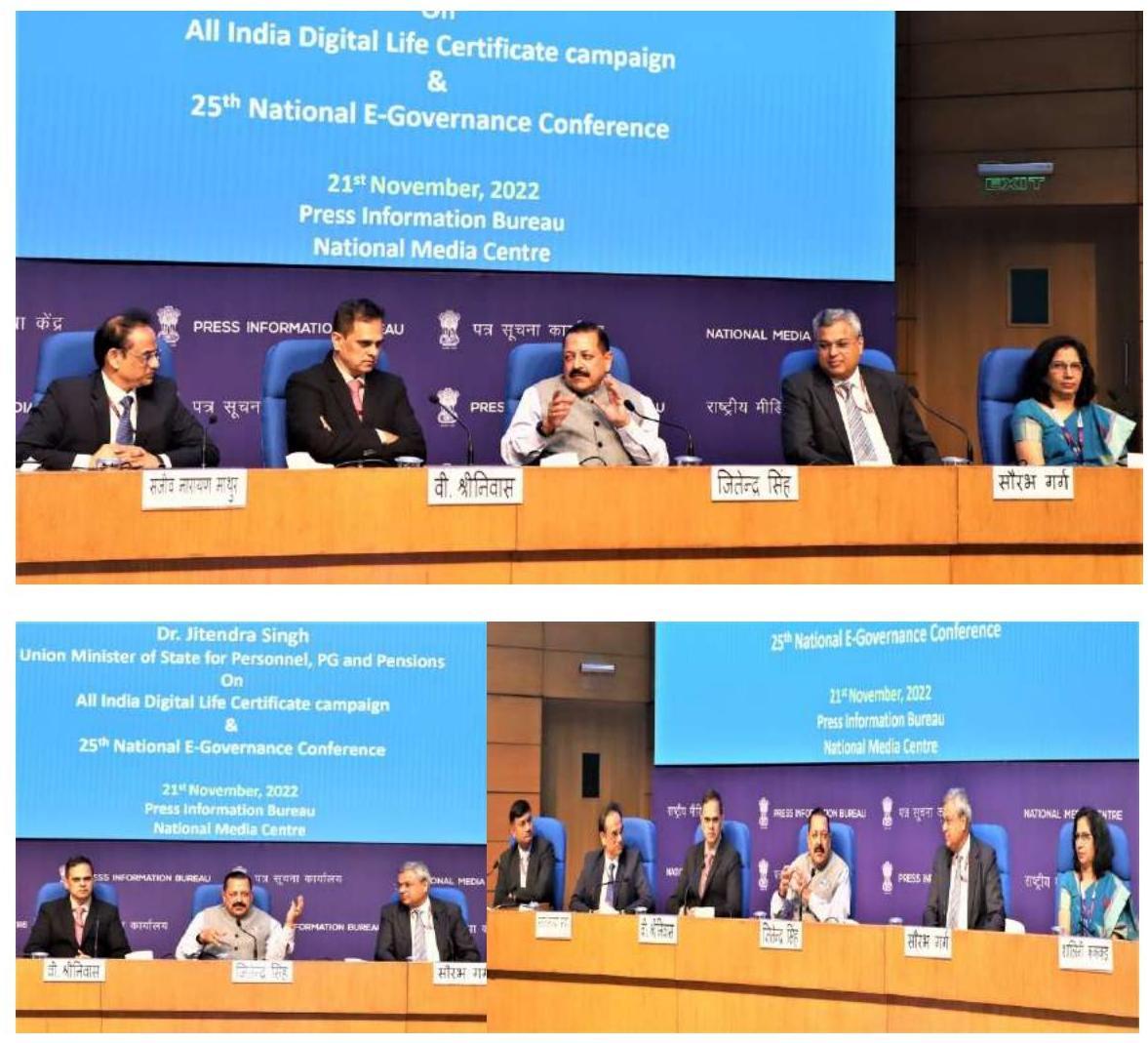
- Department of Pension and Pensioners’ Welfare has published a booklet on Nationwide Digital Life Certificate Campaign and launched this book during the Good Governance Day, 2022.
28.10 Important Policy decisions.
Central Civil Services (Pension) Rules, 2021
- This Department has notified revised CCS (Pension) Rules, 2021 on 20th December 2021 after amalgamation of instructions/amendments etc issued during the years in respect to the CCS (Pension) Rules, 1972. However, it is learnt that in many cases, Ministries/Departments or their dealing officials are not aware of the new provisions/revisions made in the new rules viz-a-viz old rules. Therefore, this Department has issued a number of instructions/clarifications to bring to the notice of
the personnel dealing with the pensionary benefits for strict compliance during the Special Campaign 2.0 from 02.10.2022 to 31.10.2022.
National Pension System (NPS)
- National Pension System (NPS) was introduced for Central Government employees w.e.f. 01.01.2004 vide Ministry of Finance (Department of Economic Affairs) Notification No. 5/7/2003-ECB & PR dated 22.12.2003 for all new recruits joining the Central Government service (except armed forces) from 01.01.2004. On introduction of the NPS, among others, the Central Civil Services (Pension) Rules, 1972 and the Central Civil Services (Extraordinary Pension) Rules, were amended on 30.12.2003. Accordingly, the benefits of old pension scheme are not admissible to the Government servants appointed on or after 01.1.2004, under the amended rules.
- Instructions have been issued vide OM No. 57/4/2019-P\&PW(B) dated 17.02.2020 by Department of Pension and Pensioners’ Welfare providing that in all cases where the results for recruitment were declared before 01.01 .2004 against vacancies occurring on or before 31.12.2003, the candidates declared successful for recruitment shall be eligible for coverage under the Central Civil Services (Pension) Rules, 1972. Accordingly, such Government servants who were declared successful for recruitment in the results declared on or before 31.12.2003 against vacancies occurring before 01.01 .2004 and covered under the National Pension System on joining service on or after 01.01.2004, may be given a one-time option to be covered under the Central Civil Services (Pension) Rules, 1972. Further, clarifications were issued vide OM dated 25.06.2020 to clarify major doubts raised by Ministries / Departments with respect to instructions issued in OM dated 17.02.2020.
- This OM stipulates time schedule for different activities to be undertaken in accordance with the instructions. All the procedure was to be completed by 01.11.2020. However, keeping in view the covid pandemic, these dates were extended vide OM dated 31.03 .2021 for further one year. Further, vide OM dated 04.01.2022, all Ministries / Departments were requested to decide options received from the eligible employees in stipulated time even if the time limit for such decision has been lapsed.
- In compliance to the recommendation of the Committee constituted for suggesting measures for streamlining implementation of National Pension System, Department of Pension and Pensioners’ Welfare in consultation with other concerned Ministries / Departments notified Central Civil Services (Implementation of National Pension System ) Rules, 2021 on 31.03.2021 for regulating service related matters for Central Government employees covered under NPS. These rules includes, applicability of NPS, general conditions, emoluments, contribution, provision for interest on delayed contribution, provision for option to choose benefits under old pension scheme or National Pension System in the event of death of Government servant or his discharge from service on invalidation or disablement, provision for Voluntary retirement, treatment of resignation, removal/ dismissal from service, compulsory retirement and absorption in corporation or body etc.
- Department of Pension and Pensioners’ Welfare vide O.M. No. 7/5/2012$\mathrm{P} \& \mathrm{PW}(\mathrm{F} / \mathrm{B})$ dated 26.08 .2016 had extended the benefit of retirement gratuity and death gratuity to the Central Government employees covered under NPS on the same terms and conditions as are applicable under CCS(Pension) Rules, 1972.
- Further, vide DoPPW O.M. No.7/5/2012-P&PW(F/B) dated 12.02.2020 instructions had been issued for counting of service for the purpose of grant of gratuity or grant of pro-rata gratuity in case of mobility of a Central Government employee to other organizations through proper channel.
- Department of Pension and Pensioners’ Welfare in consultation with other concerned Departments, have notified Central Civil Services (Payment of Gratuity under National Pension System) Rules, 2021 on 24.09.2021 for regulating grant of retirement gratuity and death gratuity to Central Government employees covered under NPS.
- Instructions has been issued in respect of Government employee appointed on or after 01.01.2004 and covered under NPS is disabled, he shall also be eligible to receive a lump sum compensation computed in terms of rule 9(3) of CCS (EOP) Rules, if the disablement is attributable to Government service and the Government employee is retained in service in spite of such disablement. (OM No 1/3/2019-P\&PW (F) dated 01.01.2021).
- Considering the hardship being faced by the family of missing Government employees appointed on or after 01.01.2004, during service, benefit of CCS(Pension) Rules, in accordance with this Department’s OM No. 1/17/2011-P\&PW(E) dated 25.06.2013 has also been extended vide Department of Pension and Pensioners’ Welfare OM No. 57/03/2020-P\&PW(B) dated 28.04.2022 to the family of missing Government employee covered under NPS during service and in accordance with the option exercised by the Government employee or default option in this regard as provided in Central Civil Services (Implementation of National Pension System) Rules, 2021.
- On the Good Governance Day, 2022 (25 th December, 2022), Hon’bleMoS(PP) released a book on the Central Civil Services (Implementation of National Pension System ) Rules, 2021 published by the Department of Pension \& Pensioners’ Welfare. These Rules were earlier notified on 30.03.2021. These Rules inter alia cover the matters relating to registration process and allotment of PRAN, contributions by the employee and the Government, compensation to be paid to the Government servant in case of delay in registration and credit of contributions to the NPS Account, option for benefits under the CCS(Pension) Rules or NPS Rules in the event of death or disability of Government servant during service, entitlements on superannuation, premature/ voluntary retirement, resignation from service, etc. and the procedure for processing of claims under NPS.
- Simplify pension rules and issued instructions were undertaken during the Special Campaign 2.0 launched by Department of Administrative Reforms and Public Grievances (DARPG) for disposal of Pending Matters during 2nd October, 2022 to 31st October 2022. Under this campaign, Department of Pension and Pensioners Welfare issued sixty (60) Notifications/Circulars for ease of rules during the month of October, 2022. A compendium of these circulars was released by Hon’ble MoS(PP) on Good Governance Day, 2022 (25 th December, 2022) .
- Department of Pension has notified the Central Civil Services (Pension) Rules, 2021 in supersession of the Central Civil Service (Pension) Rules, 1972. As per Rule 50 of the Central Civil Service (Pension) Rules, 2021, in case after the death of a Government servant or a pensioner, a member of the family, whose name is not included in Form 4, submits a claim for family pension, the claim of a member of the
family shall not be rejected on the ground that the details of such member of the family are not available in Form 4 or office records, if the Head of Office is otherwise satisfied about the eligibility of the member of the family for grant of family pension.
- In accordance with Rule 50 of the Central Civil Service (Pension) Rules, 2021, in order to decide the eligibility for family pension, a member of the family, other than the widow or widower of the deceased Government servant or pensioner, is required to submit, along with the claim for family pension, a copy of the last Income Tax Return filed by the said member of the family with the Income Tax Department. In case the said member of the family informs that he or she has not filed the Income Tax Return with the Income Tax Department, he or she shall submit a certificate of income from a sub-divisional magistrate. In case the member of the family is not able to submit either a copy of the Income Tax Return or a certificate of income from a sub-divisional magistrate, the Head of Office may rely on any other document produced by the said member of the family in support of his or her claim regarding income and decide the eligibility of the said member of the family for family pension.
- Department of Pension & Pensioners’ Welfare has issued instructions vide its OM No. 11(15)/2022 P\&PW (H)-(1) dated 28.10.2022 regarding timelines and process for completion of various activities in the process of authorisation of pension and gratuity on retirement on superannuation of a Government servant.
- Department of Pension \& Pensioners’ Welfare has issued instructions vide its OM No. 11(15)/2022 P\&PW (H)-(2) dated 28.10.2022 regarding processing of cases for authorisation of pension/family pension in respect of (i) a Government servant who is not in a position to submit the pension forms on account of any bodily or mental infirmity, and (ii) a Government servant who dies after retirement without having submitted the pension forms.
- DoPPW issued instructions vide its O.M. No. 1(8)/2021-P\&PW(H) dated 30.09.2022 regarding various methods for submission of life certificate by pensioners/ family pensioners.
28.11 Miscellaneous:
- Banks Awareness Program Series – Department of Pension and Pensioners’ Welfare has started a series of Awareness Program for Central Pension Processing Centres and field functionaries handling pension related work in the banks. Since the major Pension Disbursing Authorities are banks, the first program in the series was held for officers of State Bank of India on $20^{\text {th }}$ and $21^{\text {st }}$ June, 2022 at Udaipur, covering the Northern region of the country. A team of officers from DoPPW took sessions on Pension policy reforms \& digitization regarding disbursement of pension to Central Government pensioners, with the objective of updating the field functionaries of State Bank of India. Special sessions were organized on Income Tax matters related to pensioners as well as Digital means of submitting the Annual Life Certificates. Chief Controller (Pension), CPAO shared the reasons leading to Pensioners’ grievances and suggested actions which may be taken by the bank for redressal.
The second program in the series was held on 30th and 31st August, 2022 at Amritsar for officials of Punjab National Bank covering the Northern region of the country. A team of officers from DoPPW took sessions on Pension policy reforms \& digitization of pension disbursement to Central Government pensioners. Special sessions were organized on Income Tax matters related to pensioners as well as Digital means of submitting the Annual Life Certificates. Chief Controller (Pension), CPAO also
discussed the basic causes leading to Pensioners’ grievances and suggested action which may be taken by the Bank for redressal. Senior pensioners of the region were also invited for their inputs.
The third program in the series was held on 28-29 November 2022 at Jaipur for officials of Canara Bank.
- Pensioners’ Awareness Program – Department of Pension and Pensioners’ Welfare conducted Pensioners’ Awareness Program at Puducherry on 28th June, 2022. This is the first physical Awareness program post pandemic covering the Southern region of country. The program was attended by more than 300 pensioners from Chennai and Puducherry in collaboration with Pensioners’ Associations from Chennai and Puducherry. A team of officers from DoP&PW took sessions on Pension policy reforms \& digitization regarding pension/family pension sanction to Central Government pensioners, with the objective of updating the pensioners of the changes made under the “Ease of Living” initiative of the Government. Special sessions were organized on Income Tax matters related to pensioners as well as Digital means of submitting the Annual Life Certificates. The objective of these programs is to spread awareness of the various rules and procedures regarding pension entitlements and processes to Central Government pensioners as well as to update the pensioners about the changes that take place from time to time through various amendments in the policy and procedures. Such programs also serve as a feedback mechanism of pension policy from pensioners. Chief Controller (Pensions), CPAO, MoF also addressed the pensioners providing information about the common grievances faced by pensioners, their modes of redressal as well as new initiatives taken by CPAO to enhance ‘Ease of Living’ of pensioners. A representative from CGHS also addressed the participants and provided information on the queries raised by pensioners.
– Special Campaign Activities 2.0 (SCDPM)
4200 pensioners’ grievances with various Ministries taken up in campaign mode: During SCDPM 2.0 campaign, the department has resolved 4200 pending pension grievances to ensure speedy redressal and to enhance “Ease of living” for 68 lakh Central Government Pensioners. The Department is convening inter-ministerial meetings with concerned Ministries/Departments to resolve all grievances within due time period. Total 12 appeals on pension grievances have also been disposed of.
“Ease of Living” for pensioner was the central focus while re-iterating relevant circulars at a glance: The Department has issued 60 circulars under Easing of Rules/Processes.
Thousands of physical files as well as e-files which have outlived their codal life weeded out: Total 3569 physical files and 3747 E-Files have been closed in which action is completed.
Registered Pensioners’ Associations offices made part of Swachhta Campaign: Total 41 Cleanliness Campaign have been conducted
- The Hon’ble Minister inaugurated the vaccination camp at LokNayakBhawan organized on 12th April, 2022 for Pensioners by the Department of Pension \& Pensioners’ Welfare. The vaccination camp was for giving a booster-/precaution dose to the senior citizens. The Department organized this camp especially for Pensioners so that they don’t have to queue up at other centers. The Hon’ble Minster stated that
the Department is not only responsible for pension but also cares for the Pensioners’ Welfare in general. It was a humane gesture from the Department.
- The Department organized free precaution dose vaccination campaign on 22.07.2022 at CSOI, New Delhi under the auspices of Hon’ble MoS(PP) in which more than 250 doses were administered.
- Regular sanitization of the Department was ensured so that no incident of COVID-19 happens in the Department with special emphasis on toilets and common areas. Sanitization machines were installed in the Department.
- Gloves, Masks, sanitizers are also distributed from time to time to save staff from COVID-19. PPE kits are being distributed to the house-keeping staff in order to protect them from COVID-19. Office vehicles are also sanitized on a regular basis.
– Dearness Relief to Pensioners/Family Pensioners:
Revised rates of Dearness Relief (DR) to Central Government Pensioners/ Family pensioners on implementation of decision taken on recommendation of $7^{\text {th }} \mathrm{CPC}$ are admissible at following rates:-
| Date from which payable | Rate of Dearness Relief per month |
|---|---|
| From 01.01 .2022 | $34 %$ of Basic Pension/Family Pension |
| From 01.07 .2022 | $38 \%$ of Basic Pension/Family Pension |
For the convenience of all Ministries/ Departments and Banks/ Treasuries/ Post Offices, orders are hosted on the website of this Department. This facilitates faster payment of enhanced DR by Pension Disbursing Authorities.
The process has been streamlined to ensure that enhanced DR orders are issued with a minimum time lag with reference to the orders for enhancement of DA.
- Standing Committee of Voluntary Agencies (SCOVA)
$32^{\text {nd }}$ Meeting of Standing Committee of Voluntary Agencies (SCOVA) was held under the Chairmanship of Dr.Jitendra Singh, Hon’ble Minister of State (PP) on April 12,2022 in New Delhi, which was attended by representatives of various Pensioners’ Associations and the Ministries/Departments. - Under Special Campaign 2.0 during 02.10 .2022 to 31.10 .2022 on issue of instructions/clarifications for simplification/ease of rules in respect of Central Government pensioners, 8 such clarifications related to Dearness Relief and Commutation of Pension were issued.
28.12 राजभाषा अनुभाग
हिंदी संघ की राजभाषा होने के कारण पेंशन और पेंशनभोगी कल्याण विभाग सरकारी कामकाज में हिंदी के प्रगामी प्रयोग को बढ़ावा देने के लिए सक्रिय रूप से भूमिका निभा रहा है। पेंशन और पेंशनभोगी कल्याण विभाग का राजभाषा अनुभाग हिंदी अनुवाद का कार्य करने के साथ-साथ राजभाषा नीति तथा राजभाषा अधिनियम के कार्यान्वयन संबंधी कार्य देखता है। विभाग के सभी अनुभागों में
राजभाषा नीति के कार्यान्वयन की स्थिति की निगरानी के लिए विभाग में राजभाषा कार्यान्वयन समिति का गठन किया गया है। राजभाषा नीति के कार्यान्वयन की स्थिति की निगरानी के लिए अपर सचिव महोदय की अध्र्यक्षता में प्रत्यक तिमाही में नियमित रूप से बैठक आयोजित की जाती है और बैठक में लिए गए निर्णयों पर की गई कार्यवाही, विभाग के सभी अनुभागों से प्राप्त तिमाही प्रगति रिपोर्ट की समीक्षा की जाती है तथा सरकारी कामकाज में हिंदी के प्रयोग को बढ़ाने की दिशा में प्रयास करने हेतु मार्गदर्शन किया जाता है।
गृह मंत्रालय राजभाषा विभाग द्वारा समय-समय पर जारी किए गए आदेशों/ अनुदेशों के अनुसरण में राजभाषा हिंदी के प्रगामी प्रयोग को बढ़ावा देने के लिए पेंशन और पेंशनभोगी कल्याण विभाग में 14 सितंबर से 29 सितंबर, 2022 तक की अवधि के दौरान हिंदी पखवाड़े का आयोजन किया गया जिसके दौरान आयोजित प्रतियोगिताओं में अधिकारी/कर्मचारियों ने उत्साहपूर्वक भाग लिया।
राजभाषा अनुभाग, पेंशन और पेंशनभोगी कल्याण विभाग द्वारा वर्ष 2022 के दौरान राजभाषा हिंदी से संबंधित किए गए कुछ उल्लेखनीय कार्य निम्नवत हैं:-
- इस विभाग की विगत 8 वर्षों (2014-2022) की उपलब्धियों पर द्विभाषी ई-बुक तैयार की गई।
- दिनांक 14 से 15 सितंबर, 2022 को सूरत (गुजरात) में आयोजित हिंदी दिवस और अखिल भारतीय राजभाषा सम्मेलन में इस विभाग को 300 से कम कार्मिक वाले मंत्रालय/विभाग श्रेणी में प्रथम राजभाषा कीर्ति पुरस्कार प्रदान किया गया। इस पुरस्कार को विभाग के अपर सचिव महोदय ने ग्रहण किया। अपर सचिव महोदय के अतिरिक्त, इस सम्मलेन में विभाग से दो वरिष्ठ अधिकारियों और दो कार्मिकों ने भाग लिया।
- पखवाड़े के दौरान विभाग के अधिकारियों/कर्मचारियों में हिंदी के प्रति रुचि बढ़ाने और राजभाषा हिंदी को उत्तरोत्तर बढ़ावा देने की दिशा में उत्तर मध्य क्षेत्र सांस्कृतिक केंद्र, प्रयागराज संस्कृति मंत्रालय, भारत सरकार की स्वायत्त संस्था द्वारा प्रायोजित डॉ. एम सईद आलम द्वारा निर्देशित हिंदी नाटक ‘बिग बी’ का मंचन दिनांक 21.09.2022 को CSOI चाणक्य पुरी, नई दिल्ली में किया गया।
- दिनांक 18 अक्तूबर, 2022 को विज्ञान भवन, नई दिल्ली में आयोजित अनुभव पुरस्कार समारोह में डॉ. जितैद सिंह, माननीय राज्यमंत्री के करकमलों द्वारा केंद्र सरकार के पेंशनभोगियों को वर्ष 2019-2020, 2021 और 2022 के लिए अनुभव पुरस्कार प्रदान किया गया। इस कार्यक्रम का मंचसंचालन सहायक निदेशक(रा.भा.) द्वारा हिंदी में किया गया। कार्यक्रम से संबंधित स्टैंडी, निमंत्रण-पत्र, मिनटवार कार्यक्रम और प्रेस रिलीज द्विभाषी तैयार किए गए थे।
- विभाग ने पेंशनभोगियों के लिए डिजिटल जीवन प्रमाणपत्र को बढ़ावा देने के लिए और फेसऑर्यटिकेशन तकनीक को लोकप्रिय बनाने के लिए नवंबर 2022 में विशेष राष्ट्रव्यापी अभियान चलाया, जिसके तहत विभाग के अधिकारियों की देखरेख में देश के 37 शहरों में शिविर
आयोजित किए गए। इस संपूर्ण अभियान का प्रचार-प्रसार हिंदी और अंग्रेजी दोनों भाषाओं में दूरदर्शन, स्थानीय अख़बारों, ट्वीटर, फेस बुक और युट्यूब के माध्यमों से किया गया।
6. डॉ. जितेन्द्र सिंह, माननीय राज्यमंत्री द्वारा दिनांक 25 दिसंबर, 2022 को सुशासन दिवस के अवसर पर केंद्रीय सिविल सेवा (राष्ट्रीय पेंशन प्रणाली का कार्यान्वयन) नियमावली, 2021 नामक द्विभाषी पुस्तक का विमोचन किया गया।
7. युट्यूब फेसबुक और ट्वीटर के लिए राजभाषा अनुभाग द्वारा हिंदी में निम्नलिखित ऑडियो/वीडियो तैयार किए गए जिसमें सहायक निदेशक(रा.भा.) द्वारा हिंदी में वॉइसओवर दिया गया।
(i) स्वछता अभियान 2.0 – वीडियो
(ii) डीएलसी – ऑडियो
(iii) डीएलसी – वीडियो
(iv) डीएलसी राष्ट्रव्यापी अभियान के संबंध में जानकारी – वीडियो
(v) डीएलसी राष्ट्रव्यापी अभियान – एक समय रिपोर्ट – वीडियो
ANNEXURES
Department of Personnel and Training
Incumbency Position of Group ‘A’ Officers in D/o Personnel and Training as on 31.03.2023
| Post | Name of Incumbent |
|---|---|
| Secretary(Personnel) | Ms S. Radha Chauhan |
| Additional Secretary | 1. Ms Deepti Umashankar |
| 2. Shri Manoj Kumar Dwivedi | |
| 3. Shri Rahul Singh | |
| 4. Ms Rashmi Chowdhary | |
| Joint Secretary | 1. Shri Rajat Kumar |
| 2. Ms Rajul Bhatt | |
| 3. Shri S D Sharma | |
| Director | 1. Shri Ashok Kumar Jayapal |
| 2. Shri A.N. Narayanan | |
| 3. Ms Jayanthi Angayarkanni G.D. | |
| 4. Shri Juglal Singh | |
| 5. Shri Nila Mohanan | |
| 6. Ms Pallavi Singh Prakash | |
| 7. Shri S P Pant | |
| 8. Shri S.G. Mulchandaney | |
| 9. Shri Syed Imran Ahmed | |
| 10. Ms Vanita Sood | |
| 11. Shri Ziley Singh Vical | |
| Principal Staff Officer | 1. Shri Ashok Kumar |
| 2. Shri Harish Kumar Chawla | |
| 3. Shri P. Suresh | |
| Deputy Secretary | 1. Shri Anindya Bhattacharya |
| 2. Shri Bhagirath Jha | |
| 3. Shri Debasweta Banik | |
| 12. Shri Deepak Sajwan | |
| 13. Ms D.S. Nagalakshmi | |
| 4. Shri Harmit Singh Pahuja | |
| 5. Shri J. Sriram Murty | |
| 6. Shri Kartik V. Hegadekatti | |
| 7. Shri Murali Bhavaraju | |
| 8. Shri Naresh Kumar | |
| 9. Ms Nidhi Srivastava | |
| 10. Shri P.B. Sahu | |
| 11. Ms Pooja Jain | |
| 12. Shri Prashant Shukla | |
| 13. Shri Ram Dutt | |
| 14. Shri Sandeep Saxena | |
| 15. Shri Shamik Bhowmcik | |
| 16. Shri Sitansu Mohan Routray | |
| 17. Shri S.K. Dahiya | |
| 18. Shri Umesh Kumar Bhatia |
| Senior Principal Private Secretary | 19. Shri Vadali Rambabu |
| 1. Shri Rajinder Parshad | |
| 2. Ms Savita Sen | |
| 3. Shri Yati Raj Sehgal | |
| Principal Private Secretary | 1. Shri Amit Munjal |
| 2. Shri Arvind Bhardwaj | |
| 3. ShriDeepak Chandra Upreti | |
| 4. Shri Dilip Kandulna | |
| 5. Shri Ishwar Singh Bhandari | |
| 6. Shri Jaipal Singh | |
| 7. Shri Jay Prakash Singh | |
| 8. Shri Jenender Kawatra | |
| 9. Shri Kartika Chandra Sahoo | |
| 10. Shri Laxmi Narain | |
| 11. Shri Naresh Kumar Mendratta | |
| 12. Shri Raman Kumar | |
| 13. Shri R.K. Malhotra | |
| 14. Shri Sarada Behera | |
| 15. Shri Sanjay Sharma | |
| 16. Shri Zahid Hussain | |
| Deputy Director (OL) | 1. Shri Jagmohan Singh Negi |
| 2. Ms Shraddha Mathur | |
| Under Secretary | 1. Shri Abhay Kumar |
| 2. Shri Ajay Lawania | |
| 3. Shri Alok Suman | |
| 4. Shri Ambrish Kumar Gopal | |
| 5. Shri Amit Kumar | |
| 6. Shri Amit Srivastava | |
| 7. Ms Amrita Walia | |
| 8. Shri A.M.U. Mahesh | |
| 9. Smt Anita Bilung | |
| 10. Shri Anshuman Mishra | |
| 11. Shri Arun Kumar Singh | |
| 12. Shri Arvind Thakur | |
| 13. Shri Bhupinder | |
| 14. Shri Dasari Ramesh Babu | |
| 15. Shri Debabrata Das | |
| 16. Shri Deepak Sharma | |
| 17. Shri Deshraj Yadav | |
| 18. Shri Gautam Kumar | |
| 19. Shri George Deepak Toppo | |
| 20. Ms Jasmine | |
| 21. Shri Kulbhushan Malhotra | |
| 22. Shri Kuldeep Chaudhary | |
| 23. Shri Kumar Rajiv Ranjan | |
| 24. Shri Kundan Nath | |
| 25. Ms Manjula Juneja | |
| 26. Shri Manoj Gupta | |
| 27. Shri Manoj Kumar | |
| 28. Shri Manvendra Pratap | |
| 29. Shri Nabhlakshmi Jain Gangh |
| 30. Shri Narendra Kumar | |
|---|---|
| 31. Shri Nilesh Chandra Srivastava | |
| 32. Shri Pawan Kumar | |
| 33. Shri Pawan Kumar | |
| 34. Shri Pankaj Gangwar | |
| 35. Shri Pradeep Kumar | |
| 36. Shri Pradeep Kumar Saharawat | |
| 37. Shri Praveen Pal Singh | |
| 38. Shri Ram Lakhan | |
| 39. Shri Ravi Vazirani | |
| 40. Shri R. Venketesan | |
| 41. Shri Rajesh Kumar | |
| 42. Shri Rajesh Sharma | |
| 43. Shri Rajeev Kumar Khare | |
| 44. Shri Rajeev Lochan | |
| 45. Shri Rajeev Nayan | |
| 46. Shri Rakesh Kumar | |
| 47. Shri Rakesh Kumar Sinha | |
| 48. Shri Ramesh Chandra Jha | |
| 49. Shri Randhir Kumar | |
| 50. Shri Rishi Pal | |
| 51. Shri Rupesh Kumar | |
| 52. Shri Sanjay | |
| 53. Shri Sanjay Kumar Chaurasia | |
| 54. Shri Satish Kumar | |
| 55. Shri Subandhu Basu | |
| 56. Shri Subir Kumar | |
| 57. Shri Subodh Verma | |
| 58. Shri Sunil Kumar | |
| 59. Shri Sunil Kumar | |
| 60. Shri Sunil Kumar Mandi | |
| 61. Shri Sushil Kumar Mishra | |
| 62. Shri Shukdeo Sah | |
| 63. Shri Surya Narayan Jha | |
| 64. Shri Surya Prakash | |
| 65. Shri Udai Bhan Singh | |
| 66. Shri Vijay Kumar Darak | |
| 67. Shri Vinay Kumar | |
| 68. Shri Zachariah Thomas |
Incumbency Position of Group ‘A’ Officers in Public Enterprises Selection Board as on 31.03.2023
| Chairman | 1. | Mallika Srinivasan |
|---|---|---|
| Member | 1. | Shri Amarjeet Sinha |
| 2. | Shri Sailesh | |
| Secretary | 1. | Ms Kimbuong Kipgen |
| Director | 1. | Shri M.S. Subramanya Rao |
| Principal Staff Officer | 1. | Shri Virendar Aggarwal |
| Principal Private Secretary | 1. | Shri Girish Kumar Ahuja |
| 2. Shri Rajneesh Jain | |
|---|---|
| Under Secretary | 1. Shri Mohammad Jainuddin |
| 2. Shri Ajit Kumar |
DISPOSED DP CASES-2022-23
| S.No. | Case | File No. | Received
Date | Present Status |
| — | — | — | — | — |
| 1. | Disagreement between Disciplinary
Authority [i.e. National Highways
Authority of India (NHAI)] and Central
Vigilance Commission (CVC) in the
matter of Disciplinary proceeding case
against Shri R.P. Singh, the then
Project Director, NHAI | 119/1/2021-AVD-
III | 21.09.2021 | Hon’ble Prime Minister has decided to resolve the
disagreement between CVC and DA (NHAI), by
agreeing with the advice of DA by closing the DP
against Shri R.P. Singh, the then Project Director, NHAI
on 31.08.2022. |
| S.No. | Case | File No. | Received Date | Present Status |
| — | — | — | — | — |
| 1. | Disagreement between DA (Union Bank of India) and CVC regarding SOP against Shri G.B. Rama Ghopal Rao, chief Manager and Shri M.V. Rama Rao, Dy. Manager, e-Andhra Bank, in case No. RC/09(e)/2017/CBI BSFB Bangalore dated 30.05.2017 | 118/26/2021-AVD-
III | 29.11.2021 | Competent Authority (MOS-PP) resolved the disagreement by agreeing with the advice of CVC for granting Sanction for prosecution- 04.03.2022 |
| 2. | Disagreement between DA (Central Bank of India) and CVC regarding SOP against Mrs. Prajakta Rishikesh Patil, Manager, Central Bank of India in case No. RC/PUNE/2017/A/0006 dated 31.03.2017 | 118/27/2021-AVD-
III | 29.11.2021 | Competent Authority (MOS-PP) resolved the disagreement by agreeing with the advice of CVC for granting Sanction for prosecution- 22.03.2022 |
| 3. | Disagreement between DA (Ministry of Environment, Forest and Climate Change) and CVC regarding SOP against Shri Pradeep Raj Karat, IFS (OR:92) | 118/1/2020-AVD-III | 07.02.2020 | Competent Authority (MOS-PP) resolved the disagreement by agreeing with the advice of CVC for granting Sanction for prosecution- 02.05.2022 |
| 4. | Disagreement between DA(Union Bank of India) and CVC in the matter of SOP against Shri S.K. Mohapatra, the then DGM and 3 other officials of Union Bank of India in Case No. 14/A/2017/CBI/ACB/Patna dated 01.06.2021 | 118/1/2022-AVD-III | 26.05.2022 | Competent Authority (MOS-PP) resolved the disagreement by agreeing with the advice of CVC for granting Sanction for prosecution- 07.07.2022 |
| 5. | Disagreement between DA and CVC in the matter of SOP against 3 officials of UCO Bank, New Delhi in R.C. BD1/2018/E0007/CBI/BS&FC/DLI | 118/2/2022-AVD-III | 26.05.2022 | Competent Authority (MOS-PP) resolved the disagreement by agreeing with the advice of CVC for granting Sanction for prosecution- 07.07.2022 |
| 6. | (Central Bank of India) and CVC regarding SOP against Shri Mohd. Imran Khan, the then Manager, | 118/3/2022-AVD-III | 26.05.2022 | Competent Authority (MOS-PP) resolved the disagreement by agreeing with the advice of CVC for granting Sanction for prosecution- 07.07.2022 |
|---|---|---|---|---|
| 7. | Disagreement between DA, Bank of Baroda (BoB) and CVC regarding Sanction for Prosecution against Shri Rajendra Laxman Guttikar, Ex-GM (the then Zonal Head) & Shri Ujjal Kumar Ghosh, Ex-AGM (The then Branch Head), BoB, Camac Street Branch, Kolkata, sought by CBI in Case No. RCBSK2018E0004 dated 17.04.2018 | 118/4/2022-AVD-III | 31.05.2022 | Competent Authority (MOS-PP) resolved the disagreement by agreeing with the advice of CVC for granting Sanction for prosecution- 17.07.2022 |
| 8. | Disagreement between DA in SBI and the CVC in the matter of sanction for prosecution sought by CBI against Shri Shyamal Acharya +4 – CBI Case No. RC2E2018/3E2018/4E2018/5E2018 of CBI EOB Mumbai – In the accounts of M/s Vindhyavasini Group of Companies | 118/5/2022-AVD-III 4 cases | 31.05.2022 | Competent Authority (MOS-PP) resolved the disagreement by agreeing with the advice of CVC for granting Sanction for prosecution- 01.08.2022 |
| 9. | Disagreement between DA i.e. SBI and CVC in the matter of grant of SOP against 3 officials of SBI viz (i) Shri J. Karthikeyan, the then DGM; (ii) Smt. Sunita Sahai, the then AGM and (iii) Shri P.K. Murabia, the then AGM (all retired from service) – CBI Case No. RC10(E)2016/CBI/ BS\&FC/Mumbai dated 16.06.2016 | 118/6/2022-AVD-III | 20.06.2022 | Competent Authority (MOS-PP) resolved the disagreement by agreeing with the advice of CVC for granting Sanction for prosecution- 30.08.2022 |
| 10. | Disagreement between DA i.e. Indian Overseas Bank (IOB) and CVC in the matter of grant of Sanction for Prosecution against (i) Shri Tilak Raj Jain, the then Branch Manager (ii) Shri | 118/8/2022-AVD-III | 16.07.2022 | Competent Authority (MOS-PP) resolved the disagreement by agreeing with the advice of CVC for granting Sanction for prosecution- 02.09.2022 |
| | Vinod Kumar, the then Assistant Manager and (iii) Shri Raj Kumar Panjila, the then Manager, Indian Overseas Bank, Ludhiana sought by CBI in Case No. RC10(S)2015/CBI/SCB/CHG dated 08.10.2015. | | | |
| — | — | — | — | — |
| 11. | Disagreement between DA (i.e., Ministry of Coal) and CVC in the matter of sanction for prosecution against Shri Sunil Kumar Jha, the then Director (Technical) Operations, Eastern Coalfield Limited, in case no RC0102020A0022-CBI/ACB/Koßkata. | 118/11/2022-AVD-
III | 09.12.2022 | Competent Authority (MOS-PP) resolved the disagreement by agreeing with the advice of CVC for granting Sanction for prosecution- 10.02.2023 |
ANNEXURE-IV
National Awards for e-Governance 2022
| S.No. | Category | ProjectName | Dept. / Orgn. / State /District | Award |
|---|---|---|---|---|
| CategoryI-ExcellenceinGovernmentProcessRe-engineeringforDigitalTransformation (i)Centrallevelinitiatives;(ii)State / UTlevelinitiatives |
||||
| 1. | (i) Central level initiatives |
e-Panchayat Mission Mode Project (eGram Swaraj & Audit Online) | Ministry of Panchayati Raj, Government of India | GOLD |
| 2. | PM Street Vendors Atma Nirbhar Nidhi(PM SVA Nidhi) | Ministry of Housing and Urban Affairs, Government of India | SILVER | |
| 3. | (ii)State/UT levelinitiatives | MINEMITRA | Directorate of Geology \& Mining, Government of Uttar Pradesh | GOLD |
| 4. | Kutumba-An Entitlement Management System | $\begin{aligned} & \text { DPAR } \ & \text { Government of Karnataka } \end{aligned}$ | SILVER | |
| CategoryII -Excellence in Providing Citizen Centric Delivery (i) Central levelinitiatives; (ii) State / UT level initiatives |
||||
| 5. | (i) Central level initiatives |
Judgement \& Orders search Portal(High Courts of India) | eCommittee, Supreme Court of India, Ministry of Law and Justice, Government of India | GOLD |
| 6 . | Bharat Skills | Directorate General of Training, Ministry of Skill Development and Entrepreneurship, Government of India | SILVER | |
| 7. | (ii)State/UT level initiatives | eRegistration (Self Help Portal) for document registration | Department of Registration \& Stamps, Government of Maharashtra | GOLD |
| 8 . | ChikitsaSetu | Medical Education Department, Government of Uttar Pradesh | SILVER | |
| CategoryIII-Excellencein Districtlevelinitiativein e-Governance (i)North-East States+ Hill States; (ii)UTs(including Delhi); (iii)Other States |
||||
| 9 . | (i) North- East States + Hill States |
Parvarish (Astep Towards Kuposhan Mukta Bharat) | District Cachar, Government of Assam | GOLD |
| 10. | Infrastructure Snapshot Kokrajhar | District Kokrajhar, Government of Assam | SILVER | |
| 11. | (ii) UTs (including Delhi) | GAASH | District Srinagar, Government of Jammu and Kashmir | GOLD |
| 12. | e-Suvidha | District Ramban, Government of Jammu and Kashmir | SILVER | |
| 13. | (iii) Other States | Gang Canal Regulation Computerization Project | District Sri Ganganagar, Government of Rajasthan | GOLD |
| 14. | OTP and Feedback Based Public Grievance Redressal System | DistrictRajkot, Government of Gujarat | SILVER | |
| Category IV-Outstanding research on Citizen Centric Services by Academic / Research Institutions | ||||
| 15. | $\begin{gathered} \text { Category } \ \text { IV } \end{gathered}$ | Video Analytics for Safety and Compliance Applications | Indian Institute of Technology, Bombay | GOLD |
ORGANIZATION CHART OF DEPARTMENT OFADMINISTRATIVE REFORMS AND PUBLIC GRIEVANCES
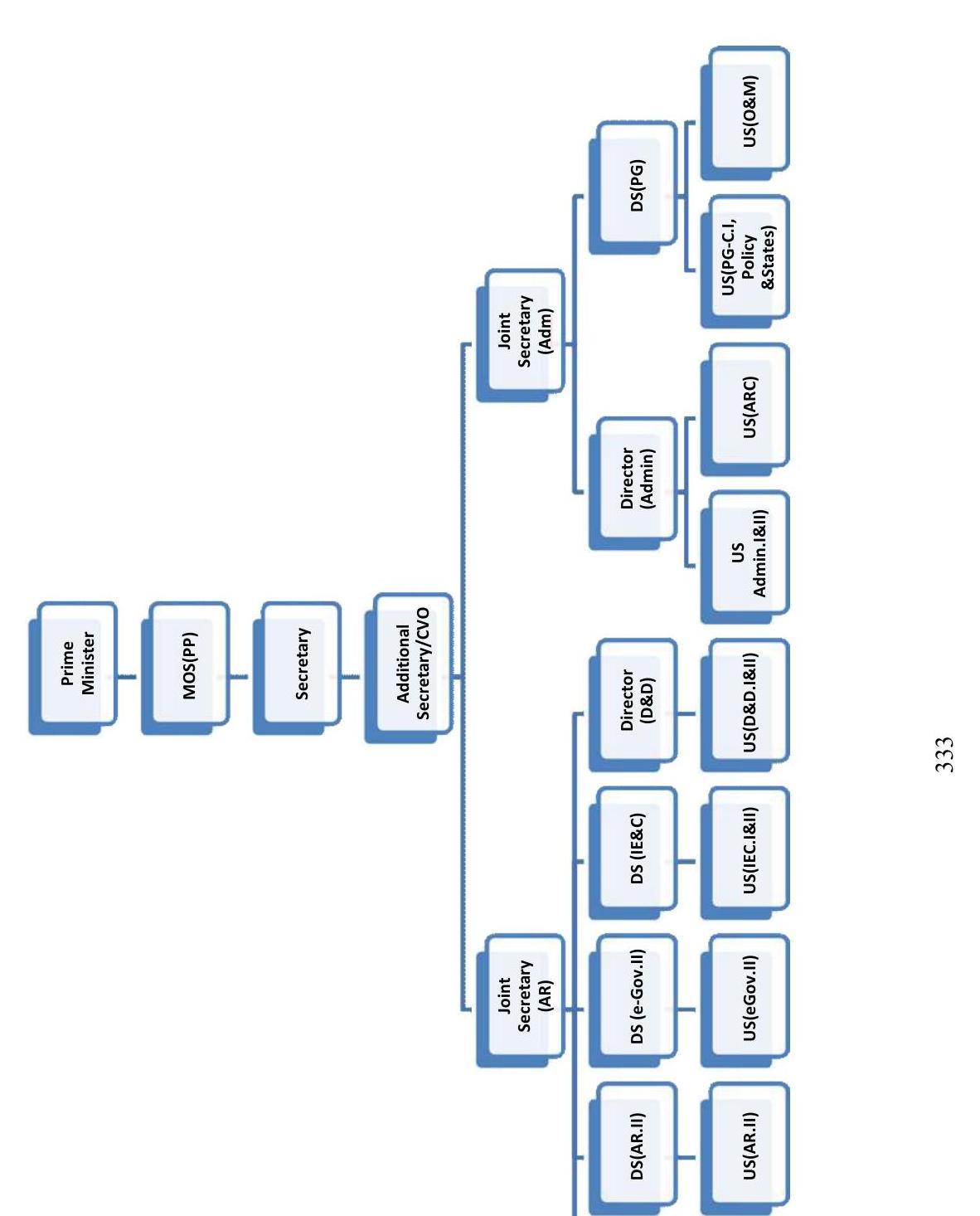
Department of Administrative Reforms and Public Grievances
Incumbency Position of Under Secretary and above level Officers in D/o AR&PG as on 31.03.2023
| Post | Name of Incumbent |
|---|---|
| Secretary | Shri V. Srinivas |
| Additional Secretary/ CVO | Shri Amar Nath |
| Joint Secretary | 1. Ms. Jaya Dubey 2. Shri NBS Rajput |
| Director | 1. Shri Narendra Kumar Meena 2. Shri K Sanjayan |
| Deputy Secretary | 1. Smt. Prisca Mathew 2. Shri Parthasarathy Bhaskar Devarakonda 3. Smt. Sarita Taneja 4. Shri Balbir Singh 5. Shri Sanjeev Shrivastava |
| Principal Staff Officer(PSO) | 1. Shri MP Varadharajan 2. Smt. Rekha Dehariya |
| Under Secretary | 1. Shri Rajendra Sharma 2. Shri Manoj KumarSingh 3. Shri Kaikam Doungel 4. Shri Khamchin Naulak 5. Shri Gya Prasad 6. Smt.Vibhuti Panjiyar 7. Shri Kamal Kumar Thakur 8. Smt. Sunila Bagga 9. Shri Dharampal Arora 10. Shri Rakesh Chandra 11. Shri Sunil Kumar Singh 12. Shri R Rajasekharan 13. Shri Santosh Kumar 14. Shri Prashant Pandey |
| Principal Private Secretary(PPS) | 1. Shri Sudhir 2. Smt. Ranjana Mallik 3. Smt. Sunita Gaba |
Department of Administrative Reforms and Public Grievances
Prevention of Sexual Harassment of Women in the Workplace
An Internal Complaint Committee has been constituted in the Department of Administrative Reforms and Public Grievances for the Prevention of Sexual Harassment of Women in the Workplace comprising offollowing members:
(i) Ms. Jaya Dubey, Joint Secretary
(ii) Shri Sanjeev Srivastava, Deputy Secretary
(iii) Ms. Vibhuti Panjiyar,Under Secretary
(iv) Dr. Sonajharia Minz, representative sponsored by YWCA
- Chairperson
- Member
- Member
- Member
Women employees are being made aware of the existence of the said Committee from time to time through circulars, display on notice boards, and interactions. In this connection, DARPG organized a Virtual Round-Table webinar on the theme “Women in Civil Service” on $7^{\text {th }}$ March 2022 to promote and celebrate women’s empowerment in all its dimensions. Two distinguished lead speakers viz. former diplomat Ambassador Bhaswati Mukherjee, and former Secretary to the Government of India Smt. Rajni Sekhri Sibal, IAS (retd) addressed the Virtual webinar on this occasion. All Officers / Officials of this Department and the Department of Pensions & Pensioner’s Welfare attended the event virtually. Also, Hon’ble MoS (PP) interacted with women officers in DoPT, DARPG and DP\&PW on 05.09.2022 at CSOI to discuss / share measures taken by the Government for welfare of women. No complaint of sexual harassment from any of the women employees has been received during the year.
Annexure-VIII
Department of Administrative Reforms and Public Grievances
Welfare of SC, ST, OBC and Persons with Disability (PWD)
As on 31.03.2023, the incumbency position of SC, ST, OBC and Persons with Disability (PWD) in the Group A, B and C category of officials of Department of Administrative Reforms and Public Grievancesis as under:
| Category | Total | SC | ST | OBC | PWD |
|---|---|---|---|---|---|
| Group-A | 28 | 4 | 3 | 4 | — |
| Group-B | 29 | 3 | 2 | 7 | $1(\mathrm{OH})$ $1(\mathrm{HH})$ |
| Group-C | 10 | 2 | – | 2 | $1(\mathrm{OH})$ |
| Total | $\mathbf{6 7}$ | $\mathbf{9}$ | $\mathbf{5}$ | $\mathbf{1 3}$ | $\mathbf{3}$ |
The Department has appointed a Nodal Officer to look into the complaints / representations, if any, received from SC, ST and OBC officials and as also to watch their welfare.
Department of Pension and Pensioner’s Welfare
ORGANISATIONAL CHART
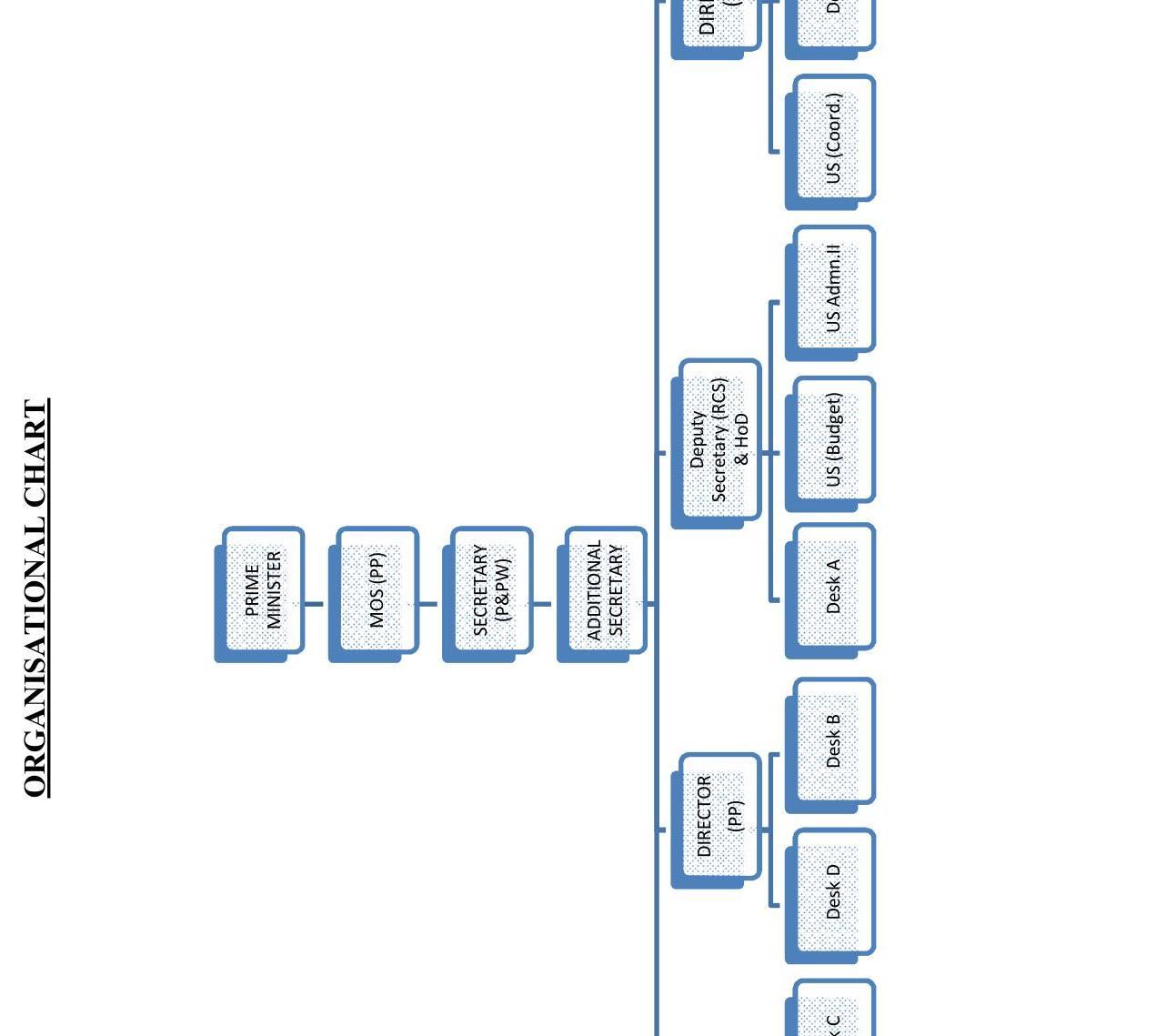
Annexure X
Incumbency position of Officers in
D/o Pension & Pensioner’s Welfare as on 31/12/2022
| Post | Name of the incumbent |
|---|---|
| Secretary | Shri V. Srinivas |
| Additional Secretary | Shri Sanjiv Narain Mathur |
| Director | Shri Ruchir Mittal Shri Pramod Kumar Shri Ravinder Kumar |
| Deputy Secretary | Shri Ramesh Chandra Sethi |
| Under Secretary | Shri Charanjit Taneja Shri Manoj Kumar Shri S. Chakrabarti Shri Ashok Kumar Singh Shri Rajendra Kumar Dutta Shri Subhash Chander Shri Rajesh Kumar Shri Dhananjay Prasad Singh Shri Vishal Kumar Shri Deepak Gupta |
| Assistant Director(OL) | Ms Manju Gupta |
| Section Officers | Shri Hemant Ms Deborah Umesh Ms Swati Kant Shri Andrew ZomawiaKarthak Shri Akhlesh Mann |
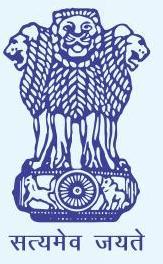
Ministry of Personnel, Public Grievances and Pensions Government of India
Printed by the Manager, Government of India Press, Minto Road, New Delhi-110002
